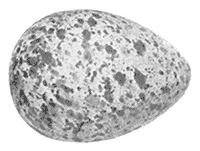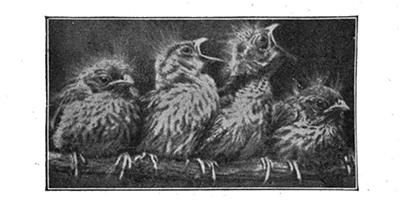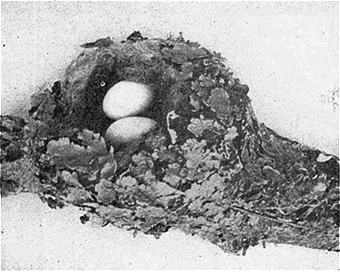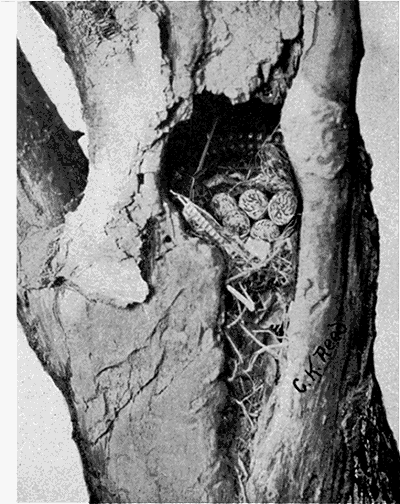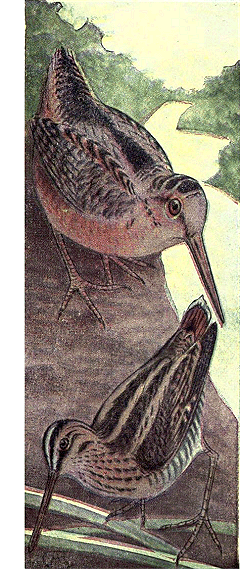The Project Gutenberg EBook of The Bird Book, by Chester A. Reed
This eBook is for the use of anyone anywhere at no cost and with
almost no restrictions whatsoever. You may copy it, give it away or
re-use it under the terms of the Project Gutenberg License included
with this eBook or online at www.gutenberg.org
Title: The Bird Book
Illustrating in natural colors more than seven hundred
North American birds; also several hundred photographs of
their nests and eggs
Author: Chester A. Reed
Release Date: September 15, 2009 [EBook #30000]
Language: English
Character set encoding: UTF-8
*** START OF THIS PROJECT GUTENBERG EBOOK THE BIRD BOOK ***
Produced by David Edwards, Rénald Lévesque and the Online
Distributed Proofreading Canada Team at
http://www.pgdpcanada.net (This file was produced from
images generously made available by The Internet
Archive/American Libraries.)
|
Page 1
|

|
|
|
Page 2
|

Male. Female.
Young.
|
|
Page 3
THE BIRD BOOK
ILLUSTRATING IN NATURAL COLORS
MORE THAN SEVEN HUNDRED
NORTH AMERICAN BIRDS;
ALSO SEVERAL HUNDRED
PHOTOGRAPHS OF THEIR
NESTS AND EGGS
BY
CHESTER A. REED, B. S.

Garden City New York
DOUBLEDAY, PAGE & COMPANY
1915
Page 4
Copyright, 1914, by
CHARLES K. REED
All rights reserved, including that of
translation into foreign languages,
including the Scandinavian.
Page 5

BARN OWL.
Page 6

TOPOGRAPHY OF A BIRD.
Page 7
TABLE OF CONTENTS
|
|
Diving Birds. Order I. Pygopodes 10
Grebes. Family Colymbidæ 11
Loons. Family Gaviidæ 17
Auks, Murres and Puffins. Family Alcidæ 21
Long-winged Swimmers. Order II. Longipennes 35
Skuas and Jægers. Family Stercoraridæ 35
Gulls and Terns. Family Laridæ 38
Skimmers. Family Rynchopidæ 58
Tube-nosed Swimmers. Order III. Tubinares 59
Albatrosses. Family Diomedeidæ 59
Fulmars, Shearwaters and Petrels. Family Procellariidæ 61
Totipalmate Swimmers. Order IV. Steganopodes 72
Tropic Birds. Family Phæthontidæ 72
Gannets. Family Sulidæ 74
Darters. Family Anhingidæ 77
Cormorants. Family Phalacrocoracidæ 78
Pelicans. Family Pelecanidæ 83
Man-o'-War Birds. Family Fregatidæ 86
Lamellirostral Swimmers. Order V. Anseres 87
Lamellirostral Grallatores. Order VI. Odontoglossæ 115
Flamingoes. Family Phœnicopteridæ 115
Herons, Storks, Ibises, etc. Order VII. Herodiones 115
Spoonbills. Family Plataleidæ 115
Ibises. Family Ibididæ 117
Storks and Wood Ibises. Family Ciconiidæ 118
Herons, Bitterns, etc. Family Ardeidæ 119
Cranes, Rails, etc. Order VIII. Paludicolæ 127
Cranes. Family Gruidæ 127
Courlans. Family Aramidæ 129
Rails, Gallinules and Coots. Family Rallidæ 131
Shore Birds. Order IX. Limicolæ 137
Phalaropes. Family Phalaropodidæ 137
Avocets and Stilts. Family Recurvirostridæ 139
Snipes, Sandpipers, etc. Family Scolopacidæ 140
Plovers. Family Charadriidæ 161
Surf Birds and Turnstones. Family Aphrizidæ 169
Oyster-catchers. Family Hæmatopodidæ 170
Jacanas. Family Jacanidæ 172
Gallinaceous Birds. Order X. Gallinæ 175
Grouse, Partridges, etc. Family Odontophoridæ 175
Turkeys. Family Meleagridæ 178
Curassows and Guans. Family Cracidæ 191
|
|
|
Page 8
|
Pigeons. Order XI. Columbæ 192
Pigeons. Family Columbidæ 192
Birds of Prey. Order XII. Raptores 198
American Vultures. Family Cathartidæ 198
Hawks, Eagles, etc. Family Buteonidæ 201
Falcons, etc. Family Falconidæ 218
Osprey. Family Pandionidæ 225
Barn Owls. Family Aluconidæ 227
Owls. Family Strigidæ 227
Parrots, Paroquets. Order XIII. Psittaci 241
Parrots and Paroquets. Psittacidæ 241
Cuckoos, etc. Order XIV. Coccyges 241
Cuckoos, Anis, etc. Family Cuculidæ 241
Trogons. Family Trogonidæ 246
Kingfishers. Family Alcedinidæ 247
Woodpeckers, Wrynecks, etc. Order XV. Pici 249
Woodpeckers. Family Picidæ 249
Goatsuckers, Swifts, etc. Order XVI. Macrochires 262
Goatsuckers, etc. Family Caprimulgidæ 263
Swifts. Family Micropodidæ 268
Hummingbirds. Family Trochilidæ 271
Perching Birds. Order XVII. Passeres 280
Cotingas. Family Cotingidæ 280
Tyrant Flycatchers. Family Tyrannidæ 280
Larks. Family Alaudidæ 297
Crows, Jays, Magpies, etc. Family Corvidæ 300
Starlings. Family Sturnidæ 314
Blackbirds, Orioles, etc. Family Icteridæ 314
Finches, Sparrows, etc. Family Fringillidæ 324
Tanagers. Family Tangaridæ 369
Swallows. Family Hirundinidæ 372
Waxwings. Family Bombycillidæ 375
Shrikes. Family Laniidæ 376
Vireos. Family Vireonidæ 378
Honey Creepers. Family Cœrebidæ 385
Warblers. Family Mniotiltidæ 385
Wagtails. Family Motacillidæ 418
Dippers. Family Cinclidæ 419
Wrens. Family Troglodytidæ 423
Thrashers, etc. Family Mimidæ 429
Creepers. Family Certhiidæ 430
Nuthatches. Family Sittidæ 431
Titmice. Family Paridæ 431
Warblers, Kinglets, Gnatcatchers. Family Sylviidæ 433
Thrushes, Solitaires, Bluebirds, etc. Family Turdidæ 442
Index 451
|
|
Page 9
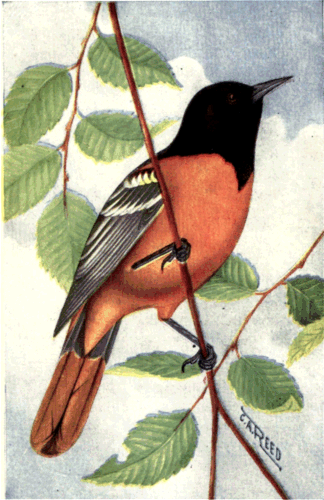
BALTIMORE ORIOLE.
|
Page 10
|
THE BIRD BOOK
DIVING BIRDS. Order I. PYGOPODES
GREBES. Family COLYMBIDÆ
Grebes are birds having a ducklike body, but with pointed bills. Their
feet, too, are unlike those of the Ducks, each toe having its separate web, and
having a broad flat nail. Their wings are very small for the size of the body,
making it impossible for them to rise in flight from the land. They rise from
the water by running a few yards along the surface until they have secured
sufficient headway to allow them to launch themselves into the air. After
having risen from the water their flight is very swift and strong. On land they
are very awkward and can only progress by a series of awkward hops; they
generally lie flat on their breasts, but occasionally stand up, supporting themselves
upon their whole tarsus. Grebes, together with the Loons, are the most
expert aquatic birds that we have, diving like a flash and swimming for an incredible
distance under water.
|
|
|
Page 11
|
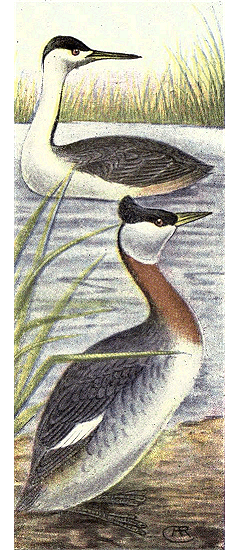
Western Grebe.
Holboell's Grebe.
1. Western Grebe. Aechmophorus occidentalis.
Range.--Western parts of North America, from
southern Alaska southward; east to Minnesota
and south in winter to the southern parts of the
United States and Mexico. Breeds from the Dakotas
and northern California northward. These
are the largest of the American Grebes; owing to
their unusually long necks, they are frequently
called "Swan Grebes." They are very timid
birds and conceal themselves in the rushes on
the least suspicion of danger. 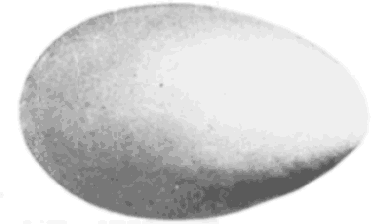
Chalky bluish white, stained buff.
At times, to escape
observation, they will entirely submerge their
body, leaving only their head and part of the
long neck visible above the water. This Grebe
cannot be mistaken for any other because of the
long slender neck and the long pointed bill,
which has a slight upward turn. They nest abundantly
in the marshes of North Dakota and central
Canada. Their nests are made of decayed rushes,
and are built over the water, being fastened to
the rushes so that the bottom of the nest rests in
the water. The nesting season is at its height
during the latter part of May. They lay from
three to five eggs, the ground color of which is a
pale blue; this color is, however, always concealed by a thin chalky deposit,
and this latter is frequently stained to a dirty white. Size 2.40 × 1.55.
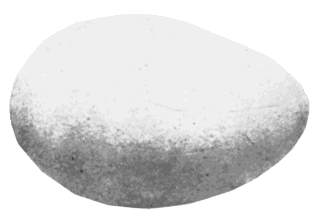
White, stained buff.
2. Holboell's Grebe. Colymbus holboellii.
Range.--Throughout North America,
breeding from northern United
States northward and wintering
from the middle to the southern
portions of the United States.
In regard to size this Grebe comes
next to the Western, being 19 in.
in length. This bird can be distinguished
by the white cheeks and
throat and the reddish brown foreneck.
They breed abundantly in
the far north placing their floating
islands of decayed vegetation in
the water in the midst of the
marsh grass. They lay from three
to six eggs of a dingy white color
which have the stained surface common to Grebes eggs. Size 2.35 × 1.25.
|

|
|
Page 12
|
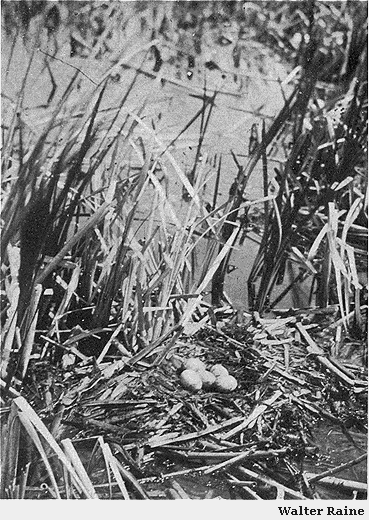
NEST AND EGGS OF HOLBOELL'S GREBE
Lake Winnipegosis, Manitoba.
|
|
|
Page 13
|
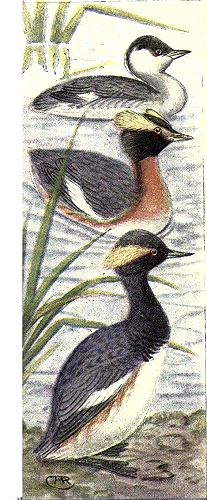
Horned Grebe.
Eared Grebe. 3. Horned Grebe. Colymbus auritus.
Range.--The whole of North America, breeding
in the interior from North Dakota northwest;
winters along the Gulf Coast. This species is
one of the most beautiful of the Grebes, having
in the breeding season buffy ear tufts, black
cheeks and throat, and chestnut neck, breast and
sides. They breed abundantly in the marshy flats
of North Dakota and the interior of Canada.

Buffy white, nest stained. They build a typical Grebe's nest, a floating mass
of decayed matter which stains the naturally
white eggs to a dirty brown. The number of
eggs varies from three to seven. Size 1.70 × 1.15.
Data.--Devils Lake, N. Dakota, June 20, 1900.
6 eggs much stained. Nest floating in 4 ft. of
water, a large mass of rotten rushes and weeds.
Collector. James Smalley.
4. Eared Grebe. Colymbus nigricollis
californicus.
Range.--North America west of the Mississippi,
breeding from Texas to Manitoba and wintering
along the Pacific Coast of the United States
and from Texas southward.
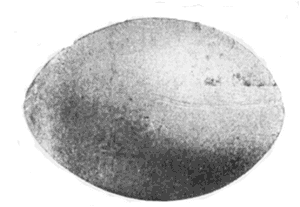
Bluish white, stained. Eared Grebes differ from the preceding in having
the entire neck blackish. They nest very
abundantly throughout the west, in favorable localities,
from Texas to Minnesota and Dakota.
Their nests are constructed in the same manner
as the preceding varieties and are located in similar localities.
As do all
the Grebes when leaving the nest, they cover the eggs with the damp rushes from
around the base of the nest. This is probably
for the purpose of assisting incubation
during their absence, by the action of
the sun's rays on the wet mass. As they
are nearly always thus covered upon the
approach of anyone, this may be done also
as a protection from discovery. They lay
from three to eight bluish white eggs with
the usual chalky and discolored appearance.
The breeding season is at its height
early in June, or earlier, in the southern
portion of its range. Size 1.75 × 1.20. Data.--Artesian,
S. Dakota, June 21, 1899. Nest
of rushes, floating in three feet of water.
Large colony in a small lake. Collector, F. A. Patton.
|

|
Page 14

|
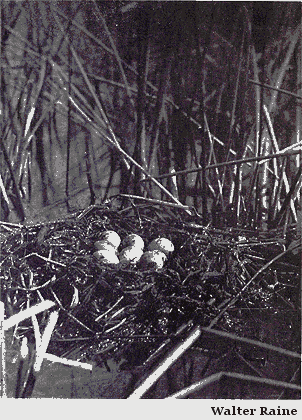
NEST AND EGGS OF HORNED GREBE
Saltcoats Marshes, Assiniboia, June 6, 1901.
|
|
|
Page 15
|
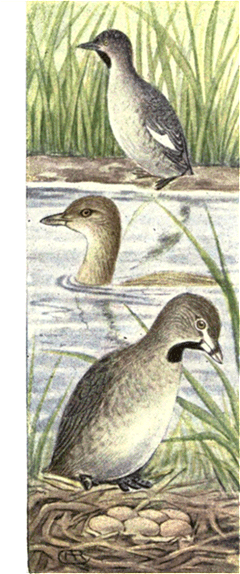
Mexican Grebe.
Pied-billed Grebe.. 5. Mexican Grebe. Colymbus
dominicus brachypterus.
Range.--Southern Texas and Lower California
southward to South America, breeding
throughout its range.
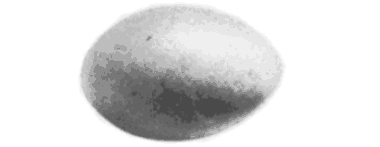
Deep buff or rich brown. The Least Grebe is by far the smallest of
the Grebes in this country, being but 10 in.
in length; it can not be mistaken for any
other, the Eared Grebe being the only species
of this family found in the same localities
during the summer. These little Grebes
nest very abundantly along the Rio Grande
Valley in Texas, the nesting season lasting
from the latter part of May until well into
December.
Their nests are floating piles of grass and
weeds upon which they lay from three to
five chalky white eggs, which are always
discolored, sometimes to a deep chocolate
hue. These eggs average a great deal darker
in color than do any of the other Grebes.
In a series of fifty sets fully half were a
rich brown tint. Size 1.40 × .95.
6. Pied-billed Grebe. Podilymbus
podiceps.
Range.--From the British provinces
southward to Argentine Republic, breeding
locally throughout the northern portions of
its range.

Deep buff. The Dabchick, as this bird is called, is the most evenly distributed bird
of this family. It is nowhere especially abundant, nor is it, except in a very
few localities, regarded as rare. Consequently it is the best known bird of
the species. They do not congregate in such large numbers as the other
Grebes during the nesting season, but one
or more pairs may be found in almost any
favorable locality. These birds render their
floating nest a little more substantial than
those of the preceding varieties by the addition
of mud which they bring up from the
bottom of the pond; this addition also tends
to soil the eggs more, consequently the
eggs of this bird are, as a general rule,
browner than the other Grebes with the exception
of the Least. The bird may always
be known by the shape of its bill which is
higher than it is broad, and in the summer
is white with a black band across the middle. The throat is also black at
this season. They lay from five to nine eggs commencing about the middle
of May. Size 1.70 × 1.18.
|

|
Page 16
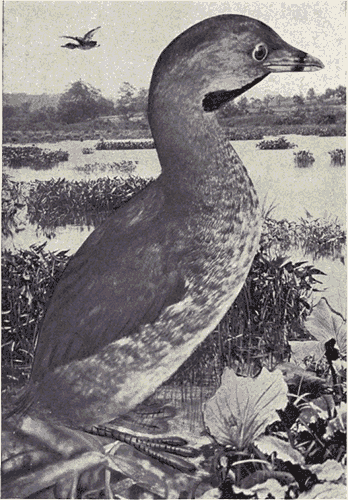
PIED-BILLED GREBE.
|
Page 17
|
LOONS. Family GAVIIDAE
Loons may be likened to gigantic Grebes from which they differ externally,
chiefly in the full webbed foot instead of the individually webbed toes of
the Grebe, and in the sharper, more pointed and spear-like bill. These birds
are similar in their habits to the Grebes, except that their homes are generally
more substantially built and are placed upon a solid foundation, generally
upon an island in some inland lake.
Both Loons and Grebes are literally "Water witches," being practically,
and in the case of Grebes, actually, born in the water and living in it ever
afterwards. Loons are strong fliers, but like the Grebes, because of their
small wings they must get their first impetus from the water in order to
rise; in case there is any wind blowing they also make use of this by starting
their flight against it. They are very peculiar birds and the expression
"crazy as a loon" is not a fanciful one, being formed from their early morning
and evening antics when two or more of them will race over the top of the
water, up and down the lake, all the while uttering their demoniacal laughter.
They vie with the Grebes in diving and disappear at the flash of a gun.

EGG OF LOON.
Dark greenish brown.
|

|
Page 18

|
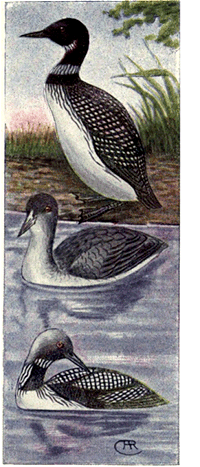
Loon.
Black-throated Loon. 7. Loon. Gavia immer.
Range.--North America north of the Mexican
boundary, breeding from the northern
parts of the United States northward.
Unlike the Grebes, Loons do not build in
colonies, generally not more than one, or
at the most two pairs nesting on the same
lake or pond; neither do they seek the
marshy sloughs in which Grebes dwell, preferring
the more open, clear bodies of
water. The common Loon may be known
in summer by the entirely black head and
neck with the complete ribbon of black and
white stripes encircling the lower neck and
the narrower one which crosses the throat.
The back is spotted with white. In some
sections Loons build no nest, simply scooping
a hollow out in the sand, while in other
places they construct quite a large nest of
sticks, moss and grasses. It is usually placed
but a few feet from the waters edge, so
that at the least suspicion the bird can slide
off its eggs into the water, where it can cope
with any enemy. The nests are nearly always
concealed under the overhanging
bushes that line the shore; the one shown
in the full page illustration, however, was
located upon the top of an old muskrat
house. The two eggs which they lay are a
very dark greenish brown in color, with
black spots. Size 3.50 × 2.25. Data.--Lake
Sunapee, N. H., June 28, 1895. Nest placed
under the bushes at the waters edge. Made
of rushes, weeds and grasses; a large structure
nearly three feet in diameter. Collector,
H. A. Collins.
8. Yellow-billed Loon. Gavia adamsi.
Range.--Northwestern North America, along the Arctic and northern Alaskan
coasts.
The Yellow-billed Loon with the exception of its whitish or yellowish bill
in place of the black, is practically otherwise indistinguishable from the
common Loon. It averages somewhat larger in size. This is one of the most
northerly breeding birds and it is only within a very few years that anything
has been learned about the breeding habits. Their nesting habits and eggs
are precisely like the preceding except that the latter average a little larger.
Size 3.60 × 2.25.
9. Black-throated Loon. Gavia arctica..
Range.--From northern United States northward, breeding along the Arctic
Coast.
This species can be easily separated from the Loon by the gray crown and
white streaks down the back of the neck. Its size, too, is about five inches
shorter. The nesting habits are the same as the Loons and the eggs have
rather more of an olive tint besides having the majority of spots at the
larger end. Size 3.10 × 2.00.
|
|
|
Page 19
|
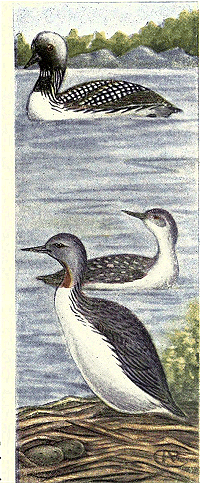
Pacific Loon.
Red-throated Loon. 10. Pacific Loon. Gavia pacifica.
Range.--Western North America along the
coast chiefly, breeding from Alaska south to
British Columbia. In winter, south along the
coast to Mexico.
This species differs from the Black-throated
only in the tint of the head reflections. The
habits are the same as those of the other members
of the family. They lay two eggs of a greenish
brown or greenish gray hue with black spots.
Size 3.10 × 1.90. Data.--Yukon River, Alaska,
June 28, 1902. Nest of rubbish on an island;
found by a miner.
11. Red-throated Loon. Gavia stellata.
Range.--Northern parts of North America,
breeding from southern Canada northward in the
interior on both coasts. South to the middle portions
of the United States in winter.
This is the smallest of the Loon family, being
twenty-five inches in length. In plumage it is
wholly unlike any of the other members at all
seasons of the year. In summer the back, head
and neck are gray, the latter being striped with
white. A large chestnut patch adorns the front
of the lower part of the neck. In winter the
back is spotted with white, whereas all the others
are unspotted at this period. The nesting habits are
identical with the other species; the ground color
of the two eggs is also the same. Size 2.00 × 1.75.

|

|
Page 20

NEST AND EGGS OF LOON.
This nest is built on top of a Muskrat house.
Page 21
PUFFINS, AUKS and MURRES.
Family ALCIDÆ
|
|
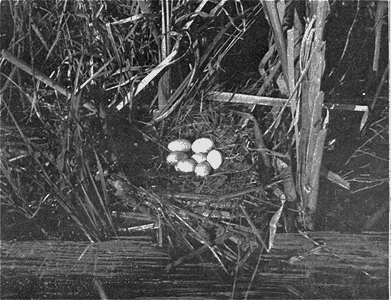
NEST AND EGGS OF PIED-BILLED GREBE.
Puffins, Auks and Murres are all sea birds and are only found inland when
blown there by some severe storm of winter. At this season numbers of them
are apt to lose their bearings and may sometimes be found with their feet
frozen in some of our inland ponds. Puffins are heavily built birds in appearance,
but are very active both on the wing and in the water. Their wings are
much larger comparatively than those of the other members of this family,
so they are enabled to perform evolutions in the air, which are withheld from
the others. They stand upright on the sole of the foot and are able to walk
quite easily on land. Puffins have very heavy and deep but thin bills, which
are entirely unlike those of any other bird and often give then the name of
Parrot Auks. Puffins, Auks and Murres are otherwise recognized by the presence
of but three toes which are webbed.
|

|
Page 22

Page 23
|
12. Tufted Puffin. Lunda cirrhata.
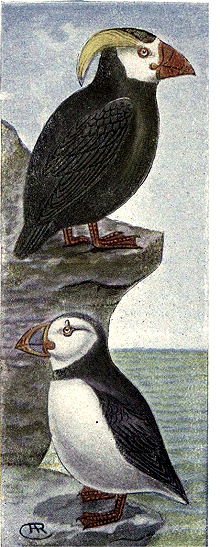
Tufted Puffin. Puffin. Range.--Pacific Coast from Alaska southward
to southern California, breeding locally throughout
their range.
Tufted Puffins are the largest of the Puffins.
In the breeding plumage, they are a sooty brownish
or black color; the cheeks are white, and a
long tuft of straw colored feathers extends back
from each eye; the bill is bright red and greenish
yellow. They breed commonly on the Farallones,
where two or three broods are raised by a
bird in a single season, but much more abundantly
on the islands in the north.
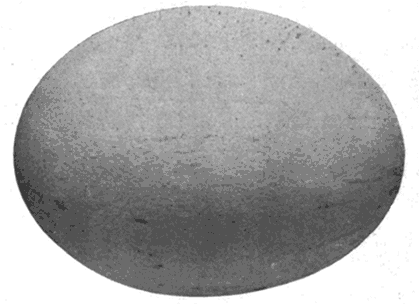
White. Their single eggs are laid in burrows in the ground or else in
natural crevices formed by the rocks. The eggs are pure white or pale buff
and are without gloss. They very often have barely perceptible shell markings
of dull purplish color. The eggs are laid about the middle of June. Size 2.80
× 1.90. Data.--Farallone Is., May 27, 1887. Single egg laid in crevice of rocks.
Collector, W. O. Emerson.
13. Puffin. Fratercula arctica arctica.
Range.--North Atlantic Coast, breeding from the Bay of Fundy northward.
Winters from breeding range along the New England Coast.

White.. The common Puffin has the cheeks, chin and underparts white; upper parts
and a band across the throat, blackish. Bill deep and thin, and colored with
red, orange and yellow. They breed in large numbers on Bird Rock in the
Gulf of St. Lawrence.
The nest is either among the natural crevices of the
rocks, or in burrows excavated
in the ground by the birds.
These burrows vary in length
from two and a half to four
or five feet. Except upon the
positive knowledge of the absence
of the bird, it is a
hazardous thing to put the
hand in one of these burrows
for the bird can, and will nip
the fingers, sometimes to the
bone. They lay but a single
egg, usually dull white and
unmarked, but in some cases
obscurely marked with reddish
brown. Size 2.50 × 1.75. Data.--So. Labrador, June 23, 1884. Single egg
laid at end of burrow in the ground. Collector, J. H. Jameson.
13a. Large-billed Puffin. Fratercula arctica naumanni.
A more northerly subspecies of the last, inhabiting the Arctic region on the
Atlantic side. The bird is somewhat larger but otherwise indistinguishable
from the common species. The eggs are exactly the same or average a trifle
larger. Size 2.55 × 1.80. Data.--Iceland, July 6, 1900. Single egg in hole under
a rock. Collector, Chas. Jefferys.
14. Horned Puffin. Fratercula corniculata.
Range.--Pacific Coast from Alaska to British Columbia. The Horned Puffin
differs from the common in that the blackish band across the throat extends
upwards in a point to the bill. Their nesting habits are precisely the same as
those of the preceding species. A single pure white egg is laid; the shell is
slightly rougher than those of the others. Size 2.65 × 1.80. Data.--Round Is.,
Alaska, June 24, 1884. Single egg laid at end of burrow in ground; no nest.
Collector, G. L. Kennedy.
15. Rhinoceros Auklet. Cerorhinca monocerata.
Range.--Pacific Coast, breeding from British Columbia northward and wintering
southward to Lower California.
The Rhinoceros Auklet or Horned Auk has a much smaller bill than the
Puffins; in the summer this is adorned at the base by a horn from which it
takes its name. There are also slender plumes from above and below the eyes.
Unlike the Puffins, these birds sit upon their whole tarsus.
They nest on islands of the North Pacific Coast from Vancouver northward.
A single egg is laid in crevices among the rocks or in burrows in the ground.
It is similar both in size and shape to that of the Puffins, but is often quite
heavily blotched with brown. Size 2.70 × 1.80. Data.--Unak Is., Alaska, June
30, 1900. Egg laid in a fissure of the rocks; no nest. Collector, F. Weston.
|

|
Page 24

|
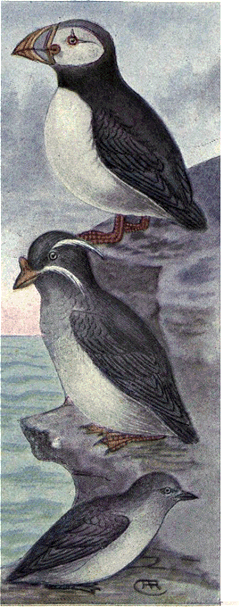
Horned Puffin.
Rhinoceros Auklet.
Cassin Auklet. 16. Cassin Auklet. Ptychoramphus aleuticus.
Range.--Pacific Coast from Alaska to Lower
California, breeding nearly throughout its range.
A plain appearing bird about 9 in. in length,
with blackish upperparts relieved only by a white
spot over the eye; breast and throat gray and
belly white. This Auklet is fairly abundant on
the Farallones, breeding on the lower portions of
the island.
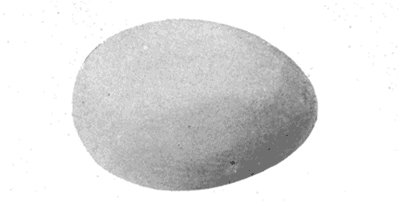
White.. The late Mr. C. Barlow says that it
is found in deserted rabbit burrows and in all
probability often excavates its own burrows. It
also nests among the cliffs placing its eggs among
the rocks in any crevice or tunnel which may offer
a dark retreat during the day for they are nocturnal
in their habits. The single egg which they
lay is dull white in color, the inside of the shell
being a pale green, which color can only be seen
by holding the egg to the light. They are generally
slightly nest stained. Size 1.80 × 1.30.
Data.--Coronado Islands, Cal., March 23, 1897.
Single egg laid on the bare ground at end of a
burrow three and one-half feet long. Collector,
E. A. Shives.
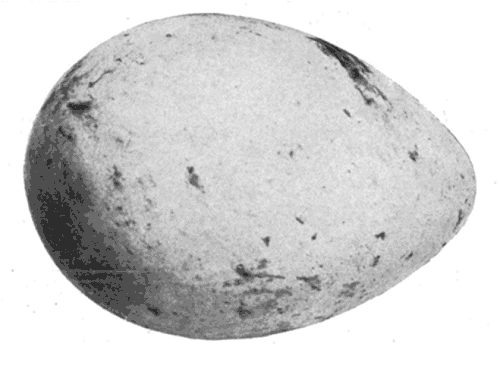
RHINOCEROS AUKLET.
Color white, sometimes heavily blotched,
as above, and again unspotted.
|
|
|
Page 25
|
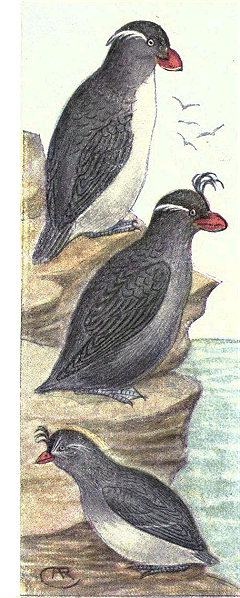
Paroquet Auklet.
Crested Auklet. 17. Paroquet Auklet.--Phaleris psittacula.
Range.--The Alaskan Coast, casually farther
south in winter.
This bird is about the same size as the preceding,
and the plumage is similar, except that it
has no white spot over the eye, and the breast is
white. It also has a slender plume extending
from back of the eye.
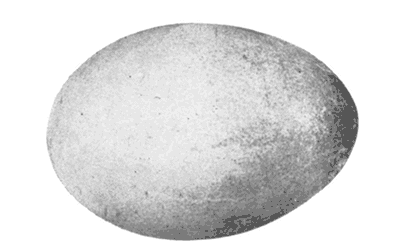
White. The bill is very peculiar,
being quite deep and rounded and having an upward
tendency. It is orange red in color. They
breed very commonly on the islands of Bering
Strait. Their eggs are laid in the crevices of the
cliff, often several feet in and by a crooked path
so that it is impossible to reach them. The single
chalky white egg is laid in May. Size 2.30 ×
1.45. Data.--Rocky Islet in the Aleutians, June
22, 1890. Single egg laid on bare rock in a deep
crevice. Collector, Capt. S. Wilson.
18. Crested Auklet. Aethia cristatella.
Range.--Alaska Coast, similar in form and plumage to the latter, except
that the whole under parts are gray and it has a crest of recurved feathers.
The nesting season begins in May, the birds nesting upon the same islands
and in the same kinds of sites as the last species. The single egg is chalky
white. Size 2.10 × 1.50. Data.--Unak Is., Alaska, July 1, 1900. Egg laid in a
crevice among the rocks. Collector, F. Weston.
19. Whiskered Auklet. Aethia pygmaea.
Range.--The Alaska Coast.
Much smaller than the preceding; but 7.5 in. in length. Breast gray, belly
white; a small tuft of recurved feathers on the forehead and slender white
plumes from base of bill over the eye and from under the eye, backwards. The
bill in summer is a bright vermillion color. On some of the islands of the
Aleutian chain they breed quite abundantly. The nests are placed back in
the crevices of the rocks, where the single white eggs are laid. Size 2.00 × 1.25.
|

|
Page 26

|
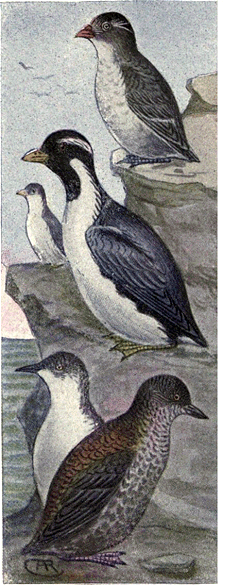
Least Auklet.
Ancient Murrelet.
Marbled Murrelet. 20. Least Auklet. Aethia pusilla.
Range.--North Pacific on the islands and coast
of Alaska. This is the smallest of the Auklets;
length 6.5 in. This species has no crest, but has
the slender white plumes extending back from
the eye. The entire under parts are white sparsely
spotted with dusky. This species is by far the
most abundant of the water birds of the extreme
Northwest, and thousands of them, accompanied
by the two preceding species, nest on the rocky
cliffs of the islands of Bering Sea. Their nesting
habits are the same as those of the other Auklets,
they placing their single white egg on the
bare rocks, in crevices on the cliffs. Size 1.55 ×
1.10. Data.--Pribilof Is., Alaska, June 8, 1897.
Single egg laid in crevice. Thousands breeding
on the island.
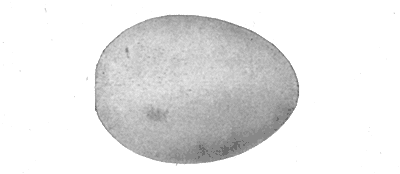
White. 21. Ancient Murrelet. Synthliboramphus antiquus.
Range.--Pacific Coast, breeding from the border
of the United States, northward, and wintering
south to southern California. The Murrelets have no crests or
plumes and the bills are more slender
than the Auklets and are not
highly colored.
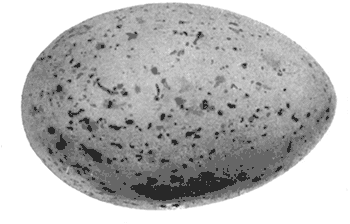
Buff.
The ancient Murrelet
or Black-throated Murrelet,
as it is also called, has a gray
back, white under parts and a
black head and throat, with a broad
white stripe back of the eye and
another formed by the white on
the breast extending up on the side
of the neck. They breed abundantly
on the islands in Bering Sea,
laying one or two eggs at the end
of burrows in the banks or on the
ground, and in some localities in crevices on the cliffs. The eggs are a buffy
white color and are faintly marked with light brown, some of these being in
the shape of spots and others lengthened. Size 2.40 × 1.40. Data.--Sanak Islands,
July 1, 1894. Two eggs on the ground under a tuft of grass and in a
slight excavation lined with fine grass.
|
|
|
Page 27
|
23. Marbled Murrelet. Brachyramphus marmoratus.
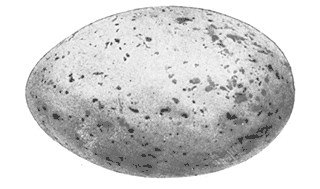
Buff. Range.--North Pacific Coast,
breeding from Vancouver Island.
South in winter to southern
California.
In the breeding plumage,
this bird is brownish black
above, barred with rusty and
below is marbled with brownish
gray and white. Its nesting
habits and eggs are very similar
to those of the Ancient Murrelet,
they placing their single
eggs in holes in the ground or
crevices among the cliffs. Size
2.20 × 1.40. Data.--Chichagof Is., Alaska, June 18, 1898. Single egg in crevice
on face of cliff. Large colony breeding in company with Ancient Murrelets.
24. Kittlitz Murrelet. Brachyramphus brevirostris.
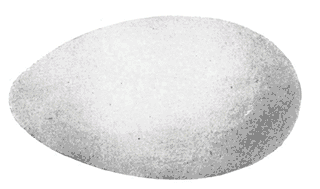
White. Range.--North Pacific Coast in the Aleutian Islands and north to Unalaska,
breeding on isolated islands
throughout its range. This species
is very similar to the Marbled
Murrelet, the chief difference
being in the bill which is
shorted. They have been found
breeding on the same islands
with the preceding species.
Their single white egg is laid
in crevices in the cliffs. Size
2.40 × 1.30. Data.--Sanak Is.,
Alaska, June 25, 1890. Nest in
a hollow under a bunch of rank
matted grass. Many ancient
Burrelets breeding on the same
Islands. Collector, Capt. Tilson.
25. Xantus Murrelet. Brachyramphus hypoleucus.
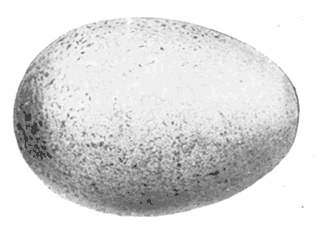
Pale Blue. Range.--Resident along the coast of southern and Lower California.
This bird is blackish above and entirely
white below, including the sides of
the head below the eye. The whole of
the under surface of the wing is also
white. They breed on the coast islands
from Santa Barbara southward. The single
egg is laid at the end of a burrow
or in crevices among the rocks. It is a
pale buffy white in color and thickly, but
finely dotted over the whole surface with
purplish brown, and with some larger
spots at the larger end. Size 2.05 × 1.40.
Data.--Galapagos Islands, March 2, 1901.
No nest. Single egg laid in a crevice in
the rocks. Collector, Rollo H. Beck.
|

|
Page 28

|
26. Craveri's Murrelet. Brachyramphus craveri.
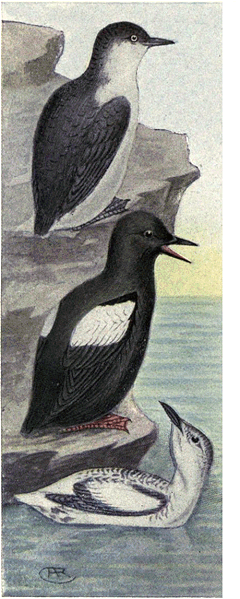
Xantus Murrelet.
Mandt's Guillemot. Range.--Both coasts of Lower California, breeding
chiefly on the Gulf side. Craveri Murrelet is
very similar to the last except that the under surfaces
of the wings are dusky.
27. Black Guillemot. Cepphus grylle.
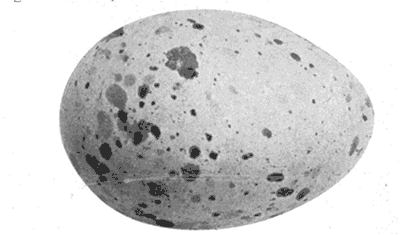
Bluish white. Breeds on the islands
near Cape St. Lucas, burrowing in the
ground as do most of the others of this species.
They lay a single egg, the ground color of which
is buff; they are quite heavily blotched with
brownish. Size 2.00 × 1.40.
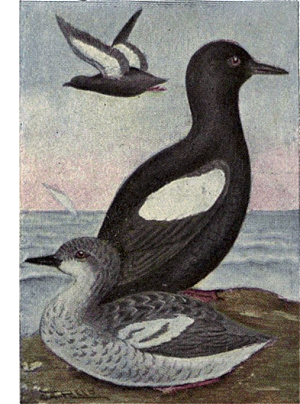
Black Guillemot.
Range.--Coasts and islands of the North Atlantic,
breeding from Maine northward to southern
Greenland. Guillemots are larger birds than
the Murrelets (length 13 inches) and their plumage
is entirely different. This species in summer
is entirely black except the wing coverts which
are white. The bases of the greater coverts,
however, are black, this generally breaking the
white mirror as it is called. The under surfaces
of the wings are white. Legs red. These
birds breed abundantly on the rocky islands
and high cliffs along the coast. Soon after
the first of June the eggs are laid in the crevices
of the rocks and sometimes upon the bare
ledges. Two or three eggs make the set. The
ground color is a pale bluish or greenish white
and the markings are various shades of brown
and black. Size 2.40 × 1.60. Data.--Grand
Manan, June 15, 1896. Two eggs laid in a
cavity back of large boulder. No nest. Collector,
D. H. Eaton.
|
|
|
Page 29
|
28. Mandt's Guillemot. Cepphus mandti.
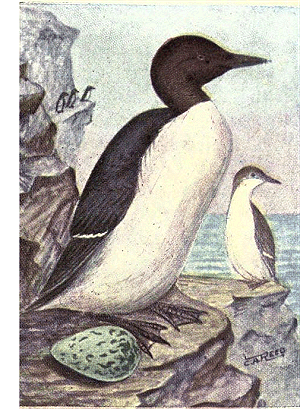
Murre. Range.--North Atlantic coast, more northerly
than the preceding, breeding from Labrador
to northern Greenland.
The bird differs from the Black Guillemot
only in having the bases of the coverts white
also. The nesting habits and eggs are identical.
They nest in colonies of thousands and
place the eggs upon the bare rock with no attempt
at nest building. Generally the eggs
are in the crevices so as to be difficult to get
at. Size 2.30 × 1.55. Data.--Depot Island, Hudson
Bay, June 6, 1894. Two eggs laid on bare
rocky ground. Collector John Comer.
29. Pigeon Guillemot. Cepphus columba.
Range.--The Pacific Coast of North America,
breeding from southern California northward.
This bird is very similar to the Black
Guillemot except that the under surfaces of
the wings are dark. They breed abundantly on some of the islands of Bering
Sea and a few of them nest on the Farallones. They lay their two eggs on
the bare rock in dark crevices. The color is grayish or pale greenish blue
and the markings are brown and
black with paler shell markings of
lilac. Size 2.40 × 1.60. Data.--S.
Farallone Islands, Cal. Two eggs
laid on gravel at the end of a burrow,
about two feet from the entrance
and 285 feet above the sea
level. Collector, Claude Fyfe.
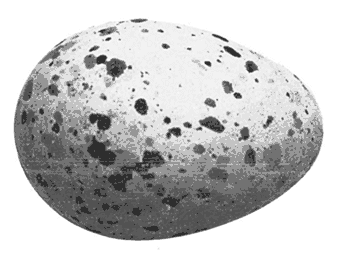
Pale bluish gray. 30. Murre. Uria troile troille.
Range.--North Atlantic coasts
and islands, breeding from Bird
Rock northward. Murres are similar
in form to the Guillemots, but
are larger, being about 16 inches
in length. Entire head and neck
sooty brown; rest of upper parts
Pale bluish gray.
grayish black except the tips of
the secondaries which are white. Under parts white. These birds nest by
thousands on Bird Rock and on the cliffs of Labrador. They build no nests
but simply lay their single egg on the narrow ledges of cliffs, where the only
guarantee against its rolling off is its peculiar shape which causes it, when
moved, to revolve about its smaller end instead of rolling off the ledge. The
eggs are laid as closely as possible on the ledges where the incubating birds
sit upright, in long rows like an army on guard. As long as each bird succeeds
in finding an egg to cover, on its return home, it is doubtful if they
either know or care whether it is their own or not. The ground color of the
eggs vary from white to a deep greenish blue and the markings of blackish
brown vary in endless patterns, some eggs being almost wholly unspotted.
Size 3.40 × 2.00. Data.--South Labrador, June 19, 1884. Single egg laid on the
bare cliff. Large colony breeding. Collector, M. A. Grasar.
|

|
Page 30

|
30a. California Murre. Uria troille californica.
Range.--Pacific Coast, breeding from the Farallones north to Alaska.
This Pacific form of the common Murre is the most abundant breeding bird
on the Farallones. Their eggs are used in enormous numbers for commercial
purposes and these islands being located, as they are, within easy distance
from San Francisco, thousands of dozens of the eggs are sold yearly, chiefly
to bakeries. Although continually robbed, their numbers have not as yet
diminished to any great extent. They lay but a single egg on the bare ledge.
Individual eggs are indistinguishable from the last species but in a large
series the ground color averages brighter. They show the same great difference
in color and markings. The first set is laid in May, but owing to
their being so often molested, fresh eggs can be found during August. Data.--Farallones,
July 4, 1895. Single egg laid on bare cliff. Collector, Thos. E.
Slevin.
31. Brunnich Murre. Uria lomvia lomvia.
Range.--North Atlantic Coast, breeding range the same as the common
Murre.

This species differs from the common Murre in having a shorter and thicker
bill, the base of the cutting edge of which is less feathered. They breed on
the same islands in company with the common Murre and their eggs are indistinguishable.
Data.--Coast of South Labrador. Single egg laid on ledge of
cliff. About three hundred birds in the colony.
|
|
|
Page 31
|
31a. Pallas Murre. Uria lomvia arra.
Range.--The Pacific coasts and islands.
This is the Pacific form of Brunnich Murre. Its breeding range is more
northerly than that of the California variety. Countless thousands of them
breed on the islands off the coast of Alaska, their breeding habits and eggs
being the same as the more southern form.
32. Razor-billed Auk. Alca torda.
Range.--North Atlantic coast, breeding from Bird Rock northward and
wintering south to the Middle States on the coast.
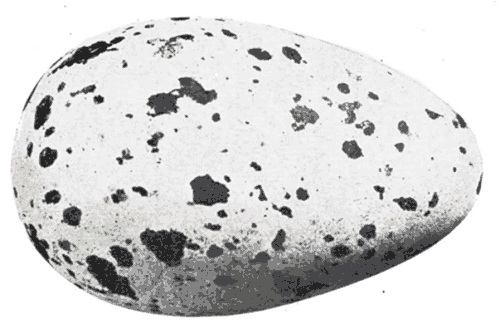
Grayish white.
The Razor-billed Auk is in form similar to the Murres, but the bill is very
different, being deep and thin, and with the upper mandible rounded at the
tip. Entire upper parts black shading to brownish on the throat. Under parts
and tips of secondaries, white; line from eye to bill and another across the
middle of the bill, white. They nest in large numbers on Bird Rock in company
with the Murres and in still greater numbers off the coast of Labrador.
Their eggs are not placed in as exposed positions as the Murres, being generally
behind boulders or in crevices. This is necessary because, not being
of the pear-shaped form of the Murres, they would be very apt to be dislodged
if commonly placed on the narrow ledges. The eggs vary endlessly in marking
but do not show the differences in ground color that the Murres do. The
color is white, grayish or buffy. But one egg is generally laid, although two
are sometimes found. Size 3.00 × 2.00. Data.--Bay of Fundy. June 17, 1891.
Single egg laid on bare rock in a crevice under loose rocks. Collector, A. C.
Bent.
|

|
Page 32

|
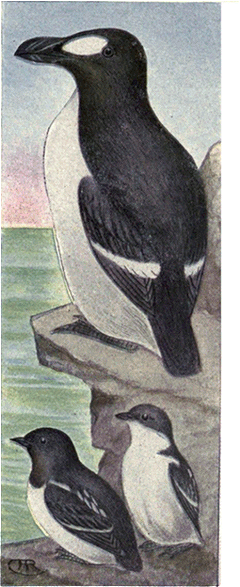
Great Auk Dovekie. 33. Great Auk. Plautus impennis.
Range.--Formerly the whole of the North Atlantic
coasts. Now extinct.
These great auks formerly dwelt in large numbers
on the islands of the North Atlantic, but
owing to their lack of the powers of flight and
the destructiveness of mankind, the living bird
has disappeared from the face of the earth.
Although they were about thirty inches in length,
their wings were even smaller than those of the
Razor-billed Auk, a bird only eighteen inches in
length. Although breeding off the coast of Newfoundland,
they appeared winters as far south as
Virginia, performing their migration by swimming
alone. The last bird appears to have been
taken in 1844, and Funk Island, off the coast of
Newfoundland, marks the place of their disappearance
from our shores. There are about seventy
known specimens of the bird preserved, and
about the same number of eggs. The immediate
cause of the extinction of these birds was their
destruction for food by fishermen and immigrants,
and later for the use of their feathers commercially.
The single egg that they laid was about 5.00 x 3.00
inches, the ground color was buffy white, and the spots brownish and blackish.
The markings varied in endless pattern as do those of the smaller Auk.
There are but two real eggs (plaster casts in imitation of the Auks eggs are
to be found in many collections) in collections in this country, one in the
Academy of Natural Science, Philadelphia, and the other in the National
Museum, at Washington. Through the kindness of Mr. Witmer Stone, of the
Academy of Natural Science, we are enabled to show a full-sized reproduction
from a photograph of the egg in their collection.

|
|
|
Page 33
|
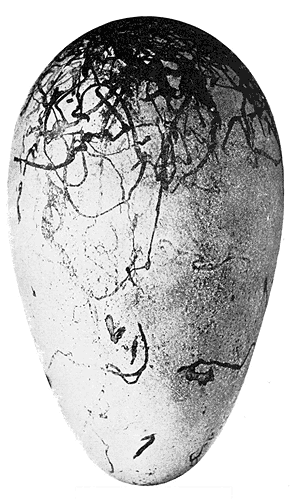
EGG OF THE GREAT AUK.
Photographed from the specimen in the Academy of Natural Science, Philadelphia;
not more than ten or twelve of these eggs are in this country;
the one figured is one of the best marked specimens.
|

|
Page 34

|
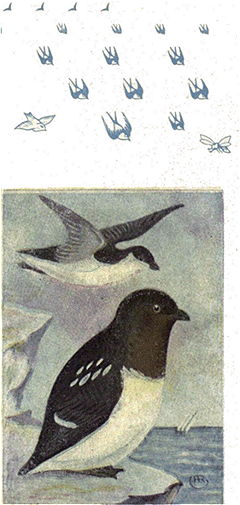
Dovekie. 34. Dovekie. Alle alle.
Range.--Coasts and islands of the North Atlantic
and East Arctic oceans, breeding in the
Arctic regions and wintering as far south as the
Middle States. The little Dovekie or Sea Dove is
the smallest member of the family, being only 8
inches in length, and is the only member of the
sub-family allinæ.
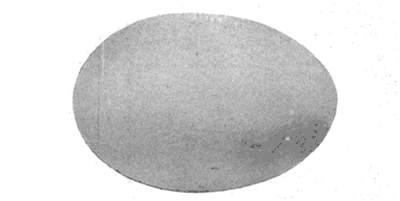
Pale greenish blue. The form is very robust and
the bill is short and stout. In summer the plumage
is black above; the throat and upper breast
are sooty brown, and the under parts are white,
as are also the tips of the secondaries and edges
of the scapulars. They nest in large numbers
on the Rocky cliffs of islands in the East Arctic.
Their single pale greenish blue egg is placed in
a crevice of the rocks. Size 1.80 × 1.25. Data.--Greenland,
June 8, 1893. Single egg laid in a
crevice of a sea cliff.

MURRE--White, buff, or deep greenish blue.
|
|
Page 35
LONG-WINGED SWIMMERS. Order II. LONGIPENNES
SKUA AND JAEGERS. Family STERCORARIIDAE
|
|
Skuas and Jægers are birds having a Gull or Tern-like form and with a hooked
bill, the base of which is covered with a scaly shield. They have webbed
feet and are able to swim and dive, but they commonly get their living by
preying upon the Gulls and Terns, overtaking them by their superior speed
and by their strength and ferocity forcing them to relinquish their food. The
Jægers especially are one of the swiftest and most graceful birds that fly.
|
|
Page 36

|
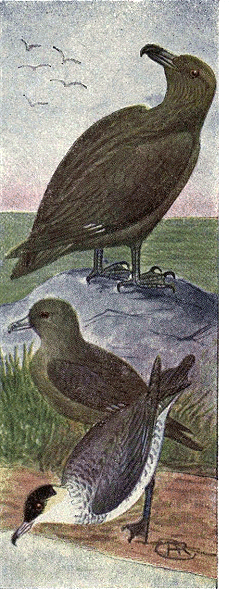
Skua.
Pomarine Jæger. 35. Skua. Megalestris skua.
Range.--Coasts and islands of the North Atlantic,
chiefly on the European side; rare on the
Atlantic coast of North America.
Skuas are large (22 inches in length) and very
powerfully built birds, having the general form
of a Gull.
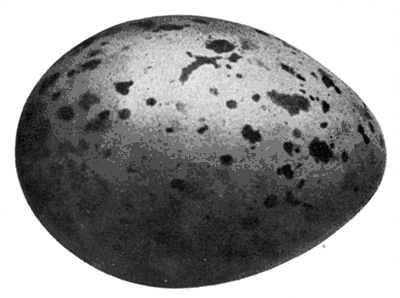
Olive brown. Their whole plumage is a dingy brownish
black color, palest below. Breeds in Iceland
and possibly on some of the islands in Hudson
Strait. The nest is a hollow on the ground in
the marsh grass and is lined with grass. The
two eggs which they lay have an olive greenish
ground, spotted with dark brown. Size 2.75 × 1.90.
36. Pomarine Jaeger. Stercorarius pomarinus.
Range.--Northern Hemisphere, breeding within the Arctic Circle, more
commonly in the Old World.
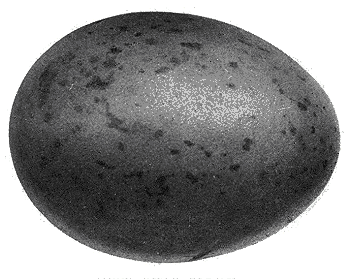
Deep olive brown. In the breeding plumage, this
Jæger has the crown and face
blackish; back and sides of head,
throat and under parts pure white,
except the pointed stiffened feathers
of the neck which are yellow.
Back, wings and tail blackish, the
latter with the two middle feathers
lengthened about four inches
beyond the rest of the tail, and
broad to the tips, which are twisted
so that the feathers are vertical.
They breed throughout the
Arctic regions, but not as commonly
in America as the following
species. The nest is on the ground
in the marsh grass and is made of
grass and moss. They lay two and rarely three eggs of an olive brown or
greenish color. These are spotted with brown and black. Size 2.20 × 1.70.
|
|
|
Page 37
|

Parastic Jæger.
Long-tailed Jæger. 37. Parasitic Jaeger. Stercorarius parasiticus.
Range.--Northern Hemisphere, wintering south
to South America.
The Parasitic Jæger is very similar to the
Pomarine except that the central tail feathers
are pointed and are straight instead of twisted.
It is an abundant bird in Alaska, breeding from
the Aleutian Chain northward.
They locate their nests in the highest parts
of marshy places, the nest itself being only a depression
in the ground lined with grass and moss.
The two eggs have an olive greenish or brownish
ground and are marked with various shades of
brown and black. Size 2.15 × 1.65.

Brownish. 38. Long-tailed Jaeger. Stercorarius longicaudus.
Range.--Arctic America; south in winter to
South America.
The long-tailed Jæger is, according to length,
the largest of the Jægers, being 21 in. long; this is, however, due to the long
sharp pointed central pair of tail feathers, which extend about eight inches
beyond the others, and from the most noticeable distinguishing point from
the former species. The plumages that have been described are the light
phases; all the Jægers have a dark
phase in which the plumage is a nearly
uniform sooty brown, lightest below.
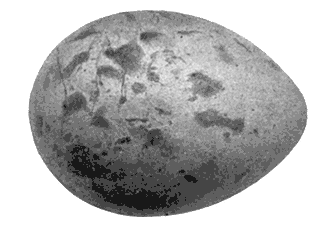
Olive brown. The Long-tailed Jægers are the
most numerous in Alaska and are
even more graceful in flight than are
the Gulls and Terns, floating, skimming,
sailing, plunging, and darting
about with incredible swiftness and
ease. Like the others of this family,
they pilfer their food from the Gulls,
and are also very destructive to young
birds and eggs. Their eggs are either
laid on the bare ground or in a
slight depression, scantily lined with
grasses. The eggs are indistinguishable from those of the preceding species
except that they average a trifle smaller. Size 2.10 × 1.50.
|

|
Page 38

|
GULLS and TERNS. Family LARIDÆ
Gulls are webbed footed birds having a slight hook to the end of the upper
mandible. Their plumage is generally a silvery gray above and white below.
They nest in large colonies, some on the islands of fresh water inland, but
mostly on the sea coast. They procure their food from the surface of the
water, it consisting mostly of dead fish and refuse matter, and crustacea which
they gather from the waters edge. When tired they rest upon the surface of
the water, where they ride the largest waves in perfect safety.
Terns are birds of similar plumage to the Gulls, but their forms are less robust
and the bills are generally longer and sharply pointed. Their food consists
chiefly of small fish which they secure by hovering above the water, and
then plunging upon them. They are less often seen on the surface of the
water than are the Gulls.
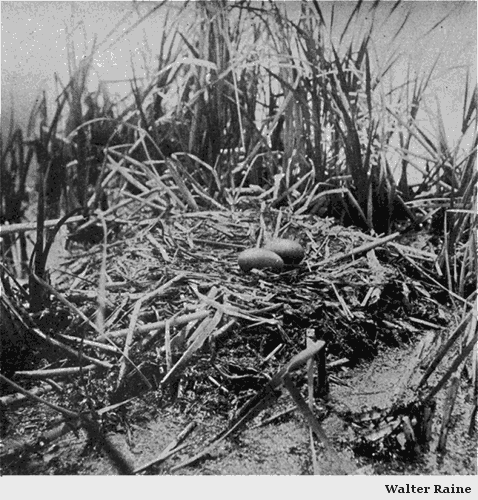
CHARACTERISTIC NEST OF A LOON.
|
|
|
Page 39
|

Ivory Gull.
Kittiwake. 39. Ivory Gull. Pagophila alba.
Range.--Arctic regions; south in winter to the
northern border of the United States.
The little Snow Gull, as it is often called, is
eighteen inches in length. In the breeding season
the plumage is entirely white; the bill is tipped
with yellow and there is a red ring around
the eye. These Gulls nest in large colonies in
the Arctic Regions, placing their nests on the
high rocky cliffs. The nest is made of grass,
moss and rubbish, and the three eggs are laid
during June. The eggs are olive color and the
markings are dark brown.
40. Kittiwake. Rissa tridactyla trydactyla.
Range.--North Atlantic and Arctic regions,
breeding from the Gulf of the St. Lawrence northward
and wintering south to the Great Lakes and
Long Island.
The Kittiwake is sixteen inches in length, has
a pearly gray mantle, black tips to the primaries,
and remainder of plumage white. Its hind toe
is very small being apparently wanting in the
eastern form, while in the Pacific it is more developed.
These are very noisy Gulls, their notes
resembling a repetition of their name. They are
very common in the far north, placing nests on
the ledges of high rocky cliffs, often in company
with Murres and Auks.
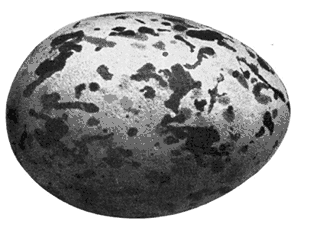
White. They gather together a
pile of sticks, grass and moss, making the interior
cup-shaped so as to hold their two or three
eggs. Large numbers of them breed on Bird
Rock, they occupying certain
ledges while the Gannets and
Murres, which also breed there,
also have distinct ledges on
which to make their homes.
The breeding season is at its
height during June. The eggs
are buffy or brownish gray and
are spotted with different shades
of brown. Size 2.25 × 1.60. Data.--So.
Labrador, June 15, 1884.
Three eggs. Nest made of seaweed
and moss, placed on ledge
of cliff. Many Murres nesting
on other ledges.
|

|
Page 40

|

Red-legged Kittiwake.
Glaucus Gull. 40a. Pacific Kittiwake. Rissa tridactyla pollicaris.
Range.--Coast of the North Pacific, wintering
south to California.
The Pacific Kittiwake breeds in immense rookeries
on some of the islands in Bering Sea. They
are well distributed over Copper Island where
they nest in June and July, choosing the high
ledges which overhang the sea. The nesting
habits and eggs are precisely the same as those
of the common Kittiwake.
41. Red-legged Kittiwake. Rissa brevirostris.
Range.--Northwestern coasts, breeding in high
latitudes.
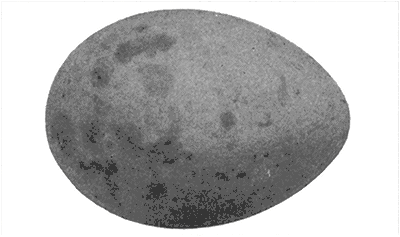
Brownish buff. This Kittiwake is similar to the preceding, with
the exception that the legs are bright red, the
mantle is darker, and the bill is shorter. This
species was found by Dr. Leonard Stejneger to be
a very abundant nesting bird on islands in Bering
Sea, selecting steep and inaccessible rocks and ledges on which to build
its nest. Their nesting habits are precisely the same as the Pacific Kittiwake,
but they most often nest in separate colonies, but can be distinguished readily
when nesting together by the darker mantles when on the nest and the red
legs when flying. Grass, moss and mud are used in the nest. The ground color
of the eggs is buffy or brownish, and the spots are dark brown and lilac.
Size 2.15 × 1.50.
42. Glaucous Gull. Larus hyperboreus.
Range.--Arctic regions, south in winter to Long Island, the Great Lakes, and
San Francisco Bay.
This Gull shares with the Great Black-backed Gull the honor of being
the largest of the Gulls, being 28 inches in length. Mantle light gray; it is
distinguished by its size and the primaries, which are white to the tips. A
powerful bird that preys upon the smaller Gulls and also devours the young
and eggs of smaller birds.
They nest on the ground on the islands and shores of Hudson Bay, Greenland,
etc. The nest is made of seaweed, grass and moss and is generally quite
bulky. The two or three eggs are laid in June. They are of various shades of
color from a light drab to a brownish, and are spotted with brownish and
black. Size about 3.00 × 2.20.
|
|
|
Page 41
|
42.1. Point Barrow Gull. Larus barrovianus.
Range.--Northwest coast from Bering Sea to Point Barrow.
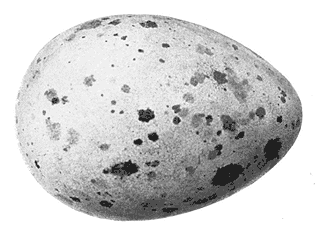
White. This species is almost
identical with the Glaucus
Gull, averaging perhaps
a trifle smaller.
Its standing as a distinct
species is still
questioned and has not
yet been decided satisfactorily.
Early in June
their nests are built on
remote islands in Bering
Sea. These nests
are the same as the last
species, large piles of
vegetation, hollowed on
top for the reception of
the eggs. The eggs
have the same variations
in color and markings
as the Glaucus
Gull. Size 3.00 × 2.10.
Data.--Herschel Is.,
Alaska, July 1, 1900. Nest made of seaweed and grass; placed on the ground.
Three eggs. Collector, Rev. I. O. Stringer.
13. Iceland Gull. Larus leucopterus.
Range.--Arctic regions, south in winter to the Middle States.
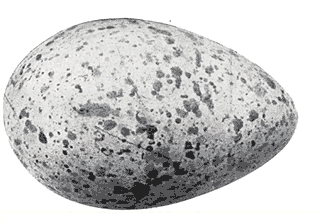
Greenish brown. This Gull in appearance is precisely like the two preceding ones but is considerably
smaller; 24 inches in length. A very common bird in the north,
breeding in colonies of thousands on many of the islands. It is regarded as
one of the most common
of the larger Gulls in Bering
Sea and also nests
commonly in Hudson Bay
and Greenland, as well as
in the Eastern Hemisphere.
They nest indifferently
on high rocky cliffs or
on low sandy islands. Except
when the eggs are laid
in a sandy depression in
the soil, quite bulky nests
are made of seaweed and
moss. The eggs are laid
about the first of June;
they number two to three
and have a ground color
of brownish or greenish brown and are blotched with umber. Size 2.80 × 1.83.
Data.--Mackenzie Bay, Arctic America. June 18, 1899. Nest made of seaweed
and grass on an island in the bay.
|

|
Page 42

|
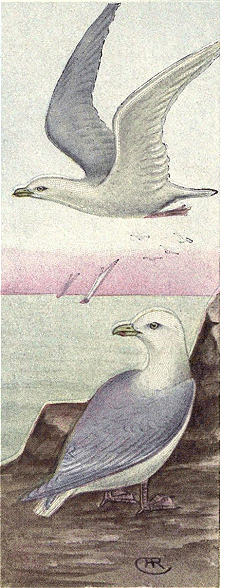
Iceland Gull.
Glaucous-winged Gull. 44. Glaucous-winged Gull. Larus glaucescens.
Range.--North Pacific coast, breeding from
British Columbia northwards and wintering from
the same country to southern California.
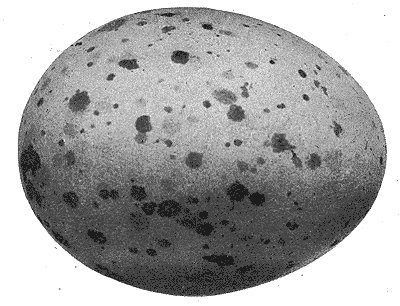
Pale greenish brown. This Gull is very like the preceding except
that the primaries are the same color as the
mantle, and are tipped with white. Length about
27 inches. Not so northerly distributed a bird
as the previous ones, and consequently better
known. They breed in large numbers both on
the high rocky cliffs of the islands along the
coast and on the low sandy islands of the Aleutian
Chain. On Copper Island they breed on the
inaccessible cliffs overhanging the water. As in
the case of the Iceland Gull, when the nests are
on the cliffs, a large nest of seaweed is made,
whereas if they are on the ground, especially in
sandy places no attempt is made at nest-building. The eggs have a greenish
brown ground color and dark brown spots. Size 2.75 × 2.05. Data.--West Coast
of Vancouver Island. June 20, 1896. Three eggs; nest made of seaweed.
Located on a low ledge. Collector, Dr. Newcombe.
45. Kumlien's Gull. Larus Kumlieni.
Range.--North Atlantic coast, breeding in Cumberland Sound and wintering
as far south as Long Island.
This bird differs from the Glaucous-winged only in the pattern of the gray
markings of the primaries and in having a little lighter mantle. It is quite
common in its breeding haunts where it places its nest high up on the ledges
of the cliffs. The eggs are not different apparently from glaucescens.
46. Nelson's Gull. Larus nelsoni.
Range.--Coast of Alaska.
Plumage exactly like that of Kumlien Gull and questionably a new species.
The nests and eggs are not to be distinguished from the preceding.
|
|
|
Page 43
|
47. Great- Black-Backed Gull.Larus marinus.
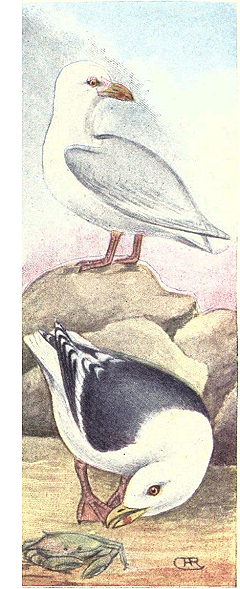
Great Black-Backed Gull.
Kumlien's Gull. Range.--North Atlantic on both the American
and European sides; breeds from Nova Scotia
northward and winters south to the Great Lakes
and the Middle States.
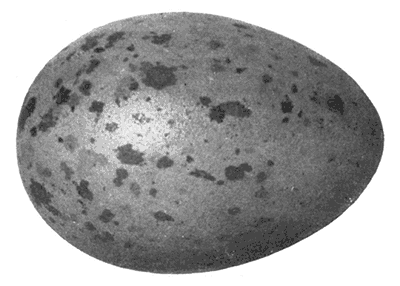
Grayish buff. The largest of the Gulls (thirty inches long)
and unlike any other. The mantle is dark slaty
black, and the primaries are black with white
tips. The bill is very large and powerful and
quite strongly hooked. They are quite abundant
birds in their range, and are very quarrelsome,
both among themselves and other species. They
do not breed in as large colonies as do the other
Gulls, half a dozen pairs appropriating a small
island to the exclusion of all other birds. They
are very rapacious birds and live to a great extent,
especially during the breeding season, upon the eggs and young of other
birds such as Ducks, Murres and smaller Gulls. They place their nests upon
the higher portions of sandy islands. They are made of grasses and seaweed.
The three eggs are laid early in June; they are grayish or brownish, spotted
with brown and lilac. Size 3.00 × 2.15. Data.--South Labrador, June 21, 1884.
Three eggs. Nest on a small island off the coast; of grasses and moss.
48. Slaty-backed Gull.--Larus schistisagus.
Range.--North Pacific and Arctic Oceans.
This Gull, which is similar to the Great Black-backed, but is smaller and has
a lighter mantle, does not breed in any considerable numbers on the American
side of the Pacific. It nests in June on some of the islands in Bering Sea
and probably more commonly farther north. They often nest in company with
other species, placing their small mounds of seaweed on the ground on the
higher parts of the islands. The full set contains three eggs of grayish or
brownish color, spotted with dark brown or black. Size 2.90 × 2.00. Data.--Harrowby
Bay, N. W. T. Canada, June 11, 1901. Nest of grass, roots and mud and
lined with dry grass; on point making into the bay. Collector, Capt. H. H.
Bodfish.
|

|
|
Page 44

|
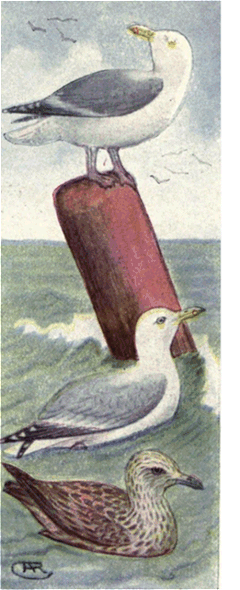
Western Gull.
Herring Gull. 49. Western Gull. Larus occidentalis.
Range.--Pacific Coast, breeding from southern
California to British Columbia.
This bird, which is the most southerly distributed
of the larger Gulls is twenty-four inches in
length. Mantle slate colored; primaries black,
both these and the secondaries being broadly
tipped with white. These Gulls nest abundantly
on the Farallones, the majority of them showing
a preference for the lower portions of the island,
although they nest on the ledges also. Besides
man, these Gulls are the greatest enemies that
the Murres have to content against. They are
always on the watch and if a Murre leaves its
nest, one of the Gulls is nearly always ready to
pounce upon the egg and carry it away bodily in
his bill. The Gulls too suffer when the eggers
come, for their eggs are gathered up with the
Murres for the markets. They make their nests
of weeds and grass, and during May and June
lay three eggs showing the usual variations of
color common to the Gulls eggs. Size 2.75 × 1.90.
50. Siberian Gull. Larus affinis.
This bird does not nest in North America, and
has a place on our list, by its accidental occurrence
in Greenland. It is an Old World species
and its nesting habits and eggs are like those of
the Herring Gull.
51. Herring Gull. Larus argentatus.
Range.--Whole of the Northern Hemisphere,
breeding from Maine and British Columbia northward
and wintering south to the Gulf.
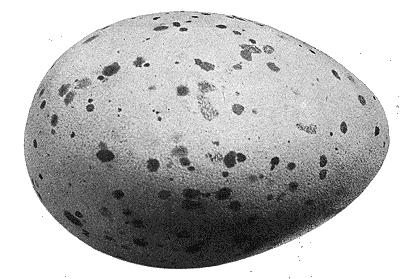
Buff. This Gull, which formerly was No. 51a, a subspecies
of the European variety, is now regarded
as identical with it, and is no longer a sub-species.
It is twenty-four inches in length, has a light gray mantle and black primaries
which are tipped with
white. The Herring
Gulls nest in colonies
in favorable localities
throughout their range,
chiefly on the coasts
and islands. A few pairs
also nest on islands in
some of the inland
bodies of fresh water.
Except in places where
they are continually
molested, when they
will build in trees, they
place their nests on the
ground either making
no nest on the bare
sand, or building a
bulky nest of seaweed
in the grass on higher
parts of the island.
They lay three eggs of
a grayish color marked with brown. In rare cases unspotted bluish white
eggs are found. Size 2.80 × 1.70.
|
|
|
Page 45
|
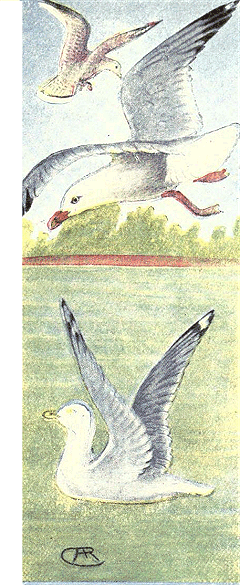
Ring-billed Gull.
California Gull. 52. Vega Gull. Larus vegae.
Range.--Coast of Alaska, south in winter to
California.
Similar to the Herring Gull, but with the mantle
darker, but not so dark as in the Western Gull.
The nesting habits and eggs are the same as
those of the Herring Gull, except that in a series,
the eggs of the Vega will average a little
darker in ground color. It nests during May on
the coasts and islands of Bering Sea, placing its
eggs in a hollow on the ground. Size 2.75 × 1.65.
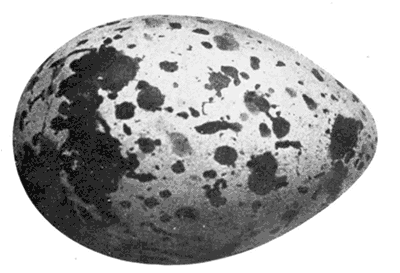
Grayish brown. 53. California Gull. Larus californicus.
Range.--Western North America, breeding in
the interior.
A smaller Gull than the Herring with the primaries
grayish instead of black; length twenty-five inches. This Gull is found
in winter on the coast from British Columbia southward to Lower California,
but nests in the interior from Utah northward. They nest very abundantly
around the Great Salt Lake, placing their nests generally upon the bare ground.
Sometimes there is a scant lining of grasses or weeds and again the nests will
be situated in the midst of a tussock of grass. Three or four eggs generally
constitute a set, but occasionally five are laid. The usual nesting time is during
May. They show the same great variations in color and markings common
to most of the Gulls. Size 2.60 × 1.80.
54. Ring-billed Gull. Larus delawarenis.
Range.--Whole of North America, breeding from the United States northward
and wintering south to the Gulf States.
A small Gull, eighteen inches in length, with a light gray mantle, black
primaries with white tips, and always to be distinguished in the breeding season
by the black band around the middle of the greenish yellow bill. They
nest in enormous colonies on islands in the interior of the country and in
smaller colonies on the coasts. Thousands of them breed on the lakes of the
Dakotas and northward. The majority of them nest on the ground, although
on the coast they are often found on the cliffs. They commonly lay three eggs
placing them in a slight hollow in the ground, generally on the grassy portions
of the islands. The color varies from grayish to brownish, marked with
brown and lilac. The height of the nesting season is in June. Size of eggs,
2.80 × 1.75.
|

|
Page 46

|
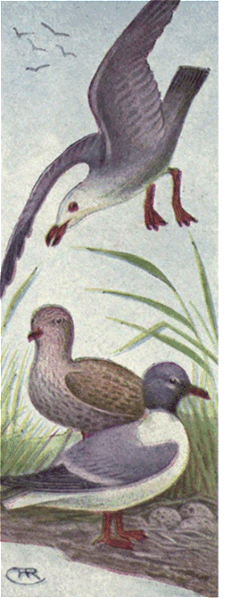
Short-billed Gull.
Heerman's Gull. 55. Short-billed Gull. Larus brachyrhynchus.
Range.--Breeds from the interior of British
Columbia northward to Alaska; south in winter to
Lower California.
The Short-billed or American Mew Gull is seventeen
inches in length, has a short, stout bill and
is otherwise similar to the preceding species.
Nests on islands in the lakes and along the river
banks of Alaska. The nest is made of grass,
weeds and moss and is placed on the ground.
Early in June the birds lay their set of three eggs,
the ground color of which is greenish brown marked
with dark brown. Size 2.25 × 1.60. Data.--Mackenzie
River, N. W. T., June 18, 1900. Three
eggs. Nest made of seaweed and grass and placed
on the ground on an island in the river.
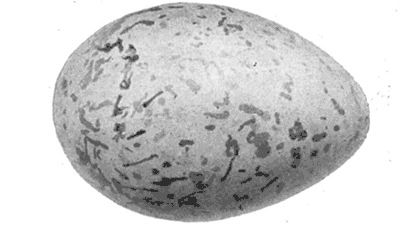
Pale greenish-brown. 56. Mew Gull. Larus canus.
This is the European variety of the above species,
breeding commonly both in the British Isles
and northern Europe. This species is given a place in our avifauna because
of its accidental appearance in Labrador.
57. Heerman's Gull. Larus heermanni.
Range.--Pacific Coast of North America from British Columbia south to
Panama, breeding chiefly south of the United States border.
A very handsome species, often called the White-headed Gull, and wholly
unlike any other; length seventeen inches. Adults, in summer, have the
entire head, neck and throat white, this shading quite abruptly into the slaty
upper and under parts; the primaries and tail are black, the latter and the
secondaries being tipped with white. The legs and bill are vermilion. They
are found off the coast of California, but are not believed to breed there.
They are known to breed on some of the islands off the Mexican coast nesting
on the ground the same as the other species. The three eggs are greenish
drab in color and are marked with different shades of brown and lilac. Size
2.45 × 1.50.
|
|
|
Page 47
|
58. Laughing Gull. Larus atricilla.
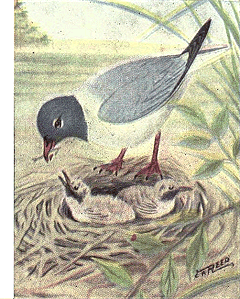
Laughing Gull. Range.--Eastern North America, breeding
from the Gulf to Nova Scotia, chiefly on the
coast. A beautiful Gull, 16 inches long, with
a dark slate colored head, gray mantle, black
primaries, and white neck, underparts and tail. Bill and feet red.
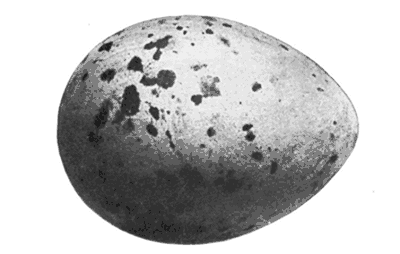
Pale grayish brown. 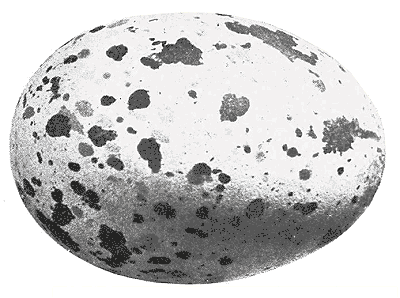
RING-BILLED GULL--Gray. This bird
has its name from its peculiar laughing cry when alarmed or angry; it is
also called the Black-headed Gull.
They nest by thousands on the islands off
the Gulf Coast and along the South
Atlantic States. The nest is placed
on the ground and is made of seaweed.
Three, four and sometimes
five eggs are laid, of a grayish to
greenish brown color, marked with
brown and lilac. Size 2.25 × 1.60.
Data.--Timbalin Is., La., June 3,
1896. Three eggs. Nest of drift
grass thrown in a pile about 8
inches high, slightly hollowed on
top, in low marsh back of beach.
Collector, E. A. McIlhenny.
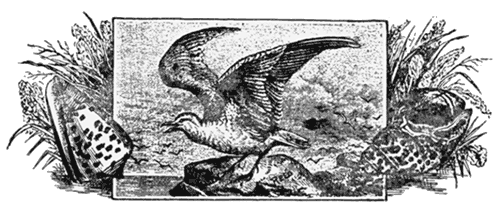
|

|
Page 48

|
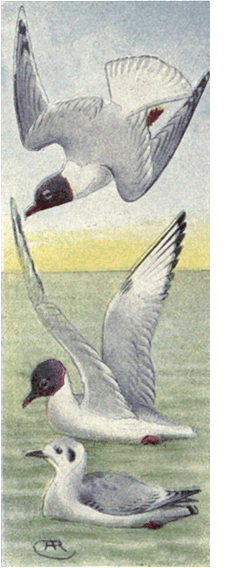
Franklin's Gull.
Bonaparte's Gull. 59. Franklin's Gull. Larus franklini.
Range.--Interior North America, breeding from
middle United States northward.
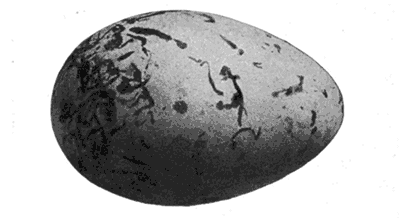
Grayish brown. Like the last but smaller and with the primaries
light. Underparts rosy in breeding season.
Nests very abundantly in the marshes of Minnesota
and northward. Nest made of grasses and
placed in the marsh grass barely above the surface
of the water. Eggs same color as the last
but the markings more inclined to zigzag lines.
Size 2.10 × 1.40. Data.--Heron Lake, Minn., May
26, 1885. Nest of wet sedge stalks and rubbish
placed in a bunch of standing sedge in shallow
water; at least five thousand birds in rookery.
Collector, J. W. Preston.
60. Bonaparte's Gull. Larus philadelphia.
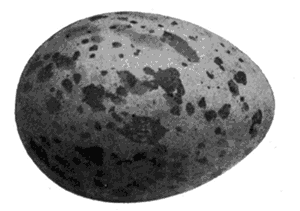
Pale grayish brown. Range.--Breeds in the northern parts of North America; winters from Maine
and British Columbia to the southern border of the United States.
Smaller than the last; 14 inches long.
Plumage similar, but bill slender and
black. They nest in great numbers on
the marshes of Manitoba and to the
northward. The nests, of sticks and
grass, are placed on the higher parts of
the marsh and the usual complement of
three eggs is laid during the latter part
of June. The eggs are grayish to greenish
brown, marked with dark brown and
lilac. Size 1.90 × 1.30.
|
|
|
Page 49
|
60.1. Little Gull. Larus minutus.
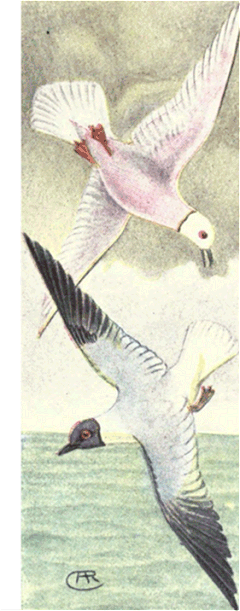
Rose Gull.
Sabine Gull. This Gull is the smallest of the family; it is
a European bird, and has accidentally strayed to
our shores but a few times. Its plumage is similar
to that of the Bonaparte Gull but the bill is
red. It breeds in the marshes around the Baltic
Sea, placing its nest of dead vegetation on the
highest parts of the marsh. They lay three eggs
of a greenish gray color marked with dark brown
and lilac. Size 1.75 × 1.25.
61. Roses Gull. Rhodostethia rosea.
Range.--The Arctic regions, south in winter
to Alaska, Greenland, northern Europe and Asia.
This beautiful bird is the most rare of all the
Gulls, being very difficult to obtain because of
its extreme northerly distribution. It is in form
and plumage like Bonaparte Gull, with the exceptions
that the head is white, there being a narrow
black collar around the neck, the tail is
wedge shaped, and the whole under parts from
the chin to the tail are rosy in the breeding plumage.
The nests and eggs remain still undiscovered,
although Nansen, in August 1896, found a
supposed breeding ground in Franz Josef Land,
because of the numbers of the birds, but found
no nests.
62. Sabine's Gull. Xema sabinii.
Range.--Arctic regions, breeding from Alaska
and Greenland and northward, and wintering
south to New England.
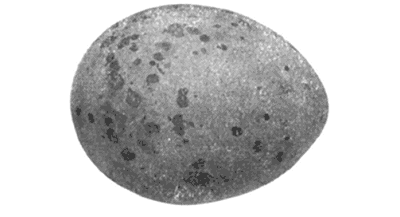
Greenish brown. A handsome bird, having the slaty hood
bordered behind with a black ring, the primaries
black, white tipped, and the tail slightly
forked. They breed abundantly on the marshes
of northern Alaska and Greenland, nesting the
same as others of the species. The two or
three eggs are laid in June. They are greenish
brown in color and are marked with dark
brown. Size 1.75 × 1.25. Data.--Hudson Bay,
August 1, 1894. Eggs laid on the ground in
the moss; no nest except the hollow in the
moss.

|

|
Page 50

|
63. Gull-billed Tern. Gelochelidon nilotica.
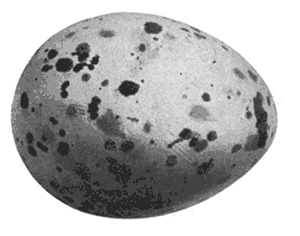
Pale greenish buff. Range.--Found in North America along the Gulf Coast and on the Atlantic
Coast north to Virginia and casually farther.
This is one of the largest of the Terns,
is 14 inches long, has a short, thick, black
bill and a short slightly forked tail; the
crown is black, mantle pearly gray, white
below. This species is very widely distributed,
being found in Europe, Australia,
Asia and Africa. They are known
locally as "Marsh Terns" where they
breed in immense numbers on some of
the marshes about the Gulf, particularly
in Texas. They also breed on many of
the islands along the Coast, rarely making
any nest, but laying the eggs in a
hollow in the sand. They nest most
abundantly in the latter part of May,
generally laying three eggs. They are
of a yellowish, grayish or greenish buff
color and are spotted with brown and lilac. Size 1.80 × 1.30. Data.--Northampton
Co., Va., May 28, 1882. Three eggs laid on a mass of seaweed on marsh
above tide water.
64. Caspian Tern. Sterna caspia.
Range.--Like the preceding species, this bird is nearly cosmopolitan in its
range, in North America breeding from the Gulf Coast and Texas northward
to the Arctic Regions.
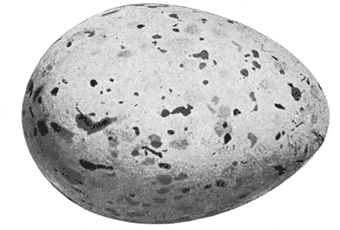
Grayish buff. This beautiful bird is the largest of the Tern family, being about 22 inches in
length, with the tail forked about 1.5 inches. The bill is large, heavy and
bright red; the crest, with which this and the next three species are adorned,
is black. The mantle is pale
pearl and the under parts
white. These Terns sometimes
nest in large colonies
and then again only a few
pairs will be found on an
island. In Texas, the breeding
season commences in
May, it being later in the
more northern breeding
grounds. They may be regarded
as largely eastern
birds, as while they are common
in the interior of the
country, they are rarely found
on the Pacific Coast. Two or
three eggs constitute a complete
set; these are laid on
the sand in a slight hollow scooped out by the birds. They vary from gray to
greenish buff, marked with brown and lilac. Size 2.60 × 1.75. Data.--Hat Island,
Lake Michigan, July 1, 1896. No nest. Two eggs in a hollow in the
gravel. Fully a thousand terns nesting on about one acre. Collector, Charles
L. Cass.
|
|
|
Page 51
|
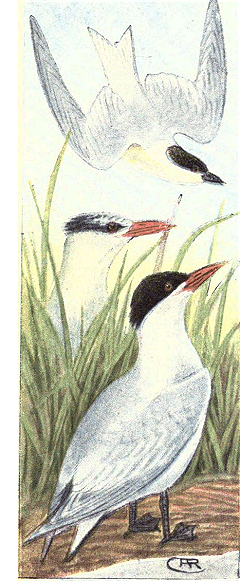
Gull-billed Tern.
Caspian Tern.
Royal Tern. 65. Royal Tern. Sterna maxima.
Range.--Temperate North and South America,
breeding in the United States locally from Texas
and the Gulf States northward to the northern
boundary of the United States.
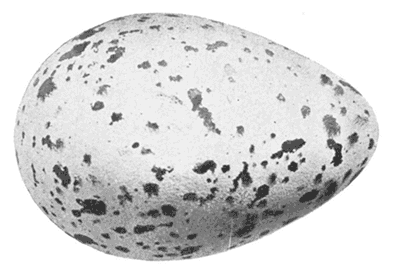
Grayish buff. The Royal Terns nest in great numbers on the
coasts and islands on the South Atlantic and
Gulf States and in the marshes of southern Texas.
Like the former species they lay two or three
eggs in a hollow on the bare sand. The eggs are
the same size but differ in being more pointed
and having a lighter ground and with the markings
more bold and distinct. Size 2.60 × 1.70.
66. Elegant Tern. Sterna elegans.
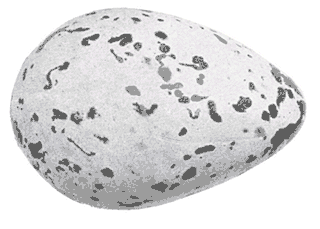
Cream color. Range.--Pacific Coast of South and Central
America; north to California in summer.
A similar bird to the Royal Tern, but easily
distinguished by its smaller size,
slender bill, and more graceful
form. In the breeding plumage
the under parts of these Terns
are tinged with rosy, which
probably first gave the birds
their name. They breed on the
coasts and islands of Mexico and
Central America, placing their
eggs on the sand. They are believed
to lay but a single egg,
like that of the Royal Tern, but
smaller. Size 2.40 × 1.40. Data.--Honduras,
Central America,
June 5, 1899. Single egg laid on
the sandy beach.
|

|
Page 52

|
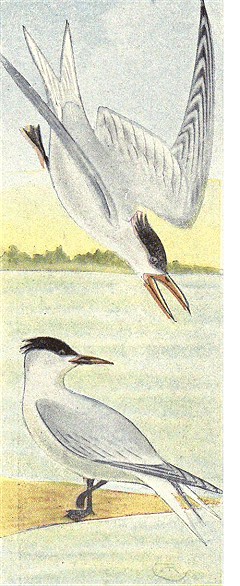
Elegant Tern.
Cabot's Tern. 67. Cabot Tern. Sterna sandvicensis acuflavida.
Range.--A tropical species breeding regularly
north to the Bahamas and Florida; casually
farther north.
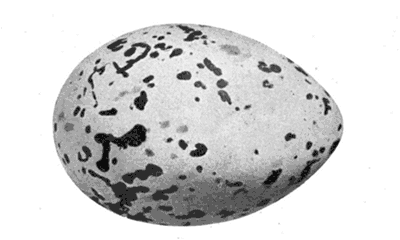
Cream color. A beautiful bird distinguished
from the three preceding ones by its smaller size
(sixteen inches) and by the bill which is black
with a yellow tip. They nest in colonies on the
shores of islands in the West Indies and Bahamas,
but not to a great extent on the United States
Coast. Their two or three eggs have a creamy
ground color, and are boldly marked with brown
and black. Size 2.10 × 1.40.
68. Trudeau's Tern. Sterna trudeaui.
Range.--South America; accidentally along the coast of the United States.
A rare and unique species with a form similar to the following, but with the
coloration entirely different. About fifteen inches in length; tail long and
deeply forked; bill yellow with a band of black about the middle. Whole head
pure white, shading into the pearly color of the upper and under parts. A
narrow band of black through the eye and over the ear coverts. A very rare
species that is supposed to breed in southern South America. Given a place
among North American birds on the strength of a specimen seen by Audubon
off Long Island.
|
|
|
Page 53
|
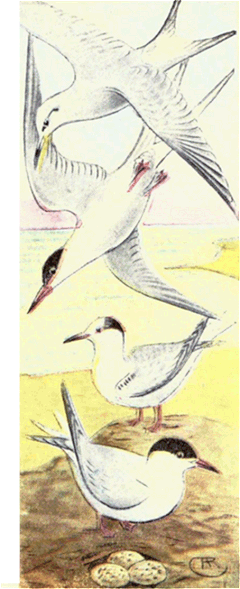
Forsters Tern.
Common Tern. 69. Forster's Tern. Sterna forsteri.
Range.--Temperate North America, breeding
from Manitoba, Mass., and California, south to
the Gulf Coast and Texas.
Length about fifteen inches; tail long and deeply
forked; crown black, back and wings pearl and
under parts white. Bill orange red. This species
and the three following are the most graceful
of birds in appearance and flight. Their movements
can only be likened to those of the Swallows,
from which they get the name of "Sea Swallows."
Their food consists of fish, which they
get by diving, and marine insects. They breed by
thousands in the marshes from Manitoba to Texas
and along the South Atlantic coast. The eggs are
laid in a hollow on the dry grassy portions of the
islands or marshes. They generally lay three
eggs and rarely four. They are buffy or brownish
spotted with dark brown and lilac. Size 1.80 × 1.30.
Data.--Cobb's Island, Va., June 8, 1887. Eggs in a hollow on grassy
bank. Collector, F. H. Judson.

Brownish buff. 70. Common Tern. Sterna hirundo.
Range.--Eastern North America, breeding both on the coast and in the interior
from the Gulf States northward.
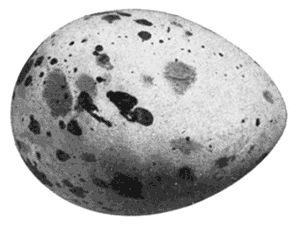
Buff. This bird differs from the preceding chiefly in having a bright red bill tipped
with black, and the under parts washed with pearl. These are the most common
Terns on the New England coast, nesting
abundantly from Virginia to Newfoundland.
These beautiful Terns, together with
others of the family, were formerly killed
by thousands for millinery purposes, but the
practice is now being rapidly stopped. In
May and June they lay their three, or sometimes
four eggs on the ground as do the
other Terns. They are similar to the preceding
species but average shorter. Data.--Duck
Is., Maine, June 30, 1896. Three eggs
in marsh grass about fifty feet from beach.
No nest. Collector, C. A. Reed.
|

|
Page 54

|
71. Arctic Tern. Sterna paradisaea.
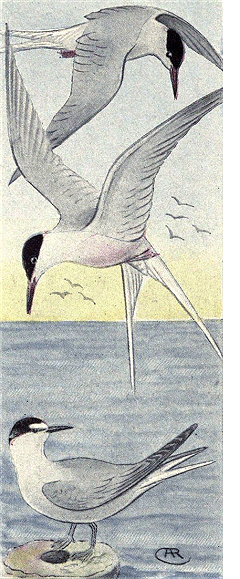
Arctic Tern.
Roseate Tern.
Aleutian Tern. Range.--Northern Hemisphere, breeding from
New England northward to the Arctic Regions
and wintering south to California and the South
Atlantic States. A similar bird to the last, differing
in having the bill wholly red and the feet being
smaller and weak for the size of the bird. A
more northern bird than the last, breeding abundantly
in Alaska, both on the coast and in the interior.
In the southern limits of its breeding
range, it nests in company with the Common
Tern, its nests and eggs being indistinguishable
from the latter. When their nesting grounds are
approached, all the birds arise like a great white
cloud, uttering their harsh, discordant "tearrr,
tearrr," while now and then an individual, bolder
than the rest, will swoop close by with an angry
"crack." On the whole they are timid birds, keeping
well out of reach. The nesting season is
early in June. Eggs like the preceding. Data.--Little
Duck Is., Me., June 29, 1896. Three eggs
in a slight hollow on the beach, three feet above
high water mark.
72. Roseate Tern. Sterna dougalli.
Range.--Temperate North America on the east
coast, breeding from New England to the Gulf.
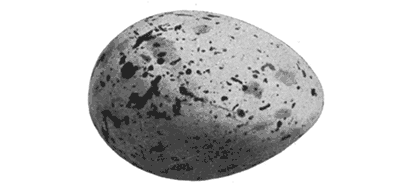
Grayish or Brownish. These are the most beautiful birds, having a
delicate pink blush on the under parts during
the breeding season; the tail is very long and deeply forked, the outer feathers
being over five inches longer than the middle ones; the bill is red with a
black tip. They nest in large colonies on the islands from Southern New England
southward, placing the nests in the short grass, generally without any
lining. They lay two or three eggs which are indistinguishable from the
two preceding species.
73. Aleutian Tern. Sterna aleutica.
Range.--Found in summer in Alaska and the Aleutian Islands.
South in winter to Japan. This handsome Tern is of the form and size
of the Common Tern, but has a darker mantle, and the forehead is white,
leaving a black line from the bill to the eye. They nest on islands off the coast
of Alaska, sometimes together with the Arctic Tern. The eggs are laid upon
the bare ground or moss, and are similar to the Arctic Terns, but average narrower.
They are two or three in number and are laid in June and July. Size
1.70 × 1.15. Data.--Stuart Is., Alaska. Three eggs in a slight hollow in the moss.
|
|
|
Page 55
|
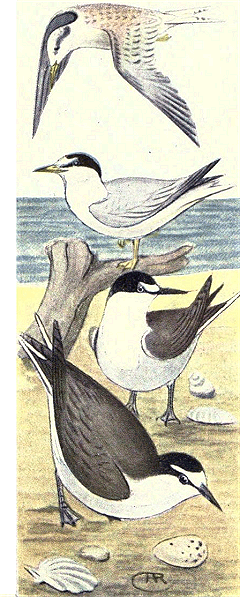
Least Tern.
Sooty Tern. 74. Least Tern. Sterna antillarum.
Range.--From northern South America to
southern New England, Dakota and California,
breeding locally throughout its range.
These little Sea Swallows are the smallest of
the Terns, being but 9 inches in length. They
have a yellow bill with a black tip, a black crown
and nape, and white forehead. Although small,
these little Terns lose none of the grace and beauty
of action of their larger relatives.
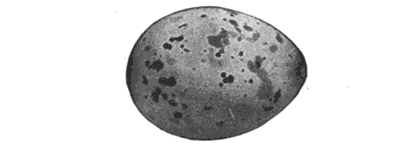
Light buff. They nest
in colonies on the South Atlantic and Gulf Coasts,
placing their eggs upon the bare sand, where they
are sometimes very difficult to see among the
shells and pebbles. They are of a grayish or
buffy color spotted with umber and lilac. They
number two, three and rarely four, and are laid
in May and June. Size 1.25 × .95. Data.--DeSota
Beach, Fla., May 20, 1884. Three eggs laid on
the sandy beach. Collector, Chas. Graham.
75. Sooty Tern. Sterna fuscata.
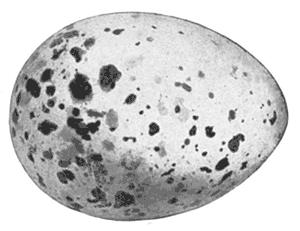
Creamy white. Range.--Tropical America, north to the South
Atlantic States. This species measures 17 inches
in length; it has a brownish black mantle, wings
and tail, except the outer feathers of the latter which are white; the forehead
and under parts are white, the crown and a line from the eye to the bill, black.
This tropical species is very numerous at
its breeding grounds on the small islands
of the Florida Keys and the West Indies.
They lay but a single egg, generally placing
it on the bare ground, or occasionally
building a frail nest of grasses. The egg
has a pinkish white or creamy ground
and is beautifully sprinkled with spots of
reddish brown and lilac. They are laid
during May. Size 2.05 × 1.45. Data.--Clutheria
Key, Bahamas, May 28, 1891.
Single egg laid on bare ground near water.
Collector, D. P. Ingraham.
|

|
Page 56

|

Black Tern.
Noddy.
Black Skimmer. 76. Bridled Tern. Sterna anaetheta.
Range.--Found in tropical regions of both hemispheres;
casual or accidental in Florida. This
Tern is similar to the last except that the nape
is white and the white of the forehead extends
in a line over the eye.

Creamy white. The Bridled Tern is common
on some of the islands of the West Indies
and the Bahamas, nesting in company with the
Sooty Terns and Noddies. The single egg is laid
on the seashore or among the rocks. It is creamy
white beautifully marked with brown and lilac.
Size 1.85 × 1.25. Data.--Bahamas, May 9, 1892.
Single egg laid in a cavity among the rocks. Collector,
D. P. Ingraham.
77. Black Tern. Hydrochelidon nigra surinamensis.
Range.--Temperate America, breeding from the
middle portions of the United States northward
to Alaska; south in winter beyond the United
States Border.
The identity of these Terns cannot be mistaken.
They are but ten inches in length; the whole head, neck and under parts are
black; the back, wings and tail are slaty and the under tail coverts are white.
Their dainty figure with their long slender wings gives them a grace and airiness,
if possible, superior to other species of the family.
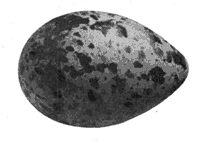
Deep greenish brown. They are very active
and besides feeding upon all manner of marine
crustacea, they capture many insects in the air.
They nest in large colonies in marshes, both along
the coast and in the interior, making a nest of
decayed reeds and grasses, or often laying their
eggs upon rafts of decayed vegetation which are
floating on the water. The nesting season commences
in May, they laying three eggs of a brownish
or greenish color, very heavily blotched with
blackish brown. Size 1.35 × .95. Data.--Winnebago
City, Minn., May 31, 1901. Three eggs. Nest
made of a mass of weeds and rushes floating on
water in a swamp. Collector, R. H. Bullis.
|
|
|
Page 57
|
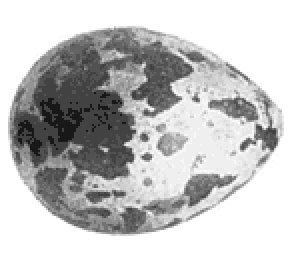
Greenish buff. 78. White-winged Black Tern. Hydrochelidon leucoptera.
Range.--Eastern Hemisphere, its addition to American
birds being made because of the accidental
appearance of one bird in Wisconsin in 1873. They
nest very abundantly among the lakes and marshes
of southern Europe, placing their
eggs the same as the American species,
upon masses of decayed reeds
and stalks.
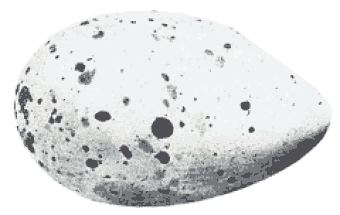
Buff. They lay three eggs
which have a somewhat brighter
appearance than the common Black
Terns because of a somewhat lighter
ground color.
79. Noddy. Anous stolidus.
Range.--Tropical America, north to the
Gulf and South Atlantic States.
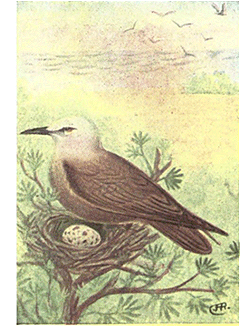
Noddy. A peculiar
but handsome bird (about fifteen inches long),
with a silvery white head and the rest of the
plumage brownish, and the tail rounded.
They breed in abundance on some of the Florida
Keys, the West Indies and the Bahamas.
Their nests are made of sticks and grass, and
are placed either in trees or on the ground.
They lay but a single egg with a buffy or
cream colored ground spotted with chestnut
and lilac. Size 2.00 × 1.30. Atwood's Key,
Bahamas, June 1, 1891. Nest made of sticks
and grasses, three feet up a mangrove. Collector,
D. P. Ingraham.

|

|
Page 58

|
SKIMMERS. Family RYNCHOPIDÆ
Skimmers are Tern-like birds having a very strangely developed bill. The
lower mandible is much longer than the upper and very thin, the upper edge
being as sharp as the lower. The lower mandible is rounded at the end while
the upper is more pointed. Young Skimmers are said to have both mandibles
of the same length, the abnormal development not appearing until after flight.
Skimmers are very graceful birds, and, as implied by their name, they skim
over the surface of the water, rising and falling with the waves, and are said
to pick up their food by dropping the lower mandible below the surface, its thin
edge cutting the water like a knife. There are four species of Skimmers, only
one of which is found in North America.
80. Black Skimmer. Rynchops nigra.

Buffy yellow. Range.--The South Atlantic and Gulf Coasts, breeding from New Jersey
southward. The Black Skimmer is about eighteen inches in length, and besides
the remarkable bill is a bird of striking plumage; the forehead, ends of
the secondaries, tail feathers and under parts are white; the rest of the plumage
is black and the basal half of the bill is crimson. Skimmers nest in large
communities, the same as do the Terns, laying their eggs in hollows in the
sand. They are partially nocturnal in their
habits and their hoarse barking cries may
be heard after the shadows of night have
enveloped the earth. Fishermen call them
by the names of "Cut-water" and "Sea Dog."
The nesting season commences in May and
continues through June and July. They lay
from three to five eggs, having a creamy
or yellowish buff ground, blotched with
black, chestnut and lilac. Size 1.75 × 1.30.
Data.--Cobb's Is., Va., June 8, 1894. Three
eggs laid in a hollow on the beach. No
nest.
|
|
|
Page 59
|
TUBE-NOSED SWIMMERS. Order III. TUBINARES.
ALBATROSSES. Family DIOMEDEIDAE
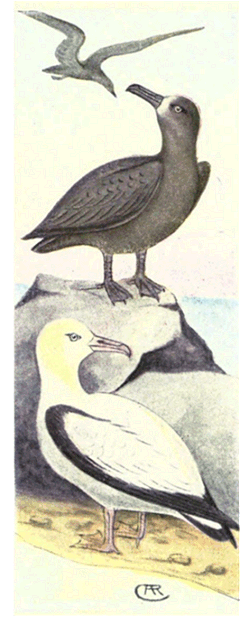
Black-footed Albatross.
Short-tailed Albatross. Albatrosses are the largest of the sea birds and have an enormous expanse
of wing, the Wandering Albatross, the largest of the family, sometimes attaining
an expanse of fourteen feet. Their nostrils consist of two slightly projecting
tubes, one on each side near the base of the bill. They are unsurpassed
in powers of flight, but are only fair swimmers and rarely, if ever, dive, getting
their food, which consists of dead animal matter, from the surface of the water.
81. Black-footed Albatross. Diomedea nigripes.
Range.--North Pacific from California northward.
This Albatross is thirty-two inches in
length; it is of a uniform sooty brown color shading
into whitish at the base of the bill, which is
rounded. Like the other members of the family,
this species is noted for its extended flights, following
vessels day after day without any apparent
period of rest, for the purpose of feeding on the
refuse that is thrown overboard. They breed
during our winter on some of the small isolated
islands in the extreme southern portions of the
globe. They lay a single white egg on the bare
ground.
82. Short-tailed Albatross. Diomedea albatrus.
Range.--North Pacific Ocean in summer, from
Lower California to Alaska. With the exception
of the Wandering Albatross, which is now regarded
as doubtful as occurring off our coasts, the
Short-tailed Albatross is one of the largest of
the group, measuring thirty-six inches in length,
and has an extent of seven feet or more. With
the exception of the black primaries, shoulders
and tail, the entire plumage is white, tinged with
straw color on the back of the head. They breed
on the guano islands in the North Pacific off the
coasts of Alaska and Japan. They lay a single
white egg on the bare ground or rocks. As with
the other members of the family, the eggs are
extremely variable in size, but average about
4.25 × 2.50.
|

|
Page 60

|
82.1. Laysan Albatross. Diomedea immutabilis.
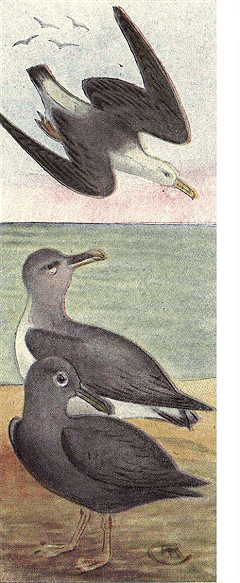
Laysan Albatross.
Yellow-nosed Albatross.
Sooty Albatross. Range.--Laysan Island of the Hawaiian Group,
appearing casually off the coast of California.
This species breeds in large numbers on the island
from which it takes its name. The birds are
white with the exception of the back, wings and
tail, which are black. The birds, having been little
molested in their remote island, are exceedingly
tame, and it is possible to go among the sitting
birds without disturbing them. Mr. Walter K.
Fisher has contributed an admirable report on
this species in the 1913 Bulletin of the Fish Commission,
the report being illustrated with numerous
illustrations of the birds from photos by the
author. Their single white eggs are laid on the
bare ground.
83. Yellow-nosed Albatross. Thalassogeron culminatus.
This is a species which inhabits the South Pacific
and Indian Oceans, and is said to rarely occur
on the California coast. They breed during
our winter on some of the small islands and during
our summer are ocean wanderers. An egg in
the collection of Col. John E. Thayer was taken on
Gough Island, South Atlantic Ocean; Sept. 1st,
1888. The nest was a mound of mud and grass
about two feet in height. The single white egg
measured 3.75 × 2.25. It was collected by George
Comer.
84. Sooty Albatross. Phoebetria-palpebrata.
Range.--Southern seas, north in our summer along the Pacific coast of the
United States.
This species is entirely sooty brown except the white eyelids. It is similar
to the Black-footed Albatross from which species it can be distinguished in
all plumages by the narrow base of the bill, while the bill of the former species
is broad and rounded. They breed commonly on isolated islands in many
quarters of the southern hemisphere. Sometimes this species constructs a
mound of mud on which to deposit its single white egg, and also often lays
it on the bare ground or rock. A specimen in Mr. Thayer's collection, taken
by Geo. Comer on So. Georgia Is. in the South Atlantic ocean, was laid in a
hollow among loose stones on the ledge of an overhanging cliff. Size 4.10 ×
2.75.
|
|
|
Page 61
|
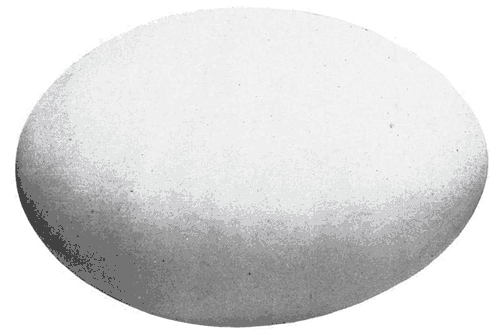
EGG OF SOOTY ALBATROSS--White.
FULMARS, SHEARWATERS and PETRELS
Family PROCELLARIDAE
Fulmars, Shearwaters and Petrels are Gull-like birds with two nostril tubes
located side by side, in a single tube, on the top of the bill at its base.
The Fulmars are mostly northern birds while the majority of the Shearwaters
nest in the extreme south during our winter, and appear off our coasts
during the summer. Their food consists of fish or offal which they get from
the surface of the water; large flocks of them hover about fishermen, watching
their chance to get any food which falls, or is thrown, overboard.

|

|
Page 62

|

Fulmar. 85. Giant Fulmar. Macronectes gigantea.
Range.--This Petrel is a native of the southern
seas and is only casually met with off the
Pacific coast.
It is the largest of the family, being about
three feet in length, and is normally a uniform
sooty color, although it has light phases of
plumage. They nest in December on many of
the islands south of Africa and South America,
laying their single white egg on the bare rocks.
86. Fulmar. Fulmarus glacialis glacialis.
Range.--North Atlantic coasts from New
England northward, breeding from Hudson
Bay and southern Greenland northward.
This bird which is 19 inches in length, in the light phase has a plumage
very similar to that of the larger Gulls. They nest by thousands on rocky
islands of the north, often in company with Murres and Gulls. Owing to the
filthy habits of the Fulmars, these breeding grounds always have a nauseating
odor, which is also imparted to, and retained by the egg shell. Their
single white eggs are laid on the bare rocks, in crevices of the cliffs, often
hundreds of feet above the water. Size 2.90 × 2.00. Data.--St. Kilda, off Scotland.
June 5, 1897. Single egg laid on rock on side of sea cliff. Collector, Angus
Gillies.
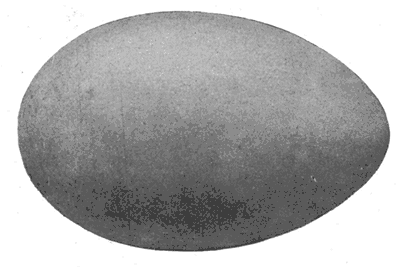
|
|
|
Page 63
|

Pacific Fulmar.
Slender-billed Fulmar. 86b. Pacific Fulmar. Fulmarus glacialis glupischa.
This sub-species of the preceding, has a darker
mantle than the common Fulmar; it is found on
the northern Pacific coasts where it breeds on
the high rocky cliffs, the same as its eastern
relative. They nest in large colonies, every
crevice in the rocks having its tenant. Their
flight is graceful like that of the Gulls, which
they closely resemble. They lay but a single
white egg, the average dimensions of which are
slightly smaller than those of the common Fulmar.
Data.--Copper Is., Alaska. May 14, 1889.
Egg laid in a crevice among the cliffs.
86.1. Rodger's Fulmar. Fulmarus rodgers.
Range.--North Pacific, breeding in large numbers
on some of the islands in Bering Sea; south
to California in winter. Very similar to the two
preceding species except that the back is mixed
with whitish, it is not believed to have a dark
phase. Their breeding habits and eggs do not
differ from the common Fulmar. The eggs are
laid on the rocky cliffs during June.
87. Slender-billed Fulmar. Priocella glacialoides.
Range.--Southern seas, appearing on the Pacific coast of the United States
in the summer. This species has a paler mantle than the others of the family,
and the primaries are black. The make-up and plumage of the whole bird is
more like that of the Gulls than any of the others. They probably breed in
the far south during our winter, although we have no definite data relative
to their nesting habits.

|

|
Page 64

|
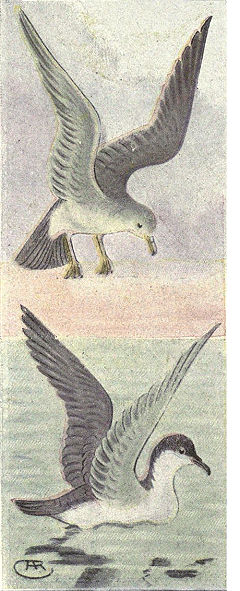
Cory Shearwater.
Greater Shearwater. 88. Cory's Shearwater. Puffinus borealis.
This species probably breeds in the far south.
It has been found only off the coast of Massachusetts
and Long Island. This is the largest
of our Shearwaters, and can be distinguished from
the next species by its wholly white underparts,
its light mantle and yellowish bill. We have no
data relative to its nesting habits.
89. Greater Shearwater. Puffinus gravis.
Range.--The whole of the Atlantic Ocean.
Thousands of them spend the latter part of the
summer off the New England coast, where they
are known to the fishermen as Haglets. Their
upper parts are brownish gray, darker on the
wings; bill and feet dark; underparts white, with
the middle of the belly and the under tail covers
dusky. Length about 20 inches. Little is
known concerning their nesting quarters, although
they are said to breed in Greenland.
From the fact of their early appearance off the
New England coast it is probable that the greater
part of them nest in the far south.
90. Manx Shearwater. Puffinus puffinus.
This species inhabits the North Atlantic ocean
chiefly on the European side, being abundant in
the Mediterranean and in the British Isles.
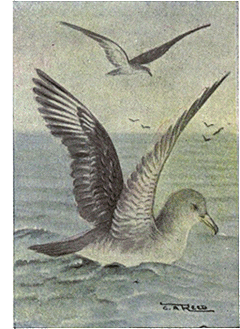
Audubon's Shearwater. Thesebirds deposit their single pure white eggs in
crevices among the cliffs, on the ground or in
burrows dug by themselves. Size of egg 2.35
× 1.60. Data.--Isle of Hay, North Scotland.
June 1, 1893. Single egg laid at the end of a
three foot burrow.
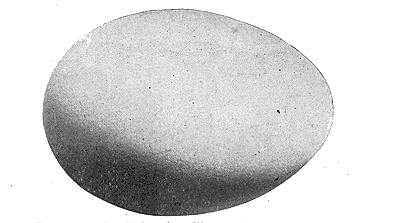
Egg of Audubon's Shearwater--White. |
|
|
Page 65
|
91. Pink-footed Shearwater. Puffinus creatopus.
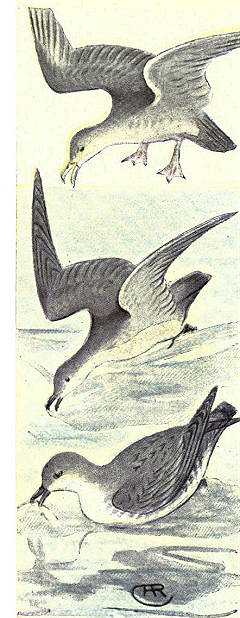
Pink-footed Shearwater.
Black-vented Shearwater.
Townsend's Shearwater. Range.--Pacific Ocean, north on American side
to California in summer.
This species, whose breeding habits are little
known, is similar in size and color to the Greater
Shearwater, differing chiefly in the yellowish bill
and pinkish colored feet.
92. Audubon's Shearwater. Puffinus lherminieri.
Range.--Middle Atlantic, ranging north in late
summer to Long Island.
This bird, having a length of but twelve inches,
is the smallest of the Shearwaters found along our
coasts. Large colonies of them breed on some
of the small islands and keys of the West Indies
and Bahamas, and not so commonly in the Bermudas.
Their eggs, which are pure white, are deposited
at the end of burrows dug by the birds.
Size of egg 2.00 × 1.35. Their nesting season commences
about the latter part of March and continues
through April and May. After the young
are able to fly, like other members of the family,
the birds become ocean wanderers and stray
north to southern New England. Data.--Bahamas,
April 13, 1891. Single egg laid at the end of a
burrow about two feet in length. Collector, D.
P. Ingraham.
92.1. Allied Shearwater. Puffinus assimilis.
This is an Australian and New Zealand species
that has accidentally strayed to the shores of
Nova Scotia.
93. Black-vented Shearwater. Puffinus opisthomelas.
Range.--Middle Pacific coast of the Americas, north in late summer along
the coast of California. This species breeds commonly on the islands off the
coast of Lower California, especially on the Gulf side. Their single egg is
white, size 2.00 × 1.30, and is located at the end of a burrow. Data.--Natividad
Is., Lower California, April 10, 1897. Single egg laid on the sand at the
end of a burrow six feet in length. Collector, A. W. Anthony.
93.1. Townsend's Shearwater. Puffinus auricularis.
This bird ranges from Cape St. Lucas, south along the Pacific coast of Mexico,
breeding on the Revillagigedo Islands off the Mexican coast.
|

|
|
Page 66
|
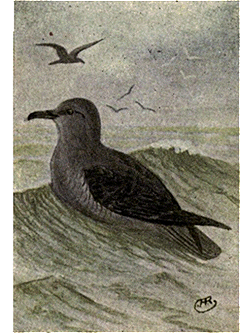
Sooty Shearwater. 94. Sooty Shearwater. Puffins fuliginosus.
Range.--A common species off the Atlantic
coast in summer; breeds along our northern
coasts, and it is also supposed that many of
them nest in southern seas and reach our
coasts early in the summer. These Shearwaters
are entirely sooty gray, being somewhat
lighter below. They are called "black
haglets" by the fishermen, whose vessels they
follow in the hope of procuring bits of refuse.
They commonly nest in burrows in the ground,
but are also said to build in fissures among
the ledges. Their single white egg measures
2.55 × 1.75. Data.--Island in Ungava Bay,
northern Labrador, June 14, 1896. Egg laid in
a fissure of a sea cliff. Collector, A. N. McFord.
|
|

|
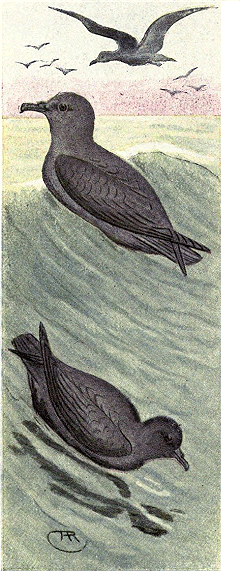
Dark-bodied Shearwater.
Slender-billed Shearwater. 95. Dark-bodied Shearwater. Puffinus griseus.
This is a southern species which, after having
nested on islands in the far south during
our winter, comes north and appears off the
Pacific coast of the United States during the
summer. It is a similar bird to the Sooty Shearwater,
but is considerably darker and the under
coverts are whitish. Their nesting habits are
the same as those of other members of the family.
Size of egg, 2.40 × 1.65. Data.--Stewart's
Island, New Zealand, February 15, 1896. Single
egg at the end of a long burrow.
96. Slender-billed Shearwater. Puffinus tenuirostris.
Range.--Northern Pacific Ocean in the summer,
extending from Japan and Alaska southward.
Supposed to breed in the southern hemisphere,
as well as probably on some of the Aleutians
in Alaska.
96.1. Wedge-tailed Shearwater. Puffinus cuneatus.
Range.--North Pacific, breeding on the Revillagigedo
Islands off the coast of Mexico, and
probably on some of the small islands in the
Gulf of California.
97. Black-tailed Shearwater. Priofinus cinerus.
This is a Shearwater which inhabits the southern
hemisphere, but which has accidentally wandered
to the Pacific coast of the United States.
It is dark above and whitish below, with black
under tail coverts. It breeds in the far south.
|
|
|
Page 67
|
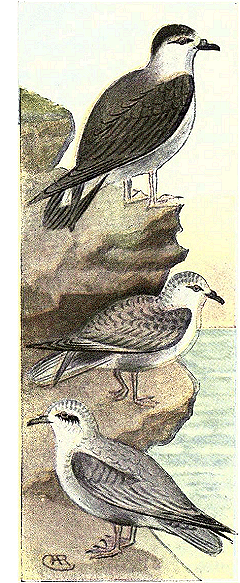
Black-capped Petrel.
Scaled Petrel.
Fisher's Petrel. 98. Black-capped Petrel. Æstrelata hasitata.
This is not a common species; it is an inhabitant
of tropical seas and has only been casually
found on our coasts or inland. It is a handsome
species with white forehead, underparts and nape
with a small isolated black cap on the crown;
the rest of the upper parts are blackish. It is a
native of the West Indies.
99. Scaled Petrel. Æstrelata scalaris.
This is another rare species which is an inhabitant
of southern seas. A single specimen
taken in New York State gives it a claim as a
doubtful North American species. It is a handsome
bird, the feathers of the grayish upperparts
being edged with white, thus giving it the appearance
of being barred. Its eggs have only been
known to science within the past few years.
Data.--Preservation Inlet, New Zealand, June 7,
1900. Single white egg. Size 2.40 × 1.75. Collector,
P. Seymour. Parent bird taken with the egg.
100. Fisher's Petrel. Æstralata fisheri.
This is a handsome bird known only from the
type specimen taken off Kadiak Is., Alaska, by
Mr. Fisher.
101. Bulwer's Petrel. Bulweria bulweri.
An eastern Atlantic species which is only an accidental visitant to our
shores. They breed on the Madeira Islands where the eggs are laid in crevices
among the rocks or in burrows in the ground. Size 1.75 × 1.55, white.
102. Pintado Petrel. Daption capensis.
This is the Cape Pigeon of the southern hemisphere. It has only accidentally
occurred on our coast.
|

|
Page 68

|
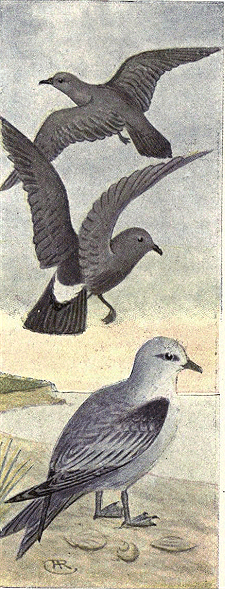
Least Petrel.
Stormy Petrel.
Forked-tailed Petrel. 103. Least Petrel. Halocyptena microsoma.
Range.--Pacific coast of America from Lower
California to Panama. The Least Petrel is the
smallest of this family, in length measuring only
5.75 inches. Their plumage is entirely dark
sooty. They have been found breeding on San
Benito Island, Lower California, and they probably
do on others farther south. The single egg
that this bird lays is white with a wreath of fine
black specks around one and sometimes both
ends. Data.--San Benito Is., Lower California,
June 12, 1897. No nest, the egg being simply
laid on the bare rock in a crevice. Size 1.00
× .75. Collector, A. W. Anthony.
104. Storm Petrel. Thalassidroma pelagica.
North Atlantic Ocean chiefly on the European
side, wintering south to New Brunswick. Smallest
of the white rumped, black petrels; 5.75
inches in length.
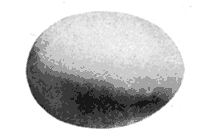
White. This species is the originally
called "Mother
Cary's Chicken" by the
sailors. They nest abundantly
on many of the islands
off the coasts of
Europe and the British
Isles, laying their single
egg either in burrows or crevices among the cliffs.
Data.--Coast of County Kerry, Ireland, June 1,
1895. Single egg laid at the end of burrow in a
sea cliff. Size 1.05 × .80; white with a wreath of
very fine dots about the larger end. Collector,
G. H. McDonald.
105. Forked-tailed Petrel. Oceanodroma furcata.
Range.--North Pacific from California to Alaska, breeding in the Aleutians.
These birds have a plumage of bluish gray, the wings being darker and the
underparts lightest. The nests are made in burrows or crevices in the banks.
Data.--Uniak Is., Alaska, June 10, 1900. No nest. Single egg laid at the
end of a burrow. Several pairs nesting near. Egg white with a fine wreath
of purplish black specks about the large end. Size 1.25 × .95.

|
|
|
Page 69
|
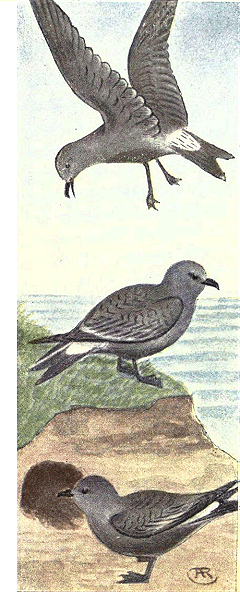
Kæding's Petrel.
Leach's Petrel.
Guadalupe Petrel. 105.2. Kæding's Petrel. Oceanodroma kædingi.
This bird is similar to Leach Petrel, but is
smaller and the tail is less deeply forked. Its
range is from California to Panama breeding
on the Revillagigedo Islands off Mexico.
106. Leach's Petrel. Oceanodroma leucorhoa.
Range.--North Atlantic and North Pacific
Oceans, breeding from Maine and from the
Farallones, northward to Greenland and the Aleutians.
These are the most common of the Petrels
found on our coast; they are eight inches in
length, of a sooty brown color, and have a white
rump. The forked tail will at once distinguish
them from any of the Atlantic Petrels. They
nest in burrows in the ground, laying a pure
white egg, sometimes with a very faint dusty
wreath about the larger end. Size 1.20 × .95.
These birds generally take turns in the task of
incubation, one remaining at sea during the day
and returning at night while his mate takes her
turn roving the briny deep in search of food.
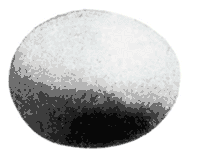
White. The young are fed by
regurgitation upon an oily
fluid which has a very offensive
odor. This odor
is always noticeable about
an island inhabited by
Petrels and is always retained
by the eggs or skins
of these birds. They are very rarely seen flying in the vicinity of their nesting
island during the day; the bird that is on the nest will remain until removed
by hand. Data.--Pumpkin Is., Maine, June 22, 1893. Single egg; nest
of a few grasses at the end of a burrow dug in the bank. Collector, J. Lefavour.
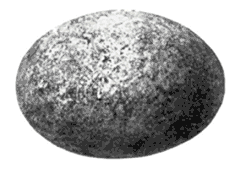
White, nest stained. 106.1 Guadalupe Petrel. Oceanodroma macrodactyla.
This species, which is very similar to the preceding, except for a longer
and more deeply forked tail, breeds on Guadalupe
Is. Their eggs are white very minutely wreathed
with reddish brown; they are, however, nearly always
nest stained to an uneven brownish color.
Data.--Guadalupe Is., Lower California, March 24,
1897. Single egg laid on a few oak leaves and pine
needles at the end of a three foot burrow. Size of
egg 1.40 × 1.00. Collector, A. W. Anthony.
|

|
Page 70

|
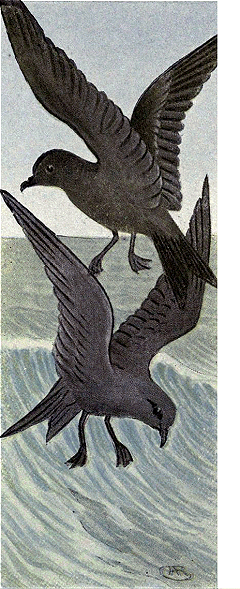
Black Petrel.
Ashy Petrel. 107. Black Petrel. Oceanodroma melania.
Range.--South Pacific, from southern California
southward, breeding on the small islands on
both coasts of Lower California. They are similar
to the Leach's Petrel except that the rump is
blackish. Data.--San Benito Is., Lower California,
July 23, 1896. White egg laid on bare ground
at the end of three foot burrow. Size 1.40 × 1.
Collector, A. W. Anthony.
108. Ashy Petrel. Oceanodroma homochroa.
Range.--California coast, breeding on the Farallones
and Santa Barbara Islands.
This species, while not common, nests in all
manner of localities on the Farallones, concealing
their eggs under any rock or in any crevice
that may attract their fancy. Their single white
egg is only faintly if at all wreathed with fine
dust-like specks of reddish brown. Size 1.15 ×
.86. Data.--Farallone Is., California, June 12,
1895. Egg laid on sand in crevice at the base of
a stone wall; well concealed. Collector, Chester
Barlow.
108.1. Socorro Petrel. Oceanodroma socorroensis.
Breeds on Socorro, San Benito and Coronado
Islands, placing its eggs at the end of burrow.
Data.--San Benito Is., Lower California, July 12,
1897. Single egg at the end of a burrow 3 feet
in length. Egg pure white very finely wreathed
with pale reddish brown. Size 1.15 × .87. Collector,
A. W. Anthony.
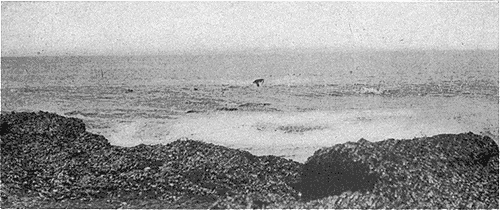
|
|
|
Page 71
|
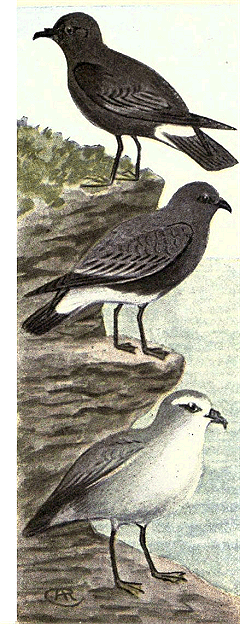
Wilson's Petrel.
White-billed Petrel.
White-faced Petrel. 109. Wilson's Petrel. Oceanites oceanicus.
Breeds in the southern hemisphere in February
and March and spends the summer off the Atlantic
coast as far north as Newfoundland. This species
can be distinguished from Leach Petrel by
its square tail and from the Stormy Petrel by its
large size and yellow webs to its feet. These
birds are the greatest wanderers of the genus,
being found at different seasons in nearly all
quarters of the globe. Their single egg is white.
Size 1.25 × .90.
110. White-bellied Petrel. Fregetta grallaria.
A small species (length about 7.5 inches) inhabiting
southern seas. Recorded once at Florida.
General plumage blackish. Upper tail coverts,
bases of tail feathers, under wing coverts,
and abdomen, white.
111. White-faced Petrel. Pelagodroma marina.
Range.--Southern seas, accidentally north to
the coast of Massachusetts. This beautiful species
is of about the same size as the Leach's
Petrel. It has bluish gray upper parts; the whole
under parts, as well as the forehead and sides
of head, are white.
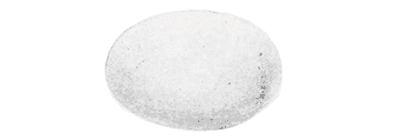
White. These birds have the same characteristics as do others of the species, pattering
over the water with their feet as they skim over the crests and
troughs of the waves. They are not uncommon in the waters about New
Zealand where they breed. Their single eggs are about the same as Leach's
Petrel, are brilliant white and are, very strongly, for a Petrel egg, wreathed
about the large end with dots of reddish brown. Size 1.32 × .90. Data.--Chatham
Is., New Zealand, January 7, 1901. Egg laid at end of a burrow. Collector,
J. Lobb. This egg is in Mr. Thayer's collection.

|

|
Page 72

|
TOTIPALMATE SWIMMERS. Order IV. STEGANOPODES
TROPIC BIRDS. Family PHAETHONTIDAE
Tropic Birds are Tern-like birds, having all the toes connected by a web,
and having the two central tail feathers very much lengthened.
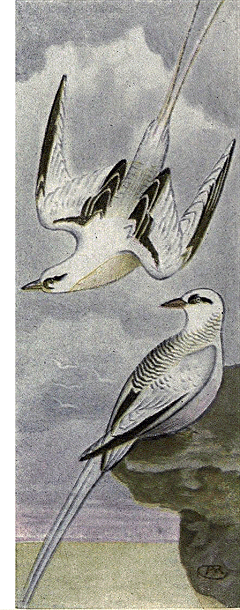
Yellow-billed Tropic Bird.
Red-billed Tropic Bird. 112. Yellow-billed Tropic Bird. Phæthon americanus.
Range.--Tropical regions, breeding in the Bahamas,
West Indies and the Bermudas, casual in
Florida and along the South Atlantic coast.
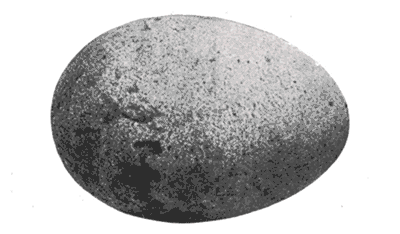
Dull purplish. The Tropic Birds are the most strikingly
beautiful of all the sea birds; they are about 30
inches in length, of which their long slender tail
takes about 20 inches. They fly with the ease
and grace of a Tern, but with quicker wing beats.
They feed on small fish, which they capture by
darting down upon, and upon snails which they
get from the beach and ledges. They build their
nests in the crevices and along the ledges of the
rocky cliffs. While gregarious to a certain extent
they are not nearly as much so as the Terns.
The nest is made of a mass of seaweed and weeds;
but one egg is laid, this being of a creamy or pale
purplish ground color, dotted and sprinkled with
chestnut, so thickly as to often obscure the
ground color. Size 2.10 × 1.45. Data.--Coney Is.,
Bermudas, May 1, 1901. Nest made of moss and seaweed in a crevice on
ledge of cliff. Collector, A. H. Verrill.

|
|
|
Page 73
|
113. Red-billed Tropic Bird. Phæthon æthereus.
Range.--Tropical seas, chiefly in the Pacific Ocean; north to southern
California.
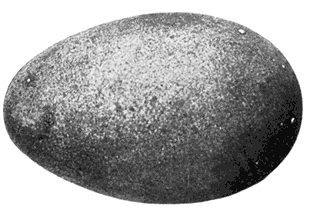
Pale purplish. They breed on several islands in the Gulf of California. This species differs
from the preceding in having a red bill, and the back being barred with black.
Their plumage has a peculiar satiny appearance and is quite dazzling when
viewed in the sunlight. They
are strong fliers and are met
with, hundreds of miles from
land. They often rest upon the
water, elevating their long tails
to keep them from getting wet.
They nest, as do the preceding
species, on rocky islands and
are said to also build their nests
in trees or upon the ground.
The single egg that they lay
has a creamy ground and is minutely
dotted with chestnut.
Size 2.40 × 1.55. Data.--Daphone
Is., Galapagos Is., South Pacific, March 6, 1901. Egg laid in hole of a sea cliff.
The eggs are easily told from those of the yellow-billed by their much larger
size. Collector, R. H. Beck.
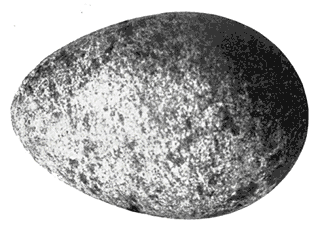
Pale purplish ground color. 113.1 Red-tailed Tropic Bird. Phæthon rubricaudus.
Range.--Tropical regions of the Pacific and Indian Oceans, accidental off
the coast of Lower California.
This is a singularly beautiful species resembling the latter except that the
central tail feathers are bright red, with the extreme tips white. During
August and September they
breed in large colonies on
small islands in the South
Seas. On Mauritius Island
they build their nests either
in the trees or place them on
the ground; the nest is made
of seaweed, sticks and weeds;
numbers of them nest on
Laysan Is., of the Hawaiian
group, concealing their nests
on the ground under overhanging
brush.
The single egg has a pale
purplish ground speckled
with brown.
|

|
Page 74

|
GANNETS. Family SULIDAE

Blue-faced Booby.
Blue-footed Booby. Gannets are large stoutly built birds, having the four toes joined by a web;
they have a small naked pouch beneath the bill; the bill is a little longer than
the head, and the tail is quite short. The plumage of the adults is generally
white, that of the young grayish.
114. Blue-faced Booby. Sula syanops.
Range.--Widely distributed in the tropical seas,
north casually to Florida and breeding in the Bahamas.
Like the rest of the Gannets, this one is stupid
and will often remain on the nest until removed
with the hand, merely hissing at the intruder.
Often they lay their eggs on the bare ground, but
sometimes the nest is lined with seaweed or grass.
They lay either one or two eggs early in April.
These eggs are of a dull white color and are heavily
covered with a chalky deposit. Size 2.50 × 1.70.
Data.--Clarion Is., Mexico, May 24, 1897. Nest
a mere hollow in the sand near the beach. Collector,
A. W. Anthony.
114.1. Blue-footed Booby. Sula nebouxi.
Range.--Pacific coasts and islands from the
Gulf of California southward to Chili.
These birds nest in numbers on the island of
San Pedro Martir in the Gulf of California. They
lay but a single egg, placing it upon the bare
rock. Their breeding season extends from the
latter part of March into May. The egg is a dull
white, generally nest stained and is covered with
the usual chalky deposit. Size 2.35 × 1.60. Data.--Clarion
Island, Mexico, May 21, 1897. Two eggs
in a hollow in the sand near the beach. Collector,
A. W. Anthony.

|
|
|
Page 75
|
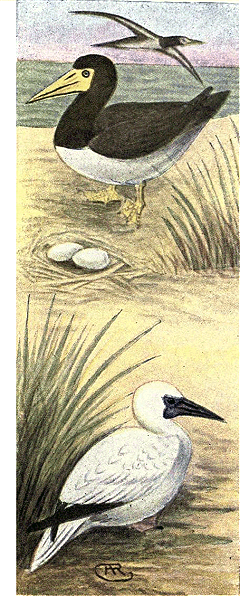
Booby.
Red-footed Booby. 115. Booby. Sula leucogastra.
Range.--Tropical coasts and islands of the Atlantic;
north casually to Georgia.
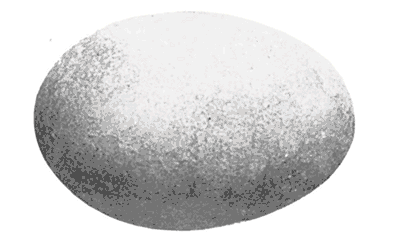
Chalky bluish white, nest stained. The common Booby is an abundant bird on
some of the islands of the Bahamas and Bermudas;
it is commonly called the Brown Booby because
the upper parts are of a brownish gray.
These birds, as do the other Gannets, have great
powers of flight and without apparent effort dart
about with the speed of an arrow. They are
quite awkward upon their feet and are not very
proficient swimmers. They rarely rest upon the
water except when tired. Hundreds and sometimes
thousands of them breed in company, laying
their eggs upon the bare rocks. Sometimes
a few sticks or grasses will be placed about the
bird to prevent the eggs from rolling away. They
generally lay two eggs, chalky white and nest
stained. Size 2.40 × 1.60. Data.--Key West, Bahamas,
April 14, 1891. No nest; two eggs laid on
the bare rocks.
115.1. Brewster's Booby. Sula brewsteri.
Range.--Pacific coast from Lower California southward. This Gannet replaces
the common Booby on the Pacific coast. It nests abundantly on many
islands in the Gulf of California, and in company with the blue-footed variety,
on San Pedro Martir Island. They generally lay two eggs, placing them upon
the bare rocks and surrounding them with a ring of sticks and seaweed to keep
them in place. The eggs are chalky white and cannot be distinguished from
those of the other Boobies. Data.--San Benedicto Is., Lower California, May
18, 1897. Single egg laid on the sand amid a few blades of grass.
116. Red-footed Booby. Sula piscator.
This is another species that is only occasionally taken on the Florida coast.
The habits of the birds and their nesting habits are the same as those of the
others of the family. Two chalky white eggs are laid. Data.--San Benedicto
Is., Lower California, May 18, 1897. Single egg. Nest a few twigs of rank
grass. Collector, A. W. Anthony.
|

|
Page 76

|
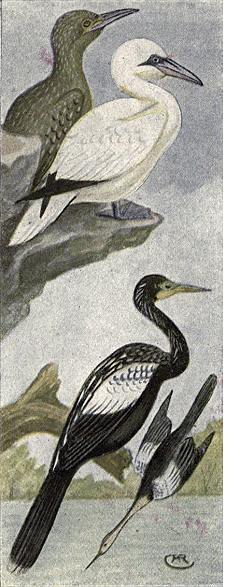
Ganet Anhinga. 117. Gannet. Sula bassana.
Range.--North Atlantic, breeding, in America,
only on Bird Rocks in the St. Lawrence.
These are the largest of the family, being 35
inches in length. They feed on fish which they
catch by diving upon, from the air. When flying
their neck is carried fully extended. They rest
on the water when tired, the numerous air cells
beneath the skin, causing them to sit high up in
the water and enabling them to weather the
severest storm in perfect safety. The only known
breeding place in America is Bird Rocks, where
they nest by thousands, placing their nests in
rows on the narrow ledges; the nests are made
of piles of seaweed, mud and stones. They lay
but one egg of dingy white color and covered with
a chalky deposit. On St. Kilda Island, off the
coast of Scotland, they breed by millions. They
are very tame and will frequently allow themselves
to be touched with the hand. It is said
that thousands of the young are killed by fishermen
every year and marketed in Edinburg and
other places. Data.--St. Kilda Island, Scotland,
June 18, 1896. Single egg laid on a large mass of
seaweed on a sea cliff. Collector, H. McDonald.
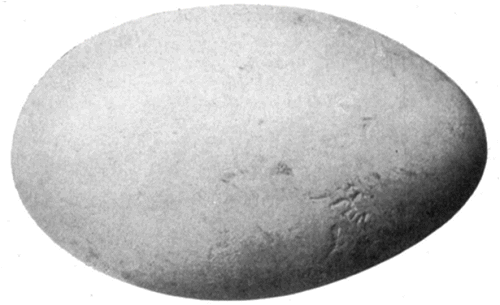
|
|
|
Page 77
|
DARTERS. Family ANHINGIDAE
118. Water Turkey. Anhinga anhinga.
Range.--Tropical America, north to the South Atlantic States and up the
Mississippi Valley to Illinois.
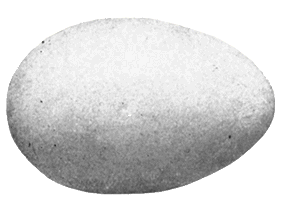
Chalky bluish white. Anhingas or Snake Birds are curiously formed creatures with a Heron-like
head and neck, and the body of a Cormorant. They live in colonies in inaccessible
swamps. Owing to their thin and light bodies, they are remarkable
swimmers, and pursue and catch fish
under water with ease. When alarmed
they have a habit of sinking their
body below water, leaving only their
head and neck visible, thereby having
the appearance of a water snake.
They also fly well and dive from their
perch into the water with the greatest
celerity.
They nest in colonies in the swamps,
placing their nests of sticks, leaves
and moss in the bushes over the
water. They breed in April, laying
from three to five bluish eggs, covered with a chalky deposit. Size 2.25 × 1.35.
Data.--Gainesville, Florida, May 18, 1894. Nest in the top of a button-wood
tree, made of leaves and branches, overhanging the water. Collector, George
Graham.
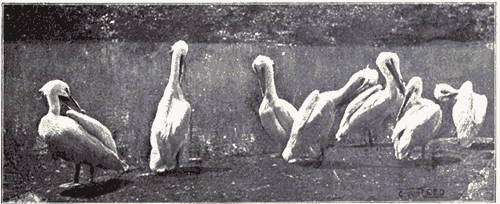
PELICAN POND.
Washington Zoological Park.
|

|
|
Page 78
|
CORMORANTS. Family PHALACROCORACIDÆ
Cormorants have a more bulky body than do the Anhingas; their tail is
shorter and the bill strongly hooked at the tip. Cormorants are found in
nearly all quarters of the globe. They are very gregarious and most species
are maritime. They feed upon fish which they catch by pursuing under water.
Most of the Cormorants have green eyes.
|
|
|
Page 79
|
119. Cormorant. Phalacrocorax carbo.
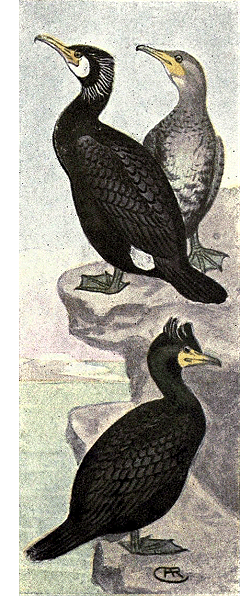
Cormorant.
Double-crested Cormorant. Range.--The Atlantic coast breeding from Maine
to Greenland.
The common Cormorant or Shag is one of the
largest of the race, having a length of 36 inches.
In breeding plumage, the black head and neck
are so thickly covered with the slender white
plumes as to almost wholly obscure the black.
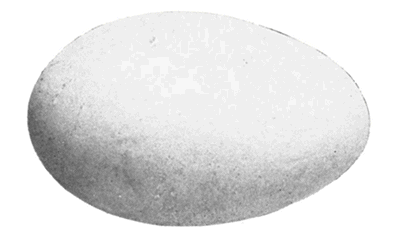
Chalky greenish or bluish white. There is also a large white patch on the flanks.
They nest in colonies on the rocky shores of Newfoundland
and Labrador, placing their nests of
sticks and seaweed in rows along the high ledges,
where they sit, as one writer aptly expresses it,
like so many black bottles. A few pairs also nest
on some of the isolated rocky islets off the Maine
coast. During the latter part of May and during
June they lay generally four or five greenish
white, chalky looking eggs. Size 2.50 × 1.40. Data.--Black
Horse Rock, Maine coast, June 6, 1893.
Four eggs in a nest of seaweed and a few sticks;
on a high ledge of rock. Collector, C. A. Reed.
120. Double-crested Cormorant. Phalacrocorax auritus auritus.
Range.--The Atlantic coast and also in the interior, breeding from Nova
Scotia and North Dakota northward.
This is a slightly smaller bird than carbo, and in the nesting season the white
plumes of the latter are replaced by tufts of black and white feathers from
above each eye. On the coast they nest the same as carbo and in company with
them on rocky islands. In the interior they place their nests on the ground or
occasionally in low trees on islands in the lakes. They breed in large colonies,
making the nests of sticks and weeds and lay three or four eggs like those of
the common Cormorant but averaging shorter. Size 2.30 × 1.40. Data.--Stump
Lake, North Dakota, May 31, 1897. Nest of dead weeds on an island. Six eggs.
Collector, T. F. Eastgate.
|

|
|
Page 80
|
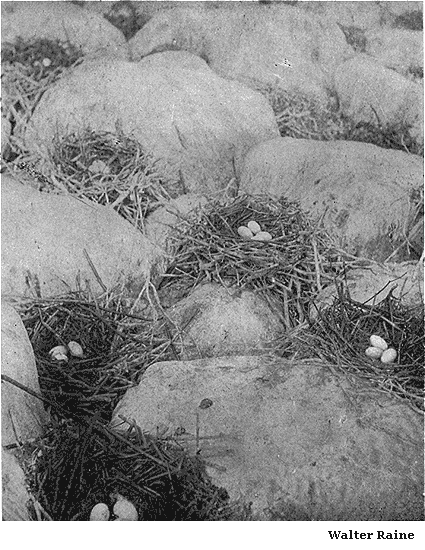
NESTS OF DOUBLE-CRESTED CORMORANTS.
|
|
|
Page 81
|
120a. Florida Cormorant. Phalacrocorax auritus floridanus.
This sub-species is a common breeding bird in the swamps and islands of the
Gulf coast and north to South Carolina and southern Illinois. The nests are
placed in the mangroves in some of the most impenetrable swamps and are
composed of twigs and lined with leaves or moss. They lay three or four chalky
bluish white eggs. Size 2.30 × 1.40. Data.--Bird Is., Lake Kissimee, Florida,
April 5, 1898. Three eggs. Nest made of weeds and grass, in a willow bush.
120b. White-crested Cormorant. Phalacrocorax auritus cincinatus.
Range.--Northwestern coast of North America, breeding in Alaska, and south
to the northern boundary of the United States, breeding both in the interior
and on the coast, in the former case generally on the ground or in low trees
on swampy islands and in the latter, on the rocky cliffs of the coasts and
islands. The nests are built in the same fashion as the other Cormorants, and
the three to five eggs are similar. Size 2.45 × 1.40.
120c. Farallon Cormorant. Phalacrocorax auritus albociliatus.
Range.--This sub-species breeds on the coasts and islands of California and
southward.
In company with other species of Cormorants, these birds breed in large
numbers on the Farallones, placing their nests well up on the higher ridges and
rocks. They breed most abundantly during May. When nesting on the inland
islands, they place their nests in low bushes. Their nests and eggs are similar
to those of the other Cormorants. Size 2.40 × 1.50. Data.--Farallones, California.
Nest of weeds and seaweed on the rocks. Collector, W. O. Emerson.
121. Mexican Cormorant. Phalacrocorax vigua mexicanus.
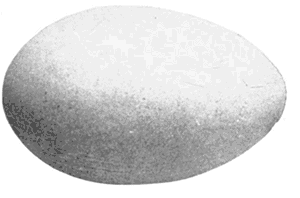
Greenish white. Range.--Breeds abundantly from southern Texas, south through Mexico;
north rarely to Kansas; has recently
been found breeding in limited number
on some of the Bahamas. In the
interior they nest in trees, chiefly
those overhanging or growing in the
water. On the coasts they nest on the
rocky ledges, as do the other Cormorants.
They nest in colonies building
their abode of twigs and weeds, and
during May laying three or four eggs,
greenish white in color and chalky, as
are all the Cormorants. Size 2.25 × 1.35.
|

|
|
Page 82
|
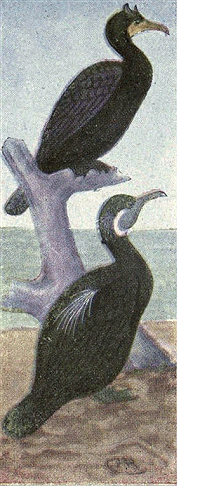
120c--122. 122. Brandt's Cormorant. Phalacrocorax penicillatus.
Range.--Pacific coast breeding along the whole coast
of the United States.
This species is found more abundantly on the Farallones
than is the Farallone Cormorant. Like the other
Cormorants breeding on these islands, these cling closely
to their nests, for fear of being robbed by the Gulls, that
are ever on the watch to steal either eggs or young.
Their nesting habits and eggs are identical with those of
the other species. Size 2.50 × 1.50. Data.--Bird Island,
California, May 24, 1885. A very bulky nest of seaweed
on the rocks. Collector, A. M. Ingersoll.
123. Pelagic Cormorant. Phalacrocorax pelagicus pelagicus.
Range.--Coast of Alaska.
These are perhaps the most beautiful species of Cormorants,
having brilliant violet green metallic reflections
and, in the breeding plumage, crests on the forehead
and nape, as well as large white flank patches.
They breed in large colonies on the Aleutian Islands,
placing their nests of sticks and sea mosses on the rocky
ledges, often hundreds of feet above the sea level. Three
or four eggs are laid during May and June. The young
birds when hatched are naked and black, and are repulsive
looking objects, as are those of all the other Cormorants. The eggs
are greenish white with the usual calcareous deposit. Size 2.30 × 1.40.
|
|

|
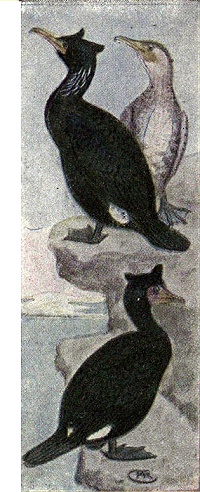
123b--124. 123a. Violet-green Cormorant. Phalacrocorax pelagicus robustus.
This sub-species is found on the Pacific coast from Washington to the Aleutian
Islands. Their habits and nests and eggs are the same as those of the
Pelagic Cormorant, nesting on the high cliffs of the
rocky islands. The eggs are the same size as those of
the preceding.
123b. Baird's Cormorant. Phalacrocorax pelagicus resplendens.
This variety breeds on the Pacific coast from Washington
south to Mexico. They nest on the Farallones,
but in smaller numbers than the other varieties found
there. Both the birds and their eggs are smaller than
the preceding. Size of eggs 2.20 × 1.40.
124. Red-faced Cormorant. Phalacrocorax urile.
Range.--Southwest coast of Alaska, migrating to
Japan in the winter.
This species differs from the Pelagic chiefly in having
the forehead bare. They do not differ in their breeding
habits from others of the family. That the Cormorants
are expert fishermen may be seen from the fact that the
Chinese tame and have them catch fish for them, placing
a ring around their neck to prevent their swallowing the
fish. Their nesting places are very filthy, being covered
with excrement and remains of fish that are strewn
around the nests. They breed in June laying three or
four eggs. Size 2.50 × 1.50.
|
|
Page 83

|
PELICANS. Family PELECANIDÆ
Pelicans are large, short legged, web footed (all four toes joined by a web)
birds, the most noticeable feature of which is the long bill with its enormous
pouch suspended from lower mandible. This pouch, while normally contracted,
is capable of being distended to hold several quarts. It is used as a scoop in
which to catch small fish. Their skin is filled with numerous air cells, making
them very light and buoyant.
125. American White Pelican. Pelecanus erythrorhynchos.
Range.--Temperate North America, breeding in the interior, from Utah and
the Dakotas northward. These large birds, reaching a length of five feet, are
entirely white except for the black primaries. They get their food by approaching
a school of small fish and, suddenly dipping their head beneath the surface,
sometimes scoop up a large number of fish at a time; after allowing the
water to run out of the sides of the mouth, they proceed to swallow their catch.
They nest in large communities on islands in some of the inland lakes.
Great Salt Lake, Utah, and Shoal Lake, Manitoba, furnish breeding ground
for many thousands of Pelicans. They build their simple nests on the ground,
making them of sticks and weeds. They generally lay two eggs, but often
three or four. Size 3.45 × 2.30. Data.--Egg Island, Great Salt Lake, June 19,
1884. Two eggs. Nest a slight hollow in the ground, surrounded by a few
sticks. Collector, F. F. Leonard.
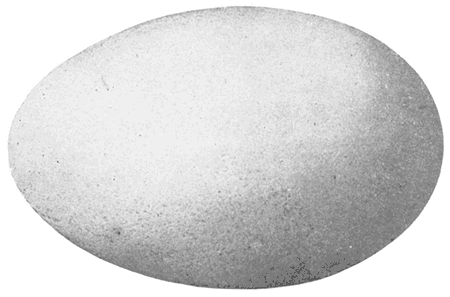
Chalky white.

|

|
|
Page 84
|

AMERICAN WHITE PELICAN.
|
|
|
Page 85
|
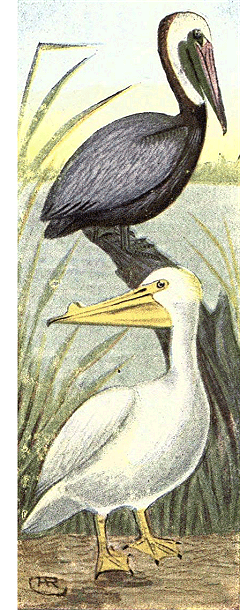
Brown Pelican.
White Pelican. 126. Brown Pelican. Pelecanus occidentalis.
Range.--Found on the South Atlantic and Gulf
coasts of the United States.
Brown Pelicans are about 50 inches in length;
they have a blackish and grayish body and a
white head and neck with a brown stripe down
the back of the latter. The pouch is a dark greenish
brown. This species is maritime and is not
found inland. They breed in large colonies on
many of the islands in the Gulf of Mexico and on
Pelican Island on the east coast of Florida, in
which latter place they are now protected from
further depredations at the hand of eggers and
gunners.

Chalky white. Their fishing tactics differ from those
of the White Pelican. They dive down upon the
school of fish from the air and rarely miss making
a good catch. Their nests are quite bulky structures made of sticks and
weeds and grasses. These are generally located on the ground but occasionally
in low mangroves, these latter nests being more bulky than the ground ones.
They lay from two to five chalky white eggs during May and June. Size 3. ×
1.90. Data.--Tampa Bay, Fla., May 29, 1894. Three eggs. Nest in the top of
a stout mangrove; made of sticks, branches and leaves. Collector, Geo. Graham.
127. California Brown Pelican. Pelecanus californicus.
Range.--Pacific coast from British Columbia south to the Galapagos Islands.
This bird is similar to the preceding, but larger and the pouch is reddish.
They breed abundantly on the Coronado Islands and southward. Their habits,
nesting habits and eggs are the same as those of the Brown Pelican. Size of
the three or four chalky white eggs is 3.10 × 1.95. Data.--Coronado Islands,
Calif., March 28, 1897. Three eggs. Nest of sticks, lined with green leaves,
located on the ground. Collector, H. McConville.

|

|
Page 86

|
MAN-O'-WAR BIRDS. Family FREGATIDÆ
128. Man-o'-war Bird. Fregata aquila.
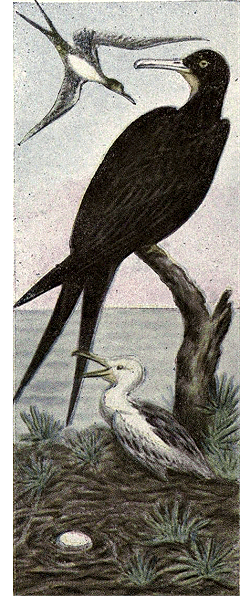
Man-O'-War Bird.
Range.--Tropical seas, north regularly in America to the South Atlantic and
Gulf coasts, casually farther.
Man-o'-war Birds or "Frigates," as they are
often called, are remarkable birds in many respects.
In comparison with their weight they
have the largest expanse of wing of any known
bird. Weighing only about four pounds they have
an extent of from seven to eight feet, their wings
being extremely long and pointed.

White. The length of
the bird is about 40 inches, of which the tail comprises
about 18 in., 10 inches of this being forked.
They have a large bright orange gular sac, a long,
hooked bill, and small slightly webbed feet. Their
powers of flight combine the strength of the
Albatrosses and the grace of the Terns. They
are very poor swimmers and do not dive, so are
forced to procure their food by preying upon the
Gulls and Cormorants, forcing them to drop their
fish, which the pirates catch before it reaches the
water. They also feed upon flying fish, catching
them in the air, whither they have been driven by
their enemies in their natural element. They nest in large colonies on some of
the Bahama Islands and on some of the small Florida Keys. Their nests are
small frail platforms of sticks and twigs and the single egg is laid in March
and April. It is white and has a smooth surface. Size 2.80 × 1.90. Data.--Key
Verde, Bahamas, March 6, 1889. Single egg. Nest a frail affair of sticks on a
cactus. Collector, D. P. Ingraham.

|
|
|
Page 87
|
Order V. ANSERES
DUCKS, GEESE AND SWANS. Family ANATIDAE
The birds comprising this family are of greatly varying sizes, but all have
webbed feet, and generally the bill is broader than high, and is serrated on the
edges or provided with gutters to act as a strainer in assisting the birds to
gather their food.
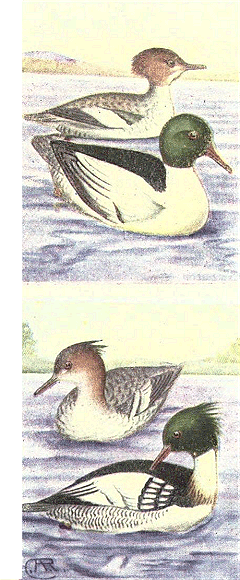
American Merganser.
Red-breasted Merganser. 129. Merganser. Mergus americanus.
Range.--North America, breeding from the
northern border of the United States northward.
The three species of Mergansers are almost
exclusively fish eating birds. Therefore their flesh
is unpalatable and they are known as "Fish
Ducks."
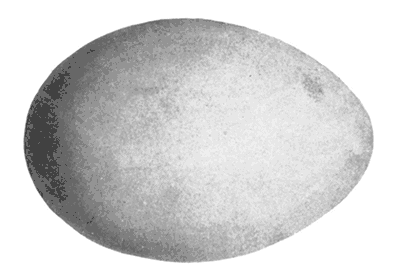
Brownish buff. They are also sometimes called "Sawbills"
because of the teeth-like serration on both
the upper and the under mandibles. Unlike the
other species of ducks, their bills are long, slender
and rounded instead of being broad and flat;
it is also hooked at the tip. Like the Cormorants,
they often pursue and catch fish under the water,
their teeth-like bills enabling them to firmly hold
their prey.
The American Mergansers, Goosanders, or Sheldrakes,
as they are often called, are found both
on the coast and in the interior. Except in certain
mountainous regions, they breed chiefly north
of the United States. The male bird has no crest
and the head is a beautiful green, while the female has a reddish brown crest
and head, shading to white on the chin. They build their nest in hollow trees
near the water. It is made of grasses, leaves and moss and is lined with feathers
from the breast of the female. During May, they lay from six to ten eggs
of a creamy or buff color. Size 2.70 × 1.75. Data.--Gun Is., Lake Winnipeg.
June 16, 1903. Eleven eggs in a nest of white down, located between two large
boulders. Collector, Walter Raine.
|

|
Page 88

|
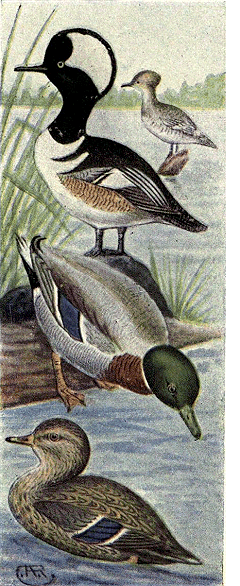
Hooded Merganser.
Mallard. 130. Red-breasted Merganser. Mergus serrator.
Range.--North America, breeding from northern
United States northward.
This species is more abundant than the preceding.
It is slightly smaller, being 22 inches in
length, and the male is crested. Found abundantly
in the United States in winter. Breeds commonly
in the interior of British America and in
Labrador and Newfoundland. They make their
nests on the ground, near the water, concealing
them under rocks or tufts of grass. The nest is
made of grasses, leaves and moss and lined with
feathers. They lay, generally, about ten eggs of
a buffy or greenish buff color. Size 2.50 × 1.70.
Data.--Lake Manitoba, N. W. Canada. Two eggs
in a hollow lined with down, under a patch of rose
bushes near shore. Collector, Jos. Hamaugh.
131. Hooded Merganser. Lophodytes cucullatus.
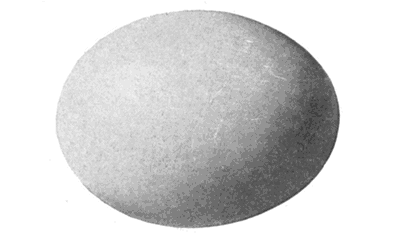
Grayish white. Range.--North America, breeding locally throughout
its range, in the interior. These are beautiful
little Ducks distinguished from all others by the semi-circular, compressed
crest which is black with an enclosed white area. They make their nests in
hollow trees, in wooded districts near the water, lining the cavity with
grasses and down. They lay ten or twelve grayish white eggs. Size 2.15 × 1.70.
132. Mallard. Anas platyrhynchos.
Range.--Northern Hemisphere, breeding in America from northern United
States northward, and wintering south to Panama and the West Indies.
Contrasting with the preceding Fish Ducks, the Mallards are regarded as
one of the most esteemed table birds. They feed on mollusks and marine
insects which they generally reach by tipping in shallow water. They nest in
many localities in the United States but more abundantly north of our borders.
They nest in fields in close proximity to ponds or lakes, placing their nests
of grasses and feathers in the tall grass. In May and June they lay from six
to ten eggs of a buffy or olive color. Size 2.25 × 1.25. Data.--San Diego, California,
May 19, 1897. Nest made of grass, lined with down, placed on the edge
of a field near a pond.
|
|
|
Page 89
|
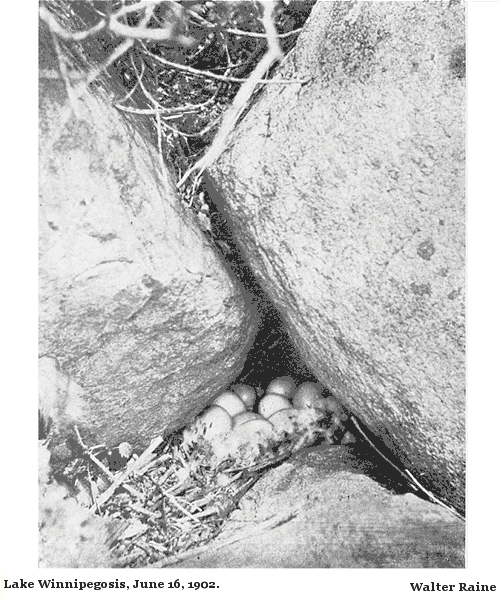
NEST AND EGGS OF AMERICAN MERGANSER.
This species usually nest in holes in trees, but on this island
they were nesting
in holes under boulders.
|
|
Page 90

|
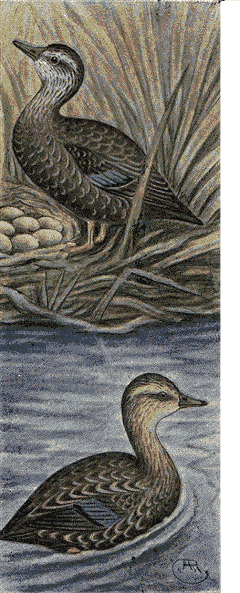
Black Duck.
Florida Duck. 133. Black Duck. Anas rubripes.
Range.--Eastern North America, breeding from
the middle portions north to the Hudson Bay territory
and Labrador.
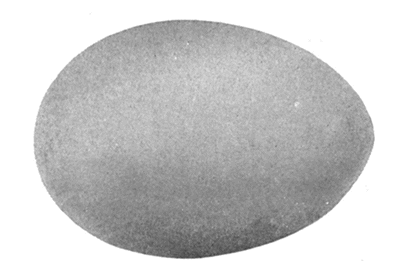
Pale greenish buff. Throughout their breeding region, one or more
pairs of these ducks nest in nearly every favorable
locality. Their nests are placed on the ground
in marshes, swamps or fields bordering a pond
or lake, the nest being concealed in the long grass
or reeds. They breed in equal abundance, either
in the interior or along the sea coast; in the latter
case their nests are often placed beside of, or
under an overhanging rock. It is made of weeds,
grass and moss and is lined with feathers and
down. They lay from six to twelve eggs during
May and June; these are buff or greenish buff in
color. Size 2.30 × 1.70. Data.--Duck Is., Maine,
June 3, 1893. Nest of grasses, concealed in a
large tuft on water's edge.
134. Florida Duck. Anas fulvigula fulvigula.
Range.--Florida and the Gulf of the Mississippi.
This is a similar, lighter colored, locally distributed race of the foregoing.
The most noticeable difference in plumage between this and the Black Duck is
the absence of markings on the chin. The habits are the same, and the eggs,
which are deposited in April, are similar to those of the Black Duck, but
smaller. Size 2.15 × 1.60.

|
|
|
Page 91
|
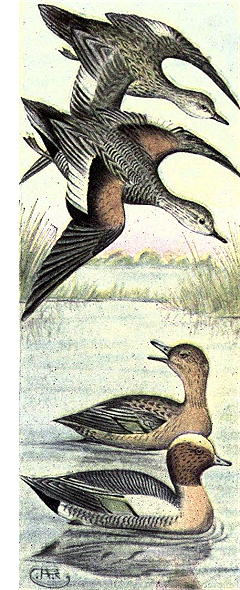
Gadwall.
Widgeon. 134a. Mottled Duck. Anas fulvigula maculosa.
Range.--Gulf coast of Texas and up the Mississippi
Valley to Kansas.
The habits of this bird differ in no way from
the preceding ones. The six to ten eggs are
greenish buff in color. Size 2.15 × 1.55.
135. Gadwall. Chaulelasmus streperus.
Range.--Northern Hemisphere, breeding in
America, chiefly in the United States and north
to Manitoba, chiefly in the interior.
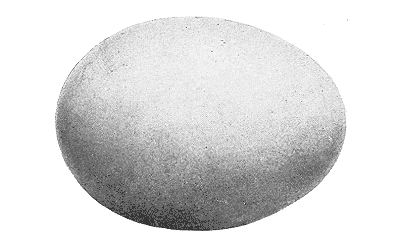
Creamy buff. South in winter to the Gulf. The males of these
birds may be identified by the white speculum
and the chestnut wing coverts. Gadwalls nest
on the ground among the reeds of marshes or in
the long grass of bordering fields; they make little
or no nest but line the cavity with down from
their breasts. They lay from seven to twelve
eggs of a creamy buff color. Size 2.10 × 1.60.
Data.--Benson Co., North Dakota, June 19, 1898.
Eight eggs. Nest on the ground among rank grass on a low island in Devils
Lake. Made of weeds lined with down. Collector, E. S. Rolfe.
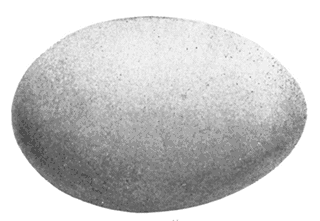
Pale buff. 136. Widgeon. Mareca penelope.
Range.--Northern Hemisphere,
breeding in America, only in the
Aleutian Islands; rare or accidental
in other parts of the country.
The European Widgeon is similar
in build and plumage to the following
species, except that the
whole head, with the exception of
the white crown, is chestnut. They
build their nests in the rushes, making
them of reeds and grass and
lining them with feathers. They
lay from six to ten light buff colored
eggs. Size 2.20 × 1.50.
|

|
Page 92

|
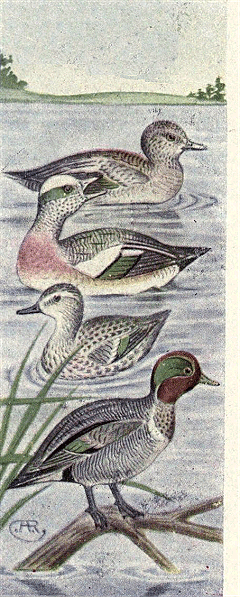
Baldpate.
Green-winged Teal. 137. Baldpate. Mareca americana.
Range.--North America, breeding in the interior
from Texas north to Hudson Bay.
The Baldpate (so-called because of the white
crown) or American Widgeon is a handsomely
marked bird and is regarded as a great table
delicacy.
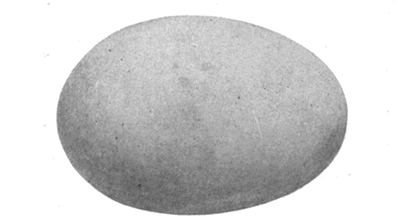
Creamy white. The male birds cannot be mistaken for
any other species because of the white crown,
wing coverts and underparts and the broad green
stripe, back of the eye. They breed locally in
many parts of the country, building their nests
of grass and weeds, neatly lined with feathers,
on the ground in marshes. They lay from six
to twelve creamy eggs. Size 2.15 × 1.50. Data.--Lac
Aux Morts, North Dakota. Eight eggs. Nest
of grass and down on ground in a grassy meadow.
Collector, E. S. Bryant.
138. European Teal. Nettion crecca.
An old world species that is casually found on
both coasts of America.
139. Green-winged Teal. Nettion carolinense.
Range.--Whole of North America,
breeding chiefly north of the United
States.
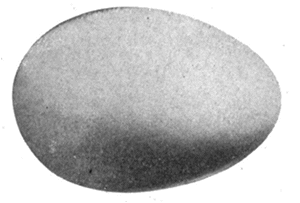
Buff. A small, handsome species, the male of
which can readily be identified by the
reddish brown head and neck, with the
large green patch behind each ear; length
fourteen inches. Green-winged Teals are
our smallest representative of the Duck
family. They are eagerly sought by
sportsmen, both because of their beauty
and the excellence of their flesh. They
are among the most common of Ducks in
the interior, where they nest generally in
tufts of grass along ponds, lakes or
brooks. Nest of grass and weeds, lined with down from the bird. Eggs buffy,
four to ten in number. Size 1.85 × 1.25.
|
|
|
Page 93
|
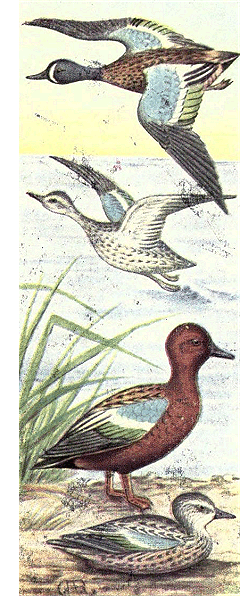
Blue-winged Teal.
Cinnamon Teal. 140. Blue-winged Teal. Querquedula discors.
Range.--North America, breeding from northern
United States northward; rare on the Pacific
coast.
Another small species, known by the blue wing
coverts and the white crescent in front of eye.
They nest in the same localities with the preceding
species, placing their nest of grass and weeds
on the ground in meadows near water. Eggs
buffy white. Six to twelve in number. Size 1.90 ×
1.30.
141. Cinnamon Teal. Querquedula cyanoptera.
Range.--Western United States, chiefly west
of the Rocky Mountains. Casually east to Texas,
Illinois and British Columbia.
The Cinnamon Teal is another small Duck,
marked by the uniform rich chestnut plumage and
light blue wing coverts. The speculum is green.
The nesting habits are the same as those of the
Teals, the nests being placed on the ground in
marshes or fields near water. Their nests are
closely woven of grass and weeds and lined with
down and feathers from the breast of the bird.
The eggs are pale buff and number from six to
fourteen. Size 1.85 × 1.35.
141.1. Ruddy Sheldrake. Casarca ferruginea.
This is an Old World species that has accidentally
occurred in Greenland.

|

|
Page 94

|
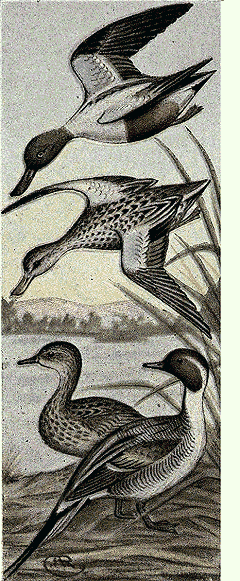
Pintail.
Shoveller. 142. Shoveller. Spatula clypeata.
Range.--Whole of North America, breeding in
the interior from Texas northward.
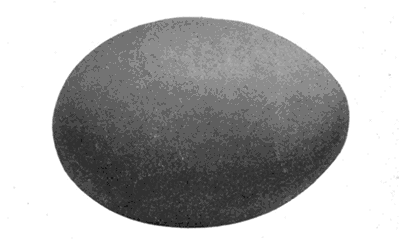
Lead gray. This strikingly marked Duck is twenty inches
in length, has a green head and speculum, blue
wing coverts and chestnut belly. The bill is long
and broad at the tip. It makes its nest on the
ground in marshy places, of grass, weeds and
feathers. Six to ten eggs constitute a complete
set. They are greenish or leaden gray color.
Size 2.10 x 1.50. Data.--Graham's Island, North
Dakota, May 28, 1899. Nest of dead weed stems
and grass, lined with down. Ten eggs. Collector,
E. S. Bryant.
143. Pintail. Dafila acuta.
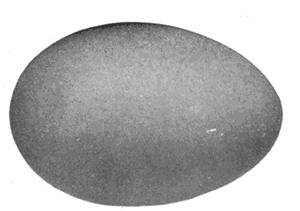
Dull olive gray. Range.--Northern Hemisphere, breeding in
North America from northern United States northward,
wintering south to Panama. This species,
which is also known as the Sprig-tail, is very
common in the United States in the
spring and fall migrations. It is about
thirty inches long, its length depending
upon the development of the tail
feathers, the central ones of which are
long and pointed. They breed casually
in many sections of the United
States, but in abundance from Manitoba
to the Arctic Ocean. They nest
near the water, laying from six to
twelve eggs of dull olive color. Size
2.20 x 1.50. Data.--Graham's Island,
Devil's Lake, N. Dakota, June 15, 1900.
Ten eggs. Nest on the ground, of
weeds, lined with down. Colony breeding.
Collector, E. S. Bryant.
|
|
|
Page 95
|
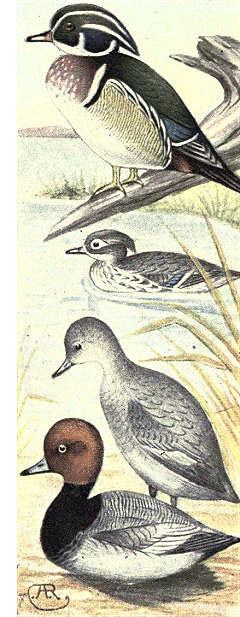
Wood Duck.
Redhead. 144. Wood Duck Aix sponsa.
Range.--Temperate North America, breeding
from Labrador and British Columbia south to
Florida.
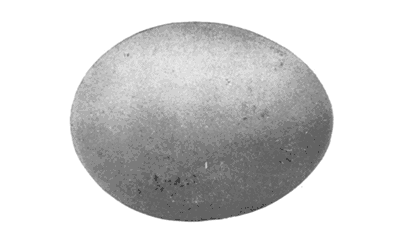
Rich buff. Bridal Duck is a name often given to this, the
most beautiful of all Ducks.
They are beautifully marked, have a large crest,
and are iridescent with all colors of the rainbow.
They frequent wooded country near ponds and
lakes, feeding on water insects and mollusks in
the coves. They build their nests in hollow trees
and stumps, often at quite a distance from the
water. When the young are a few days old, they
slide, scramble, or flutter down the tree trunk to
the ground below, and are led to the water. The
nest is made of twigs, weeds and grass, and warmly
lined with down. The eggs are a buff color
and number eight to fifteen. Size 2. × 1.5.
145. Rufous-crested Duck. Netta rufina.
A European species; a single specimen taken on Long Island in 1872.
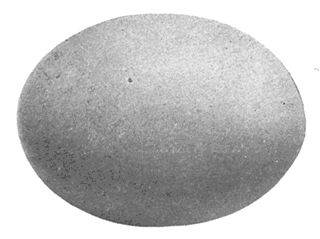
Buffy. 146. Redhead. Marila americana.
Range.--North America at large,
breeding from northern United
States northward, chiefly in the interior.
A bird commonly seen in the
markets where it is often sold as
the following species because of
their similarity. The nests are
placed on the ground in marshes or
sloughs, and are made of grasses,
lined with feathers. Eggs from
six to fourteen in number, of a
buffy white color. Size 2.40 × 1.70.
|

|
|
Page 96
|
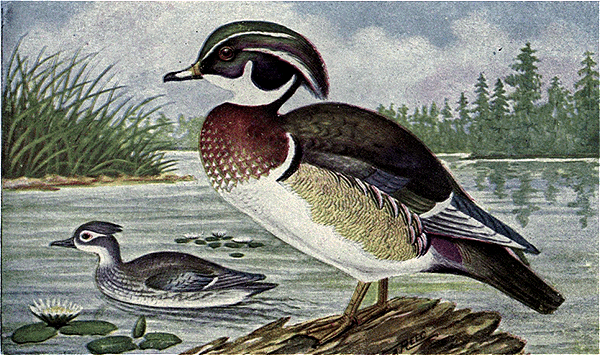
WOOD DUCK.
|
|
|
Page 97
|
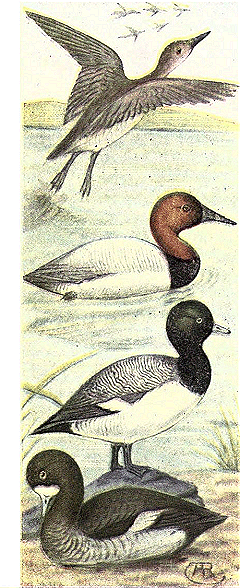
Canvas-back.
American Scaup Duck. 147. Canvas-back. Marila valisineria.
Range.--Whole of North America, breeding
chiefly in the interior from the United States to
the Arctic Ocean.
A noted table bird, especially in the south
where it feeds on wild celery. Can be distinguished
from the Redhead by its darker head, lighter
back, and gradually sloping bill. They nest abundantly
in Manitoba, their habits being the same as
the preceding. They lay from six to ten eggs of
a darker shade than the Red-heads. Size 2.40 ×
1.70. Data.--Haunted Lake, N. Alberta, June 12,
1897. Ten eggs. Nest of reeds in a heavy reed
bed out in the lake. Collector, Walter Raine.
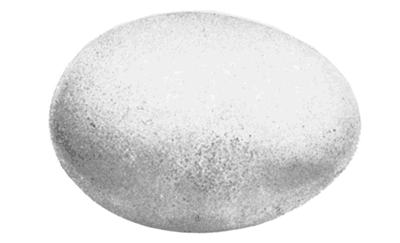
Pale greenish gray. 148. Scaup Duck. Marila marila.
Range.--North America, breeding from North
Dakota northward, chiefly in the interior; south
in winter to Central America.
This and the following species are widely known
as "Blue-bills" owing to the slaty blue color of
that member. Their plumage is black and white,
somewhat similar in pattern to that of the Redhead,
but darker, and the whole head is black.
They nest in marshes about many of the ponds and lakes in the interior of
British America. The nest is made of marsh grasses and lined with feathers.
The six to ten eggs are pale grayish or greenish gray. Size 2.50 × 1.70. Data.--
Saltcoats
Marshes, N. W. Canada, June 15, 1901. Ten eggs. Nest in the grass;
a depression lined with down and dried grasses. Collector, Walter Raine.

|

|
Page 98

|
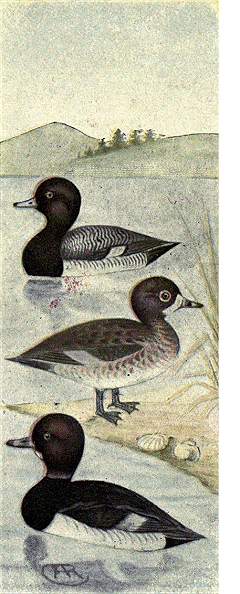
Lesser Scaup Duck.
Ring-necked Duck. 149. Lesser Scaup Duck. Marila affinis.
Range.--North America, breeding from North
Dakota and British Columbia northward; winters
south to Central America.
This Duck is distinguished from the preceding,
chiefly by its size which is about two inches less,
or 17 inches in length. The nesting habits are
the same as those of the Greater Scaup and the
eggs are similar but smaller. Size 2.25 × 1.55.
Data.--Northern Assiniboia, June 10, 1901. Ten
eggs on grass and down at the edge of a lagoon.
Collector, Walter Raine.
150. Ring-necked Duck. Marila collaris.
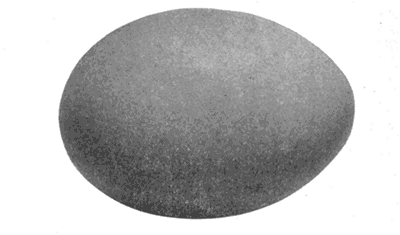
Lead gray. Range.--North America, breeding in the interior,
from North Dakota and Washington northward.
Winters from Maryland on the east and
British Columbia on the west to Central America.
Similar to the Lesser Scaup in size and plumage,
except that it has a narrow chestnut collar
around the neck, the back is black instead of
barred with white, and the speculum is gray instead of white. The habits and
nesting habits of the Ring-neck do not differ from those of the other Scaups.
They lay from six to twelve eggs. Size 2.25 × 1.60. Data.--Cape Bathurst,
N. Y. T., June 18, 1901. Ten eggs in a slight hollow in the moss, lined with
down. Collector, Captain Bodfish.

|
|
|
Page 99
|
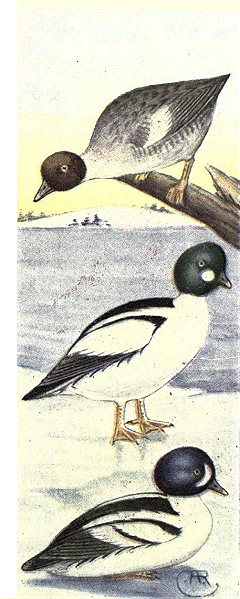
American Golden-eye.
Barrow Golden-eye. 151. Golden-eye. Clangula clangula
americana.
Range.--North America, breeding both on the
coast and in the interior, from the northern border
of the United States northward to the Arctic
Ocean.
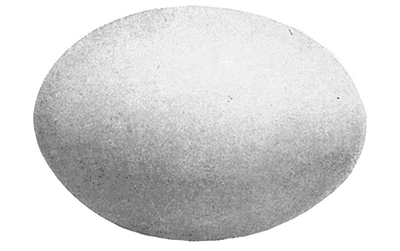
Grayish green. These are handsome Ducks known as "Whistlers"
from the noise of their wings when flying,
and "Greatheads" because of the puffy crest. The
head is greenish with a large round white spot in
front of, and a little below the eye. The rest of
the plumage is black and white. This species
nests in hollow trees near the water, lining the
cavity with grass, moss and leaves, and lining the
nest with down from their breasts. In May and
June they lay from six to ten eggs of a grayish
green color. Size 2.30 × 1.70.
152. Barrow's Golden-eye.
Clangula islandica.
Range.--Northern North America, breeding
north of the United States except from the mountainous
portions of Colorado northward.
This Golden-eye differs from the preceding chiefly in the shape of the white
spot before the eye, which in this species is in the form of a crescent. The
size is the same, about 20 inches in length. The reflections on the head are
purplish rather than greenish as in the preceding. The nesting habits are
the same, they building in hollow trees near water. The six to ten eggs are
not different from the preceding. Size 2.30 × 1.65. Data.--Alfusa, Iceland, June
30, 1900. Seven eggs. Nest of grass and down in a box attached to a tree by
an islander.

|

|
Page 100

|
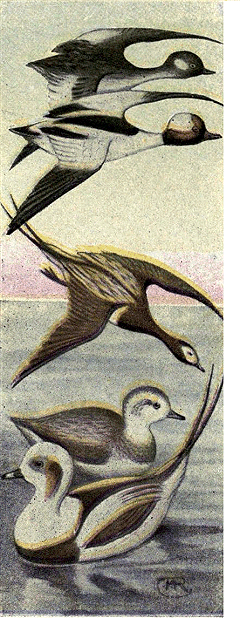
Buffle-head.
Old-squaw. 153. Buffle-head. Charitonetta albeola.
Range.--North America, breeding from United
States northward. Winters south to Mexico.

Dull buff. Gunners know this handsome little duck by
the names of "Butter-ball," and "Dipper," a name
also given to Grebes. It is also quite similar, but
smaller (15 in. long), to the American Golden-eye
but has a large white patch on the back of the
head, from eye to eye. It is an active bird and,
like the two preceding, is capable of diving to a
great depth to get its food. Its nesting habits
are like the preceding. Eggs eight to fourteen.
Size 2 × 1.40. Data.--Alberta, Canada, June 6,
1899. Seven eggs. Nest in hole in tree stump,
lined with down. Collector, Dr. George.
154. Old-squaw. Harelda hyemalis.
Range.--Northern Hemisphere, breeding in the
Arctic regions; south in winter to New Jersey
and Illinois.
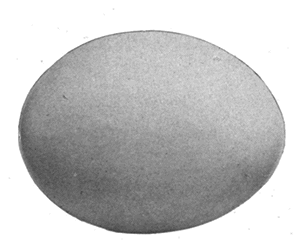
Buff. The Long-tailed Duck, as it is called,
is especially noticeable because the
breeding plumage of the male differs
markedly from that in the winter. In
summer their general plumage is blackish
brown, with a white patch around the
eye, and white belly. In winter they are
largely white. The central tail feathers
are much lengthened. They breed
abundantly in Greenland, Alaska and the
Hudson Bay Territory, placing their
nests of grasses and weeds on the ground
near the water. It is generally concealed
in the long grass. The eggs number
from six to twelve. Size 2. × 1.50. Data.--N.
Iceland, June 10, 1900. Nest on ground,
lined with down. Collector, S. H. Wallis.
|
|
|
Page 101
|
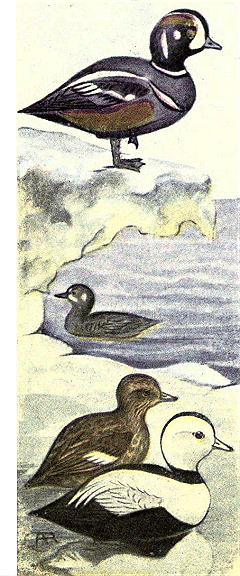
Harlequin Duck.
Labrador Duck. 155. Harlequin Duck. Histrionicus
histrionicus.
Range.--Northern Hemisphere in America,
breeding from Newfoundland and the Rocky
Mountains in Colorado, northward. South in winter
to California and New England.
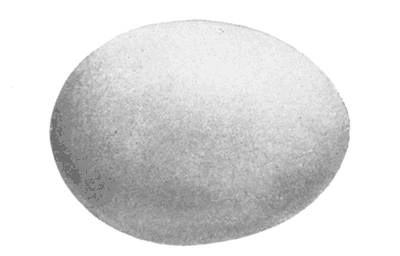
Greenish buff. A beautiful and most gorgeous bird, not in colors,
but in the oddity of the markings, the colors
only including black, white, gray and chestnut.
Either sex can be recognized by the small short
bill. They breed mostly in single pairs along
swiftly running streams, placing their nest, which
is woven of weeds and grasses, in the ground
near the water. It is also claimed that they sometimes
nest in hollow trees. They lay from five
to eight eggs, yellowish or greenish buff in color.
Size 2.30 × 1.60. Data.--Peel River, Alaska, June
13, 1898. Seven eggs in a hollow in river bank,
lined with down. Collector, C. E. Whittaker.
156. Labrador Duck. Camptorhynchus labradorius.
This bird, whose range was from Labrador to New Jersey in the winter,
has probably been extinct since 1875, when the last authentic capture was
made. It is a strange fact that a bird of this character should have been
completely exterminated, even though they were often sold in the markets.
Only forty-one specimens are known to be preserved at present and nothing
is known in regard to their nesting habits or eggs.
|

|
Page 102

|
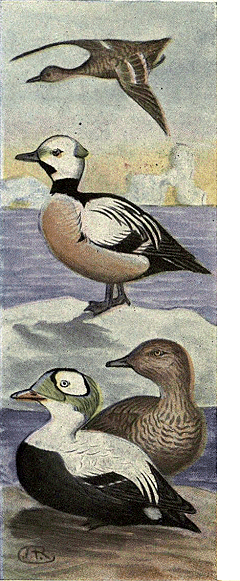
Steller's Duck.
Spectacled Eider. 157. Steller's Duck. Polysticta stelleri.
Range.--Arctic regions in America, chiefly on
the Aleutian Islands and northwest coast of
Alaska.
A very beautiful species eighteen inches long;
head white, washed with greenish on the forehead
and nape; chin, throat, neck, back, tail and
crissum, black; underparts chestnut; wing coverts
white, the long scapulars black and white.
It breeds on the rocky coasts and islands of
Bering Sea. The six to nine eggs are pale olive
green in color. Size 2.25 × 1.60. Data.--Admiralty
Bay, Alaska, June 22, 1898. Nest on a hummock
of the tundra, near a small pool, lined with
grass and down. Collector, E. A. McIlhenny.
158. Spectacled Eider. Arctonetta fischeri.
Range.--Coast of Alaska from the Aleutians
to Point Barrow.
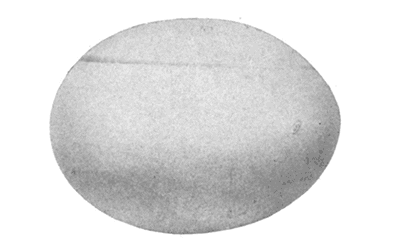
Pale olive green. Like the rest of the true Eiders, this species is black beneath and mostly
white above. The head is largely washed with sea green, leaving a large patch
of white, narrowly bordered by black around each eye, thus resembling a pair
of spectacles. The nests are made of grass and seaweed and lined with down;
they are placed on the ground in clumps of grass or beneath overhanging
stones. The five to nine eggs are an olive drab or greenish color. Size 2.70
× 1.85. Data.--Point Barrow, Alaska, June 15, 1898. Six eggs. Nest of moss
and down in a hollow in dry tundra. Collector, E. A. McIlhenny.
159. Northern Eider. Somateria mollissima borealis.
Range.--North Atlantic coast, breeding from Labrador to Greenland and
wintering south to New England.
A large Duck similar to the next species, but with the base of the bill
differing, as noted in the description of the following species, and with a more
northerly distribution. The nesting habits are the same as those of the other
Eiders. Six to ten eggs generally of a greenish drab color. Size 3. × 2.
|
|
|
Page 103
|
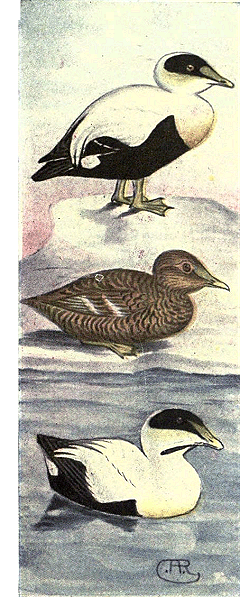
Eider.
Pacific Eider. 160. Eider. Somateria dresseri.
Range.--Atlantic coast, breeding from Maine to
Labrador and wintering south to Delaware.
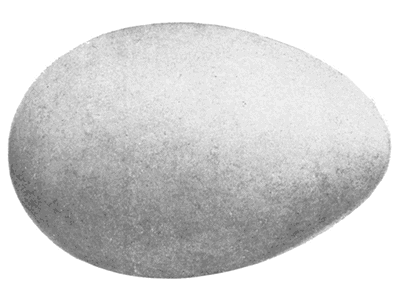
Greenish drab. This species differs from the preceding only in
the fleshy part of the base of the bill, which extends
back on each side of the forehead, it being
broad and rounded in this species and narrow and
pointed in the Northern or Greenland Eider. This
species, but more especially the Northern Eider,
are the ones chiefly used for the eider-down of
commerce. The preceding species is often semi-domesticated
in Greenland, the people protecting
them and encouraging them to nest in the neighborhood.
They make their nests of seaweed and
grass and warmly line it with down from their
breast; this down is continually added to the nest during incubation until
there is a considerable amount in each nest, averaging about an ounce in
weight. The birds are among the strongest of the sea ducks and get their food
in very deep water. Their flesh is not good eating. Their eggs number from
five to ten and are greenish drab. Size 3. × 2.
161. Pacific Eider. Somateria v-nigra.
Range.--North Pacific from the Aleutian Islands northward, and east to
Great Slave Lake.
This bird is, in plumage, like the Northern Eider, except that it has a black
V-shaped mark on the throat. They nest sparingly on the Aleutian Islands,
but in great numbers farther north on the coast about Point Barrow. Their
habits, nests and eggs are precisely the same as those of the eastern forms.
Their eggs number from five to ten and are of olive greenish color. Size 3. × 2.
Data.--Cape Smythe, Alaska, June 8, 1900. Eight eggs. Nest a hollow in the
moss, lined with grass and down.
|

|
Page 104

|
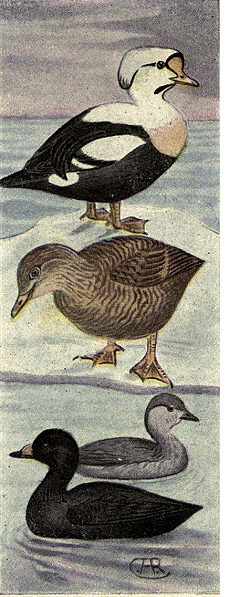
King Eider.
Scoter. 162. King Eider. Somateria spectabilis.
Range.--Northern Hemisphere, breeding in
America from Labrador to Greenland and the
Arctic Ocean; south in winter to the New England
States and rarely farther on the eastern
side, and to the Aleutians on the Pacific; also
casually to the Great Lakes in the interior.
A handsome and very different species from
any of the foregoing, having the crown ashy blue,
and the long scapulars black instead of white.
It also has a broad V-shaped mark on the throat.
Like all the other Eiders, the female is mottled
brown and black, the different species being very
difficult to separate. The nests are sunk in the
ground and lined with down. Eggs number from
six to ten. Size 2.80 × 1.80. Data.--Point Barrow,
Alaska, July 5, 1898. Five eggs. Nest a hollow
in the moss on tundra lined with moss and down.
Collector, E. A. McIlhenny.
163. Scoter. Oidemia americana.
Range.--Northern North America, breeding
from Labrador, the Hudson Bay region and the
Aleutian Islands northward; winters south to
Virginia, the Great Lakes and California.
Scoters or "Coots" as they are generally called
are sea ducks whose plumage is almost wholly
black; they have fantastically colored and shaped
bills. The American Scoter is entirely black
without markings; base of bill yellow and orange.
This species nest as do the Eiders, often concealing
the nest, of grass and feathers, under some
overhanging rock. They lay from six to ten eggs
of a dingy buff color. Size 2.50 × 1.70. Data.--Mackenzie
Bay, June 15, 1899. Ten eggs. Nest
a hollow in the sand, lined with down.
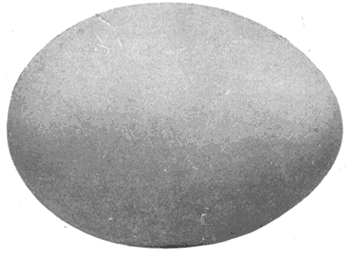
Buff.
|
|
|
Page 105
|
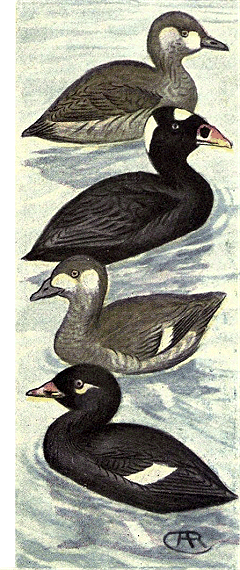
Surf Scoter.
White-winged Scoter. 164. Velvet Scoter. Oidemia fusca.
An Old World species that has accidentally occurred
in Greenland.
165. White-winged Scoter. Oidemia deglandi.
Range.--Abundant in North America, breeding
from Labrador, North Dakota and British Columbia,
northward. Wintering south to the Middle
States, southern Illinois and southern California.
The largest of the Scoters, length 22 inches,
distinguished by a large white speculum on the
wing, also a white comet extending from under
the eye backwards. It also has a yellow eye.
Like the other Scoters, this species often feeds
in very deep water. They are strong, active diving
birds, and are also strong on the wing, generally
flying close to the surface of the water.
Their flesh is not regarded as good eating, although
they are often sold for that purpose. They
nest on the ground, generally in long grass or
under low bushes making a coarse nest of
grasses, and sometimes twigs, lined with feathers.
They lay from five to eight eggs of a pale buff
color. Size 2.75 × 1.85.
166. Surf Scoter. Oidemia perspicillata.
Range.--Northern North America, breeding
north of the United States boundary, and wintering
south to Virginia and southern California.
The male of this species is entirely black, except
for the white patches on the forehead and
nape, and the vari-colored bill of black, white,
pink and yellow. They nest either along the
coast or in the interior, building a nest lined
with down, in the marsh grass bordering small ponds. They lay from five to
eight buffy cream colored eggs. Size 2.40 × 1.70. The females of all the
Scoters are a dingy brownish color, but show the characteristic marking of the
species, although the white is generally dull or sometimes mottled. Data.--Mackenzie
River, June 25, 1894. Six eggs in a nest of down on an island in the
river.

|

|
Page 106

|
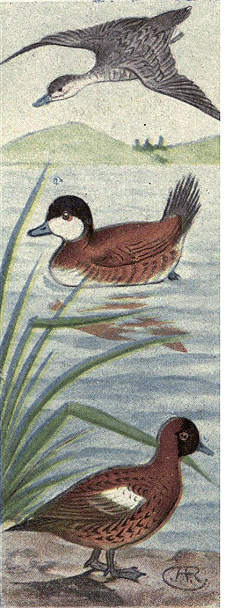
Ruddy Duck.
Masked Duck. 167. Ruddy Duck. Erismatura jamaicensis.
Range.--Whole of North America, breeding
chiefly north of the United States border except
locally on the Pacific coast. Winters along the
Gulf and through Mexico and Central America.
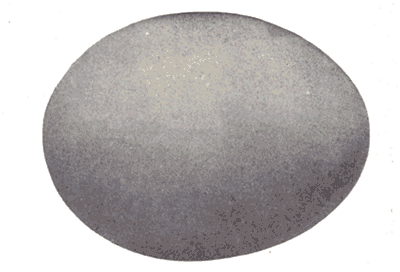
Grayish white. This peculiar species may always be recognized
by the brownish or chestnut upper parts, blackish
crown, white cheeks and silvery white underparts.
The bill is very stout and broad at the end, and
the tail feathers are stiff and pointed like those
of a Cormorant. They build their nests in low
marshy places, either placing them on the
ground near the water or in the rushes over it.
Their nests are made of rushes and grasses,
sometimes lined and sometimes not, with down
from the parents breast. The eggs number from
six to twelve and are grayish in color. Size 2.40
× 1.75. Data.--Northern Assiniboia, Canada, June
6, 1901. Eight eggs. Nest made of aquatic
grasses, lined with down. Built in a tuft of rushes
in a marsh. Collector, Walter Raine.
168. Masked Duck. Nomonyx dominicus.
This is a tropical species which is resident in Mexico, Central America and
in the West Indies. It occurs in Mexico north to the lower Rio Grande Valley
and has in three known instances strayed to northern United States. The
general plumage is a rusty chestnut, mottled with blackish, it has a black face
and throat, with white wing bars.

|
|
|
Page 107
|
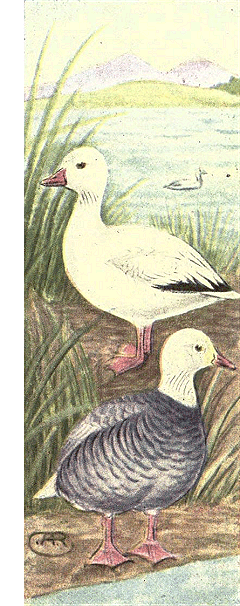
Lesser Snow Goose.
Blue Goose. 169. Snow Goose. Chen hyperboreus
hyperboreus.
Range.--North America west of the Mississippi
Valley, breeding in northern Alaska and the MacKenzie
River district.
This smaller species of the Snow Goose nests
on islands in rivers along the arctic coast. The
nest is a depression in the ground, lined with
grasses and, occasionally down. They lay from
four to eight eggs of a buffy or yellowish white
color. Size 2.75 × 1.75.
169a. Greater Snow Goose. Chen hyperboreus nivalis.
Range.--Eastern North America, breeding in
the Arctic regions and wintering chiefly on the
Atlantic coast, south to Cuba.
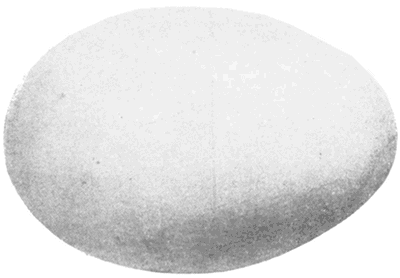
Grayish White. This bird is like the preceding; except in size;
about thirty-six inches, instead of twenty-six inches in length as is the lesser
variety. The entire plumage is white except for the black primaries. They
construct their nests of grasses on the ground the same as the preceding variety.
The eggs number from five to eight and are cream colored. Size 3.40 ×
2.40.
169.1. Blue Goose. Chen cærulescens.
Range.--North America, principally in the interior, breeding from Hudson
Bay northward and wintering along the Gulf coast.
This species may always be recognized by the entirely white head and neck,
the body being grayish or bluish gray. They nest on the ground as do the
other geese laying from four to eight eggs of a brownish buff color. Size 2.50
× 1.75. Data,--Cape Bathurst, Arctic coast, June 29, 1899. Four eggs laid in a
depression lined with grass, on an island. Collected with the parent birds by
the Esquimaux.
|

|
Page 108

|

Ross Snow Goose.
American White-fronted Goose. 170. Ross's Snow Goose. Chen rossi.
Range.--This beautiful species, which is similar
in plumage to the large Snow Goose, is but
twenty-one inches in length. It breeds in the extreme
north, and in winter is found in the western
part of the United States as far south as the
Gulf of Mexico. Their nesting habits and eggs
probably do not differ from others in the family
except in the matter of size.
171. White-fronted Goose. Anser albifrons
albifrons.
This European species is exactly like the American
except that it is said to average a trifle
smaller. It is occasionally found in Greenland.
171a. American White-fronted Goose.
Anser albifrons gambeli.
Range.--Whole of North America, breeding in
the Arctic regions and wintering south to the
Gulf coast; not common on the Atlantic coast
during migrations.
These birds may be recognized by their mottled
plumage, dark head and white forehead. This
species is more abundant than any of the preceding
and nests in large colonies along the arctic
coast and in Alaska. Their nests are made of
dried grasses, feathers and down and are placed
on the ground in a slight depression. From
four to nine eggs are laid; these have a dull buff
ground. Size 3.00 × 2.05. Data.--Island in delta
of Mackenzie River, June 10, 1899. Four eggs.
Nest of grass and feathers on the ground on a
small island. Collector, Rev. I. O. Stringer.
[Illustration z110: ]
171.1. Bean Goose. Anser fabalis.
This European species is casually found in Greenland. It is one of the
most common of the Old World Species.

|
|
|
Page 109
|

Canada Goose.
Cackling Goose. 172. Canada Goose. Branta canadensis
canadensis.
Range.--The whole of North America, breeding
from northern United States northward, and wintering
in the southern parts of the United States.
This species is the most widely known of American
Geese and is the most abundant. Its familiar
"honk" has long been regarded as the signal of
the coming of spring, and the familiar V-shaped
formation in which the flocks migrate is always
an object of interest to everyone. With the exception
of in North Dakota and Minnesota, they
breed chiefly north of the United States. They
construct quite a large nest of weeds and grass,
and warmly line it with down and feathers.
They lay from four to nine eggs of a buff or drab
color. Size about 3.50 × 2.50. Data.--Ellingsars
Lake, North Dakota, May 18, 1896. Five eggs.
Nest on an island in the lake, constructed of
weeds and trash, and lined with a few feathers.
Collector, Edwin S. Bryant.
172a. Hutchins Goose. Branta canadensis
hutchinsi.
This sub-species is like the preceding except
that it is smaller, thirty inches in length. It is
a western variety, breeding in Alaska and along
the Arctic coast and wintering to southern California.
Its breeding habits, nests and eggs are
the same as the common goose except that the
eggs are smaller. Size 3.00 × 2.05.
172b. White-cheeked Goose. Branta canadensis occidentalis.
This bird is about the same size as the Canada
Goose and the plumage is very similar except
that the black sometimes extends on the throat,
thereby isolating the white cheek patches, and
there is a white collar below the back of the neck. It is a western species,
breeding in Alaska and wintering along the Pacific coast of the United States.
Its nesting habits and eggs are same as those of the Canada Goose except that
the latter are a trifle smaller.
172c. Cackling Goose. Branta canadensis minima.
This bird is really a miniature of the Canada Goose, being but twenty-four
inches in length. It breeds in Alaska and along the Arctic coast and migrates
into the western parts of the United States. They are abundant birds in their
breeding range, where they place their nests upon the shores of ponds, or on
islands in inland rivers or lakes. The nests are made of weeds and grasses,
lined with down. The eggs which are buff colored, number from four to nine
and are laid during June and July. Size 2.30 × 1.95.
|

|
|
Page 110
|

CANADA GEESE.
|
|
|
Page 111
|
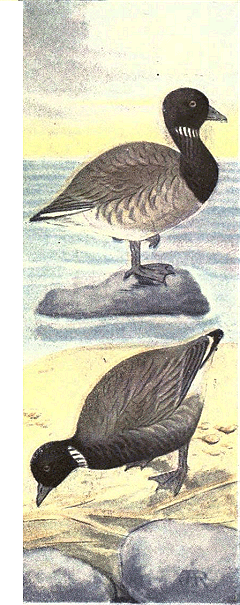
Brant.
Black Brant. 173. Brant. Branta bernicla glaucogastra.
Range.--Eastern North America, breeding in the
Arctic regions and wintering in the United States
east of the Mississippi.
The Brant resembles a small Canada Goose,
except that the black of the neck extends on the
breast, and only the throat is white. They are
one of the favorite game birds and thousands are
shot every fall and spring. Their nests and eggs
are the same as the next species.
174. Black Brant. Branta nigricans.
Range.--Western North America, breeding in
Alaska and wintering on the Pacific coast of the
United States. Rare east of the Mississippi.
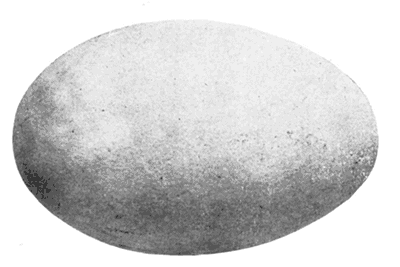
Grayish. This species is like the last except that the
black extends on the under parts. This species
nests very abundantly in northern Alaska, laying
their eggs in a depression in the ground, lined with down. Favorite locations
are the many small islets in ponds and small lakes. They lay from four to
eight grayish colored eggs. Size 2.80 × 1.75. Data.--Cape Bathurst, North
West Territory, Junes 22, 1901. Seven eggs in a small hollow in the ground,
lined with down. Collector, Capt. H. H. Bodfish.
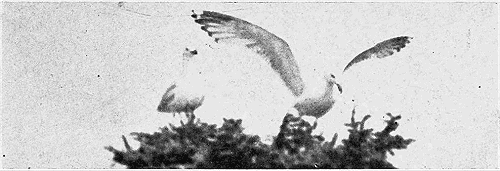
|

|
Page 112

|
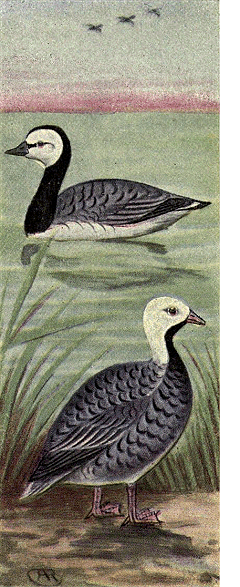
Barnacle Goose.
Emperor Goose. 175. Barnacle Goose. Branta leucopsis.
This Old World species occurs frequently in
Greenland and very rarely is found on the mainland
of this continent.
176. Emperor Goose. Philacte canagica.
Range.--Alaska, south in winter casually to California.
This handsome species is twenty-six inches in
length; it may be known from the mottled or
"scaly" appearance of the body, and the white
head with a black chin and throat. While not uncommon
in restricted localities, this may be considered
as one of the most rare of North American
Geese. Their nests are built upon the ground
and do not differ from those of other geese. They
lay from three to seven eggs of a dull buff color.
Size 3.10 × 2.15. Data.--Stuart Island, Alaska,
June 16, 1900. Six eggs laid in a slight hollow in
the ground, lined with a few feathers and some
down. Collector, Capt. H. H. Bodfish.
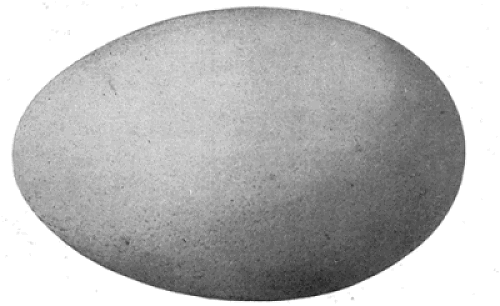
Egg of Canada Goose--Buffy drab.
|
|
|
Page 113
|
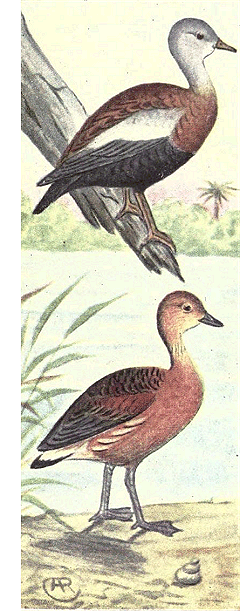
Black-bellied Tree duck.
Fulvous Tree-duck. 177. Black-bellied Tree-duck. Dendrocygna
autumnalis.
Range.--Tropical America, north in the Rio
Grande Valley to southern Texas.
These peculiar long-legged Ducks are very
abundant in southern Texas during the summer
months. They build their nests in hollow trees,
often quite a distance from the water. They lay
their eggs upon the bottom of the cavity with
only a scant lining, if any, of feathers and down.
They are very prolific breeders, raising two broods
in a season, each set of eggs containing from ten
to twenty. These eggs are creamy or pure white,
size 2.05 × 1.50. The first set is laid during the
latter part of April or early in May, and fresh
eggs may be found as late as July. They are
especially abundant about Brownsville and Corpus
Christi, Texas. Data.--Hidalgo, Mexico, May 29,
1900. Ten eggs in a hole in an old elm tree on
side of lake in big woods near town. Eight feet
from the ground. Collector, F. B. Armstrong.
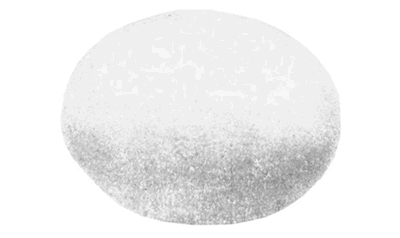
White. 178. Fulvous Tree-duck. Dendrocygna bicolor.
Range.--This species is tropical like the last, but the summer range is extended
to cover, casually the whole southwestern border of the United States.
This bird is long-legged like the last, but the plumage is entirely different,
being of a general rusty color, including the entire under parts. The nesting
habits and eggs are the same as those of the Black-bellied Duck, the white eggs
being laid at the bottom of a cavity in a tree. They number from eight to (in
one instance) thirty-two eggs in one nest. This species is nearly as abundant
as the preceding in southern Texas.

|

|
Page 114

|
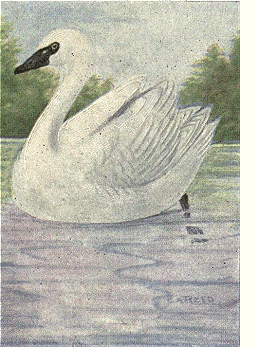
Whistling Swan. 179. Whooper Swan. Olor cygnus.
This European variety frequently is found in
Greenland and formerly, regularly bred there.
It nests in secluded swampy places in northern
Europe.
180. Whistling Swan. Olor columbianus..
Range.--North America, breeding in the Arctic
Circle, and wintering south to the Gulf of
Mexico.
These birds, which are nearly five feet in
length, are snow white with the exception of
the black bill and feet. The Whistling Swan
is distinguished from the next species by the
presence of a small yellow spot on either side
of the bill near its base. Their nests are made
of a large mass of rubbish, weeds, grass, moss,
feathers and occasionally a few sticks. It is
generally placed in a somewhat marshy place
in the neighborhood of some isolated pond.
The eggs are of a greenish or brownish buff
color, and number from three to six. Size 4.00
× 2.75. Data.--Mackenzie River. Nest a mass
of weeds, sods and grass, lined with feathers;
on an island near the mouth of the river. Collector,
I. O. Stringer.
181. Trumpeter Swan. Olor buccinator.
Range.--Interior of North America from the Gulf of Mexico northward, breeding
from northern United States northward.
This is a magnificent bird, about five and one-half feet in length. Its plumage
is exactly like that of the preceding except that the bill is entirely black,
and the nostril is located nearer the eye. Their nesting habits and eggs are
the same as those of the Whistling Swan. While a few pairs may breed within
the United States by far the greater number are found in the extreme north,
from Hudson Bay to Alaska. The eggs may average a trifle larger than those
of the preceding species.

|
|
|
Page 115
|
LAMELLIROSTRAL GRALLATORES. Order VI. ODONTOGLOSSÆ
FLAMINGOES. Family PHOENICOPTERIDAE
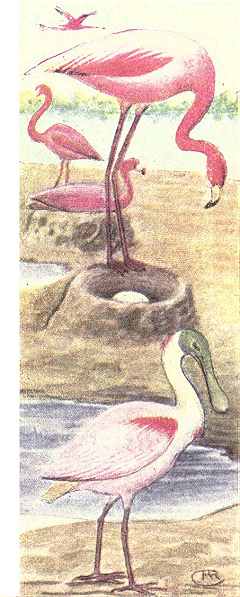
American Flamingo.
Roseate Spoonbill. 182. Flamingo. Phœnicopterus ruber.
Range.--Tropical and sub-tropical America on
the Atlantic coasts, breeding in the Bahamas and
West Indies; north to Florida and casually to the
South Atlantic States.
These remarkable and grotesque appearing
birds attain a length of about 48 inches. The
plumage varies from white to a deep rosy red. It
requires several years for them to attain the perfect
adult plumage, and unlike most birds, they
are in the best of plumage during the winter, the
colors becoming faded as the nesting season approaches.
The birds are especially noticeable because
of the crooked, hollow, scoop-shaped bill,
and the extremely long legs and neck. The feet
are webbed, but more for the purpose of supporting
them upon the mud flats than for use in swimming.
The nests are usually built on a sandy
point of an island; they are mounds of earth, grass
and rubbish from one to two feet in height, the
top being hollowed to receive the eggs. One or
two eggs are a complete set. The shell is pale
blue, but this is covered with a heavy white chalky
deposit. The eggs are laid in June and July.
Size 3.40 × 2.15.
IBISES, STORKS, HERONS, etc. Order VII. HERODIONES
The members of this order are wading birds, consequently they all have
long legs and necks. They have four toes, not webbed.
SPOONBILLS. Family PLATALEIDAE
183. Roseate Spoonbill. Ajaia ajaja..
Range.--Tropical America, north in summer to the Gulf States. They formerly
nested in remote swamps along the whole Gulf coast, but are now confined
chiefly to the Everglades in Florida.
|

|
Page 116

|
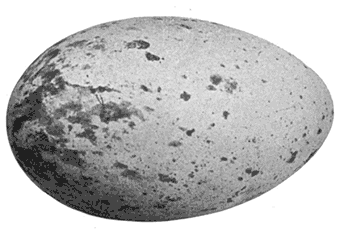
Pale greenish blue. This bird, with its broad, flat bill, bare head, and rosy plumage with carmine
epaulets and tail coverts, seem more like the fanciful creation of some artist
than a real bird of flesh and blood. Its plumage and colors are strikingly clear
and beautiful. Full plumaged
adult birds have very brilliant
carmine shoulders and tail coverts,
a saffron colored tail, and a
lengthened tuft of bright rosy
feathers on the foreneck. This
species breed in small colonies
in marshy places, often in company
with herons and ibises.
Their nests are rather frail platforms
of sticks, located in bushes
or trees, from four to fifteen
feet from the ground. The eggs
are laid during the latter part
of May and June. They are
three or four in number and
have a ground color of dull
white, or pale greenish blue and
are quite heavily blotched with several shades of brown. Size 2.50 × 1.70.
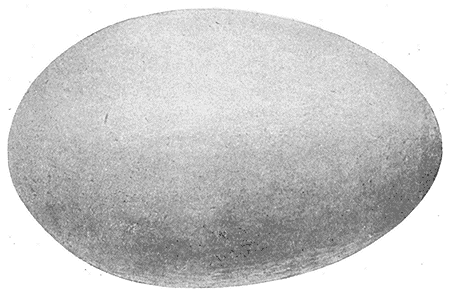
Chalky bluish white.
Egg of American Flamingo.

|
|
|
Page 117
|
IBISES. Family IBIDIDÆ
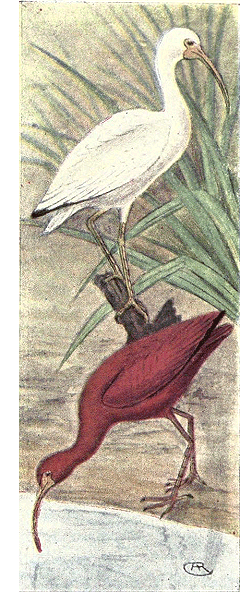
White Ibis.
Scarlet Ibis. Ibises are gracefully formed birds having a long
curved bill and a bare face.
184. White Ibis. Guara alba.
Range.--This is a tropical and sub-tropical
species which is found along the Gulf coast, and
north to South Carolina, west to Lower California.
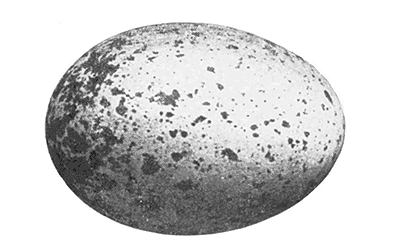
Grayish. These handsome birds are wholly white, with
the exception of black primaries. The legs and
the bare skin of the face is orange red. These
birds are very abundant in most marshy localities
along the Gulf coast, especially in Florida, where
they nest in rookeries of thousands of individuals.
Owing to their not having plumes, they have not
been persecuted as have the white herons. They
build their nests of sticks and grasses, in the
mangroves a few feet above the water. In other
localities they build their nests entirely of dead
rushes, attaching them to the standing ones a foot or more above the surface
of the water. They are quite substantially made and deeply cupped, very different
from the nests of the Herons. Their eggs are from three to five in number,
vary from grayish ash to pale greenish or bluish in color, blotched with
light brown. Size 2.25 × 1.60. The nesting season is during May and June.
Data.--Tampa Bay, Fla., June 4, 1895. Three eggs. Nest of sticks and a few
weeds in small bushes on an island. Collector, Fred Doane.
185. Scarlet Ibis. Guara rubra..
Range.--Occasionally, but not recently met with in the southern states.
Their habitat is tropical America, they being especially abundant along the
Orinoco River in northern South America.
Full plumaged adults of this species are wholly bright scarlet, except for the
primaries, which are black. Their nests are built in impenetrable thickets,
rushes or mangroves, the nests being constructed like those of the White Ibis.
The eggs, too, are very similar to those of the preceding species, but both the
ground color and the markings average brighter. While still common in some
localities, the species is gradually becoming less abundant, chiefly because of
the demand for their feathers for use in fly-tying.
|

|
Page 118

|
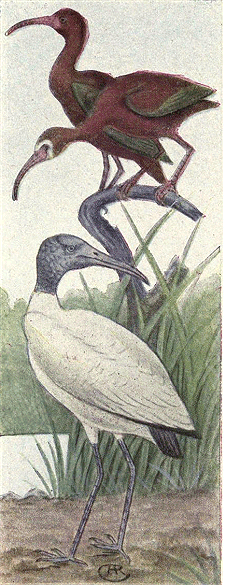
Glossy Ibis.
White-faced Glossy Ibis.
Wood Ibis. 186. Glossy Ibis. Plegadis autumnalis..
Range.--This tropical and sub-tropical species,
is chiefly found in the Old World. It is occasionally
found in southeastern United States where it
sometimes breeds. Its habits, nesting habits and
eggs are just the same as the next species.
187. White-faced Glossy Ibis. Plegadis guarauna.
Range.--A sub-tropical species found in the
southwestern parts of the United States, rarely
found east of the Mississippi.
This species differs from the Glossy Ibis in
having the feathers on the front of the head white,
the rest of the plumage is a dull brownish chestnut,
with greenish reflections on the back. As
these birds are not in demand commercially, their
numbers have not decreased, and thousands of
them breed in colonies in southern Texas. They
build a substantial nest of reeds and rushes woven
about the upright canes, close to the surface of the
water. Their eggs are laid during May, and number
from three to four. They are easily distinguished
from those of the Herons, being of a
deeper greenish blue color and averaging more
elongate. Size 1.95 × 1.35. Data.--Corpus Christi,
Texas, May 26, 1899. Four eggs. Nest of twigs
and rushes on side of river. Collector, F. B.
Armstrong.
STORKS and WOOD IBISES
Family CICONIIDAE
188. Wood Ibis. Mycteria americana.
Range.--A sub-tropical species which is resident along the Gulf coast and
which strays casually north to New England and Colorado.
This peculiar member of the Stork family has the whole head and part of the
neck bare and covered with numerous scales; the bill is large, long and heavy;
the plumage is white, except for the black primaries and tail. It is a large
bird about four feet in length. They are quite abundant in swamps along the

|
|
|
Page 119
|
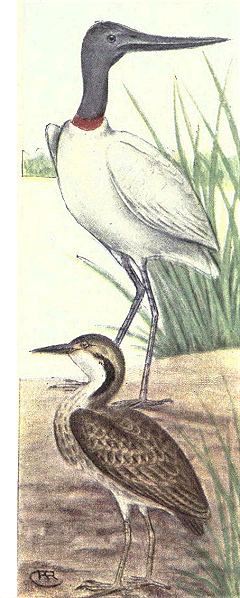
Jabiru.
Bittern. Gulf coast, where they place their nests, which
are platforms of sticks, in trees and bushes over
the water. They lay three eggs which are white,
and have a rough surface. Size 2.75 × 1.75.
189. Jabiru. Jabiru mycteria.
This large bird, which is the only true Stork
that claims a place in our avifauna, is a native
of South and Central America, wandering north,
casually to Texas. Their nests are large platforms
of sticks in very high trees.
BITTERNS and HERONS
Family ARDEIDAE
Herons and Bitterns are long-legged waders,
having straight, pointed bills, and with the head
feathered, except for the lores.
190. Bittern. Bautaurus lentiginosus.
Range.--United States and southern British
provinces, breeding in the northern half of the
United States and wintering in the southern portion.

Brownish drab. This species, with its mottled rusty brownish plumage, is one of the best
known of the Heron family. It is known locally by a great many names, nearly
all of which have reference to the "booming" or "pumping" sound made during
the mating season. They build their nests in swampy or marshy places, placing
them on the ground, frequently on a tussock, entirely surrounded by water.
The nest proper is only a few grasses twisted about to form a lining to the
hollow. They lay from three to five eggs of brownish drab. Size 1.95 × 1.50.
They do not breed in colonies, generally, but one or two pairs nesting in one
marsh. Data.--Worcester, Mass., June 3, 1897. Four eggs laid in a grass lined
hollow in middle of a hummock of earth and grass, in middle of marsh. Collector,
James Jackson.

|

|
Page 120

|
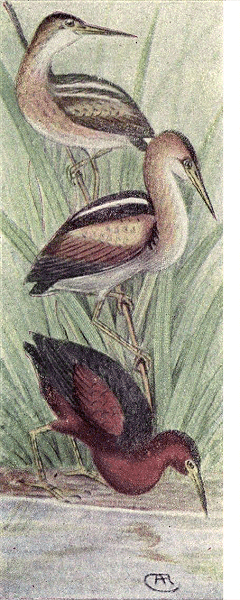
Least Bittern.
Cory's Least Bittern. 191. Least Bittern. Ixobrychus exilis.
Range.--Common throughout the United States,
especially in the eastern part, and in the southern
British provinces.
This small variety of Bittern is very common
in the southern portions of the United States, but
less so and locally distributed in the northern
portions of its range. They are very quiet and
sly birds, and their presence is often unsuspected
when they are really quite abundant. When approached,
they will remain
perfectly quiet, with
the body erect and the
head and neck pointed
skyward, in which position
their yellowish
brown plumage strongly
resembles the rushes
among which they are
found. Their nests are
made of strips of rushes
woven about upright
stalks, generally over water. They lay from
three to five eggs of a pale bluish white color.
Size 1.20 × .90. Data.--Avery's Island, La., May 1,
1896. Four eggs. Nest of strips of rushes woven
together to form a platform and fastened to saw
grass growing on the bank of a stream. Collector,
E. A. McIlhenny.
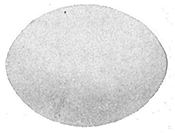
Pale bluish gray. 191.1. Cory's Least Bittern. Ixobrychus
neoxenus.
This rare species, of which about twenty specimens
are known is probably resident in Florida,
wandering north in the summer, specimens having
been taken in Ontario, Canada, and in several
localities in eastern United States. It is very different from the Least Bittern,
having a more uniform chestnut coloration, especially on the under parts. It is
twelve inches in length. Mr. C. W. Crandall has a set of five eggs of this
species, taken on the Caloosahatchee River, Fla., April 15, 1891, by S. B. Ladd.
Nest was made of grasses and rushes placed in the cane two feet above the
water.

|
|
|
Page 121
|

Great White Heron.
Great Blue Heron. 192. Great White Heron. Ardea occidentalis.
Range.--This species occurs in the United
States regularly, only in the southern parts of
Florida. It is a resident of the West Indies.
This large white Heron is about the same size
as the Great Blue Heron; it has none of the
slender plumes found on the smaller White Herons.
These birds are not uncommon in southern
Florida, especially on the Keyes, where they build
their nests in company with Great Blue Herons.
Their nesting habits and eggs are very similar
to those of the Blue Heron. Size of eggs 2.25 ×
1.80. Data.--Outside of Torch Key, Florida, June
16, 1899. Nest a platform of sticks about five feet
from the ground, in a mangrove tree. Three eggs.
Collector, O. Tollin.
194. Great Blue Heron. Ardea herodias herodias.
Range.--Nearly the whole of North America,
except the extreme north; resident south of the
middle portions of the United States and migratory
north of there.
This handsome Heron is about four feet in
length. Its general color is a bluish gray, relieved
by a black crest, primaries and patches on the
sides, and a white crown. In the south they breed
in large colonies, often in company with many
other species. In the northern portions of their
range they breed singly or in companies of under
a hundred individuals. They generally place
their rude platforms of sticks well up in trees,
near ponds, swamps or rivers, but in the most
northerly parts of their range, where trees are
scarce, they often build on the ground. Unless
they are disturbed, they return to the same breeding
grounds, year after year. They lay from three to five eggs of a greenish
blue color. Size 2.50 × 1.50. Data.--Duck Island, Maine, May 20, 1883. Three
eggs. Nest of sticks and twigs, about fifteen feet from the ground. Collector,
R. B. Gray.
194a. Northwest Coast Heron. Ardea herodias fannini.
This darker sub-species of the breeding is found along the Pacific coast,
north to Sitka, Alaska. Its nests and eggs do not differ from the former
species.

|

|
Page 122

|
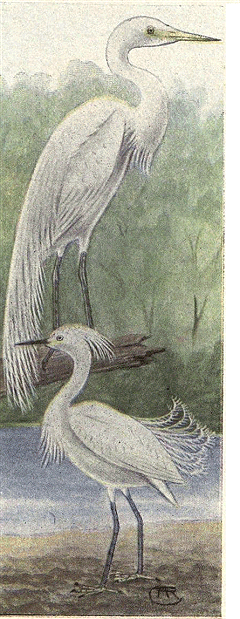
Snowy Egret.
Egret. 194b. Ward's Heron. Ardea herodias wardi.
This sub-species is a resident in Florida. It is
a lighter variety than the common. It nests together
with the Great Blue Heron and its habits
are the same.
195. European Heron. Ardea cinerea.
This species is only an accidental straggler in
Greenland. It is very similar to our Blue Heron
and is the one which was formerly used to furnish
sport for the royalty when falconry was at
its height.
196. Egret. Herodias egretta.
Range.--Resident in the southern portions of
the United States, straggling northward casually
to the northern parts.
This is one of the beautiful Herons which have
been sought by plume hunters till they are upon
the verge of extermination. They are entirely
white, with a long train of beautiful straight
"aigrettes" flowing from the middle of the back.
In remote localities, quite large colonies of them
may still be found, but where they numbered
thousands, years ago, they can be counted by
dozens now. They breed in impenetrable swamps,
very often in company with the following species,
and also with Louisiana and Little Blue
Herons, and White Ibises. Their nests are but
frail platforms, generally in bushes over the
water. Their usual complement of eggs numbers
from three to five, four as the most common number.
They are generally laid during the latter
part of May, but often on account of their being
disturbed, nests with eggs may be found in July.
The eggs are a light bluish green in color. Size
2.25 × 1.45. Data.--Gainesville, Florida, April 14, 1894. Four eggs on a platform
of sticks and grass, in a button-wood bush over six feet of water. Collector,
George Graham.
197. Snowy Egret. Egretta candidissima candidissima.
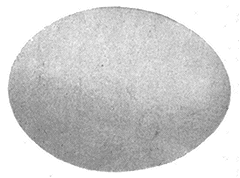
Light greenish blue. Range.--Common now only in restricted localities
in the Gulf States and Mexico.
This species, which is smaller than the last,
being but twenty-four inches in length, is also
adorned with "aigrettes," but they are beautifully
recurved at the tips. Owing to the merciless
slaughter to which they have been subjected,
their ranks have been woefully decimated,
and it is to be hoped that the remaining
ones may be safely protected. Their nesting
habits are the same as the last, although, of
course, the eggs are smaller. Size 1.80 × 1.25.
|
|
|
Page 123
|
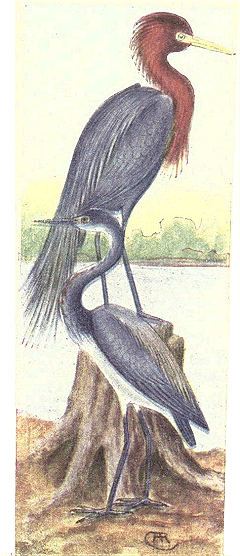
Reddish Egret.
Louisiana Heron. 198. Reddish Egret. Dichromanassa rufescens.
Range.--In the United States, this species is
confined chiefly to the Gulf States.
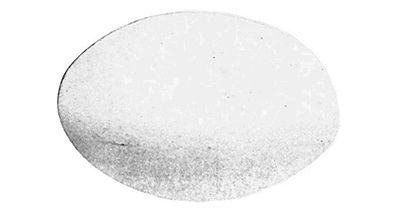
Pale bluish green. It is somewhat larger than the last species, the
head and neck are rufous, the body is bluish gray,
and the back is adorned with slender gray plumes.
It also has a white phase. This Egret is very
abundant along the whole Gulf coast, but especially
so in Texas. Their nesting habits are identical
with those of the other small Herons and
Egrets. The three or four eggs are rather of a
more greenish blue than the preceding. Size 1.90
× 1.45. Data.--Gainesville, Florida, April 14, 1894.
Three eggs. Nest of sticks and straw in a button-wood
tree, two feet above the water. Collector,
George Graham.
199. Louisiana Heron. Hydranassa tricolor
ruficollis.
Range.--Sub-tropical America, north regularly
to the Gulf States and casually farther.
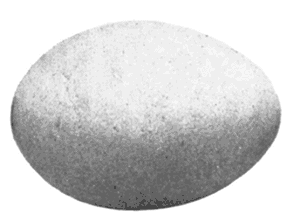
Pale bluish green. This Heron is of about the size of the Reddish
Egret, but the neck is longer, more slender and
dark, while the chin, throat and underparts
are white. The plumes from the back are
short, reaching barely to the end of the
tail. They nest in large colonies in company
with Egrets and Little Blue Herons,
placing their nests in the mangroves, only
a few feet above the water. Their nests are
the same as those of the other species, a
slight platform of sticks, and the three to
five eggs are practically not distinguishable
from those of the Snowy or Little Blue
Herons. Size 1.75 × 1.35.
|

|
Page 124

|
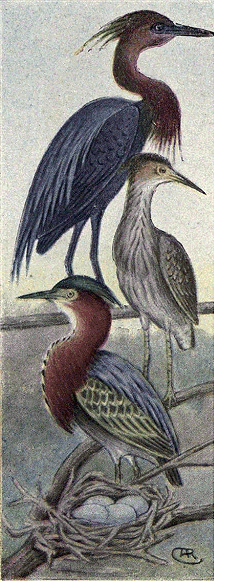
Little Blue Heron.
Green Heron. 200. Little Blue Heron. Florida cærulea.
Range.--South Atlantic and Gulf coasts, north
casually to New England and Manitoba; west to
Kansas and Nebraska.
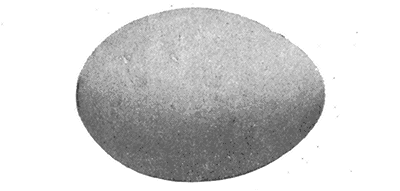
Pale bluish green. A smaller species than the preceding, length
22 inches, plumage a uniform slaty blue changing
to purplish red on the head and neck. They
also have a white phase, but always show traces
of the slaty blue, especially on the primaries.
Young birds are always white. They breed in
immense rookeries during April and May. Their
nesting habits and eggs are very similar to the
last species, although the eggs average a trifle
smaller. Size 1.75 × 1.25. Data.--Avery's Island,
Louisiana, April 21, 1896. 5 eggs. Nest a flat
and frail platform of twigs in a Mimosa tree
growing in floating turf, over deep water in a
large swamp. Collector, E. A. McIlhenny.
201. Green Heron. Butorides virescens
virescens.
Range.--Temperate and sub-tropical America,
breeding north to the British Provinces.
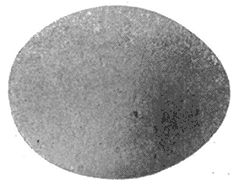
Light bluish green. This is the smallest of our Herons, and is well known all over the country.
Sometimes they breed in numbers in rookeries, in company with the larger
Herons, but in most sections of the country they will be found nesting, one or
two pairs together, along the border of some
swamp or stream. They have a greater diversity
of building sites, than do any of the other Herons
and frequently nest a long ways from water.
Their nests may be found in alders, birches or
even apple trees. It is the usual Heron type of
platform, upon which the three to six eggs are
laid. They are a pale greenish blue in color, and
measure 1.45 × 1.10. Data.--Avery's Island, Louisiana,
April 10, 1894. 5 eggs on a platform of
twigs placed in a willow tree growing on the edge
of a pond. Collected by E. A. McIlhenny.
|
|
|
Page 125
|
201a. Frazar's Green Heron. Butorides virescens frazari.
A darker variety found in Lower California; nesting the same as the common
species.
201b. Anthony's Green Heron. Butorides virescens anthonyi.
A lighter, desert form found in the arid portions of the interior of southwestern
United States and Mexico.
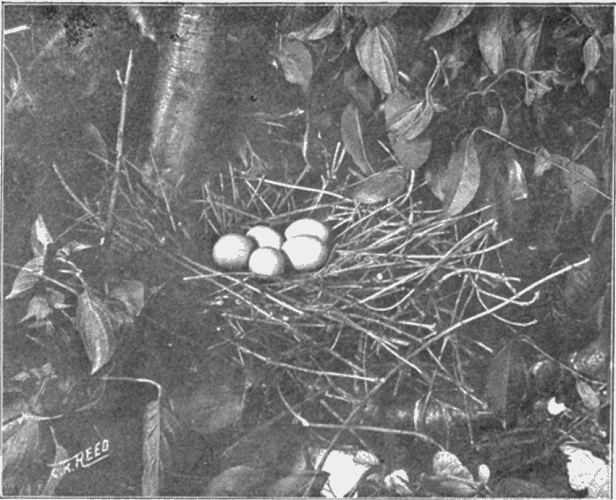
NEST AND EGGS OF GREEN HERON.
|

|
Page 126

|

Black-crowned Night Heron.
Yellow-crowned Heron. 202. Black-crowned Night Heron.
Nycticorax nycticorax naevius.
Range.--North America from southern British
Provinces, southward; winters along the Gulf
coast and beyond.
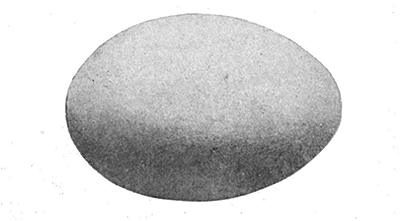
Pale bluish green. A well known bird, often called "quawk" from
the sound of its note frequently heard in the evening.
While, in some localities, only a few pairs
of these birds are found nesting together, most
of them gather together into large colonies during
the breeding season. In New England they
generally select a remote pine grove as their
breeding grounds. If not disturbed they will return
to this same place each year. Their nests
are built of sticks and lined with small twigs,
and are placed well up towards the tops of the
trees.
Frequently several nests will be found in the
same tree, and I have counted as many as fifty
nests in view at the same time. In large swamps
in the south they generally nest at a low elevation,
while in the marshes of Wisconsin and Minnesota, large colonies of them
nest on the ground, making their nest of rushes. Like all Heronries, those of
this species have a nauseating odor, from the remains of decayed fish, etc.,
which are strewn around the bases of the trees. Their eggs number from three
to five and are of a pale bluish green color. Size 2.00 × 1.40. Data.--Uxbridge,
Mass., May 30, 1898. 4 eggs. Nest of sticks, about thirty feet up in a pine tree.
Many other nests. Collector, H. A. Smith.
203. Yellow-crowned Night Heron. Nyctanassa violacea.
Range.--Sub-tropical America, breeding along the Gulf coast and to Lower
California; casually farther north, to Illinois and South Carolina.
A handsome grayish colored species, with long lanceolate plumes on the
back, and two or three fine white plumes from the back of the head, like those
of the Black-crowned species. Its black head, with tawny white crown and ear
coverts, renders it unmistakable. This species nests in colonies or by pairs,
like the preceding, and very often in company with other Herons. They lay
from three to six eggs, very similar in size, shape and color to those of the
Black-crowned Heron.
|
|
|
Page 127
|
CRANES, RAILS, etc. Order VIII. PALUDICOLÆ
CRANES. Family GRUIDAE
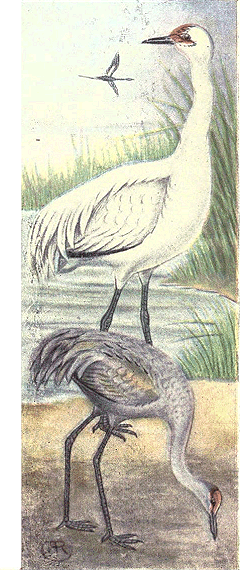
Whooping Crane.
Little Brown Crane. Cranes are large, long-legged, long-necked birds, somewhat resembling
Herons. Their structure and mode of living partakes more of the nature of
the Rails, however. They are found upon the prairies, where besides shell
fish from the ponds, they feed largely upon grasshoppers, worms, etc.
204. Whooping Crane. Grus americana.
Range.--Interior of North America, breeding
from about the latitude of Iowa northward to the
Arctic regions; winters in the Gulf states and
southward.
The Whooping Crane is the largest of the family
in America, measuring 50 inches or more in
length. The plumage of the adults is pure white,
with black primaries. The bare parts of the head
and face are carmine. It is a very locally distributed
species, in some sections being practically
unknown, while in a neighboring locality it
may be rated as common. They are very shy
birds and are not easily obtained. They nest
either upon the solid earth or in marshy places
over the water. In either case the nest is a very
bulky mass of grass and weeds from two to three
feet in diameter and raised perhaps a foot above
the ground. They lay two eggs of a brownish
buff color, irregularly blotched with brown, and
with fainter marking of gray. Size 3.75 x 2.50.
Data.--Torkton, northern Assiniboia, northwest
Canada. Nest a mass of marsh hay, three feet in
diameter, on the prairie. The birds seen, but very
wary. Collector, Cowbry Brown.
205. Little Brown Crane. Grus canadensis.
Range.--North America in the interior, breeding
from Hudson Bay and southern Alaska north
to the Arctic coast; south in winter to Mexico.
This uniform gray colored Crane differs from
the next species only in size, being about three
feet in length, while the Sandhill averages three
and one-half feet. The eggs cannot be distinguished
with any certainty.

|

|
Page 128

|

Brownish buff.
EGG OF WHOOPING CRANE.
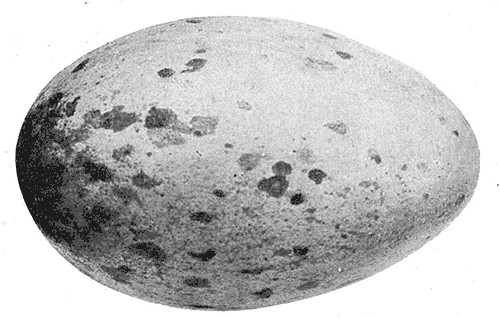
Buff.
EGG OF LITTLE BROWN CRANE.
|
|
|
Page 129
|
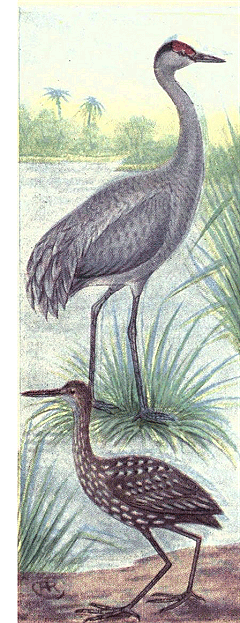
Sandhill Crane.
Limpkin. 206. Sandhill Crane. Grus mexicana.
Range.--Temperate North America, breeding
from the Gulf States, locally north to the southern
parts of the British Provinces.
This is the most common and the most southerly
distributed member of the family. In some
sections of Florida and Texas it is regarded as
abundant. They nest in marshy places near secluded
ponds. The nests are masses of grass,
weeds and roots, generally placed in marshes and
entirely surrounded by water. The two eggs are
similar to those of the Whooping Crane, but the
ground color is lighter. The eggs of the two species
cannot always, with certainty, be distinguished.
Size 3.75 x 2.40. Data.--Carman, Manitoba,
May 31, 1903. 2 eggs. Nest on a knoll in a
marsh, hidden by dead rushes and weeds; a flat
loose structure of broken rushes and reeds. Collector,
Chris Forge.
COURLANS. Family ARAMIDÆ
207. Limpkin. Aramus vociferus.
Range.--This bird is a native of the West
Indies and Central America, but occurs regularly
north to the southern portions of Florida.
This strange bird is the only member of its family
found in the United States. It may be likened
to a large Rail or a small Crane, being apparently,
a connecting link between the two. It is about
two feet in length, and the plumage is mottled
brownish and white. It lives in the marshes,
from whence, until late at night, emanate its
strange cries, which are likened to those of a
child in distress. They nest in the most impenetrable
parts of swamps, building their nests of rushes, grass and weeds, in
tangled masses of vines a few feet above the ground or water. They lay from
three to eight eggs having a ground color of buff or grayish white and blotched
with light brown. Their coloration is very similar to those of the Cranes.
Size 2.30 x 1.70. They nest in April and May.
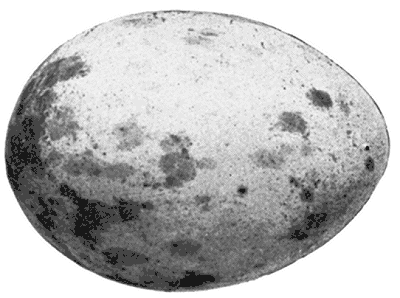
Buffy white.
|

|
|
Page 130
|

NEST AND EGGS OF LITTLE BROWN CRANE.
|
|
|
Page 131
|
RAILS, GALLINULES and COOTS. Family RALLIDÆ
Members of this family are almost exclusively frequenters of marshes,
where they lead a shy, retiring life and are more often heard than seen.
208. King Rail. Rallus elegans.
Range.--Fresh water marshes of eastern United States from New England
and the Dakotas, southward. Very abundant on the South Atlantic coast, in
the inland marshes.

Cream color. This is one of the largest of the Rails, (17
inches in length) and may be known by the
richness of its plumage, the breast and wing
coverts being a rich cinnamon color. It is
almost exclusively a fresh water species and is
very rarely found around a salt water marsh.
Its nest is built on the ground, in a tuft of grass
and weeds woven about the upright stalks.
They lay from five to twelve eggs having a
cream colored ground, sparingly speckled with
brown and lilac. Size 1.60 × 1.20. Data.--Clark
County, Missouri, June 6, 1893. 10 eggs. Nest
composed of reed stalks; a slightly concave mass 8 inches across, and only
two inches above the water, in a clump of reeds. Collector, Ed. S. Currier.
209. Belding's Rail. Rallus beldingi.
Range.--Lower California and the islands in the Gulf.
This is a locally confined species, very similar to the preceding but darker
and with the flank bars narrower. Its nesting or eggs will not differ from those
of the King Rail.
210. California Clapper Rail. Rallus obsoletus.
Range.--Salt marshes of the Pacific coast of the United States.

Light buff. This species is like a dull colored King Rail,
with reference to the markings of the back, or
a bright colored Clapper Rail, as it has a cinnamon
colored breast. It is an abundant species
in nearly all the salt marshes along the coast.
They make their nests on the higher parts of
the marsh, where it is comparatively dry, building
them of grass and strips of rushes. They
lay from four to nine eggs of a light buff color,
boldly spotted with brown, and with fainter
markings of lilac. Size 1.75 × 1.25. Data.--Palo
Alto, Cal., May 1, 1899. Nest of marsh
grass under a small bush on bank of slough.
Collector, Ernest Adams.
|

|
Page 132

|
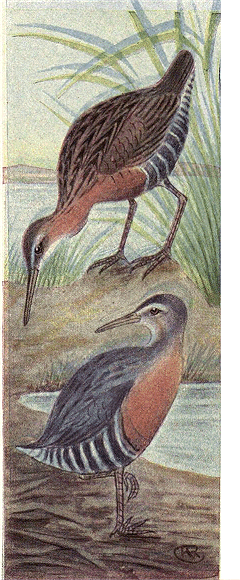
King Rail.
Clapper Rail. 211. Clapper Rail. Rallus crepitans crepitans.
Range.--Salt marshes of the Atlantic coast
from southern New England southward.
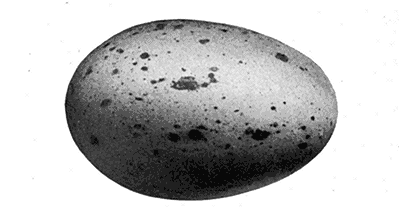
Buff. A grayish colored Rail, about the size of, and
with the markings similar to those of the King
Rail. It is as exclusively a salt water species as
the King Rail is a fresh water one. With the
possible exception of the Carolina or Sora Rail,
this is the most abundant of all the Rails, hundreds
nesting in a single marsh on the South
Atlantic coast. Their nests are built of rushes
and weeds, and are placed on the ground either in
the tall grass bordering the marshes or attached
to the rushes in the midst of the marsh. The
nesting season commences during April and continues
through May. They lay from six to fourteen
eggs, of a buff color spotted irregularly with
brown and gray. Size 1.70 × 1.20.
211a. Louisiana Clapper Rail. Rallus crepitans saturatus.
The habitation of this subspecies is limited to
the coast of Louisiana. It is very similar to the proceeding but is said to be
brighter in plumage.
211b. Florida Clapper Rail. Rallus crepitans scotti.
Range.--Western coast of Florida.
This bird is also similar to crepitans but is much darker and brighter.
211c. Wayne's Clapper Rail. Rallus crepitans waynei.
Range.--South Atlantic coast from North Carolina to Florida.
This subspecies is a little darker than crepitans, being about midway between
that species and Rallus scotti. The nests and eggs of any of these sub-species
cannot be distinguished from those of the common Clapper Rail.
211.2. Caribbean Clapper Rail. Rallus longirostris caribaeus.
Range.--West Indies and east coast of Mexico, north to southern Texas.
This species is similar to the Clapper, but has a shorter and relatively stouter
bill.
|
|
|
Page 133
|
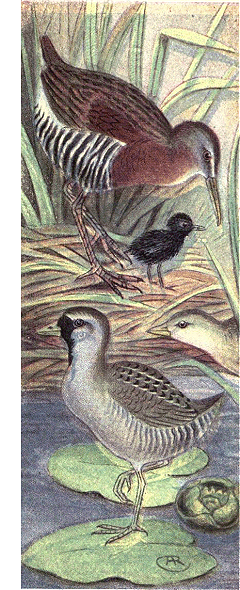
Sora.
Virginia Rail. 212. Virginia Rail. Rallus virginianus.
Range.--Temperate North America, breeding
from the Middle States and California, northward
to British Columbia and Labrador, and wintering
along the Gulf coast; most abundant in the east.
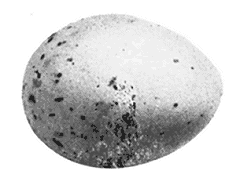
Creamy white. A small Rail, 9 inches
long, very similar in
markings and coloration
to the King Rail.
It is found chiefly in
fresh water swamps,
where it builds its nests
in tufts of rushes. The
eggs number from six
to fourteen, and are
creamy white, or white,
speckled with reddish brown. Size 1.25 × .90 Data.--Fighting
Island, Detroit River, Michigan, May
30, 1904. Nest made of marsh grass, in rushes, 6
inches above the water. Collector, E. Leroy King.
213. Spotted Crake. Porzana porzana.
This common European species is casually
found in Greenland. It breeds in large numbers
throughout temperate Europe, nesting as do the
American Rails.
214. Sora. Porzana carolina.
Range.--Temperate North America, breeding
from the southern parts of the British possessions,
south to the Gulf coast.

Bright buff. This abundant species of Rail may be readily
known by its small size, about eight inches long,
and the black face and throat of the adult. These
are the "Rail-birds" or "Ortolans" which are annually
slaughtered by thousands, for sport and marketing, during their fall migration.
It is only because of the large families
that they rear, that they are able to withstand this
yearly decimation of their ranks. They nest
either in salt or fresh water marshes, making a
rude structure of grass, weeds and strips of rushes,
on the ground, generally concealed in a tuft of grass
in a tangled swamp or marsh. During May, they
lay from six to sixteen eggs of a bright, buffy gray
color, spotted with reddish brown and lavender.
Size 1.25 × .90.

|

|
Page 134

|
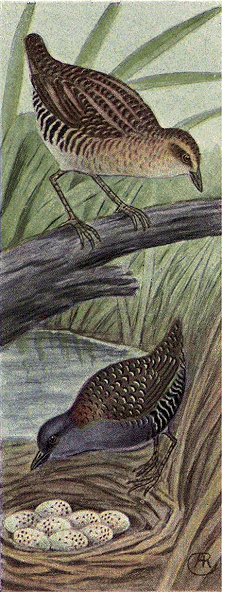
Yellow Rail.
Black Rail. 215. Yellow Rail. Coturnicops noveboracensis.
Range.--Locally distributed in temperate North
America, from New England and Nova Scotia, to
California and British Columbia; south to the
Gulf States in winter.
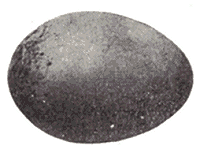
Rich buff. This is a very handsome species, with plumage
of glossy brown, yellowish buff, black and white;
length seven inches. They are very shy and secretive,
and are probably
more common than generally
supposed. Their nesting
habits are the same
as those of the preceding.
Their eggs are of a rich
buff color, speckled in the
form of a wreath about
the large end, with reddish
brown. They are
relatively narrower than
those of other Rails. Size
1.10 × .80. Data.--Benson Co., North Dakota, June
4, 1901. Set of ten eggs collected by Rev. P. B.
Peabody. This set is in the collection of Mr.
John Lewis Childs.
216. Black Rail. Creciscus jamaicensis.
Range.--Temperate North America, breeding
from northern United States southward.
Smallest of the rails; 5 inches in length. A
dark slaty colored bird with
white specks, and a patch of
dark chestnut on the fore
back. This diminutive species
is very hard to find because
of its retiring habits,
but according to Mr. Brewster
it may be located by the
clicking sound of its song.
Their nests are woven of strips of rushes or grasses, and are well "cupped"
to receive the eggs. They are on the ground on the border of, or in, marshy
places. Mr. Childs has a fine set of eight eggs, taken by Arthur T. Wayne, at
Mt. Pleasant, S. C., June 10, 1903. The nest was located in an oat field. The
eggs have a creamy white ground, and are specked all over with reddish brown.
Size 1.03 × .75.
216.1. Farallon Rail. Creciscus coturniculus.
Known only from a single specimen, which is slightly smaller than jamaicensis
and without the white specks on the back.

|
|
|
Page 135
|
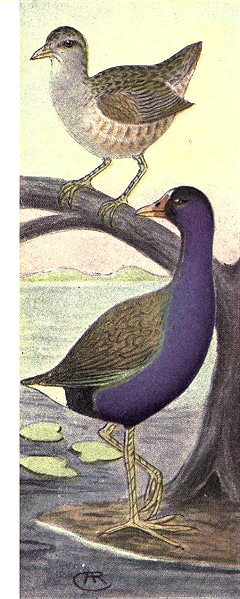
Purple Gallinule.
Corn Crake. 217. Corn Crake. Crex crex.
This European Rail is casually found in Greenland
and along the Atlantic coast of North America.
It is the most abundant of European Rails
and is found breeding in marshes, meadows and
along streams.
218. Purple Gallinule. Ionornis martinicus.
Range.--South Atlantic and Gulf States; casually
north in eastern United States to Massachusetts
and Ohio.
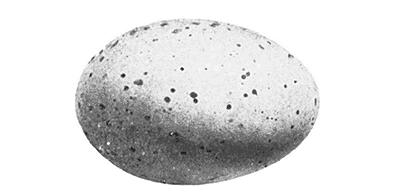
Pale buff. A very handsome bird with purplish head,
neck and under parts, and a greenish back. Like
all the Gallinules and Coots, this species has a
scaly crown plate. An abundant breeding species
in the southern parts of its range. Its nests are
made of rushes or grasses woven together and
either attached to living rushes or placed in tufts
of grass. They lay from six to ten eggs of a
creamy or pale buff color sparingly blotched with
chestnut. Size 1.60 × 1.15. Data.--Avery's Island,
Louisiana, May 7, 1896. Ten eggs. Nest of dry rushes, woven to standing ones
growing around an "alligator hole" in a marsh. Collector, E. A. McIlhenny.

|

|
Page 136

|
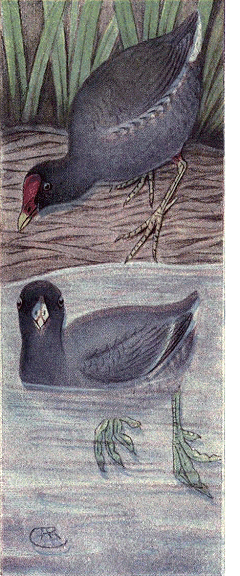
Florida Gallinule.
Coot. 219. Florida Gallinule. Gallinula galeata.
Range.--Temperate North America, from New
England, Manitoba and California, southward.
A grayish colored bird of similar size to the
last (13 inches long), with flanks streaked with
white, and with the bill and crown plate reddish.
They nest in
colonies in
marshes and
swamps, building
their nests
like those of
the Purple
Gallinule. The
eggs, too, are
similar, but
larger and
slightly duller.
Size 1.75 × 1.20.
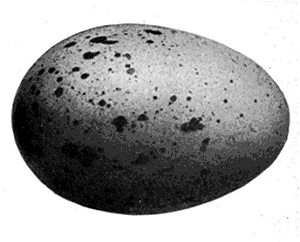
Pale buff. Data.--Montezuma
marshes, Florida, June 6, 1894. Eleven
eggs. Nest of dead flaggs, floating in two feet of
water. Collector, Robert Warwick.
220. European Coot. Fulica atra.
A European species very similar to the next,
and only casually found in Greenland. Nesting
the same as our species.
221. Coot. Fulica americana.
Range.--Whole of temperate North America,
from the southern parts of the British Provinces,
southward; very common in suitable localities
throughout its range.

Grayish. The Coot bears some resemblance to the
Florida Gallinule, but is somewhat larger,
its bill is white with a blackish band about
the middle, and each toe has a scalloped
web. They inhabit the same marshes and
sloughs that are used by the Rails and Gallinules
as nesting places, and they have the
same retiring habits, skulking through the
grass to avoid observation, rather than flying.
Their nests are either floating piles
of decayed vegetation, or are built of dead
rushes in clumps of rushes on the banks.
They generally build in large colonies. The
eggs number from six to sixteen and have
a grayish ground color, finely specked all over the surface with blackish. Size
1.80 × 1.30.

|
|
|
Page 137
|
SHORE BIRDS. Order IX. LIMICOLÆ
PHALAROPES. Family PHALAROPODIDAE
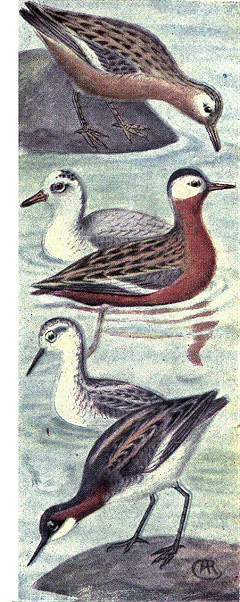
Red Phalarope.
Northern Phalarope. Phalaropes are small Plover-like birds, but with lobate webbed feet, similar
to those of the Grebes and Coots.
222. Red Phalarope. Phalaropus fulicarius.
Range.--Northern Hemisphere, breeding in the
far north, and migrating to the middle portions
of the United States, chiefly on the coasts.
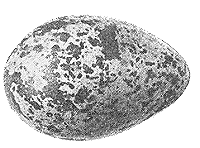
Greenish buff. The Red Phalarope during the breeding season
has the underparts wholly reddish brown; they
are very rarely seen in the United States in this
dress, however for it is early changed for a suit
of plain gray and white.
This species has a much
stouter bill than the two
following; it is about nine
inches in length. All the
Phalaropes are good swimmers,
and this species, especially,
is often found in
large flocks off the coast,
floating on the surface of
the water; they feed largely upon small marine
insects. Nests in hollows on the ground, lined
with a few grasses. The eggs are three or four
in number, generally of a greenish buff color,
spotted and blotched with brown and blackish.
Data.--Myvates, Iceland, June 19, 1897. Collector,
C. Jefferys.
223. Northern Phalarope. Lobipes labatus.
Range.--Northern Hemisphere, breeding in the
northern parts of the British Provinces.
This is the smallest of the Phalaropes, being
about eight inches long; in summer it has a
chestnut band across the breast and on the side
of the neck.

Greenish buff. Its habits and nesting habits vary
but little from those of the Red Phalarope, although
its distribution is a little more southerly,
and it is not as exclusively maritime as the preceding
species. It is found on both coasts of the
United States, but more common on the Pacific side,
during the fall and spring, when going to or returning
from its winter quarters in the tropics.
Their eggs cannot, with certainty, be distinguished
from the preceding species.
|

|
Page 138

|
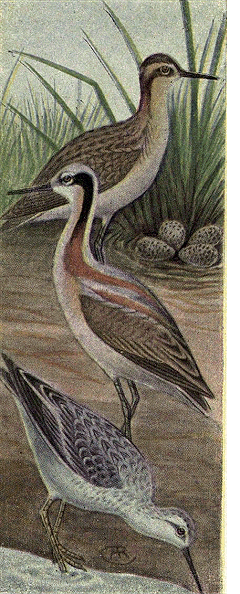
Male, female, young.
Wilson's Phalarope. 224. Wilson's Phalarope. Steganopus tricolor.
Range.--Interior of temperate North America,
breeding from the latitude of Iowa, northward,
and wintering south of the United States.
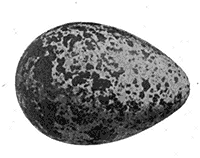
Brownish buff. This is the most handsome species of the family,
being of a very graceful form, of a grayish
and white color, with a broad stripe through the
eye and down the neck, where it fades insensibly
into a rich chestnut
color. It is an exclusively
American
species and is rarely
found near the
coast. It builds its
nest generally in a
tuft of grass, the
nests also being of
grass. The eggs
are of a brownish or greenish buff color, spotted
and blotched with black and brown. Size 1.30 ×
.90. Data.--Larimore, N. D., May 30, 1897. Nest
a shallow depression, scratched in the sand, under
a tuft of grass on an island. Collector, T. F.
Eastgate.
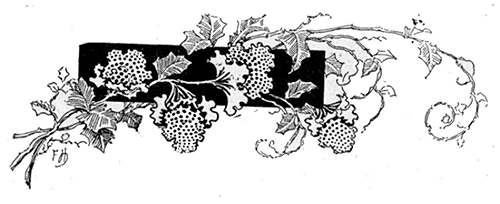
|
|
|
Page 139
|
AVOCETS and STILTS. Family RECURVIROSTRIDÆ
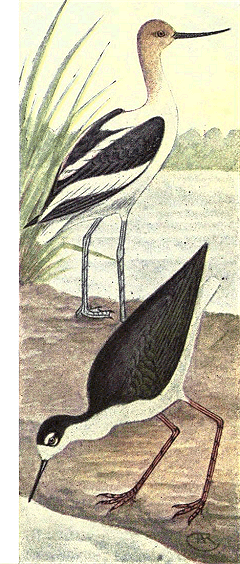
American Avocet.
Black-necked Stilt. 225. Avocet. Recurvirostra americana.
Range.--Western North America, breeding
north to Northwest Territory.
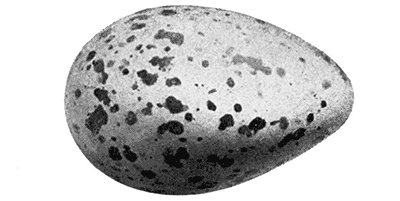
Greenish buff. The Avocet can be known from any other bird
by its up-curved bill, light plumage, webbed feet
and large size (length about 17 inches). These
waders are quite numerous in suitable localities
throughout the west, constructing their nests in
the grass, bordering marshy places. The nest is
simply a lining of grass in a hollow in the ground.
They lay three or four eggs of a dark greenish
or brownish buff color, boldly marked with
brown and black. Size 1.90 × 1.30. Data.--Rush
Lake, Assiniboia. Four eggs laid in a depression
in the sand, lined with dry weeds. Many birds
nesting in the colony.
226. Black-necked Stilt. Himantopus mexicanus.
Range.--Like the last, this species is rarely
found east of the Mississippi, but is very abundant
in the United States west of that river.
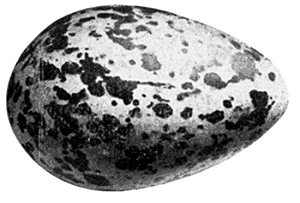
Greenish buff. A black and white wader, with extremely
long red legs; otherwise a gracefully
formed bird. It breeds in large
colonies anywhere in its range, making
its nests of weeds and sometimes a few
twigs, on the ground beside of, or in the
marshes. Their eggs number three or
four and are brownish or greenish buff
with numerous markings of brownish
black, these markings being somewhat
lengthened and mostly running lengthwise
of the shell. They nest during
April in the southern parts of their
range and through May and June in the
northern. Size of eggs 1.80 × 1.25. Data.--Freshwater Lake, southern California,
June 5, 1891. Four eggs laid on a mud flat near the water's edge; no nest.
Collector, Evan Davis.
|

|
Page 140

|
SNIPES, SANDPIPERS, Family SCOLOPACIDÆ
Members of this family are long-legged waders, of either large or small size,
and found either about streams or ponds in the interior or along the coasts.
They feed upon small shell fish, or insects which they get usually by probing
in the soft mud.
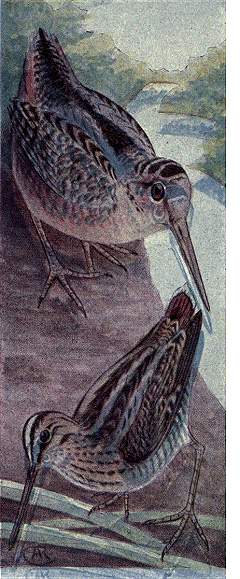
American Woodcock.
Wilson's Snipe. 227. European Woodcock. Scolopax rusticola.
This European bird is similar to the American
Woodcock, but is larger and is barred beneath.
Their habits are the same as those of our species.
228. Woodcock. Philohela minor.
Range.--Eastern North America, north to the
British Provinces, breeding throughout its range.
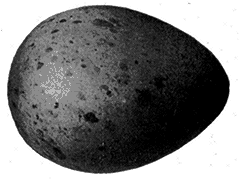
Buffy gray. This is one of the most eagerly sought game
birds of the east. Their flight is very rapid and
erratic, and accompanied by a peculiar whistling
sound made by the rapid motion of the wings; it
requires a skillful
marksman to
bring them down.
They frequent
boggy places especially
"runs"
lined with alders,
where they bore
in the soft ground
for worms and
grubs. Their
eggs are laid upon
the bare
ground among
the leaves and sticks; they are of about the color
of dead leaves, as is also the bird, making it quite
difficult to discover their nests. They lay three
or four eggs of a buffy color, with yellowish brown
spots. Size 1.50 × 1.15.
229. European Snipe. Gallinago gallinago.
A common species in Europe; of casual or accidental appearance in Greenland.
The bird does not differ essentially from our Snipe and its habits are
the same.

|
|
|
Page 141
|

WOODCOCK ON HER NEST.
|
|
Page 142
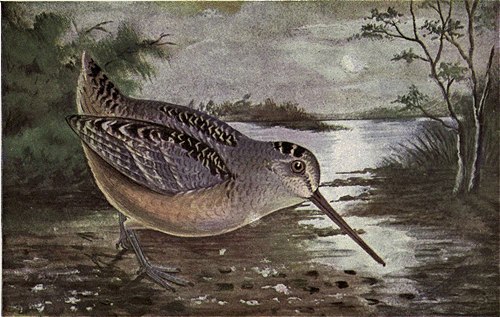
WOODCOCK.
|
Page 143
|
Wilson Snipe. Gallinago delicata.
Range.--North America, breeding from northern United States northward;
winters along the Gulf States and to California, and southward.
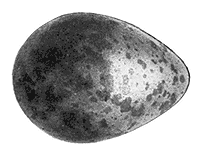
Olive gray. Another favorite game bird, but one which requires
skill to hunt successfully. Of about the
same size as the Woodcock (11 inches long).
This species, to a great extent frequents the same
haunts used by Woodcock, but is especially fond
of open marshy meadows, with winding brooks.
Their nests are depressions in grassy banks, generally
unlined; the three or four eggs have an
olive gray color and are strongly marked with
blackish brown. Size 1.50 × 1.10. Data.--Lake
Winnipegosis, Manitoba, June 10, 1903. Nest in
a hollow on a tuft of marsh grass, the four eggs
having their points together. Collector, Walter
Raine.
230.1. Greater Snipe. Gallinago media.
A European species, only American as having accidentally occurred at Hudson
Bay; similar in appearance to the preceding species.

NEST AND EGGS OF WOODCOCK.
|

|
Page 144

|
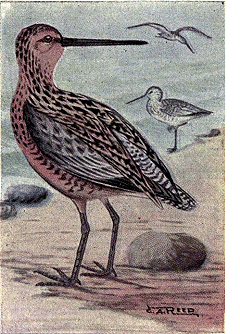
Dowitcher. 231. Dowitcher. Macrorhamphus griseus.
Range.--North America, most abundant in
the eastern parts; breeds in the extreme north,
and winters from the Gulf States to Northern
South America.
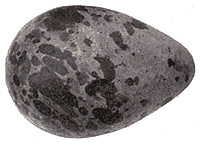
Greenish buff. This species is
commonly known
as "Red-breasted
Snipe" in late
spring and summer
because of
the rich, rusty
red coloration of
the underparts,
and as "Gray-back"
in winter
because of its
color at that season.
They are very common along the Atlantic
coast during the Spring migration; they
can be easily identified by their very long
bills, which are over two inches in length and
nearly one quarter the length of the whole
bird. They nest during June, placing their three or four eggs in a slight hollow,
which may or may not be lined with dried grass or leaves. The eggs have
a greenish or brownish buff color and are boldly marked with dark brown.
They do not differ greatly from those of the Snipe. Data.--Mackenzie River,
June 27, 1900. Four eggs in a hollow in the grass, lined with dead grass. Collector,
Walter Raine.
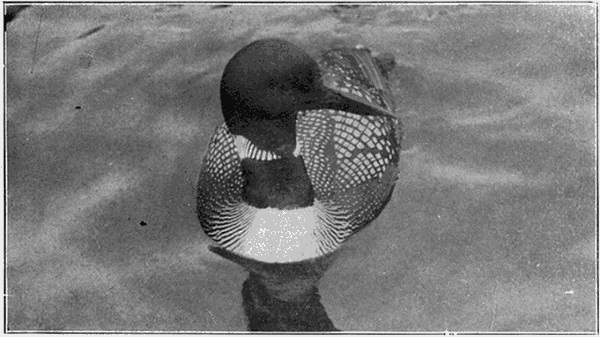
LOON.
|
|
|
Page 145
|
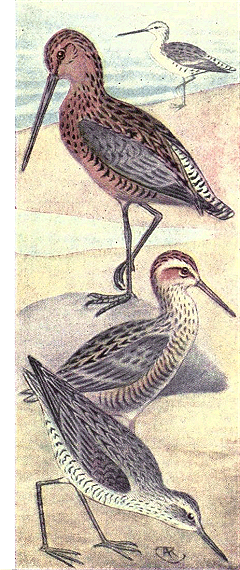
Long-billed. 232. Long-billed Dowitcher. Macrorhamphus griseus scolopaceus.
Range.--Whole of North America, but not common
on the Atlantic coast; breeds in the Arctic
regions and migrates chiefly through the central
and western parts of the United States to Mexico.
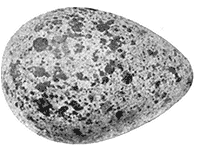
Greenish buff. This bird is practically the same as the last, but
is a trifle larger and the bill averages about a
half inch longer. They are very numerous in
their breeding
haunts, and, during
their migrations, fly
in large compact
flocks. They are
not very timid, and
consequently fall an
easy prey to the gunners.
Their nesting
habits and eggs are
the same as the last
species, except that
the eggs may average a trifle larger. Size 1.75 ×
1.15. Data.--Norton Is., Alaska, June, 1900. Nest
a small hollow in the dry ground. Four eggs.
Collector, Capt. H. H. Bodfish.
233. Stilt Sandpiper. Micropalama himantopus.
Range.--North America, east of the Rocky
Mountains; breeds in the Arctic regions and winters
from the Gulf States southward.
In the summer, these birds may be known by
the reddish coloration of the underparts, which
are numerously barred; they are smaller than
the preceding, length about eight inches. Their
nesting habits are the same as those of the majority
of the members of the family. The three
or four eggs are buffy or grayish, and are blotched and spotted with shades of
brown. Size 1.40 × 1.00.
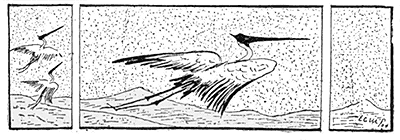
|

|
Page 146

|
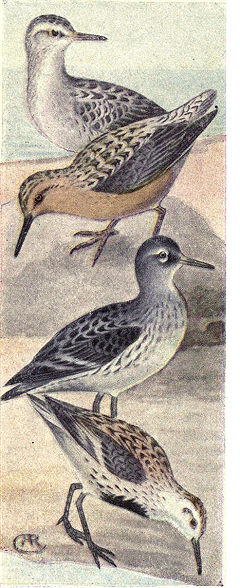
Knot.
Purple Sandpiper. 234. Knot. Tringa canutus.
Range.--Arctic regions in summer; south
through the United States, chiefly on the Atlantic
coast, to South America.
Of about the same size as the Dowitchers, length
10.5 inches, but with a much shorter bill. In
summer the entire under parts are a uniform reddish
chestnut color. They are known to breed
in Arctic America, from Point Barrow and Hudson
Bay, northward, but no authentic eggs are
known, at present, to exist in collections. One
taken from a bird by Lieut. Greely, was a pea
green color, specked with brown; size 1.10 × 1.00.
As it was not fully developed, it was probably
correct neither as to size nor color.
235. Purple Sandpiper. Arquatella maritima maritima.
Range.--Arctic regions, wintering south to the
Middle States and the Great Lakes, but chiefly
on the coast.
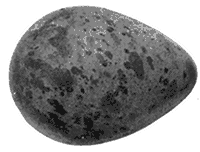
Grayish buff. A grayish and blackish colored species, about
nine inches long. It nests in northern Labrador,
about Hudson Bay and
in Iceland. Its eggs are
a grayish buff color
handsomely splashed
with rich shades of
brown and obscure
markings of darker
gray. Data.--Northern
Iceland, June 7,
1897. Four eggs. Nest
a hollow in the ground
among grass and weeds and lined with a few
grasses. Collector, C. Jefferys.
235a. Aleutian Sandpiper. Arguatella maritima couesi.
Range.--Supposed to be a resident on the coast and islands of Alaska, from
the Aleutians northward.
A very similar species to the preceding; scarcely distinguishable. These
Sandpipers, which are found in Alaska at all seasons of the year, breed during
May and June. Their nesting habits are the same as those of the preceding
bird and the eggs are indistinguishable. Size 1.40 × 1.00. Data.--Unalaska,
Bering Sea, June 3, 1898. Nest containing four eggs, a depression in the moss,
lined with grasses and bits of moss. The eggs were laid with their small ends
together.

|
|
|
Page 147
|
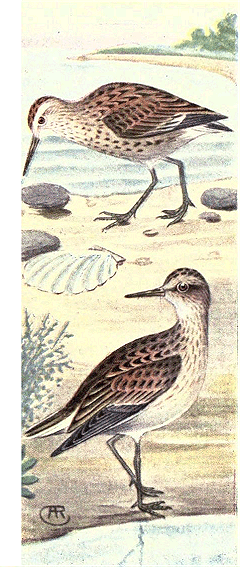
Sharp-tailed Sandpiper.
Pectoral Sandpiper. 237. Pribilof Sandpiper. Arquatella maritina ptilocnemis.
Range.--Coast and islands of Bering Sea, south
in winter to southern Alaska.
This bird, which is ten inches in length, has
the feathers of the upper parts edged with
rusty, and the underparts light, with a distinguishing
patch of black on the breast. Similar in
appearance to the Red-backed Sandpiper, but not
so reddish above, and the latter has the black
patch on the belly. They breed commonly on
the Pribilof and other islands in Bering Sea,
nesting the same as other Sandpipers. Their four
eggs are similar to those of the preceding, but
average darker. Size 1.50 × 1.05.
238. Sharp-tailed Sandpiper. Pisobia aurita.
Range.--An Asiatic species, quite abundant in
Alaska in the summer; supposed to migrate
south in winter, wholly on the Asiatic side of
the Pacific.
A similar bird, in appearance, to the following,
but slightly smaller and with the breast more
ruddy. Its nesting habits probably do not differ
from those of the following Sandpiper.
239. Pectoral Sandpiper. Pisobia maculata.
Range.--Whole of North America, breeding in
the Arctic regions, and wintering south of the
United States, most abundant in the eastern parts
of the United States during migrations.
This species is blackish brown above, with
light brown edgings to the feathers, and white
below, except the chest, which is brownish,
streaked with black. A very peculiar species,
having the power, during the mating season, of inflating
the throat to a great extent, making a balloon-like
appendage, nearly the size of the bird. They
have more the habits of Snipe, than do most of the
Sandpipers, frequenting grassy meadows or marshes,
in preference to the seashore. Their nests are
grass lined depressions, and the eggs are grayish
or greenish buff, blotched with brown. Size 1.45 ×
1.00. Data.--Cape Smythe, Alaska, June 1900. Four
eggs in a hollow in the ground, lined with grass.

|

|
Page 148

|
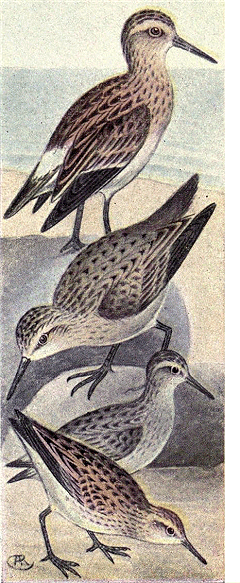
White-rumped Sandpiper.
Baird's Sandpiper.
Least Sandpiper. 240. White-rumped Sandpiper. Pisobia fuscicollis.
Range.--North America, breeding from Labrador
and southern Greenland, northward and wintering
from central to Southern South America;
most common on the Atlantic coast.
This species is 7.5 inches in length, and has
white upper tail coverts; otherwise it is marked
similarly to the preceding Sandpiper. Its nesting
habits are the same as those of the majority
of the family, and the three or four eggs that they
lay cannot be distinguished from those of the following
species. Size 1.30 × .90. These are one
of the most common of the beach birds along
the Atlantic coast during migrations; they are
very often known as Bonaparte Sandpipers.
241. Baird's Sandpiper. Pisobia bairdi.
Range.--North America, chiefly in the interior,
breeding along the Arctic coast and about Hudson
Bay, and wintering south of the United
States.
A very similar species to the preceding, but
without the white rump. Their nests are hollows
in the ground, generally concealed in a tuft of
grass, and lined with grasses and a few leaves.
They lay three or four eggs having a grayish
colored ground, and marked with different shades
of brown, and also with some faint markings of
lilac. Size 1.30 × .90. Data.--Peel River, Arctic
America, June 18, 1898. Four eggs, taken with
the bird by an Indian. Eggs in a slight hollow
on the river bank.
242. Least Sandpiper. Pisobia minutilla.
Range.--North America, breeding from the southern parts of the British
Provinces northward; winters from southern United States southward. Common
in the interior and on both coasts.
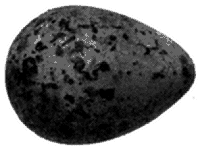
Grayish. This is the smallest of our Sandpipers, being under six
inches in length. Except for size, they are similar in
appearance to Baird's Sandpiper, only the back is browner.
A very abundant species during migrations, being found
on the seashore or in marshes, nearly always in company
with other species of the family. Their nests are the same
as other Sandpipers, and the eggs are grayish, thickly
specked with brown. Size 1.15 × .80. Data.--Peel River,
Arctic America, June 20, 1899. Nest simply a depression
in the river bank, lined with grass.
|
|
|
Page 149
|
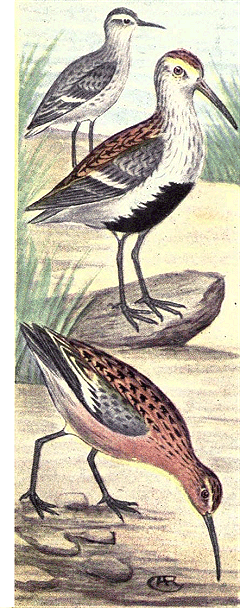
Red-backed Sandpiper.
Curlew Sandpiper. 242.1. Long-toed Stint. Pisobia damacensis.
An Asiatic species accidentally found on the
Alaskan shores. It is a very similar bird to the
Least Sandpiper, and about the same size. As
implied by its name, it has unusually long toes.
243. Dunlin. Pelidna alpina alpina.
A very common Sandpiper in the British Isles
and in Europe, but only casually occurring as a
straggler along the Atlantic coast. Very similar
to the next species, but a trifle smaller. The nest
and eggs do not differ from the following.
243a. Red-backed Sandpiper. Pelidna alpina sakhalina.
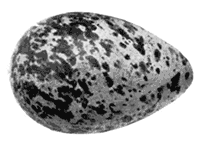
Greenish buff. Range.--Whole of North America, breeding
from southern Greenland, Labrador, Hudson Bay
and the Yukon, northward, wintering from the
Gulf States southward.
This handsome
species is
similar to the Pribilof
Sandpiper, but is
smaller (length 8
inches), the upperparts
are more reddish,
the breast
more heavily streaked,
and it has a black
patch on the belly instead of on the breast as in
ptilocnemis. Their nesting habits are similar to
others of the family; they lay three or four eggs
with a brownish or greenish buff color, heavily
blotched and spotted with shades of brown and
chestnut. Size 1.40 × 1.00. Data.--- Peel River, Arctic America, June 30, 1899.
Nest a simple cavity in the ground, lined with a few grasses and three or four
leaves. Collector, J. O. Stringer.
244. Curlew Sandpiper. Erolia ferruginea.
Range.--A common Old World species, but regarded as rare in eastern North
America and northern Alaska.
A bird of slighter build, but similar coloration to the Knot; smaller (length
eight inches) and with a slightly decurved bill. Until within recent years, eggs
of these birds were rarely seen in collections, and I believe they have not yet
been taken in this country, although a few pairs nest along our Arctic coast.
Their eggs are very similar to those of the Red-backed Sandpiper, but average
somewhat larger. Size 1.50 × 1.05. Data.--Kola, northern Lapland, June 15,
1898. Four eggs laid in a grass-lined hollow in the ground. Collector, J.
Ramberg.
|

|
Page 150

|
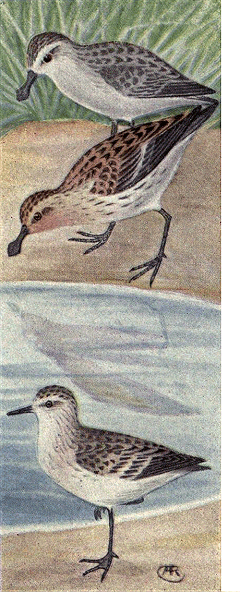
Spoonbill Sandpiper.
Semipalmated Sandpiper. 245. Spoonbill Sandpiper. Eurynorhynchus pygmeus.
A very rare Asiatic species, which has been
taken in Kotzebue Sound, Alaska. A very peculiar
bird having the end of the bill broadened
and flattened into a sort of spatula. Otherwise
very similar to the Least Sandpiper, but with
the breast and sides of neck ruddy in summer.
About 75 specimens of this rare bird are known
to exist.
246. Semipalmated Sandpiper. Ereunetes pusillus.
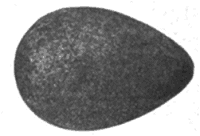
Grayish. Range.--Whole of North America, but chiefly
in the eastern and central parts, breeding about
the ponds and streams of Labrador and Hudson
Bay, and northward. These little Sandpipers are
abundant during the migrations either in marshes
or on beaches. They are most often found in
company with other species, such as the Spotted
and Least Sandpipers. Their appearance is very
similar to that of the Least Sandpipers, but they
are slightly larger and the feet are partially
webbed. Their eggs have a greenish buff or grayish
ground color and are
spotted with brownish or
blackish, sometimes, so
heavily as to completely
obscure the shell color.
Size 1.20 × .80. Data.--Small
island near Okak,
Labrador, July 3, 1895. 2
eggs. Nest a hollow at the
foot of a tuft of grass,
lined with a few bits of grass and small leaves.
Eggs unmistakable in this dark type.
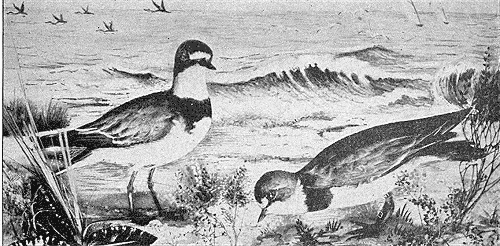
|
|
|
Page 151
|
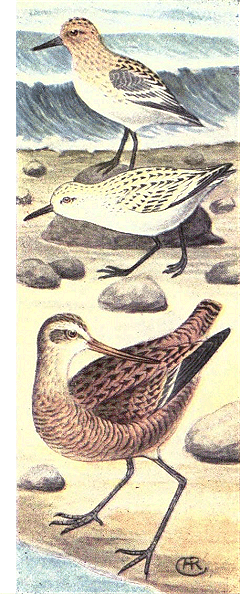
Western Sandpiper.
Sanderling.
Marbled Godwit. 247. Western Sandpiper. Ereunetes mauri.
Range.--Western North America, breeding in
the Arctic regions and migrating through the
United States, chiefly west of the Mississippi to
the Gulf States and southward.
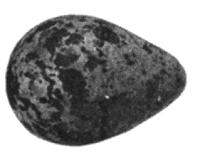
Grayish buff. Scarcely to be distinguished
from the preceding species,
but the upper parts are
said to be brighter and the
bill, to average a trifle longer.
The nesting habits and
eggs are precisely the same
as those of the Semipalmated
variety. Data.--Cape Prince
of Wales, Alaska, June 28, 1898. Four eggs. Nest
a neatly rounded hollow, sunk into a mossy hummock
in marshy ground. Collector, Joseph Grinnell.
248. Sanderling. Calidris leucophaea.
Range.--Found in all parts of the northern hemisphere,
breeding within the Arctic Circle and
wintering in North America, from California and
South Carolina southward.
A handsome and abundant species, found during
migrations by thousands on beaches and about
large bodies of water in the interior. They are
one of the lightest colored of the Sandpipers,
either in winter or summer plumage. In summer
the upper parts are a light rusty color and black,
and the whole underparts are white. Owing to
their extreme northerly distribution in summer,
but few of their eggs have been taken. Their
nesting habits are like those of the other Sandpipers.
The three or four eggs are greenish buff in
color, spotted and blotched with brown. Size 1.45 × .95. Data.--Peel River,
Alaska, June 18, 1897. Three eggs in a depression on the ground.
249. Marbled Godwit. Limosa fedoa.
Range.--North America, breeding, chiefly in the interior, from northern
United States northward.
Godwits are large Plovers with long slightly up-curved bills. This species
is 19 inches in length, is of a nearly uniform ruddy color and is handsomely
marbled above, and barred below with black. Their eggs are laid upon the
ground in the vicinity of ponds or rivers; sometimes there is no lining and
again a few straws or grasses may be twisted around the depression. Their
eggs number three or four and have a ground color of grayish or greenish buff,
sometimes quite dark, and are blotched with dark brown. Size 2.25 × 1.60.
Data.--Devil's Lake, N. D., June 10, 1895. Four eggs laid on the ground in the
middle of an unused road. Lined with a few grasses. Collector, W. F. Hill.
|

|
Page 152

|
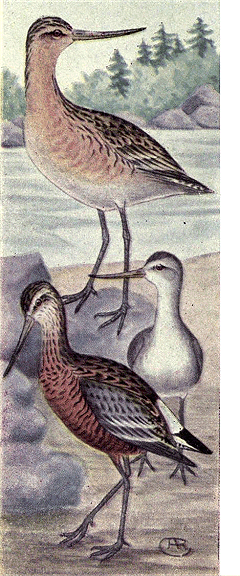
Pacific Godwit.
Hudsonian Godwit 250. Pacific Godwit. Limosa lapponica baueri.
Range.--Coasts and islands of the Pacific Ocean
on the Asiatic side, north in summer to Alaska.
This species is more uniform and brighter ruddy
beneath than the preceding, and the back is
not marbled as strongly. Even in Alaska where
it breeds, it is not a common species, and it only
occurs elsewhere on the Pacific coast of America
casually. The nesting habits are the same, but
the eggs are somewhat darker than those of the
preceding, but not as dark as those of the following
species. Size 2.20 × 1.45.
251. Hudsonian Godwit. Limosa haemastica.
Range.--North America, east of the Rocky
Mountains, breeding in the Arctic regions and
wintering south of the United States.
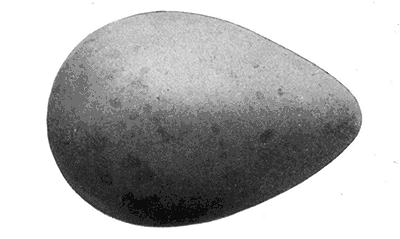
Brownish. This species is apparently not as common or is
more locally distributed during migrations than
is the Marbled Godwit. They are more abundant in their breeding grounds and
are occasionally seen in large flocks. They are smaller than the Marbled
Godwit (length 18 inches) and are deep reddish brown below. They lay four
eggs on the ground, in marshes or near ponds or streams, lining the hollow
with weeds and dried leaves. The eggs have a dark brownish buff ground
color and are blotched with brownish black. Size 2.20 × 1.40. Data.--Mackenzie
River, Arctic America. Four eggs laid in a hollow in the ground. Collector,
J. O. Stringer.
252. Black-tailed Godwit. Limosa limosa.
A European and Asiatic species only casually occurring in Greenland. Very
similar in appearance to our Hudsonian Godwit, which is frequently called by
the name of this species. The nesting habits and the eggs are precisely like
those of the American bird.
253. Green Shank. Glottis nebularia.
A common bird in Europe and the British Isles, but only American as having
been taken once in Florida. A very similar species to the following.
|
|
|
Page 153
|
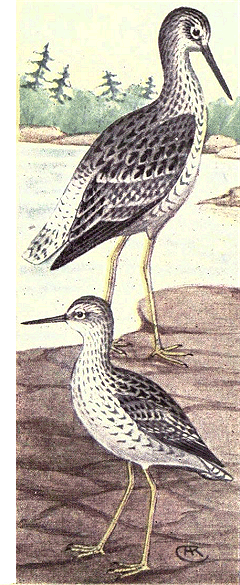
Greater Yellow-legs.
Yellow-legs. 254. Greater Yellow-legs. Totanus melanoleucus.
Range.--Whole of North America, nesting in the British Provinces and rarely in the northern part of the Mississippi Valley.
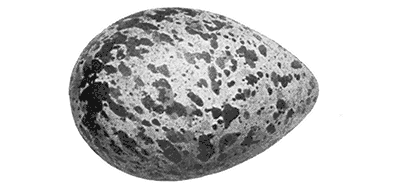
Grayish white. This and the next species are much sought by sportsmen during their migrations; they are commonly called "Tell-tale," the present species being the "Greater Tell-tale." They are blackish above, speckled with white, and below are white and, in summer, marked with arrowhead spots of black. The legs, as implied by the name of the bird, are yellow and long; length of bird, 14 inches. They nest most abundantly in localities remote from habitations, in the interior of Canada. The eggs are generally laid on the ground, near a marsh or on the bank of a stream, with little or no lining to the nest. They are grayish white, boldly splashed with several shades of brown, and with lilac. Size 1.65 × 1.25. Data.--Whale River, Labrador, June 10, 1902. Eggs laid on the ground in an open marsh.
255. Yellow-legs. Totanus flavipes.
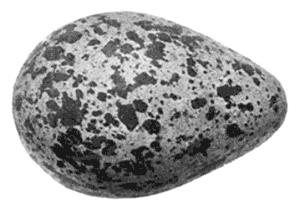
Buffy. Range.--North America, breeding chiefly in the interior and eastern parts of Canada, and rarely in the upper Mississippi Valley. This species is very similar to the preceding, but is smaller; length 10.5 inches. It is also called the "Lesser Tell-tale," a name applied because of their wariness, and because, when they fly, they warn all other species within hearing, of danger. Their eggs are laid on the ground, and in similar localities to the preceding. They are three or four in number, grayish or buffy in color, and are quite heavily blotched and spotted with rich brown and grayish or lilac. Size 1.60 × 1.20. Data.--Whale River, Labrador, June 14, 1902. Four eggs laid on the ground in a large marsh.
|

|
Page 154

|

Solitary Sandpiper. 256. Solitary Sandpiper. Helodromas solitarius solitarius.
Range.--Eastern North America, breeding chiefly north of the United States boundary, but apt to be found nesting in any part of its range; winters south of the United States.
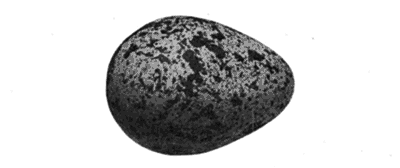
Clay-colored. A bird with a greenish gray back, barred with white, and white below; length 8.5 inches. This species is one of the oddities among the waders. They are most always met with, singly or in pairs, and are very rarely seen, even in very small flocks. Their preference is for small ponds or streams in wet woods or open meadows, rather than marshes which are frequented by other species. They are occasionally seen during the nesting season, even in the southern parts of their range, and they probably breed there although their eggs are very rarely found. The eggs are clay-colored, spotted with brownish black. Data.--Simco Island, Kingston, Ontario, June 10, 1898. 5 eggs in a shallow depression on the ground, lined with a few grasses.

NEST OF SPOTTED SANDPIPER.
|
|
|
Page 155
|
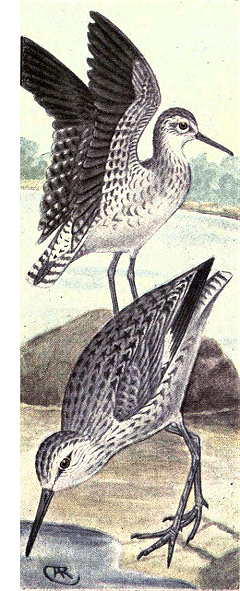
Western Sandpiper.
Willet. 256a. Western Solitary Sandpiper. Helodromas solitarius cinnamomeus.
Range.--North America, west of the Plains;
breeds in British Columbia and probably south
of there, also.
This bird is like the last, except that the spots
on the back are buffy instead of white. Its nest
and eggs will not differ in any respect from those
of the eastern form.
257. Green Sandpiper. Helodromas acrophus.
This species, which very closely resembles our
Solitary Sandpiper, is common in the northern
parts of the Old World. It has only accidentally
strayed to our shores.
258. Willet. Catoptrophorus semipalmatus semipalmatus.
Range.--Eastern United States, breeding north
to the Middle States and occasionally straying to
the Canadian border, especially in the Mississippi Valley.
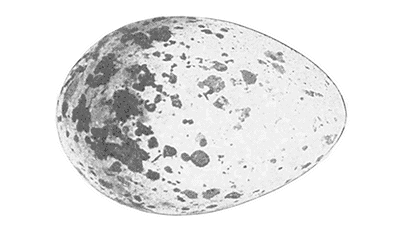
Buff. These large waders are among the most abundant of the marsh or beach
birds. They breed in small companies in marshes, frequently in those which
are covered with water at high tide, building a frail nest of grasses and weeds,
where it will be barely out of reach of the highest water. The three or four
eggs have a brownish, or sometimes greenish, buff ground color and are blotched
with umber, and have fainter markings of lilac. Size 2.00 × 1.50. Data.--Sandy
Bank, South Carolina, May 3, 1901. Nest on the ground, secreted in the
high grass. Made of dead marsh grass, lined with finer grasses.
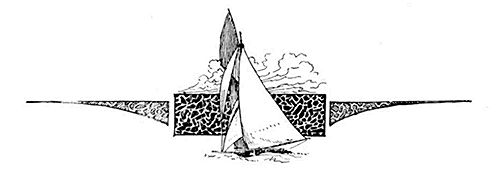
|

|
Page 156

|
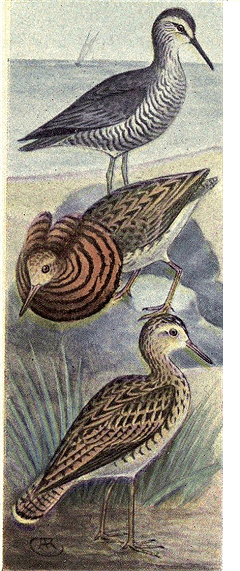
Wandering Tattler.
Ruff.
Upland Plover. 258a. Western Willet. Catoptrophorus semipalmatus inornatus.
Range.--Western North America, breeding
north to Manitoba and British Columbia. Casually
found on the South Atlantic coast during migrations.
A larger and paler form of the preceding species;
length 15.5 inches. The nesting habits are
the same, and the eggs cannot be distinguished
from those of the common Willet. Data.--Refugio,
Texas, May 18, 1900. 4 eggs in a grass
lined depression on the bay shore flat. Collector,
J. W. Preston.
259. Wandering Tattler. Heteractitis incanus.
Range.--Pacific coast of North America, breeding
from British Columbia northward.
This is a handsome species, uniform grayish
above and white below, closely barred (in summer)
with blackish. During the breeding season
it is found on the rugged coasts and islands of
Alaska, and casually south. It breeds in the
marsh grass near the shores and along the banks
of streams.
260. Ruff. Machetes pugnax.
A common European species, occasionally found
on the Atlantic coast of North America. It is a
species remarkable for its pugnacity during the
mating season; in size and appearance it is about
like the Upland Plover, with the exception of the
"ruff" which adorns the neck and breast of the
male bird.
261. Upland Plover. Bartramia longicauda.

Buff. Range.--North America, chiefly east of the Rocky Mountains, breeding from
middle United States, northward.
A handsome bird, 12 inches in length,
generally known as the "Upland Plover,"
from its habit of frequenting dry side hills,
where it feeds upon grasshoppers and
worms. It is a favorite bird with many
sportsmen. It builds a nest of grasses, on
the ground in a tuft of grass in the middle
of fields. The three or four eggs have a buff
ground and are blotched with yellowish
brown. Size 1.75 × 1.25. Data.--Stump Lake,
N. D., June 10, 1897. Nest of grass, lined
with wool, under a tuft of grass left by the
mower. Collector, Alf. Eastgate.
|
|
|
Page 157
|
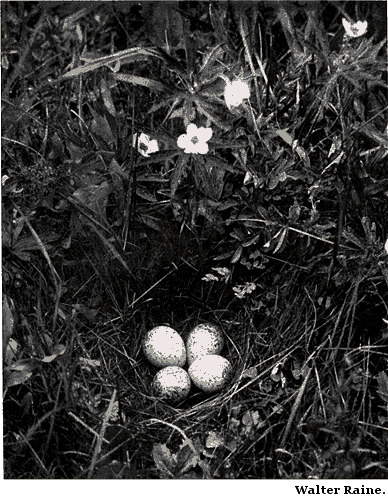
NEST AND EGGS OF UPLAND PLOVER.
|
|
Page 158

|

Buff-breasted Sandpiper.
Spotted Sandpiper. 262. Buff-breasted Sandpiper. Tryngites subruficollis.
Range.--Interior of North America, breeding
from the Hudson Bay region to the Arctic coast.
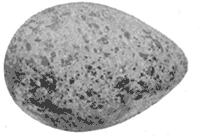
Grayish white. A buffy colored species, with a peculiarly marbled
back. Size 8.5 inches long. It is an upland
species like the last. The nests are scantily lined
depressions in the ground. The eggs have a
grayish white ground
and are boldly blotched
with rich brown and
chestnut with fainter
markings of lilac. Size
1.45 × 1.05. Data.--Cape
Smythe, Alaska, June,
1900. 4 eggs in a hollow
in dry spot on a
marsh. Collector, H. H.
Bodfish.
263. Spotted Sandpiper. Actitis macularia.
Range.--Whole of North America from Hudson
Bay southward, breeding throughout its range.
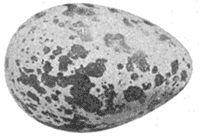
Buff. A small wader about 7.5 inches in length, with
brownish gray upper parts, and white underparts
thickly spotted with blackish, especially on the
breast and flanks. This is the most abundant of
all the shore birds, and its "peet-weet" is a familiar
sound to every country boy. It has a peculiar
habit of continually moving its tail up and down,
when at rest on a stone or when running along
the shore; from these characteristic actions it
has received the very common names of "Teeter-tail"
and "Tip-up." They build their nests on the
ground near ponds, brooks or marshes, generally
concealing it in a tuft of grass or weeds on the
shore or in the high grass at the edge of the
meadows. The eggs number from three to five and are of a grayish buff color,
spotted and blotched with blackish brown. The young, like those of all the
shore birds, are hatched covered with down, and run about as soon as born.
They are anxiously attended by the parents and at
the least sign of danger, conceal themselves beneath
a tuft of grass or behind a small stone, where they
remain perfectly motionless until called by the old
birds. The adults frequently attempt to lead an enemy
away from the young by feigning a broken
wing, or lameness. Size of eggs 1.35 × .90. Data.--Parker
County, Ind., May 22, 1901. Nest about six
yards from bank of creek, among weeds on a sand
bar; a hollow in the sand lined with weeds. Collector,
Winfield S. Catlin.

|
|
|
Page 159
|

Long-billed Curlew.
Hudsonian Curlew. 264. Long-billed Curlew. Numenius americanus.
Range.--Breeds in the South Atlantic states
and northward in the interior to Manitoba and
British Columbia.
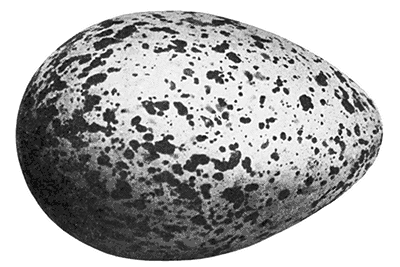
Greenish buff. This is the largest of the family of shore birds,
having a length of about 24 inches. Its plumage
is of a buffy color, much variegated above with
black and brown; the bill is strongly curved downward
and is from four to eight inches in length.
Their nests are located on the ground in meadows
or on the prairies, and three or four eggs are laid,
of a buff or greenish buff color, covered with
numerous spots of brownish black. Eggs of the
common Curlew of Europe, have been very frequently
used as belonging to this species, but the
eggs of our species have a lighter and more
greenish ground, and the spots are smaller and
more numerous. Size, 2.50 × 1.80.
265. Hudsonian Curlew. Numenius hudsonicus.
Range.--Whole of North America, breeding in the Arctic regions and wintering
south of the United States.

Brownish buff. This species is smaller (length
17 inches), darker, more grayish
and has a shorter bill than the preceding
species. It also has white
median and lateral stripes on the
top of the head. The nesting habits
are the same as those of the
Long-billed species; the three or
four eggs have a brownish buff
ground color and are blotched with
blackish brown. Size 2.25 × 1.60.
Data.--McKenzie River, Arctic
America. Nest a pile of grass,
moss and weeds on an island in
the river.
|

|
Page 160

|
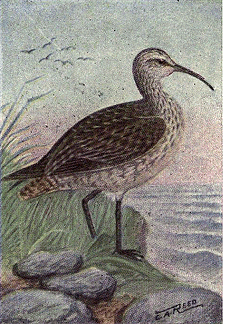
Eskimo Curlew. 266. Eskimo Curlew. Numenius borealis.
Range.--Eastern North America, breeding in
the Arctic regions and wintering in South
America; migrating through the eastern half
of the United States, more abundantly in the
interior than on the coast.
A still smaller species than the last (length
14 inches) and very similar to it. A few years
ago this was considered the most abundant of
the curlews, but so persistently have they been
hunted that they are now practically exterminated.
They were the most unsuspicious of the
shore birds, and would allow the near approach
of the gunner, and the penalty may now be
seen. Only a short while ago they were very
often found, during migration, in company with
other waders such as the Golden or Black-bellied
Plovers. Their nests are simply hollows
in the plains, lined with a few grasses, dried
leaves, or moss. The three or four eggs are the
same as the last for color but are smaller;
size 2.00 × 1.45.
267. Whimbrel. Numenius phaeopus.
A European species casually appearing in Greenland; very similar to the
Hudsonian Curlew, but with the rump white.
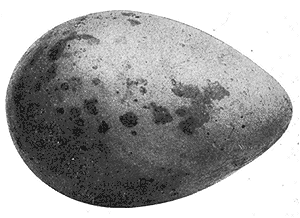
Olive brown. This species is known as the
Jack Curlew in England and
Scotland, where it is very abundant,
and is a favorite game bird.
It breeds in the northern parts
of Europe and Asia, and in the
extreme north of Scotland and
on the Shetland Islands. The
eggs are laid in hollows on the
ground on higher parts of the
marshes. The three or four eggs
have an olive or greenish brown
color and are blotched with dark
brown. Size 2.30 × 1.60. Data.--Native,
Iceland, May 29, 1900.
Six eggs. Nest a depression in
the ground, lined with dried
grass.
268. Bristle-thighed Curlew. Numenius tahitiensis.
Range.--Islands and coast on the Asiatic side of the Pacific; casually found
in Alaska. A very peculiar species with many of the feathers on the flanks
terminating in long bristles.
|
|
|
Page 161
|
PLOVERS. Family CHARADRIIDÆ
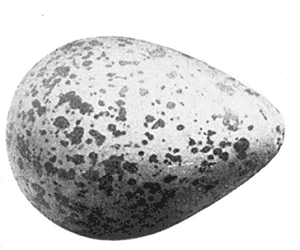
Grayish. Plovers are stouter built birds than those of
the previous family, have larger head, shorter
necks and but three toes, the bill also is much
harder and shorter.
269. Lapwing. Vanellus vanellus.
An abundant European species accidentally
occurring on the Atlantic coast. It may readily
be recognized by its long black crest, black
chin and throat, and white under parts. It
breeds throughout temperate Europe, laying
its eggs in hollows on the ground. The eggs
have a dark grayish buff ground and are spotted
with black. Size 1.85 × 1.30.
269.1. Dotterel. Eudromias morinellus.
A European bird supposed to have been accidentally taken on the Atlantic
coast.
270. Black-bellied Plover. Squatarola squatarola.
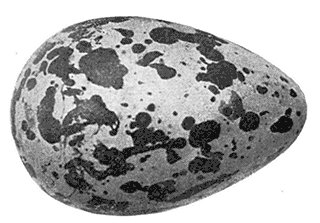
Greenish buff. Range.--Northern Hemisphere, breeding in the Arctic regions and wintering
from the Gulf States to northern South America.
This is a remarkably handsome species
when in the summer dress. The upper
parts are largely white with black
spots and bars on the back, wings and
tail; the throat, sides of head, breast
and fore under parts, black. In winter,
brownish-black, somewhat mottled, above;
below, dull white. Young similar to winter
adults, but the back is spotted with
yellowish-white. While these handsome
plover migrate to some extent, and sometimes
in large flocks, through the interior
of the United States, they are chiefly
and most abundantly found on the coast.
This species has a very small hind toe.
It is a very familiar bird to sportsmen
and gunners, to whom it is generally known by the names of "Bull-head," or
"Beetle-head Plover." They are very numerous in the fall, during which season
the underparts are entirely white. The eggs are either laid upon the bare
ground or upon a slight lining of grasses or dead leaves. They are three or
four in number, brownish or greenish buff in color and boldly marked with black.
Size 2.00 × 1.40. Data.--Point Barrow, Alaska, June, 1900. Nest a small hollow
on side of hillock, lined with dry grass.
|

|
|
Page 162
|

BLACK-BELLIED PLOVER.
|
|
|
Page 163
|
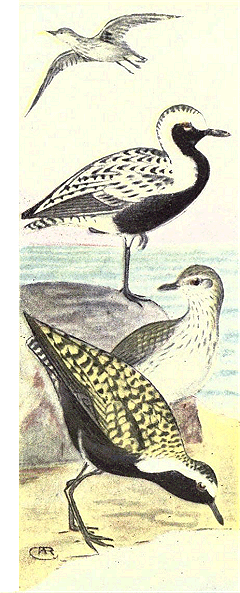
Black-bellied Plover.
Golden Plover. 272. European Golden Plover. Charadrius apricarius.
A European bird, similar to the next, casually
found in Greenland.
It is a very abundant bird throughout Europe,
breeding in the northern parts. Its habits, nests
and eggs are the same as those of the American
bird.
272. Golden Plover. Charadrius dominicus dominicus.
Range.--Whole of North America, breeding in
the Arctic regions and wintering south to Patagonia.
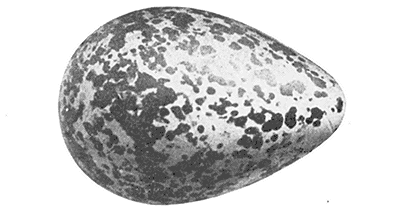
Greenish buff. This handsome bird is about the same size as
the Black-bellied Plover (10.5 inches long). No
hind toe. Back and tail mottled with black and
yellow; below, more or less entirely black to the
tail. Young and winter adults, more or less spotted
with yellow and blackish-brown above, and
grayish-white below, with indistinct streaks on the breast. Often confused with
the last species in this plumage, but is smaller, bill smaller and more slender,
and the axillars, or feathers nearest the body, under the wings, are gray while
those of the Black-bellied Plover are black. This species is now regarded as
rare on the North Atlantic coast during migrations, while in the interior it is
more abundant than the last species. They do not seem to be as suspicious as
the Black-bellies, and a flock will often allow a close approach, even when they
see you. They nest abundantly along the coast and islands of the Arctic Ocean.
The four eggs are very similar to those of the preceding, but smaller. Size 1.90
× 1.30. Data.--Peel River, Arctic America, June 1, 1898. Nest of grasses and
leaves on the ground in the moss.
272a. Pacific Golden Plover. Charadrius dominicus fulvus.
Range.--An Asiatic species, breeding in northern Asia and on the islands
and coast of Asia. Very like the preceding, but more golden color on the back
and wings. Nesting and eggs the same.
|

|
|
Page 164
|
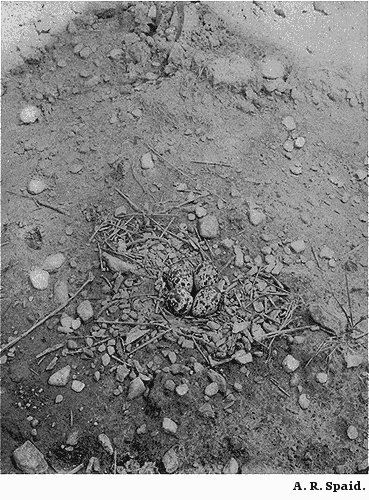
NEST AND EGGS OF KILLDEER.
|
|
|
Page 165
|
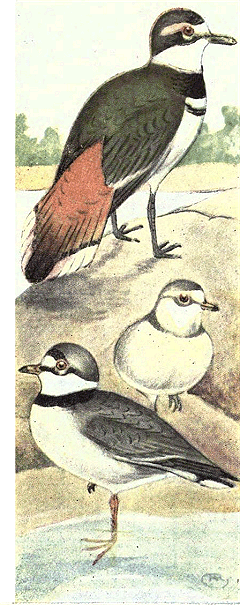
Kildeer.
Semi-palmated Plover. 273. Killdeer. Oxyechus vociferus.
Range.--Temperate North America from the
southern parts of Canada southward. Next to the
Spotted Sandpiper, this bird is the most common
of the shore birds in the United States. It is
rarely seen in New England, but is common south
of there and in the interior of the country to Canada.
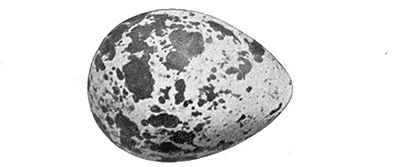
Grayish buff. They are very noisy birds, continually uttering
their "kil-deer, kil-deer" from which they take
their name. They nest anywhere on the ground,
generally near water, placing their nests in fields,
cornfields or meadows. The eggs are drab or
greenish buff and profusely spotted with black.
Size 1.50 × 1.10. Data.--Refugio county, Texas,
May 11, 1899. 4 eggs in a depression on the
ground, lined with a few grasses.
274. Semipalmated. Ægialitis semipalmata.
Range.--North America, breeding in the interior
of Canada and wintering south from the Gulf
States.
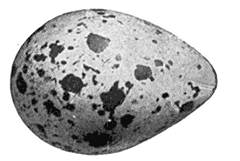
Buff. Small web between the bases of the two outer
toes. Single broad, black band across the breast;
black line from base of bill to eye. They are very
abundant on our seacoast in Fall, both in flocks
composed entirely of their own kind, and also
with Least and Semipalmated Sandpipers. They
usually keep on the inner side of sandbars or
muddy flats bordering marshes, rather than on the
open ocean beach. It is also found in smaller
flocks, about ponds and marshes in the interior of
the country. They are usually unsuspicious and will allow a close approach, or
if you are still, will run by within a very few feet. Nest on the ground; eggs
buffy, sparsely specked with black, 1.30 × .90; June.
|

|
Page 166

|
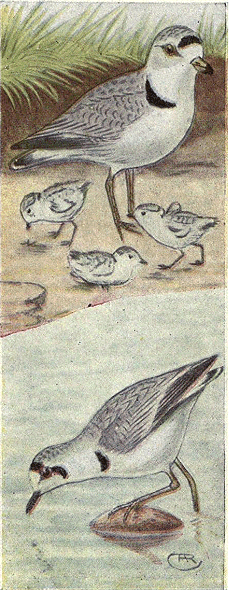
Ring Plover.
Snowy Plover. 275. Ring Plover. Ægialitis hiaticula.
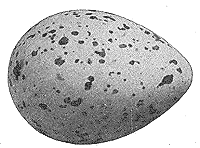
Buffy. Range.--A European bird that breeds abundantly
in Greenland. It nests in great numbers on
the banks of streams
and in fields, laying
its eggs in hollows on
the ground, generally
without any lining.
Their three or four
eggs are practically
not distinguishable
from those of the Semipalmated
Plover, but
larger; size, 1.40 x 1.00. The bird, too, is similar,
but the toes are not palmated, and the black
breast band is wider.
276. Little Ringed Plover. Ægialitis dubia.
An Old World species, accidentally occurring
on the Pacific coast. Like the last species, but
smaller. The eggs, too, are smaller; size 1.20
x .85.
277. Piping Plover. Ægialitis meloda.
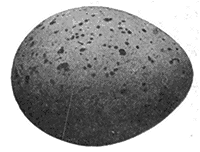
Clay Color. Range.--Eastern North America, chiefly along
the Atlantic coast, breeding from the Carolinas
north to Newfoundland.
A handsome little bird, with a black crescent
on each side of neck, a small black patch on top
of the head, and without any black on the lores
or ear coverts. It is the lightest colored of any
of the eastern Plovers. Length, 7 inches. Young,
similar, but the black replaced by grayish, as is
the case with the last species. This species, apparently, never could be classed
as abundant and of late years, it is becoming rather rare along our Atlantic
coast; this is probably more due to the building of
summer resorts and homes along their former breeding
grounds than to hunters. They are rather more shy
than the last species, but will usually attempt to escape
by running along the beach or by hiding, rather
than by flight. Owing to their light colors it is very
difficult to see them at any distance. They lay their
eggs upon the sandy beaches in slight, and generally
unlined, hollows. The eggs have a pale clay colored
ground and are sparsely specked with small black
dots. Size 1.25 x 1.00.

|
|
|
Page 167
|
278. Snowy Plover. Ægialitis nivosa.
Range.--Breeds along the Pacific coast of the United States, and from Texas
to Manitoba in the interior. Winters on the California coast and south to Chili.
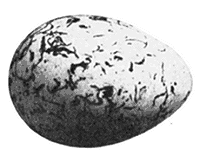
Pale buff. Snowy Plovers are very much like the Piping, but
are smaller (length 6.5 inches), have a longer and
more slender bill, and have a small black patch on
the side of head. It is the palest colored of the
Plovers. Large numbers of them nest along the
Pacific coast and in Texas; north of Texas, in the
interior, they are locally distributed. The eggs are
pale clay color, marked with small scratchy dots of
black. Size 1.20 x .90. Data.--Newport Beach, California,
May 1, 1897. Nest a hollow in the sand, a
short distance above high water; lined with broken
shell. Collector, Evan Davis.
279. Mongolian Plover. Ægialitis mongola.
An inhabitant of the Old World, awarded a place in our avifauna because of
its accidental occurrence at Alaska.

SPOTTED SANDPIPER AND NEST.
|

|
Page 168

|
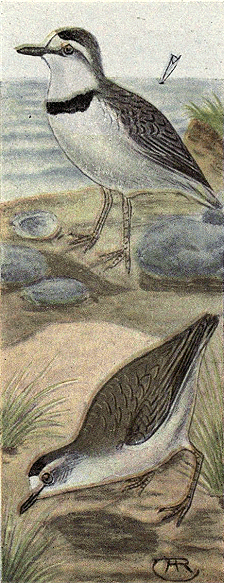
Wilson's Plover.
Mountain Plover. 280. Wilson's Plover. Octhodromus wilsonius.
Range.--An abundant breeding species on the
Gulf coast, coast of Lower California, and on the
Atlantic coast north to Virginia, and casually
farther.
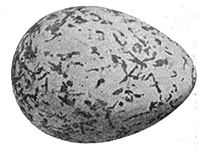
Olive gray. A common Plover, which may be distinguished
from others of the genus by its comparatively
large heavy black bill, and the single broad black
band across the
breast, and not extending
around the
back of the neck.
They nest on pebbly
"shingle" or in
the marsh, back of
the beaches. Their
eggs are an olive
gray color and are
spotted and scratched
with blackish
brown, with some
fainter markings of gray. Size 1.40 x 1.05. Data.--Corpus
Christi, Texas, May 10, 1899. 4 eggs
laid on the ground among drifted grass on a salt
marsh near town. Collector, Frank B. Armstrong.
281. Mountain Plover. Podasocys montanus.

Brownish gray. Range.--Plains and prairies of western North
America, breeding from the central portions
north to Manitoba, and wintering in California
and southward.
A very peculiar species, inhabiting even the
driest portions of the western prairies. It is 9
inches in length, and has a plumage of a pale
buffy tone. It seems to be less aquatic than any
other American Plover and is rarely found in the
vicinity of bodies of water. It nests on the ground
anywhere on the prairie, laying its eggs in a
slight hollow. The eggs are brownish gray in
color and are spotted and blotched with blackish
brown. Data.--Morgan county, Colorado, May 7,
1902. Nest a slight hollow on the ground, near a
large cactus bed and close to a water hole. No
lining to nest. Collector, Glenn S. White.

|
|
|
Page 169
|
SURF BIRDS AND TURNSTONES. Family APHRIZIDÆ
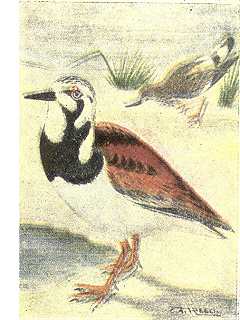
Turnstone. 282. Surf Bird. Aphriza virgata.

Creamy. This species, which is found on the Pacific
coast from Alaska to Chili, seems to be the
connecting link between the plovers and the
Turnstones, having the habits of the latter
combined with the bill of the former. Its nest
and eggs are not known to have been yet discovered.
283. Turnstone. Arenaria interpres.
Range.--The distribution of this species, which is grayer above than the following,
is supposed to be confined, in America, to the extreme north from
Greenland to Alaska. Its habits and eggs are precisely like the next.
283a. Ruddy Turnstone. Arenaria interpres morinella.
Range.--Breeds in the Arctic regions, and migrates through all parts of the
United States, south to the southern parts of South America. This species has
the upperparts variegated with reddish brown, black and white; the underparts
are pure white, except for a black patch on the throat, branching upward to the
eye and back to the sides of the breast. It has a peculiar, slightly up-turned
bill, which is used, as their name implies, for turning over pebbles and stones
in their search for food. They nest commonly in northern Labrador, about
Hudson Bay and in Alaska, laying their eggs in scantily lined hollows on the
ground, near water. The eggs are very peculiar and beautiful, having a light
grayish or cream color ground, peculiarly marbled with many shades of brown
and lilac. Size 1.65 × 1.10. Data.--Mackenzie River, Arctic America, June 28,
1900. Four eggs in a grass lined depression in the sand.

|

|
Page 170

|
284. Black Turnstone. Arenaria melanocephala.
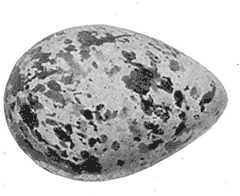
Grayish. Range.--Pacific coast of North America, breeding
from British Columbia northward, and wintering
south to Lower California.
This species, which has the form and habits of
the preceding, is blackish above and on the breast;
the rump and the base of the tail are white, being
separated from each other by the black tail coverts.
Their nesting habits are in no wise different
from those of the common turnstone. The
eggs are similar, but the markings are not so
strikingly arranged. Size 1.60 × 1.10. Data.--Kutlik,
Alaska, June 21, 1898. Nest simply a depression
in the sand on the sea beach.
OYSTER-CATCHERS. Family HÆMATOPODIDÆ
285. European Oyster-catcher. Hæmatopus frazari.
This European species is very similar to the American one which follows. It
casually occurs in Greenland.
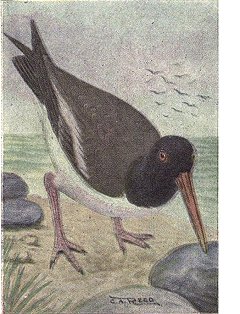
American Oyster-catcher. 286. Oyster-catcher. Hæmatopus palliatus.
Range.--Breeds on the coast of the South
Atlantic States and Lower California and winters
south to Patagonia. Oyster-catchers are
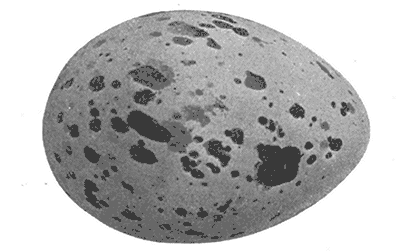
Buff. large, heavy-bodied birds, with stocky red legs
and long, stout red bills. The present species
has the whole upper parts and entire head and
neck, blackish; underparts and ends of secondaries, white; length, 19 inches. They
are abundant breeding birds on the sandy beaches of the South Atlantic States,
and casually wander north to Nova Scotia. They lay their two or three eggs
on the ground in slight hollows scooped out of the sand. The eggs are of a
buffy or brownish buff color, and are irregularly spotted with blackish brown,
with subdued markings of lavender. Size 2.20 × 1.50. Data.--Sandy Point, S.
C., May 12, 1902. Three eggs on the sand just above high water mark; nest a
mere depression on a small "sand dune" lined with pieces of shells.
|
|
|
Page 171
|
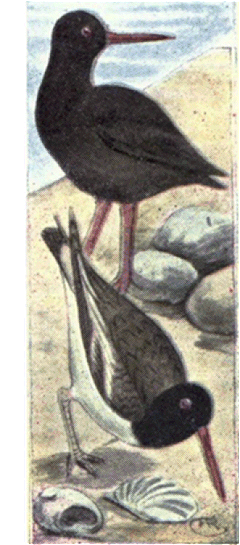
287--286.1. 286.1. Frazar's Oyster-catcher. Hæmatopus bachmani.
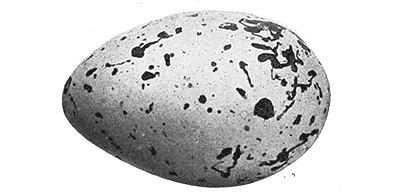
Brownish buff. Range.--Lower California.
This species is darker on the back than the preceding,
and the breast is mottled with dusky. Bill very long,
heavy, compressed, and thin and chisel-like at the tip.
Bill and eyes red; legs flesh color; under parts white, and
a white wing bar. These are large, awkward looking birds.
It is not an uncommon wader in its somewhat restricted
range. Its nesting habits are the same as those of the
preceding one, but the markings are generally more sharply
defined. The one figured is from a set in the collection of Mr. C. W. Crandall.
287. Black Oyster-catcher. Hæmatopus bachmani.
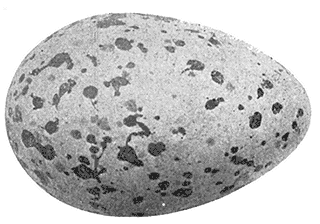
Olive buff. Range.--Pacific coast of North
America from Lower California
north to Alaska.
This species is the same size as
the Oyster-catcher, but the plumage
is entirely black both above and below.
They are found upon the
rocky coasts and islands, more frequently
than upon sandy beaches.
Their eggs are laid upon bare rocks
or pebbles with no attempt at lining
for the nest. The eggs are an
olive buff in color, spotted and
blotched with brownish black.
Size 2.20 × 1.55. Breeding throughout
the Aleutian Islands, British
Columbia and south to Lower California. Three or four eggs are laid.

|

|
Page 172

|
JACANAS. Family JACANIDÆ
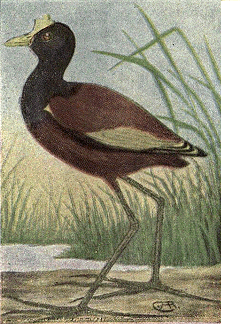
Mexican Jacana. 288. Mexican Jacana. Jacana spinosa.
Range.--Tropical America, north in summer
to the lower Rio Grande Valley in Texas, and
casually to Florida.
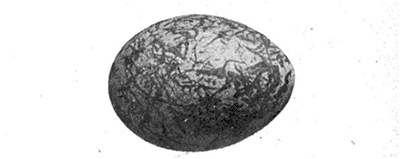
Yellowish olive. This interesting species has most of its
structural characters similar to the Plovers,
but has more the appearance and habits of the
Rails. They are about eight inches long, the
head and neck are black, the body chestnut,
and the wings largely greenish yellow. They
have long legs, long toes and extremely long toe nails, a scaly leaf on the forehead,
and a sharp spur on the shoulder of the wing. Owing to their long toes
and nails, they are enabled to walk over floating weeds and rubbish that would
sink beneath their weight, otherwise. They build their nests on these little
floating islands in the marsh; they are also sometimes made of weeds and
trash on floating lily pads. They lay from three to five eggs of a yellowish
olive color, curiously scrawled with brown and black. Size 1.22 × .95. Data.--Tampico,
Mexico, June 3, 1900. Three eggs. Nest of weeds and drift on lily
leaf floating in fresh water pond near town.
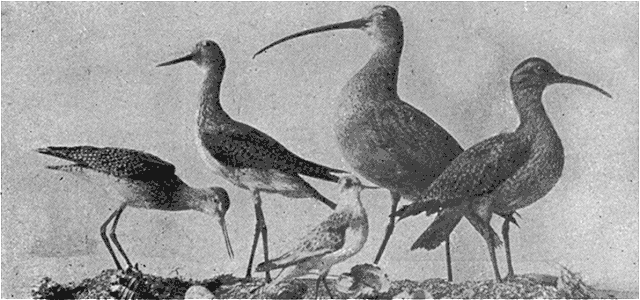
|
|
|
Page 173
|
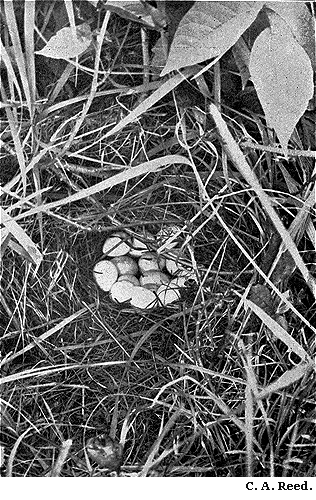
NEST AND EGGS OF BOB-WHITE.
|
|
|
Page 174
|

BOB WHITE.
Female--Male.
|
|
|
Page 175
|
GALLINACEOUS BIRDS. Order X. GALLINÆ
GROUSE, PARTRIDGES, ETC. Family TETRAONIDAE
The members of this family are birds of robust form, subdued (not brightly
colored) plumage, comparatively short legs and necks; the tarsi and toes are
feathered in the Ptarmigan, the tarsi, only, feathered in the Grouse, and the
tarsi and toes bare in the Partridges and Bob-whites. They feed upon berries,
buds, grain and insects.
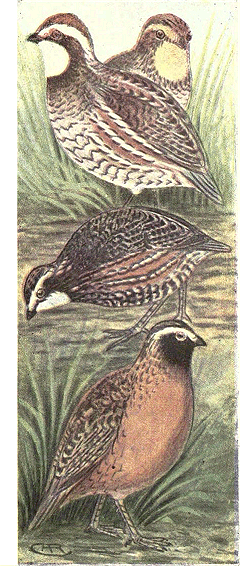
Bobwhite.
Florida Bobwhite.
Masked Bobwhite. 289. Bob-white. Colinus virginianus virginianus.
Range.--United States east of North Dakota and
Texas and from the southern British Provinces to
the Gulf coast.
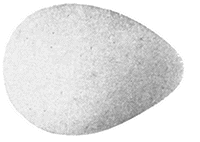
White. A celebrated "game bird" which has been hunted
so assiduously in New England that it is upon
the verge of extermination, and the covers have
to be continually replenished with birds trapped
in the south and west. They frequent open fields,
which have a luxuriant
growth of weeds, or
grain fields in the fall.
Their nests are built
along the roadsides, or
beside stonewalls or
any place affording satisfactory
shelter. The
nest is made of dried
grasses and is arched
over with grass or
overhanging leaves so as to conceal the eggs.
They lay from ten to twenty pure white eggs,
which are very frequently nest stained when
found. Size 1.20 × .95. Often two or three broods
are raised in a season, but frequently one or more
broods are destroyed by rainy weather.
289a. Florida Bob-white. Colinus virginianus floridanus.
Range.--This sub-species, which is found in the
southern half of Florida, is very much darker
than the northern Bob-white, and is numerously
barred below with black. Its nesting habits and
eggs are identical with those of the preceding.
289b. Texas Bob-white. Colinus virginianus texanus.
Range.--Texas; casually north to Kansas. A grayer variety of the Bob-white.
The nesting habits and eggs are the same as those of the Bob-white, except that
the eggs may average a trifle smaller. Size 1.18 × .92.
291. Masked Bob-white. Colinus ridgwayi.
Range.--Sonoran region of Mexico north to southern Arizona.
The female of this species is like that of the Texan Bob-white. Their nesting
habits and eggs are in all respects like those of the other Bob-whites. Size of
eggs, 1.20 × .95.
|

|
Page 176

|
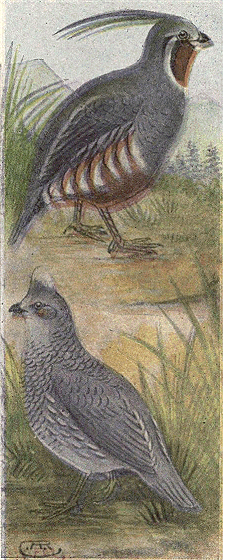
Mountain Partridge.
Scaled Partridge. 292. Mountain Quail. Oreortyx picta picta.
Range.--Pacific coast of North America from
California to Washington.
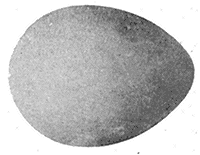
Reddish buff. This is the largest of the Partridges, being 11
inches in length. It is of a general grayish color,
with chestnut throat patch, and chestnut flanks,
barred with white.
Two long plumes extend
downward from
the back of the head.
This species nests
abundantly in the
mountainous portions
of northern California
and throughout Oregon,
and is gradually increasing
in numbers in
Washington. As a rule
they nest only on the
higher mountain ranges, placing their nest of
leaves under the protection of an overhanging
bush or tuft of grass. Their eggs number from
six to fifteen, and are of a pale reddish buff color.
Size 1.35 × 1.05.
292a. Plumed Quail. Oreortyx picta plumifera.
Range.--Mountain ranges of California and
Lower California, chiefly in the southern parts of
the former. This species is like the latter except
that it is grayer on the back of the head and
neck. Its nesting habits and eggs are like the
preceding.
292b. San Pedro Quail. Oreortyx picta confinis.
Range.--San Pedro Mountains, Lower California.
This species, which is grayer above than the preceding two, breeds only in
the highest peaks of its range. Otherwise its nesting habits and eggs are the
same as the other Plumed Partridges.
293. Scaled Quail. Callipepla squamata squamata.
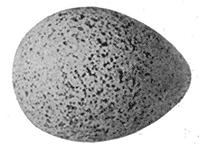
Creamy white. Range.--Mexico and southwestern border of the United States.
This blue gray species is 10 inches in length; the
feathers on the neck and underparts have narrow
dark borders, thus giving the plumage a scaly appearance,
from which the birds take their name.
They have a small tuft of whitish or buffy feathers
on the top of the head. It is especially abundant in
the dry arid portions of its range, being found often
many miles away from water. Their eggs are laid
in a shallow hollow under some small bush or cactus,
and number from eight to sixteen; they are creamy
white, finely specked with buff or pale brownish.
Size 1.25 × .95.
|
|
|
Page 177
|
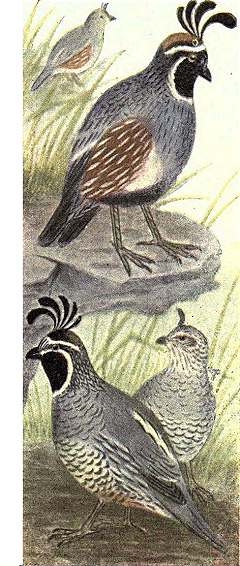
California Partridge. 293a. Chestnut-bellied Scaled Quail. Callipepla squamata castanogastris.
Range.--Lower Rio Grande Valley in Texas and
and southward into Mexico.
This sub-species is like the last with the addition
of a chestnut patch on the belly. Their
breeding habits do not vary in any particular way
from those of the Scaled Partridge.
294. California Quail. Lophortyx californica californica.
Range.--Coast region of California, Oregon,
Washington and British Columbia.
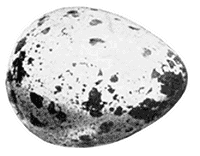
Creamy white. This is one of the most beautiful of the Partridges,
with its crest of feathers rising from the
crown and curving forwards so that the broadened
ends hang directly
over the bill. It is
about the size of the preceding
species, and is distinguished
from the following
one by its white
forehead, chestnut patch
on the belly and the scaly
appearance of the feathers
in that region, by its dark
crown and the gray flanks
with white streaks. They lay from eight to
twenty eggs with a creamy white or buffy ground
color, handsomely blotched with shades of brown
and yellowish brown. Size 1.20 × .93.
294a. Valley Partridge. Lophortyx californica vallicola.
Range.--Interior portions of California, Oregon and Washington.
The nesting habits of this grayer sub-species do not differ in any manner
from those of the above species. The eggs are indistinguishable.
295. Gambel Quail. Lophortyx gambeli.
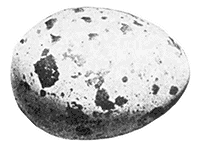
Buff. Range.--Southwestern United States from Texas to California; north to Utah.
This handsome species differs from the California
in the Chestnut crown and flanks, and the black
patch on the belly. They are very abundant in Arizona,
both on the mountains and in the valleys, and
apparently without any regard to the nearness to, or
remoteness from a water supply. They breed during
May, laying their eggs on the ground under any
suitable cover. The eggs cannot be distinguished
from those of the California Partridge, except that
they average a trifle larger. Size 1.25 × .95.
|

|
Page 178

|
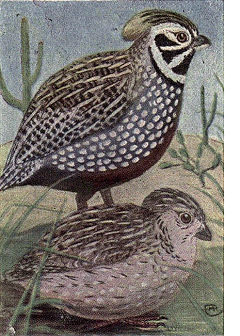
Mearns Partridge. 296. Mearns Quail. Cyrtonyx montezumæ mearnsi.
Range.--Mexico, north to southern Arizona
and New Mexico, and to western Texas.
A remarkable species about 9 inches long;
often called "Fool Quail" because of its eccentric
and clownish markings, streaks and spots
of black, white, buff, gray and chestnut. It is
met with in small flocks on the mountains and
less frequently in the valleys. It frequents
scrubby wooded places rather than open hill
sides and is very easy to approach and kill;
this confidence or stupidity together with its
clownish appearance are the reasons for its
commonly used local name. Their nests are
hollows in the ground, lined with grasses and
concealed by overhanging tufts of grass. The
eggs, which are pure white, are not distinguishable
with certainty from those of the Bob-white,
but average longer. Size 1.25 × .95.
297. Dusky Grouse. Dendragapus obscurus obscurus.
Range.--Rocky Mountain region from central Montana south to New Mexico.
With the exception of the Sage Grouse, this species is the largest of the family,
being about 20 inches in length. The general tone of its plumage below is
gray; above, blackish gray and the tail blackish with a broad terminal band of
light gray. They frequent the wooded and especially the coniferous districts,
where they build their nests under fallen trees or at the bases of standing ones.
They lay from six to ten eggs of a buffy color, sparsely spotted and blotched
with brownish. Size 2.00 × 1.40.
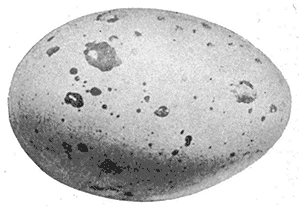
Rich buff. 297a. Sooty Grouse. Dendragapus obscurus fuliginosus.
Range.--Mountain ranges along the
Pacific coast from California to British
Columbia.
Like the last, this somewhat darker
sub-species is met with in timbered
regions, where its habits are about the
same as those of the Ruffled Grouse,
except, of course, that they are not
nearly as shy as the Grouse in New
England. Their eggs are laid in hollows
beside stumps or under logs.
The eggs are buff colored, spotted with
reddish brown. Size 2.00 × 1.40.

|
|
|
Page 179
|
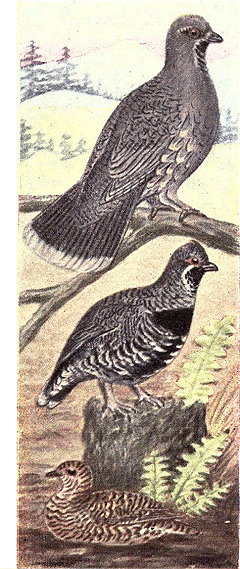
Sooty Grouse.
Spruce Grouse. 297b. Richardson's Grouse. Dendragapus obscurus richardsoni.
Range.--Northern Rocky Mountains from central
Montana to British Columbia.
A dark variety with no terminal band of gray
on the tail. Its habits, nesting and eggs are precisely
like those of the preceding species.
298. Hudsonian Spruce Partridge. Canachites canadensis canadensis.
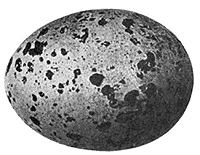
Bright buff. Range.--Northern United States and southern
British Provinces; west to Minnesota.
A dark species, smaller than the last (15 inches
long), and easily recognized by its black throat
and extensive black patch on the breast. The
habits of this species
and the two varieties
into which it
has been sub-divided
are the same; as a
species, they are
very tame, will not
fly unless actually
obliged to, and frequently
allow themselves
to be knocked
down with sticks.
Their nests are hollows
in the leaves on the ground, generally under
the sheltering branches of a low spreading fir
tree. The six to fifteen eggs are a bright buff
color, blotched and spotted boldly with various
shades of brown. Size 1.70 × 1.25.
298b. Alaska Spruce Partridge. Canachites canadensis osgoodi.
Range.--Alaska.
This variety is practically the same as the preceding, the birds not always
being distinguishable; the nest and eggs are the same as the Canada
Grouse.
298c. Canada Spruce Partridge. Canachites canadensis canace.
Range.--Labrador and the Hudson Bay region.
Like the last, this variety is hardly to be distinguished from the Hudsonian.
Its nesting habits and eggs are the same.

|

|
Page 180

|
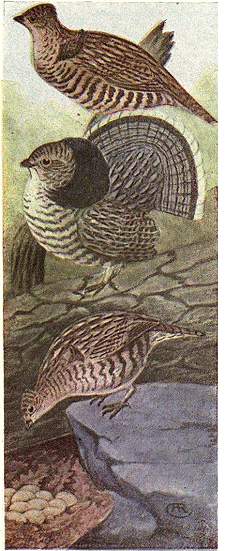
Ruffed Grouse. 299. Franklin's Grouse. Canachites franklin franklini.

Brownish buff. Range.--Northwestern United States and British
Columbia.
This species is very similar to the Canada
Grouse, the most apparent difference being the
absence of the brownish gray tip to the tail, and
the upper coverts are broadly tipped with white.
This species,
which is very
abundant in the
northwest, has
the same stupid
habits of the eastern
bird. During
the mating season,
the males of
both this and the
preceding species
have the same
habit of "drumming"
that the
Ruffed Grouse has. Their nests are placed on
the ground under bushes or fir trees and from
eight to fifteen eggs are laid. These are brownish
buff in color, spotted and blotched with rich
brown. They are very similar to the eggs of the
Canada Grouse. Data.--Moberly Peak, Cascade
Mts., British Columbia, June 9, 1902. 7 eggs in a
slight hollow on the ground. Collector, G. F.
Dippie.
300. Ruffed Grouse. Bonasa umbellus umbellus.
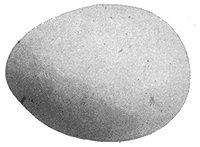
Brownish buff. Range.--Eastern United States from Minnesota
to New England; south to Virginia.
The Ruffed Grouse is "King of the Game Birds"
in the east, where it has been hunted so freely,
that it has become very wary and requires a skillful
marksman to bring it down. Because of the
cutting off of all heavy timber, and the vigor with
which they are pursued by hunters, they are becoming
very scarce in New England, and within
a few years they will probably be practically extinct
in that section. Their favorite resorts are
heavily timbered woods or low growth birches.
Their nests are hollows in the leaves under fallen
trees, beside some stump or concealed among the
small shoots at the base of a large tree. The bird
sits very close, but when she does fly, goes with the familiar rumble and roar
which always disconcerts the novice, the wind created by her sudden flight
generally causing the leaves to settle in the nest and conceal the eggs. They
lay from eight to fifteen eggs, of a brownish buff color, sometimes with a few
faint markings of brown, but generally unspotted. Size 1.55 × 1.15. The young
of all the Partridges and Grouse are born covered with down and follow their
parents soon after leaving the shell. The adults are very skillful in leading
enemies away from their young, feigning lameness, broken wings, etc. The
nesting habits and eggs of the three sub-species are precisely the same in every
respect as those of this bird.
|
|
|
Page 181
|

RUFFED GROUSE.
|
|
Page 182

|

299--300a. 300a. Canada Ruffed Grouse. Bonasa umbellus togata.
Range.--Northern United States and southern British
Provinces from Maine and Nova Scotia west to Washington
and British Columbia.
300b. Gray Ruffed Grouse. Bonasa umbellus umbelloides.
Range.--Rocky Mountain region from Colorado to
Alaska.
A grayer species than the common.
300c. Oregon Ruffed Grouse. Bonasa umbellus sabini.
Range.--Pacific coast from California to British Columbia.
A dark species with the prevailing color a reddish tone.

NEST AND EGGS OF RUFFED GROUSE.
|
|
Page 183

|
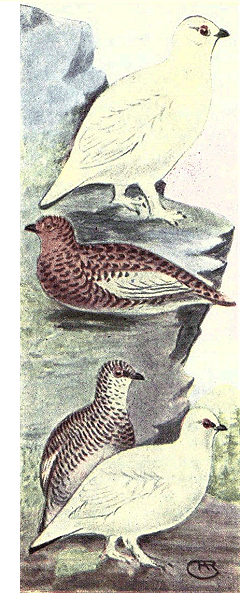
Willow Ptarmigan.
Rock Ptarmigan. 301. Willow Ptarmigan. Lagopus lagopus lagopus.
Range.--Arctic regions, in America south nearly
to the United States border, and casually to
Maine.
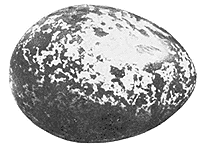
Brownish buff. Ptarmigan are Grouse-like birds, feathered to
the toe nails; they have many changes of plumage,
in winter being nearly pure white, and in
summer largely reddish brown or grayish, barred
with black.
In the breeding
plumage they
have red comb-like
wattles over
the eye. In other
seasons, their
plumage varies in
all degrees between
winter and
summer. They
nest on the
ground in hollows
among the leaves,
lined with a few grasses, and sometimes feathers.
They lay from six to sixteen eggs which have a
ground color of buff or brownish buff, heavily
speckled, blotched and marbled with blackish
brown. Size 1.75 × 1.25.
301a. Allen's Ptarmigan. Lagopus lagopus alleni.
Range.--Newfoundland. A very similar bird to
the preceding; eggs indistinguishable.
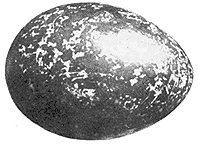
Buff. 302. Rock Ptarmigan. Lagopus rupestris rupestris.
Range.--Chiefly in the interior of British
America, from the southern portions to Alaska
and the Arctic Ocean.
A species with a smaller bill and in summer
a grayer plumage, more finely barred with
black. Its nesting habits are the same as the
other species, it nesting on the ground in such
localities as would be frequented by the Ruffed
Grouse. Its eggs cannot be positively distinguished
from those of the Willow Ptarmigan.
Size 1.70 × 1.20.
|
|
Page 184

|
302a. Reinhardt's Ptarmigan. Lagopus rupestris reinhardi.
Range.--Labrador and Greenland; an eastern variety of the preceding species.
Its habits, nesting habits and eggs are just the same as those of Rock Ptarmigan.
302b. Nelson's Ptarmigan. Lagopus rupestris nelsoni.
Range.--Unalaska, of the Aleutian chain. An abundant species in its
restricted range, making its nest on the ground in the valleys. Eggs like the
others.
302c. Turner's Ptarmigan. Lagopus rupestris atkhensis.
Range.--Atka Island, of the Aleutian chain. Nests and eggs not distinctive.
302d. Townsend's Ptarmigan. Lagopus rupestris townsendi.
Range.--Kyska Island of the Aleutian group.
On account of the constantly changing plumage of these birds, while interesting,
they are very unsatisfactory to study, and it is doubtful if anyone can identify
the different sub-species of the Rock Ptarmigan, granting that there is any
difference, which is doubtful.
302.1. Evermann's Ptarmigan. Lagopus evermanni.
Range.--Attu Island, of the Aleutian group.
This is, in summer, the darkest of the Ptarmigans, having little or no rufous
and much blackish. The nesting habits and eggs are the same as those of the
Rock Ptarmigan.
303. Welch's Ptarmigan. Lagopus welchi.
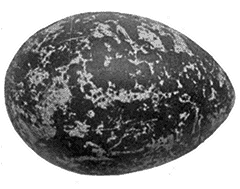
Buff. Range.--Newfoundland.
This species, in summer, is more grayish
than the Rock Ptarmigan, and is very finely
vermiculated with blackish. It is a perfectly
distinct species from the Allen Ptarmigan,
which is the only other species found on the
island. They inhabit the higher ranges and
hills in the interior of the island, where they
are quite abundant. They build their nests on
the ground under protection of overhanging
bushes. The eggs are laid in a hollow in the
dead leaves, sometimes with a lining of grasses.
The eggs do not differ in size or appearance
from those of the Rock Ptarmigan. Data.--Newfoundland, June 3, 1901. Nest
a slight hollow in the moss, besides a fallen stump; lined with a few feathers.
Collector, E. H. Montgomery.
|
|
|
Page 185
|
304. White-tailed Ptarmigan. Lagopus leucurus leucurus.
Range.--Higher ranges of the Rocky Mountains, from New Mexico north to
Alaska.
Ptarmigan are remarkable birds in that they are in an almost continual state
of molting, nearly every month in the year showing them in different stages of
plumage, ranging from the snow-white winter dress to the summer one in which
reddish-brown prevails on Willow Ptarmigan and a black and gray barred effect
predominates on the other species. Notice that they are feathered to the toes,
in winter the feathers on the toes growing dense and hair-like, not only protecting
the toes from the cold but making excellent snowshoes which enable them
to walk with impunity over the lightest snow.
Ptarmigan form the staple article of diet for northern foxes, and were it not
for the fact that their plumage changes to correspond to the appearance of the
ground at the various seasons they would fare hardly indeed.
In spring the little red combs above the eyes of the males are swollen and
conspicuous. At this season they strut and perform curious antics, such as all
Grouse are noted for.
This species differs from any of the preceding in having at all seasons of the
year, a white tail; it is also somewhat smaller than the Rock Ptarmigan. They
nest abundantly near the summits of the ranges in Colorado, making their
nests among the rocks, and generally lining them with a few grasses. During
June, they lay from six to twelve eggs having a creamy background, speckled
and blotched with chestnut brown. Size 1.70 x 1.15.
304a. Kenai White-tailed Ptarmigan. Lagopus leucurus peninsularis.
Range.--Kenai Peninsular, Alaska. A similar but paler (in summer) variety
of the preceding. The nesting habits or eggs will not differ.
305. Prairie Chicken. Tympanuchus americanus americanus.
Range.--The prairies, chiefly west of the Mississippi; north to Manitoba, east
to Ohio, and west to Colorado.
This familiar game bird of the west is about 18 inches in length, brownish
above and grayish below, with bars of brownish black both above and below.
In the place of the ruffs of the Ruffled Grouse, are long tufts of rounded or
square ended feathers, and beneath these a peculiar sac, bright orange in the breeding
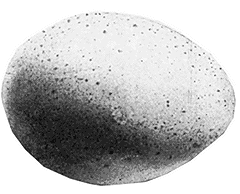
Olive Buff.
|

|
Page 186

|
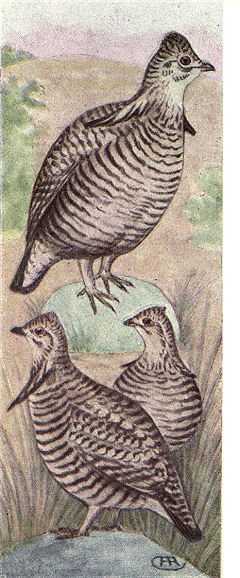
Prairie Chicken.
Heath Hen. season, and capable of being inflated to
the size of a small orange; this is done when the
bird makes its familiar "booming" noise. They
are very good "table birds" and although they are
still very abundant in most of their range, so
many are being killed for market, that it has
become necessary to make more stringent laws
relating to the killing and sale of Pinnated
Grouse, as they are often called. They nest anywhere
on the prairie, in hollows on the ground
under overhanging bushes or tufts of grass. They
lay from eight to fifteen eggs having a buffy or
olive buff ground color, sparingly and finely
sprinkled with brown; size 1.70 × 1.25.
305a. Attwater Prairie Chicken. Tympanuchus americanus attwateri.
Range.--Coast region of Louisiana and Texas.
This is a slightly smaller and darker variety of
the Pinnated Grouse. Its eggs cannot be distinguished
from those of the more northerly distributed
bird.
306. Heath Hen. Tympanuchus cupido.
Range.--Island of Martha's Vineyard, Mass.
This species is similar to the preceding, but has the scapulars more broadly
tipped with buff, the axillars barred, and the pinnated feathers on the neck
pointed. It is slightly smaller than the western species. It is found on the
wooded portions of the island, where its breeding habits are the same as those of
the Ruffed Grouse. Mr. Brewster probably has the only authentic set of the
eggs of this species. They are of a yellowish green color and are unspotted.
Size 1.70 × 1.25. A number of Prairie Hens liberated on the island several
years ago are apparently thriving well, and nests found there now would be
fully as apt to belong to this species.

|
|
|
Page 187
|
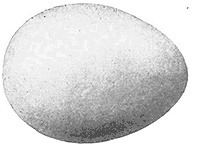
Pale buff. 307. Lesser Prairie Chicken. Tympanuchus pallidicinctus.
Range.--Prairies from southwestern Kansas
through Indian Territory to western Texas.
A smaller and paler species than the Prairie
Chicken. Never as abundant as the common Pinnated
Grouse, this species appears to be becoming
scarcer each year. Its nests are concealed under
overhanging brush or placed under a large tuft of
prairie grass, and are generally lined with a few
grasses or leaves. They lay from eight to twelve
eggs of a buffy color, much lighter than those of
the Prairie Chicken, and unmarked. Size 1.65 ×
1.25.
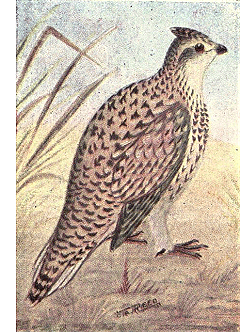
Prairie Sharp-tailed Grouse. 308. Sharp-tailed Grouse. Pedioecetes phasianellus phasianellus.
Range.--Interior of British America, from
the United States boundary northwest to the
Yukon.
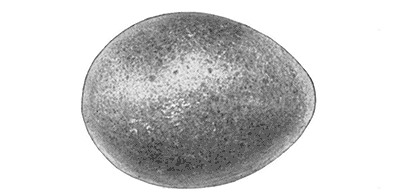
Buffy drab. Sharp-tailed Grouse are similar in form to
the Prairie Chicken, but are somewhat smaller
and very much lighter in color, being nearly
white below, with arrowhead markings on the
breast and flanks. This species is very abundant in Manitoba and especially so
on the plains west of Hudson Bay. Their nests are generally concealed under
a thicket or a large tuft of grass, and are lined with grasses and feathers.
They lay from six to fifteen eggs of a drab color, very minutely specked all over
with brown. Size 1.70 × 1.25.
308a. Columbian Sharp-tailed Grouse. Pedioecetes phasianellus
columbianus.
Range.--Northwestern United States and British Columbia to central Alaska.
Both the nesting habits and eggs of this variety are the same as the last, with
which species, the birds gradually intergrade as their ranges approach.
308b. Prairie Sharp-tailed Grouse. Pedioecetes phasianellus campestris.
Range.--Plains of the United States from the Mississippi to the Rockies.
This sub-species shades directly into the two preceding where their ranges meet,
and only birds from the extreme parts of the range of each show any marked
differences. The nesting habits and eggs of all three are not to be distinguished.
|

|
Page 188

|
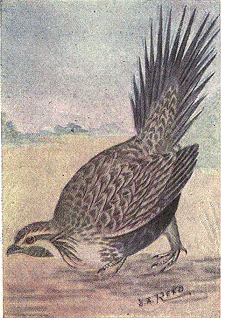
Sage Hen. 309. Sage Hen. Centrocercus urophasianus.
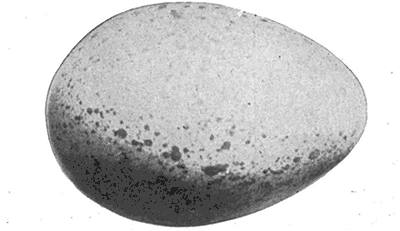
Pale greenish drab. Range.--Sage plains of the Rocky Mountain
region from British Columbia to New Mexico,
and from California to Dakota. This handsome
bird is the largest of the American
Grouse, being about 30 inches long (the hen
bird is about six inches shorter). It may easily
be recognized by its large size, its peculiar graduated tail with extremely
sharp pointed feathers, and the black belly and throat. Their nests are hollows
scratched out in the sand, under the sage bushes, generally with no lining.
The nesting season is during April and May, they laying from six to twelve
eggs of a greenish drab color, spotted with brown. Size 2.15 × 1.50.
PHEASANTS. Family PHASIANIDÆ
* * *Ring-necked Pheasant. Phasianus torquatus.
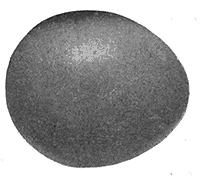
Greenish buff. Several species of Pheasants have been introduced into the United States,
among them being the Ring-necked, English, and
Green Pheasants. The Ring-necked species seems
to be the only one that has obtained a really strong
foothold, it being now very abundant in Oregon
and Washington, and adjacent states, and also
found in abundance on many game preserves in
the east. The males of any of the species may at
once be distinguished from any of our birds by
the long tail. Their nests are hollows in the
leaves under tufts of grass or bushes. They lay
from eight to fourteen eggs of a buff or greenish
buff color, unmarked; size 1.50 × 1.30.
|
|
|
Page 189
|

RING-NECKED PHEASANT.
|
|
Page 190

|
TURKEYS. Family MELEAGRIDÆ
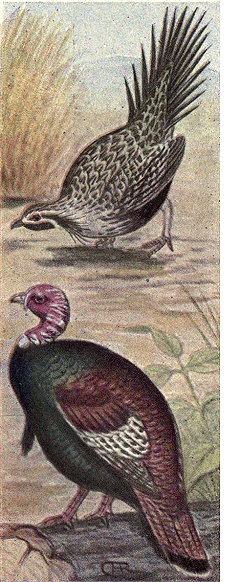
Sage Hen.
Wild Turkey. 310. Wild Turkey. Meleagris gallopavo silvestris.
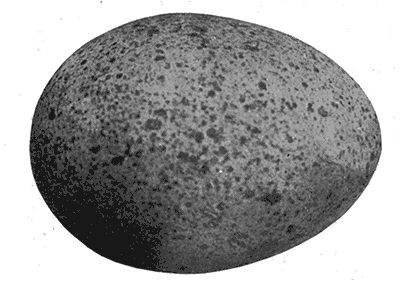
Buff. Range.--Eastern United States from southern
Middle States south to central Florida and west
to the Mississippi Valley and eastern Texas. These
magnificent birds, which once ranged over the
whole of eastern United States, are being yearly
confined to a smaller range, chiefly because of the
destruction of their natural covers, and from persecution
by hunters. They are generally very
wary birds and either escape by running through
the underbrush or by flying as soon as a human
being appears in sight. Their nests are made
under tangled growths of underbrush or briers.
Their eggs, which are laid during April and May,
range from eight to sixteen in number. They are
of a buff color sprinkled and spotted with brownish.
Size 2.55 × 1.90. Data.--Hammond, La., April
17, 1897. Fifteen eggs. Nest hollow scraped in the ground under a bush on
the edge of a pine woods; lined with grasses and leaves. Collector, E. A. McIlhenny.
310a. Merriam's Turkey. Meleagris gallopavo merriami.
Range.--Southwestern United States from Colorado south through western
Texas, New Mexico and Arizona to Mexico.
This variety is abundant throughout its range, its nesting habits and eggs
being practically indistinguishable from those of the eastern form.
|
|
|
Page 191
|
310b. Florida Turkey. Meleagris gallopavo osceola.
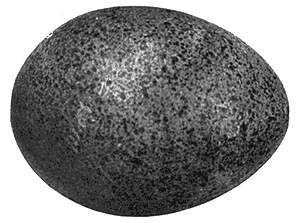
Greenish buff. Range.--Southern Florida.
A small variety of the Wild Turkey,
about 42 inches long. They
breed in the tangled thickets in the
higher portions of the southern
half of Florida, laying from ten to
sixteen eggs of a brighter and
deeper buff color than the northern
variety, and smaller; size 2.30 ×
1.75. Their nests are generally lined
with grasses and occasionally
with feathers. The female sits
very close when incubating and will
not fly until almost trod upon,
trusting to her variegated markings
to conceal her from observation.
310c. Rio Grande Turkey. Meleagris gallopavo intermedia.
Range.--Lowlands of the southern parts of Texas and northern Mexico. A
sub-species which differs slightly in plumage and not at all in nesting habits or
eggs from the common Wild Turkey.
CURASSOWS AND GUANS. Family CRACIDÆ
311. Chachalaca. Ortalis vetula mccalli.

Chachalaca. Range.--Eastern portions of Mexico, north
to the Lower Rio Grande Valley in Texas.
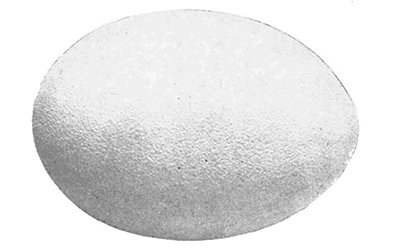
Buffy white. A very peculiar grayish colored bird with a
greenish gloss to the back, and a long, broad
tail, quite long legs, and with the face and
sides of the throat devoid of feathers. They
are very abundant birds in some localities, and very noisy during the breeding
season, their notes resembling a harsh trumpeting repetition of their name.
They are ground inhabiting birds, but nest in low bushes. Their nests are
made of sticks, twigs, leaves, or moss and are generally frail, flat structures
only a few feet above the ground. During April, they lay from three to five
buffy white eggs, the shell of which is very rough and hard. Size 2.25 × 1.55.
|

|
Page 192

|
PIGEONS AND DOVES. Order XI. COLUMBÆ
Family COLUMBIDAE
Pigeons and doves are distributed throughout nearly every temperate and
tropical country on the globe, nearly five hundred species being known, of
which twelve occur within our limits. Their plumage is generally soft and
subdued colors, the head small, the wings strong and the flight rapid.
312. Band-tailed Pigeon. Columba fasciata fasciata.

White. Range.--The Rocky Mountains and westward to the Pacific, from British
Columbia south to Mexico.
This large species may be generally recognized
by the white crescent on the nape; it is about 15
inches in length. They nest abundantly on the
mountain ranges, sometimes in large flocks, and
again, only a few pairs together. Their nests are
rude platforms of sticks and twigs either in bushes
or in large trees in heavily wooded districts. The
two eggs which are laid during May or June are
pure white in color, and like those of all the
pigeons, equally rounded at each end. Size
1.55 × 1.10.
312a. Viosca's Pigeon. Columba fasciata vioscæ.
Range.--Southern Lower California. This is a paler variety of the preceding
species and is not noticeably different in its habits, nesting or eggs.
313. Red-billed Pigeon. Columba flavirostris.
Range.--Mexico and Central America, north to southern Texas, Arizona and
New Mexico.
This species, characterized by its red bill, purplish colored head, neck and
breast and absence of iridescent markings, is abundant in the valley of the
Lower Rio Grande, where they build their frail nests in thickets and low bushes,
and during May and June lay their white eggs. Size of eggs, 1.55 × 1.05.
314. White-crowned Pigeon. Columba leucocephala.
Range.--Resident of the West Indies; in summer, found on the Florida Keys.
This species, which can be identified by its white crown, nests in trees or mangroves
on certain of the Florida Keys, laying its two white eggs on its rude
platform of sticks and twigs. Size of eggs 1.40 × 1.05. Nests in April and
May.
314.1. Scaled Pigeon. Columba squamosa.
A West Indian species, a single specimen of which was taken at Key West,
Florida.
A dark colored species, with purplish head, neck and breast; named from the
scaly appearance of the iridescent feathers on the sides of the neck.
|
|
|
Page 193
|

Passenger Pigeon. 315. Passenger Pigeon. Ectopistes migratorius.
Range.--Formerly, North America east of the
Rockies; casually seen in the upper Mississippi
Valley, now extinct.
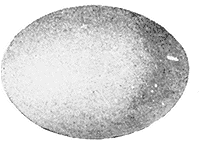
White. A handsome species (see frontispiece) with
ruddy underparts, grayish upperparts and a
long graduated
tail. This species
years ago found
in flocks of thousands
or millions,
is now practically
exterminated,
chiefly by being
hunted and trapped.
A few pairs
probably now nest
in the interior,
from northern
United States to Hudson Bay. Their nests are
very rude, frail platforms of twigs, on which
two white eggs are laid, they being longer and
narrower, comparatively, than those of other species. Size of eggs, 1.50 × 1.02.
Data.--Southwest shore of Lake Manitoba, June 1, 1891. Nest of twigs in an
aspen tree.
316. Mourning Dove. Zenaidura macroura carolinensis.
Range.--North America from New England, Manitoba and British Columbia,
southward.

Mourning Dove. 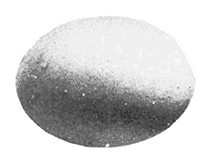
White. Now that the Passenger
Pigeon has
disappeared, this
species becomes the
only one found in
the east, with the exception
of the little
Ground Dove in the
South Atlantic and
Gulf States. While,
sometimes, small flocks of them nest in a community,
they generally nest in companies of
two or three pairs. Their nests are generally
at a low elevation, in trees, bushes and often
upon the ground. Their nests are made entirely
of twigs and rootlets, and eggs may be
found from early in April until the latter part
of September, as they often raise two or three
broods a season. The two eggs are white.
Size 1.15 × .80. Data.--Refugio Co., Texas, May
3, 1899. Two eggs laid on the ground in a
slight cradle of twigs. Collector, James J.
Carroll.
|

|
Page 194

|
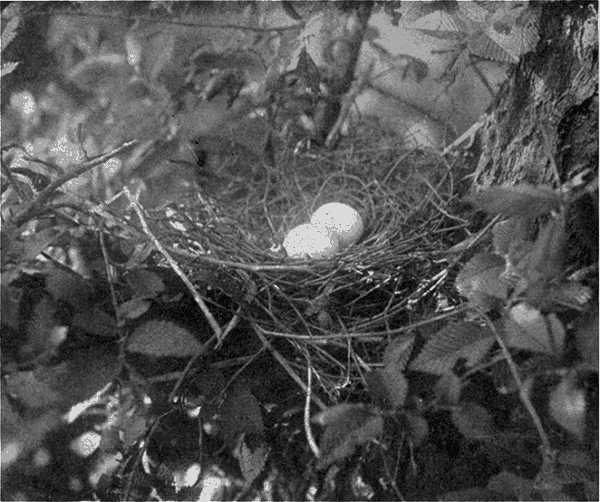
NEST AND EGGS OF MOURNING DOVE
H. B. Stough.
317. Zenaida Dove. Zenaida zenaida.
Range.--West Indies; in summer, on the Florida Keys, but not in great numbers.
This species is similar in size to the Mourning Dove, but it has a short and
square tail, and the secondaries are tipped with white, and the underparts more
ruddy. They generally nest upon the ground, but occasionally in small bushes,
laying two white eggs a trifle larger than those of the preceding species. Size
1.20 × .90. The nests are made of grasses and twigs, on the ground under bushes.

|
|
|
Page 195
|
318. White-fronted Dove. Leptotila fulviventris brachyptera.
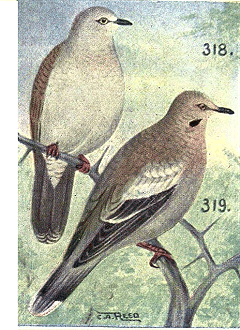
White-fronted Dove.
White-winged Dove. Range.--Mexico and Central America north
to southern Texas.
Slightly larger than the last, much paler below,
with no black ear mark as in the two preceding
species, and with the forehead whitish.
They build their nests of sticks, grasses and
weeds, and place them in tangled vines and
thickets a few feet from the ground. Their
two eggs, which are laid in May and June,
have a creamy white or buffy color. Size 1.15
× .85. They cannot be called a common species
within our borders.
319. White-winged Dove. Melopelia asiatica.
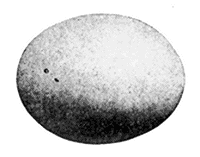
White. Range.--Central America,
Mexico and the
southwestern border of
the United States.
This species is 12 inches
in length, has a
black patch on the ear
coverts, white tips to
the greater and lesser
coverts and some of the
secondaries, and broad
white tips to the outer tail feathers, which are black. This species is very
abundant in some localities within our borders. Their nests are very frail platforms
of twigs placed in trees or bushes or precariously suspended among
tangled vines. Their two eggs are white or creamy white, and measure
1.15 × .85.
320. Ground Dove. Columbigallina passerina terrestris.
Range.--South Atlantic and Gulf States to eastern Texas.
The Ground Doves are the smallest of the family, measuring but about 6.5
inches in length. Their nesting habits and eggs are exactly like those of the
next to be described. They are very abundant, especially along the South Atlantic
coast.
320a. Mexican Ground Dove. Chæmepelia passerinus pallescens.
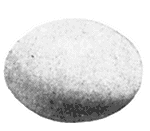
White. Range.--Border of the United States from Texas to southern
California and southward.
This paler sub-species builds a nest of twigs and weeds,
placing the flat structure either in low bushes or on the
ground. Their two white eggs are laid during April to July,
they sometimes rearing two broods a season. Size of eggs,
.85 × .65.
320b. Bermuda Ground Dove. Chæmepelia passerina bermudiana.
Range.--Bermuda. Smaller and paler than the last; otherwise the same in
nesting habits and eggs.
|

|
Page 196

|
321. Inca Dove. Scardafella inca.
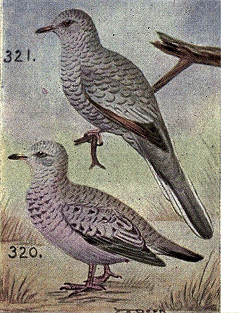
Inca Dove.
Ground Dove. 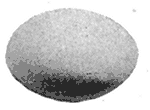
White. Range.--Mexican border of the United States
south to Central America and Lower California.
This handsome species is about the size of
the last, but its tail is longer and graduated,
consequently its length is
greater, it being about 8
inches long. It is not an
uncommon species along
our Mexican border, but is
not nearly as abundant as
is the Ground Dove. It is
often called "Scaled Dove"
because of the blackish edges of nearly all its
feathers. They build fairly compact nests of
twigs, rootlets and weeds, these being placed
in bushes at a low elevation. They are two in
number and pure white. Size .85 × .65.
322. Key West Quail Dove. Geotrygon chrysia.
Range.--West Indies, rarely found at Key
West, although supposed to have been common
there in Audubon's time. This species is of
about the size of the Mourning Dove, has rusty
colored upper parts, and is whitish below, the
white below the eye being separated from that of the throat by a stripe of dusky
from the base of the bill. They nest in trees, laying two buffy white eggs.
Size 1.15 × .9O.
322.1. Ruddy Quail Dove. Geotrygon montana.
Range.--Central America, north to eastern Mexico and the West Indies; once
taken at Key West. This species is similar to the last but has no white streak
under the eye, and the underparts are buffy. Eggs, creamy white. Size
1.15 × .90.
323. Blue-headed Quail Dove. Starnoenas cyanocephala.
Range.--Cuba, accidentally straying to Key West, but not in recent years.
It is a beautiful species, with a bright blue crown, black throat and stripe
through the eye, separated by a white line under the eye. The rest of the
plumage is of a brownish or rusty color. Eggs buffy white. Size 1.30 × 1.05.

|
|
|
Page 197
|

CALIFORNIA VULTURE.
|
|
Page 198

|
VULTURES, HAWKS and OWLS. Order XII. RAPTORES
AMERICAN VULTURES. Family CATHARTIDAE
Vultures are peculiarly formed birds of prey, having a bare head and neck, a
lengthened bill strongly hooked at the end for tearing flesh, and long, strong,
broad wings upon which they float in the air for hours at a time without any
visible flapping. They are scavengers and do great service to mankind by devouring
dead animal matter, that, if allowed to remain, would soon taint the
atmosphere. Their eyesight and sense of smell is very acute. They do not,
except in very unusual cases, capture their prey, but feed upon that which has
been killed or died of disease.

Ashy gray.
324. California Vulture. Gymnogyps californianus.
Range.--Apparently now restricted to the coast ranges of California, casually
inland to Arizona, and formerly to British Columbia.
This large bird, which weighs about 20 pounds, measures about 4 feet in
length, and has an expanse of wings of about 10 feet. Its plumage is blackish
with lengthened lanceolate feathers about the neck, and with the greater wing
coverts broadly tipped with grayish white (in very old birds). The birds are
very rare in their restricted range and are becoming scarcer each year, owing to
their being shot and their nests robbed. While the eggs are very rarely found
and only secured at a great risk, they are not as unobtainable as many suppose,
as may be seen from the fact that one private collection contains no less than
six perfect specimens of the eggs and as many mounted birds. These birds lay
but a single egg, placing it generally in caves or recesses in the face of cliffs,
hundreds of feet from the ground, and often in inaccessible locations. The eggs
are of an ashy gray color and measure about 4.45 × 1.55.
|
|
|
Page 199
|
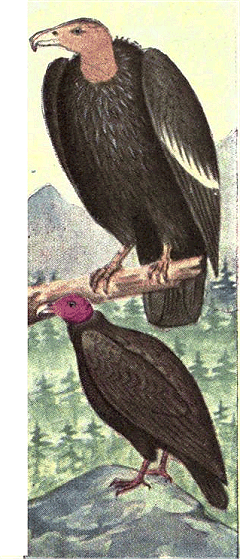
324--325. 325. Turkey Vulture. Cathartes aura septentrionalis.
Range.--America, from New Jersey on the Atlantic coast,
Manitoba and British Columbia, south to southern South
America, wintering in the southern half of the United
States.

Creamy white. The plumage of this small Buzzard (length 30 inches) is blackish brown, the
naked head being red. It is very common in the southern and central portions
of its range, where it frequents the streets and door yards picking up any refuse
that is edible. It is a very graceful bird while on the wing, and can readily be
identified when at a distance from the fact that, when in flight, the tips of the
wings curve upward. The two eggs which constitute a set are laid upon the
ground between large rocks, in hollow stumps, under logs, or between the
branching trunks of large trees, generally in large woods. They frequently
nest in communities and again, only a single pair may be found in the woods.
Its nesting season ranges from March until June in the different localities.
The eggs are creamy or bluish white, spotted and blotched with shades of brown,
and with fainter markings of lavender. Size 2.70 × 1.85.
326. Black Vulture. Catharista uruba.
Range.--More southerly than the preceding; north regularly to North Carolina
and southern Illinois, and west to the Rocky Mountains.
This species is about the same size, or slightly smaller than the Turkey
Vulture; its plumage is entirely black as is also the naked head, and bill. In
the South Atlantic and Gulf States, the present species is even more abundant
than the preceding, and might even be said to be partially domesticated. The
nesting habits are the same as those of the Turkey Buzzard but their eggs
average longer and the ground color is pale greenish or bluish white rather than
creamy. They are spotted and blotched the same. Size 3.00 × 2.00.

|

|
|
Page 200
|
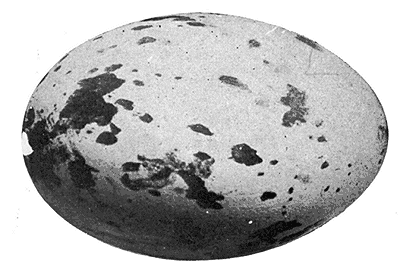
Bluish white.
EGG OF BLACK VULTURE.

NEST AND EGGS OF TURKEY VULTURE.
|
|
|
Page 201
|
KITES, HAWKS AND EAGLES. Family BUTEONIDÆ
The members of this family are chiefly diurnal; they get their living by
preying upon smaller animals or birds. They have strong sharply hooked
bills, powerful legs and feet armed with strong, curved and sharply pointed
talons.
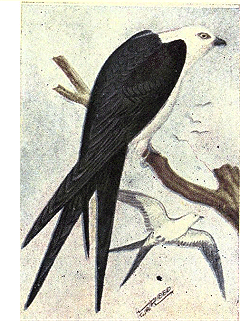
Swallow-tailed Kite. 327. Swallow-tailed Kite. Elanoides forficatus.
Range.--Southern United States; casually
north to New York and Manitoba.
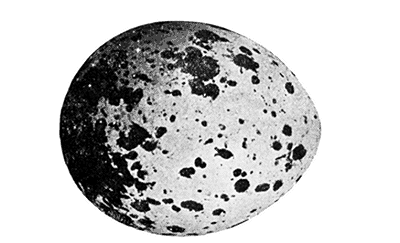
White. This most beautiful Kite can never be mistaken
for any other; its whole head, neck and
underparts are snowy white, while the back, wings and tail are glossy blue
black, the wings being very long and the tail long and deeply forked. The extreme
length of the bird is 24 inches. As a rule nests of this bird are placed
high up in the tallest trees; they are made of sticks, weeds and moss. Two
eggs, or rarely three, constitute a full set. They are white or bluish white,
spotted with brown. The one figured is an unusually handsome marked specimen
in the collection of Mr. C. W. Crandall. Average size of eggs, 1.80 × 1.50.
Data.--Yegna Creek bottoms, Texas, April 27, 1891. Two eggs. Nest of sticks
and green moss, the same moss also being used for lining; in an elm tree 80
feet up.
328. White-tailed Kite. Elanus leucurus.
Range.--Southern United States, north to the Carolinas, Illinois and middle
California.
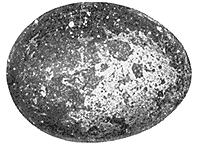
Creamy white. This species can be recognized by its light
bluish gray mantle, black shoulders and white
tail. It is a very active species, feeding upon
insects and reptiles, and small birds and mammals.
The nests of these species are placed
in trees at quite an elevation from the ground,
being made of sticks, weeds and leaves. The
eggs are creamy white, profusely blotched and
spotted with reddish brown and umber. Size
1.65 × 1.25. Data.--Los Angeles, Cal., April 9,
1896. Nest in fork of willows about 25 feet up.
Made of willow twigs and weed stalks, lined
with pieces of bark.
|

|
Page 202

|
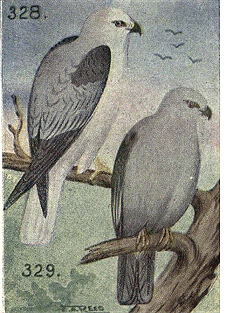
White-tailed Kite
Mississippi Kite. 329. Mississippi Kite. Ictinia mississippiensis.
Range.--Southeastern United States, north
to South Carolina and Illinois.
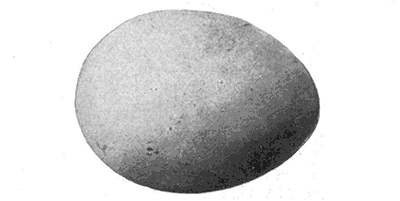
Bluish white. A small species (length 14 inches) with the
head, neck, and underparts gray, and the back,
wings and tail blackish, the tips of the secondaries
being grayish. They live almost exclusively
upon insects, such as grasshoppers,
and small reptiles. They build their nests of sticks and weeds well up in tall
trees. The eggs are two or three in number and normally bluish white, unmarked,
but occasionally with very faint spots of pale brown. Size 1.65 × 1.25.
Data.--Giddings, Texas, May 31, 1887. Nest of sticks and weeds, with green
pecan leaves in the lining; placed in the top of a live oak sapling, 20 feet from
the ground. Collector, J. A. Singley.
330. Everglade Kite. Rostrhamus sociabilis.
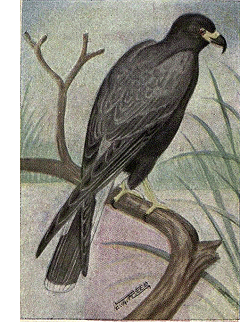
Everglade Kite. Range.--South America, north to southern Florida and Mexico.
This peculiar species has a long, slender, curved bill, blackish plumage, with
white rump and bases of outer tail feather. They feed largely upon snails,
both land and water varieties. They nest at a low elevation in bushes or under
brush, often over the water.
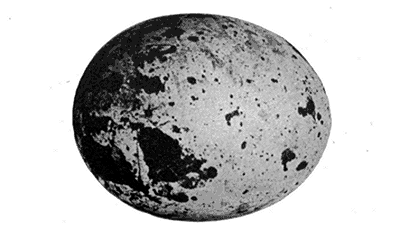
Pale greenish white. The nests are
of sticks, weeds and leaves. The three eggs
are light greenish white, spotted and splashed
with chestnut brown. Size, 1.70 × 1.30. Nest
in a custard apple tree, 6 feet from the ground,
built of twigs, lined with small vine stems and
willow leaves.
|
|
|
Page 203
|
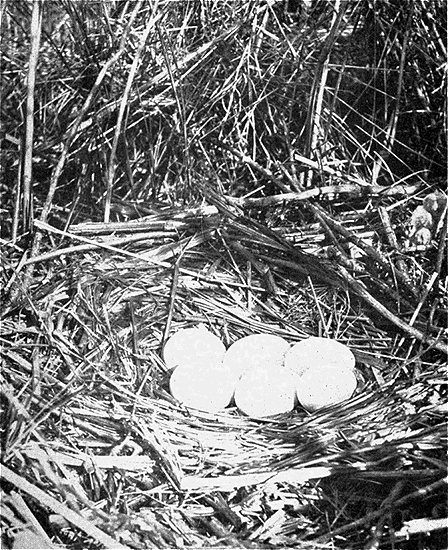
NEST AND EGGS OF MARSH HAWK.
|
|
Page 204

|

(Adult and young)
Marsh Hawk. 331. Marsh Hawk. Circus hudsonius.
Range.--Whole of North America, very
abundant in all sections.
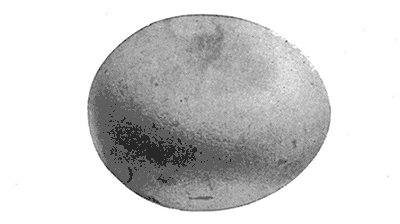
Pale bluish white. The adult of this species is very light colored,
and young birds of the first two years have a
reddish brown coloration; in both plumages
the species is easily identified by the white
patch on the rump. They are, almost exclusively frequenters of fields and
marshes, where they can most often be seen, towards dusk, swooping in broad
curves near the ground, watching for field mice, which form the larger portion
of their diet. Their nests are made in swampy ground, often in the middle of a
large marsh, being placed on the ground in the centre of a hummock or clump
of grass; it is generally well lined with grasses and often rushes. They lay
from four to seven pale bluish white eggs, generally unmarked; size 1.80 × 1.40.

Sharp-shinned Hawk. 332. Sharp-shinned Hawk. Accipiter velox.
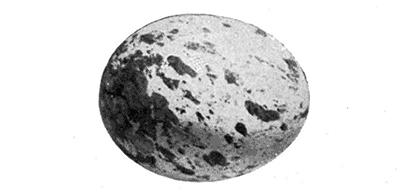
Bluish white. Range.--Whole of North America, wintering in the United States and southward;
breeds throughout its range, but most abundantly in northern United
States and northward. This is one of the smallest of the hawks and in the
adult plumage is a beautiful species, being barred
below with light brown, and having a bluish
slate back. It is a very spirited and daring
bird and is one of the most destructive to small
birds and young chickens. Its nest is a rude
and sometimes very frail platform of twigs and
leaves placed against the trunk of the tree at
any height, but averaging, perhaps, fifteen feet.
The eggs are bluish white, beautifully blotched
and spotted with shades of brown.
|
|
|
Page 205
|
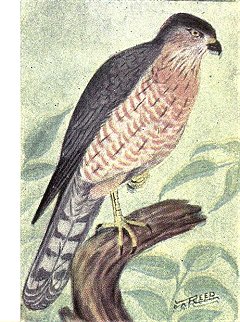
Cooper's Hawk. 333. Cooper's Hawk. Accipiter cooperi.
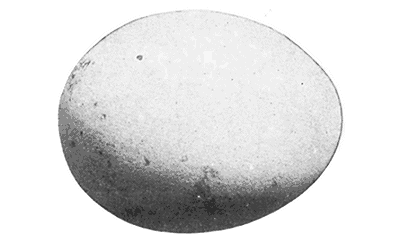
Bluish white. Range.--Whole of temperate North America,
breeding throughout its range.
Although larger (length 17 inches), the plumage
of this species is almost exactly the same
as that of the preceding. Like the last, this is also a destructive species.
They construct their nests in the crotches of trees, generally at quite a height
from the ground; the nest is made of sticks and twigs, and often lined with
pieces of bark; occasionally an old Hawk's or Crow's nest is used by the birds.
Their eggs are bluish white, unmarked or faintly spotted with pale brown.
334. Goshawk. Astur atricapillus atricapillus.
Range.--Northern North America, south in winter to the northern parts of
the United States.
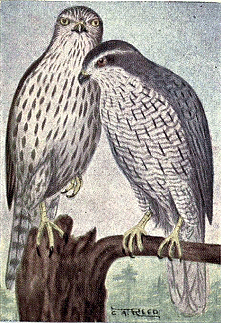
American Goshawk. 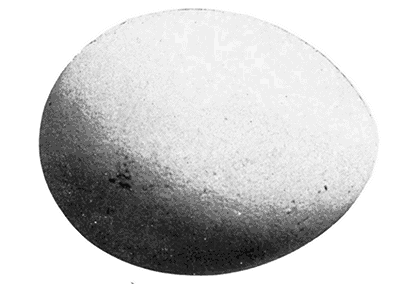
Bluish white. This species is one of the largest, strongest and most audacious of American
Hawks, frequently carrying off Grouse and poultry, the latter often in the
presence of the owner. It is a handsome species in the adult plumage, with
bluish gray upper parts, and light under parts, finely vermiculated with grayish
and black shafts to the feathers. Length 23 inches. Their nests are placed
well up in the tallest trees, usually in dense woods, the nests being of sticks
lined with weeds and bark. The three or
four eggs are bluish white, generally unmarked,
but occasionally with faint spots of
brown. Size 2.30 x 1.70.
|

|
|
Page 206
|

NEST AND EGGS OF COOPER'S HAWK.
|
|
|
Page 207
|
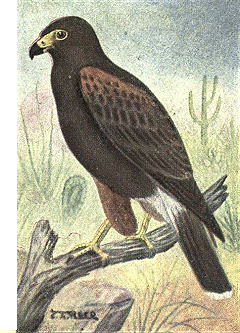
Harris's Hawk. 334a. Western Goshawk. Astur atricapillus striatulus.

Bluish white. Range.--Western North America from Alaska
to California, breeding chiefly north of
the United States except in some of the higher
ranges of the Pacific coast. This sub-species is darker, both above and below,
than the American Goshawk. Its nesting habits and eggs are precisely the
same. The eggs are quite variable in size.
335. Harris's Hawk. Parabuteo unicinctus harrisi.
Range.--Mexico and Central America, north to the Mexican border of the
United States; very abundant in southern Texas.
This is a peculiar blackish species, with white rump, and chestnut shoulders
and thighs. It is commonly met with in company with Caracaras, Turkey Buzzards
and Black Vultures, feeding upon carrion. They also feed to an extent
on small mammals and birds. Their nests are made of sticks, twigs and weeds,
and placed in bushes or low trees. The three or four eggs are laid in April or
May. They are dull white in color and generally unmarked, although often
showing traces of pale brown spots. They are quite variable in size, averaging
2.10 x 1.65.
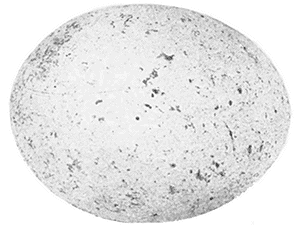
White.
|

|
Page 208

|
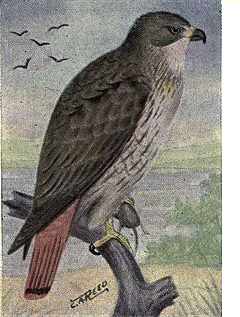
Red-tailed Hawk. 337. Red-tailed Hawk. Buteo borealis borealis.
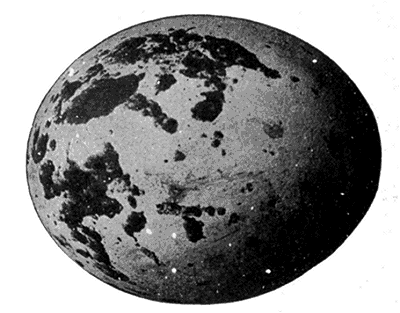
Pale bluish white. This is one of the handsomest of the larger
hawks, and is the best known in the east,
where it is commonly, but wrongly, designated as "hen hawk", a name, however,
which is indiscriminately applied to any bird that has talons and a hooked
beak. The adult of this species is unmistakable because of its reddish brown
tail; young birds are very frequently confounded with other species. Their
food consists chiefly of small rodents, snakes and lizards, and only occasionally
are poultry or birds taken. They nest in the tallest trees in large patches of
woods, the nests being made of sticks, weeds, leaves and trash. The eggs
number from two to four, and are white, sometimes heavily, and sometimes
sparingly, blotched and spotted with various shades of brown. Size 2.35 x 1.80.
337a. Krider's Hawk. Buteo borealis krideri.
Range.--Plains of the United States, north to Manitoba.
This sub-species is described as lighter on the underparts, which are almost
immaculate. Its nesting habits and eggs are the same as those of the preceding.
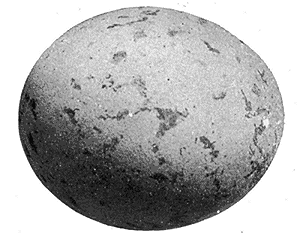
White. 337b. Western Red-tail. Buteo borealis calurus.
Range.--Western North America,
chiefly west of the Rocky Mountains.
This sub-species varies from the
plumage of the eastern Red-tail, to
a nearly uniform sooty above and
below, with the dark red tail crossed
by several bands; it is a generally
darker variety than the Red-tail.
Its nesting habits are the
same and the eggs show the great
variations in markings that are
common to the eastern bird.
|
|
|
Page 209
|
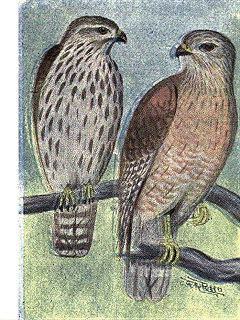
Red-shouldered Hawk. 337d. Harlan's Hawk. Buteo borealis harlani.
Range.--Gulf States and southward, north to
Kansas.
This dark sub-species is generally nearly uniform
blackish, but sometimes is lighter or even
white below. Its tail is rusty, mottled with
blackish and white. Its nesting habits are the
same and the eggs are not distinguishable
from those of the other Red-tails.
339. Red-shouldered Hawk. Buteo lineatus lineatus.
Range.--North America, east of the Plains
and from the southern parts of the British
Provinces southward; abundant and breeding
throughout its range.
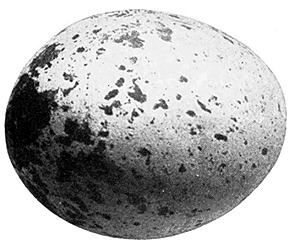
White. This species is smaller than the Red-tailed
and is not as powerfully built; length 19 inches.
The adults are handsomely barred beneath
with reddish brown, giving the entire
underparts a ruddy color. Like the
last species, they rarely feed upon
poultry, confining their diet chiefly to
mice, rats, frogs, reptiles, etc. These
Hawks nest in the larger growths of
timber, usually building their nests
high above the ground. The nest is
of sticks, and lined with leaves, weeds
and pieces of bark. They lay three
or four eggs with a white ground
color, variously blotched and spotted,
either sparingly or heavily, with different
shades of brown. Size 2.15 ×
1.75. Data.--Kalamazoo, Michigan,
April 25, 1898. Nest about 40 feet up
in an oak tree; made of sticks and
twigs and lined with bark. Four eggs.
Collector, J. C. Holmes.
339a. Florida Red-shouldered Hawk. Buteo lineatus alleni.
Range.--Florida and the Gulf coast; north to South Carolina. The nesting
habits of this paler sub-species are precisely like those of the last species.

|

|
|
Page 210
|
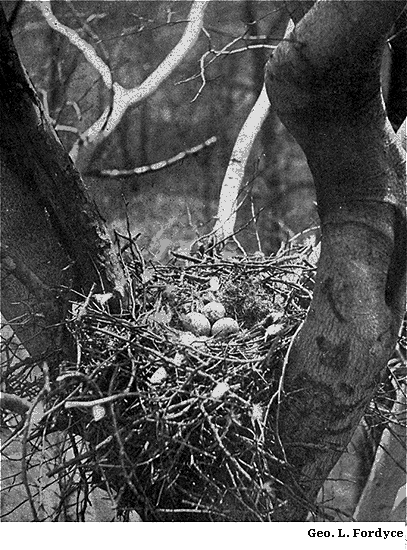
NEST AND EGGS OF RED-SHOULDERED HAWK.
|
|
|
Page 211
|
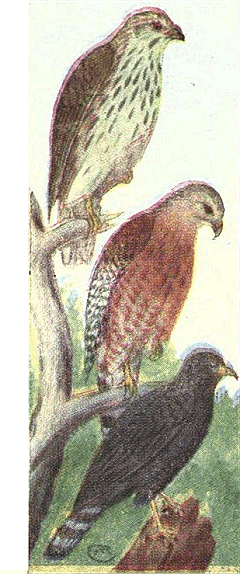
339b--340. 339b. Red-bellied Hawk. Buteo lineatus elegans.
Range.--Pacific coast from British Columbia south to
Lower California, chiefly west of the Rockies.
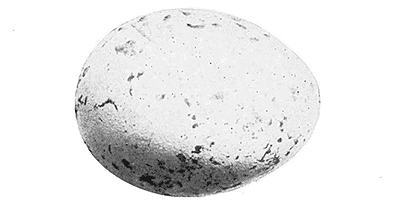
White. This variety is similar to, but darker than lineatus, and
the underparts are a uniform reddish brown, without barring.
Their nests are like those of the Red-shouldered
variety, and almost always placed high up in the largest
trees. The eggs are very similar, but average lighter in markings. Size 2.15
× 1.70. Data.--Diego, Cal., April 13, 1897. Nest in a sycamore 20 feet from
ground, made of sticks, leaves and feathers.
340. Zone-tailed Hawk. Buteo abbreviatus.
Range.--Mexico and Central America, north to the Mexican border of the
United States.
This species, which is 19 inches long, is wholly black with the exception of
the tail, which is banded. Their nests are built in heavy woods, and preferably
in trees along the bank of a stream. The nest is of the usual Hawk construction
and the two to four eggs are white, faintly marked with pale chestnut.
Data.--Marathon, Texas. Nest of sticks, lined with weeds and rabbit fur; on a
horizontal branch of a cotton-wood tree, 30 feet up.
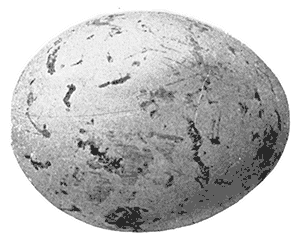
White.
|

|
Page 212

|
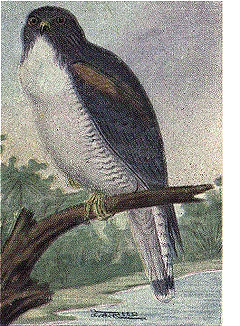
Sennett's White-tailed Hawk. 341. Sennett's White-tailed Hawk. Buteo albicaudatus sennetti.
Range.--Mexican border of the United States
and southward.
A large, handsome Hawk which may be identified
by its dark upper parts and white underparts
and tail, the flanks and tail being lightly
barred with grayish; the shoulders are chestnut.
It is especially abundant in the southern
parts of Texas, where it builds its nests of
sticks and weeds, lined with grasses, leaves
and moss. They nest in March and April, laying
two, or rarely three, eggs which are a dull
white, and generally immaculate, but occasionally
faintly or sparingly spotted with brown.
Size of eggs 2.25 × 1.80.
342. Swainson's Hawk. Buteo swainsoni.
Range.--Central and western North America,
from the Mississippi Valley and Hudson Bay,
to the Pacific coast, breeding throughout its
range.

White. 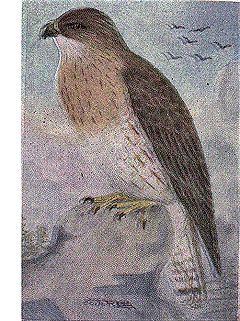
Swainson's Hawk. In the greater part of its range, this is
the most abundant of the Hawk family.
Its plumage is extremely variable, showing all the intergradations from a uniform
sooty blackish to the typical adult plumage of a grayish above, and a
white below, with a large breast patch of rich chestnut. Their nesting habits
are as variable as their plumage. In some localities, they nest exclusively in
trees, in others indifferently upon the ground or rocky ledges. The nest is the
usual Hawk structure of sticks; the eggs are white, variously splashed and
spotted with reddish brown and umber. Size
2.20 × 1.70. Data.--Stark Co., N. D., May 21,
1897. Nest of sticks, lined with weeds in an
ash tree. Collector, Roy Dodd.
|
|
|
Page 213
|
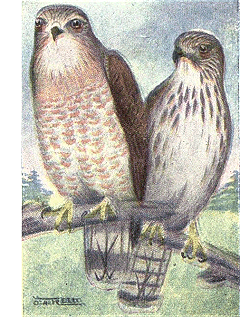
American Rough-legged Hawk. 343. Broad-winged Hawk. Buteo platypterus.
Range.--North America, east of the Plains,
and from the British Provinces southward.
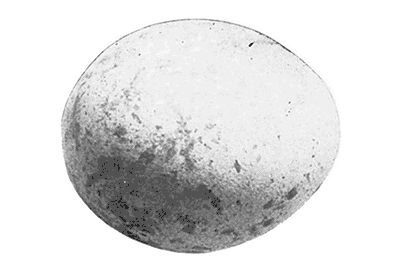
Grayish white. A medium sized species, about 16 inches in
length, and with a short tail and broad rounded
wings; adults have the underparts handsomely barred with brown. Their nests
are usually built in large trees, but generally placed against the trunk in the
crotch of some of the lower branches. It is made of sticks and almost invariably
lined with bark. The two to four eggs are of a grayish white color, marked
with chestnut, brown and stone gray; size 1.90 × 1.55. Data.--Worcester,
Mass., May 16, 1895. Nest about 20 feet up in a large chestnut tree. The birds
continually circled overhead, their weird cries sounding like the creaking of
branches. Collector, A. J. White.
344. Short-tailed Hawk. Buteo brachyurus.
Range.--A tropical species, which occurs north to the Mexican border and
regularly to southern Florida, where it breeds in the large cypress swamps. Its
eggs are pale greenish white, sparingly spotted with brown, chiefly at the large
end. Size 2.15 × 1.60.
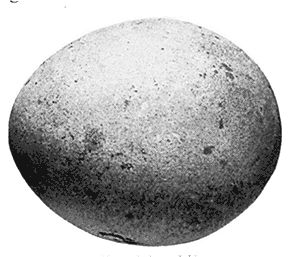
Grayish white. 345. Mexican Black Hawk. Urubitinga anthracina.
Range.--Mexican border of the United
States and southward.
A coal black species about 22 inches in
length, distinguished by the white tip,
and broad white band across the tail
about midway. This is one of the least
abundant of the Mexican species that
cross the border. They are shy birds and
build their nests in the tallest trees in
remote woods. Their two or three eggs
are grayish white, faintly spotted with
pale brown; size 2.25 × 1.80. Data.--Los
Angeles County, Cal., April 6, 1889.
Nest of sticks, lined with bark and
leaves; 45 feet up in a sycamore tree.
Collector, R. B. Chapman.
|

|
Page 214

|

Rough-legged Hawk. 346. Mexican Goshawk. Asturina plagiata.
Range.--Mexico, north to the border of the
United States.
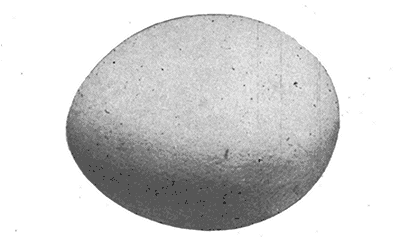
White. A beautiful, medium sized Hawk (17 inches
long), slaty gray above, white below, numerously
barred with grayish; tail black, crossed
by several white bars. These are graceful
and active birds, feeding largely upon small rodents, and occasionally small
birds. They nest in the top of tall trees, laying two or three greenish white,
unmarked eggs; size 1.95 x 1.60. Data.--Santa Cruz River, Arizona, June 3,
1902. Nest in the fork of a mesquite tree about forty feet from the ground;
made of large sticks, lined with smaller ones and leaves. Three eggs. Collector,
O. W. Howard.
347a. Rough-legged Hawk. Archibuteo lagopus sancti-johannis.
Range.--Northern North America, breeding chiefly north of our borders and
wintering south to the middle portions of the United States.

Bluish white. The Rough-legs are large, heavily built birds of prey, specially characterized
by the completely feathered legs. The present species is 22 inches long, and in
the normal plumage has a whitish head, neck, breast and tail, the former being
streaked and the latter barred
with blackish; the remainder of
the upper and underparts are blackish
brown. Their nests are usually
placed in trees, and less often on
the ground than those of the next
species. These Rough-legs are very
irregularly distributed, and are nowhere
as common as the next.
While the greater number nest
north of the United States, it is
very probable that a great many
nest on the higher ranges within
our borders. The species is often
taken in summer, even in Massachusetts.
They lay three eggs of a
bluish white color, boldly splashed
with dark brown; size 2.25 x 1.75.
|
|
|
Page 215
|
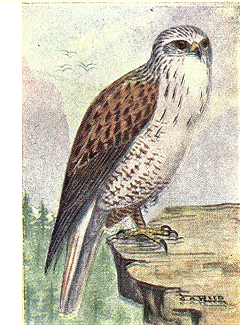
Rough-legged Hawk. 348. Ferruginous Rough-leg. Archibuteo ferrugineus.
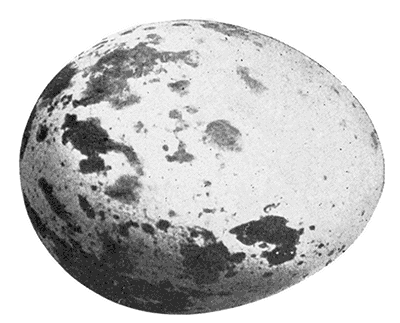
White. Range.--North America, west of the Mississippi, breeding from the latitude
of Colorado north to the Saskatchewan region.
This species nests very abundantly along our northern states, particularly in
Dakota. It is a larger bird than the preceding and can easily be told by its
reddish coloration, particularly on the shoulders and tibia. While in some
localities they nest only in trees, the greater number appear to build their nests
on the ground or rocky ledges, making a large heap of sticks, weeds and grass.
Their three or four eggs are white, beautifully spotted and blotched, in endless
variety, with various shades of brown. Size 2.60 x 2.00. Data.--Stark Co., N.
D., April 29, 1900. Nest built of coarse sticks on a clay butte.
349. Golden Eagle. Aquila chrysætos.
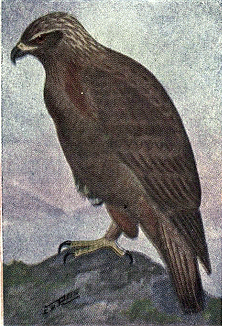
Golden Eagle. Range.--North America, west of the Mississippi;
most abundant in the Rockies and along
the Pacific coast ranges.
This magnificent bird, which is even more
powerful than the Bald Eagle, measures about
34 inches long, and spreads about 7 feet. Its
plumage is a rich brownish black, very old
birds being golden brown on the nape. They
can be distinguished in all plumages from the
Bald Eagle by the completely feathered tarsus.
They build their nests in the tops of the tallest
trees in the wild, mountainous country of the
west, and more rarely upon ledges of the cliffs.
The nests are made of large sticks, lined with
smaller ones and leaves and weeds. Their eggs
are the most handsome of the Raptores, being
white in color, and blotched, splashed, spotted
and specked with light brown and clouded with
gray or lilac, of course varying endlessly in
pattern and intensity. Size 2.90 x 2.50. Data.--Monterey
Co., Cal., May 3, 1888. Three eggs.
Nest of sticks, lined with pine needles, in a
pine tree, 50 feet up.
|

|
|
Page 216
|
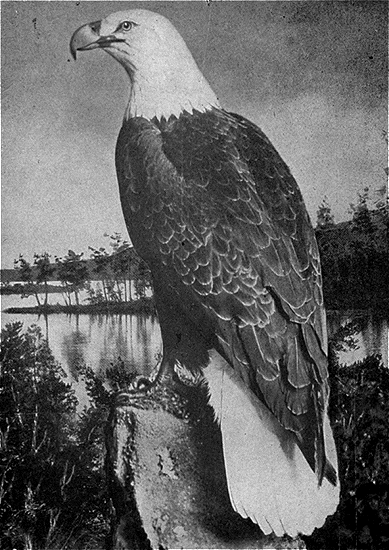
BALD EAGLE.
|
|
|
Page 217
|
351. Gray Sea Eagle. Haliæetus albicilla.
A common species on the sea coasts of Europe; straggling to southern Greenland,
where it nests upon the rocky cliffs.

Bald Eagle. 352. Bald Eagle. Haliæetus leucocephalus leucocephalus.
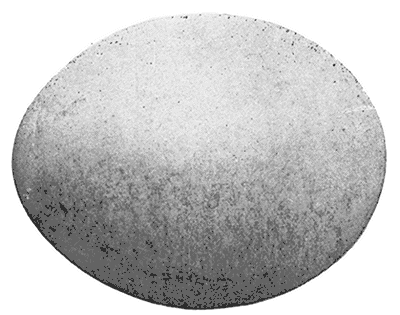
White. Range.--Whole of North America; most abundant on the Atlantic
coast; breeds throughout its range. This large white-headed and white-tailed
species is abundant in sufficiently wild localities along the Atlantic
coast. It only attains the white head and tail when three years old,
the first two years, being blackish. It is about 34 inches in length
and expands about seven feet, never over eight feet, and only birds of the second
year (when they are larger than the adults) ever approach this expanse.
Their food consists of fish (which they sometimes capture themselves, but
more often take from the Osprey), carrion, and Ducks, which they catch in
flight. Their nests are massive structures of sticks, in the tops of tall trees.
They very rarely lay more than two eggs, which are white. Size 2.75 x 2.10.
Data.--Mt. Pleasant, S. C., nest in top of a pine, 105 feet from the ground;
made of large sticks and lined with Spanish moss.
352a. Northern Bald Eagle.--Haliæetus leucocephalus alascanus.
Range.--Alaska. This sub-species averages slightly larger than the Bald
Eagle, but never exceeds the largest dimensions of that species. Its nesting
habits and eggs are the same, except that it more often builds its nests on rocky
cliffs than does the Bald Eagle. The eggs are laid in February and March.

|

|
Page 218

|
FALCONS AND CARACARAS
Family FALCONDIDAE
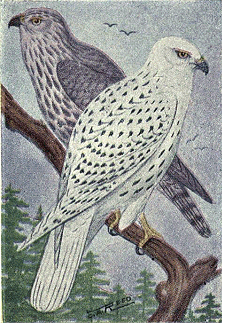
Gray Gyrfalcon.
White Gyrfalcon. 353. White Gyrfalcon. Falco islandus.
Range.--Arctic regions; south in winter casually
to northern United States, chiefly on the
coast.
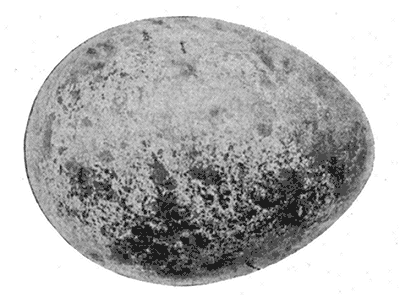
Buff. Gyrfalcons are large, strong, active and fearless
birds, about 23 inches in length. Their food consists chiefly of hares,
Ducks and Waders which abound in the far north. The present species is
snowy white, more or less barred with blackish brown on the back and wings
and with a few marks on the breast. They nest upon the ledges of high cliffs,
laying three or four eggs of a buffy color, blotched and finely specked with
reddish brown, this color often concealing the ground color. Size of eggs, 2.30 ×
1.80. In America, they nest in Greenland and the Arctic regions.
354. Gray Gyrfalcon. Falco rusticolus rusticolus.
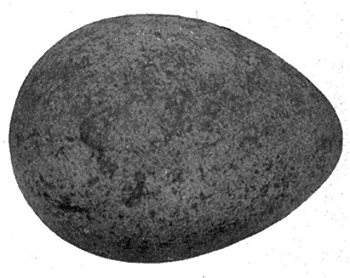
Buff. Range.--Arctic regions; south in
winter to northern United States.
This species is of the size of the last
but the plumage is largely gray, barred
with dusky. They nest more
abundantly in southern Greenland than
do the preceding species. The nesting
habits and eggs do not differ.
354a. Gyrfalcon. Falco rusticolus gyrfalco.
Range.--Arctic regions; south casually
to Long Island.
This sub-species is hardly to be distinguished
from the preceding; its
nesting habits and eggs are identical,
the nests being of sticks, lined with weeds and feathers and placed upon the
most inaccessible ledges of cliffs.
|
|
|
Page 219
|
354b. Black Gyrfalcon. Falco rusticolus obsoletus.
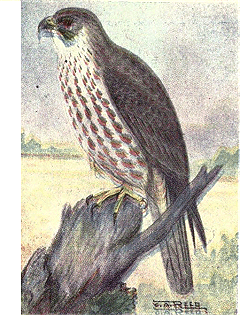
Prairie Falcon. Range.--Labrador; south casually, in winter,
to Long Island.
A slightly darker variety. Eggs indistinguishable.
Data.--Ungava coast, Labrador,
May 25, 1900. Nest a heap of seaweed and
feathers on sea cliff, containing three eggs.
355. Prairie Falcon. Falcon mexicanus.
Range.--United States west of the Mississippi,
and from Dakota and Washington southward
to Mexico.
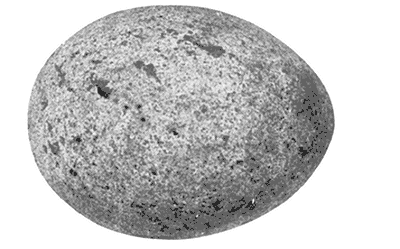
Reddish buff. This species abounds in suitable localities,
generally placing its nests
upon rocky ledges and cliffs, and sometimes
trees, generally upon the banks
of some stream. The nests are masses
of sticks, lined with weeds and grasses. The three or four eggs have a reddish
buff ground color, and are thickly sprinkled and blotched with reddish buff
brown and chestnut; size 2.05 × 1.60.
356a. Duck Hawk. Falco peregrinus anatum.
Range.--Whole of North America, breeding locally, chiefly in mountainous regions,
throughout its range.
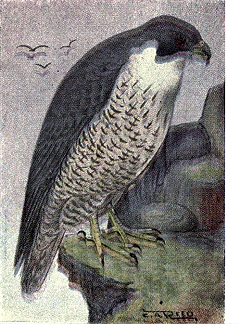
Duck Hawk. 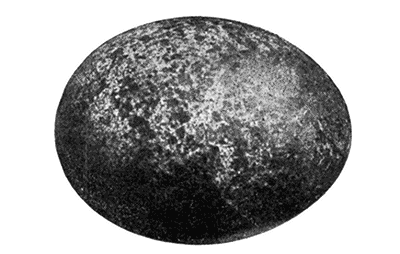
Buff or reddish buff. This beautiful species, characterized by its black moustache, is the most
graceful, fearless, and swiftest of the Falcons, striking down birds of several
times its own weight, such as some of the larger Ducks. It breeds quite
abundantly on the Pacific coast and in certain localities in the Dakotas, laying
its eggs on the rocky ledges. Their eggs are
similar to those of the Prairie Falcon, but are
darker and brighter, in fact they are the darkest,
brightest marked, and most beautiful of
Falcon eggs; size 2.05 × 1.55.
|

|
Page 220

|
356b. Peale's Falcon. Falco peregrinus pealei.
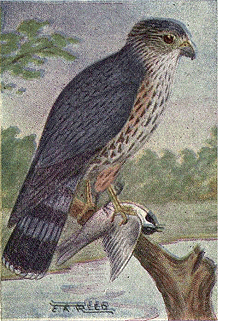
Pigeon Hawk. Range.--Pacific coast from northern United
States north to Alaska.
A darker form of the preceding, such as occurs
in this section with a great many other
birds. The nesting habits and the eggs are
precisely like those of the Duck Hawk.
357. Pigeon Hawk. Falco columbarius columbarius.
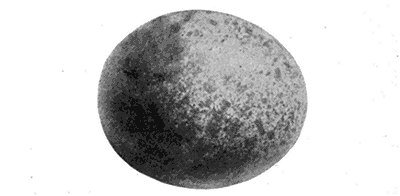
Brownish buff. Range.--North America, breeding chiefly north
of the United States except in some of the higher
ranges along our northern border. A small Falcon,
about 11 inches long, often confused with the Sharp-shinned Hawk, but
much darker and a more stoutly built bird. It is a daring species, often attacking
birds larger than itself; it also feeds on mice, grasshoppers, squirrels, etc.
They generally build a nest of sticks in trees, deep in the woods; less often in
natural cavities of dead trees; and sometimes on rocky ledges. Their four or
five eggs have a brownish buff ground color, heavily blotched with brown and
chestnut. Size 1.50 × 1.22.
357a. Black Pigeon Hawk. Falco columbarius suckleyi.
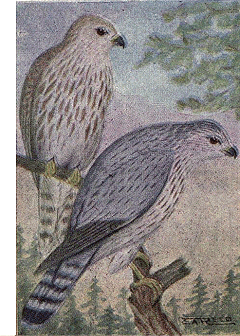
Richardson's Pigeon Hawk. Range.--Pacific coast from northern United States north to Alaska.
Very similar in appearance to the preceding,
but much darker, both above and below. Its
nesting habits and eggs will not differ in any
manner from those of the Pigeon Hawk.
357b. Richardson's Pigeon Hawk. Falco columbarius richardsoni.
Range.--Interior of North America from the
Mississippi to the Rockies and from Mexico to
the Saskatchewan.
This species is similar to the Pigeon Hawk,
but is paler both above and below, and the tail
bars are more numerous and white. Their
nesting habits are the same as those of the
preceding species, they either building in hollow
trees, or making a rude nest of sticks and
twigs in the tops of trees. The eggs have a
creamy ground and are sprinkled with dots
and blotches of various shades of brown. Size
1.60 × 1.23. The egg figured is one of a beautiful
set of four in the collection of Mr. C. W.
Crandall.
|
|
|
Page 221
|
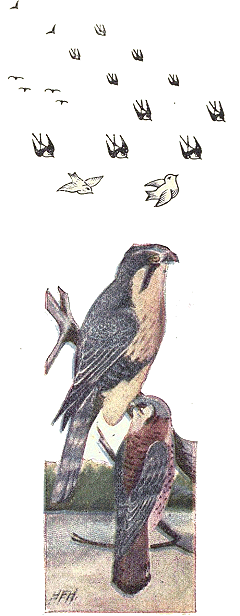
Aplomado Falcon.
Desert Sparrow Hawk. 358.1 Merlin. Falco æsalon.
This common European species was once accidentally
taken in southern Greenland. Their eggs
are generally laid on the ground on cliffs or banks.
359. Aplomado Falcon. Falco fusco-cærulescens.
Range.--Tropical America north to Mexican
boundary of the United States.
This handsome and strikingly marked Falcon is
found in limited numbers within the United States,
but south is common and widely distributed. They
nest at a low elevation, in bushes or small trees,
making their rude nests of twigs, lined with a
few grasses. They lay three, and sometimes four,
eggs which have a creamy white ground color,
finely dotted with cinnamon, and with heavy
blotches of brown. Size 1.75 × 1.30.

Buff. 359.1. Kestrel. Falco tinnunculus.
Range.--Whole of Europe; accidental on the
coast of Massachusetts.
This species is very similar in size and coloration
to the American Sparrow Hawk. They are
much more abundant than the Sparrow Hawk is
in this country and frequently nest about houses,
in hollow trees, on rafters of barns, or on ledges
and embankments. Their eggs are of a reddish
buff color, speckled and blotched with reddish
brown, they being much darker than those of the
American Sparrow Hawk.
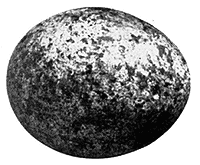
Reddish buff. 360a. Desert Sparrow Hawk. Falco sparverius phalæna.
Range.--Western United States from British Columbia south to Mexico.
This variety is slightly larger and paler than the eastern form. There are no
differences in the identification of the two varieties.
|

|
Page 222

|
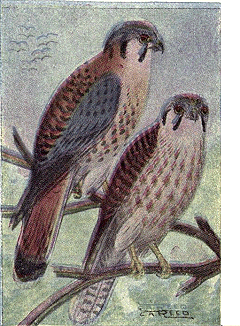
Sparrow Hawk. 360. Sparrow Hawk. Falco sparverius.
Range.--North America, east of the Rocky
Mountains and north to Hudson Bay; winters
from the middle portions of the United States,
southward.
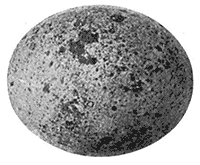
Buffy. This beautiful little
Falcon is the
smallest of the American
Hawks, being
only 10 inches in
length. They are
very abundant in the
east, nesting anywhere
in cavities in
trees, either in
woods or open fields.
The eggs are generally
deposited upon
the bottom of the
cavity with no lining; they are creamy or yellowish
buff in color, sprinkled, spotted or
blotched in endless variety, with reddish brown.
Size 1.35 × 1.10. These birds are very noisy,
especially when the young are learning to fly, uttering a loud, tinkling, "killy,
killy, killy." They have a very amiable disposition, and frequently nest harmoniously
in the same tree with other birds, such as Flickers and Robins.
360b. St. Lucas Sparrow Hawk. Falco sparverius peninsularis.
Range.--Lower California.
This variety is smaller than the eastern, and even paler than the western
form. Eggs identical with eastern specimens.
361. Cuban Sparrow Hawk. Falco sparveroides.
A darker colored West Indian form, whose habits and nesting do not vary
from those of the common Sparrow Hawk; casually taken in Florida.
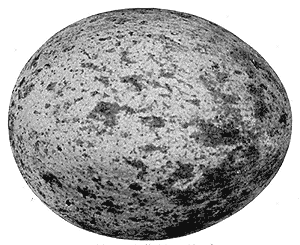
Egg of Golden Eagle.
|
|
|
Page 223
|
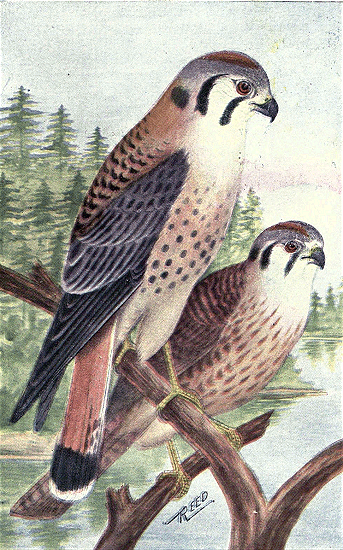
SPARROW HAWK.
|
|
Page 224

|
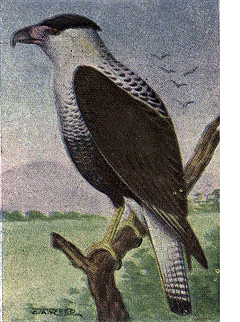
Audubon's Caracara. 362. Audubon Caracara. Polyborus cheriway.
Range.--Southern border of the United States
south to South America.
A strikingly marked blackish and whitish
species, much barred on the fore back and the
breast, with the head and throat largely white,
except for a black and somewhat crested
crown. They are numerous in southern Texas
and also in the interior of southern Florida,
where they are resident. They build bulky,
but shabby nests of sticks, weeds and grass,
piled into a promiscuous heap, generally located
in bushes or low trees. Their two or three
eggs have a ground color varying from buff to
bright cinnamon, and are dotted and blotched
with all shades of brown and umber. On the
whole, these eggs show a greater diversity of
markings and ground color than those of any
other species. Size 2.50 × 1.80.
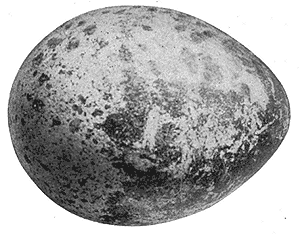
Cinnamon.
363. Guadalupe Caracara. Polyborus lutosus.
Range.--Guadalupe Island and others off Lower California.
This species is somewhat like the preceding, but the plumage is duller, and
the coloration more uniform. Their nesting habits and eggs do not vary essentially
from those of Audubon Caracara. Mr. John Lewis Childs has a set of two
eggs taken June 8, 1896, on Santa Anita Island, by Coolidge and Miller. The
nest was made of sticks and situated in a giant cactus. The eggs are slightly
brighter and more clearly marked than any of cheriway that I have ever seen.

|
|
|
Page 225
|
OSPREY. Family Pandionidae
364. Osprey. Pandion haliætus carolinensis.
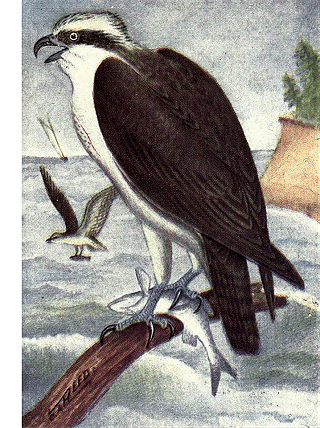
American Osprey. Range.--Whole of temperate
America from the Arctic circle
south to the equator, most abundant
along the sea coasts.
Real old birds have the head
whiter, and less white edging
to the back feathers, than do
the young. Feet very strong,
and very hard and rough, perfectly
adapted to grasping slippery
fish; outer toe can be used
equally as well, either in front
or behind, when perching or
grasping their prey.
Probably this great fisherman
is as well known from one end
of the country to the other as
any of our wild birds. He is
protected by law in a great many
states and by custom in nearly
all localities where they breed.
It is one of the pleasantest
sights along the coast to watch
a number of these great birds
as they soar at an elevation
above the water, watching for
fish to come near the surface, when, with folded wings, the bird speeds downward
and plunges into the water, rarely missing his prey. In many localities
they are very tame and nest in the vicinity of houses, sometimes even in the
yard. Their nests are platforms of sticks, which, being used year after year
and constantly added to, become of enormous proportions. They lay two or
three eggs of a bright creamy color, handsomely blotched with bright chestnut
brown. They show a great diversity of size as well as markings, but average
2.40 × 1.80.
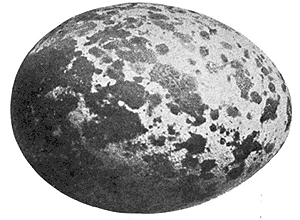
|

|
|
Page 226
|
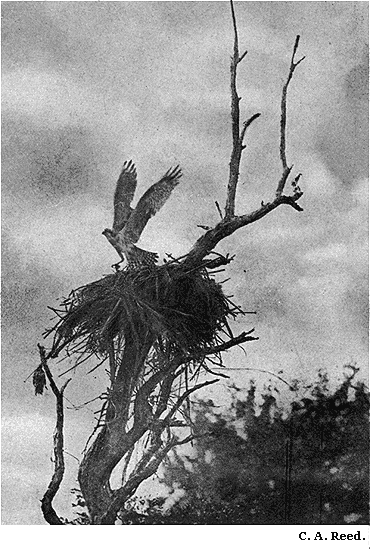
OSPREY LEAVING NEST.
|
|
|
Page 227
|
BARN OWLS. Family Alucondidae
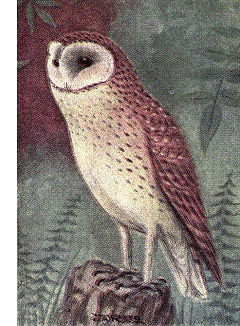
Barn Owl. 365. Barn Owl. Aluco pratincola.
Range.--Chiefly in the southern parts of the
United States; north casually to Massachusetts,
Minnesota and Washington.
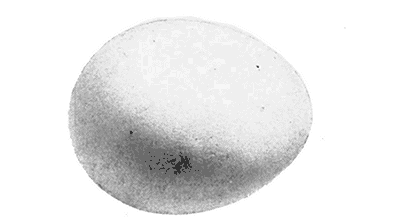
White. This is one of the lightest colored of the
Owls; it has a long, peculiarly hooded face,
from which it gets the name of "Monkey-faced
Owl." Its plumage is yellowish buff, specked and barred lightly with blackish.
It nests usually in hollow cavities of trees, but appears to have no objections
to barns, holes in banks, or anywhere it can find a concealed crevice in which
to deposit its four to six pure white eggs; size 1.70 × 1.30.
HORNED OWL. Family Strigidae
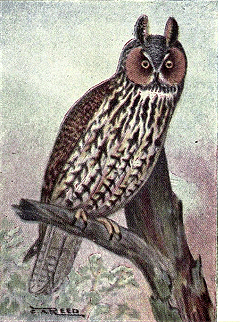
Long-eared Owl. 366. Long-eared Owl. Asio wilsonianus.
Range.--North America, breeding from the southern parts of British America,
southward.
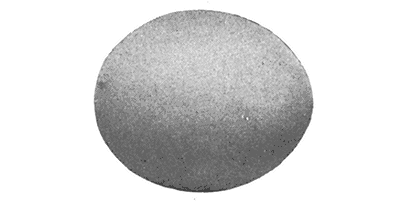
White. This species is 15 inches in length; it can easily be separated from any other
species by its long ear tufts, brownish face,
and barred underparts. Their food consists
almost entirely of small rodents, which they
catch at night. Most of their nests are found
in trees, they generally using old Crow's or
Hawk's nests. They also, in some localities,
nest in hollow trees, or in crevices among
rocks. They lay from four to seven pure white
eggs; size 1.55 × 1.35.
|

|
|
Page 228
|
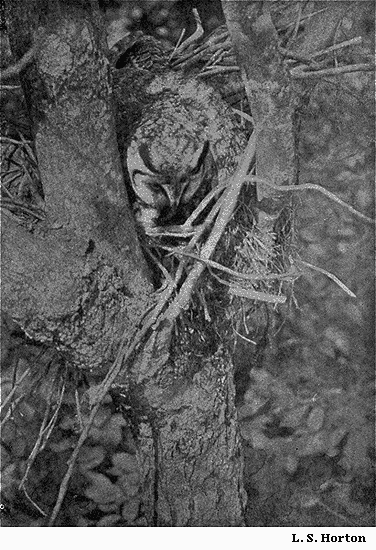
LONG-EARED OWL ON NEST.
|
|
|
Page 229
|
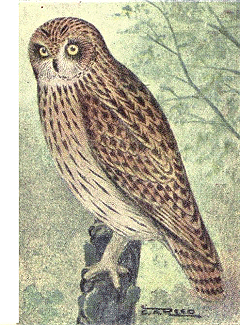
Short-eared Owl. 367. Short-eared Owl. Asio flammeus.
Range.--Whole of North America, breeding
from the middle portions of the United States
northward, and wintering in the United States.

White. This species is of the size of the last, but is
paler, has very short ear tufts, and is streaked
beneath. Its habits are the same except that it
frequently hunts, over the marshes and meadows,
on dark days and towards dusk.
Their four to seven pure white eggs are laid upon the ground in marshy
places, sometimes upon a lining of sticks and weeds, and are generally under a
bush, or close to an old log. Size of eggs 1.55 × 1.25.

White. 368. Barred Owl. Strix varia varia.
Range.--Eastern North America, from
the British Provinces, southward; west to
the Rockies.
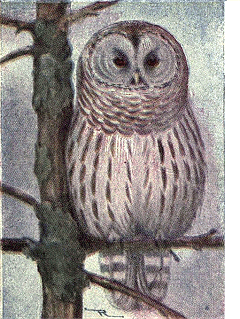
Barred Owl. This species is the most common of
the large owls, and can be distinguished
by its mottled and barred gray and white
plumage, and lack of ear tufts; length 20
inches. It is the bird commonly meant
by the term "hoot owl", and being strictly
nocturnal, is rarely seen flying in the day time,
unless disturbed from its roosting place in the
deep woods. Its food consists chiefly of rats,
mice and frogs, and sometimes, but not often,
poultry. It nests in the heart of large woods,
generally in hollows of large trees, and less
often in deserted Crow's nests. They lay from
two to four pure white eggs, averaging considerably
smaller than those of the Great Horned
Owl; size 1.95 × 1.65.
368a. Florida Barred Owl. Strix varia alleni.
Range.--Florida and the Gulf States; north
to South Carolina.
|

|
|
Page 230
|
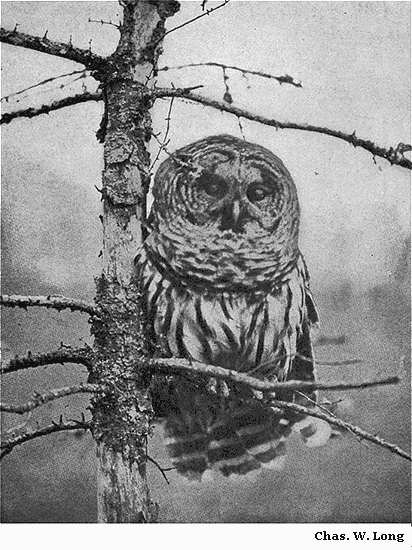
BARRED OWL.
|
|
|
Page 231
|
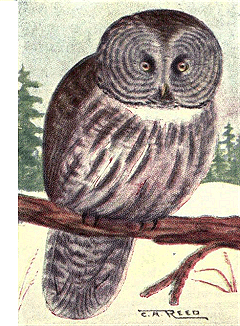
Great Gray Owl. 368b. Texas Barred Owl. Strix varia albogilva.
Range.--Southern Texas.
A very similar but slightly paler variety than
the Barred Owl, and with the toes bare, as in
alleni. Eggs indistinguishable.
369. Spotted Owl. Strix occidentalis occidentalis.
Range.--Western United States, from southern
Oregon and Colorado, southward.
Similar to the Barred Owl, but spotted, instead
of barred, on the back of head and neck,
and much more extensively barred on the under
parts. The nesting habits do not appear to
differ in any respect from those of the eastern
Barred Owl, and their eggs, which are from two
to four in number, can not be distinguished
from those of the latter species; size 2.05 × 1.80.
369a. Northern Spotted Owl. Strix occidentalis caurina.
Range.--Northwestern United States and British Columbia.
Similar to the preceding, but darker, both above and below; nesting the same,
in hollow trees or in old Hawk's or Crow's nests. Eggs not distinguishable.
370. Great Gray Owl. Scotiaptex nebulosa.
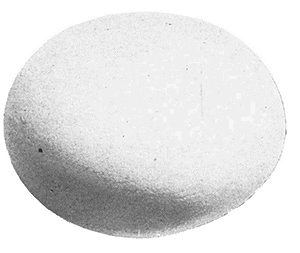
White. Range.--Northern North America;
wintering regularly south to the northern
border of the United States and
casually farther.
This is the largest of American Owls,
being about 26 inches in length; it
does not weigh nearly as much, however,
as the Great Horned or Snowy
Owls, its plumage being very light
and fluffy, and dark gray in color,
mottled with white. The facial disc is
very large, and the eyes are small and
yellow, while those of the Barred Owl
are large and blue black. They nest in
heavily wooded districts, building
their nests of sticks, chiefly in pine
trees. The two to four white eggs are laid during May and June; size 2.15 × 1.70.

|

|
Page 232

|
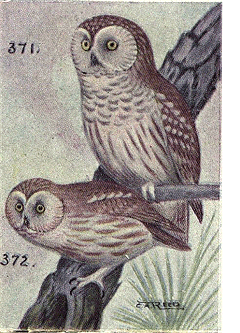
Richardson's Owl.
Saw-whet Owl. 370a. Lapp Owl. Scotiaptex nebulosa lapponica.
A paler form of the Great Gray Owl, inhabiting
the Arctic regions of the Old World; accidental
on the coast of Alaska. Their nesting
habits and eggs do not differ from those of the
American bird.
371. Richardson's Owl. Cryptoglaux funerea richardsoni.

White. Range.--Northern North America, breeding north of the United States; winters
south to our border and casually farther.
This is a dark grayish and white bird, 10 inches in length, and without ear
tufts. Breeds commonly in the extensively wooded districts of British America,
chiefly in the northern parts. Their three or four white eggs are usually at
the bottom of a cavity in a tree, but occasionally the birds build a rude nest of
sticks and twigs, lined with leaves and placed in trees at a moderate height
from the ground. Size of eggs, 1.25 × 1.05.
372. Saw-whet Owl; Acadian Owl. Cryptoglaux acadica acadica.
Range.--North America, breeding in the northern parts of the United States
and in British America, and south in the Rockies to Mexico; winters south to
the middle portions of the United States.
This small species (length 8 inches) is marked very similarly to the preceding,
but the plumage is brown instead of gray. They normally nest in hollow trees,
generally in deserted Woodpecker holes, in extensively wooded sections, and
usually in mountainous country, especially in the United States. They have
also been known to nest in bird boxes near farm houses and in old Crow's nests.
During April or May, they lay from three to six white eggs. Size 1.20 × 1.00.
They are quiet and chiefly nocturnal birds, not often seen, and may be found
nesting in any of the northern states.
372a. Northwestern Saw-whet Owl. Cryptoglaux acadica scotiæa.
Range.--A dark variety found on the coast of British Columbia.

|
|
|
Page 233
|
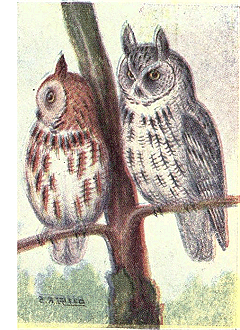
Screech Owl. 373. Screech Owl. Otus asio asio.
Range.--North America, east of the plains
and from the southern British Provinces to
Florida.

White. This well known
species, which is often
called "Little
Horned Owl" because
of its ear tufts
is found either in the
type form of some of
its varieties in all
parts of the United
States. They have
two color phases, the
plumage being either
a yellowish brown or
gray, and black and white; these color phases
are not dependent upon sex or locality, as often
young or both phases are found in the same
nest; the gray phase is the most abundant.
They nest anywhere in hollow trees, being
found very frequently in decayed stubs of apple trees. They also often nest in
barns or other old buildings which are not frequented too freely. Their food
consists chiefly of mice and meadow moles, with occasionally small birds.
During April or May they lay their white eggs, the full complement of which
is from five to eight. Size 1.35 × 1.20. The nesting habits of all the sub-species,
as far as we can learn, are exactly like those of the eastern Screech Owl; the
eggs cannot be distinguished, and in most cases, even the birds cannot be distinguished.
373a. Florida Screech Owl. Otus asio floridanus.
Range.--South Atlantic and Gulf coasts.
Slightly smaller and darker than asio. The eggs average slightly smaller.
Size 1.30 × 1.15.
373b. Texas Screech Owl. Otus asio mccalli.
Range.--Texas, and southward into Mexico. Very similar to floridanus.
373c. California Screech Owl. Otus asio bendirei.
Range.--Coast of California and Oregon. Size of, but darker than asio.
373d. Kennicott's Screech Owl. Otus asio kennicotti.
Range.--Pacific coast from Oregon to Alaska. This is the darkest of the
Screech Owls and averages a trifle larger than the eastern form.
373e. Rocky Mountain Screech Owl. Otus asio maxwelliæ.
Range.--Foothills of the Rockies, from Colorado to Montana. This is the
palest form of the Screech Owl. Of the same size as the last.
|

|
Page 234

|
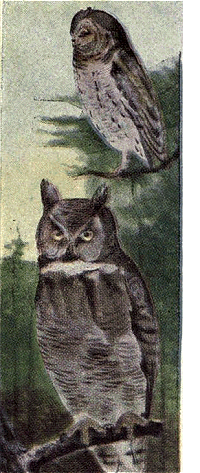
374--375a. 373f. Mexican Screech Owl. Otus asio cineraceus.
Range.--Western Mexico and southwestern border of
the United States. A gray form with little or no buff, and
more numerously barred below.
373g. Aiken's Screech Owl. Otus asio aikeni.
Range.--El Paso County, Colorado. A gray form, with
the dark markings coarser and more numerous than in any
other.
373h. MacFarlane's Screech Owl. Otus asio macfarlanei.
Range.--Northern border of the United States from
Washington to Montana.
373.1. Spotted Screech Owl. Otus trichopsis.
Range.--Mountains of southern Arizona, south into
Mexico.
A grayish species, similar to asio, but paler and more
finely barred beneath, and with whitish spots on the
feathers of the foreback. The nesting habits and eggs are
probably the same as those of the Screech Owl.
373.2. Xantus's Screech Owl. Otus xantusi.
Range.--Southern Lower California.
A grayish species with the back and underparts finely vermiculated with reddish
brown, and with streaks of darker. It is not likely that the habits or eggs
of this species will be found to differ from those of the Screech Owl.
374. Flammulated Screech Owl. Otus flammeolus flammeolus.
Range.--Mountain ranges of Mexico, north to Colorado and west to California.
This species is smaller than asio, has shorter ear tufts, the plumage is much
streaked and edged with rusty, and the toes are unfeathered to their base. They
nest in hollow trees, generally using deserted Woodpecker holes. Their three
or four eggs are white. Size 1.15 × .95. This species is uncommon in all parts
of its range.
374a. Dwarf Screech Owl. Otus flammeolus idahœnsis.
Range.--Local in Idaho, eastern Washington and California.
This rare variety is smaller than the preceding and is considerably paler. Its
eggs have not been described, but should be a trifle smaller than the last.

|
|
|
Page 235
|
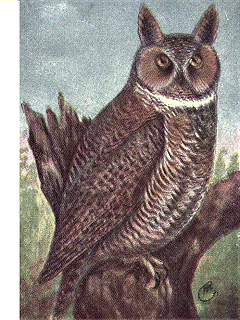
Great Horned Owl. 375. Great Horned Owl. Bubo virginianus virginianus.
Range.--North America, east of the Plains
and north to Labrador.

White. This species and its varieties are the only large Owls having conspicuous ear
tufts. They are about 22 inches in length, and have a mottled brown, black and
white plumage, barred below. This is also one of the "Hoot Owls," but is not
nearly as abundant as the Barred Owl. It is one of the strongest of the family,
and captures rabbits, grouse and poultry, and is very often found to have been
feeding upon, or to have been in the immediate vicinity of a skunk. They nest
very early, January, February and March. Deserted Hawk's or Crow's nests
are very frequently used by this bird, if they are located in dense woods. They
also sometimes nest in hollow cavities in large trees. They lay from two to
four pure white eggs. Size 2.25 × 1.85.
375a. Western Horned Owl. Bubo virginianus pallescens.
Range.--Western North America, except the Pacific coast.
A smaller and lighter colored form of the preceding, having the same habits
and the eggs being indistinguishable from those of the eastern bird.
375b. Arctic Horned Owl. Bubo virginianus subarcticus.
Range.--Interior of Arctic America from Hudson Bay to Alaska; south in
winter to the northwestern tier of states.
A very pale colored Horned Owl with little or no buff or brownish in the
plumage, some specimens (very rare) being pure white with only a few black
bars on the back. Their nesting habits are the same and the eggs do not vary
appreciably from those of the eastern Horned Owl.
375c. Dusky Horned Owl. Bubo virginianus saturatus.
Range.--Pacific coast from California to Alaska.
This is the darkest of the Horned Owls, the extreme case being nearly black
on the back and very dark below. Nesting the same as the Great Horned Owl.
375d. Pacific Horned Owl. Bubo virginianus pacificus.
Range.--California, southward and east to Arizona.
Smaller and darker than the eastern form but not as dark as the last. Eggs
the same as those of the others.
|

|
|
Page 236
|

YOUNG SCREECH OWLS.
|
|
|
Page 237
|
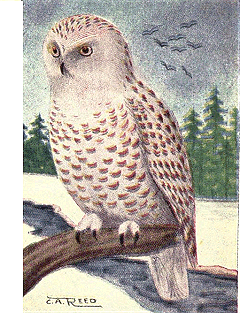
Snowy Owl. 375e. Dwarf Horned Owl. Bubo virginianus elachistus.
Range.--Lower California.
This is a similar but darker form of the
Horned Owl and is very much smaller than
virginianus. The nesting habits will be the
same, but the eggs may average smaller.
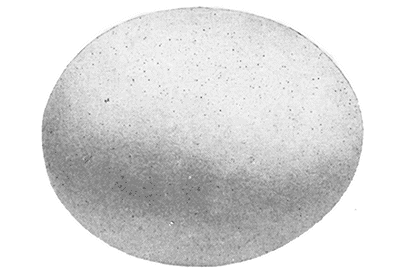
White. 376. Snowy Owl. Nyctea nyctea.
Range.--Arctic regions, breeding within the Arctic Circle and wintering to
the northern border of the United States and casually farther.
This very beautiful species varies in plumage from pure white, unmarked, to
specimens heavily and broadly barred with blackish brown. It is, next to the
Great Gray Owl, the largest species found in America, being 2 feet in length.
Like the Great Horned Owls, they are very strong, fearless, and rapacious birds,
feeding upon hares, squirrels and smaller mammals, as well as Grouse, Ptarmigan,
etc. They nest upon the ground, on banks or mossy hummocks on the
dry portions of marshes, laying from two to eight eggs, white in color and with
a smoother shell than those of the Great Horned Owl. Size 2.25 × 1.75. Data.--Point
Barrow, Alaska, June 16, 1898. Three eggs laid in a hollow in the moss.
377. European Hawk Owl. Surnia ulula ulula.
Range.--Northern portion of the Old World; accidental in Alaska.
Similar to the American species, but lighter and more brownish.

|

|
Page 238

|
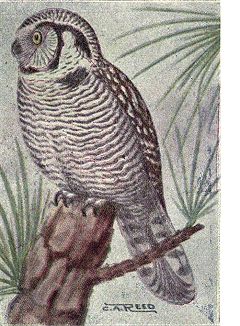
American Hawk Owl. 377a. Hawk Owl. Surnia ulula caparoch.
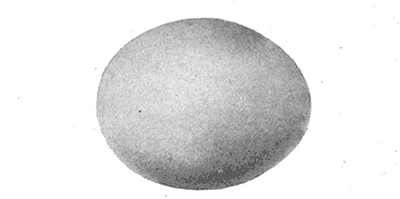
White. Range.--Northern North America, breeding
from the central portions of British America
northward; probably also breeds in the Rocky
Mountains in the northern tier of states and
casually farther.
This handsome mottled and barred, gray and
black Owl might readily be mistaken for a
Hawk, because of his Hawk-like appearance
and long rounded tail. They are very active birds, especially in the day time,
for they are more diurnal than nocturnal; their food is mostly of small rodents,
and also small birds. They nest either in the tops of large fir trees, in hollows
of stumps, or, in some cases, upon the ground. When in trees their nests are
made of twigs, leaves and weeds, and sometimes lined with moss and feathers;
they lay from three to eight white eggs, size 1.50 × 1.20. Data.--Labrador, May
3, 1899. Five eggs. Nest in the top of a dead tree, 15 feet from the ground.
378. Burrowing Owl. Speotyto cunicularia hypogæa.
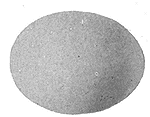
White. Range.--Western North America from the Mississippi
Valley west to California; north to the southern parts
of British America and south to Central America.
These peculiar birds are wholly different in plumage,
form and habits from any other American Owls. They
can readily be recognized by their long, slender and
scantily feathered legs. Their plumage is brownish,
spotted with white above, and white, barred with brown
below; length 10 inches. They nest, generally in large
communities in burrows in the ground, usually deserted
Prairie Dog holes. While generally but a single pair
occupy one burrow, as many as twenty have been found nesting together.
Sometimes the burrows are unlined, and again may have a carpet of grasses
and feathers. Their white eggs generally number from six to ten; size 1.25 ×
1.00. Data.--Sterling, Kans., May 7, 1899. Nest of bits of dry dung at the end of
a deserted Prairie Dog burrow.

|
|
|
Page 239
|
378a. Florida Burrowing Owl. Speotyto cunicularia floridana.

Burrowing Owl. Range.--Local in the interior
of Florida.
Like the last, but slightly
smaller and paler, and with the
tarsus less feathered. Their
habits or eggs do not differ from
the preceding.
379. Pygmy Owl. Glaucidium gnoma gnoma.
Range.--Rocky Mountain region
and westward; from British
Columbia southward. These
interesting little Owls, which are
but seven inches in length, feed
in the day time upon insects,
mice and, occasionally, small
birds. They frequent extensively
wooded districts, chiefly in
the mountain ranges. They nest
in tall trees, generally in deserted
Woodpeckers' holes, laying
three or four white eggs during
May; size about 1.00 × .90.
379a. California Pygmy Owl. Glaucidium gnoma californicum.
Range.--Pacific coast from British Columbia, south through California. This
sub-species is darker and more brownish than the last. It is not an uncommon
bird in California. They nest in the tallest trees along the ranges, often being
found 75 or more feet from the ground. The eggs do not differ from those of
the Pygmy Owl, ranging in size from 1.00 × .85 to 1.20 × .95.
379.1. Hoskin's Pygmy Owl. Glaucidium hoskinsi.
Range.--Southern Lower California.
This species is smaller and more gray than the preceding. It is not probable
that its manners of nesting or eggs differ in any respect from those of the others
of this genus.

|

|
Page 240

|
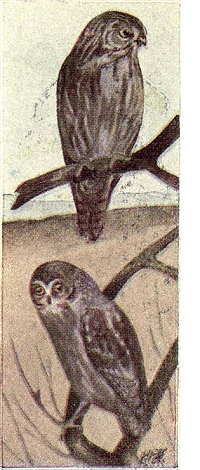
380--381. 380. Ferruginous Pygmy Owl. Glaucidium phalœnoides.
Range.--Mexico and Central America; north to the Mexican
border of the United States.
This species is of the same size as the last, but is much
tinged with rufous on the upper parts, and the tail is of a
bright chestnut brown color, crossed by about eight bars
of black. They nest in hollow cavities in trees, from ten
to forty feet from the ground, laying three or four glossy
white eggs; size 1.10 × .90.
381. Elf Owl. Micropallas whitneyi.
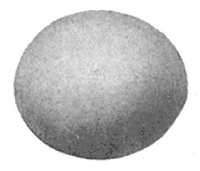
White. Range.--Mexico, north to the bordering states.
This odd little bird is the smallest
member of the family found in America,
attaining a length of only six inches.
In plumage it may be described
as similar to a very small, earless
Screech Owl, only with the pattern of
the markings a great deal finer. They
are said to be quite abundant in the
table lands of central Mexico and in
southern Arizona, where they build
their nests in deserted Woodpeckers' holes, perhaps most frequently in the
giant cactus. It is said to be more nocturnal than the Pygmy Owls and to feed
almost exclusively upon insects. They lay from three to five eggs having a
slight gloss. Size 1.02 × .90. Data.--Southern Arizona, May 22, 1902. Nest in a
deserted Woodpecker hole. Two eggs.

|
|
|
Page 241
|
PAROQUETS AND PARROTS. Order XIII. PSITTACI.
Family PSITTACIDAE
382. Carolina Paroquet. Conuropsis carolinensis.
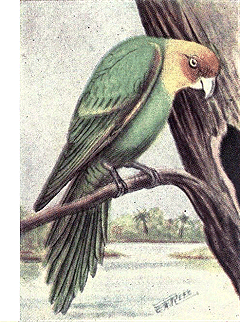
Carolina Paroquet. Range.--Now rare in Florida and along the
Gulf coast to Indian Territory. As late as 1885,
the Carolina Paroquets were abundant in the
South Atlantic and Gulf States, but owing to
their wanton destruction by man, they have
been exterminated in the greater portion of
their range, and now are rarely seen in any
locality, and then only in the most unhabitable
swamps and thickets.
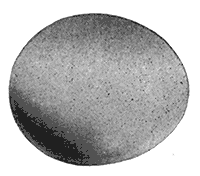
White. A reliable account of
their nesting habits is lacking, as are also specimens
of their eggs
taken from wild birds.
They are said to build
rude nests of sticks
upon horizontal branches
of cypress trees,
and to nest in colonies;
it is also claimed
that they nest in
hollow trees, laying
from three to five pure
white eggs. The one
figured is one of three
laid in confinement at Washington, D. C., by a
pair of birds owned by Mr. Robert Ridgeway. It is 1.31 × 1.06 and was laid
July 12, 1892. This set is in the collection of Mr. John Lewis Childs.
382.1. Thick-billed Parrot. Rhynchopsitta pachyrhyncha.
Range.--Mexico, north casually to the Mexican border of the United States.
This large Parrot (16 inches long) has a heavy black bill, and the plumage is
entirely green except for the deep red forehead, strips over the eye, shoulder,
and thighs, and the yellowish under wing coverts. Their eggs are white and
are laid in natural cavities in large trees in forests.
CUCKOOS, TROGANS, KINGFISHERS, ETC. Order XIV.
CUCKOOS, ANIS, ETC. Family CUCULIDAE
383. Ani. Crotophaga ani.
Range.--Northeastern South America and the West Indies; casual in Florida,
and along the Gulf coast; accidental in Pennsylvania.
This species is similar to the next, but the bill is smoother and without
grooves. Its nesting habits are the same as those of the more common American
species.
|

|
|
Page 242
|
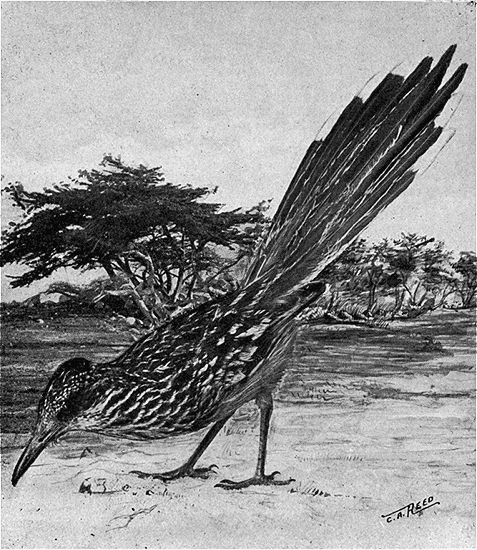
ROADRUNNER.
|
|
|
Page 243
|
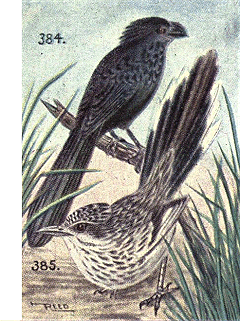
Groove-billed Ani.
Road Runner. 384. Groove-billed Ani. Crotophaga sulcirostris.
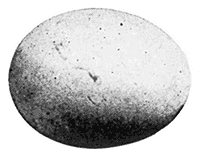
Greenish blue. Range.--Mexico and the border of the United
States; common in southern Texas. This odd
species has a Cuckoo-like form, but is wholly
blue black in color, and has a high thin bill
with three conspicuous longitudinal grooves on
each side. They build
large bulky nests of
twigs, lined with
leaves and grasses,
and located in low
trees and bushes. They
build in small colonies
but do not, as is
claimed of the common
Ani, build a large
nest for several to occupy.
They lay from
three to five eggs of a greenish blue color, covered
with a chalky white deposit. Size 1.25
× 1.00. They are laid in May or June.
385. Road-runner. Geococcyx californianus.
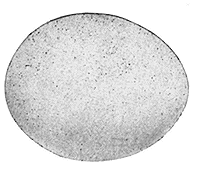
White. Range.--Western United States from Oregon, Colorado and Kansas, southward;
most abundant on the Mexican border, and wintering in central Mexico.
This curious species is known as the "Chaparral
Cock", "Ground Cuckoo," "Snake-killer," etc. Its
upper parts are a glossy greenish brown, each
feather being edged or fringed with whitish; the
tail is very long, broad and graduated, the feathers
being broadly tipped with white. They are noted
for their swiftness on foot, paddling over the
ground at an astonishing rate, aided by their outstretched
wings and spread tail, which act as
aeroplanes; their legs are long and have two toes
front and two back. Their food consists of lizards
and small snakes, they being particularly savage
in their attacks upon the latter. They build rude
nests of sticks and twigs, in low trees or bushes,
and during April or May, lay from four to ten eggs, depositing them at intervals
of several days. They are pure white and measure 1.55 × 1.20.

|

|
Page 244

|

Mangrove Cuckoo.
Yellow-billed Cuckoo. 386. Mangrove Cuckoo. Coccyzus minor minor.
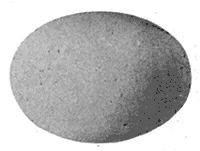
Light greenish blue. Range.--West Indies, Mexico and South
America, north regularly to southern Florida.
This species is very
similar to our common
Yellow-billed Cuckoo,
but the whole underparts
are deep buff. It
is a common species and
nests abundantly in the
West Indies, but occurs
only in limited numbers
in southern Florida.
Their nests are shallow
platforms of twigs and rootlets, placed in
bushes and low trees, and upon which they lay
three or four pale greenish blue eggs, similar
to those of the Yellow-billed species but averaging
smaller; size 1.15 × .85.
386a. Maynard's Cuckoo. Coccyzus minor maynardi.
Range.--Bahamas; accidental on Florida Keys. This is a slightly smaller
and paler form than the preceding.
387. Yellow-billed Cuckoo. Coccyzus americanus americanus.
Range.--United States east of the Plains and from southern Canada southward.
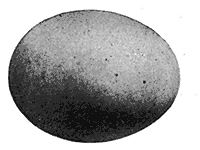
Pale greenish blue. This species is generally abundant in all localities in its range, which afford
suitable nesting places of tangled underbrush or vines. It may be distinguished
from the Black-billed variety by its larger size (12 inches long), blackish tail
with broad white tips, and yellowish lower mandible. They are often regarded
by the superstitious as forecasters of rain, and as
omens, probably because of their gutteral croaking
notes.
Their nests are made of twigs, lined with shreds
of grape vine bark or catkins; the nests are generally
very shabbily made and so flat on the top that
the eggs frequently roll off. They are located near
the ground in bushes or low trees. The three or four
eggs are deposited at intervals of several days, and
frequently young birds and eggs are found in
the nest at the same time. Like the Flicker, this
bird will frequently continue laying if one egg is
removed at a time, and as many as twelve have been taken from the same nest,
by this means. The eggs are light greenish blue. Size 1.20 × .90. They are
usually laid during May or June.

|
|
|
Page 245
|
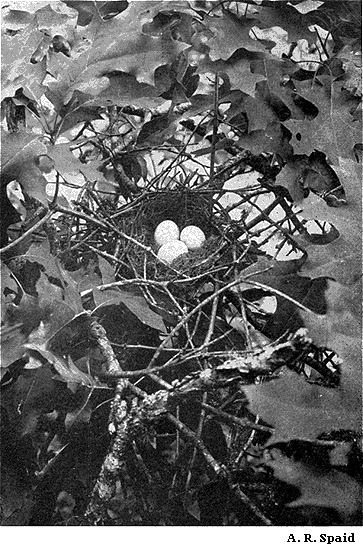
NEST AND EGGS OF YELLOW-BILLED CUCKOO.
|
|
Page 246

|
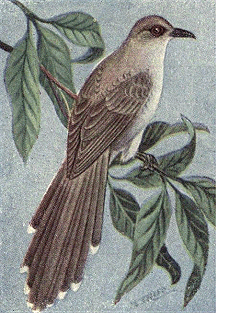
Black-billed Cuckoo. 387a. California Cuckoo. Coccyzus americanus occidentalis.
Range.--Western North America, from
British Columbia, southward.
Slightly larger and with a stouter bill than
the last. Eggs not distinguishable.
388. Black-billed Cuckoo. Coccyzus erythrophthalmus.
Range.--United States east of the Rocky
Mountains; north to Labrador and Manitoba;
south in winter to Central and South America.
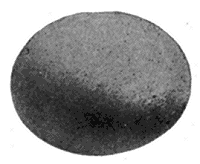
Greenish blue. This species is rather
more common in the
northern part of the
United States than the
Yellow-billed variety.
The bird is smaller, has
a blackish bill, and the
tail is the same color as
the back and only slightly
tipped with white.
Their nests are built in
similar locations and of the same materials as used by the Yellow-bill; the three
or four eggs are smaller and a darker shade of greenish blue. Size 1.15 × .85.
All the Cuckoos are close sitters and will not leave the nest until nearly reached
with the hand, when they will slowly flutter off through the underbrush, and
continue to utter their mournful "Kuk-kuk-kuk," many times repeated.
388.1. Kamchatka Cuckoo. Cuculus canorus telephonus.
An Asiatic subspecies of the common European Cuckoo, accidentally occurring
in Alaska.
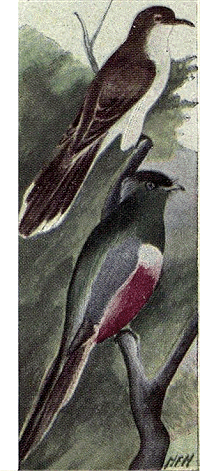
387a--389. TROGONS. Family TROGONIDÆ
389. Coppery-tailed Trogon. Trogon ambiguus.
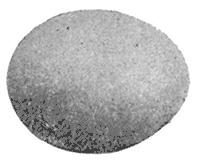
Dull White. Range.--Southern Mexico, north to the Lower Rio
Grande in Texas and in southern Arizona, in both of which
localities they probably breed.
This is the only member of this
family of beautiful birds which
reaches our borders. This species
is 12 inches in length, and is a
metallic green color on the upper
parts and breast, and with coppery
reflections of the middle tail feathers,
the outer ones being white,
very finely vermiculated with black,
as are the wing coverts. The underparts,
except for a white band
across the breast, are rosy red. This species nest in
cavities in large trees, generally in large, deserted Woodpecker
holes. They are also said to have been found nesting
in holes in banks. Their eggs are three or four in
number and are a dull white in color. Size 1.10 × .85.
|
|
|
Page 247
|
KINGFISHERS. Family ALCEDINIDÆ
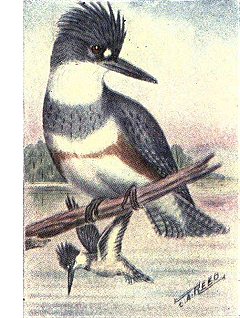
Belted Kingfisher. 390. Belted Kingfisher. Ceryle alcyon.
Range.--Whole of North America, breeding
from southern United States, northward and
wintering from the southern parts of its breeding
range, southward.
This well known bird is abundant in all localities
near water, where its rattling notes are
among the most familiar of sounds.

White. Their food
is almost entirely of small fish, which they
catch by plunging upon from their perch on an
old dead limb overhanging
the water,
or by hovering in
the air like an Osprey.
Their nests
are located at the
end of burrows in
sand banks or the
banks of creeks and
rivers. These tunnels,
which are dug
by the birds, generally
commence two or three feet from the top
of the bank and extend back from six to eight
feet, either in a straight line or curved; the end is enlarged to form a suitable
nesting place, in which from five to eight eggs are laid. They are glossy and
pure white in color. Size 1.35 × 1.05. Data.--Lake Quinsigamond, Massachusetts,
June 6, 1900. 7 eggs at the end of a 6 foot tunnel in a sand bank. Bird
removed by hand from the nest. Collector, C. E. Howe.
390.1. Ringed Kingfisher. Ceryle torquata.
Range.--Mexico, north casually to the Lower Rio Grande Valley in Texas.
This handsome species is much larger than the Belted Kingfisher and the
underparts are nearly all bright chestnut, except the white throat. They nest in
river banks the same as the common American species, and the eggs are white,
but larger. Size 1.45 × 1.10.

|

|
|
Page 248
|
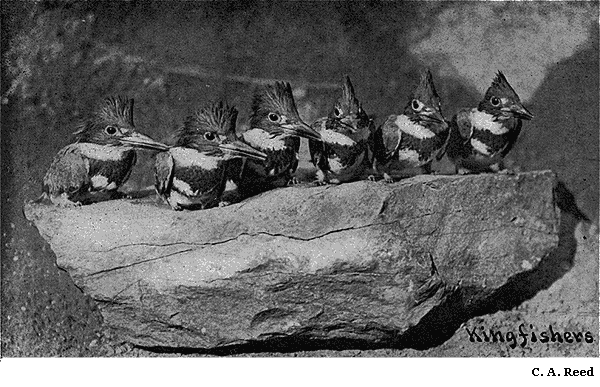
YOUNG KINGFISHERS.
|
|
|
Page 249
|
391. Texas Kingfisher. Ceryle americana septentrionalis.

Texas Kingfisher. Range.--Southern Texas, south through Mexico.
This variety is much smaller than the Belted,
length 8 inches, and is a lustrous greenish
above, variously speckled with white, and is
white below, spotted with greenish. It is a
common and resident species in southern
Texas, where it lays its eggs in holes in the
banks along streams. The eggs are white and
glossy, and measure .95 × .70.
WOODPECKERS. Order XV. PICI.
Family PICIDAE
Woodpeckers are well known birds having
sharp chisel-like bills, sharply pointed and
stiffened tail feathers, and strongly clawed feet
with two toes forward and two back, except in
one genus. Their food is insects and grubs,
which they get by boring in trees, and from under the bark, clinging to the
sides of trunks or the under side of branches with their strong curved nails,
aided by the tail, for a prop. They are largely resident where found.
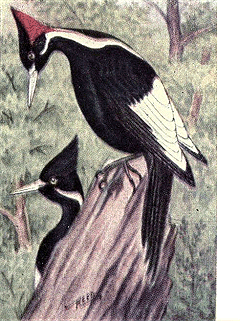
Ivory-billed Woodpecker. 392. Ivory-billed Woodpecker. Campephilus principalis.
Range.--Locally distributed, and rare, in
Florida, along the Gulf coast and north casually
to South Carolina and Arkansas.
This is the largest of the Woodpeckers found
within our borders, being 20 inches in length.
But one other American species exceeds it in
size, the Imperial Woodpecker of Mexico, which
reaches a length of nearly two feet; as this
species is found within a few miles of our
Mexican border, it may yet be classed as a
North American bird. The present species has
a large, heavy, ivory-white bill. They can
readily be identified, at a great distance, from
the Pileated Woodpecker by the large amount
of white on the secondaries. They used to be
not uncommonly seen in many sections of the
southeast but are now found very locally and
only in the largest and remote woods. They
nest in holes in large trees in the most impenetrable
swamps; laying three, and probably as
many as six pure white glossy eggs measuring 1.45 × 1.00.
|

|
Page 250

|
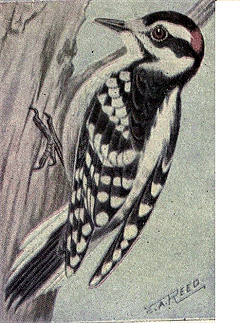
Hairy Woodpecker. 393. Hairy Woodpecker. Dryobates villosus villosus.
Range.--United States east of the Plains and
from North Carolina to Canada.
The Hairy Woodpecker or its sub-species is
found in all parts of North America. The nesting
habits and eggs of all the sub-species are
not in any way different from those of the
eastern bird, consequently what is said in regard
to the eastern form will apply equally to
all its varieties.
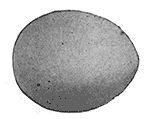
White. Except during the winter
months, this species
is not as commonly seen
about houses or orchards
as the Downy Woodpecker.
During the summer they
retire to the larger woods
to nest, laying their eggs
in holes in the trunks or
limbs of trees at any height from the ground,
and generally using the same hole year after
year, and often twice or three times during
one season, if the first sets are taken. They
lay from three to six glossy white eggs; size .95 × .70. This species can
be distinguished
from the Downy Woodpeckers by their larger size (9 inches long),
and the white outer tail feathers, which are unspotted.
393a. Northern Hairy Woodpecker. Dryobates villosus leucomelas.
Range.--North America, north of the United States.
Slightly larger than the preceding.
393b. Southern Hairy Woodpecker. Dryobates villosus auduboni.
Range.--Southern United States; north to South Carolina.
Similar to the Hairy Woodpecker, but smaller.
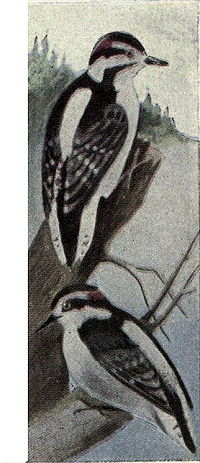
393c--394a. 393c. Harris's Woodpecker. Dryobates villosus harrisi.
Range.--Pacific coast from California to British Columbia.
Similar to the Hairy but with fewer or no white spots
on the wing coverts, and grayish on the underparts.
393d. Cabanis Woodpecker. Dryobates villosus hyloscopus.
Range.--Southern California, east to Arizona and south
into Mexico. Like the preceding but whiter below.
393e. Rocky Mountain Hairy Woodpecker. Dryobates villosus monticola.
Range.--Rocky Mountains from British Columbia south
to New Mexico.
Similar to harrisi but slightly larger and pure white below.
393f. Queen Charlotte Woodpecker. Dryobates villosus picoideus.
Range.--Queen Charlotte Islands, British Columbia.
Like Harris Woodpecker, but with the flanks streaked
and the middle of the back spotted with blackish.
|
|
|
Page 251
|
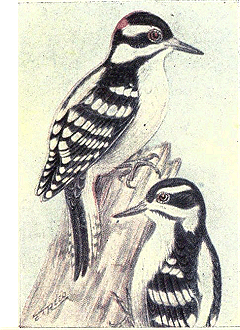
Southern Downy. 394. Southern Downy Woodpecker. Dryobates pubescens pubescens.
Range.--Gulf and South Atlantic States;
north to South Carolina.
This species, which is the smallest of the
North American Woodpecker (length 6 inches),
is similar in plumage to the Hairy Woodpecker,
but has the ends of the white, outer tail feathers
spotted with black.
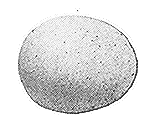
White, glossy. Like the last species,
it is represented by sub-species
in all parts of North
America, the nesting habits
of all the varieties being the
same and the eggs not distinguishable
from one another.
They nest in holes in
trees, very often in orchards
or trees in the neighborhood of houses. They are
not nearly as shy as the Hairy Woodpeckers, and
also associate with other birds very freely. The
three to six eggs are laid upon the bottom of
the cavity, with no lining. The height of the
nesting season is during May or June. The
white glossy eggs are .75 × .60.
394a. Gairdner's Woodpecker. Dryobates pubescens gairdneri.
Range.--Pacific coast from northern California to British Columbia.
This sub-species is like the last, but is without spots on the wing coverts and
is a dingy white below, differing the same as Harris Woodpecker from the Hairy.
394b. Batchelder's Woodpecker. Dryobates pubescens homorus.
Range.--Rocky Mountain region of the United States.
Like the last but whiter below.
394c. Downy Woodpecker. Dryobates pubescens medianus.
Range.--North America, east of the Plains and north of South Carolina.
Similar to the southern variety but slightly larger and whiter.
394d. Nelson's Downy Woodpecker. Dryobates pubescens nelsoni.
Range.--Alaska.
Similar to the northern variety but still larger.
394e. Willow Woodpecker. Dryobates pubescens turati.
Range.--California except the northern parts and the ranges of the south.
Similar to Gairdner Woodpecker, but smaller and whiter.
395. Red-cockaded Woodpecker. Dryobates borealis.
Range.--Southeastern United States, from South Carolina and Arkansas,
southward.
This black and white species may be known from any other because of
the uniform black crown and nape, the male having a small dot of red on
either side of the crown, back of the eye. They are quite abundant in the
Gulf States and Florida, where they nest during April and May, and in some
localities in March. They build in hollow trees or stumps at an elevation
from the ground, laying from three to six glossy white eggs; size .95 × .70.
|

|
Page 252

|
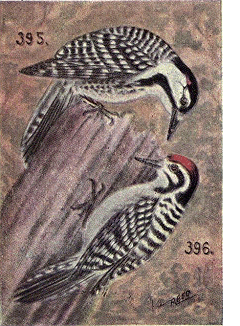
Red-cockaded Woodpecker.
Texas Woodpecker. 396. Texas Woodpecker. Dryobates scalaris bairdi.
Range.--Southwestern United States from
southern Colorado south to northern Mexico.
This species is brownish white below, has the
back barred with black and white, and the male
has the whole crown red, shading into mixed
black and whitish on the forehead. Its habits
and nesting are just the same as those of the
Downy, but the three or four white eggs, that
they lay in April, are larger; size .80 × .65.
396a. San Lucas Woodpecker. Dryobates scalaris lucasanus.
Range.--Lower California, north to the Colorado
Desert, California.
Very similar to the last; less barring on the
outer tail feathers. Eggs the same.
397. Nuttall's Woodpecker. Dryobates nuttalli.
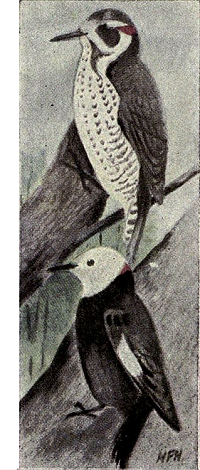
398--399. Range.--Pacific coast from Oregon south to Lower California.
Similar to the Texan Woodpecker but whiter below,
with whitish nasal tufts, and the fore part of the crown
black and white striped, the red being confined to the
nape region. They nest in holes in trees, either in dead
stumps or in growing trees, and at any height above
ground. During April or May they deposit their white
glossy eggs upon the bottom of the cavity. The eggs
measure .85 × .65.
398. Arizona Woodpecker. Dryobates arizonæ.
Range.--Mexican border of the United States, chiefly in
Arizona and New Mexico.
This species is entirely different from any others of
our Woodpeckers, being uniform brownish above, and soiled
whitish below, spotted with black. The male bird has a
red crescent on the nape. They are said to be fairly abundant
in some sections of southern Arizona. Their nesting
habits do not vary from those of the other Woodpeckers
found in the same regions, and they show no especial preference
for any particular kind of a tree in which to lay
their eggs. The nesting season appears to be at its
height in April. The pure white eggs average in size
about .85 × .60.

|
|
|
Page 253
|
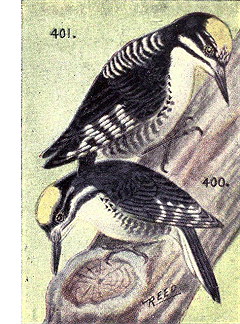
Three-toed Woodpecker.
Arctic Three-toed Woodpecker. 399. White-headed Woodpecker. Xenopicus albolarvatus.
Range.--Western United States from southern
California to southern British Columbia.
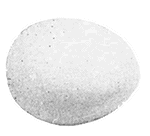
White. This odd species is wholly a dull black color,
except for the white head and neck, and basal
half of the primaries. They
are quite abundant in some
localities, particularly in
California on mountain
ranges. They nest at any
height, but the greater
number have been found
under twenty feet from the
ground and in old pine
stubs. They lay from four
to six glossy white eggs,
measuring .95 × .70. They are said to be more
silent than others of the Woodpecker family,
and rarely make the familiar tapping and never
drum. It is claimed that they get at their
food by scaling bark off the trees, instead of
by boring.
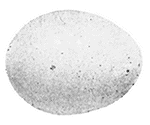
White. 400. Arctic Three-toed Woodpecker. Picoides arcticus.
As implied by their name, members of this genus have
but three toes, two in front and one behind. The plumage
of this species is entirely black above, and whitish below,
with the flanks barred with blackish. The male has a
yellow patch on the crown. They breed abundantly in
coniferous forests in mountainous regions throughout their
range, laying their eggs in cavities in decayed stumps and
trees, apparently at any height, from five feet up. The
eggs are laid in May or June. Size .95 × .70.
Range.--Northern parts of the United States, north to the Arctic regions.
401. Three-toed Woodpecker. Picoides americanus americanus.
Range.--From northern United States northward.
The chief difference between this species and the last is in the white on the
back, either as a patch or in the form of broken bars. The nesting habits are
just the same and the eggs cannot be distinguished from those of the preceding.
Both forms are found breeding in the same localities in the Adirondacks and in
nearly all other portions of their range.

|

|
Page 254

|
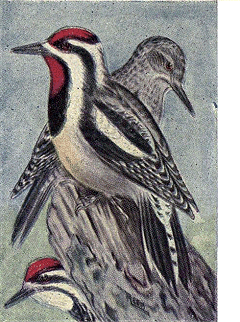
Yellow-bellied Sapsucker. 401a. Alaska Three-toed Woodpecker. Picoides americanus fasciatus.
Range.--Alaska, south to British Columbia
and Washington.
Like the last, but with more white on the
back. Eggs like the arcticus.
401b. Alpine Three-toed Woodpecker. Picoides americanus dorsalis.
Range.--Rocky Mountains from British Columbia
south to New Mexico.
Slightly larger than the preceding and with
more white on the back, almost entirely losing
the barred effect of the American Three-toed
variety. They nest chiefly in dead pines, laying
four or five white eggs that cannot be distinguished
from those of many other species.
Size .95 × .70.
402. Yellow-bellied Sapsucker. Sphyrapicus varius varius.
Range.--North America, east of the Plains; breeding from Massachusetts
northward, and wintering from the Carolinas and Illinois southward.
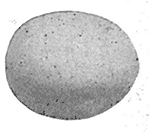
White. This species is one of the most handsomely marked of the family; they can
easily be recognized by the red crown and throat (white on the female), each
bordered by black, and the yellowish underparts. The members
of this genus have been found to be the only ones that
are really injurious, and these only to a slight extent, to cultivated
trees. This species and the two following are the only
real "sapsuckers," a crime that is often attributed to the most
useful of the family. Their nesting season is during May and
June, they then resorting to the interior of the woods, where
they deposit their four to seven glossy eggs on the bottom
of holes in trees, generally at quite an elevation from the
ground. Size of eggs .85 × .60.
402a. Red-naped Sapsucker. Sphyrapicus varius nuchalis.
Range.--Rocky Mountain region of the United States and southern Canada
south to Mexico and west to California.
This variety differs from the last, chiefly in addition of a band of scarlet
on the nape in place of the white on the Yellow-bellied species. Coming as
it does, midway between the ranges of the preceding species and the following,
this variety, with its extension of red on the head and throat, may be regarded
somewhat as a connecting link between the two species, but it is perfectly distinct
and does not intergrade with either. There appears to be no difference in
the nesting habits of the two varieties, except that the present one, according to
Bendire, shows a preference to nesting in live aspens. The eggs measure
.90 × .65.
|
|
|
Page 255
|
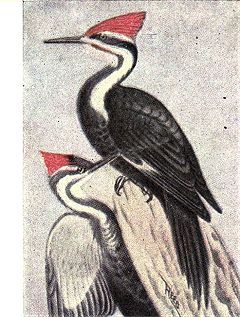
Pileated Woodpecker. 403. Red-breasted Sapsucker. Sphyrapicus ruber ruber.
Range.--Pacific Coast from Lower California
to Oregon.
Except for a whitish line from the eye to
the bill, the entire head, neck and breast of
this species is red, of varying shades in different
individuals, from carmine to nearly a scarlet;
the remainder of their plumage is very
similar to that of the Yellow-bellied Sapsucker.
This is an abundant species and in most parts
of the range they are not timid. Like many of
the Woodpeckers, they spend a great deal of
their time in drumming on some dead limb.
They nest commonly in aspens, preferably living
ones, and are said to build a new nesting
hole each year rather than use the old. The
eggs are laid during May or June, being glossy
white, five to seven in number, and measuring
.90 × .70.
403a. Northern Red-breasted Sapsucker. Sphyrapicus ruber notkensis.
Range.--Pacific coast from California to Alaska.
404. Williamson's Sapsucker. Sphyrapicus thyroideus.
This is a deeper and brighter variety, and is more yellowish on the belly. Its
nesting habits and eggs are the same as those of the southern form.
Range.--Mountain ranges from the Rockies to the Pacific; north to British
Columbia.
This oddly marked species shows a surprising number of variations in plumage;
the normal adult male is largely black on the upper parts and breast,
with only a narrow patch of red on the throat, and with the belly, bright yellow.
The female is entirely different in plumage and for a long time was supposed to
be a distinct species; she is brownish in place of the black in the male, has no
red in the plumage, and is barred with black and white on the back and wings.
They nest at high altitudes in mountain ranges, either in coniferous forests or
in aspens. There is no peculiarity in their nesting habits; they lay from four
to seven eggs, glossy white. Size .97 × .67.
405. Pileated Woodpecker. Phlœotomus pileatus pileatus.
Range.--Southern and South Atlantic States.
This heavily built Woodpecker is nearly as large as the Ivory-bill, being 17
inches in length. They are not nearly as beautiful as the Ivory-bills, their
plumage being a sooty black instead of glossy, and the white on the wing,
being confined to a very small patch at the base of the primaries; the whole
crown and crest are vermillion, as is also a moustache mark in the male. They
breed in the most heavily timbered districts, and generally at a high elevation;
excavating a cavity sometimes 25 inches in depth and eight inches in diameter.
In most localities they are very shy and difficult to approach. During April or
May they lay from three to six white eggs. Size 1.30 × 1.00.
|

|
Page 256

|
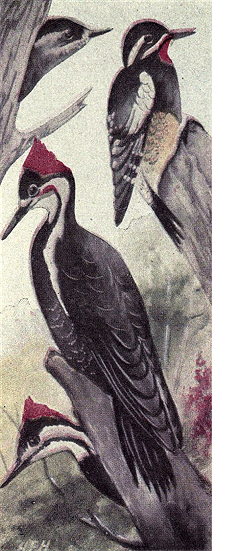
Williamson Sapsucker
Northern Pileated Woodpecker. 405a. Northern Pileated Woodpecker. Phlœotomus pileatus abieticola.
Range.--Local throughout North America,
from the northern parts of the United States
northward.
This variety is only very slightly larger
than the preceding, it otherwise being the
same. It is still abundant in many localities,
but its range is rapidly being reduced, on account
of cutting away the forests. Its nesting
habits and eggs are the same as those of the
southern variety.
406. Red-headed Woodpecker. Melanerpes erythrocephalus.
Range.--United States, east of the Rockies,
except New England; north to northern Canada;
winters in southern United States.
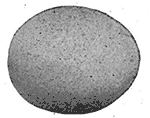
White. This beautiful species
has a bright red head,
neck and breast, glossy
blue black back, wings
and tail, and white underparts,
rump and secondaries.
It is the most abundant
of the family in the
greater portion of its
range, where it nests in
any kind of trees or in telegraph poles at any
height from the ground; they also sometimes
nest in holes under the eaves of buildings. They
are the most pugnacious of the Woodpeckers,
and are often seen chasing one another or driving
away some other bird.
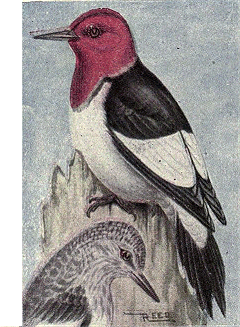
Red-headed Woodpecker. They are also known
to destroy the nests and eggs of many species,
and also to kill and devour the young, they
being the only Woodpecker, so far as known,
to have acquired this disreputable habit; they
also feed upon, besides ants and larvæ, many
kinds of fruit and berries. Their nesting season
is during May and June, when they lay
from four to eight white eggs, with less gloss
than those of the Flicker. Size 1.00 × .75.
407. Ant-eating Woodpecker. Melanerpes formicivorus formicivorus.
Range.--Mexican border of the United States,
southward.
This species may be identified by the black
region around the base of the bill, the white
forehead, red crown and nape, yellowish throat,
and blackish upper parts, extending in a band
across the breast, this variety having the band
streaked with white posteriorly. The habits of
this variety are the same as the next which is
most abundant in the United States.
|
|
|
Page 257
|
407a. California Woodpecker. Melanerpes formicivorus bairdi.
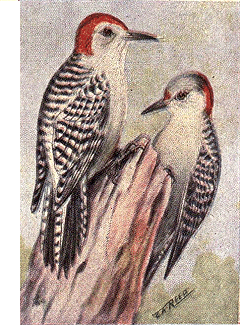
Red-bellied Woodpecker. Range.--California and Oregon.
This bird differs from the last in having fewer
white stripes in the black breast band. In
suitable localities, this is the most abundant of
Woodpeckers on the Pacific coast. They have
none of the bad habits of the Red-heads, appear
to be sociable among their kind, and are not
afraid of mankind. It nests indifferently in all
kinds of trees at any height from the ground,
laying from three to seven eggs. Size 1.00 ×
.75. This species has the habit of storing food
for future use developed to a greater extent
than any other of the family. They sometimes
completely honeycomb the exterior surface of
decayed trees, with holes designed to hold
acorns.
407b. Narrow-fronted Woodpecker. Melanerpes formicivorus angustifrons.
Range.--Southern Lower California.
This variety differs from the others in being slightly smaller and in having
the white band on the forehead narrower. Its nesting habits are the same, but
the eggs average smaller. Size .95 × .75.
408. Lewis's Woodpecker. Asyndesmus lewisi.
Range.--Western United States from the Rockies to the Pacific coast; from
British Columbia south to Mexico.

White. A very oddly colored species, 11 inches in length having
a dark red face, streaked red and white under
parts, a gray breast band, and glossy greenish black
upperparts. They are not uncommon in the greater
part of their range, can not be called shy birds, and
nest in all kinds of trees at heights varying from six to
one hundred feet from the ground, the five to nine white
eggs measuring 1.05 × .80, and being laid during May
or June.
409. Red-bellied Woodpecker. Centurus carolinus.
Range.--United States east of the Plains, breeding from the Gulf States north
in nearly all parts of their range, frequenting the more heavily timbered regions,
where they nest in any place that attracts their fancy; in some localities they
also commonly nest in telegraph poles. They are quite tame, and during the
winter months come about yards and houses, the same as, and often in company
with Downy Woodpeckers. Their eggs, which are laid during May, are glossy
white, average in size 1.00 × .75 and number from four to six.

|

|
Page 258

|
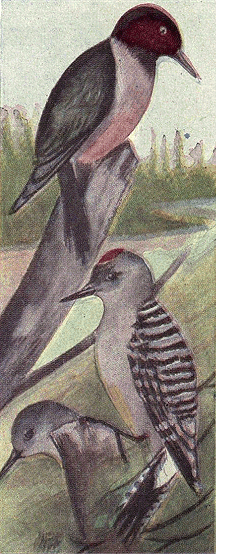
408--411. 410. Golden-fronted Woodpecker. Centurus aurifrons.
Range.--Mexico and southern Texas, resident.
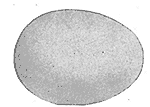
White. This is also one of the "zebra" or "ladder-backed"
Woodpeckers, having the back and
wings closely barred with black and white, the
same as the preceding; the forehead, nasal
tufts and nape are golden
yellow, and the
male has a patch of red
on the crown. This is
a very common resident
species in the Lower
Rio Grande Valley in
Texas, where it nests in
trees or telegraph poles,
sometimes so numerously
in the latter situations as to become a
nuisance. Their nesting habits are not in any
manner peculiar, and the eggs cannot be distinguished
from those of the preceding. Size
1.00 × .75. Laid during April and May.
411. Gila Woodpecker. Centurus uropygialis.
Range.--Mexican border of the United States,
in southern Arizona and New Mexico.
Like the preceding but without any yellow
on the head, the male having a red patch in
the center of the crown. They are locally distributed
in New Mexico, but appear to be abundant
in all parts of southern Arizona, where they
nest principally in giant cacti, but also in many other trees such as cotton-woods,
mesquite, sycamores, etc. Besides their decided preference for giant cacti,
there is nothing unusual in their nesting habits, and the eggs are not different
from those of others of the genus. They lay from three to six eggs in April or
May. Size 1.00 × .75.
412. Flicker. Colaptes auratus auratus.
Range.--Southeastern United States.

White. Flickers are well known, large Woodpeckers (13
inches long), with a brownish tone to the plumage, barred
on the back and spotted on the breast with black.
The present species has a golden yellow lining to the
wings and tail, and the shafts of the feathers are yellow;
it has a red crescent on the nape, and the male has black
moustache marks. This species and its sub-variety are
the most widely known Woodpeckers in eastern North
America, where they are known in different localities,
by something like a hundred local names, of which
|
|
|
Page 259
|
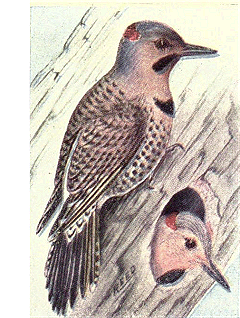
Northern Flicker. Pigeon Woodpecker and Yellow-hammer seem
to be the most universal. They have the undulating
flight common to all Woodpeckers and
show the white rump patch conspicuously when
flying. They are often found on the ground in
pastures or on side hills, feeding upon ants;
they are more terrestrial than any others of
the family. They nest anywhere, where they
can find or make a suitable cavity for the reception
of their eggs; in trees in woods or solitary
trees in large pastures, in apple trees in
orchards, in fence posts, in holes under the
roofs of buildings, etc. They ordinarily lay
from five to ten very glossy eggs, but it has
been found that they will continue laying, if
one egg is removed from the nest at a time,
until in one case seventy-one eggs were secured.
Fresh eggs may be found at any time from
May until August, as they frequently raise two
broods a season. Size of eggs, 1.10 × .90 with
considerable variations.
412a. Northern Flicker. Colaptes auratus luteus.
Range.--Whole of North America, east of the Rockies, except the southeastern
portion.
Averaging larger than the preceding, but individual specimens of the northern
variety are frequently found to be even smaller than the southern, and vice
versa, making the distinction one of the study rather than Nature.
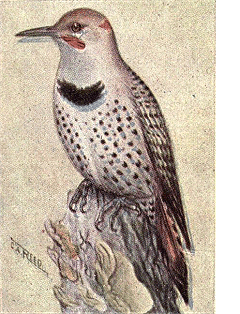
Red-shafted Flicker. 413. Red-shafted Flicker. Colaptes cafer collaris.
Range.--United States west of the Rockies.
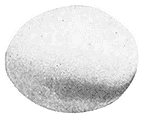
White. This species is marked similarly to the preceding,
but the top of the head is brownish instead
of gray, and the underparts of the wings
and tail, and their quills are reddish. Neither
sex has the red crescent
on the back of the head,
except in the case of hybrids
between the two
species, but the male has
red moustache marks.
There are no differences
in the nidification between
this species and
the preceding, but the
eggs of this average a trifle larger (1.15 × .90).
413a. Northwestern Flicker. Colaptes cafer saturatior.
Range.--Pacific coast, breeding from Oregon to Alaska.
This is a much darker variety of the Red-shafted Flicker, but its nesting habits
or eggs do not differ in any way.
|

|
|
Page 260
|
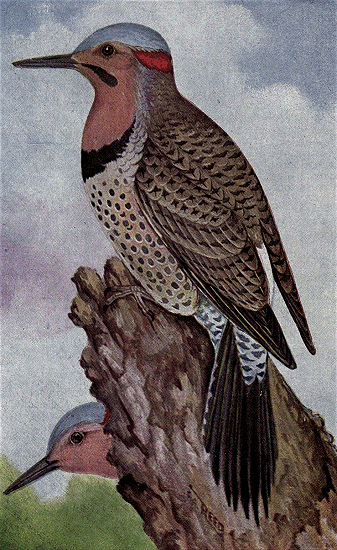
NORTHERN FLICKER.
|
|
|
Page 261
|
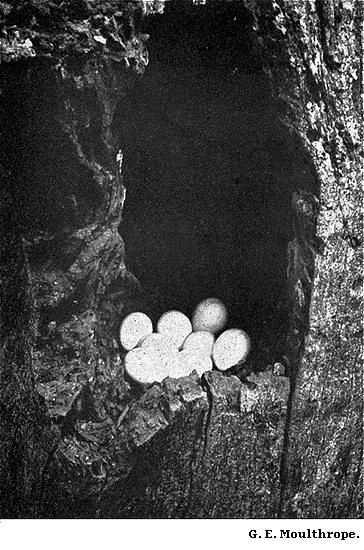
NEST AND EGGS OF NORTHERN FLICKER.
|
|
Page 262

|
414. Gilded Flicker. Colaptes chrysoides.
Range.--Arizona and southward through Mexico to southern Lower California.
This pale species has the yellowish lining to the wings and tail as in the
Flicker, but has a pale cinnamon brown crown, no crescent on back of head, and
the male has red moustache marks. It is a common species in all localities
where the giant cactus abounds, and shows a preference to nesting in these
strange growths, to any other trees. Their habits are, in all respects, the same
as those of the other Flickers and their eggs cannot be distinguished. Size
1.10 × .90.
414a. San Fernando Flicker. Colaptes chrysoides brunnescens.
Range.--Northern Lower California.
This is a slightly smaller and darker variety of the Gilded Flicker.
415. Guadalupe Flicker. Colaptes rufipileus.
Range.--Guadalupe Island.
Similar to the Red-shafted Flicker, but with the crown darker and the rump a
solid pinkish white. They are common in a large cypress grove in the middle
of the island, but rarely found on any other portions. The eggs have been described
by Mr. Walter E. Bryant, who found them breeding on the island, to be
indistinguishable from those of the others of the genus.

[Illustration z264.]
GOATSUCKERS, SWIFTS, AND HUMMINGBIRDS.
Order XVI. MACROCHIRES.
GOATSUCKERS, Family CAPRIMULGIDAE.
Goatsuckers are long winged birds, with small bills, but with an extraordinarily
large mouth, the opening of which extends beneath and beyond the eyes.
They are chiefly dusk or night fliers, their food consisting of insects which
they catch on the wing. Their plumage is mottled black, brownish and white,
resembling the ground upon which they lay their eggs.
|
|
|
Page 263
|
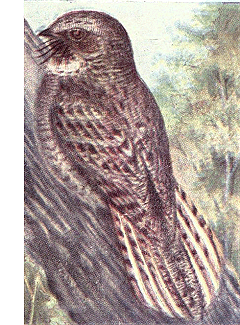
Chuck-will's-widow. 416. Chuck-will's-widow. Antrostomus carolinensis.
Range.--South Atlantic and Gulf States,
breeding north to Virginia and Indiana, and
west to Arkansas and eastern Texas.
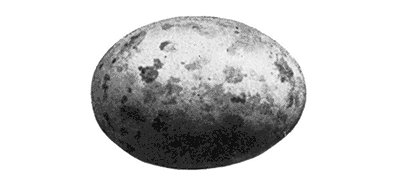
Grayish white. These birds are abundant summer residents
in the southern portions of their range, but as
they are silent and hiding in the woods during
the day time, they are not as popularly known
as are most birds. They rarely fly during the
day time unless disturbed from their roosting
place which is on the ground under underbrush
or in hollow logs. Their notes, which are a rapid and repeatedly uttered whistling
repetition of their name, are heard until late in the night. They nest during
April, May or June, laying two eggs on the ground amid the leaves in woods
or scrubby underbrush. The eggs are grayish to creamy white in color, handsomely
marked with shades of lilac, gray and brownish; size 1.40 × 1.00.
417. Whip-poor-will. Antrostomus vociferus vociferus.
Range.--North America east of the Plains; north to the southern parts of the
British possessions; winters along the Gulf coast and southward.
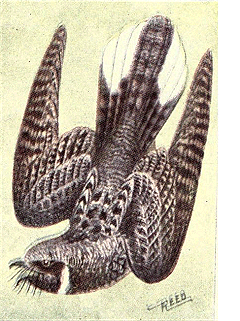
Whip-poor-will. This species is well known, by sound, in nearly all parts of its range, but
comparatively few ever observed the bird, and probably the greater number
mistake the Nighthawk for this species. The two species can readily be distinguished
at a distance by the absence of any pronounced white marking in
the wings, and by the white tips to the outer
tail feathers in the present species, while the
Night Hawk has a prominent white band across
the tail, but the top is black, and the tail slightly
forked.
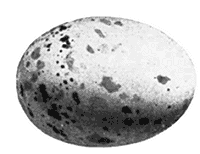
Creamy white. The Whip-poor-will, rarely leaves
its place of concealment before dark, and is
never seen flying about cities, as are the Nighthawks.
In their pursuit
of insects, they glide
like a shadow over
fields and woods, their
soft plumage giving
forth no sound as their
wings cleave the air.
Until late at night, their
whistling cry "whip-poor-will,"
repeated at
intervals, rings out in all wooded hilly districts.
Their two eggs are deposited on the
ground among dead leaves, generally in dense
woods. They are grayish white or cream color
marbled with pale brown and gray, with fainter
markings of lilac. Size 1.50 × .85.
|

|
Page 264

|

Merrill's Paraque.
Poor-will. 417a. Stephen's Whip-poor-will. Antrostomus vociferus macromystax.
Range.--Arizona and New Mexico, south
through the tableland of Mexico.
This sub-species is slightly larger and has
longer mouth bristles than the eastern bird.
Their nesting habits are the same and the eggs
differ only in averaging lighter in color, with
fainter markings, some specimens being almost
immaculate.
418. Poor-will. Phalænoptilus nuttalli nuttalli.
Range.--United States west of the Mississippi,
breeding from Kansas and northern California
northward to Montana and British Columbia.
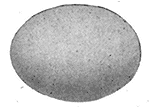
White. This handsome species
is the smallest of the family,
being under 8 inches
in length. Its plumage is mottled black, white and frosty
gray, harmoniously blended together. They can easily be
distinguished from all other Goatsuckers by their size and
silvery appearance. They nest on the ground, either placing
their two eggs upon a bed of leaves or upon a flat rock.
The breeding season is from the latter part of May through July. The eggs are
pure white and glossy; size 1.00 × .75.
418a. Frosted Poor-will. Phalænoptilus nuttalli nitidus.
Range.--Texas and Arizona, north to western Kansas.
This variety is like the last but paler, both above and below. Eggs indistinguishable
from those of others of the genus.
418b. Dusky Poor-will. Phalænoptilus nuttalli californicus.
Range.--A darker race found on the coast of California, having the same nesting
habits as the others.
The egg figured is of this species. Data.--Los Angeles, Cal., June 24, 1900.
2 eggs on the ground at the foot of an oak tree on the side of a hill. Collector,
F. M. Palmer.

|
|
|
Page 265
|
419. Merrill's Parauque. Nyctidromus albicollis merrilli.
Range.--Mexico, north to the Lower Rio Grande in southern Texas.

Salmon buff. This species is the same length as the Chuck-will's-widow, but is not as stoutly
built, and has a slightly longer tail. It can be distinguished
from any other of the family by its tail,
the outer feather on each side being black (or brownish
barred with black in the female), and the next
two having white ends for nearly half their length.
Their eggs are laid on the ground in open localities,
and generally under the protection of an overhanging
bush. They are two in number and differ greatly
from those of any other American member of this
family, being a buff or rich salmon buff in color, spotted
and splashed with gray, lavender, and reddish brown; size 1.25 × .90.
Data.--Brownsville, Texas, April 16, 1900. Eggs laid on the ground in a dense
thicket. Collector, Frank B. Armstrong.
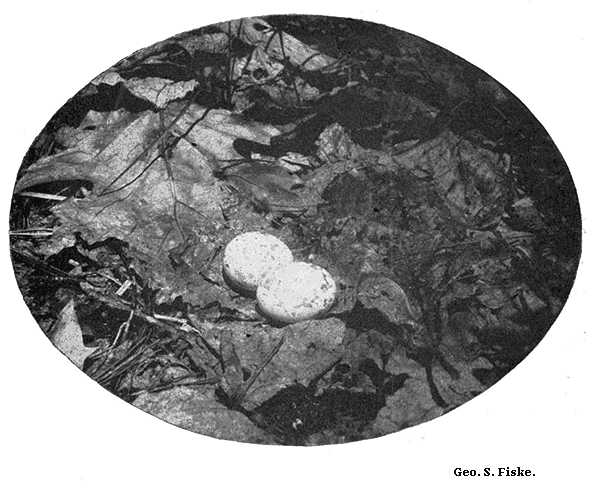
NEST AND EGGS OF WHIP-POOR-WILL.
|

|
Page 266

|
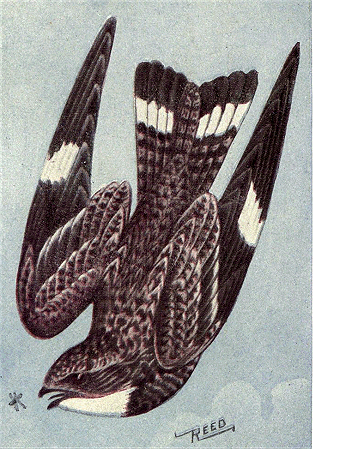
Nighthawk. 420. Nighthawk. Chordeiles virginianus virginianus.
Range.--North America,
east of the Plains and from
Labrador to the Gulf of Mexico;
winters through Mexico
to northern South America.
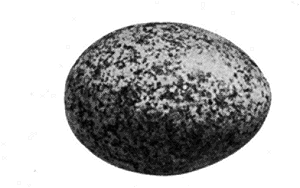
Grayish white. The Nighthawk or some of
its sub-species is found in
nearly all parts of North
America, its habits being the
same in all localities. It is
of the same size as the Whip-poor-will,
from which species
it can readily be distinguished
by its lack of mouth bristles,
forked tail with a white
band near the end, and the
white band across the primaries,
the latter mark showing
very plainly during flight. Besides
in the country, they are
very common in cities, where they will be seen any summer day towards dusk
flying, skimming, sailing, and swooping over the tops of the buildings, upon
the gravel roofs on which they often lay their eggs. They nest generally on
rocky hillsides or in open woods, laying their two eggs upon the top of a flat
rock. The eggs are a grayish white color, marbled, blotched and spotted with
darker shades of gray. Size 1.20 x .85.
420a. Western Nighthawk. Chordeiles virginianus henryi.
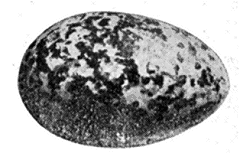
Grayish white. Range.--United States west of the Plains.
A similar bird to the preceding, but with plumage
somewhat more rusty. It frequents the more open
portions of the country in its range, its habits and
nesting habits being the same as others of the former
species; the eggs average a trifle lighter in color.
420b. Florida Nighthawk. Chordeiles virginianus chapmani.
Range.--A smaller and paler form found in Florida and along the Gulf coast.
No difference can be observed in the nesting habits of this as compared with the
northern form and the eggs are indistinguishable.
|
|
|
Page 267
|

NEST AND EGGS OF NIGHTHAWK.
|
|
Page 268

|
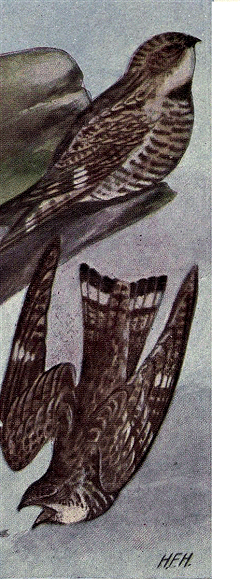
420-421. 420c. Sennett's Nighthawk. Cordeiles virginianus sennetti.
Range.--A very pale species with little or
no tawny; found in the Great Plains from
Texas north to the Saskatchewan; winters
south of the United States.
421. Texas Nighthawk. Chordeiles acutipennis texensis.
Range.--Mexico and Central America, breeding
north to southern Utah and California.
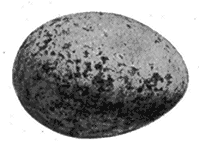
Grayish white.
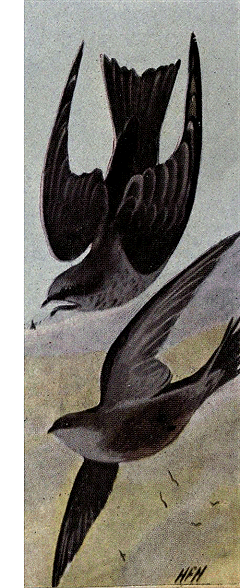
422-424. The pattern of the
marking of this species
is finer and more mottled
with rusty than
the Nighthawk. Its
habits do not differ to
any extent from those
of the preceding species;
they lay their two
mottled gray eggs upon
the bare ground, often on the dry sand and
in arid regions
where they are
exposed, with
no protection,
to the scorching
rays of the
sun. The eggs
vary endlessly
in extent of
markings, some
being very pale
and others
very dark gray,
mottled with
various shades
of gray, brown and lilac. Size 1.10 x .75.
SWIFTS.
Family MICROPODIDÆ
422. Black Swift. Cypseloides niger borealis.
Range.--Mountain ranges from Central America
north to British Columbia, locally distributed
throughout its range.
The plumage of this Swift is entirely sooty
black, darkest above; the tail is slightly forked
and is without spines; length of bird, 7 inches.
Although the general habits of this species are
well known, little is known of their nesting;
they are seen during the breeding season about
the higher ranges throughout their United
States habitat, and are supposed to nest in
crevices on the face of cliffs at a high altitude.
|
|
|
Page 269
|
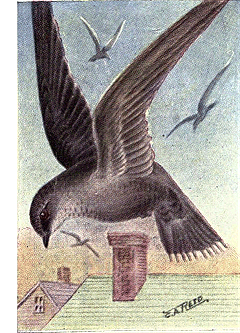
Chimney Swift. 423. Chimney Swift. Chætura pelagica.
Range.--North America east of the Plains,
breeding from central Canada, south to the Gulf
coast, and wintering south of our borders.
This well known species is sooty brownish
black, 5.5 inches long, and has the tail feathers
terminating in sharp spines. They are very
abundant in all portions of their range, and
may be seen on the wing at all hours of the
day, but especially abundant in the early morning
and toward dusk. They formerly dwelt
and bred only in hollow trees, and a great many
still continue to do so, as large hollow stumps
are known where hundreds nest every year.
The majority of the eastern Chimney Swifts
now nest in old chimneys that are unused, at
least during the summer; some small chimneys
contain but a single pair while other large ones
may have from fifty to a hundred or more nests
glued to the sides. The birds are on the wing
during the greater part of the day, generally
not frequenting the vicinity of their nesting
site, but returning toward dusk, when they may
be seen to, one at a time, dive headforemost into
the tops of chimneys.
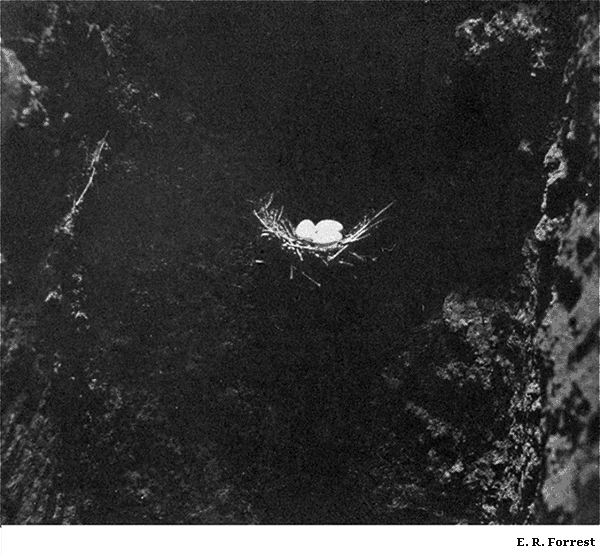
NEST AND EGGS OF CHIMNEY SWIFT.
|

|
Page 270

|
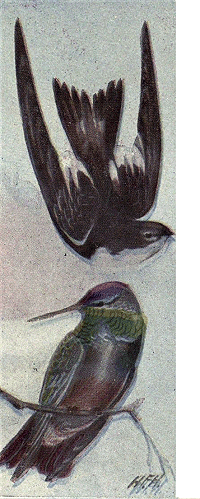
425--426. 
White. The nest
is made of small twigs firmly
glued to the sides of the chimney,
or tree, and to each other,
with the glutinous saliva of the
bird, making a narrow semi-circle
platform for the reception of
their three to five white eggs which are deposited
in May or June; size .75 × .50.
424. Vaux's Swift. Chætura vauxi.
Range.--Western United States, chiefly west of
the Rockies; breeding north to British Columbia,
and wintering south of the United States.
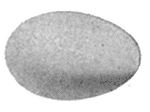
White. Similar to the last but smaller
(length 4.5 inches), and paler in
color, fading to white on the
throat. The habits of this species
are like those of the eastern
Chimney Swift, except that
the majority of these species still
continue to use hollow trees as
nesting places. The eggs are just like those of
the last bird.
425. White-throated Swift. Æronautes melanoleucus.
Range.--Western United States south of Canada,
and chiefly in the Rocky Mountains, and in
California ranges, north to Lat. 38°.

White. A handsome species, 6.5 inches in length, with blackish upper parts and sides,
and white throat, breast and central line of under parts, flank
patches and ends of secondaries; tail feathers not spined or
stiffened. These birds are fairly common in some localities
within their range, but appear to be found only on high ranges
or in their immediate vicinity. They nest in crevices and
caves in the face of cliffs, making a nest similar in construction
to that of the Chimney Swift but of weed stalks instead
of twigs, and lined with feathers. They lay four or five dull white eggs, during
June or July; size .85 × .50.
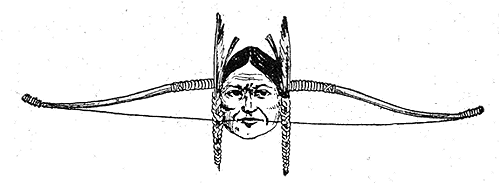
|
|
|
Page 271
|
HUMMINGBIRDS. Family TROCHILIDAE
Hummingbirds have been truly called "Winged Gems." They are the smallest
of birds, the usual plumage being a metallic green with throat or crown
patches of the brightest of iridescent shining red, orange, blue or
violet.
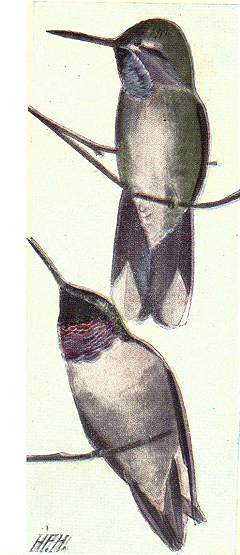
427--429. Their nests are marvels of architecture being compactly and intricately made of plant
fibres and downy feathers ornamented in some cases with lichens. Their flight
is accompanied by a peculiar buzzing sound produced by their rapidly vibrating
stiffened wing feathers. Their food is small
insects and honey both of which they get chiefly
from flowers.
426. Rivoli's Hummingbird. Eugenes fulgens.
Range.--Mexico, north in summer to southern
Arizona where they breed at high elevations
in the Huachuca Mountains.
This is one of the most gorgeous of the Hummers
having the crown a violet purple color,
and the throat brilliant green. This species
saddles its nest upon branches often at heights
of 20 or 30 feet from the ground. They are
made of plant down and generally decorated
with lichens on the outside, similar to nests of
the Ruby-throat. The two white eggs measure
.65 × .40.
427. Blue-throated Hummingbird. Cyanolæmus clemenciæ.
Range.--Mexico, north in summer to the
border of Arizona and western New Mexico.
This species is the largest of North American
Hummers being 5.25 inches long, this being
slightly larger than the preceding. As the
name implies, it has a patch of blue on the
throat, the upper parts being a uniform greenish;
the outer tail feathers are broadly tipped
with white. Their nests, which are placed upon
the limbs of trees, are made of mosses and
plant fibres covered with cobwebs. The two
eggs are laid during July and August, and
measure .65 × .40.

|

|
|
Page 272
|
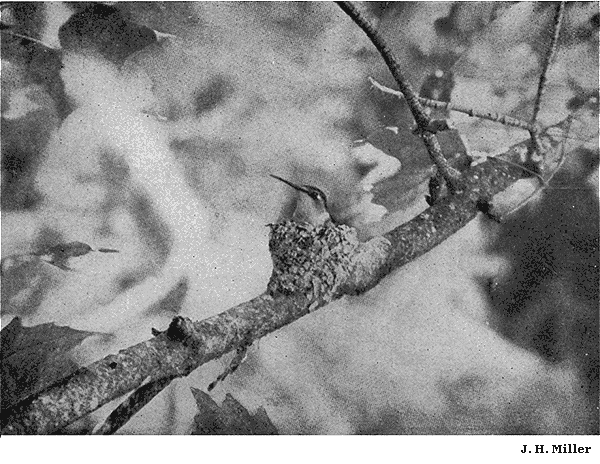
FEMALE RUBY-THROATED HUMMINGBIRD ON NEST.
|
|
|
Page 273
|
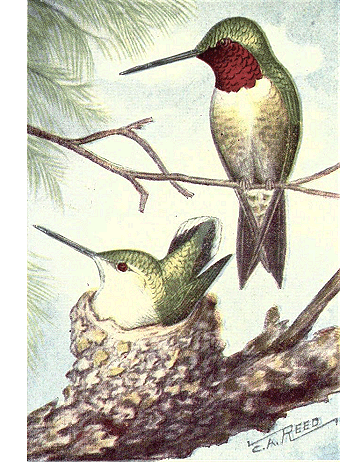
Ruby-throated Hummingbird. 428. Ruby-throated Hummingbird. Archilochus colubris.
Range.--North America east
of the Plains and north to
Labrador.
This is the only representative
of the family found
east of the Mississippi. It is
a small species, 3.5 inches
long, with greenish upper
parts and a bright ruby throat.
Its nest is as beautiful, if not
more so, than that of any
other species. They build
their nests on horizontal
limbs of trees at any height
from the ground, but usually
more than six feet. Branches
an inch or more in diameter
are usually selected, they not
being particular as to the
kind of tree, but oaks, pines
and maples perhaps being
used the most often. The
nests are made of plant fibres
and down, and the exterior is
completely covered with green
lichens so that it appears like
a small bunch of moss on the
limb. The two white eggs are
laid in May or June; size .50
× .35.
429. Black-chinned Hummingbird. Archilochus alexandri.
Range.--North America west of the Rocky Mountains; north to British Columbia;
winters south of the United States.
Similar in size and appearance to the Ruby-throat, but with the chin and
upper throat black, the
rest of the throat gorget
being violet or amethyst.
It is an abundant species
in summer in many localities,
especially in the southern
half of its range. They
build their nests at low elevations,
rarely above ten
feet, on small branches or
the fork at the end of a
limb. The nests are made
of yellowish plant fibres
and are not covered with
lichens, so that they have
a peculiar spongy appearance.
Eggs indistinguishable
from those of the
Ruby-throat. Laid during
April, May or June.
|

|
|
Page 274
|
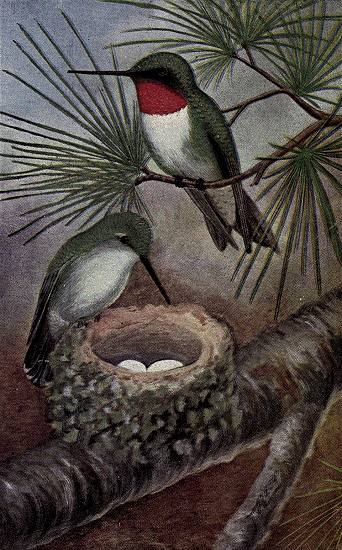
RUBY-THROATED HUMMINGBIRD.
|
|
|
Page 275
|
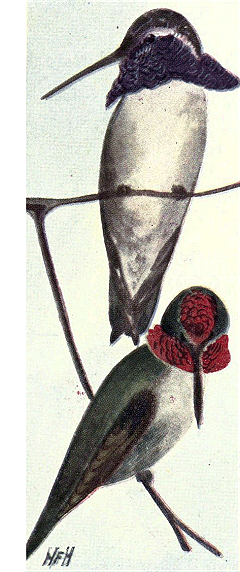
430--431. 430. Costa's Hummingbird. Calypte costæ.
Range.--Southwestern United States; north
to southern Utah; winters south of our border.
Smaller than the last and with both the
crown and the throat gorget, violet or amethyst,
the feathers on the sides of the latter being
lengthened. Their nests are situated in
the forks of branches generally near the ground,
and seldom above six feet from it. They are
made of plant down with shreds of weeds, bark
and lichens worked into the outside portions,
and are often lined with soft feathers. The
two eggs average .48 × .32. Data.--Arroyo Seco,
California, June 10, 1900. Nest in an alder bush.
Collector, Charles E. Groesbeck.
431. Anna's Hummingbird. Calypte anna.
Range.--Pacific coast of the United States
from northern California, southward, wintering
in Mexico and southern California.
This handsome species has both the crown
and the broadened and lengthened throat gorgets,
a purplish pink; it is slightly larger than
the Ruby-throat. They are very abundant in
their restricted range, and nest in February
and March and again in April or May, raising
two broods a season. Their nests are made of
plant down and covered on the outside with
cobwebs and a few lichens, and are generally
located at a low elevation. The white eggs
average .50 × .30. Data.--Santa Monica, California,
March 4, 1897. Nest in a bunch of seed
pods in a gum tree, ten feet from the ground.
Collector, Tom Bundy.
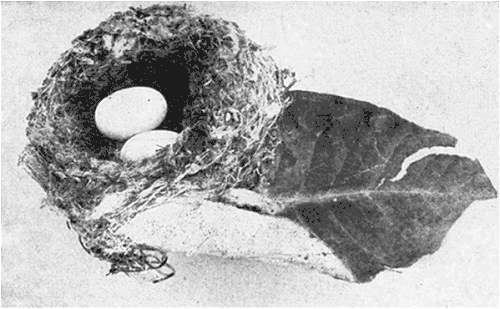
|

|
Page 276

|
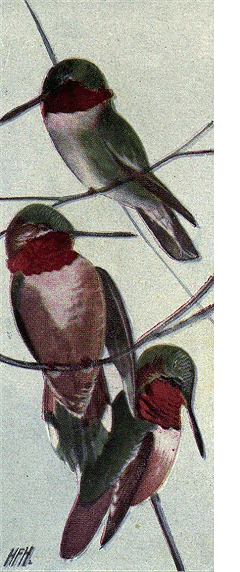
432--433--434. 432. Broad-tailed Hummingbird.
Selasphorus platycercus.
Range.--Rocky Mountain regions, north to
Wyoming; winters south of the United States.
This species is similar to the Ruby-throat,
but larger and with the back more golden
green color, and the throat shining lilac. They
are very abundant in Colorado and Arizona,
nesting as do the Ruby-throats in the east, and
their nests being similar in construction and
appearance to those of that species. The
eggs cannot be distinguished from those of
other species.
433. Rufous Hummingbird.
Selasphorus rufus.
Range.--Western North America, breeding
from the Mexican border north to Alaska and
fairly abundant in most of its range.
A handsome little species with the back and
tail reddish brown, and with a throat gorget of
orange red, the feathers being slightly lengthened
into a ruff on the side of the gorget. They
nest in a great variety of locations and at a
low elevation, such as vines, bushes and the
low hanging branches of trees. The nest is
made of vegetable fibres covered with cobwebs
and often with lichens. The eggs do not
differ from those of the other Hummers.
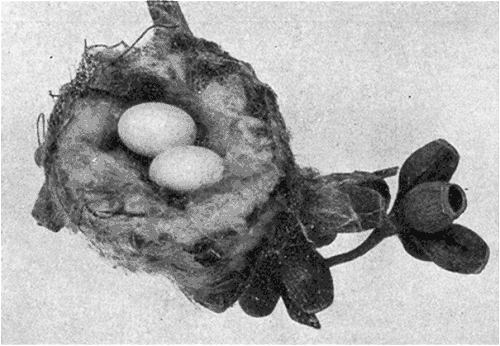
|
|
|
Page 277
|
434. Allen's Hummingbird. Selasphorus alleni.
Range.--Pacific coast from British Columbia southward; most abundant in
California. Winters in Mexico.
This species is like the last,
but the back is greenish, only
the tail being reddish brown.
These birds generally locate
their nests at low elevations
near the end of overhanging
branches, on vines, weed
stalks, or bushes, but have
been found as high as 90 feet
above ground. The nests of
this species are made of plant
fibres and cobwebs, generally
decorated with lichens. The
two white eggs measure .50 ×
.32. Data.--Santa Monica,
Cal., May 29, 1896. Nest two
feet from the ground in a
sage bush. Collector, W. Lee
Chambers.
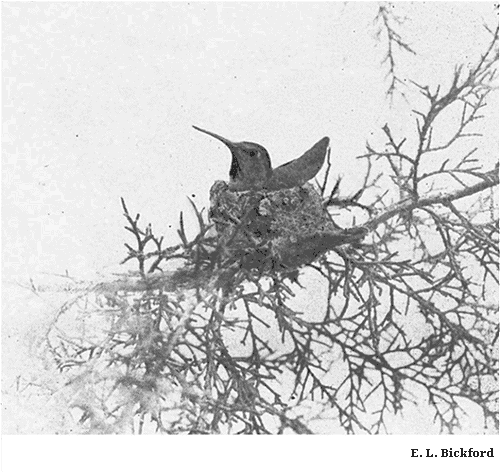
ANNA'S HUMMINGBIRD.
|

|
Page 278

|
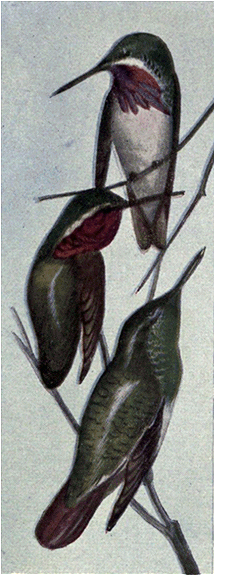
436--437--438. 435. Morcom's Hummingbird.
Atthis morcomi.
Range.--This species is known only from a
single specimen, taken in the Huachuca Mountains,
Arizona, in 1896.
436. Calliope Hummingbird.
Stellula calliope.
Range.--Western United States from British
Columbia southward, and from the Rocky
Mountains west to eastern Oregon and California.
This is the smallest of North American Hummers,
being but 3 inches in length. It is greenish
above and has a violet gorget showing the
white bases of the feathers. They build their
nests in all manner of locations from high up
in tall pines to within a foot of the ground in
slender bushes. The nests are made interiorly
with plant down, but the outside is generally
grayish colored shreds and lichens. The eggs
average but a trifle smaller than those of colubris,
.45 × .30.
437. Lucifer's Hummingbird.
Calothorax lucifer.
Range.--Mexico, north to southwestern Texas
and Arizona.
This species, which is common in parts of
Central Mexico, occurs only casually north to
our borders and has not yet been found nesting
there. They build small compact nests of plant
down attached to the stalks or leaves of plants
or weeds.
438. Reiffer's Hummingbird. Amizilis tzacatl.
Range.--Abundant in southern Mexico; casual in southern Texas.
This species is greenish above, with a bronzy lustre; the tail is reddish brown,
and the throat and breast are metallic green. They breed abundantly about
houses and nest apparently at all seasons of the year in Central America, where
they are the most common species of Hummers.

|
|
|
Page 279
|
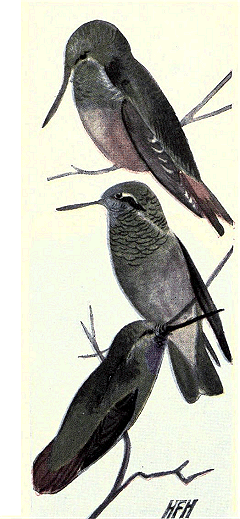
439--440.1--441. 439. Buff-bellied Hummingbird.
Amizilis cerviniventris chalconota.
Range.--Lower Rio Grande Valley in Texas
and southward through Mexico.
These birds are like the last but have the
underparts a pale brownish buff color. They
are quite common in their summer range in the
United States, nesting at a low elevation in
bushes and low trees. The two eggs are white,
.50 × .35. Data.--Brownsville, Texas, May 5,
1892. Nest of fine bark-like fibre on the outside,
lined with lint from thistle plant; located
on limb of small hackberry. Collector, Frank
G. Armstrong.
440. Xantus' Hummingbird.
Basilinna xantusi.
Range.--Southern Lower California.
A handsome species, greenish above, with a
coppery tinge and shading into reddish brown
on the tail; under parts buffy, throat metallic
green, and a broad white streak behind the eye.
They breed on the ranges making a similar
nest to those of other Hummers, placed on
weeds or bushes near the ground. The eggs
cannot be distinguished from those of the majority
of other species.
440.1. White-eared Hummingbird.
Basilinna leucotis.
Range.--A Central American and Mexican
species, casually found on the ranges in Southern
Arizona.
The plumage of this species is greenish above and below, being metallic green
on the breast; the forehead, sides of head, and throat are iridescent blue
and a white line extends back from the eye.
441. Broad-billed Hummingbird. Cynanthus latirostris.
Range.--Mountains of central Mexico north to southern Arizona and New
Mexico.
The throat of this species is a rich metallic blue; otherwise the plumage is
greenish above and below, being brighter and more irisdescent on the breast.
They are not uncommon on the ranges of southern Arizona, where they have
been found nesting in July and August, their nest not being unlike those of the
Rufous Hummer, but with the exterior largely composed of shreds of grayish
bark and lichens. Their eggs are like many others of the Hummers.

|

|
Page 280

|
PERCHING BIRDS. Order XVII. PASSERES
COTINGAS. Family COTINGIDAE
441.1. Xantus Becard. Platypsaris aglaiæ albiventris.
Range.--Mexico; north casually to the southern border of Arizona.
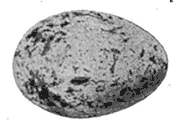
Buffy gray. This peculiar species is grayish above and lighter gray below, has dark slaty
crown, and a patch of rose color on the lower throat. This
is the only representative of this tropical family that has
been found as yet over the Mexican border, but its near
ally, the Rose-throated Becard has been found within a
very few miles and will doubtless be added to our fauna
as an accidental visitor ere long. Their nests are large
masses of grasses, weeds, strips of bark, etc., partially
suspended from the forks of branches. Their eggs number
four or five and are a pale buffy gray color, dotted and scratched with a pale
reddish brown and dark gray. Size .95 × .70. The one figured is from a set
in the collection of Mr. Crandall, taken June 1, 1897 at Presidio Sinaloa, Mexico.
FLYCATCHERS. Family TYRANNIDÆ
Flycatchers, which are found only in America and chiefly in the tropics, are
insect-eating birds, generally having a grayish colored plumage, sometimes
adorned with a slight crest or a coronal mark of orange, red, or yellow. Only
two of the species found in North America are gaudy in plumage, the Vermilion,
and the Derby Flycatchers. They all have the habit of sitting erect on a
dead twig, and watching for passing insects, which they catch on the wing.
442. Fork-tailed Flycatcher. Muscivora tryannus.
Range.--A Central and South American species accidentally having occurred
in the United States on several occasions.
This is a handsome black, white and gray species of the size and form of the
next.

|
|
|
Page 281
|
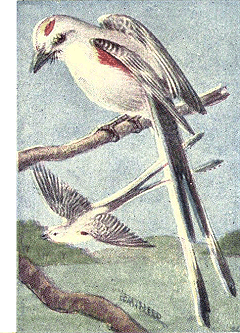
Scissor-tailed Flycatcher. 443. Scissor-tailed Flycatcher. Muscivora forficata.
Range.--Mexico, north through Texas to
southern Kansas; accidental in other parts of
the country.
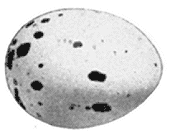
Creamy white. The Scissor-tail or "Texan Bird of Paradise"
is the most beautiful member of this interesting
family. Including its long tail, often 10
inches in length and forked for about 6 inches,
this Flycatcher reaches a
length of about 15 inches.
It is pale grayish above,
fading into whitish below,
and has scarlet linings to
the wings, and a scarlet
crown patch. They are
one of the most abundant
of the breeding birds in
Texas, placing their large
roughly built nests in all kinds of trees and at
any elevation, but averaging between ten and
fifteen feet above ground. The nests are built
of rootlets, grasses, weeds and trash of all
kinds, such as paper, rags, string, etc. The
interior is generally lined with plant fibres,
hair or wool. They lay from three to five, and rarely six eggs with a creamy
white ground color, more or less spotted and blotched with reddish brown, lilac
and gray, the markings generally being most numerous about the larger end.
They average in size about .90 × .67. Data.--Corpus Christi, Texas, May 18,
1899. 6 eggs. Nest of moss, vines, etc., on small trees in open woods near town.
Collector, Frank B. Armstrong.
444. Kingbird. Tyrannus tyrannus.
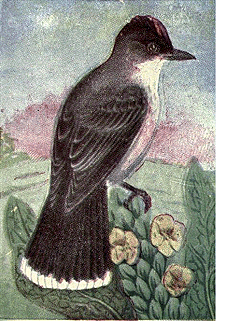
Kingbird. Range.--Temperate North America, breeding
from the Gulf of Mexico north to New Brunswick,
Manitoba and British Columbia; rare off
the Pacific coast.
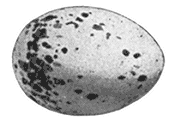
Cream color. This common Tyrant Flycatcher is very
abundant in the eastern parts of its range.
They are one of the most pugnacious and courageous
of birds attacking and driving away any
feathered creature to which they take a dislike,
regardless of size.
Before and during the
nesting season, their
sharp, nerve-racking clatter
is kept up all day long,
and with redoubled vigor
when anyone approaches
their nesting site. They
nest in any kind of a tree,
in fields or open woods, and at any height
from the ground, being found on fence rails
within two feet of the ground or in the tops of
pines 70 or 80 feet above the earth. Nearly
every orchard will be found to contain one or more pairs of these great insect
|

|
Page 282

|
destroyers; if more than one pair, there will be
continual warfare as often as one encroaches on the domains of the other. Their
nests are made of strips of vegetable fibre, weeds, etc., and lined with horsehair
or catkins. They are sometimes quite bulky and generally very substantially
made. The three to five eggs are laid the latter part of May, and are of a
creamy ground color splashed with reddish brown and lilac. Size .95 × .70.
Data.--Worcester County, Massachusetts, June 3, 1895. 4 eggs. Nest 10 feet
from the ground in an apple tree; made of fibres, string, rootlets and weeds,
lined with horse hair. Collector, F. C. Clark.
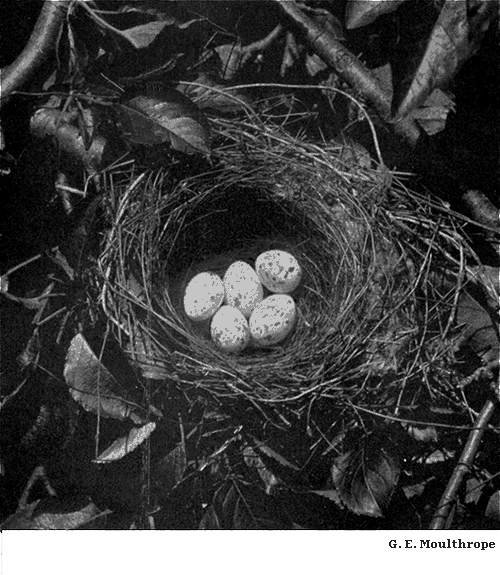
NEST AND EGGS OF KINGBIRD.
|
|
|
Page 283
|
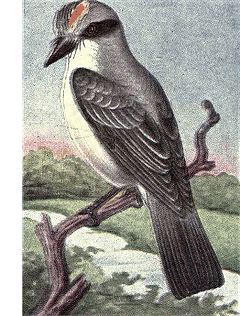
Gray Kingbird. 445. Gray Kingbird. Tyrannus dominicensis.
Range.--West Indies; north in April to Florida
and the South Atlantic States to South
Carolina and casually farther.
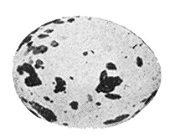
Creamy. This species is slightly larger than our Kingbird,
(9 inches long), grayish instead of dark
drab above, white below, and without any
white tip to tail. Like
the common Kingbird, it
has a concealed orange
patch on the crown. Their
habits and nesting habits
are the same as those of
our common bird, but the
nest is not generally as
well built, and nearly always
is made largely of
twigs. The three or four eggs have a creamy
or a creamy pink ground color, spotted and
blotched with dark brown and lilac, most numerously
about the large end. Size 1.00 × .73.
Tarpon Springs, Florida, May 28, 1802. Nest of twigs and weeds in a low bush.
Collector, J. A. Southley.
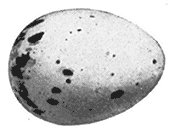
Buff. 446. Couch's Kingbird. Tyrannus melancholicus couchi.
Range.--Mexico, north in summer to southern Texas.
This species is very similar to the next but the throat
and breast are white, and the underparts a brighter yellow.
Like the other members of this genus, these build
their nests in any location in trees or bushes, making them
of twigs, weeds and moss. Their three or four eggs have
a creamy ground with a pinkish cast and are spotted
with brown and lilac. Size .97 × .12.
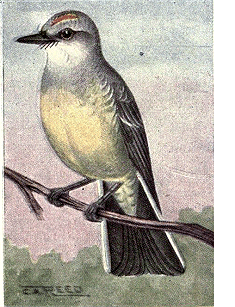
Arkansas Kingbird. 447. Arkansas Kingbird. Tyrannus verticalis.
Range.--Western United States and southern
British Provinces from Kansas and Minnesota
west to the Pacific.
This species has grayish upper parts, shading
into darker on the wings and tail, and
lighter on the throat and upper breast; the
underparts are yellow, and there is a concealed
patch of orange on the crown. They are very
abundant throughout the west, where they
have the same familiar habits of the eastern
species, nesting in all sorts of locations such as
would be used by the latter. Their nests are
made of plant fibres, weeds, string, paper or
any trash that may be handy, being sometimes
quite bulky. Their eggs do not differ in any
particular from those of the eastern bird, except
that they may average a little smaller.
Size .95 × .65.
|

|
Page 284

|

Derby Flycatcher. 448. Cassin's Kingbird. Tyrannus vociferans.
Range.--Western United
States from the Rocky Mountain
region to California, and
from Wyoming southward.

Buff. This species is like the last
except that the throat and
breast are darker. Their
habits, nesting habits and
eggs are indistinguishable
from those of the other Tyrant
Flycatchers, and they
are fully as courageous in the
defense of their homes
against either man or bird,
their notes resembling those
of the common Kingbird of
the east.
449. Derby Flycatcher. Pitangus sulphuratus derbianus.
Range.--Mexico and Central America, breeding north to southern Texas.
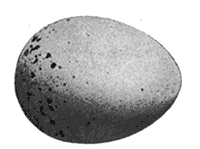
Creamy white. This handsome bird is the largest of the Flycatcher family found in the
United States, being 11 inches in length. It has a black crown enclosing a
yellow crown patch; a broad black stripe from the
bill, through the eye and around the back of the
head, is separated from the crown by a white forehead
and line over the eye; the throat is white
shading into yellow on the underparts. They are
abundant in the interior of Mexico, but can hardly
be classed as common over our border, where they
nest in limited numbers. Their nests are unlike
those of any of our other Flycatchers being large
masses of moss, weeds and grass, arched over on
top and with the entrance on the side. The three or four eggs are creamy white,
sprinkled chiefly about the large end with small reddish brown or umber spots;
size 1.15 × .85.

|
|
|
Page 285
|
451. Sulphur-bellied Flycatcher. Myiodynastes luteiventris.
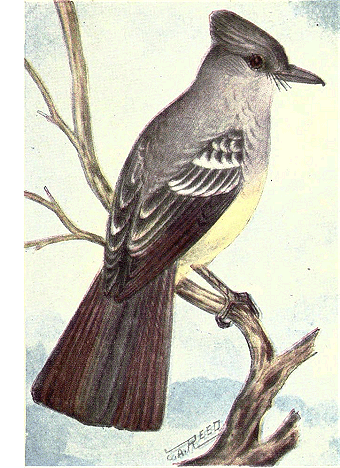
Crested Flycatcher. Range.--Mexico and Central
America, breeding north
to the Mexican border of Arizona.

Creamy buff. This peculiar Flycatcher,
which is unlike any other
American species, can only
be regarded as a rare breeding
bird in the Huachuca Mts.
It is 8 inches in length, has
a grayish back streaked with
black, the tail largely rusty
brown and the underparts sulphur
yellow, streaked on the
breast and sides with dusky;
a yellow crown patch is bordered
on either side by a stripe
of mottled dusky, and is separated
from the blackish
patch through the eye, by
white superciliary lines. Their
habits are similar to those of the genus Myiarchus, and, like them, they nest in
cavities in trees, and lay from three to five eggs of a creamy buff color thickly
spotted and blotched with brown and purplish, the markings not assuming the
scratchy appearance of the Crested Flycatchers, but looking more like those of
a Cardinal; size of egg 1.05 × .75. Data.--Huachuca Mts., Arizona, June 29, 1901.
4 eggs. Nest in the natural cavity of a live sycamore tree about fifty feet from
the ground; composed of twigs. Collector, O. W. Howard.
452. Crested Flycatcher. Myiarchus crinitus.
Range.--North America, east of the Plains, and from New Brunswick and
Manitoba southward; winters from the Gulf States southward.
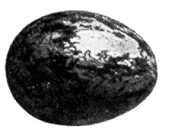
Buff. This trim and graceful, but quarrelsome, species is grayish
on the head, neck, and breast, shading to greenish on
the back and quite abruptly into bright yellow on the
underparts; the head is slightly crested and the inner webs
of all the lateral tail feathers are reddish brown. They
are abundant in most of their range but are generally shy
so they are not as often seen as many other more rare
birds. They nest in cavities of any kind of trees and at
any elevation from the ground, the nest being made of
twigs, weeds and trash, and generally having incorporated
into its make-up a piece of cast off snake skin. They lay from four to six
eggs of a buffy color, blotched and lined with dark brown and lavender.
Size .85 × .65.
|

|
Page 286

|
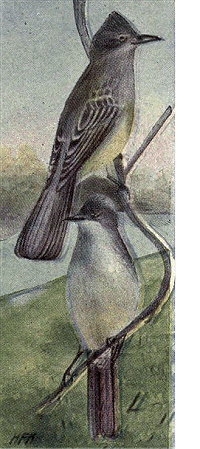
453--454. 453. Arizona Crested Flycatcher. Myiarchus magister magister.
Range.--Southern Arizona and New Mexico, south
through Mexico.
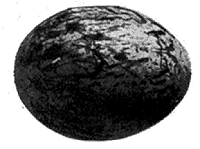
Pale buff. This bird is very similar to, but averages slightly larger
than the Mexican Flycatcher. Its nesting habits are
the same and the eggs cannot be distinguished from
those of the latter, the nest being most frequently found
in giant cacti.
453a. Mexican Crested Flycatcher. Myiarchus magister nelsoni.
Range.--Mexico, north to southern Texas.
This species is similar to the last
but is considerably paler. They are
common in some localities, nesting
in holes in trees or stumps, often
those deserted by Woodpeckers.
Their eggs are like those of the last
but average paler. Data.--Corpus
Christi, Texas, May 10, 1899. Nest
in hole in telegraph pole; made of
red cow hair, feathers and leaves. 4 eggs. Collector, Frank B. Armstrong.
454. Ash-throated Flycatcher. Myiarchus cinerascens cinerascens.
Range.--North America,
west of the Plains and
south of Canada.
Similar to the others of
the genus but grayish
brown above and with the
underparts much paler, the
throat and breast being
nearly white. Like the
others they nest in cavities
in trees, either natural
or ones made by Woodpeckers.
Their four to
five eggs are lighter in
color than those of crinitus
but cannot be distinguished
from those of
the Mexican Crested Flycatcher.
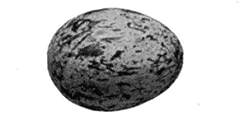
Buff. |
|
|
Page 287
|
454b. Lower California Flycatcher. Myiarchus cinerascens pertinax.
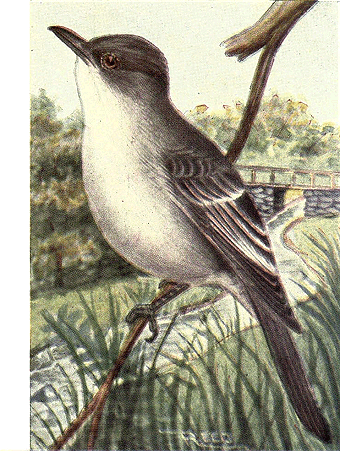
Phœbe. Range.--Lower California.
This sub-species is similar
to Nutting Flycatcher but paler
below and grayish above.
455a. Olivaceous Flycatcher. Myiarchus lawrencei olivascens.
Range.--Western Mexico,
north to southern Arizona.
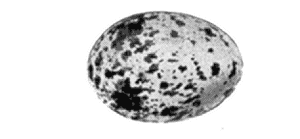
Buffy. This is the smallest of the
genus found in the United
States, being but 7 inches in
length. Except for size it is
similar to crinitus but with
very little, if any, rusty brown
on tail, except for a slight
edging on the outer web.
Their nesting sites are the
same as those chosen by the other Crested Flycatcher, but their eggs appear
to have but little of the scratchy appearance of the other members. They are
pale buffy, speckled and spotted with brown and lilac; size .80 × .60. Data.--Toluca,
Mexico, May 20, 1895. Nest of brown hair and feathers, in hole in tree
in woods. Collector, Fred T. Francis.
456. Phœbe.. Sayornis phœbe.
Range.--North America, east of the Rockies and north to Nova Scotia.
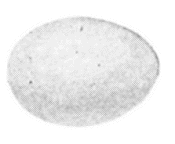
White. These very common, grayish colored birds are very often known as "Bridge
Birds" because of the frequency with which they construct their nests under
bridges and arches; they also build in crevices in ledges or
among the hanging roots near the tops of embankments, and on
the rafters or beams of old buildings. The nests are made of
mud, moss and grass, lined with feathers. The four or five eggs
measure .75 × .55. Occasionally, eggs will be found that have
a few minute spots of reddish brown. Freak situations in which
to locate their nests are often chosen by these birds, such as
the brake beam of a freight car, in the crevices of old wells, hen
houses, etc. The birds are one of the most useful that we have; being very
active and continually on the alert for insects and beetles that constitute their
whole bill of fare.
|

|
|
Page 288
|

PHOEBE ON NEST.
|
|
|
Page 289
|
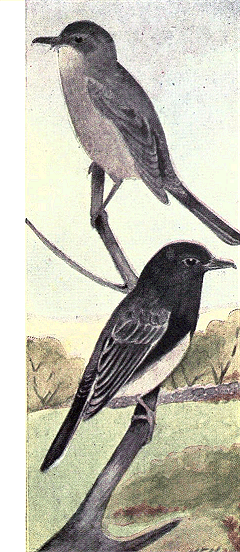
457-458. 457. Say's Phœbe. Sayornis sayus.
Range.--Western United States, breeding
from southern United States, north to the Arctic
regions, and from Kansas and Wisconsin
westward. Winters in Mexico.
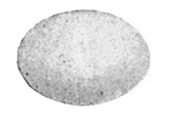
White. This bird is slightly larger than the last
(7.5 inches long), and is rusty brown color on
the belly and lower breast. Like the eastern
Phœbes they are one of the earliest birds to return
in the spring and are abundant in the
greater parts of their range.
Like the latter, they often
raise two broods a season,
one in April and another in
July. Their nests are generally
placed on narrow shelves
and crevices of ledges, but
they also nest as commonly about houses and
farms as does the eastern bird. The nests are
made of weeds, mosses, fibres and wool, and
are quite flat. They lay four or five white eggs.
Size .78 x .58.
458. Black Phœbe. Sayornis nigricans.
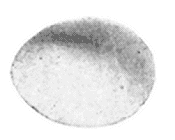
White. Range.--Mexico and north in summer into
the bordering States.
This species is of the size of the last but
is blackish (darkest on the head and breast),
with a white belly and under
tail coverts, the latter streaked
with dusky. Their habits
and nesting habits are the
same as those of the eastern
Phœbe, they building their
nests of mud, moss, weeds
and feathers on ledges or
about buildings, and generally close to or in the vicinity of water. They breed
during April or May, laying four or five white eggs which cannot be distinguished
from those of the common Phœbe. Size .75 x .55.
458a. Western Black Phœbe. Sayornis nigricans semiatra.
Range.--Pacific Coast of Mexico and the United States, breeding north to
Oregon.
This variety differs from the last in having the under tail coverts pure white.
Its nesting habits are precisely the same and the eggs indistinguishable.

|

|
Page 290

|

Olive-sided Flycatcher. 459. Olive-sided Flycatcher. Nuttallornis borealis.
Range.--Whole of North America, breeding
from the Middle States and California northward,
and in the Rockies, south to Mexico;
winters south of the United States.
These Flycatchers are nowhere abundant,
and in some parts of the country, especially
in the middle portion, they are
very rare.
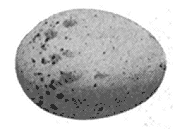
Creamy white. They breed very
locally and generally not
more than one pair in any locality.
In New England, I
have always found them nesting
in company with Parula
Warblers, in dead coniferous
swamps in which the
branches are covered with long pendant moss.
Their nests are placed high up in the trees,
generally above fifty feet from the ground, and
on small horizontal limbs; they are made of
small twigs and rootlets, lined with finer rootlets
and moss, and are very flat and shallow;
as they are generally made to match the surrounding,
they are one of the most difficult nests to find. They lay three or
four cream colored eggs which are spotted with reddish brown and lilac, chiefly
about the large end. Size .85 x .65. Data.--Lake Quinsigamond, Massachusetts,
June 12, 1897. Nest of twigs and moss, about 60 feet above the ground, in a
dead pine tree in center of a large wet swamp. Nest could not be seen from
the ground, and was found by watching the birds.
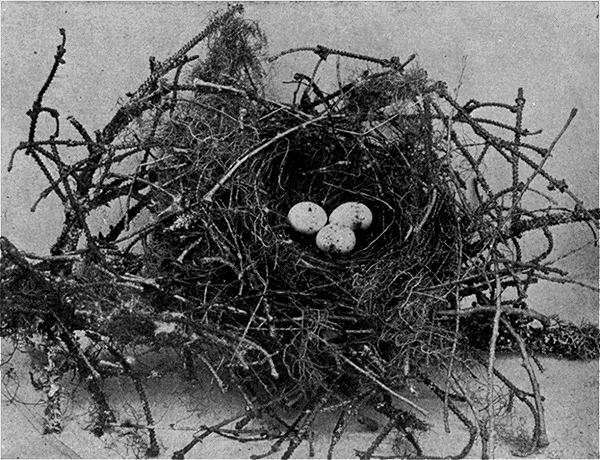
|
|
|
Page 291
|
460. Coues's Flycatcher. Myiochanes pertinax pallidiventris.
Range.--Western Mexico, breeding north to central Arizona.
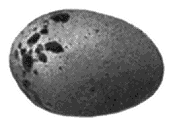
Cream color. This Flycatcher builds one of the most artistic nests created by feathered
creatures. It bears some resemblance on the exterior to that of the next species,
but it is much more firmly made, and the walls are usually
higher, making a very deeply cupped interior. The outside
of the nest is made of fibres, cobwebs, catkins, etc., firmly
felted together and ornamented with green lichens to match
the limb upon which it is saddled. The interior is heavily
lined with dried, yellowish grasses, making a very strong contrast
to the exterior. They are fairly abundant birds in the
ranges of southern Arizona, where they nest generally during
June. They lay three eggs of a rich creamy color, spotted and blotched, chiefly
about the larger end, with reddish brown and lilac gray. Size .95 x .61. Data.--Huachuca
Mts., Arizona, July 8, 1897. 3 eggs. Nest in a yellow pine about 60
feet up and near the extremity of a long slender limb. Elevation 7000 feet.
Collector, O. W. Howard.
461. Wood Pewee. Myiochanes virens.
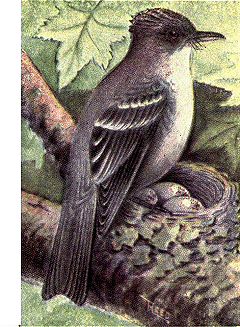
Wood Pewee. Range.--North America, east of the Plains
and north to the southern parts of the British
Provinces. Winters south of the United States.

Cream color. This is one of the best
known and one of the most
common frequenters of open
woods, where all summer
long its pleasing notes may
be heard, resembling "Pee-a-wee"
or sometimes only two
syllables "pee-wee." They
nest on horizontal limbs at elevations of six
feet or over, making handsome nests of plant
fibres and fine grasses, covered on the exterior
with lichens; they are quite shallow and very
much resembles a small knot on the limb of
the tree. They lay three or four eggs of a
cream color spotted in a wreath about the
large end, with reddish brown and lavender;
size .80 x .55. Data.--Torrington, Conn., June
16, 1890. Nest of fibres covered with lichens,
saddled on the branch of an oak tree near
roadside. Collector, John Gath.

Chickadee Family.
|

|
|
Page 292
|
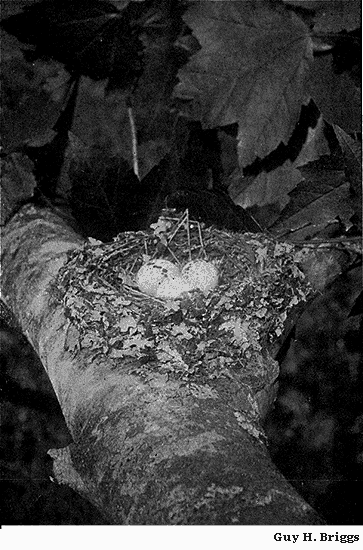
NEST AND EGGS OF WOOD PEWEE.
|
|
|
Page 293
|
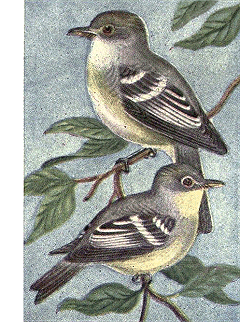
Yellow-bellied Flycatcher.
Acadian Flycatcher. 462. Western Wood Pewee. Myiochanes richardsoni richardsoni.
Range.--Western United States from the
Plains to the Pacific, and from Manitoba southward,
wintering south of the United States.
The nesting habits of this bird are the same
as those of the eastern Pewee, but their nests
are more strongly built and generally deeper,
and without the outside ornamentation of
lichens. They are saddled upon horizontal
branches, like those of the preceding, as a
rule, but are also said to have been found in
upright crotches like those of the Least Flycatcher.
Their three or four eggs cannot be
distinguished from those of the eastern Wood
Pewee.
462a. Large-billed Wood Pewee. Myiochanes richardsoni peninsulæ.
Range.--This species which differs from the
last only slightly, as is indicated by the name,
inhabits the peninsula of Lower California; its
nesting habits and eggs will not differ from those of the other Pewees.
463. Yellow-bellied Flycatcher. Empidonax flaviventris.
Range.--North America, east of the Plains and north to Labrador; winters
south of the United States.
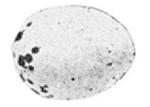
Creamy white. This species is slightly larger than the Least Flycatcher and is
more yellowish above and below, the breast being quite bright.
While common in some districts it is quite shy and frequents
thickly wooded regions, where it is not very often seen. They
nest near or on the ground among rocks or roots of fallen trees,
chiefly in swampy places; the nests are made in bunches of
moss, hollowed out and lined with very fine grasses. Their four
eggs are creamy or buffy white, spotted and speckled about the larger end with
reddish brown and gray; size .68 × .51.
464. Western Flycatcher. Empidonax difficilis difficilis.
Range.--Western North America, from the Rocky Mountain region to the
Pacific, and north to Alaska; winters chiefly south of the United States.
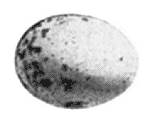
Creamy white. This Flycatcher, which is similar to the last, nests in similar
locations as well as in many others, such as crevices and fissures
in rocks, holes in banks, cavities in trees, rafters in buildings,
etc. The nests are variously made, but consist chiefly of fine
grasses, weeds and fibres. The eggs are as a rule similar to
those of the last species and cannot be distinguished.

|

|
Page 294

|
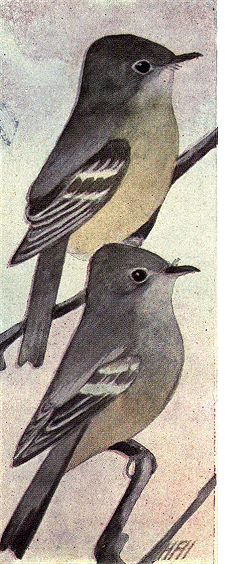
464--466. 464a. San Lucas Flycatcher. Empidonax difficilis cineritius.
Range.--Lower California.
This species is similar to, but duller in plumage
than the Western Flycatcher. Their nesting
habits do not probably vary from those of
the latter.
465. Acadian Flycatcher. Empidonax virescens.
Range.--Eastern United States, breeding
from the Gulf to southern New England, and
in the Mississippi Valley to Manitoba.
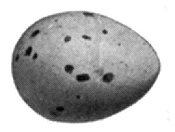
Buffy. This species is very pale below and greenish
yellow on the back. They are among the latest
of the migrants to reach our
borders and arrive in the
Middle States about the latter
part of May, when they
are quite common. They
build semi-pensile nests in
the forks of bushes or overhanging
branches at heights
of from four to twenty feet, the nests being
made of rootlets, fibres, fine grasses, etc., and
partially suspended from the branch; they are
quite shallow and loosely constructed and often
appear more like a bunch of debris deposited in
the fork by the wind than like the creation of
a bird. Their three or four eggs are buffy, spotted
or specked with brown; size .75 × .55.
466. Traill's Flycatcher. Empidonax trailli trailli.
Range.--Western North America, from the Mississippi Valley to the Pacific;
winters south of the United States.
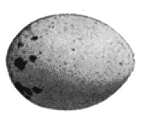
Creamy white. This species is very similar to the next, but the back is said
to be more brownish. They are common and nest abundantly
in thickets and low scrubby woods, usually placing the nest
at a low elevation, preferably in a clump of willows; the nests
are made of fine strips of bark, plant fibres, and very fine rootlets
being woven about and firmly fastened in upright
crotches. Their eggs, which are laid in June, are buffy white,
specked and spotted, chiefly at the large end, with brownish; size .70 × .54.

|
|
|
Page 295
|
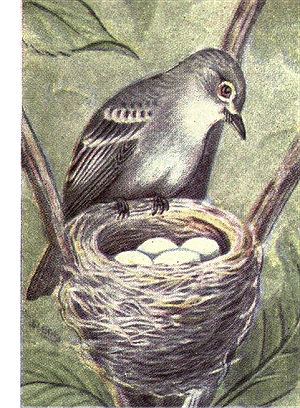
Least Flycatcher. 466a. Alder Flycatcher. Empidonax trailli alnorum.
Range.--United States, east of the Mississippi
and north to New Brunswick.
The only difference between this and the preceding
variety is in the more greenish upper
parts. They are quite abundant in the breeding
season from New England and northern
New York northward, frequenting, to a great
extent, alder thickets bordering streams. Their
nests and eggs do not differ appreciably from
those of the western variety of Traill Flycatcher.
467. Least Flycatcher. Empidonax minimus.
Range.--North America, east of the Rockies
and north to the interior of Canada, wintering
south of the United States.

White. These little birds (5.5 inches
long) are common about houses
and orchards on the outskirts of cities, and on the edges of forests
or open woods. They are very frequently known by the
name of Chebec from their continually uttered note. In nearly
all instances, the nests are placed in upright forks at elevations
varying from four to twenty-four feet from the ground. The
nests are made chiefly of plant fibres, fine grasses, string, cobwebs, etc., and
the three to five eggs are pale creamy white; size .65 × .50.
468. Hammond's Flycatcher. Empidonax hammondi.
Range.--North America, west of the Rockies and from British Columbia southward,
wintering south of the United States.
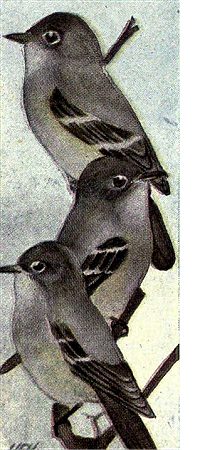
462--469--469.1. 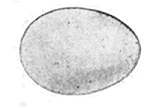
White. This western representative of the Least
Flycatcher is less abundant and more shy,
but has the same nesting habits as the eastern
birds, placing its nests either in upright
crotches or, more rarely, upon horizontal
branches at a low elevation. The eggs cannot
be distinguished from those of the last
species.
469. Wright's Flycatcher. Empidonax wrighti.
Range.--Western United States, breeding from the Mexican
border to Oregon and wintering south of the United
States.

White. A very similar bird to the last but whiter
below. It is a much more abundant species
than the last and is found breeding in open
woods and thickets on all the ranges. The
nests are built like those of the Least Flycatcher
and nearly always are found in
the crotch of trees or bushes at a low elevation;
their nests, like those of the two
preceding species, bear a strong resemblance to those of
the Yellow Warblers which are found in the same localities
and locations. The eggs are pale creamy white, four
in number and measure .68 × .52.
|

|
Page 296

|
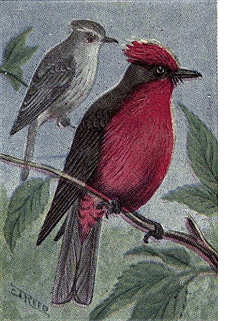
Vermillion Flycatcher. 469.1. Gray Flycatcher. Empidonax griseus.
Range.--Lower California, north to southern
California.
This is a slightly larger species than the preceding
and is grayish above and paler below,
with little or no tinge of brownish or yellow.
As far as I can learn its eggs have not yet been
taken.
470a. Buff-breasted Flycatcher. Empidonax fulvifrons pygmæus.
Range.--Western Mexico, north to southern
New Mexico and Arizona.
This small bird, which is but 4.75 inches in
length, is brownish gray above and brownish
buff below. It is not a common species anywhere,
but is known to nest during June or
July, on high mountain ranges, saddling its
nest of fibres, covered with lichens, on horizontal
boughs at quite an elevation from the
ground. The eggs are pale buffy white, unspotted, and measure .60 × .50.
471. Vermillion Flycatcher. Pyrocephalus rubinus mexicanus.
Range.--Mexico, north regularly to southern Texas, Arizona and New Mexico.
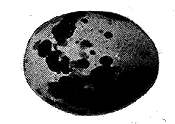
Buff. This is one of the most gaudy attired of all North American birds, being
brownish gray on the back, wings and tail, and having a bright vermillion crown,
crest and underparts. They are quite common in southern Texas, but far more
abundant in the southern parts of Arizona. Their habits do not
differ from those of other Flycatchers, they living almost exclusively
upon insects. The majority of their nests can not be distinguished
from those of the Wood Pewee, being covered with
lichens and saddled upon limbs in a similar manner, but some
lack the mossy ornamentation. Their three or four eggs are
buffy, boldly blotched with dark brown and lavender, chiefly in a wreath about
the middle of the egg; size .70 × .50. Data.--San Pedro River, Arizona, June 10,
1899. Nest in the fork of a willow about 20 feet above the stream. Collector,
O. W. Howard.
472. Beardless Flycatcher. Camptostoma imberbe.
Range.--Central America; north casually to the Lower Rio Grande in Texas.
This strange little Flycatcher, several specimens of which have been taken in
the vicinity of Lomita, Texas, is but 4.5 inches in length, grayish in color and
has a short bill, the upper mandible of which is curved. It has all the habits
peculiar to Flycatchers. Their eggs have not as yet been found as far as I can
learn.

|
|
|
Page 297
|
LARKS. Family ALAUDIDÆ
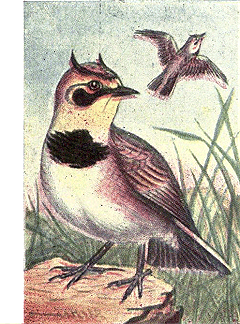
Horned Lark. 473. Skylark. Alauda arvensis.
Range.--Old World, straggling casually to
Greenland and Bermuda.
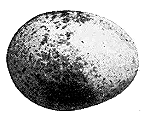
Grayish. This noted foreigner has been imported and
liberated a number of times in this country, but
apparently is not able to
thrive here, a fact which will
not cause much regret when
we remember the experiment
with the English Sparrow.
They are abundant in Europe
and Great Britain where they
nest on the ground in cultivated
fields or meadows, laying from three to
five grayish eggs, marked with brown, drab and
lavender.
474. Horned Lark. Otocoris alpestris alpestris.
Range.--Eastern North America, breeding in
Labrador and about Hudson Bay; winters in
eastern United States south to Carolina.
This variety of this much sub-divided species is 7.5 inches in length, has
brownish gray upper parts and is white below with black patches on the breast
and below the eye, yellowish throat and small black ear tufts. The various subspecies
are all marked alike, their distinction being based upon slight differences
in size, variations in the shade of the back, or the greater or less intensity
of the yellowish throat and superciliary stripe. The nesting habits of all the
varieties are the same and the eggs differ only in the shade of the ground color,
this variation among the eggs of the same variety being so great that an egg
cannot be identified without knowing the locality in which it was taken. The
present variety build their nests on the ground generally under tufts of grass
or in hollows in the moss which is found in their breeding range, making them
of dried grasses and generally lining them with feathers. The eggs are grayish
with a slight greenish tinge, and are specked and spotted over the whole surface
with drab, brownish and dark lavender. The eggs of this and the next
variety average considerably larger than those of the more southerly distributed
varieties; size .92 × .65.
474a. Pallid Horned Lark. Otocoris alpestris arcticola.
Range.--Breeds in Alaska and winters south to Oregon and Montana.
This is the largest of the Horned Larks and has the throat white, with no
trace of yellow. Its nest is built in similar locations and the eggs are like
those of the preceding species.

|

|
Page 298

|
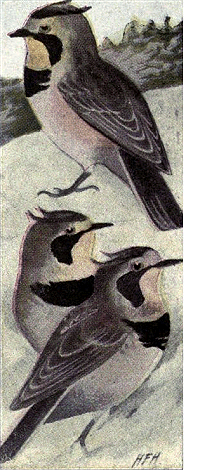
474c--474e--474f. 474b. Prairie Horned Lark. Otocoris alpestris praticola.
Range.--Breeds in the Mississippi Valley from Illinois
north to Manitoba and east to the Middle States; winters
south to Carolina and Texas.
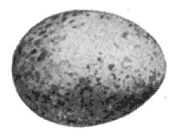
Olive buff. This sub-species is considerably smaller than the Horned
Lark, and the throat is paler yellow, while the line over
the eye and the forehead is white. They
are the most abundant and have the
most extended range of any of the better
known species. In the Mississippi Valley,
where they are of the most common
of the nesting birds, they build on the
ground in meadows or cultivated fields,
and very often in cornfields; the nests
are made of grasses and lined with horse hairs or feathers,
and placed in slight hollows generally under a tuft of grass
or sods. They raise two broods a season and sometimes
three, laying the first set of eggs in March and another in
June or July. The three or four eggs have an olive buff
ground and are thickly sprinkled with drab and lavender;
size .83 × .60.
474c. Desert Horned Lark. Otocoris alpestris leucolæma.
Range.--Plains of western United States, east of the Rockies and west of
Kansas and Dakota; breeds north to Alberta, and winters south to Mexico,
Texas and southern California.
This species is like praticola, but paler on the back; nest and eggs the same.
474d. Texas Horned Lark. Otocoris alpestris giraudi.
Range.--Coast of southeastern Texas.
A pale variety like leucolæma, but smaller; throat bright yellow, and breast
tinged with yellow. Nest and eggs like those of the others.
474e. California Horned Lark. Otocoris alpestris actia.
Range.--Lower California and southern California.
This bird is similar to the last but the yellow areas are brighter, and the
nape and back are ruddy.
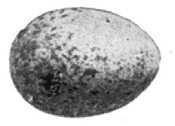
Olive buff. 474f. Ruddy Horned Lark. Otocoris alpestris rubea.
Ranges--Sacramento Valley, California.
This variety has the yellow areas brighter than in any other
and the back and nape are more ruddy. The eggs cannot be
distinguished from those of the others.

|
|
|
Page 299
|
474g. Streaked Horned Lark. Otocoris alpestris strigata.
Range.--Northwestern United States (Washington, Oregon and northern California).
Similar to the last, but with the back broadly streaked with black, the ruddy
less intense and the underparts tinged with yellowish.
474h. Scorched Horned Lark. Otocoris alpestris adusta.
Range.--Western Mexico, north in summer to southern Arizona.
This variety has the back and nape nearly a uniform pinkish ruddy with but
little streaking.
474i. Dusky Horned Lark. Otocoris alpestris merrilli.
Range.--Northwestern United States and southern British Columbia, wintering
south to central California.
Similar to praticola but slightly darker above.
474j. Sonora Horned Lark. Otocoris alpestris pallida.
Range.--Gulf coast of northern Lower California.
The upperparts of this variety are very pale pinkish brown.
474k. Hoyt's Horned Lark. Otocoris alpestris hoyti.
Range.--Interior of British America, west of Hudson Bay and east of Alaska,
south in winter in the interior of the United States to Kansas.
Much larger than the last; equal in size and similar to articola but with the
throat yellowish and the upperparts darker and brighter.
474l. Montezuma Horned Lark. Otocoris alpestris occidentalis.
Range.--Western New Mexico and eastern Arizona, south in winter to northern
Mexico.
This variety has the upperparts pale brownish and not streaked; throat and
forehead yellowish.
474m. Island Horned Lark. Otocoris alpestris insularis.
Range.--Santa Barbara Islands, California.
Similar to strigata but darker. With the exception of the three large varieties
of Horned Larks found north of our borders, neither the eggs nor, in most
cases, the birds can be identified without the precise location where they were
taken.

|

|
Page 300

|
CROWS, JAYS, MAGPIES, ETC. Family CORVIDÆ.
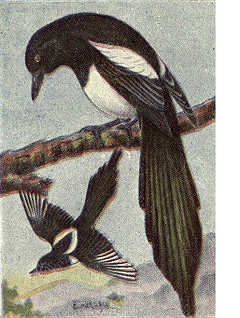
Magpie. 475. Magpie. Pica pica hudsonia.
Range.--Western North America from the
Great Plains to the Pacific and from Alaska
to Arizona and New Mexico.
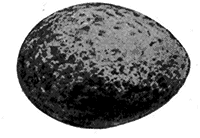
Grayish white. These large handsome birds have the entire
head, neck and breast velvety black, abruptly
defined against the
white underparts.
The back, wings and
tail are greenish or
bluish black, and the
scapulars, white;
length of bird 20
inches. They are well
known throughout
the west, where their
bold and thievish habits always excite comment.
They nest in bushes and trees at low
elevations from the ground, making a very
large nest of sticks, with an opening on the
side, and the interior is made of weeds and
mud, lined with fine grasses; these nests often
reach a diameter of three feet and are made of
quite large sticks. During April or May, they lay from four to eight grayish
white eggs, plentifully spotted with brown and drab. Size 1.25 x .90.
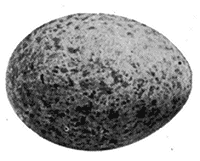
Grayish white. 476. Yellow-billed Magpie. Pica nuttalli.
Range.--Middle parts of California, west of the
Sierra Nevadas.
This species is slightly smaller than the last and
has a yellowish bill and lores, otherwise being precisely
like the more common species. Their habits
do not differ from those of the other, the nests are
the same and the eggs are indistinguishable. Size
1.25 x .88.

|
|
|
Page 301
|
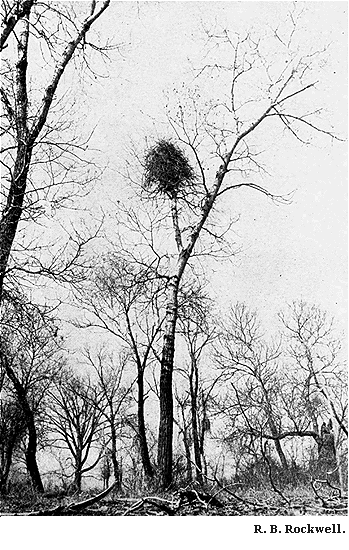
NEST OF AMERICAN MAGPIE.
|
|
|
Page 302
|

YOUNG BLUE JAYS.
|
|
|
Page 303
|

Blue Jay. 477. Blue Jay. Cyanocitta cristata cristata.
Range.--North America, east of the Plains
and north to Hudson Bay; resident and very
abundant in its United States range.
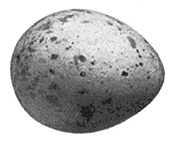
Greenish buff. These beautiful and
bold marauders are too
well known to need description,
suffice it to
say that they are the
most beautiful of North
American Jays; but beneath
their handsome
plumage beats a heart
as cruel and cunning as
that in any bird of prey. In the fall, winter
and spring, their food consists largely of
acorns, chestnuts, berries, seeds, grain, insects,
lizards, etc., but during the summer months
they destroy and devour a great many eggs and
young of the smaller birds, their taste for
which, being so great that they are known to
watch a nest until the full complement of eggs
is laid before making their theft. They nest
in open woods or clumps of trees, indifferently, in pines or young trees, building
most often below twenty feet from the ground; the nests are made of twigs
and rootlets, lined with fine rootlets. During May they lay from four to six
eggs of a greenish buff color spotted with olive brown. Size 1.10 x .80.
477a. Florida Blue Jay. Cyanocitta cristata florincola.
Range.--Florida and the Gulf coast.
The nesting habits and eggs of this smaller sub-species are the same as those
of the northern Blue Jay. Like our birds, they frequently nest near habitations.
478. Steller's Jay. Cyanocitta stelleri stelleri.
Range.--Pacific coast from southern California to Alaska; resident and breeding
throughout its range.
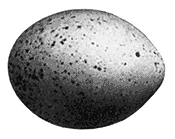
Greenish blue. All the members of this sub-species are similar in
plumage, having a sooty black head, crest and neck,
shading insensibly into dark bluish on the back and
underparts, and brighter blue on the wings and tail.
They usually have a few streaks or spots of pale blue on
the forehead. They are just as noisy, bold and thievish
as the eastern Jay and are also excellent mimics like
the latter. They nest in fir trees at any height from the
ground and in April or May deposit their three to six
greenish blue eggs which are spotted with various
shades of brown. Size 1.25 x .90. Their nests are more
bulky than those of the eastern Jay and are usually made of larger sticks and
held together with some mud.
478a. Blue-fronted Jay. Cyanocitta stelleri frontalis.
Range.--Coast ranges of California and Oregon.
The nesting habits and eggs of this variety are indistinguishable from those
of the preceding. The bird has more blue on the forehead.
478b. Long-crested Jay. Cyanocitta stelleri diademata.
Range.--Southern Rocky Mountains from Arizona to Wyoming.
No general difference can be found between the eggs of this species and the
Steller Jay, and the nests of each are constructed similarly and in like situations.
|

|
|
Page 304
|
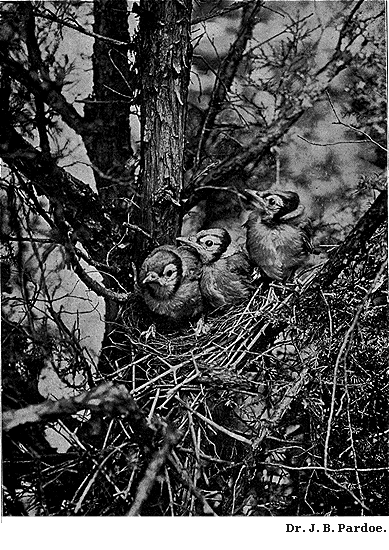
YOUNG BLUE JAYS.
|
|
|
Page 305
|
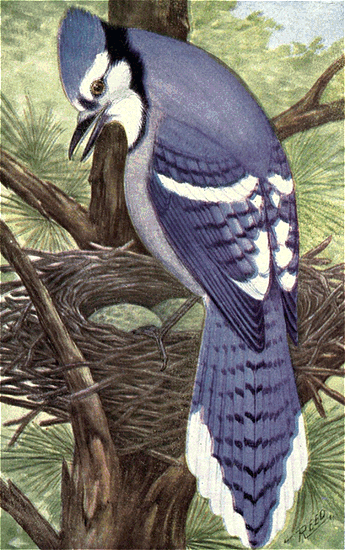
BLUE JAY.
|
|
Page 306

|
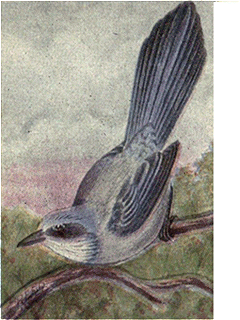
Florida Jay. 478c. Black-headed Jay. Cyanocitta stelleri annectens.
Range.--Northern Rocky Mountains from
northern Colorado to British Columbia.
The eggs of this sub-species cannot be identified
from those of the other varieties. Like
the others, their nests are made of sticks plastered
together with mud and lined with weeds
and rootlets.
478d. Queen Charlotte Jay. Cyanocitta stelleri carlottæ.
Range.--Queen Charlotte Islands, British
Columbia.
479. Florida Jay. Aphelocoma cyanea.
Range.--Locally distributed in Florida.
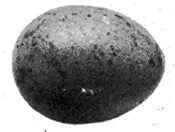
Greenish blue. All the birds of this genus have no crests or
decided markings, are white or grayish below,
and more or less intense blue above, with the back grayish
or brownish blue. This species is 11.5 inches long, has a
pale blue crown and a nearly white forehead. It has a very
limited distribution, being confined chiefly to the coast districts
of middle Florida, and very abundant in some localities
and rare in adjoining ones. They build shallow structures
of small sticks and weeds lined with fine rootlets and
placed at low elevations in bushes or scrubby trees. The
three or four eggs, which are laid in April or May are dull
greenish blue, marked with olive brown. Size 1.00 x .80. Data.--Titusville,
Fla., April 17, 1899. Nest of sticks in a scrub oak, five feet from the ground.
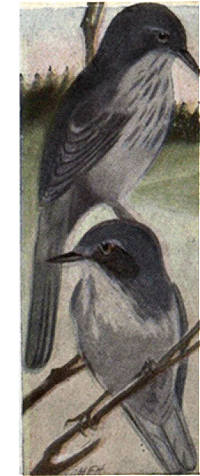
480-487. 480. Woodhouse's Jay. Aphelocoma woodhousei.
Range.--United States west of the Rockies and from
Oregon and Wyoming to Mexico.
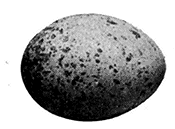
Bluish green. This species has the crown and forehead bluish, and
the underparts gray, streaked with bluish gray on the
breast. It is also larger than the last, being 12 inches
long. They are very abundant in
the Great Basin between the Rockies
and the Sierra Nevadas, breeding
during April or May in scrubby
trees or bushes at low elevations
and generally near streams. They
lay from three to five eggs of a
dull bluish green color, spotted
with umber and lilac gray. Size
1.08 x .80. Data.--Iron County, Utah,
May 3, 1897. 4 eggs. Nest of sticks and weeds in a small
pine tree.
|
|
|
Page 307
|
480.1. Blue-eared Jay. Aphelocoma cyanotis.

482--484a--485. Range.--Interior of Mexico north to the southern boundary
of Texas.
The nesting habits of this species are the same as those
of the others of the genus and the eggs are similar but
the markings are generally more prominent and larger.
Size 1.10 × .80.
480.2. Texas Jay. Aphelocoma texana.
Range.--Southeastern Texas.
It is not likely that the eggs of this species differ essentially
from those of many of the others.
481. California Jay. Aphelocoma californica californica.
Range.--Pacific coast of California and Washington.
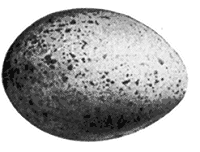
Bright bluish green. This is a very abundant species
both about habitations and in low
woodlands. They are very bold
and familiar, stealing everything
they may take a fancy to, and frequently
robbing smaller birds of
their eggs and young. They are said to be more tame
and familiar than the eastern Blue Jay, thereby bringing
their bad habits much more frequently to the attention
of the masses. They nest most often in bushes or
low trees, but not as a rule, far above the ground. Their eggs are a bright
bluish green color, speckled and spotted with brownish and lavender. Size
1.10 × .80.
481a. Xantus's Jay. Aphelocoma californica hypoleuca.
Range.--Lower California.
The habits and nests and eggs of this lighter colored variety do not differ
from those of the California Jay.
481b. Belding's Jay. Aphelocoma californica obscura.
Range.--San Pedro Martir Mts. Lower California.
A darker variety of the California Jay, whose nesting habits will not differ in
any essential particular.
481.1. Santa Cruz Jay. Aphelocoma insularis.
Range.--Santa Cruz Island, California.
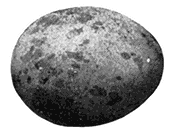
Greenish blue. This species is the largest and darkest colored bird
of the genus Aphelocoma. It is said to be a very abundant
species on the island from which it takes its name,
and to have the habits and traits common to all the
members of the Jay family. The nesting habits are
the same as those of the others, but the eggs are slightly
larger, averaging 1.15 × .85.
Set of three in the collection of John Lewis Childs, taken
by R. H. Beck on May 10, 1897.
482. Arizona Jay. Aphelocoma sieberi arizonæ.
Range.--Arizona and southwestern New Mexico south into Mexico.
|

|
Page 308

|
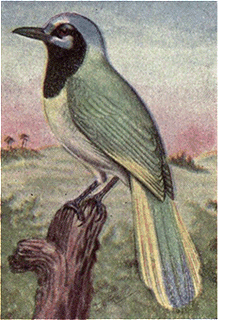
Green Jay. 482a. Couch's Jay. Aphelocoma sieberi couchi.
Range.--Eastern Mexico, north to western Texas.
483. Green Jay. Xanthoura luxuosa glaucescens.
Range.--Northeastern Mexico and the Lower
Rio Grande Valley in Texas.
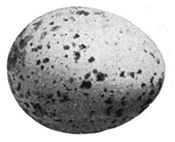
Grayish buff. This handsome species has a bright blue
crown and patches under
the eyes, the rest of the
upper parts being greenish;
throat and sides of
head black, underparts
greenish white. This gaudy
and noisy bird has all the
habits common to other
Jays including that of robbing
birds' nests. They
build generally in tangled
thickets or low bushes, placing their nests at a low elevation and making them
of twigs, weeds, moss, etc., lined with fine rootlets. Their four or five eggs,
which are laid during April or May, are grayish buff in color, spotted with
various shades of brown and lavender gray. Size 1.20 × .85.
484. Canada Jay. Perisoreus canadensis canadensis.
Range.--Southeastern British Provinces and the adjacent portions of the
United States; west to the Rockies.
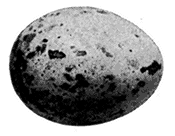
Grayish. 
Canada Jay. This is the bird that is well known to hunters of "big game" by various
names such as "Whiskey Jack", "Moose Bird", "Camp Robber", etc. During
the winter months, owing to the scarcity of food, their thieving
propensities are greatly enhanced and they
remove everything from the camps, which looks
as though it might be edible. Birds of this
genus are smoky gray
on the back and lighter
below, shading to white
on the throat; the forehead
and part of the
crown is white and the
nape blackish. Their
nests are placed at low
elevations in bushes or
fir trees, and are usually
very different from any of the preceding Jays'
nests. They are nearly as high as wide, and
are made of small twigs, moss, catkins, weeds
and feathers making a soft spongy mass which
is placed in an upright crotch. The eggs are
a yellowish gray color spotted and blotched with
brown and grayish. Size 1.15 × .80. Data.--Innisfail,
Alberta, March 12, 1903. Nest a beautiful
structure of twigs, moss and feathers in a
willow bush, 6 feet from the ground. The thermometer
registered 32 below zero the day the
eggs were taken. Collector, W. Blackwood.
|
|
|
Page 309
|
484a. Rocky Mountain Jay. Perisoreus canadensis capitalis.
Range.--Rocky Mountains from Montana to Arizona.
This variety has the whole crown white and only a small amount of blackish
on the nape. Its nesting habits and eggs are precisely like those of the last.
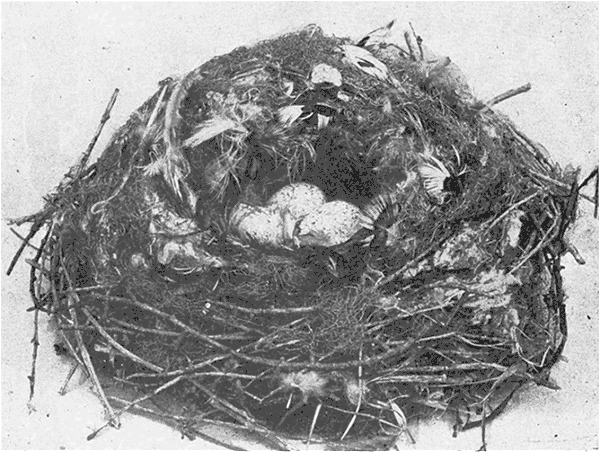
NEST AND EGGS OF CANADA JAY SHOWING CONSTRUCTION.
484b. Alaska Jay. Perisoreus canadensis fumifrons.
Range.--Alaska.
A very similar bird to the Canada Jay but with the forehead yellowish or
duller; the nests and eggs are like those of the others of the genus.
484c. Labrador Jay. Perisoreus canadensis nigricapillus.
Range.--Labrador.
This is a darker variety of the Canada Jay. Its eggs cannot be distinguished
from those of any of the others of the genus.
485. Oregon Jay. Perisoreus obscurus obscurus.
Range.--Mountain ranges from northern California to British Columbia.
These birds are very similar to canadensis but have the whole underparts
white. Like the Canada Jays they appear to be wholly fearless and pay little
or no attention to the presence of mankind. Their nesting habits and eggs
are the same as the preceding except that they have generally been found nesting
near the tops of tall fir trees. Size of eggs, 1.05 × .80.
|

|
|
Page 310
|
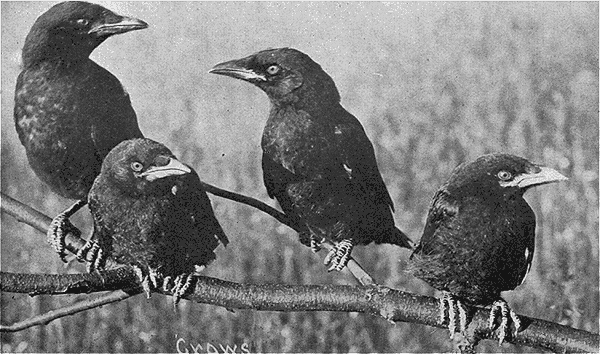
YOUNG CROWS
|
|
|
Page 311
|
485a. Gray Jay. Perisoreus obscurus griseus.
Range.--British Columbia to northern California, east of the coast ranges.
This bird is said to be larger and grayer than the preceding.
486. Raven. Corvus corax sinuatus.
Range.--North America west of the Rockies and from British Columbia
southward.
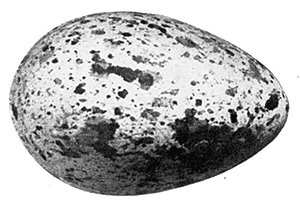
Pale greenish white. The Raven is like a very large Crow,
length 24 inches, but has the feathers
on the neck lengthened and stiffened.
Their habits are similar to those of the
Crow, but more dignified, and they
remain mated for life. Besides grasshoppers
and worms, they feed largely
upon animal matter such as lizards,
shell fish, frogs, eggs and young of
birds, and carrion. They nest on
ledges of high inaccessible cliffs or
the tops of tall trees, making large
nests of sticks lined with smaller ones
and hair or wool; the eggs are laid in
April or May, number from four to
seven, and are light greenish in color,
blotched with umber and drab. Size 1.95 × 1.25.
486a. Northern Raven. Corvus corax principalis.
Range.--Eastern North America chiefly north of the United States and northwest
to Alaska; south on some of the higher ranges to Georgia.
This variety is like the last but is larger. They are not nearly as abundant
as the western form and are very rare within the United States. A few pairs
still breed on some of the rocky islands off the coast of Maine; more off New
Brunswick and Newfoundland, and they are quite common on the cliffs of
Labrador and Alaska. Their nesting habits and eggs are like those of the last.
487. White-necked Raven. Corvus cryptoleucus.
Range.--Mexico and the border of the United States; north to eastern Kansas.
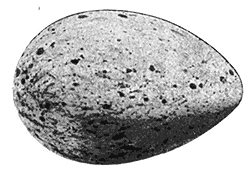
Pale bluish green. This small Raven is of about the size of
the Crow, and has the bases of the neck
feathers white. They are very abundant in
some localities, especially in southern Arizona.
Their food consists chiefly of animal
matter, the same as the large Ravens, and
they are not nearly as shy, frequently feeding
in camps upon refuse which is thrown
out to them. They build at low elevations
in any tree, but preferably in mesquites,
making their nests of sticks and lining them
with hair, leaves, bark, wool or anything
soft. During June they lay from four to six
pale bluish green eggs, generally sparingly spotted or scratched with dark
brown and drab. Size 1.75 × 1.20.
|

|
Page 312

|
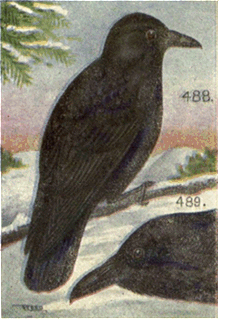
American Crow.
American Raven. 488. Crow. Corvus brachyrhynchos brachyrhynchos.
Range.--Whole of North America south of
the Arctic Circle; most abundant in eastern
United States; rare in many localities in the
west.
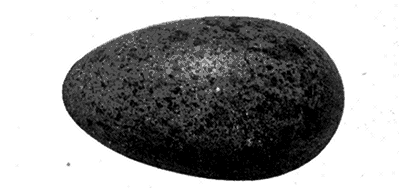
Greenish white. These birds, against which the hand of every
farmer is uplifted, are very shy and cunning;
as is well known, they nearly always post a
sentinel in some tree top to keep watch while
the rest of the flock is feeding in the field below.
In the fall and winter, large numbers of them flock, and at night all roost
in one piece of woods; some of the "crow roosts" are of vast extent and
contain thousands of individuals.
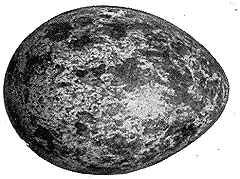
Bluish white. Crows nest
near the tops of large trees, preferably pines,
either in woods or single trees in fields. Their
nests are made of sticks and lined with rootlets,
and the eggs, which are laid in April or May,
range from four to seven in number, are a bluish
or greenish white, sparingly or very densely
speckled, spotted and blotched with various shades
of brown and lilac. Size 1.60 × 1.15.
488a. Florida Crow. Corvus brachyrhynchos pascuus.
Range.--Florida.
This variety has a slightly shorter tail and wings than the last.
490. Fish Crow. Corvus ossifragus.
Range.--Northwest coast from Oregon to Alaska.
This small Crow which is but 16 inches in length, is found only on the coast,
where they feed upon shell fish and offal. They nest, as do the Ravens, either
on ledges or in tree tops. The eggs resemble those of the common Crow, but
are smaller. Size 1.55 × 1.05.
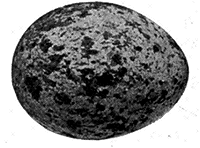
Bluish white. 489. Northwestern Crow. Corvus caurinus.
Range.--South Atlantic and Gulf coasts, north
in summer to Connecticut.
From Virginia southward, this small Crow
(length 16 inches) is more abundant on the coast
than the common Crow which is often in company
with this species. Their food consists of grain,
berries, and animal matter. Their nesting habits
are like those of the common Crow and the eggs
are similar and have as great variations, but are
smaller. Size 1.45 × 1.05.
|
|
|
Page 313
|
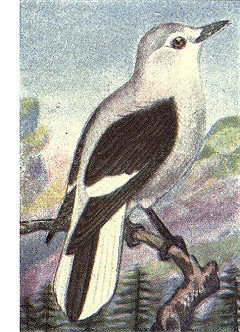
Clarke's Nutcracker. 491. Clarke's Nutcracker. Nucifraga columbiana.
Range.--Mountains of western North America
from Mexico to Alaska.
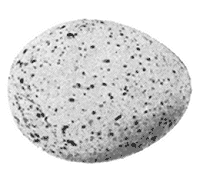
Grayish blue. The Clarke Crow, as this bird is often known,
is a common resident in most of its range. The
adults are grayish with black wings and central
tail feathers, the tips of the primaries and
outer tail feathers being
white. Their tail is short
and their flight slow and
somewhat undulating like
that of some of the Woodpeckers.
Their food consists
of anything edible
from seeds and larvæ in
the winter to insects, berries,
eggs and young birds
at other seasons. In the spring they retire to
the tops of ranges, nearly to the limit of trees,
where they build their large nests of sticks,
twigs, weeds, strips of bark, and fibres matted
together so as to form a soft round ball with a
deeply cupped interior; the nest is located at
from ten to forty feet from the ground in pine trees and the eggs are laid early
before the snow begins to leave. They are three in number, grayish in color
with a greenish tinge and finely spotted over the whole surface with dark
brown and lavender. Size 1.30 × .90. Data.--Salt Lake Co., Utah, April 25,
1900. Nest placed in pine 40 feet up on a horizontal branch, and not visible
from below. The tree was at the upper edge of a pine forest at an altitude of
about 3000 feet above Salt Lake City. The nest was discovered by seeing the
parent fly into the tree; the next day a nest was found with three young nearly
ready to fly. Collector, W. H. Parker. This set of three eggs is in the oological
collection of Mr. C. W. Crandall.
492. Pinon Jay. Cyanocephalus cyanocephalus.
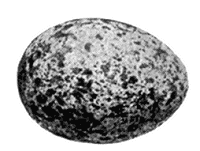
Bluish white. Range.--Western United States between the Rockies
and Sierra Nevadas, and from southern British Columbia
to Arizona.
This Crow-like Jay has a nearly uniform bluish plumage,
and is found abundantly in the pine belts of its
range. Their habits are similar to those of the Clarke
Crow and the nests are similarly built at lower elevations
in pines or junipers. During April or May they lay
from three to five eggs of a bluish white color specked
and spotted with brown. Size 1.20 × .85.

|

|
Page 314

|
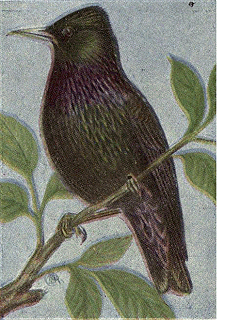
Starling. STARLINGS. Family STURNIDÆ
493. Starling. Sturnus vulgaris.
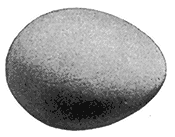
Bluish green. Range.--A European species which has casually
been taken in Greenland. It was liberated
a number of years ago in Central Park,
New York City, and has
now become abundant
there and is spreading
slowly in all directions.
They build their nests
in all sorts of locations
such as are used by the
English Sparrow, wherever
they can find a
sufficiently large crevice
or opening; less often they build their nests
in trees, making them of straw, twigs and
trash. They lay from four to six pale bluish
green eggs; size 1.15 × .85. Two broods are
reared in a season.
BLACKBIRDS, ORIOLES, ETC. Family ICTERIDÆ
494. Bobolink. Dolichonyx oryzivorus.
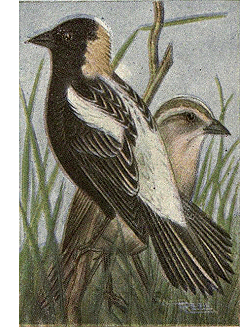
Bobolink. Range.--Eastern North America, breeding from New Jersey north to Nova
Scotia and Manitoba, and west to Utah and Nevada; winters in South America.
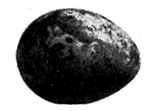
Grayish white. This black and white bird is well known in the east, where his sweet, wild
music, often uttered on the wing, is much admired.
He sings all day long during May and
June to his Sparrow-like mate, who is sitting
on her nest concealed in the
meadow grass. They are
quite sociable birds and several
pairs often nest in the
same field, generally a damp
meadow; the nests are hollows
in the ground, lined with
grass and frequently with the top slightly arched
to conceal the eggs, which are grayish white,
clouded, spotted and blotched with brownish,
gray and lilac; size .84 × .62. They number from
four to six and are laid in June.
495. Cowbird. Molothrus ater ater.
Range.--North America from the Atlantic
to eastern California, and from New Brunswick
and Manitoba southward; winters from the
southern half of the United States southward.
|
|
|
Page 315
|
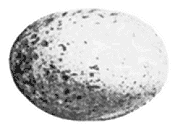
White. 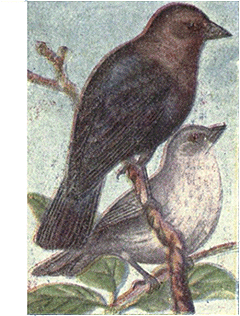
Cowbird. These uncivilized members of the bird world
build no nests for themselves, but slyly deposit
their egg in the nest of some other bird from
the size of a Robin down, probably the greater
number being in Warblers
and Sparrows nests; the
eggs are hatched and the
young cared for by the unfortunate
birds upon which
they are thrust. The eggs
are white, spotted and
speckled all over, more or
less strongly with brown and yellowish brown;
size .85 × .64.
495a. Dwarf Cowbird. Molothrus ater obscurus.
Range.--Southwestern United States and
Mexico, wintering south of our borders.
This variety is like the last, but slightly
smaller. The nesting habits of the two are
identical and the eggs are indistinguishable.
It is believed that Cowbirds do more damage to
the smaller birds than all other dangers combined,
as their young being larger and stronger
either crowd or smother the other young or else starve them by getting most
of the food brought to the nest.
496. Red-eyed Cowbird. Tangavius æneus involucratus.
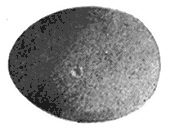
Light blue-green. Range.--Mexico; north in summer to the Lower Rio
Grande in Texas.
This parasite is larger than the Cowbird, being 9 inches
long, and is glossy black with brassy reflections on the
upper and under parts. They are abundant in southern
Texas where they deposit their eggs in the nests of other
birds, apparently preferring those of Orioles; their eggs
are pale bluish green, unmarked; size .90 × .70.
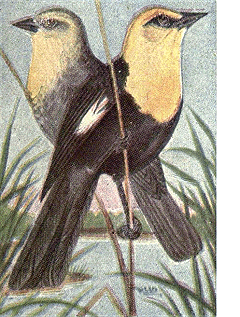
Yellow-headed Blackbird. 497. Yellow-headed Blackbird. Xanthocephalus xanthocephalus.
Range.--North America west of the Mississippi
to eastern California, breeding from the
southern parts of the United States north to
British Columbia and Hudson Bay and wintering
from southern United States downward.
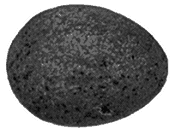
Grayish white. This large handsome
Blackbird with bright yellow
head and breast is
very abundant in some
parts of the west, where
they nest in large colonies
in sloughs and marshes,
being especially abundant
in the Dakotas and Manitoba.
The nests are made of strips of rushes,
skillfully woven together and attached to upright
cane near the surface of the water. They
lay from four to six eggs having a grayish
white ground color, finely specked and spotted
with shades of brown and gray; size 1.00 × .70.
|

|
Page 316

|
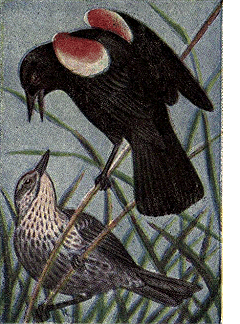
Red-winged Blackbird. 498. Red-winged Blackbird. Agelaius phœniceus phœniceus.
Range.--North America east of the Rockies
and from the southern British Provinces southward
to the Gulf; winter in southern United States.
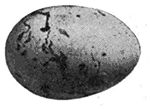
Bluish white. These birds are familiar
to every frequenter of the
country, in their range;
too familiar to many, for
the enormous flocks do
considerable damage to
grain fields in the fall.
They also do a great
amount of good at other
seasons in the destruction of injurious insects
and weed seed. They breed from April in the
southern parts of their range to May and June
in the northern, making their nests of grasses,
woven and twisted together and placing them
in bushes in swamps or over water, and sometimes
on the ground in clumps of grass. Their
eggs are from three to five in number, bluish
white boldly spotted, clouded or lined with blackish brown and purplish. Size
1.00 × .70. The nests and eggs of the numerous sub-species are all precisely the
same as those of this bird, so we will but enumerate the varieties and their
range. To identify these varieties other than by their ranges will require
micrometer calipers and the services of the men who separated them.
498a. Sonora Red-wing. Agelaius phœniceus sonoriensis.
Range.--A slightly larger variety found in southern United States.
498b. Bahama Red-wing. Agelaius phœniceus bryanti.
Range.--Bahamas and southern Florida.
This species has a slightly longer bill.
498c. Florida Red-wing. Agelaius phœniceus floridanus.
Range.--Florida and Gulf coast.
A smaller species with a longer bill.
498d. Thick-billed Red-wing. Agelaius phœniceus fortis.
Range.--Breeds in the interior of British America; in winter south through
the Plains to southwestern United States.
498e. San Diego Red-wing. Agelaius Phœniceus neutralis.
Range.--Great Basin between the Rockies and Sierra Nevadas, from British
Columbia to Mexico, wintering in the southern parts of its range.
498f. Northwestern Red-wing. Agelaius phœniceus caurinus.
Range.--Pacific coast from California to British Columbia.
|
|
|
Page 317
|
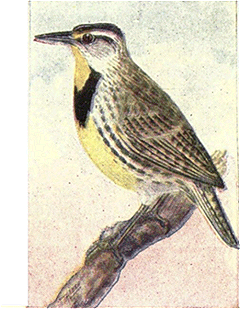
Meadowlark. 499. Bicolored Red-wing. Agelaius gubernator californicus.
Range.--Pacific coast, west of the Sierra
Nevadas, from Washington south to Lower
California.
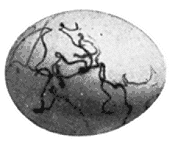
Dull bluish white. The males of this species
are distinguished from
those of the Red-wings by
the absence of light margins
to the orange red
shoulders. They are fairly
abundant in their restricted
localities, building their
nests in swamps about
ponds and streams. The
nests are like those of the Red-wings, and the
eggs are similar and with the same great variations
in markings, but average a trifle smaller;
size .95 × .67.
500. Tricolored Red-wing. Agelaius tricolor.
Range.--Pacific coast of California and Oregon; rare east
of the Sierra Nevadas.

Dull bluish white. This species differs from the Red-wing in having the
shoulders a much darker red and the median coverts white
instead of buffy. Like the last species they have a limited
range and are nowhere as common as are the Red-wings in
the east. Their nests are like those of the Red-wings and
the eggs are not distinguishable in their many variations,
but they appear to be more often lined than those of the
former.
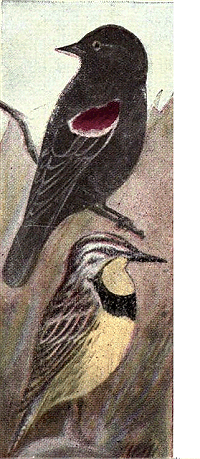
500--501.1. 501. Meadowlark. Sturnella magna magna.
Range.--North America east of the Plains and north to
Nova Scotia and Manitoba; winters from New England
southward.
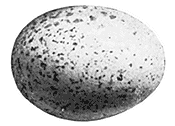
White. This handsome dweller among our fields and meadows is
frequently heard giving his high, pleasing, flute-like whistle
with its variations; his beautiful
yellow breast with its black
crescent is not so frequently
seen in life, for they are usually
quite shy birds. They artfully
conceal their nests on the ground
among the tall grass of meadows,
arching them over with dead
grass. During May or June they
lay from four to six white eggs,
speckled over the whole surface with reddish brown and
purplish; size 1.10 × .80.
501a. Rio Grande Meadowlark. Sturnella magna hoopesi.
Range.--A brighter and slightly smaller variety found
along the Mexican border.
|

|
|
Page 318
|

NEST AND EGGS OF MEADOWLARK.
|
|
|
Page 319
|

Audubon Oriole. 501.1. Western Meadowlark. Sturnella neglecta.
Range.--North America west of the Mississippi
and from Manitoba and British Columbia
southward, its range overlapping that of the
eastern Meadowlark in the Mississippi Valley,
but the two varieties appear not to intermingle.
This variety is paler than the eastern, but the
greatest point of difference is in the songs,
they being wholly unlike, and that of the western
bird much louder, sweeter and more varied
than the simple whistle of the eastern form.
The nesting habits of both varieties are the
same and the eggs indistinguishable.
501c. Southern Meadowlark. Sturnella magna argutula.
Range.--Florida and the Gulf coast.
A very similar bird to the northern form
but slightly smaller and darker. There is no
difference between the eggs of the two varieties.
503. Audubon's Oriole. Icterus melanocephalus auduboni.
Range.--Mexico and the Lower Rio Grande Valley in Texas.
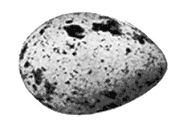
White. This large Oriole has a wholly black head, neck, fore breast, tail and wings;
it is 9.5 inches in length. They are quite abundant and
resident in southern Texas where they build at low elevations
in trees, preferably mesquites, making the nests of
woven grasses and hanging them from the small twigs of
the trees; the nests are more like those of the Orchard
Oriole and not long and pensile like those of the Baltimore.
The three to five eggs are grayish white, blotched, clouded,
spotted or streaked with brownish and purple. Size 1.00
x .70. Data.--Brownsville, Texas, April 6, 1897. 5 eggs.
Nest of threads from palmetto leaves, hanging from limb of mesquite, 10 feet
above ground in the open woods. Collector, Frank B. Armstrong.
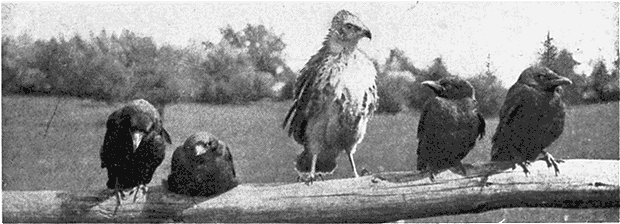
|

|
Page 320

|
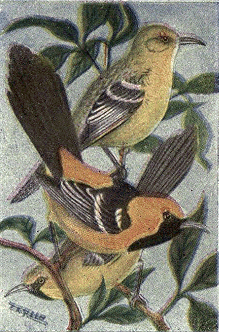
Hooded Oriole. 504. Scott's Oriole. Icterus parisorum.
Range.--Western Mexico north to the adjoining
states; north to Nevada.
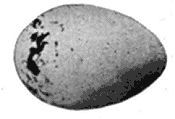
Bluish white. This handsome black
and yellow species does
not appear to be abundant
in any part of its range.
Their nests are swung
from the under side of
leaves of the yucca palm
or from small branches of
low trees, and are made of grass and fibres.
The eggs are bluish white, specked and blotched
chiefly about the large end with blackish
brown and lilac gray. Size .95 X .65. Data.--Chiricahua
Mts., Arizona, June 5, 1900. Nest
placed on the under side of a yucca palm leaf,
being hung from the spines, about 4 feet from
the ground. Altitude 7000 feet. Collector, O.
W. Howard.
505. Sennett's Oriole. Icterus cucullatus sennetti.
Range.--Mexico, north in summer to the Lower Rio Grande Valley in Texas.
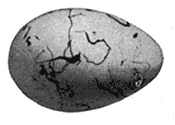
White. This species is orange yellow except for the face, throat,
fore back, wings and tail, which are black; the wings are
crossed by two white bars. These handsome birds are the
most abundant of the Orioles on the Lower Rio Grande,
where their pure mellow whistle is heard at frequent intervals
throughout the day. They generally build their nests
in hanging moss from mesquite trees, turning up at the
ends and lining the pocket with moss, or else make a
shallow hanging nest of fibres and suspend it from yuccas.
During May or June they lay from three to five eggs of a white color, spotted
(rarely lined) with purplish brown and gray. Size .85 × .60.
505a. Arizona Hooded Oriole. Icterus cucullatus nelsoni.
Range.--Western Mexico; in summer north to southern Arizona, New Mexico
and California.
This variety is like the last but more yellowish. Their nests are made of a
wiry grass compactly woven together and partially suspended to mistletoe twigs
growing from cottonwood trees; nests of this type are perfectly distinct from
those of the preceding, but when they are made of fibre and attached to yuccas,
they cannot be distinguished from nests of the former variety. Their eggs are
similar to those of the Hooded Oriole, but generally more strongly marked and
usually with some zigzag lines. Size .85 × .60.

|
|
|
Page 321
|
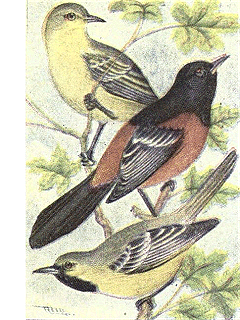
Arizona Hooded Oriole. 506. Orchard Oriole. Icterus spurius.
Range.--United States, east of the Plains,
breeding from the Gulf to southern New England,
and Canada in the interior. Winters beyond
our borders.
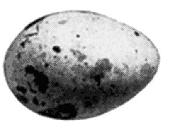
Bluish white. The adult male of this species
is a rich chocolate brown
and black, it requiring three
years to attain this plumage.
They nest commonly about
habitations in their range,
usually preferring orchard
trees for sites. Their nests
are skillfully woven baskets
of fresh grasses, about as high as wide; they
are generally placed in upright forks and well
concealed by drooping leaves. They lay from
four to six bluish white eggs, spotted and
blotched with brown and lavender. Size .80 ×
.55. Data.--Avery's Island, La., May 10, 1896.
Nest of grass, lined with thistledown; semi-pensile
in drooping twigs of a willow. Collector,
F. A. McIlhenny.
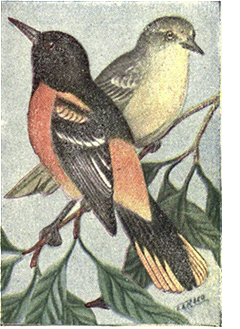
Baltimore Oriole. 507. Baltimore Oriole. Icterus galbula.
Range.--North America, east of the Rockies, breeding from southern United
States north to New Brunswick and Saskatchewan.

White. This beautiful and well known eastern Oriole
can readily be identified by its orange flame
color and entirely black head. Even better
known than the birds, are the pensile nests
which retain their positions on the swaying
drooping branches all
through the winter. Although
they build in
many other trees, elms
seem to be their favorites.
Their nests are
made of plant fibres and
frequently string, and
often reach a length of
about 10 inches and
about half that in diameter; they are usually
attached to drooping branches by the rim so
that they rock to and fro, but are sometimes
held more firmly in position by having their
side bound to a branch. Their eggs, which are
laid in May and June, are white, streaked and
lined with blackish brown and grayish. Size
.90 × .60.
|

|
Page 322

|

Rusty Blackbird
Brewster's Blackbird. 508. Bullock's Oriole. Icterus bullocki.
Range.--North America, west of the Plains
and from British Columbia southward, wintering
in Mexico.
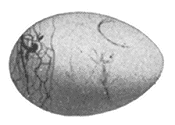
Bluish white. This handsome species
is as abundant in the west
as the Baltimore Oriole is
in the east, and breeds
throughout its United
States range. Their nests
are similarly made and in
similar locations, and the
eggs are hardly distinguishable
from those of the preceding, but the
ground color is generally of a pale bluish white
tint and the markings are usually finer, the
lines running around the eggs and often making
a very handsome wreath about the large
end. Size of eggs, .94 × .62.
509. Rusty Blackbird. Euphagus carolinus.
Range.--North America east of the Plains, breeding from northern New England
and the Adirondacks northward; winters in southern United States.
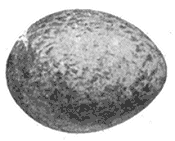
Bluish green. But few of these birds breed within our borders, the majority
of them passing on to the interior of Canada. They
generally nest in pairs, or at the most three or four pairs
in a locality, building their large substantial nests of moss,
twigs and grass, lined with fine green grass; this structure
is situated in bushes or low trees in swampy places and at
from 3 to 20 feet from the ground. The eggs are laid in
May or June; they vary from three to five in number, of a
pale bluish green color, spotted, blotched and clouded with
shades of brown and gray. Size .96 × .71.
510. Brewer's Blackbird. Euphagus cyanocephalus.
Range.--North America west of the Plains, and from British Columbia and
Saskatchewan southward.

Dull white. This western representative of the preceding is of about
the same size (10 inches long), but differs in having a
purplish head and greenish black body. They nest abundantly
throughout their range either in bushes or trees at
low elevations or upon the ground; the nests are made of
sticks, rootlets and grasses, lined with finer grass and
moss, and the eggs, which are very variable, are dull
whitish, clouded and blotched with brownish and streaked
with blackish. Size 1.00 × .75.

|
|
|
Page 323
|

Purple Grackle.
Bronzed Grackle. 511. Purple Grackle. Quiscalus quiscula quiscula.
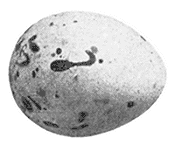
Dull greenish white. Range.--Eastern United States from the Gulf
to Massachusetts; winters along the Gulf.
This species, which is
commonly known as Crow
Blackbird, nests in trees
or bushes anywhere in its
range, and on the coast
frequently constructs its
nests among the large
sticks of Ospery nests.
Large pines appear to be
favorite sites for them to
locate their large nests of twigs, weeds, grass
and trash. They are placed at any elevation
from nearly on the ground to 50 feet above it.
The eggs range from three to five and are
greenish white, splashed, spotted and scrawled
with various shades of brown and gray, and
with streaks of black. Size 1.10 × .80. The
nesting habits and eggs of the sub-species of
this Grackle do not differ in any particular. Like those of this variety the eggs
show an endless number of patterns of markings.

Grayish white. 511a. Florida Grackle. Quiscalus quiscula aglæus.
Range.--South Atlantic and Gulf States.
A smaller variety of the preceding; length about 11
inches. Eggs indistinguishable.
511b. Bronzed Grackle. Quiscalus quiscula æneus.
Range.--North America east of the Rockies, breeding
from the Gulf to Hudson Bay and Labrador. Winters
in the southern parts of the United States. This is the most common and
widely distributed of the Crow Blackbirds and is distinguished by the brassy
color of the upper parts.
513. Boat-tailed Grackle. Megaquiscalus major major.
Range.--South Atlantic and Gulf States; north to Virginia.
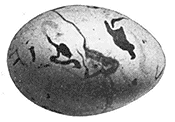
Grayish white. This handsome bird measures about 16 inches in
length, is iridescent with purplish and greenish, and
has a very long, graduated and hollowed tail. These
Grackles are very abundant residents along the Gulf,
breeding in large colonies in swamps, placing their
nests of weeds, moss, grasses, etc., in bushes, trees,
canes or rushes, but a few inches above the water, while
those in trees are sometimes 50 feet above the ground.
The eggs are laid in March, April or May, are from
three to five in number, and are a dull bluish or grayish
white, streaked, lined, clouded and blotched with brown, black and gray; size
1.25 × .95.
|

|
Page 324

|
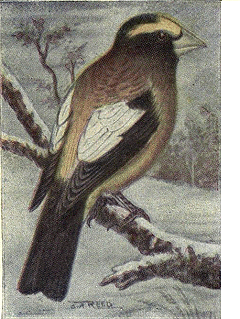
Evening Grosbeak. 513a. Great-tailed Grackle. Megaquiscalus major macrourus.
Range.--Mexico to southern and eastern Texas.
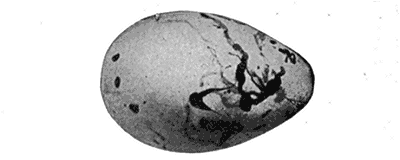
Grayish white. This variety is larger than the last (length
18 inches) and the tail is very broad and flat.
Like the former, they nest in bushes, rushes or
trees at any elevation from the ground. The
nests are built of the same materials and the
eggs are similar to those of the Boat-tailed
Grackle, but larger; size 1.28 × .88.
FINCHES, SPARROWS, ETC. Family FRINGILLDÆ
514. Evening Grosbeak. Hesperiphona vespertina vespertina.
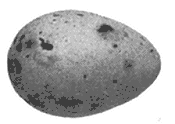
Greenish white. Range.--Western United States in the Rocky Mountain region; north to Saskatchewan;
south in winter to Mississippi Valley and casually
east to New England and the intermediate states.
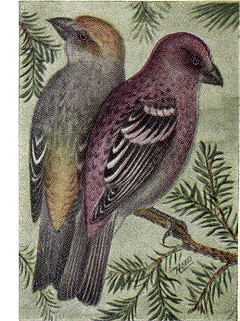
Pine Grosbeak. These are dull and yellowish birds, shading to brownish
on the head; with a bright yellow forehead and susperciliary
line, black wings and tail, and white inner secondaries
and greater coverts. They breed in the mountainous portions
of their range, placing their flat nests of sticks and
rootlets in low trees or
bushes. The eggs are laid in May or June and
are greenish white spotted and blotched with
brown; size .90 × .65.
514a. Western Evening Grosbeak. Hesperiphona vespertina montana.
Range.--Western United States, breeding in
the mountains from New Mexico to British
Columbia.
The nesting habits and eggs of this variety
are the same as those of the preceding, and the
birds can rarely be separated.
515. Pine Grosbeak. Pinicola enucleator leucura.
Range.--Eastern North America, breeding
from northern New England northward, and
wintering to southern New England and Ohio
and casually farther.
|
|
|
Page 325
|

Purple Finch. They build in conifers making their nests of small twigs and rootlets,
lined with fine grasses and lichens. During the
latter part of May or June they lay three or
four eggs, which have a
ground color of light
greenish blue, spotted and
splashed with dark brown,
and with fainter markings
of lilac. Size 1.00 × .70.
Pine Grosbeaks have been
separated into the following
sub-species, the chief
distinction between them being in their
ranges. The nesting habits and eggs of all
are alike.
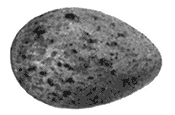
Greenish blue. 515a. Rocky Mountain Pine Grosbeak. Pinicola enucleator montana.
Range.--Rocky Mountain region from New
Mexico to Montana.
515b. California Pine Grosbeak. Pinicola enucleator californica.
Range.--Higher parts of the Sierra Nevadas in California.
515c. Alaska Pine Grosbeak. Pinicola enucleator alascensis.
Range.--Interior of Northwest America from Alaska south to British Columbia.
515d. Kadiak Pine Grosbeak. Pinicola enucleator flammula.
Range.--Kadiak Island and the southern coast of Alaska.
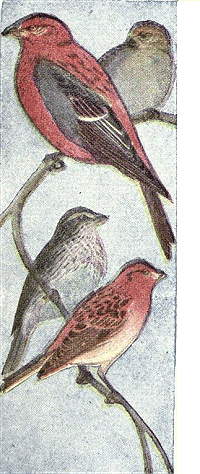
515b--517a. 516. Cassin's Bullfinch. Pyrrhula cassini.
Range.--Northern Asia; accidental in Alaska.
517. Purple Finch. Carpodacus purpureus purpureus.
Range.--North America east of the plains, breeding
from the Middle States north to Labrador and Hudson Bay;
winters in the United States.
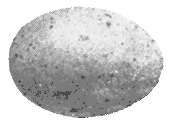
Greenish blue. These sweet songsters are quite abundant
in New England in the summer, but
more so north of our borders. While
they breed sometimes in trees, in orchards,
I have nearly always found their
nests in evergreens, usually about three-fourths
of the way up. The nests are
made of fine weeds and grasses and lined
with horse hair. The eggs, which are usually laid in June,
are greenish blue, spotted with dark brownish; size
.85 × .65.
517a. California Purple Finch. Carpodacus purpureus californicus.
Range.--Pacific coast, breeding from central California
to British Columbia and wintering throughout California.
The nesting habits and eggs of this darker colored
variety are just like those of the last.
|

|
Page 326

|

518--519. 518. Cassin's Purple Finch. Carpodacus cassini.
Range.--North America west of the Rockies, breeding
from British Columbia south to New Mexico.
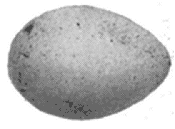
Greenish blue. This species is similar to the last but
the back, wings and tail are darker and
the purplish color of the preceding species
is replaced by a more pinkish shade.
The nesting habits and eggs are the
same as those of the eastern Purple
Finch; size of eggs .85 × .60. Data.--Willis,
New Mexico, June 23, 1901. Nest made of twigs
and rootlets and lined with horse hair. Collector, F. J.
Birtwell.
519. House Finch. Carpodacus mexicanus frontalis.
Range.--United States west of the Plains and from
Oregon and Wyoming to Mexico.
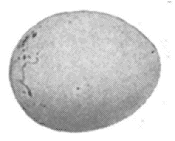
Greenish blue. This is one of the best known of western
birds, and nests commonly in all situations
from trees and bushes to vines growing on
porches. Their nests are made of rootlets
and grasses and are lined with horse hair.
Their nesting season includes all the summer
months, they raising two and sometimes
three broods a season. The three to five eggs are pale greenish blue with a few
sharp blackish brown specks about the large end. Size .80 × .55.
519b. San Lucas House Finch. Carpodacus mexicanus ruberrimus.
Range.--Southern Lower California. A slightly smaller variety of the preceding.
519c. San Clemente House Finch. Carpodacus mexicanus clematis.
Range.--San Clemente and Santa Barbara Islands. Somewhat darker than
the last.
520. Guadalupe Finch. Carpodacus amplus.
Range.--Guadalupe Island, Lower California.
Similar to the House Finch, but deeper red and slightly larger. Their nesting
habits and eggs are precisely like those of the House Finch but the eggs
average larger; size .85 × .60.
520.1. Mcgregor's House Finch. Carpodacus mcgregori.
Range.--San Benito Island, Lower California.
A newly made species, hardly to be distinguished from the last. Eggs probably
the same.

|
|
|
Page 327
|

Crossbill. 521. Crossbill. Loxia curvirostra minor.
Range.--Northern North America, breeding
in the Alleghanies and from northern New
England northward; winters south to the middle
portions of the United States and casually
farther.
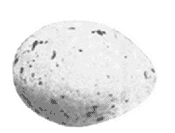
Greenish white. The birds are very curious
both in appearance and
actions, being very "flighty"
and restless, and apt to remain
to breed on any of the
mountains. They build during
March or April, making
their nests of twigs, rootlets,
moss, feathers, etc., and placing them in forks
or on branches of trees (usually conifers) at
any height from the ground. The eggs are
greenish white, spotted with brown and with
lavender shell markings; size .75 × .55.
521a. Mexican Crossbill. Loxia curvirostra stricklandi.
Range.--Mountain ranges from central Mexico north to Wyoming.
A larger variety of the preceding. The eggs will not differ except perhaps
a trifle in size.
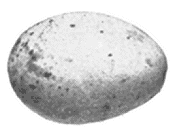
Greenish white. 522. White-winged Crossbill. Loxia leucoptera.
Range.--Northern North America, breeding in the Alleghanies
and from northern Maine northward; winters to
middle portions of the United States.
This species is rosy red with two white wing bars. Like
the last, they are of a roving disposition and are apt to
be found in any unexpected locality. Their nesting habits
are the same as those of the American Crossbill, but the
eggs average larger and the
markings are more blotchy; size .80 × .55.
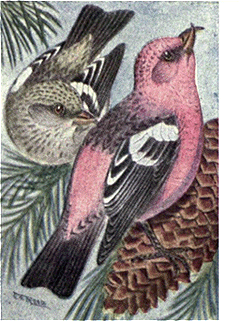
White-winged Crossbill. 523. Aleutian Rosy Finch. Leucosticte griseonucha.
Range.--Aleutian and Pribilof Islands; south
to Kadiak.
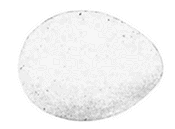
White. This is the largest of the genus, and can
be distinguished from the others by its very
dark chestnut coloration and the gray hindneck
and cheeks. Like the other
Leucostictes, they are
found in flocks and frequent
rocky or mountainous
country, where they
are nearly always found
on the ground. They build
in crevices among the
rocks or under ledges or
embankments, making the
nest of weeds and grasses. Their four or five
pure white eggs are laid during June. Size
.97 × .67. Data.--St. George Islands of the
|

|
Page 328

|
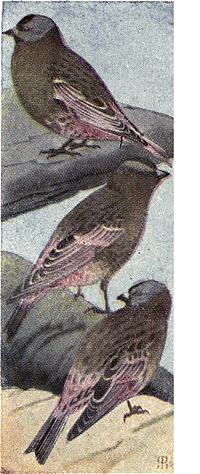
523--524--524a. 524. Gray-crowned Rosy Finch. Leucosticte tephrocotis tephrocotis.
Range.--Rocky Mountain region from Saskatchewan
south to northern United States and also
breeding in the Sierra Nevadas; winters
on the lowlands of northwestern United
States and east to Manitoba.
The habits and breeding habits of this
species are like those of the last. The
bird is paler colored and the gray is restricted
to the hind part of the head.
They nest on the ground in June, laying
four or five white eggs.
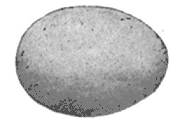
White. 524a. Hepburn Rosy Finch. Leucosticte tephrocotis littoralis.
Range.--Higher ranges from Washington and British
Columbia to Alaska.
This variety is like the Aleutian Leucosticte but the
brown is a great deal paler. The nesting habits and eggs
are, in all probability, like those of the last.
525. Black Rosy Finch. Leucosticte atrata.
Range.--Rocky Mountain region of northern United States; known to breed
in Idaho.
This species is black in place of the brown of the others; the gray is restricted
to the hind part of the head and the rosy is rather more extensive on the
wings. Their eggs probably cannot be distinguished from those of the Gray-crowned
variety.
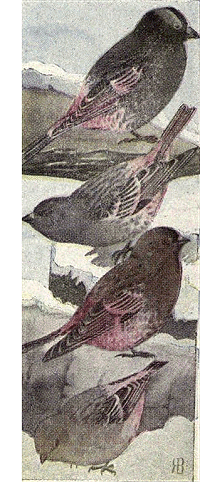
525--526. 526. Brown-capped Rosy Finch. Leucosticte australis.
Range.--Breeds at high altitudes in the Rockies in Colorado;
south to New Mexico in winter.
A similar bird to the Gray-crowned Leucosticte but with
no gray on the head. They nest on the ground above
timber line on the higher ranges of the Rockies.
527. Greenland Redpoll. Acanthis hornemanni hornemanni.
Range.--Greenland and northern Europe; south in winter
to Labrador.
This large Redpoll nests at low elevations in trees and
bushes, its habits and eggs being similar to the more common
American species.
527a. Hoary Redpoll. Acanthis hornemanni exilipes.
Range.--Breeds in the Arctic regions and winters south
to the northern parts of the United States.
This variety is smaller than the last and is considerably
darker but still retains the white rump of the Greenland
Redpoll. Its nesting habits are the same as those of the
next.
|
|
|
Page 329
|
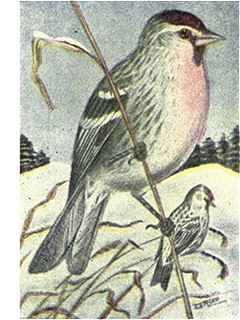
Redpoll. 528. Redpoll. Acanthis linaria linaria.
Range.--Breeds within the Arctic Circle;
winters south to New York, Kansas and northern
California and casually farther.
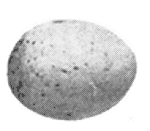
Bluish green. This species is similar to the last but much
darker, and the rump is also streaked with
blackish. These handsome birds are often met
with in winter, feeding on seeds
of the weed stems that project
above the snow. Their flight
and song is similar to that of the
Goldfinch or Pine Siskin. They
nest at low elevations, either in
trees or bushes. The eggs number
from three to six and are pale bluish, sparingly
specked with reddish brown. Size .65 ×
.50. Data.--Mouth of Great Whale River, Hudson
Bay, May 16, 1899. Nest in a willow 4 feet
from the ground; made of fine rootlets and
grass, lined with feathers. Collector, A. P.
Lowe.
528a. Holboll's Redpoll. Acanthis linaria holbœlli.
Range.--Arctic regions; south casually to the border of the United States.
A slightly larger variety of the common Redpoll. Eggs probably not distinguished.
528b. Greater Redpoll. Acanthis linaria rostrata.
Range.--Breeds in southern Greenland; in winter south through Labrador to
the northern border of the United States.
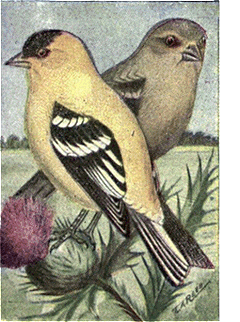
Goldfinch. This variety is larger and darker than the common Redpoll. It has been
found breeding abundantly in southern Greenland, where its nesting habits are
the same as those of the Redpoll and the eggs
similar but averaging a trifle larger.
529. Goldfinch. Astragalinus tristis tristis.
Range.--North America east of the Rockies,
and from Labrador and Manitoba southward.
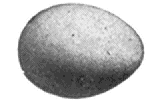
Bluish white. These beautiful birds are
among our sweetest songsters
from May until September.
They are resident
throughout their United States
range, where they breed in
August or early in September,
being one of the latest nesting birds that
we have. Their nests are located in bushes, at
a height of generally below fifteen feet above
the ground, being placed in upright forks, and
made of plant fibres and thistle down, firmly
woven together. They lay from three to six
plain bluish white eggs. Size .65 × .50. The majority
of nests that I have found have been in
alders over small streams.
|

|
|
Page 330
|
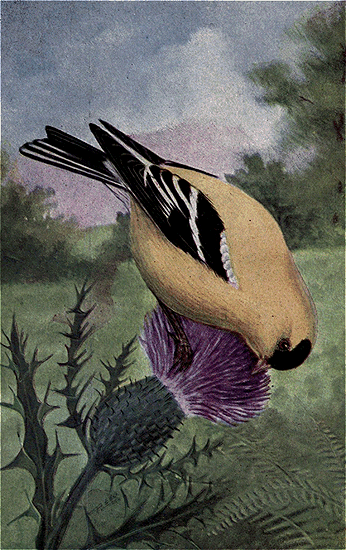
AMERICAN GOLDFINCH.
|
|
|
Page 331
|
529a. Pale Goldfinch. Astragalinus tristis pallidus.
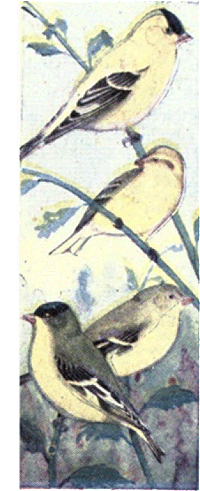
529a--529b--530. Range.--Rocky Mountains from Mexico to British Columbia.
This variety is slightly larger and (in winter) paler than
the last.
529b. Willow Goldfinch. Astragalinus tristis salicamans.
Range.--Pacific coast from Washington to Lower California.
Similar to the eastern Goldfinch but back said to be
slightly greenish yellow.
530. Arkansas Goldfinch. Astragalinus psaltria psaltria.
Range.--United States, west of the Plains and from Oregon
to Mexico.

Bluish white. This species has greenish upper parts and
yellow below; the crown, wings and tail are
black, the bases of the lateral tail feathers
and primaries being whitish. They are common
in portions of their range, nesting in similar locations to
those chosen by the common Goldfinch and laying from three to
five eggs which are similar but slightly smaller. Size .60 × .45. Data.--Riverside,
California, May 20, 1891. 5 eggs. Nest made of fine grasses lined with
cotton; 5 feet from the ground in a small tree.
530a. Green-backed Goldfinch. Astragalinus hesperophilus.
Range.--Mexico north to the Lower Rio Grande in southern Texas.
A similar bird to the last but with the entire upper parts and cheeks, black.
The habits, nests and eggs are identical with those of the Arkansas Goldfinch.
531. Lawrence's Goldfinch. Astragalinus lawrencei.
Range.--Pacific coast of California, wintering along the Mexican border.
This grayish colored Goldfinch has a black face and yellow breast, rump,
wing coverts and edges of the primaries. They are quite common in their
restricted range, nesting either in upright crotches or in the forks of horizontal
limbs. The four or five eggs which they lay are pure white; size .60 × .45.
Data.--Santa Monica Canyon, Cal., April 26, 1903. Nest in a cypress tree 12
feet up; composed of grasses, feathers, etc. Collector, W. Lee Chambers.
532. Black-headed Goldfinch. Spinus notatus.
Range.--Mountainous regions of Central America and southern Mexico;
accidental in the United States.
|

|
Page 332

|
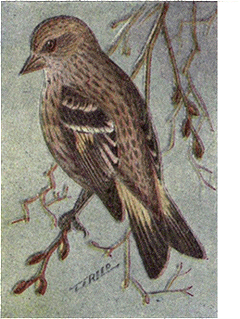
Pine Siskin. 533. Pine Siskin. Spinus pinus.
Range.--Breeds from northern United States
northward, in the Alleghanies and in the Rockies
south to New Mexico. Winters throughout
the United States.

Greenish white. Siskins are of the size of the Goldfinch (5
inches long), and their calls, songs and habits
are similar to those of this bird. Their plumage
is grayish brown, streaked with dusky and
the bases of the wings and tail feathers are
yellow. Like the Crossbills,
they frequently feed along our
northern borders, but very sporadically.
Their nests are built
on horizontal branches of pines
or cedars at any elevation from
the ground, being made of
grasses and rootlets lined with hair or pine
needles, and of rather frail and flat construction.
Their eggs are laid during May or June
and are greenish white, specked with reddish
brown; size .68 × .48. Data.--Hamilton Inlet,
Labrador, June 17, 1898. Nest on branch of a spruce, 10 feet from the ground;
made of grass, lined with moss and feathers. Collector, L. Dicks.
534. Snow Bunting. Plectrophenax nivalis nivalis.
Range.--Breeds in the Arctic regions, and winters irregularly in large flocks
through the United States to Oregon, Kansas
and Georgia.
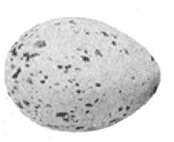
Greenish white. 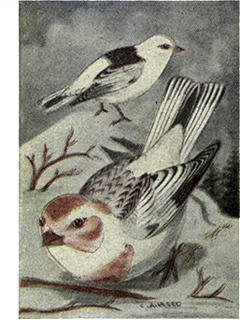
Snowflake. These birds are only seen in the United
States in large roving flocks,
during the winter when they
feed on weed seeds on side
hills. Their nests are built
on the ground, being sunk
into the sphagnum moss, and
made of grasses lined with
feathers. Their four or five
eggs are a light greenish white, spotted and
splashed with yellowish brown and lilac. Size
.90 × .65.
534a. Pribilof Snow Bunting. Plectrophenax nivalis townsendi.
Range.--Pribilof and Aleutian Islands, Alaska.
A slightly larger variety which is resident
on the islands in its range. Eggs like those
of the preceding; laid from May to July.
|
|
|
Page 333
|
535. McKay's Snow Bunting. Pletrophenax hyperboreus.
Range.--Western Alaska; known to breed on Hall's Island.
This beautiful species is, in summer, entirely white except for the tips of the
primaries and a black spot on end of central tail feathers, thus being very distinct
from the preceding, which has the back and the wings to a greater extent
black, at this season. Their eggs probably very closely resemble those of the
last species.
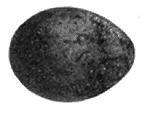
Grayish. 536. Lapland Longspur. Calcarius lapponicus lapponicus.
Range.--Breeds in northern North America; winters south
casually to New York, Ohio and Oregon and occasionally farther.
These sparrow-like birds are 6.5 inches long and have a black
crown, cheeks and throat, and chestnut band on nape. Like the
Snowflakes they nest on the ground in moss, but the four to six
eggs that they lay are grayish, heavily mottled and blotched with
chocolate brown; size .80 × .60.
536a. Alaska Longspur. Calcarius lapponicus alascensis.
Range.--Northwest North America, breeding in Alaska; winter south to Oregon.
This sub-species is like the last but slightly paler. Eggs indistinguishable.
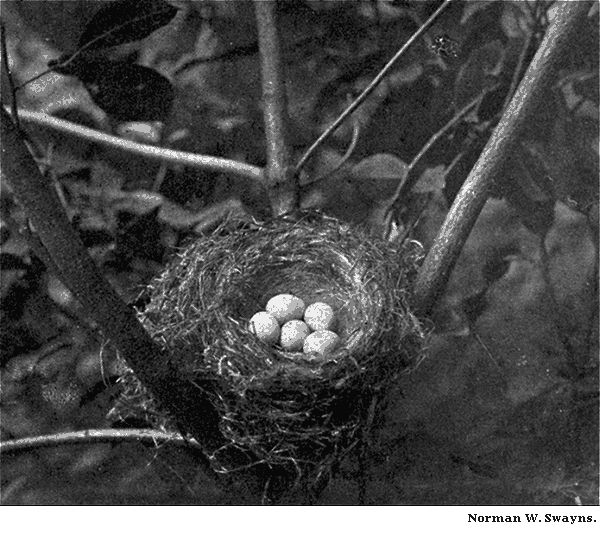
NEST AND EGGS OF GOLDFINCH.
|

|
Page 334

|
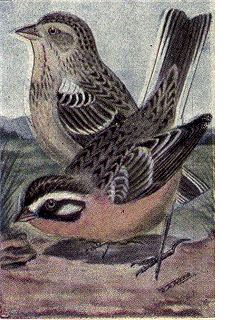
Smith's Longspur. 537. Smith's Longspur. Calcarius pictus.
Range.--Breeds in Hudson Bay and Mackenzie
River districts and winters south to
Texas chiefly on the Plains.
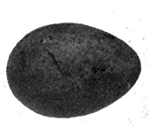
Grayish. This species is of the size
of the last but is a rich buff
color below, and the other
markings are very different.
These birds together with
the next species are very
common on the prairies in
central United States in winter.
They nest on the ground like the preceding
species but the nests are scantily made of
grasses and not warmly lined like those of the
last. The eggs are similar but paler; size .80
× .60. Data.--Herschell Island, Arctic Ocean,
June 10, 1901. Nest built in a tuft of grass;
made of fine roots and grass, lined with feathers.
538. Chestnut-collared Longspur. Calcarius ornatus.
Range.--Plains in the interior of North America, breeding from Kansas north
to Saskatchewan; very abundant in the Dakotas and Montana.

Dull white. This handsome species in the breeding plumage has the
throat white, breast and belly black, and a chestnut collar on
the nape. They are one of the most abundant breeding birds
on the prairies, nesting in hollows on the ground either in the
open or protected by a tuft of grass. The nests are made of
grasses and sometimes moss; three or four eggs laid in June
or July; white, blotched, lined
and obscurely marked with
brown and purplish; size .75 x .55.

Chestnut-collared Longspur. 539. McCown's Longspur. Rhynchophanes mccowni.
Range.--Great Plains, breeding from Kansas
to the Saskatchewan.
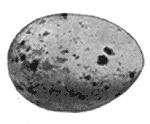
Grayish white. This Longspur which breeds in company with
the preceding, throughout its range, can be distinguished
from it by the
small black patch on the
breast, the black crown, and
chestnut wing coverts. Their
nesting habits are the same,
and at this season all the
Longspurs have a sweet song
often uttered during flight,
like that of the Bobolink. Their eggs are of the
same size and similarly marked as the last, but
the ground color is more gray or olive.
|
|
|
Page 335
|
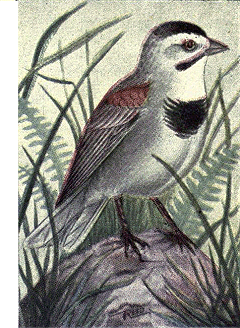
McCown's Longspur. 540. Vesper Sparrow. Poœcetes gramineus gramineus.
Range.--Eastern United States, breeding from
Virginia and Missouri north to Manitoba and
New Brunswick; winters in the southern half
of the United States.

Whitish. A streaked grayish, buffy
and white bird distinguished
by its chestnut shoulders and
white outer tail feathers.
They are abundant birds in
eastern fields where their
loud piping whistle is known
to many frequenters of weedy
pastures. They build on the ground, either
in grassy or cultivated fields, lining the hollow
scantily with grasses. Their four or five eggs
are usually laid in May or June; they are dull
whitish, blotched and splashed with light
brown and lavender tints; size .80 × .60.
540a. Western Vesper Sparrow. Poœcetes gramineus confinis.
Range.--This paler variety is found in North America west of the Plains and
south of Saskatchewan.
Its nesting habits are like those of the preceding and the eggs are indistinguishable.
540b. Oregon Vesper Sparrow. Poœcetes gramineus affinis.
A browner variety found on the coast of Oregon and northern California.
Its nesting habits are like those of the eastern bird and the eggs similar but
averaging a trifle smaller.
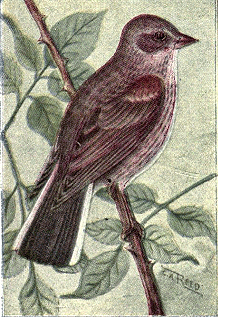
Vesper Sparrow. * * * English Sparrow. Passer domesticus.
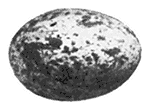
White. These birds, which were imported from
Europe, have increased so rapidly that they
have overrun the cities and villages of the country
and are doing inestimable damage both by
driving out native insect
eating birds and by their
own destructiveness. They
nest in all sorts of places
but preferably behind
blinds, where their unsightly
masses of straw
protrude from between the
slats, and their droppings besmirch the buildings
below; they breed at all seasons of the
year, eggs having often been found in January,
with several feet of snow on the ground and
the mercury below zero. The eggs number from
four to eight in a set and from four to eight
sets a season; the eggs are whitish, spotted
and blotched with shades of gray and black.
Size .88 × .60.
|

|
|
Page 336
|
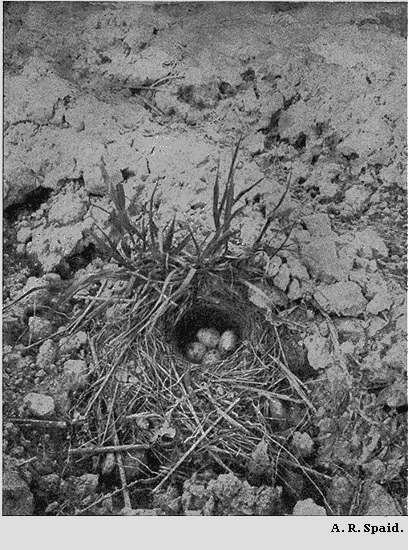
NEST AND EGGS OF VESPER SPARROW.
|
|
|
Page 337
|
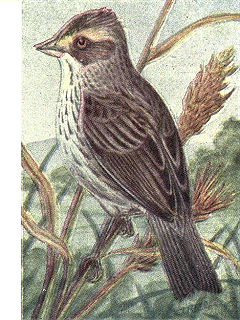
Savannah Sparrow. 541. Ipswich Sparrow. Passerculus princeps.
Range.--Breeds on Sable Island, off Nova
Scotia; winters on coast of South Atlantic
States. This a large and pale colored form of
the common Savannah Sparrow. Its nesting
habits are similar to those of the latter and the
eggs are marked the same but average larger.
Size .80 × .60.
542. Aleutian Savannah Sparrow. Passerculus sandwichensis sandwichensis.
Range.--Breeds on the Alaskan coast; winters
south to northern California.
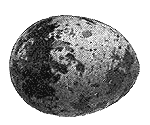
Grayish White. A streaked Sparrow like the
next but with the yellow superciliary
line brighter and more
extended. Its nesting habits
are precisely like those of the
next variety which is common
and well known; the eggs are
indistinguishable.
542a. Savannah Sparrow. Passerculus sandwichensis savanna.
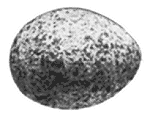
Grayish White. Range.--North America east of the Plains, breeding from the
Middle States north to Labrador and the Hudson Bay region.
Similar to the last but with the superciliary line paler and
the yellow reduced to a spot on the lores. Their nests are
hollows in the ground, lined with grasses and generally concealed
by tufts of grass or weeds. Their three to five eggs
vary greatly in markings from finely and evenly dotted all
over to very heavily blotched, the ground color being grayish
white. Size .75 × .55
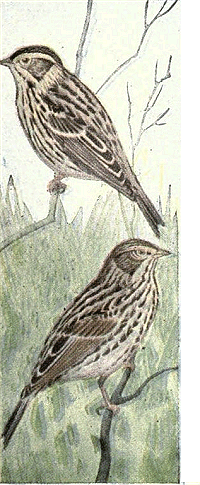
542b--543. 542b. Western Savannah Sparrow. Passerculus sandwichensis alaudinus.
Range.--Western North America from Alaska to Mexico.
A slightly paler form whose nesting habits and eggs do
not differ from those of the last.
542c. Bryant's Sparrow. Passerculus sandwichensis bryanti.
Range.--Salt marshes of California from San Francisco
Bay south to Mexico.
Slightly darker and brighter than the eastern Savannah
Sparrow and with a more slender bill. The eggs are not
different from many specimens of savanna; they are light
greenish white heavily blotched with various shades of
brown and lavender. Size .75 × .55.
543. Belding's Sparrow. Passerculus beldingi.
Range.--Pacific coast marshes of southern California
and southward.
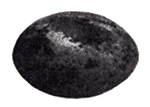
Grayish white. This species is similar to the last but
darker and more heavily streaked below.
They breed abundantly in salt marshes,
building their nests in the grass or
patches of seaweed barely above the
water, and making them of grass and
weeds, lined with hair; the eggs are dull
grayish white, boldly splashed, spotted and clouded with
brown and lavender. Size .78 × .55.
|

|
Page 338

|

544--544c. 544. Large-billed Sparrow. Passerculus rostratus rostratus.
Range.--Coast of southern and Lower California.
Similar to the Savannah Sparrow but paler and grayer,
without yellow lores and a larger and stouter bill. They
are common in salt marshes, often in company with the
last species and their nesting habits are similar to and
the eggs not distinguished with certainty from those of
the latter.
544a. San Lucas Sparrow. Passerculus rostratus guttatus.
Range.--Southern Lower California.
A slightly darker form of the preceding, having identical
habits, and probably, eggs.
544c. San Benito Sparrow. Passerculus rostratus sanctorum.
Range.--Breeds on San Benito Islands; winters in southern
Lower California.
The nesting habits and eggs of these very similar subspecies
are identical.
545. Baird's Sparrow. Ammodramus bairdi.
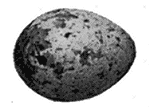
White. Range.--Plains, breeding from northern United States to
the Saskatchewan; south in winter to the Mexican border.
These Sparrows breed abundantly on the plains of Dakota
and northward, placing their nest in hollows on the ground in
fields and along road sides. During June or July, they lay
three to five dull whitish eggs, blotched, splashed and spotted
with light shades of brown and gray. Size .80 × .60.
546. Grasshopper Sparrow. Ammodramus savannarum australis.
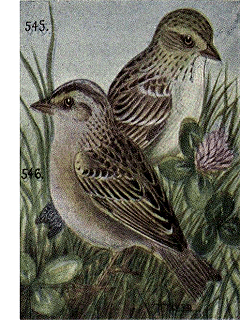
Baird's Sparrow.
Grasshopper Sparrow. Range.--United States east of the Plains,
breeding from the Gulf to Canada.
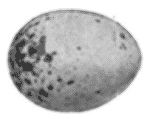
White. A stoutly built Sparrow marked on the upper
parts peculiarly, like a quail; nape grayish
and chestnut. These birds
are common in dry fields and
pastures, where their scarcely
audible, grasshopper-like
song is heard during the heat
of the day. Their nests are
sunken in the ground and
arched over so that they are very difficult to
find, especially as the bird will not flush until
nearly trod upon. The four or five eggs, laid in
June, are white, specked with reddish brown.
Size .72 × .55.
546a. Western Grasshopper Sparrow.
Ammodramus savannarum bimaculatus
Range.--West of the Plains from British
Columbia to Mexico.
Slightly paler than the last; has the same
nesting habits; eggs indistinguishable.
|
|
|
Page 339
|
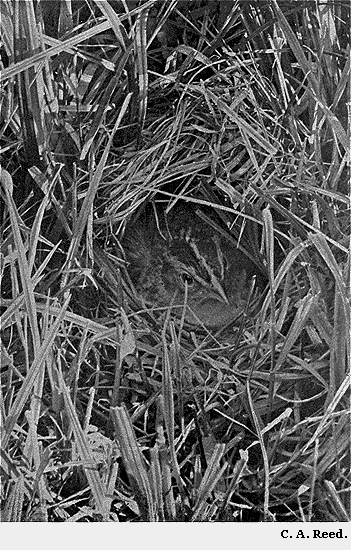
GRASSHOPPER SPARROW ON NEST.
|
|
Page 340

|
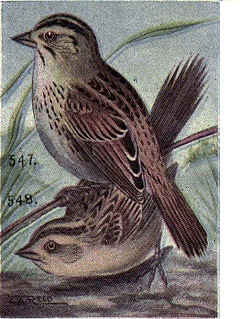
Henslow's Sparrow.
Leconte's Sparrow. 546b. Florida Grasshopper Sparrow. Ammodramus savannarum floridanus.
Range.--Central Florida.
A local form, darker above and paler below
than the common species. Eggs not different
in any particular.
547. Henslow's Sparrow. Passerherbulus henslowi henslowi.
Range.--United States east of the Plains,
breeding locally from Maryland and Missouri
north to Massachusetts and Minnesota.
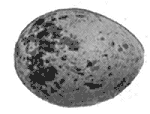
White. This species is similar in form and marking
to the last, but is olive green on the nape, and
the breast and sides are
streaked with blackish. Their
nesting habits are very similar
to those of the Grasshopper
Sparrow, the nests being
difficult to find. The eggs
are greenish white, spotted
with reddish brown. Size .75 × .55.
547a. Western Henslow's Sparrow. Passerherbulus henslowi occidentalis.
Range.--A paler and very local form found in the Plains in South Dakota and
probably, adjoining states. Eggs not apt to differ from those of the preceding.
548. Leconte's Sparrow. Passerherbulus lecontei.
Range.--Great Plains, breeding from northern United States to Assiniboia;
winters south to Texas and the Gulf States.
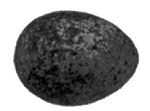
White. A bird of more slender form than the preceding, and with
a long, graduated tail, the feathers of which are very narrow
and pointed. They nest on the ground in damp meadows, but
the eggs are difficult to find
because the bird is flushed
from the nest with great difficulty. The eggs are white
and are freely specked with brown. Size .70 × .52.
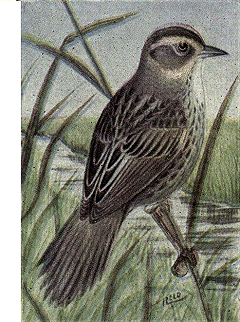
Sharp-tailed Sparrow. 549. Sharp-tailed Sparrow. Passerherbulus caudacutus.
Range.--Breeds in marshes along the Atlantic
coast from Maine to South Carolina and
winters farther south.
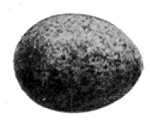
White. These birds are very common in nearly all
the salt marshes of the coast, nesting in the
marsh grass. I have nearly always found their
nests attached to the coarse
marsh grass a few inches above
water at high tide, and generally
under apiece of drifted seaweed.
The nests are made of grasses,
and the four or five eggs are
whitish, thickly specked with
reddish brown. Size .75 × .55. The birds are
hard to flush and then fly but a few feet and
quickly drop into the grass again.
|
|
|
Page 341
|
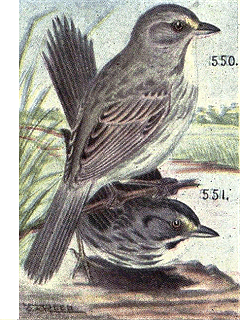
Seaside Sparrow.
Dusky Seaside Sparrow. 549.1. Nelson's Sparrow. Passerherbulus nelsoni nelsoni.
Range.--Breeds in the fresh water marshes
of the Mississippi valley from Illinois to Manitoba.
This species is similar to the Sharp-tailed
Finch but more buffy on the breast and generally
without streaks. The nesting habits are
the same and the eggs indistinguishable.
549.1a. Acadian Sharp-tailed Sparrow. Passerherbulus nelsoni
subvirgatus.
Range.--Breeds in the marshes on the coast
of New England and New Brunswick; winters
south to the South Atlantic States.
This paler variety of Nelson's Sparrow nests
like the Sharp-tailed species and the eggs are
the same as those of that bird.
550. Seaside Sparrow. Passerherbulus maritimus maritimus.
Range.--Atlantic coast, breeding from southern New England to Carolina and
wintering farther south.
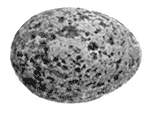
White. This sharp-tailed Finch is uniform grayish above and light
streaked with dusky, below. They are very abundant in the
breeding range, where they nest in marshes in company with
caudacutus. Their nests are the same as those of that species
and the eggs similar but slightly larger. Size .80 x .60.
Data.--Smith Island, Va., May 20, 1900. Nest situated in tall
grass near shore; made of dried grass and seaweed. Collector,
H. W. Bailey.
All the members of this genus have a habit of fluttering out over the water,
and then gliding back to their perch on the grass, on set wings, meanwhile
uttering a strange rasping song. The nesting habits and eggs of all the subspecies
are precisely like those of this variety, and they all occasionally arch
their nests over, leaving an entrance on the side.
550a. Scott's Seaside Sparrow. Passerherbulus maritimus peninsulœ.
Range.--Coasts of Florida and north to South Carolina. Above blackish
streaked with brownish gray; below heavily streaked with black.
550b. Texas Seaside Sparrow. Passerherbulus maritimus sennetti.
Range.--Coast of Texas. Similar to maritimus, but streaked above.
550c. Louisiana Seaside Sparrow. Passerherbulus maritimus fisheri.
Range.--Gulf coast. This form is similar to peninsulœ, but darker and more
brownish.
|

|
Page 342

|
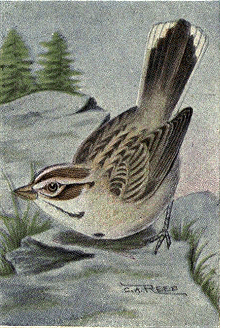
Lark Sparrow. 550d. Macgillivray's Seaside Sparrow. Passerherbulus maritimus
macgillivrai.
Range.--Coast of South Carolina. Like
fisheri but grayer.
551. Dusky Seaside Sparrow. Passerherbulus nigrescens.
Range.--Marshes of Indian River near Titusville,
Florida.
This species is the darkest of the genus, both
above and below, being nearly black on the
upperparts. Their habits are like those of the
others and the eggs are not likely to differ.
552. Lark Sparrow. Chondestes grammacus grammacus.
Range.--Mississippi Valley from the Plains
to Illinois and casually farther east, and from
Manitoba to Texas; winters in Mexico.
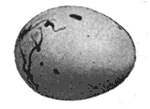
White. This handsome Sparrow has the sides of the crown and ear
patches chestnut, and the sides of the throat and a spot on the
breast, black. They are sweet singers and very welcome birds
in their range, where they are quite abundant. Their nests
are generally placed on the ground in the midst of or under a
clump of weeds or tuft of grass, but sometimes in bushes or
even trees; they are made of grasses and weeds and the eggs,
which are usually laid in May, are white marked chiefly
about the large end with blackish zigzag lines and spots. Size .80 × .60.
552a. Western Lark Sparrow. Chondestes grammacus strigatus.
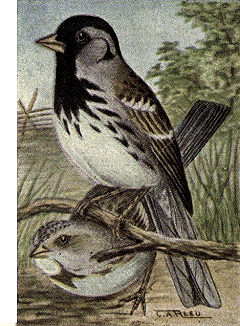
Harris's Sparrow. Range.--United States west of the Plains;
breeds from British Columbia to Mexico.
This paler and duller colored variety is common
on the Pacific coast; its habits and nests
and eggs are like those of the last.
553. Harris's Sparrow. Zonotrichia querula.
Range.--Mississippi Valley, chiefly west,
breeding in Manitoba and Saskatchewan, the
exact range being unknown.

Whitish. Although the birds are
abundant during migrations,
they seem to suddenly and
strangely disappear during
the breeding season. Supposed
nests have been found
a few inches above the ground
in clumps of grass, the eggs
being whitish, thickly spotted
with shades of brown. Size .85 × .65.
|
|
|
Page 343
|
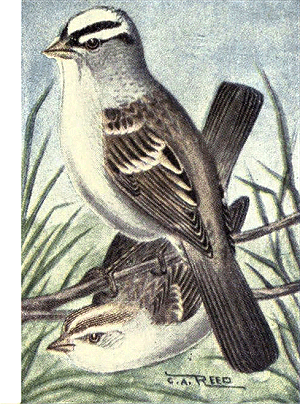
White-crowned Sparrow. 554. White-crowned Sparrow. Zonotrichia leucophrys leucophrys.
Range.--North America breeding abundantly
in Labrador and about Hudson Bay, and casually
in northern New England and in western
United States in the Rockies and Sierras.
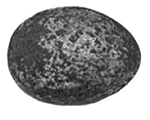
Pale greenish blue. Winters along our Mexican
border and southward. A
handsome species with a
broad white crown bordered
on either side by black, and
with a white superciliary line
and black lores; the underparts
are uniform grayish
white. These birds appear to
be nowhere as common as the White-throated
Sparrows with which they associate during migrations
and in the breeding grounds. They
build on the ground, generally near the edges
of woods or in clearings, and lay from four to
six eggs similar but larger, and with as much
variation in markings as those of the Song Sparrow; pale greenish blue, spotted
and splashed with reddish brown and grayish. Size .90 × .65. Data.--Nachook,
Labrador, June 10, 1897. Nest of fine grasses on the ground in a clump of grass.
554a. Gambel's Sparrow. Zonotrichia leucophrys gambeli.
Range.--Rocky Mountains and westward from Mexico to Alaska, breeding
chiefly north of the United States.
This bird is like the last but the lores are white. Its nesting habits and eggs
cannot be distinguished from those of the former.
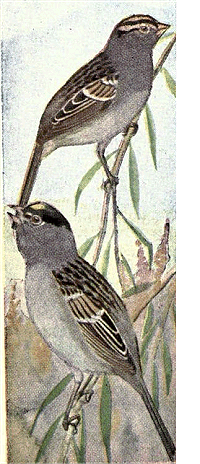
554a--557. 554b. Nuttall's Sparrow. Zonotrichia leucophrys nuttalli.
Range.--Pacific coast from British Columbia to Lower
California.
Similar to the last but smaller and browner above; nests
on the ground or in bushes, the eggs not being distinguishable
from those of the other White-crowns.
557. Golden-crowned Sparrow. Zonotrichia coronata.
Range.--Pacific coast from Mexico to Alaska, breeding
chiefly north of our borders.
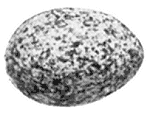
Pale greenish blue. This species has the crown yellow, bordered by black on
the sides. Their habits are like those of
the White-crowned Sparrows, they feeding
upon the ground among the dead
leaves, and usually being found in flocks
and often accompanied by many of the
last species. They nest upon the ground or
in low bushes, and in May or June lay
three or four eggs very similar to the
last. Size .90 × .65.
|

|
|
Page 344
|
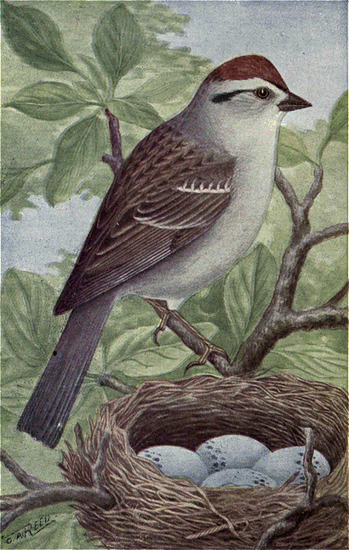
CHIPPING SPARROW.
|
|
|
Page 345
|
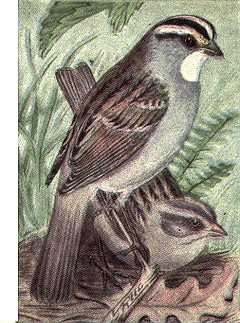
White-throated Sparrow. 558. White-throated Sparrow. Zonotrichia albicollis.
Range.--North America east of the Plains
and breeding from the northern tier of states
northward; winters from the Middle States
southward.
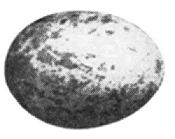
White. To my mind this is the
most beautiful of Sparrows,
with its bright and softly
blended plumage and the pure
white throat boldly contrasting
with its grayish breast
and sides of the head; the
lores are adorned with a
bright yellow spot. They are one of the most
abundant of Sparrows in the east during migrations
and their musical piping whistle is
heard from hedge and wood. They nest most
abundantly north of our borders, laying their
three or four eggs in grass lined hollows in
the ground, or more rarely in nests in bushes.
The eggs are white or bluish white, thickly spotted with several shades of
brown. Size .85 × .62. They nest most often in thickets or on the edge of
swamps, in just such places as they are met with on their migrations.
559. Tree Sparrow. Spizella monticola monticola.
Range.--North America east of the Plains, breeding north of the United States
to the Arctic coast, east of the Rockies; winters within the United States.
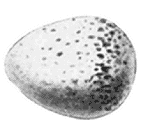
Greenish white. 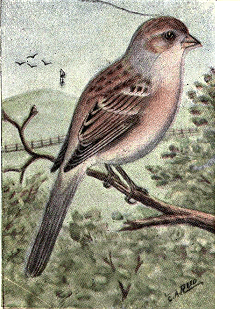
Tree Sparrow. A larger bird but somewhat resembling the common Chipping Sparrow, but
browner above, with a black spot on the breast and no black on the head.
They are quite hardy birds and winter in many of the northern
states where they may be found in flocks upon the snow, feeding
on seeds of protruding weeds. They breed very abundantly in
Labrador and about Hudson Bay, placing their green nests in
hollows on the ground or moss;
their three or four eggs are
greenish white, abundantly
speckled all over the surface
with reddish brown. Size .80 × .55. Data.--Foothills
of Black Mountains, McKenzie River,
Arctic America, June 13, 1899. Nest on the
ground under a tuft of grass on level plain;
made of grasses and moss and lined with feathers.
559a. Western Tree Sparrow. Spizella monticola ochracea.
Range.--North America west of the Plains,
breeding in Alaska and wintering to Mexico.
A paler form of the last, the nesting habits
and eggs of which are the same.
560. Chipping Sparrow. Spizella passerina passerina.
Range.--North America east of the Plains,
breeding from the Gulf to the interior of Canada
and Newfoundland.
|

|
Page 346

|
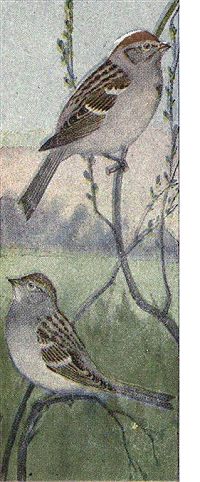
559a--560a. As indicated by their name socialis, Chipping Sparrows
are sociable birds not only with others of the bird tribe, but
with man. In all localities that are not overrun with English
Sparrows, you will find these confiding birds nesting in
trees and shrubs in the yard and in vines from porches,
while in orchards, nearly every tree has its
tenant.
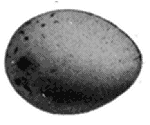
Bluish white. They are smaller birds than the
last (5.5 in. long) and have the brown
crown bordered by blackish and a black
line through the eye. Their nests, which
may be found at any height from the
ground and in any kind of a tree or shrub,
are made of fine grass and weed stems, lined
with hair; their three to five eggs are a handsome
greenish blue, sparingly specked chiefly about the large
end with blackish brown and purplish. Size .70 × .52.
560a. Western Chipping Sparrow. Spizella passerina arizonæ.
Range.--Western North America, chiefly west of the
Rockies, from Mexico to Alaska; winters in Mexico.
This variety is much duller colored than the last and
has but little brown on the back; its nesting habits are the same and the eggs
do not appear to differ in any respect from those of the eastern bird.
561. Clay-colored Sparrow. Spizella pallida.
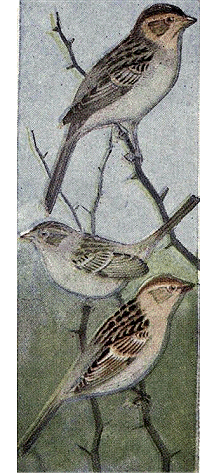
561--562--564. Range.--Interior of United States and Canada, from the Mississippi Valley to
the Rockies, breeding from Iowa and Colorado northward; winters in Mexico.
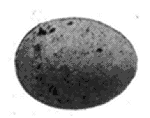
Bluish white. These birds can best be described as like
the Chipping Sparrow with the brown largely
replaced with blackish. They breed quite
abundantly in Manitoba and Minnesota, placing
their nests on or near the ground, and
making them of fine grasses. The eggs cannot
be distinguished with certainty from
those of the preceding but average a trifle
smaller. Size .65 × .50. Data.--Barnsley, Manitoba, May
24, 1900. Nest of grass stalks lined with fine grass, one
foot above ground in tuft of grass.
562. Brewer's Sparrow. Spizella breweri.
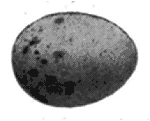
Bluish white. Range.--Western United States from Mexico
to British Columbia rarely and chiefly
between the Rockies and the Sierras; most
abundant in New Mexico and Arizona.
This bird is similar to the last but is paler
and more finely streaked. Their nesting
habits are like those of pallida and the eggs
are indistinguishable.
|
|
|
Page 347
|

CHIPPING SPARROWS (The whole family).
|
|
Page 348

|
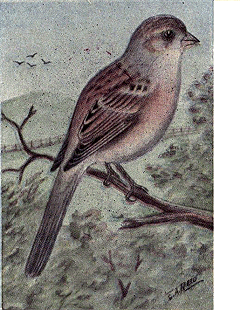
Field Sparrow. 563. Field Sparrow. Spizella pusilla pusilla.
Range.--North America east of the Plains,
breeding from the Gulf to southern Manitoba
and Quebec; winters in the Gulf States.
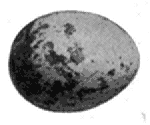
Bluish white. These are abundant birds
along roadsides, in thickets, or
on dry sidehills, where they nest
indifferently on the ground or in
bushes, making their nests of
grass and weed stems. They are
the birds, whose high piping
song is most frequently heard
on hot sultry days in summer. Their eggs are
laid in May or June; they are pale bluish
white, speckled and blotched with yellowish
brown and grayish purple. Size .65 × .50.
563a. Western Field Sparrow. Spizella pusilla arenacea.
Range.--Great Plains from Mexico to Montana, breeding in the northern half
of its range and wintering in the southern.
A paler form of the last, whose general habits and eggs are the same as those
of the eastern bird.
564. Worthen's Sparrow. Spizella wortheni.
Range.--Southern New Mexico southward through central Mexico.
This pale colored species is the size of the Field Sparrow but has no decided
markings anywhere. It is a rare bird within our borders and uncommon anywhere.
I am not able to find any material in regard to their eggs.
565. Black-chinned Sparrow. Spizella atrogularis.
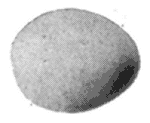
Greenish white. Range.--Mexican border of the United States and southward.

White-winged Junco. This slim-bodied, long-tailed species is grayish with a dusky
streaked, reddish brown patch on the back and a black face, chin
and throat. Their habits are similar to those of the Field
Sparrow and their nests are made near the ground in bushes,
but the eggs are plain bluish green, about like unmarked
Chipping Sparrows' eggs. Size
.65 × .50.
566. White-winged Junco. Junco aikeni.
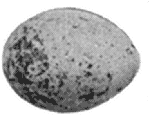
White. Range.--Breeds in the Black Hills of Dakota
and Wyoming; winters in Colorado and
casually to Kansas.
This species is like the next
but larger and with the wings
crossed by two white bars. Its
habits are like those of the common
Juncos, the nests are placed
on the ground, concealed under
overhanging rocks or tufts of
grass, and the eggs are like
those often seen of the Slate-colored Junco;
3 or 4 in number, pinkish white specked and
spotted with light reddish brown. Size .75 × .55.
|
|
|
Page 349
|

Slate-Colored Junco. 567. Slate-colored Junco. Junco hyemalis hyemalis.
Range.--North America east of the Plains,
breeding in the northern tier of states and
northward; winters in southern United States.
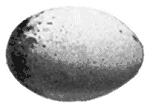
White. This species is slaty gray
on the head, neck, breast,
flanks, back, wings and central
tail feathers; the rest of
the underparts are white,
sharply defined against the
gray. They migrate through
the United States in large
flocks, usually accompanied by White-throated
or Fox Sparrows. They breed very abundantly
in the northern parts of their range, frequently
in the immediate vicinity of houses but generally
on the edges of clearings, etc., placing
their nests on the ground and generally partially
concealed by rocks, stumps, sods or logs;
the nests are made of grasses, lined with hair,
and the four or five eggs are white or greenish
white, variously speckled with reddish brown
either over the entire surface or in a wreath about the large end. Size .80 × .55.
567a. Oregon Junco. Junco hyemalis oreganus.
Range.--Pacific coast from California to Alaska, breeding north of the
United States.
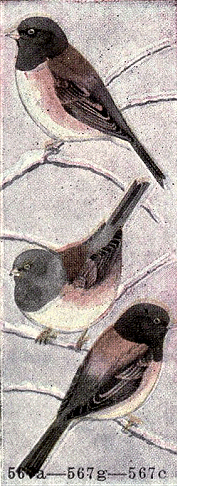
567a--567g--567c. This sub-species is entirely unlike the preceding, having a black head, neck,
throat, breast, wings and tail, and brown back; the remainder of the underparts
are white, washed with pinkish brown on the sides. The habits and nesting
habits of this western Junco are the same as those of the eastern, the birds
building in similar localities and making the nests of the same material. There
appears to be little, if any, difference between the eggs of the two varieties.
567b. Shufeldt's Junco. Junco hyemalis counectens.
Range.--Pacific coast breeding from Oregon to British
Columbia and wintering south to the Mexican boundary.
Said to be slightly larger and duller colored than the
Oregon Junco; eggs the same.
567c. Thurber's Junco. Junco hyemalis thurberi.
Range.--The Sierra Nevadas from Oregon to southern
California.
Similar to oreganus but paler and back more pinkish;
eggs will not differ.
567d. Point Pinos Junco. Junco hyemalis pinosus.
Range.--A very locally confined variety breeding in pine
woods of southwestern California, about Monterey and
Santa Cruz.
Similar to thurberi with the head and neck slaty instead
of black.
|

|
Page 350

|
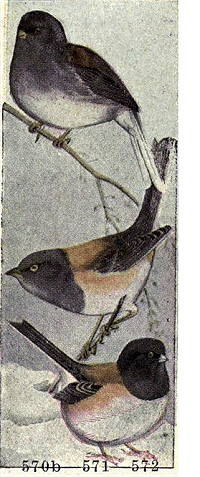
570b--571--572. 567e. Carolina Junco. Junco hyemalis carolinensis.
Range.--Alleghanies in Virginia, the Carolinas and Georgia.
A slightly larger bird than the Slate-colored Junco and
with the bill horn color instead of pinkish white. They
have been found to breed very abundantly in the higher
ranges of the Carolinas, nesting under banks, in tufts of
grass, or occasionally in small bushes, in fact in such locations
as are used by hyemalis. Their eggs which are laid
during May, June or July (probably two broods being raised)
are similar to those of the Slate-colored species but
slightly larger.
567f. Montana Junco. Junco hyemalis montanus.
Range.--From northern Idaho and Montana north to
Alberta; winters south to Mexico.
This variety is like mearnsi but darker on the head and
throat and with less pink on the sides. Its nesting habits
and eggs do not differ from those of the Pink-sided Junco.
567g. Pink-sided Junco. Junco hyemalis mearnsi.
Range.--Breeds in mountains of Idaho, Wyoming and
Montana and winters south to Mexico.
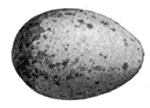
White. This species has the head and breast gray, the back brownish
and the sides pinkish brown. They breed at high altitudes
in the ranges, placing their nests of grasses under sods
or overhanging rocks; their eggs are pinkish white before
being blown and are spotted over the whole surface but more
heavily at the large end with pale reddish brown and gray.
Size .80 × .60.
570. Arizona Junco. Junco phæonotus palliatus.
Range.--Mountains of western Mexico north to southern Arizona.
Similar to the preceding species but upper mandible blackish and the gray
on throat shading insensibly into the grayish white underparts. They are quite
abundant in the higher ranges of southern Arizona, where they breed, placing
their nests on the ground in similar locations to those chosen by other Juncos;
the three or four eggs are greenish white, finely speckled chiefly about the large
end with reddish brown. Size .76 × .60.
570a. Red-backed Junco. Junco phæonotus dorsalis.
Range.--Breeds in the mountains of New Mexico and Arizona and southward.
This variety is like the last but the reddish brown on the back does not extend
to the coverts or wings. The nesting habits are like those of the last but the
eggs are only minutely specked about the large end.
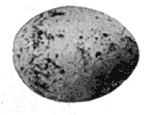
White. 570b. Gray-headed Junco. Junco phæonotus caniceps.
Range.--Rocky Mountain region from Wyoming south to Mexico.
This species is similar to the Slate-colored Junco but has a
reddish brown patch on the back. They nest on the ground in
mountainous regions, concealing the nests in tufts of grass or
under logs, stones, etc. The eggs are creamy or bluish white,
specked over the whole surface, but most numerously about the
larger end with reddish brown. Size .75 × .60. Data.--Custer
Co., Colo., June 4, 1897. Slight nest of small rootlets and fine
grass placed under a tuft of grass. Altitude over 8,000 feet.
|
|
|
Page 351
|
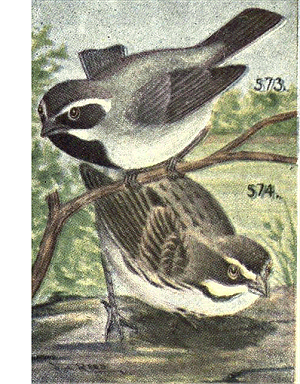
Black-throated Sparrow. 571. Baird's Junco. Junco bairdi.
Range.--Southern Lower California.
This gray headed species with rusty back
and sides is locally confined to the southern
parts of the California peninsula where it is
resident. Its eggs are not likely to differ from
those of the Pink-sided Junco which it most
nearly resembles.
567i. Townsend's Junco. Junco hyemalis townsendi.
Range.--Mountains of northern Lower California;
resident and breeding. Similar to the
Pink-sided Junco but duller colored; eggs probably
the same.
572. Guadalupe Junco. Junco insularis.
Range.--Guadalupe Island off Lower California
Resembles the Pink-sided Junco but is smaller, darker and duller colored.
They are common on the island where they nest in the pine groves, laying their
first sets in February or March. The nests are like those of the genus and the
eggs are greenish white, finely dotted with reddish brown at the large end.
Size .77 × .60.
573. Black-throated Sparrow. Amphispiza bilineata bilineata.
Range.--Breeds from central Texas to Kansas; winters in southern Texas
and Mexico.
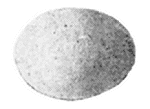
Bluish white. 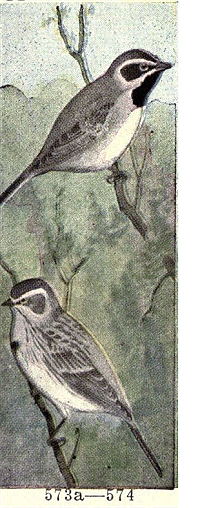
573a--574. This species is grayish brown above, with black throat, white
superciliary and line on side of throat. This is a common
species that nests on the ground or at low elevations in bushes,
making their nests of weed stems and grasses. The three to five
eggs are bluish white, unmarked and similar to those of the
Bluebird but smaller. Size .72 × .55.
573a. Desert Sparrow. Amphispiza bilineata deserticola.
Range.--Southwestern United States from western Texas
to southern California, and north to Colorado and Nevada;
winters in Mexico.
Like the last but paler above. An abundant bird among
the foothills and on plains throughout its range. Found
generally in sage brush and thickets where it nests in
bushes or on the ground laying three or four bluish white
eggs like those of the last.
574. Bell's Sparrow. Amphispiza belli.
Range.--Southern half of California and southward.
These grayish, black and white birds are abundant in
sage brush and thickets, nesting on the ground or at low
elevations in bushes, and during May or June, laying from
three to four eggs of a pale greenish white color, spotted
and blotched with reddish brown and purplish. Size .75
× .60.
|

|
Page 352

|
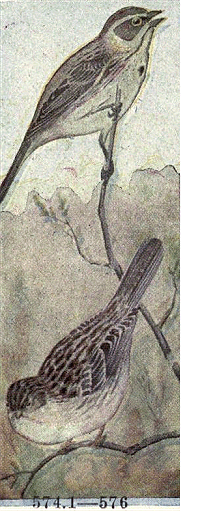
574.1--576. 574.1. Sage Sparrow. Amphispiza nevadensis nevadensis.
Range.--Sage deserts of the Great Basin from Oregon
and Montana, south to Mexico.
This sub-species is abundant throughout its range where
it nests near or on the ground, in or under bushes and generally
concealed from view. The nests are made of grass
and sage bark lined with fine grass; the eggs are like those
of the last species, greenish white, spotted and blotched
with shades of brown and purplish.
574.1a. Gray Sage Sparrow. Amphispiza nevadensis cinerea.
Range.--A smaller and paler variety found in Lower
California.
The nests and eggs of this pale variety probably do not
differ in any respect from those of the better known varieties.
[Illustration z354: 574.1--576.]
575. Pine-woods Sparrow. Peucæa æstivalis æstivalis.
Range.--Florida and southern Georgia.
These birds are common in restricted localities in their range, nesting on the
ground under bushes or shrubs; the nests are made of grasses and the four or
five eggs are pure white with a slight gloss. Size .75 × .60. The birds are said
to be fine singers and to frequent, almost exclusively, pine barrens.
475a. Bachman's Sparrow. Peucæa æstivalis bachmani.
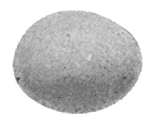
White. Range.--South Atlantic and Gulf States; north to Indiana
and Illinois.
This variety is common in most localities in its range, frequenting
pine woods and barrens chiefly, and nesting on the
ground in May or June. Their nests are made of grasses and
lined with very fine grass, and have the tops completely
arched over leaving a small entrance on the side. The eggs
are pure white with a slight gloss and measure .75 × .60.
576. Botteri's Sparrow. Peucæa botterii.
Range.--Mexican plateau north to southern Texas, New Mexico and Arizona.
They nest in abundance in tall grass in the lowlands of their range, the nests
being difficult to find because the bird flushes with great difficulty. The nests
are on the ground, made of grass, and the three to five eggs are pure white,
measuring .75 × .60.

|
|
|
Page 353
|
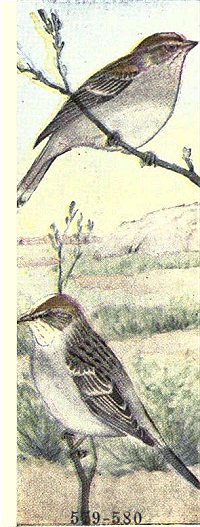
579--580. 578. Cassin's Sparrows. Peucæa cassini.
Range.--Plains and valleys from Texas and Arizona
north to Kansas and Nevada.

White. These birds breed in numbers on the
arid plains, placing their grass nests on
the ground at the foot of small bushes
or concealed in tufts of grass, and during
May lay four pure white eggs which are
of the same size and indistinguishable
from those of others of the genus.
579. Rufous-winged Sparrow. Aimophila carpalis.
Range.--Plains of western Mexico and north to southern
Arizona.
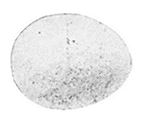
Bluish white. This pale colored bird bears a remote
resemblance to the Tree Sparrow. They
nest commonly in dry arid regions, placing
their nests at low elevations in
bushes or cacti, preferably young mesquites,
and making them of coarse grass
lined with finer. Two broods are raised
a season and from May to August sets
of four or five plain bluish white eggs may be found. Size .75 × .60.
580. Rufous-crowned Sparrow. Aimophila ruficeps ruficeps.
Range.--Local in southern half of California and in Lower California.
A brownish colored species both above and below, which is found on mountains
and hillsides in restricted localities. They nest on the ground placing their
grass structures in hollows, usually at the foot of a small bush or shrub and
well concealed. They lay from three to five pale bluish white eggs. Size
.80 × .60.
580a. Scott's Sparrow. Aimophila ruficeps scotti.
Range.--Western Texas, New Mexico and Arizona south in Mexico.
A paler species, above, than the last, and whitish below. It is quite a common
species on the mountain ranges where it nests on the ground, in clumps of
grass or beneath shrubs or overhanging rocks; the nests are made of grasses
and weeds scantily put together. The eggs are white, untinted. Size .80 × .60.
580b. Rock Sparrow. Aimophila ruficeps eremæca.
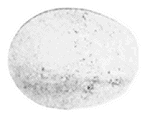
White. Range.--Middle and southern Texas and south in Mexico.
This variety frequents rocky mountain sides where it nests
abundantly under rocks or at the foot of shrubs, the nests
being made of coarse grasses loosely twisted together and
lined with finer grass. The birds are shy and skulk off
through the underbrush upon the approach of anyone so that
the nests are quite difficult to find. The three to five eggs are
pure white and of the same size as those of the last.
580c. Laguna Sparrow. Aimophila ruficeps sororia.
Range.--Mountains of southern Lower California.
The nests and eggs of this very similar variety to ruficeps proper are not
likely to differ in any particular from those of that species.
|

|
Page 354

|
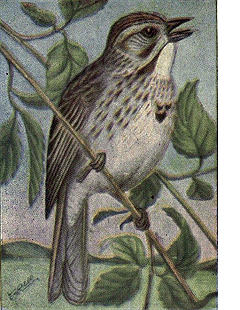
Song Sparrow. 581. Song Sparrow. Melospiza melodia melodia.
Range.--North America, east of the Plains,
breeding from Virginia to Manitoba and New
Brunswick, and wintering chiefly in the southern
half of the United States.
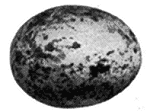
White. A favorite and one of the
most abundant in all sections
of the east. They are sweet
and persistent songsters and
frequent side hills, pastures,
roadsides, gardens and dooryards
if English Sparrows be
not present. They nest indifferently
upon the ground or in bushes, generally
artfully concealing the nest by drooping
leaves; it is made of grass and weed stems,
lined with fine grass or, occasionally, horse
hair. As is usual in the case of birds that
abound about habitations they frequently
choose odd nesting sites. They lay two and
sometimes three sets of eggs a season, from May to August, the eggs being
three to five in number and white or greenish white, marked, spotted, blotched
or splashed in endless variety of pattern and intensity, with many shades of
brown; some eggs are very heavily blotched so as to wholly obscure the ground
color while others are specked very sparingly. They measure .80 × .60 with
great variations.
581a. Desert Song Sparrow. Melospiza melodia fallax.
Range.--Desert regions of southern Nevada, Arizona and southeastern California.
The eggs of this very pale form are the same as those of the last.
581b. Mountain Song Sparrow. Melospiza melodia montana.

581a--581c--581e. Range.--Rockies and the Great Basin from Oregon and Montana southward.
This variety is paler than the Song Sparrow but darker than fallax. Eggs
the same.
581c. Heerman's Song Sparrow. Melospiza melodia heermanni.
Range.--California, west of the Sierra Nevadas.
Similar to melodia but with less brown and the markings
blacker and more distinct. The nesting habits are the same
and the eggs similar to large dark specimens of the eastern
Song Sparrow. Size .85 × .62.
581d. Samuels Song Sparrow. Melospiza melodia samuelis.
Range.--Coast regions of California, chiefly in the
marshes.
Similar to the last but smaller. They nest on the ground
in marsh grass, usually in sandy districts along the shore.
The eggs average smaller than those of melodia. Size
.78 × .58.
581e. Rusty Song Sparrow. Melospiza melodia morphna.
Range.--Pacific coast of Oregon and British Columbia.
A dark species with the upper parts dark reddish brown
and heavily streaked with the same below. The nesting
habits and eggs are like those of melodia.
|
|
|
Page 355
|
581f. Sooty Song Sparrow. Melospiza melodia rufina.
Range.--Pacific coast from British Columbia to Alaska.
A darker bird, both above and below, even than the last. Eggs like the last
but averaging a trifle larger. Size .82 × .62.
581g. Brown's Song Sparrow. Melospiza melodia rivularis.
Range.--Southern Lower California.
A light colored form like the Desert Song Sparrow; said to build in cat tails
above water as well as on the ground; eggs not different from others of the
genus.
581h. Santa Barbara Song Sparrow. Melospiza melodia graminea.
Range.--Breeds on Santa Barbara Islands; winters on adjacent coast of California.
A variety of the same size but paler than samuelis. Nesting or eggs not
peculiar.
581i. San Clemente Song Sparrow. Melospiza melodia clementæ.
Range.--San Clemente and Santa Rosa Island of the Santa Barbara group.
Slightly larger than the last; habits and eggs the same.
581j. Dakota Song Sparrow. Melospiza melodia juddi.
Range.--North Dakota, breeding in the Turtle Mountains.
Practically indistinguishable from the common Song Sparrow; the eggs will
not differ.
581k. Merrill's Song Sparrow. Melospiza melodia merrilli.
Range.--Northwestern United States; eastern Oregon and Washington to
Idaho.
Very similar to, but lighter than the Rusty Song Sparrow.
581l. Alameda Song Sparrow. Melospiza melodia pusillula.
Range.--Salt marshes of San Francisco Bay, California.
Similar to, but still smaller than Samuel Song Sparrow. Eggs will not differ.
581m. San Diego Song Sparrow. Melospiza melodia cooperi.
Range.--Southern coast of California; north to Monterey Bay.
Similar to, but smaller and lighter than heermanni.
581n. Yakutat Song Sparrow. Melospiza melodia caurina.
Range.--Coast of Alaska from Cross Sound to Prince Williams Sound.
Similar to the Sooty Song Sparrow but larger and grayer. Eggs probably
average larger.
581o. Kenai Song Sparrow. Melospiza Melodia kenaiensis.
Range.--Kenai Peninsula on the coasts.
Like the last but still larger; length about 7 inches.
581q. Bischoff's Song Sparrow. Melospiza melodia insignis.
Range.--Kadiak Island, Alaska.
Similar to and nearly as large as the next species, but browner.
581r. Aleutian Song Sparrow. Melospiza melodia sanaka.
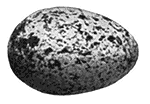
Greenish white. Range.--Found on nearly all the islands of the Aleutian group, excluding
Kadiak.
This is the largest of the Song Sparrows being nearly 8
inches in length; it is similar in appearance to the Sooty
Song Sparrow but grayer. It nests either on the ground or
at low elevations in bushes, the nest usually being concealed
in a tuft of grass or often placed under rocks or,
sometimes, driftwood along the shores. The nests are
made of grasses and weed stems, and the eggs are similar
to those of the Song Sparrow but much larger and more
elongate. Size .90 × .65.
|

|
Page 356

|
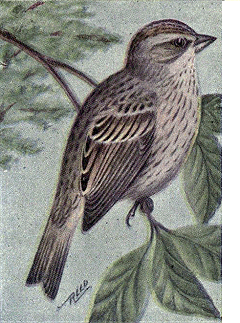
Lincoln's Sparrow. 583. Lincoln's Sparrow. Melospiza lincolni lincolni.
Range.--North America, breeding from
northern United States north to the Arctic regions;
most abundant in the interior and the
west; rare in New England.
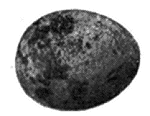
Greenish white. This bird is shy and retiring
and skulks off through
the underbrush of thickets
and swamps that it frequents
upon the approach of anyone;
consequently it is often little
known in localities where it
is quite abundant. They nest
on the ground like Song Sparrows, and rarely
in bushes. Their eggs are very similar to
those of the Song Sparrow, three or four in
number, greenish white in color, heavily spotted
and blotched with chestnut and gray. Size
.80 × .58.
583a. Forbush's Sparrow. Melospiza lincolni striata.
Range.--Pacific coast of Oregon and British Columbia.
Similar to the preceding but darker and browner. Eggs probably like those
of the last.
584. Swamp Sparrow. Melospiza georgiana.
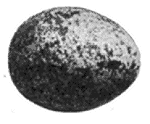
Greenish white. Range.--North America, east of the Plains, breeding from
middle United States north to Labrador and Hudson Bay.
This common and dark colored Sparrow frequents swampy
places where it breeds; owing to its sly habits it is not
commonly seen during the breeding season. Its nests are
made of grasses and located on the ground usually in places
where the walking is extremely treacherous. The eggs are
similar to those of the Song Sparrow but are generally
darker and more clouded and average smaller. Size .75 × .55.
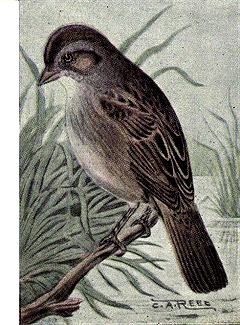
Swamp Sparrow. 585. Fox Sparrow. Passerella iliaca iliaca.
Range.--Eastern North America, breeding
from southern Canada northward, and northwest
to Alaska; winters in southern United
States.
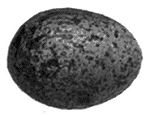
Greenish white. This large handsome species, with its mottled
grayish and reddish brown plumage and
bright rufous tail, is very common in eastern
United States during migrations, being found
in open woods and hedges in
company with Juncos and
White-throated Sparrows,
with which species their song
vies in sweetness. They nest
usually on the ground, but
sometimes in low bushes; the
nests are made of grasses and
are concealed beneath the
overhanging branches of bushes or evergreens.
The three or four eggs are greenish-white,
spotted and blotched with brown. Size .94 × .68.
|
|
|
Page 357
|
585a. Shumagin Fox Sparrow. Passerella iliaca unalaschensis.
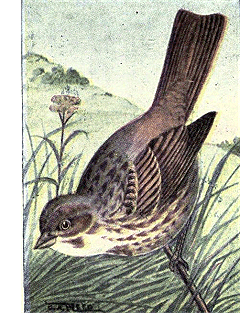
Fox Sparrow. Range.--Shumagin Islands and the Alaska
coast to Cook Inlet.
Similar to the last but paler, being one of the
several recent unsatisfactory subdivisions of
this genus. The nesting habits and eggs of all
the varieties are like those of the common eastern
form.
585b. Thick-billed Sparrow. Passerella iliaca megarhyncha.
Range.--Mountains of eastern California and
western Nevada; locally confined.
Entire upper parts and breast spots gray;
wings and tail brown. It nests in the heaviest
underbrush of the mountain sides, building on
or close to the ground.
585c. Slate-colored Sparrow. Passerella iliaca schistacea.
Range.--Rocky Mountain region, breeding from Colorado to British Columbia.
This variety which is similar to, but smaller than the last, nests in thickets
along the mountain streams. The eggs are like those of iliaca, but average
smaller.
585d. Stephen's Sparrow. Passerella iliaca stephensi.
Range.--Breeds in the San Bernadino and San Jacinto Mts. in southern California.
Like the Thick-billed Sparrow, but bill still larger and bird slightly so.
585e. Sooty Fox Sparrow. Passerella iliaca fuliginosa.
Range.--Coast of Washington and British Columbia; south to California in
winter.
585f. Kadiak Fox Sparrow. Passerella iliaca insularis.
Range.--Breeding on Kadiak Island; winters south to California.
Like the last but browner above and below.
585g. Townsend's Fox Sparrow. Passerella iliaca townsendi.
Range.--Southern coast of Alaska; winters south to California. Like the last
but more rufous above.
Upperparts and tail uniform brownish umber, below heavily spotted.
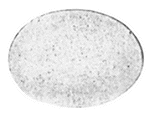
White. 586. Texas Sparrow. Arremonops rufivirgatus.
Range.--Eastern Mexico and southern Texas.
This odd species has a brownish crown, olive greenish upperparts, wings and
tail, and grayish white underparts. They are common resident
birds along the Lower Rio Grande, being found in tangled
thickets, where they nest at low elevations, making their
quite bulky nests of coarse weeds and grass and sometimes
twigs, lined with finer grass and hair; they are often partially
domed with an entrance on the side. Their eggs are plain
white, without markings; often several broods are raised in a
season and eggs may be found from May until August.
|

|
Page 358

|
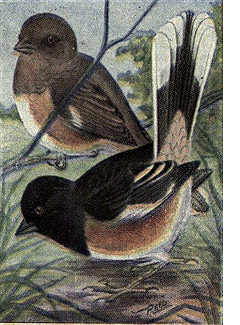
Towhee or Chewink. 587. Towhee. Pipilo erythrophthalmus erythrophthalmus.
Range.--North America east of the Plains,
breeding from the Gulf to Manitoba.
The well known Towhee, Ground Robin or
Chewink is a bird commonly met with in eastern
United States; it frequents thickets,
swamps and open woods where they nest generally
upon the ground and sometimes in
bushes near the ground.
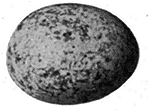
Purplish white. The nests are well
made of grasses, lined with
fine grasses and rootlets,
and the eggs, which are laid
in May or June, are pinkish
white, generally finely
sprinkled but sometimes
with bold markings of light
reddish brown, with great
variations. Size .90 × .70.
Towhees are noisy birds and at frequent intervals,
while they are scratching among the
leaves for their food they will stop and utter their familiar "tow-hee" or "che-wink"
and then again will mount to the summit of a tree or bush and sing their
sweet refrain for a long time.
587a. White-eyed Towhee. Pipilo erythrophthalmus alleni.
Range.--Florida and the Atlantic coast to South Carolina.
This variety is like the preceding except that the eyes are white instead of
red. There is no difference between their nesting habits and eggs, except that
they much more frequently, and in some localities, almost always, nest in trees.
588. Arctic Towhee. Pipilo maculatus arcticus.
Range.--Great Plains, breeding from northern United States to the Saskatchewan.
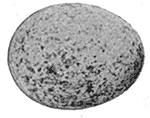
Pinkish white. This species is similar to the eastern Towhee but has the scapulars and
coverts tipped with white. They nest abundantly in suitable
localities in Montana and North Dakota and more commonly
north of our borders. Like the eastern Towhee, they
nest on the ground under the protection of overhanging
bushes, the nests being made of strips of bark and grasses
and lined with fine rootlets. Their three or four eggs, which
are laid during May, June or July, are pinkish white, profusely
speckled with reddish brown; very similar to those
of the eastern Towhee. Size .92 × .70.
588a. Spurred Towhee. Pipilo maculatus montanus.
Range.--Breeds from Mexico to British Columbia, west of the Rockies.
Similar to the last but with less white on the back. The nesting habits and
eggs are like those of the Towhee, but in some localities the nests are most
often found in bushes above the ground.
|
|
|
Page 359
|
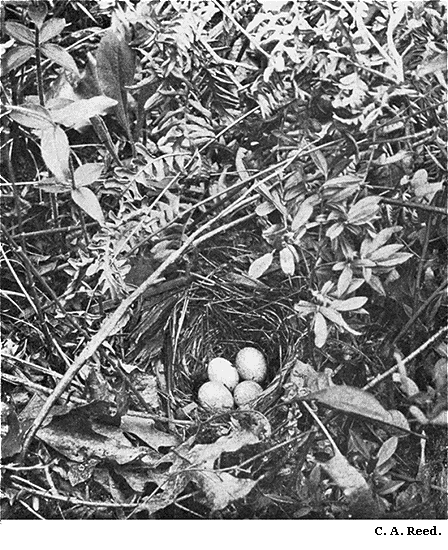
NEST AND EGGS OF TOWHEE.
|
|
Page 360

|
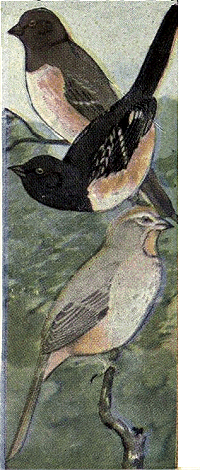
588b--591. 588b. Oregon Towhee. Pipilo maculatus oregonus.
Range.--Pacific coast from California to British Columbia;
winters to Mexico. Similar to the last but with still
fewer white markings on the back and the chestnut flanks
brighter. The nesting habits and eggs of this variety
differ in no essential particular from those of the preceding
Towhees.
588c. San Clemente Towhee. Pipilo maculatus clementæ.
Range.--San Clemente Is. and other of the Santa Barbara
group.
Black of male said to be duller. Probably no difference
between the eggs and others.
588d. San Diego Towhee. Pipilo maculatus megalonyx.
Range.--Coast of southern California and Lower California.
Said to be darker than megalonyx.
588e. Large-billed Towhee. Pipilo maculatus magnirostris.
Range.--Southern Lower California. Similar to arcticus; bill said to be larger.
589. Guadalupe Towhee. Pipilo consobrinus.
Range.--Guadalupe Island, Lower California.
Similar to oregonus but smaller and with a relatively shorter tail. The nesting
habits and eggs of this species will not likely be found to differ essentially
from those of others of the genus.
591. Canon Towhee. Pipilo fuscus mesoleucus.
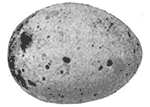
Greenish blue. Range.--Mexico and north to Arizona and New Mexico and casually farther
to Colorado.
A common species in the valleys and on the side hills,
nesting in bushes near the ground, and sometimes on
the ground; the nests are made of grasses, weeds and twigs
lined with rootlets, and the three or four eggs are greenish
blue sparingly spotted or scrawled with blackish brown, the
markings being similar to those on many Red-winged
Blackbirds' eggs. Size 1.00 × .70.
591a. San Lucas Towhee. Pipilo fuscus albigula.
Range.--Southern Lower California.
This variety is like the last but is usually paler below. It is abundant in the
region about the cape where they nest in thickets, either in the bushes or on
the ground. The eggs cannot be distinguished from those of the Canon Towhee.
591b. California Towhee. Pipilo crissalis crissalis.
Range.--Pacific coast of California.
This variety is similar to the Canon Towhee but is browner, both above and
below. They are one of the most common of California birds, frequenting
scrubby thickets, both on mountain sides and in valleys and canons, from
which their harsh scolding voice always greets intruders.
|
|
|
Page 361
|
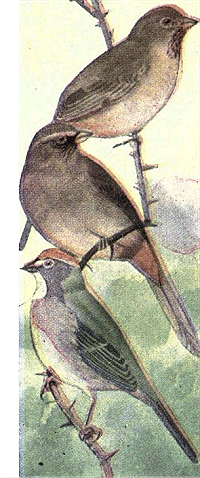
591.1--592--592.1. They place their
nests in bushes at low elevations from the ground and sometimes on the
ground; they are made of twigs, strips of bark, weeds and coarse
grasses, lined with fine rootlets. Their three or four eggs
are laid in April or May; they are light bluish green marked
like the others with purplish or brownish black. Size
.95 × .72.
591.1a. Anthony's Towhee. Pipilo crissalis senicula.
Range.--Southern California and south through Lower
California.
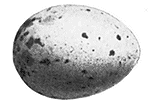
Greenish blue. A very similar bird to the last but
sightly smaller and lighter below.
The habits and nesting habits of
these birds are in every way identical
with those of the California Towhee
and the eggs cannot be distinguished
from those of that variety.
They are fully as abundant in the
southern parts of California as the
others are in the northern.
592. Abert's Towhee. Pipilo aberti.
Range.--Arizona and New Mexico north to Colorado
and Nevada and east to southeastern California.
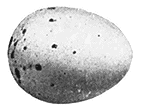
Greenish blue. This bird is wholly brownish gray both above and below
shading into reddish brown on the under tail coverts; the
face is black. They are abundant in the valleys of Arizona
and New Mexico, but unlike the preceding species, they
are generally wild and shy. They nest in chaparral thickets
along streams, the nests being constructed similarly to
those of the California Towhee, and the eggs are not easily
distinguishable from those of that species, but they are
usually more sparsely specked and the markings more distinct.
Size 1.00 × .75.
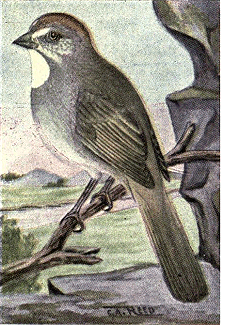
Green-tailed Towhee. 592.1. Green-tailed Towhee. Oreospiza chlorura.
Range.--Western United States, chiefly west
of the Rockies from Montana and Washington
south to Mexico; wintering in southwestern
United States.
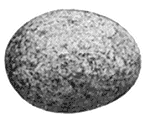
Whitish. This handsome and entirely different plumaged
species from any of the preceding would,
from appearance, be better placed in the group
with the White-throated Sparrow than its present
position. It has a reddish brown crown,
the remainder of the upper
parts, wings and tail being
greenish yellow; the throat
is white, bordered abruptly
with gray on the breast and
sides of head. These birds
place their nests on the
ground. The nests are built
similarly to those of the eastern
Towhee, and the eggs, too, are similar, being
whitish, finely dotted and specked with
reddish brown, the markings being most numerous
around the larger end. Size .85 × .65.
|

|
|
Page 362
|
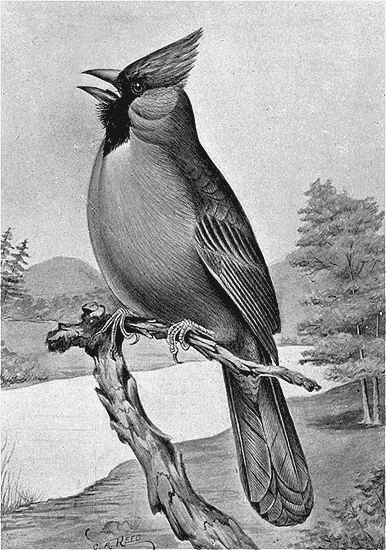
CARDINAL.
|
|
|
Page 363
|
593. Cardinal. Cardinalis cardinalis cardinalis.
Range.--Eastern United States, north to New York and Illinois, west to the
Plains and Texas. Resident in most of its range.
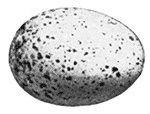
Bluish white. These beautiful fiery red and crested songsters are one of the most attractive
of our birds, and in their range, nest about habitations as
freely as among the thickets and scrubby brush of wood
or hillside. Their nests are rarely placed higher than ten
feet from the ground in bushes, branches, vines, brush
piles or trees; they are loosely made of twigs, coarse
grasses and weeds, shreds of bark, leaves, etc., and lined
with fine grass or hair. They frequently lay two or three
sets of eggs a season, the first being completed usually
early in May; three or four, and sometimes five, white or
pale bluish white eggs are laid; they are very varied in markings but usually
profusely spotted, more heavily at the large end, with reddish brown and
lavender. Size 1.00 × .70.
593a. Arizona Cardinal. Cardinalis cardinalis superbus.
Range.--Northwestern Mexico and southern Arizona.
A larger and more rosy form of the Cardinal. Its eggs cannot be distinguished
from those of the eastern Redbird.
593b. San Lucas Cardinal. Cardinalis cardinalis igneus.
Range.--Southern Lower California.
Like the last but smaller and with less black on the forehead; eggs the same.
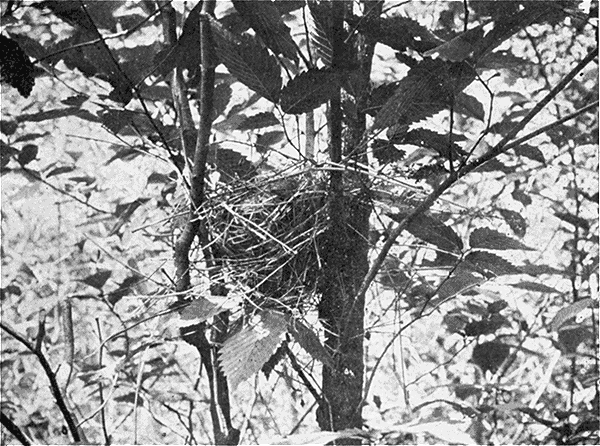
NEST OF CARDINAL.
|

|
Page 364

|
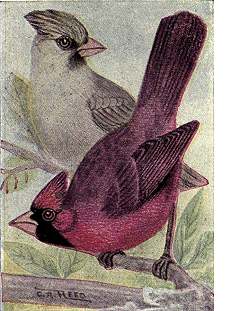
Cardinal. 593c. Gray-tailed Cardinal. Cardinalis cardinalis canicaudus.
Range.--Northeastern Mexico and southern Texas.
The male of this species is like the eastern
Cardinal but the female is said to be grayer.
The nesting habits are the same and the eggs
identical with those of the latter.
593d. Florida Cardinal. Cardinalis cardinalis floridanus.
Range.--Southern Florida.
Supposed to be a deeper and richer shade of
red. Eggs like those of cardinalis.
594. Arizona Pyrrhuloxia. Pyrrhuloxia sinuata sinuata.
Range.--Northwestern Mexico and the southern
border of New Mexico, Arizona and western Texas.

Bluish white. This species is of similar form and crested like a Cardinal,
but the bill is very short and hooked like that of a Parrot; the
plumage is grayish, with wings and tail dull reddish; face
and throat, and middle of belly rosy red. Their habits are
the same as those of the Cardinal, but their nests are said to
be slighter; they are placed in similar locations to those of
the latter, the two species often nesting together in the same
thicket. Their eggs are like those of the Cardinal but average
smaller, although the ranges overlap so that the eggs cannot
be distinguished. Size .90 x .70. Data.--San
Antonio, Texas, May 16, 1889. Nest of fine
grasses, lined with rootlets; 4 feet from ground
in a mesquite tree.
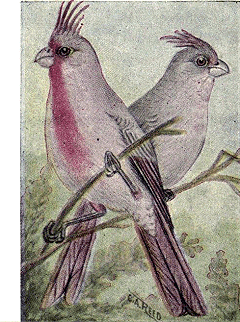
Texas Pyrrhuloxia. 594a. Texas Pyrrhuloxia. Pyrrhuloxia sinuata texana.
Range.--Northeastern Mexico and southern Texas.
Said to be grayer and the bill to average
larger than that of the last. There are no differences
in the nesting habits or eggs between
the two varieties.
594b. San Lucas Pyrrhuloxia. Pyrrhuloxia sinuata peninsulæ.
Range.--Southern Lower California.
Smaller than the Arizona Cardinal but with
a larger bill. The eggs are like those of the
others but may average a trifle smaller.
|
|
|
Page 365
|
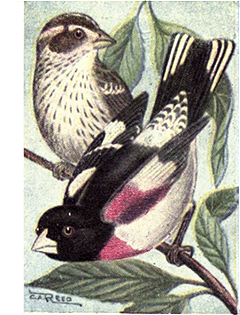
Rose-breasted Grosbeak. 595. Rose-breasted Grosbeak. Zamelodia ludoviciana.

Greenish blue. Range.--United States,
east of the Plains, breeding
from the Middle States
and Ohio north to Manitoba
and Nova Scotia.
This beautiful black and
white bird with rosy red
breast and under wing coverts,
is one of the most
pleasing of our songsters. They nest either in
bushes or trees, generally between six and
twenty feet from the ground and usually in
thick clumps of trees or scrubby apple trees.
The three or four eggs, which are laid in June,
are greenish blue, spotted, most heavily about
the larger end, with reddish brown. Size 1.00
× .75. Data.--Worcester, Mass., June 5, 1899.
Nest of twigs and rootlets in small apple tree
in woods; nest very frail, eggs showing through
the bottom.
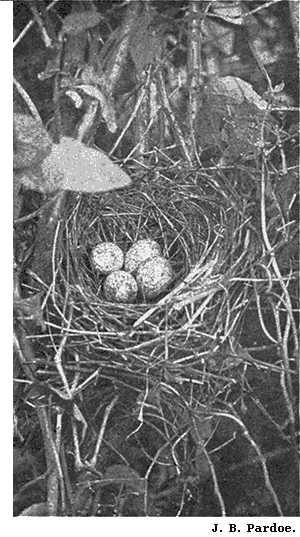
NEST OF ROSE-BREASTED GROSBEAK.
596. Black-headed Grosbeak. Zamelodia melanocephala.
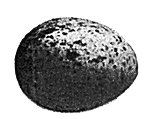
Pale greenish white. Range.--United
States, west of
the Plains, breeding
from Mexico
north to British
Columbia; winters
south of the United States.
This species is of the size of the last
(8 inches long), and is a bright cinnamon
brown color with black head, and
black and white wings and tail. The
habits of this bird are the same as
those of the Rose-breasted Grosbeak
and its song is very similar but more
lengthy. Their nests, like those of the
last, are very flimsy structures placed
in bushes or trees, usually below twenty
feet from the ground; they are open
frameworks of twigs, rootlets and
weed stalks, through which the eggs
can be plainly seen. The eggs are
similar to those of the preceding but
are usually of a paler color, the markings,
therefore showing with greater
distinctness. Size 1.00 × .70.
|

|
Page 366

|

Blue Grosbeak. 597. Blue Grosbeak. Guiraca cærulea.
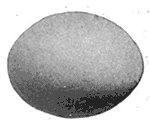
Bluish white. Range.--Southeastern United
States, breeding from the
Gulf north to Pennsylvania
and Illinois, and casually to
New England.
Smaller than the last two
species and deep blue, with
wings and tail blackish, and
the lesser coverts and tips of
greater, chestnut. It is a fairly common species
in the southerly parts of its range, nesting
most frequently in low bushes or vines
in thickets; the nest is made of rootlets, weed
stalks and grasses and sometimes leaves. The
three or four eggs are bluish white, unmarked.
Size .85 × .65. Data.--Chatham Co., Ga., June
10, 1898. 3 eggs. Nest of roots, leaves and
snake skin, lined with fine rootlets, 3 feet from
the ground in a small oak bush.
597a. Western Blue Grosbeak. Guiraca cærulea lazula.
Range.--Western United States north to Kansas, Colorado and northern California.
Slightly larger than the last and lighter blue; nests the same and egg not distinctive.
598. Indigo Bunting. Passerina cyanea.
Range.--United States, east of the Plains, breeding north to Manitoba and
Nova Scotia; winters south of the United States.
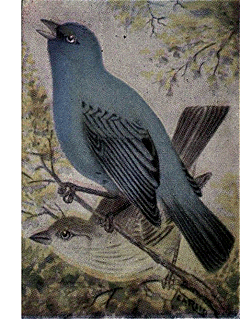
Indigo Bunting. This handsome species is rich indigo on the
head and neck, shading into blue or greenish
blue on the upper and under parts. They are
very abundant in some localities along roadsides,
in thickets and open woods, where their
song is frequently heard, it being
a very sweet refrain resembling,
somewhat, certain
passages from that of the
Goldfinch.
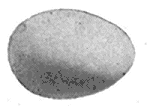
Pale bluish white. They nest at low
elevations in thickets or
vines, building their home of
grass and weeds, lined with
fine grass or hair, it being quite a substantial
structure. The eggs, which are laid in June
or July, are pale bluish white. Size .75 × .52.
599. Lazuli Bunting. Passerina amœna.
Range.--Western United States, breeding
from Mexico to northern United States and the
interior of British Columbia; east to Kansas.
This handsome bird is of the size of cyanea,
but is azure blue above and on the throat, the
|
|
|
Page 367
|
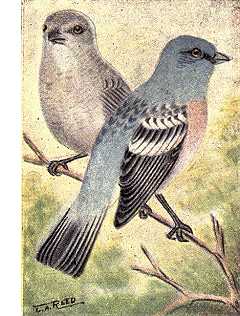
Lazuli Bunting. breast being brownish and the rest of the underparts,
white.
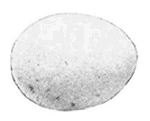
Pale bluish white. It is the western representative
of the Indigo Bunting, and its
habits and nesting habits are
in all respects the same as
those of that species, the
nests being made of twigs,
grasses, strips of bark, weeds,
leaves, etc. The eggs are like
those of the last, pale bluish
white. Size .75 × .55.
600. Varied Bunting. Passerina versicolor.
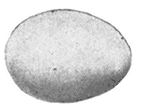
Pale bluish white. Range.--Mexico and north to southern Texas.
The general color of this odd bird is purplish,
changing to bright blue on the crown and
rump, and with a reddish
nape. They are quite abundant
in some localities along
the Lower Rio Grande, where
they nest in bushes and tangled
under brush, the nests being like those of the last
species, and rarely above five feet from the ground. The eggs
are pale bluish white, three or four in number, and laid during
May or June. Size .75 × .55.
600a. Beautiful Bunting. Passerina versicolor pulchra.
Range.--Southern Lower California.
Slightly smaller but very similar to the last; eggs will not differ.
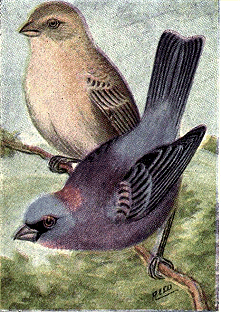
Varied Bunting. 601. Painted Bunting. Passerina ciris.
Range.--South Atlantic and Gulf States; north to Illinois in the interior.
Without exception, this is the most gaudily
attired of North American birds, the
whole underparts being red, the head and
neck deep blue, the back yellowish green, and
the rump purple, the line of demarcation between
the colors being sharp. They are frequently
kept as cage birds but more for their
bright colors than any musical ability, their
song being of the character of the Indigo Bunting,
but weaker and less musical.
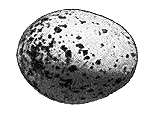
White. They are
very abundant in the South Atlantic and Gulf
States, where they nest usually
in bushes or hedges at low
elevations, but occasionally
on branches of tall trees.
Their nests are made of
weeds, shreds of bark,
grasses, etc., lined with fine
grass, very much resembling
that of the Indigo. Their
eggs are laid in May, June or July, they frequently
raising two broods; they are white or
pale bluish white, speckled with reddish
brown. Size .75 × .55.
|

|
Page 368

|
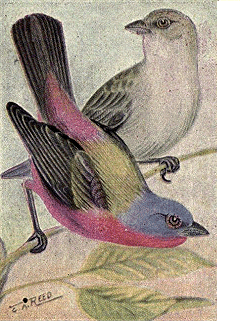
Painted Bunting. 602. Sharpe's Seed-eater. Sporophila morelleti morelleti.
Range.--Eastern Mexico, breeding north to
the Lower Rio Grande Valley in Texas.
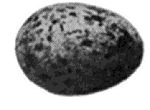
Greenish blue. This peculiar, diminutive Finch is but 4.5
inches in length, and in plumage is black, white
and gray. In restricted localities in southern
Texas, they are not uncommon during the summer
months. They build in bushes or young
trees at low elevations making their nests of
fine grasses or fibres, firmly woven together
and usually placed in an upright
crotch. The eggs are pale
greenish blue, plentifully speckled
with reddish and umber
brown, and some markings of
lilac. Size .65 × .45. Data.--Brownsville,
Texas, May 7, 1892.
Nest of fine fibre-like material lined with horse
hairs, on limb of small tree in open woods near
a lake of fresh water; 6 feet above ground.
Collector, Frank B. Armstrong. This set is in
the collection of Mr. C. W. Crandall.
603. Grassquit. Tiaris bicolor.
Range.--This small Finch is a Cuban species which casually strays to southern
Florida.
They are abundant on the island, building large arched nests of grass, with a
small entrance on the side. They lay from three to six white eggs, specked with
brown. Size .65 × .50.
603.1 Melodious Grassquit. Tiaris canora.
Another Cuban Finch which has been taken in the Florida Keys. Eggs like
the last.
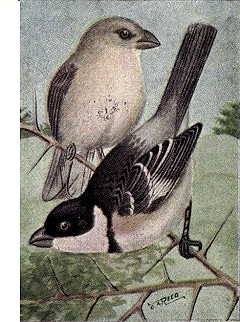
Sharpe's Seed-eater. 604. Dickcissel. Spiza americana.
Range.--Interior of the United States, breeding
from the Gulf to northern United States,
west to the Rockies, east to the Alleghanies.

Bluish white. A sparrow-like Bunting with a yellow breast
patch, line over eye and on side of throat;
throat black, chin white and wing coverts chestnut.
These sleek-coated, harmoniously colored
birds are very common in dry bush-grown pastures
and on the prairies.
They are very persistent
singers, and their song, while
very simple, is welcome on
hot days when other birds
are quiet. They nest anywhere,
as suits their fancy,
on the ground, in clumps of
grass, in clover fields, bushes,
low trees, or in thistles. The nests are made
of weeds, grasses, leaves and rootlets, lined
with fine grass, and the three to five eggs are
bluish white. Size .80 × .60.
|
|
|
Page 369
|

Dickcissel. 605. Lark Bunting. Calamospiza melanocorys..
Range.--A bird of the Plains, abundant from
western Kansas to eastern Colorado and north
to the Canadian border; winters in Mexico.
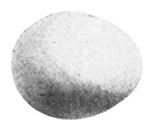
Bluish white. These black and white birds have a sweet
song which they often utter while on the wing
after the manner of the Bobolink,
all their habits being
similar to those of this bird,
except that this species likes
the broad dry prairies where
it nests on the ground under
the protection of a tuft of
grass or a low bush. Their
four or five eggs are like
those of the last but slightly larger. Size .85
× .65. Data.--Franklin Co., Kansas. 4 eggs.
Nest in cornfield in a hollow on the ground at
the base of a stalk; made of straw and weeds.
TANAGERS. Family TANAGRIDÆ
607. Western Tanager. Piranga ludoviciana.
Range.--United States, west of the Plains and north to British Columbia.
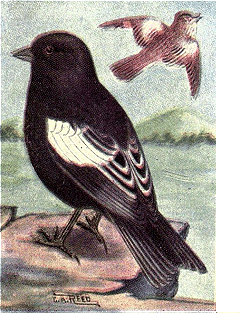
Lark Bunting. 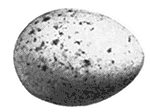
Bluish green. This handsome species is black and yellow, with an orange or reddish head.
They are common and breed in suitable localities through their range, nesting
as do the eastern Tanagers in trees usually at a low elevation, the nests being
saddled on the forks of horizontal branches; they are made of rootlets, strips
of bark, and weed stalks,
and are usually frail like
those of the Grosbeaks.
Their eggs, which are laid
in May or June, are bluish
green, specked with brown
of varying shades. Size
.95 × .65.
608. Scarlet Tanager. Piranga erythromelas.
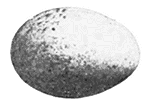
Greenish blue. These beautiful scarlet
and black birds frequent,
chiefly, woodlands, although
they are very often
found breeding in orchards
and small pine
groves. They are quiet
birds, in actions, but their
loud warbling song is
heard at a great distance, and is readily recognized
by its peculiarity.
|

|
Page 370

|
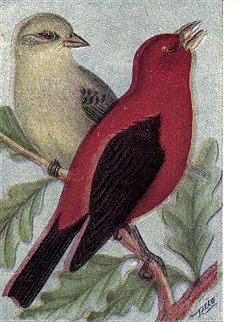
Scarlet Tanager. They nest upon horizontal limbs or forks at elevations of four to
twenty feet, making frail nests of twigs, rootlets
and weeds; they are often found in pine
trees, but apparently just as frequently in
other kinds. Their eggs are greenish blue,
specked and spotted with various shades of
brown. Size .95 × .65. Data.--Holden, Mass.,
May 31, 1898. Nest on low limb of an oak, 4
feet above ground; of weeds and rootlets and
very frail.
609. Hepatic Tanager. Piranga hepatica.
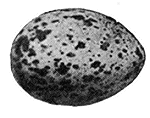
Bluish green. Range.--Western Mexico,
north to New Mexico and Arizona
in summer.
This species is similar to
the next but is darker red on
the upper parts and bright
vermilion below. They nest
on the lower horizontal
branches of trees, usually live oaks, making
the nests of rootlets and weeds; the eggs are bluish green, like those of the
next, but the markings appear to average more blotchy and brighter. Size
.92 × .64.
610. Summer Tanager. Piranga rubra rubra.
Range.--Eastern United States, breeding from the Gulf to New York and Kansas,
and casually farther; west to Texas; winters south of our borders.
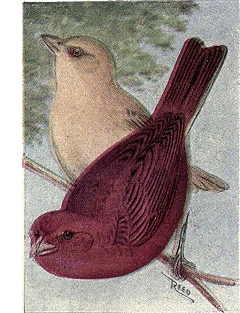
Summer Tanager. This bird is of the size of the Scarlet Tanager, but is of a uniform rosy red
color, darker on the back. They are very common in the South Atlantic and
Gulf States. Their nests are located at low elevations on horizontal branches
of trees in open woods, edges of clearings, or
along the roadside; the nests are made of
strips of bark, weed stems, leaves, etc., and are
frail like those of the other Tanagers.
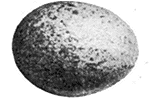
Light bluish green. Their
eggs are light bluish green,
speckled and spotted with
reddish brown, and not
distinguishable with certainty
from those of the
Scarlet Tanager. Size .92 × .64.
610a. Cooper's Tanager. Piranga rubra cooperi.
Range.--Western United States, breeding
from the Mexican border and Texas north to
central California and Nevada.
Similar to but slightly larger than the last.
There are no differences between the nesting
of this form and the last and the eggs are not
in any way different.
|
|
|
Page 371
|

SCARLET TANAGER.
|
|
Page 372

|
SWALLOWS. Family HIRUNDINIDÆ
611. Purple Martin. Progne subis subis.
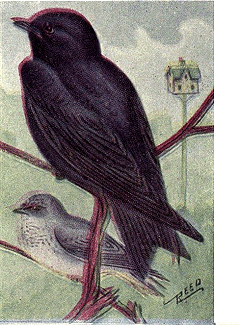
Purple Martin. Range.--Breeds throughout the United States
and temperate British America; winters in
South America.
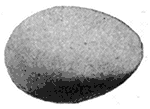
White. These large, lustrous, steely-blue Swallows
readily adapt themselves to civilization and,
throughout the east, may be found nesting in
bird houses, provided by appreciative land
owners or tenants; some of these houses are
beautiful structures modeled
after modern residences and
tenanted by twenty or thirty
pairs of Martins; others are
plain, unpainted soap boxes
or the like, but the birds
seem to take to one as kindly
as the other, making nests in
their compartments of weeds, grass, mud,
feathers, etc. They also, and most commonly
in the west, nest in cavities of trees making
nests of any available material. During June
or July, they lay from four to six white eggs;
size .95 × .65. Data.--Leicester, Mass., June
16, 1903. 5 eggs in Martin house; nest of
grasses.
611a. Western Martin. Progne subis hesperia.
Range.--Pacific coast from Washington south.
The nesting habits, eggs, and birds of this form are identical with those found
in the east.
611.1. Cuban Martin. Progne cryptoleuca.
Range.--Cuba and southern Florida (in summer).
Slightly smaller than the Purple Martin and
the eggs average a trifle smaller.
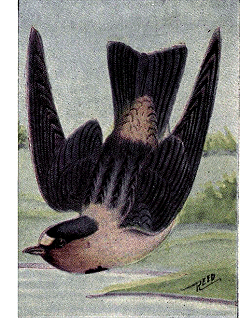
Cliff Swallow. 612. Cliff Swallow. Petrochelidon lunifrons lunifrons.
Range.--Whole of North America, breeding
north from the south Atlantic and Gulf States.

White. These birds can easily be recognized
by their brownish throat
and breast, whitish forehead and
buffy rump. They build one of
the most peculiar of nests, the
highest type being a flask
shaped structure of mud securely
cemented to the face of a cliff or under the
eaves of a building, the entrance being drawn
out and small, while the outside of the nest
proper is large and rounded; they vary from
this typical nest down to plain mud platforms,
but are all warmly lined with grass and
feathers.
|
|
|
Page 373
|

Barn Swallow. In some localities, cliffs resemble
bee hives, they having thousands of these nests
side by side and in tiers. Their eggs are
creamy white spotted with reddish brown;
size .80 × .55 with great variations. Data.--Rockford,
Minn., June 12, 1890. Nest made
of mud, lined with feathers; placed under the
eaves of a freight house.
612.1. Cuban Cliff Swallow. Petrochelidon fulva.
Range.--West Indies and Central America;
accidental on Florida Keys.
613. Barn Swallow. Hirundo erythrogastra.
Range.--Whole of North America; winters
south to South America.
This Swallow is the most beautiful and graceful
of the family, and is a familiar sight to everyone, skimming over the meadows
and ponds in long graceful sweeps, curves and turns, its lengthened outer
tail feathers streaming behind.
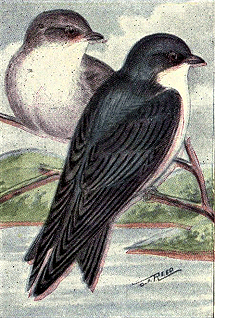
Tree Swallow. 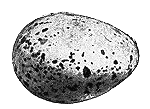
White. Throughout their range, they nest in barns,
sheds or any building where they will not be often disturbed, making their nests
of mud and attaching them to the rafters; they are warmly lined with feathers
and the outside is rough, caused by the pellets which they place on the exterior.
Before the advent of civilized
man, they attached their
nests to the sides of caves,
in crevices among rocks and
in hollow trees, as they do
now in some localities. Their
eggs cannot be distinguished
from those of the Cliff Swallow.
Data.--Penikese Is., Mass., July 2, 1900.
Nest on beam in sheep shed; made of pellets of
mud, lined with feathers.
614. Tree Swallow; White-bellied Swallow. Iridoprocne bicolor.
Range.--Whole of temperate North America,
breeding from middle United States northward;
winters in the Gulf States and along the Mexican
border and southward.
This vivacious and active species is as well
known as the last, and nests about habitations
on the outskirts of cities and in the country.

|

|
Page 374

|
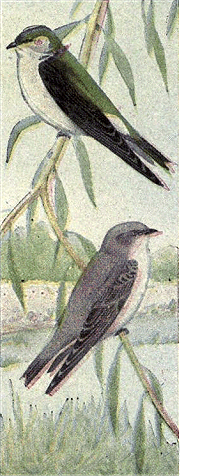
615--616. 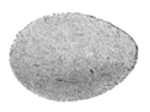
White. They naturally nest in holes in trees or stumps, preferable
in the vicinity of water, but large numbers now take up
their abode in houses provided for them
by man, providing that English Sparrows
are kept away. They make their nests of
straws and grasses, lined with feathers,
and lay four to six plain white eggs;
size .75 × .50. Data.--Portage, Mich.,
May 26, 1897. Nest in a gate post; hole
about 6 inches deep, lined with feathers.
615. Northern Violet-green Swallow. Tachycineta thalassina lepida.
Range.--United States in the Rocky Mountains and west
to the Pacific coast, breeding from Mexico to British Columbia;
winters south of our borders.
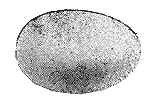
White. This very beautiful species is smaller than the last, but,
like it, is white below, but the upper parts
are blue, green and purple without gloss.
They are common in their range and
nest, usually in holes in trees, less often
in banks and under eaves; the nests are
made of grass and feathers, and the eggs
are pure white, four or five in number;
size .72 × .50.
615a. San Lucas Swallow. Tachycineta thalassina brachyptera.
Range.--Southern Lower California. Practically the same bird as the last
but with the wing very slightly shorter. Nesting habits or eggs will not differ.
615.1. Bahaman Swallow. Callichelidon cyaneoviridis.
Range.--Bahamas; casual at Dry Tortugas, Florida.
This very beautiful species is similar to the western Violet-green Swallow, as
are also its eggs.
616. Bank Swallow. Riparia riparia.
Range.--Whole of North America, north to the limit of trees, breeding from
the middle portions of the United States northward; winters south of our
borders.

White. This dull-colored Swallow is grayish above and white below,
with a gray band across the breast, they breed in holes in embankments,
digging small tunnels from one to three feet in
length, enlarged and lined at the end with grass and feathers.
During May, June or July, according to latitude, they lay from
four to six pure white eggs; size .70 × .50.
617. Rough-winged Swallow. Stelgidopteryx serripennis.
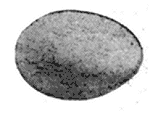
White. Range.--United States, breeding from Mexico north to southern New England,
Manitoba and British Columbia; winters south of our borders.
This species is slightly larger than the last and similar but
with the throat and breast grayish and with the outer web of
the outer primary provided with recurved hooks. They nest in
holes in embankments, in crevices in cliffs or among stones
of bridges or buildings. Their eggs are like those of the
Bank Swallow but average a trifle larger; size .75 × .52.
|
|
|
Page 375
|
WAXWINGS. Family AMPELIDÆ
618. Bohemian Waxwing. Bombycilla garrulus.
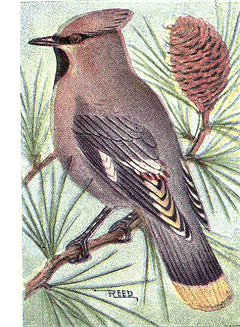
Bohemian Waxwing. Range.--Breeds in the Arctic regions except
in the Rockies where it nearly reaches the
United States; winters south to the northern
tier of states.
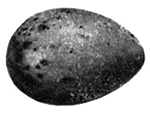
Dull bluish. This handsome crested, grayish brown Waxwing
resembles the common Cedar Waxwing
but is larger (length 8
inches), has a black throat,
much white and yellow on the
wing and a yellow tip to tail.
Their nests are made of rootlets,
grass and moss, and situated
in trees usually at a
low elevation. The eggs resemble
those of the Cedar-bird, but are larger
and the marking more blotchy with indistinct
edges; dull bluish blotched with blackish
brown; size .95 × .70. Data.--Great Slave Lake,
June 23, 1884. Nest in a willow 8 feet from
the ground. Collected for Josiah Hooper.
(Crandall collection).
619. Cedar Waxwing. Bombycilla cedrorum.
Range.--Whole of temperate North America, breeding in the northern half
of the United States and northward.
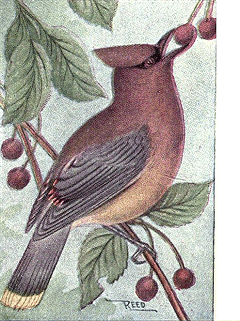
Cedar Waxwing. These birds are very gregarious and go in large flocks during the greater
part of the year, splitting up into smaller
companies during the breeding season and
nesting in orchards or groves and in any kind
of tree either in an upright crotch or on a horizontal
bough; the nests are made of grasses,
strips of bark, moss, string, etc., and are
often quite bulky. Their eggs are of a dull
grayish blue color sharply speckled with blackish
brown; size .85 × .60. Data.--Old Saybrook,
Conn., June 22, 1900. Nest composed of
cinquefoil vines, grasses, wool and cottony substances;
situated on an apple
tree branch about 10 feet
from the ground. Collector,
John N. Clark.
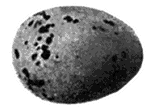
Dull bluish. This species
has a special fondness for
cherries, both wild and cultivated,
and they are often
known as Cherry-birds. They
also feed upon various berries, and frequently
catch insects in the air after the manner of
Flycatchers. Their only notes are a strange
lisping sound often barely audible.
|
|
Page 376

|
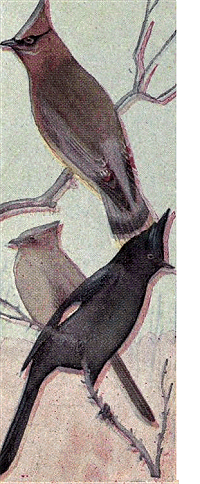
619--620. 620. Phainopepla. Phainopepla nitens.
Range.--Southwestern United States and Mexico; north
to southern Utah and Colorado.
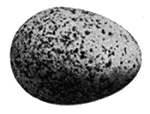
Light gray. This peculiar crested species is wholly
shining blue black except for a patch of
white on the inner webs of the primaries.
Their habits are somewhat like those of
the Cedar-bird, they being restless, and
feeding upon berries or insects, catching
the latter in the air. They make loosely
constructed nests of twigs, mosses, plant
fibres, etc., placed on branches of trees, usually below 20
feet from the ground, in thickets or open woods near water;
the eggs are two or three in number, light gray, spotted
sharply with black; size .88 × .65. Data.--Pasadena, Cal.,
July 15, 1894. Nest in an oak 10 feet up; composed of
weeds and string. Collector, Horace Gaylord.
SHRIKES. Family LANIIDÆ
621. Northern Shrike. Lanius borealis.
Range.--North America, breeding north of our borders;
winters in northern half of the United States and casually
farther south.
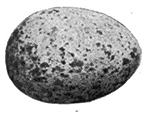
Grayish white. All Shrikes are similar in nature and plumage, being
grayish above and white below, with black wings, tail and ear patches, and
with white outer tail feathers and bases of primaries; the present species may
be known by its larger size (length over 10 inches) and wavy dusky lines on the
breast. They are bold and cruel birds, feeding upon insects,
small rodents and small birds, in the capture of
which they display great cunning and courage; as they
have weak feet, in order to tear their prey to pieces with
their hooked bill, they impale it upon thorns. They nest
in thickets and tangled underbrush, making their nests of
vines, grasses, catkins, etc., matted together into a rude
structure. During April or May they lay from four to
six grayish white eggs, spotted and blotched
with yellowish brown and umber; size 1.05
× .75.
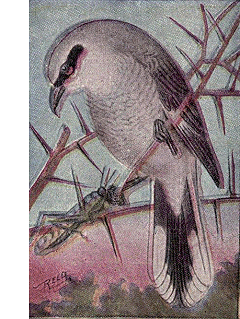
Northern Shrike. 622. Loggerhead Shrike. Lanius ludovicianus ludovicianus.
Range.--United States, east of the Plains,
breeding north to New England and Illinois;
winters in Southern States.
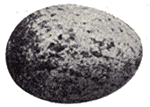
Grayish white. Like the last but smaller
(length 9 inches), not marked
below and with the ear
patches sharply defined. They
nest in hedges or thickly tangled
brush, showing a predilection
for dense thorn
bushes, where they place
their piles of weeds, grasses, feathers and rubbish;
the four or five eggs are laid in April
or May; they are like those of the last, but
smaller, averaging .96 × .72.
|
|
|
Page 377
|
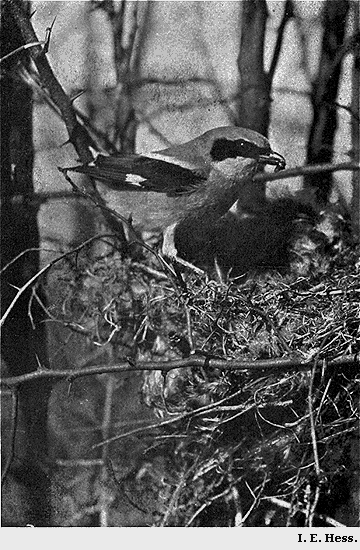
LOGGERHEAD SHRIKE AND NEST.
|
|
Page 378

|

Loggerhead Shrike. 622a. White-rumped Shrike. Lanius ludovicianus excubitorides.
Range.--North America, west of the Plains,
breeding north to Manitoba and the Saskatchewan;
winters south to Mexico.
Like the last but paler and the rump white.
Their nesting habits and eggs are in every respect
like those of the Loggerhead Shrike.
622b. California Shrike. Lanius ludovicianus gambeli.
Range.--Pacific coast north to British Columbia.
Similar to the eastern form but with the
breast washed with brownish and with indistinct
wavy bars. The eggs cannot be distinguished
from those of the others.
622c. Island Shrike. Lanius ludovicianus anthonyi.
Range.--Santa Barbara Islands, California. Like the last but smaller and
darker. Eggs not distinguishable.
VIREOS. Family VIREONDIDÆ
623. Black-whiskered Vireo. Vireosylva calidris barbatula.
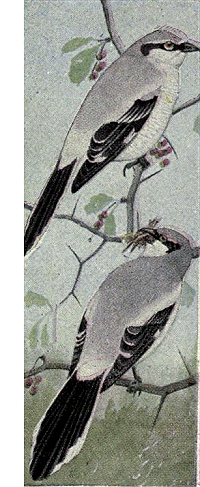
622a--622b. Range.--A Central American species, breeding in Cuba,
Bahamas and southern Florida.
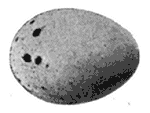
White. Like the Red-eyed Vireo but with a
dusky streak on either side of the chin.
They build pensile nests of strips of bark
and fibres, swung from the forks of
branches. The eggs cannot be distinguished
from those of the next species,
being white, more or less specked about
the large end with reddish brown and umber. Size .78 × .55.

|
|
|
Page 379
|
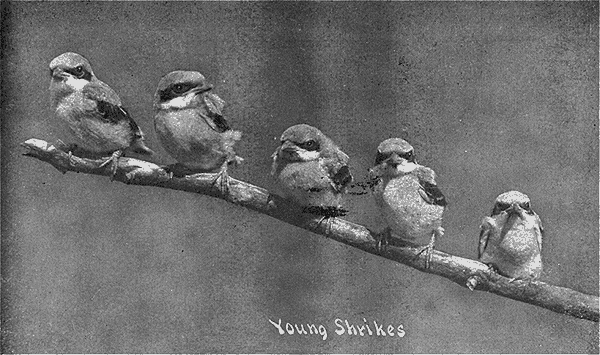
YOUNG SHRIKES (All ready for flight).
|
|
Page 380

|
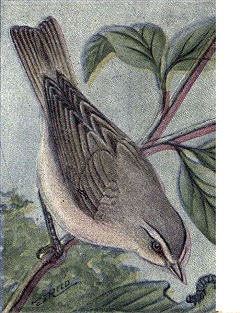
Red-eyed Vireo. 624. Red-eyed Vireo. Vireosylva olivacea.
Range.--United States, east of the Rockies,
breeding north to Labrador, Manitoba and British
Columbia.
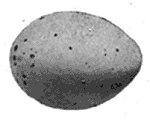
White. This is the most common of the Vireos in
the greater part of its range and is a most persistent
songster, frequenting groves, open
woods or roadsides. Their eyes are brown,
scarcely if any more red than those of any
other species and I have yet
to see one with red eyes outside
of mounted museum specimens.
They swing their
nests from the forks of trees
at any elevation from the
ground but usually below ten
feet, and I have found them
where the bottom rested on the ground; they
are made of strips of bark, fibre, etc., and often
have pieces of string or paper woven into the
sides; they are one of the most beautiful of
bird homes and are woven so strongly that old
nests hang to the branches for several seasons.
Their three or four eggs, often accompanied by
one of the Cowbirds, are laid in May or June; they are white, sparingly specked
with blackish brown. Size .85 × .55.
625. Yellow-green Vireo. Vireosylva flavoviridis.
Range.--Southern Texas and southward to South America.
Similar to the Red-eye but greener above and more yellowish on the sides.
The nesting habits are the same and the eggs indistinguishable from those of
that species.
626. Philadelphia Vireo. Vireosylva philadelphica.
Range.--Eastern United States breeding from northern New England and
Manitoba northward.
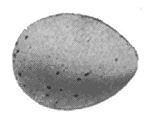
White. 
626-627. This species is much smaller than the Red-eye (length 5 in.)
and is yellowish below, and without black edges to the gray
crown. Their eggs do not differ
from those of the Red-eyed
Vireo except in size,
averaging .70 × .50.
627. Warbling Vireo. Vireosylva gilva gilva.
Range.--North America east to the Plains,
breeding north to Labrador.
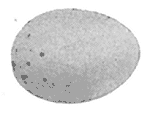
White. This Vireo is nearly as abundant as the Red-eye
but is not generally as well known, probably
because it is usually higher in the trees
and more concealed from view. Their nests
are like those of the Red-eye, but smaller and
usually placed higher in the trees. The birds
are even more persistent singers, than are the
latter but the song is more musical and delivered
in a more even manner,
as they creep about
among the foliage, peering
under every leaf for lurking
insects. The eggs are pure
white, spotted with brown or
reddish brown. Size .72 × .52.
|
|
|
Page 381
|
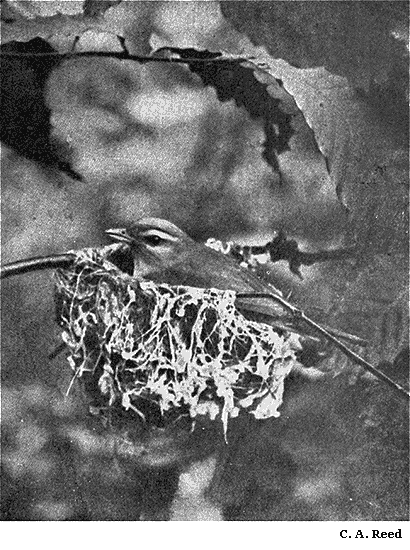
RED-EYED VIREO ON NEST.
|
|
Page 382

|
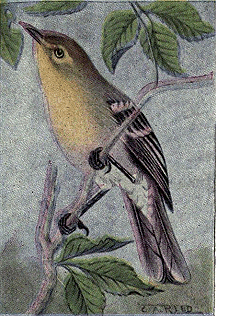
Yellow-throated Vireo. 627a. Western Warbling Vireo. Vireosylva gilva swainsoni.
Range.--Western United States, breeding
from Mexico to British Columbia.
This species is like the last but said to be
a trifle smaller and paler color. Its nesting
habits and eggs are precisely like those of
the eastern form.
628. Yellow-throated Vireo. Lanivireo flavifrons.
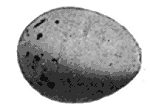
Creamy white. Range.--United States east
of the Plains, breeding from
the Gulf to Manitoba and
New Brunswick.
This handsome bird is
wholly unlike any others of
the Vireos, having a bright
yellow throat and breast; the
upper parts are greenish and the wings and
tail gray, the latter with two white bars. They
are fairly common breeding birds in northern
United States, placing their handsome basket-like
structures in forks of branches and at any
elevation from the ground; the nests are like those of the preceding Vireos but
are frequently adorned on the outside with lichens, thereby adding materially
to their natural beauty. The four or five eggs are pinkish or creamy white,
speckled about the large end with reddish brown. Size .80 × .60.
629. Blue-headed Vireo. Lanivireo solitarius solitarius.
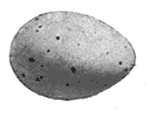
White. Range.--Eastern United States, breeding from southern
New England and the northern states north to Hudson Bay;
winters in the Gulf States and southward.
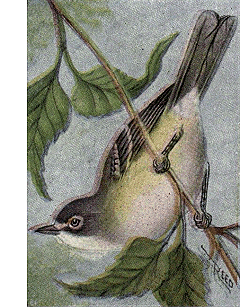
Blue-headed Vireo. A beautiful Vireo with a slaty blue crown and nape, greenish
back, white wing bars and underparts, the flanks being washed
with greenish yellow; a conspicuous mark is the white eye
ring and loral spot. They build firm, pensile, basket-like
nests of strips of birch and grapevine bark, lined with fine
grasses and hair, suspended from forks, usually
at low elevation and often in pine or fir trees
(of some twenty nests that I have found in
New England all have been in low branches of
conifers). Their three or four white eggs are
specked with reddish brown. Size .80 × .60.
629a. Cassin's Vireo. Lanivireo solitarius cassini.
Range.--United States west of the Rockies;
north to British Columbia.
Similar to the last but with the back grayish.
629b. Plumbeous Vireo. Lanivireo solitarius plumbeus.
Range.--Rocky Mountain region, breeding
from Mexico to Dakota and Wyoming.
Like the Blue-headed Vireo but with the
yellowish wholly replaced by leaden gray.
|
|
|
Page 383
|
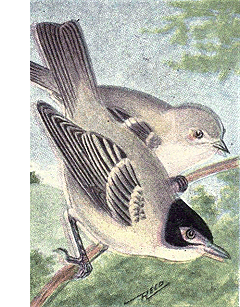
Black-capped Vireo. 629c. Mountain Vireo. Lanivireo solitarius alticola.
Range.--Mountains of Carolina and Georgia;
winters in Florida.
Said to be larger and darker than solitarius
proper. From all accounts, the habits, nests
or eggs of this species differ in no wise from
many of those of the northern Solitary Vireo,
whose nests show great variations in size and
material.
629d. San Lucas Vireo. Lanivireo solitarius lucasanus.
Range.--Southern Lower California.
Similar to cassini but with the flanks more
yellow. Their nesting habits or eggs will not
differ from the others.
630. Black-capped Vireo. Vireo atricapillus.
Range.--Central Texas north to Kansas;
winters in Mexico.
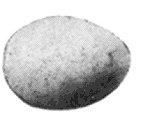
White. This peculiar Vireo has a black crown and sides of head,
broken by a white eye ring and loral stripe; upper parts greenish,
below white. They appear to be fairly common in certain
localities of their restricted range, and nest at low elevations in
mesquites or oaks, placing the nests in forks the same as other
Vireos; they are of the ordinary Vireo architecture, lined with
grasses. The three or four eggs are pure white, unmarked. Size
.70 × .50. Data.--Comal Co., Texas, May 21, 1888, 4 eggs. Nest
located in a scrub Spanish oak, 5 feet from the ground.
631. White-eyed Vireo. Vireo griseus griseus.

White-eyed Vireo. Range.--Eastern United States, breeding from the Gulf to northern United
States.
This Vireo has white eyes, as implied by its
name, is yellowish green on the sides and with
two prominent bars. They have no song, like
the other Vireos, but a strange medley of notes
resembling those of the Chat or Shrike.

White. They
nest near the ground in tangled
thickets, making large
nests for the size of the birds
and not always suspended;
they are made of weeds,
leaves, grass, bark or any
trash. Their three or four
eggs are laid late in May or
early in June; they are white, sparingly speckled
with brown; size .75 × .55.
631a. Key West Vireo. Vireo griseus maynardi.
Range.--Southern Florida.
This grayer and paler variety nests in the
same manner and the eggs are not distinct
from those of the last form.
|

|
Page 384

|
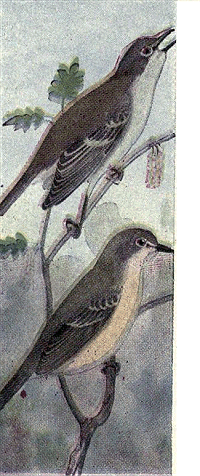
629a--632. 631b. Bermuda Vireo. Vireo griseus bermudianus.
Range.--Bermudas.
This variety is said to be slightly smaller and to have
no yellow on the sides. Its eggs are probably the same as
those of the others.
631c. Small White-eyed Vireo. Vireo griseus micrus.
Range.--Eastern Mexico north to southern Texas.
Said to be slightly smaller and grayer than the common
White-eyed Vireo. Its eggs will not differ.
632. Hutton's Vireo. Vireo huttoni huttoni.
Range.--Resident on the California coast; chiefly in
the southern parts.
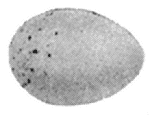
White. A similar species to noveboracensis but
with the under parts tinged with yellow.
These birds are quite common but shy, nesting
at any height from the ground in open
woods or groves; the nests are made of
grasses and moss and swung from forked
limbs; the three or four eggs are pure white,
finely specked with reddish brown. Size .70 × .50.
632a. Stephen's Vireo. Vireo huttoni stephensi.
Range.--Northwestern Mexico and the boundary of the United States.

633a-634. This variety, which is more yellowish than the last, appears to be rather uncommon
but as far as I can learn its habits and nesting do not differ from those
of the other Vireos; the eggs are white, specked with brown. Size .70 × .50.
632c. Anthony's Vireo. Vireo huttoni obscurus.
Range.--Pacific coast from Oregon (and Cal. in winter)
to British Columbia.
The nesting habits and eggs of this darker and smaller
variety are the same in all respects as those of the Hutton's
Vireo.
633. Bell's Vireo. Vireo belli belli.
Range.--Interior of the United States, breeding from
Texas to Minnesota and Dakota.
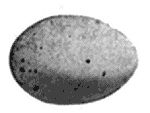
White. The nesting habits of this smaller species
are just the same as those of the larger varieties,
they suspending their small grass-woven
baskets in the forks of bushes or
trees and usually at a low elevation. Their
nests are handsome and compact little structures,
being often made almost wholly of
strips of bark lined with very fine grasses. The eggs are
white, specked with reddish brown. Size .70 × .50. Data.--Austin,
Texas, June 16, 1898. Nest of strips of bark,
fibres and grasses, neatly woven and swung from the fork
of a low bush, 2 feet from the ground.
|
|
|
Page 385
|
633a. Least Vireo. Vireo belli pusillus.
Range.--Western Mexico, Arizona and southern California.
This Vireo is slightly smaller and grayer than the last; they are quite common
in southern Arizona, nesting the same as Bell's at low elevations in bushes
or small trees. The eggs cannot be distinguished from those of belli.
634. Gray Vireo. Vireo vicinior.
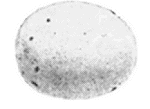
White. Range.--Southwestern United States from western Texas, southern California
and Nevada southward.
This species is grayish above and grayish white below, with
white eye ring, lores and wing bar. They are not uncommon
birds in the Huachuca Mts. of southern Arizona, where they
nest in bushes at low elevations, making the semi-pensile structures
of woven strips of bark and grasses, lined with fine round
grasses attached by the rim to a fork and sometimes stayed on
the side by convenient twigs. Eggs white, specked with brown.
Size .72 × .53.
HONEY CREEPERS. Family COEREBIDÆ
635. Bahama Honey Creeper. Cœreba bahamensis.
Range.--Bahamas, casually to southern Florida and the Keys.
This peculiar curved-billed species is dark brown above, with the underparts,
superciliary line and spot at base of primaries, whitish; the rump and a breast
patch are yellow. They nest at low elevations in bushes or trees usually in
tangled thickets, making a large dome-shaped nest of grasses, leaves and fibres
and, during May or June, lay from three to five pale creamy white eggs, speckled
sparingly all over the surface and more abundantly at the large end with reddish
brown. Size .65 × .50.
WARBLERS. Family MNIOTILTIDÆ
Warblers as a family may be classed as the most beautiful, interesting and
useful birds that we have. With few exceptions, they only return from their
winter quarters as the trees shoot forth their leaves or flowers, they feed largely
among the foliage upon small, and mostly injurious, insects. They are very
active and always flitting from branch to branch, showing their handsome
plumage to the best advantage. Their songs are simple but effectively delivered
and the nests are of a high order of architecture.
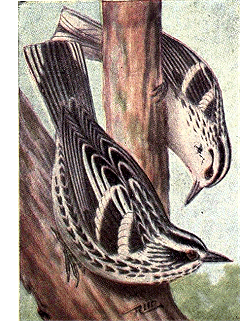
Black and White Warbler. 636. Black and White Warbler. Mniotilta varia.
Range.--North America east of the Plains,
breeding from the Gulf States north to the
Hudson Bay region; winters from our southern
borders to South America.
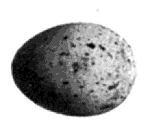
White. This striped black and white
Warbler is usually seen creeping
about tree trunks and branches
after the manner of a Nuthatch.
They are very active gleaners
and of inestimable value to man.
They nest on the ground in
woods or swamps, making their nest of strips
of bark and grass, placed among the leaves
usually beside stones, stumps or fallen trees.
Their three to five eggs are white, finely
specked and wreathed with reddish brown.
Size .65 × .50. Data.--Worcester, Mass., June
3, 1889. Nest of strips of bark on the ground
in an old decayed stump.
|

|
Page 386

|
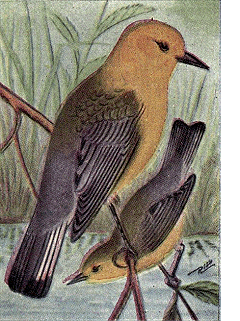
Prothonotary Warbler. 637. Prothonotary Warbler. Prothonotaria citrea.
Range.--South Atlantic and Gulf States,
north in the interior to Iowa and Illinois.
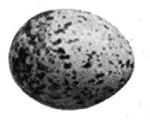
Creamy white. This species is often known
as the Golden Swamp Warbler
because of the rich golden
yellow of the head and underparts.
They frequent and
nest in the vicinity of swamps
or ponds, nesting in the cavities
of trees or stubs at low
elevations, filling the cavity with leaves, moss
and grasses, neatly cupped to receive the four
to seven eggs, which are creamy or pinkish
white, profusely spotted with reddish brown
and chestnut. Size .72 × .55. Data.--Quincy,
Mo., June 1, 1897. 5 eggs. Nest in hole of
a dead stub 6 feet up, in timber some distance
from water; made of moss and grasses, lined
with hair.
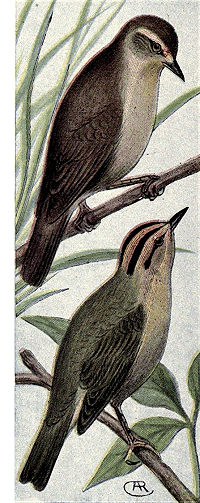
Swainson's Warbler.
Worm-eating Warbler. 638. Swainson's Warbler. Helinaia swainsoni.
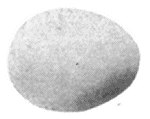
Bluish white. Range.--South Atlantic and Gulf
States, north to Virginia and Indiana,
and west to eastern Texas;
winters in Mexico and the West
Indies.
This species is brownish above
and white below, with a whitish
superciliary stripe. It has been
found breeding most numerously in thickets and
tangled underbush about swamps and pools in
any locality. Their nests are either in bushes or
attached to upright rushes over water after the
manner of the Long-billed Marsh Wren, being
made of leaves, moss, rootlets, etc., lined with fine
grasses or hair, and deeply cupped for the reception
of the three or four unmarked white or bluish
white eggs which are laid during May or June.
Size .75 × .58. Data.--Near Charlestown, S. C.,
May 12, 1888, 3 eggs. Nest in canes 4 feet from
ground, made of strips of rushes, sweet gum and
water oak leaves, lined with pine needles.
639. Worm-eating Warbler. Helmitheros vermivorus.
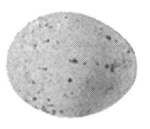
White. Range.--United States east of the
Plains, breeding north to southern
New England and Illinois; winters
south of our borders.
This bird can be identified in all
plumages by the three light buff
and two black stripes on the crown
and narrower black stripes through the eye. Their
habits are similar to those of the Oven-bird, they
feeding largely upon the ground amid dead leaves.
|
|
|
Page 387
|
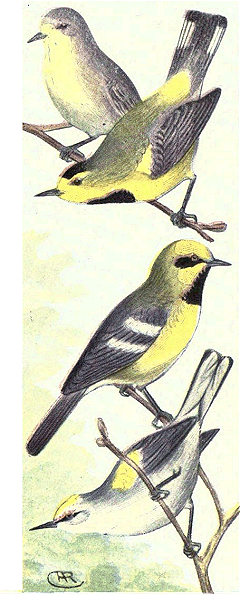
Bachman's Warbler.
Lawrence's Warbler.
Brewster's Warbler. They are quite abundant in most localities in their
range, nesting in hollows on the ground in open
woods or shrubbery on hill sides; the nest is made
of leaves, grasses and rootlets, lined with hair or
finer grasses, and is usually placed under the
shelter of some small bush. They lay (in May,
June or July) three to six eggs, white, marked or
blotched either sparingly or heavily with chestnut
or lavender. Size .70 × .52.
640. Bachman's Warbler. Vermivora bachmani.
Range.--Southeastern United States, along the
Gulf coast to Louisiana and north to Virginia and
Missouri.
This species is one of the rarest of the Warblers,
but is now much more abundant than twenty
years ago, when it had apparently disappeared.
They are greenish above, and yellow below, and
on the forehead and shoulder, and with black
patches on the crown and breast. They have
been found breeding in Missouri, nesting on the
ground like others of this genus; the eggs are
white wreathed about the large end and sparingly
specked over the whole surface with reddish
brown and chestnut. Size .65 × .50.
641. Blue-winged Warbler. Vermivora pinus.
Range.--Eastern United States, breeding north to southern New England and
in the Mississippi Valley to Minnesota; winters south of our borders.

White. This common species has the crown and underparts yellow, line through the
eye black, and white wing bars and spots on outer tail feathers. They breed
most abundantly in the northern half of their United States
range, placing their nests on the ground in thickets or on the
edge of woods; the nests are made of strips of bark, usually
grapevine, and leaves, and are usually high and deeply cupped,
they are almost always placed among the upright shoots of
young bushes. The eggs are white, finely specked with reddish
brown with great variations as to markings. Size .65 × .50.
Data.--Old Saybrook, Conn., June 1, 1900. 5 eggs. Nest composed chiefly of
dry beech leaves and strips of cedar bark, lined with shreds of bark and fine
grass; situated on the ground among a bunch of weeds in the woods.
|

|
Page 388

|
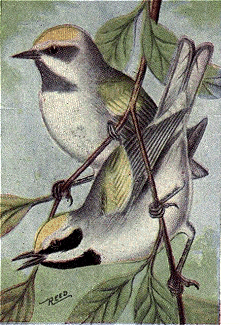
Golden-winged Warbler. 642. Golden-winged Warbler. Vermivora chrysoptera.
Range.--Eastern United States, breeding
north to the southern parts of the British Provinces,
winters south of the United States.
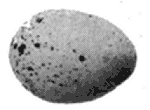
White. This is a very handsome species with black
throat and ear patches, and yellow crown and
wing bars, the upper parts being
gray and the lower white. They
frequent low fields or hillsides
where they nest among weeds
or vines, making the nest of
strips of bark, grasses and fibres,
and locating it close to the
ground in clumps of weeds, low bushes or
briers. The three to five eggs are white with
a very great diversity of markings, either
heavily or minutely spotted or wreathed with
chestnut and gray. Size .62 × .50.
643. Lucy's Warbler. Vermivora luciæ.
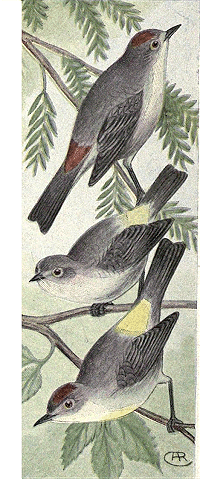
Lucy's Warbler.
Virginia Warbler. 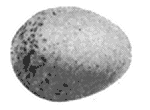
White. Range.--Western Mexico, north
commonly to Arizona and casually
to southern Utah.
This small gray and white Warbler
is especially distinguished by a
chestnut rump and patch in center
of the crown. Besides nesting in
forks of low bushes, this species is said to place
the domiciles in almost any crevice or nook that
suits their fancy, such as loose bark on tree
trunks, holes in trees, or other birds' nests. The
eggs which are usually laid during May are white,
sparingly specked and wreathed with reddish
brown. Size .60 × .50.
644. Virginia's Warbler. Vermivora virginiæ.
Range.--Western Mexico, north to Arizona and
New Mexico, and also less commonly to Colorado.
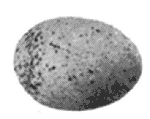
White. This species is similar to the last but has the
rump and a patch on the breast, yellow. They
are found quite abundantly in some localities,
usually on mountain ranges, nesting in hollows
on the ground beside rocks, stumps or in crevices
among the rocks; the nests are
made of fine strips of bark and
grasses, skillfully woven together,
and the three to five eggs are pure
white, specked and wreathed with
reddish brown. Size .62 × .50.
|
|
|
Page 389
|
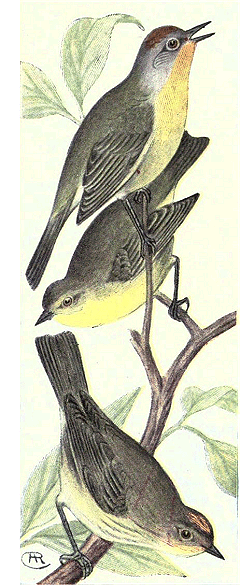
Nashville Warbler.
Orange-crowned Warbler. 645. Nashville Warbler. Vermivora rubricapilla rubricapilla.
Range.--North America east of the Plains,
breeding from New York and Illinois north to
Hudson Bay and Labrador; winters south of our
borders.

White. This small species is yellow below
and greenish above, with an
ashy gray head and neck, enclosing
a chestnut crown patch. They
breed abundantly in New England,
usually on side hills covered with
clumps of young pines, the nests
being placed flush with the surface of the ground
and usually covered with overhanging grass; they
are made of grasses and pine needles, the eggs
are white, finely specked with bright reddish
brown. Size .60 × .45. Data.--Worcester, Mass.,
June 23, 1895. Nest of pine needles and grasses
in hollow in the moss on a scrubby pine hillside.
645a. Calaveras Warbler. Vermivora rubricapilla gutturalis.
Range.--Western United States, breeding on
ranges from California and Idaho north to British
Columbia; winters in Mexico.
A slightly brighter colored form of the last
species. Their habits are the same and the eggs
cannot be distinguished from those of the eastern
bird.
646. Orange-crowned Warbler. Vermivora celata celata.
Range.--North America, chiefly in the interior, breeding north of the United
States except in the Rockies south to Arizona and New Mexico;
winters in the Gulf States and southward.
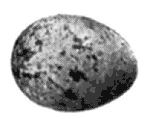
White. This plainly clad, greenish colored species has a concealed
patch of orange brown on the crown. They have been found
breeding about Hudson Bay and in the Mackenzie River district,
placing their nests in hollows on the ground, usually on the
side of banks or hills and concealed by small tufts of grass or
bushes. The three or four eggs are white, speckled with reddish brown.
Size .64 × .45.
646a. Lutescent Warbler. Vermivora celata lutescens.
Range.--Pacific coast, breeding from California to Alaska; winters in Mexico.
Similar to the last but more yellowish below. They make their nests of
leaves, rootlets, moss, etc., lined with hair, and placed on the ground, concealed
by tufts of grass or by bushes. The eggs are like those of the last. Data.--Danville,
Cal., April 21, 1898. Nest on the ground on a side hill; among weeds
in the shade of a large oak.
|

|
Page 390

|
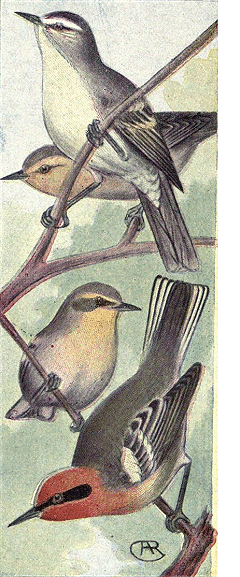
Tennessee Warblers.
Olive Warblers. 646b. Dusky Warbler. Vermivora celata sordida.
Range.--Santa Barbara Islands, off California.
Said to be duller colored and darker than the
others. The eggs cannot be distinguished.
647. Tennessee Warbler. Vermivora peregrina.
Range.--Eastern North America, breeding from
the northern tier of states, northward; winters to
northern South America.

White. This species has greenish upper
parts, white lower parts and superciliary
line, and gray crown and
nape. They nest either on the
ground or at low elevations in
bushes, making the structure of
grasses and fibres, lined with hair;
they are found on wild, tangled hillsides and
mountain ranges. The eggs are pure white, sparingly
specked with reddish brown. Size .62 × .45.
648. Parula Warbler. Compsothlypis americana americana.
Range.--Eastern United States, breeding in the
southern half.
The upper parts of this handsome species are
bluish gray with a greenish patch in the middle
of the back; the throat and breast are yellow
with a patch of black and chestnut.
They are
abundant birds in suitable localities, breeding in
swamps, especially those with old or dead trees
covered with hanging moss (usnea).
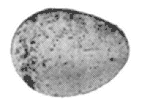
White. The nests may be found
at any height from the ground, and are usually made by turning
and gathering up the ends of the hanging moss to form a
pocket, which is lined with fine grass or hair. The four to six
eggs are white or creamy white, wreathed with specks of reddish
brown and chestnut. Size .64 × .44.
648a. Northern Parula Warbler. Compsothlypis americana usneæ.
Range.--Northern half of eastern United States and southern Canada; winters
from the Gulf States southward.
The nesting habits of the northern form of the Blue-yellow-backed Warbler
are in all respects like those of the last, and like them, where moss grown
swamps are not to be found, they have been known to construct nests of moss
suspended from branches of trees, or to nest in bunches of dead leaves. Data.--Oxford,
Mass., June 7, 1895. Nest in a dead pine swamp; made in end of hanging
moss about 6 feet from the ground. Large colony breeding.
|
|
|
Page 391
|
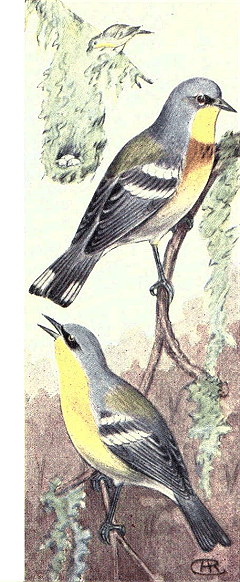
Parula Warbler.
Sennett's Warbler. 649. Sennett's Warbler. Compsothlypis piti ayumi nigrilora.
Range.--Eastern Mexico, north to the Lower
Rio Grande Valley in Texas.
This species is similar to the Parula but is more
extensively yellow below, and has black lores and
ear coverts. Their habits are the same as those
of the last and their nests are generally placed in
hanging moss, and are also said to have been
found hollowed out in the mistletoe which grows
on many trees in southern Texas, New Mexico and
Arizona. The eggs cannot be distinguished from
those of the last.
650. Cape May Warbler. Dendroica tigrina.
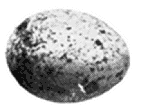
White. Range.--Eastern North America,
breeding from northern New England
and Manitoba northward; winters
south of the United States.
This beautiful Warbler is yellow
below and on the rump, streaked on
the breast and sides with black;
the ear coverts and sometimes the throat are
chestnut. They are very local in their distribution
both during migrations and in their breeding
grounds. They nest in the outer branches of
trees, preferably conifers, making the nest of
slender twigs, rootlets, grasses, etc., lined with
hair; the four or five eggs are white, variously
specked with reddish brown and lilac; size .65
× .48.
651. Olive Warbler. Peucedramus olivaceus.
Range.--Mountains of New Mexico and Arizona southward.
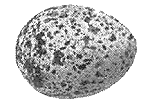
Grayish blue. This peculiar species may readily be recognized by its saffron or orange-brown
colored head and neck, with broad black bar through the eye. They
nest at high elevations in coniferous trees on the mountain sides, placing their
nests either on the horizontal boughs or forks at the end of them.
The nests are very beautiful structures made of moss, lichens,
fine rootlets and grasses and setting high on the limb like those
of the Blue-gray Gnatcatcher. The eggs are grayish white with
a bluish tinge, thickly speckled with blackish; size .64 × .48.
Data.--Huachuca Mts., Arizona, June 21, 1901. Nest in a sugar
pine near extremity of branch, 25 feet from the ground and 20
feet out from the trunk of the tree; composed of lichens and fine rootlets, lined
with plant down.

|

|
Page 392

|
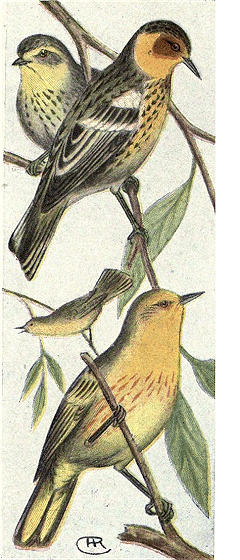
Cape May Warblers.
Yellow Warblers. 652. Yellow Warbler. Dendroica æstiva æstiva.
Range.--Breeds in the whole or North America;
winters south of our borders.
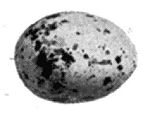
Greenish white. This well known and very common species is
wholly yellow, being more or less greenish on
the back, wings and tail, and the male is streaked
on the sides with chestnut. They nest anywhere
in trees or bushes, either in woods, pastures,
parks or dooryards, and their sprightly song is
much in evidence throughout the summer. The
nests are usually placed in upright
crotches or forks, and are made of
vegetable fibres and fine grasses
compactly woven together and lined
with plant down and hair; the eggs,
which are laid in May or June, are
greenish white, boldly specked in
endless patterns with shades of brown and lilac;
size .65 × .50.
652a. Sonora Yellow Warbler. Dendroica æstiva sonorana.
Range.--Arizona, New Mexico and western
Texas, southward.
This form is brighter yellow, especially above,
than the last. The nesting habits are the same
and the eggs indistinguishable from those of the
preceding.
652b. Alaska Yellow Warbler. Dendroica æstiva rubiginosa.
Range.--Breeds in Alaska and on the coast
south to Vancouver; winters south of the United
States.
Similar to the common Yellow Warbler but slightly darker above; its eggs
and nesting habits are the same.

|
|
|
Page 393
|
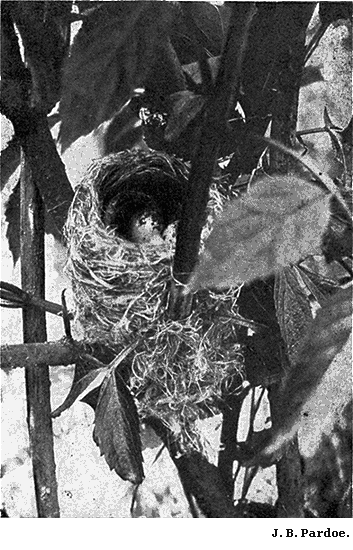
NEST OF YELLOW WARBLER.
|
|
Page 394

|
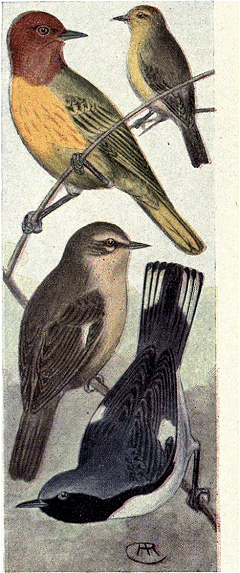
Mangrove Warblers.
Black-throated Blue Warblers. 653. Mangrove Warbler. Dendroica bryanti castaneiceps.
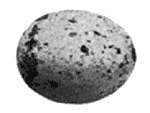
Greenish white. Range.--Southern Lower California
and western Mexico and
Central America.
This species is very similar to
the Yellow Warbler but the entire
head and neck of the male
are yellowish chestnut. Their
nesting habits or eggs do not vary in any essential
particular from those of the common Yellow-birds
of the United States.
654. Black-throated Blue Warbler. Dendroica cærulescens cærulescens.
Range.--Eastern North America, breeding from
northern United States northward; winters in
the Gulf States and southward.
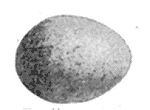
Buffy white. These black-throated bluish-backed Warblers
are abundant in swampy woodland both during
migrations and at their breeding grounds; either
sex can readily be identified in any plumage, by
the presence of a small white spot at the base of
the primaries. They nest in underbrush or low
bushes only a few inches above the ground, making
the nests of bark strips, moss rootlets, etc.,
lined with fine grasses or hair;
the eggs are pale buffy white
more or less dotted with pale
brownish; size .65 × .50. Data.--Warren,
Pa., June 9, 1891. 3
eggs. Nest one foot from the
ground in brush; made of fine
pieces of rotten wood, laurel bark and lined with
fine grasses.
654a. Cairns Warbler. Dendroica cærulescens cairnsi.
Range.--Mountain ranges of North Carolina to Georgia.
A darker form whose habits and eggs are identical with those of the last.
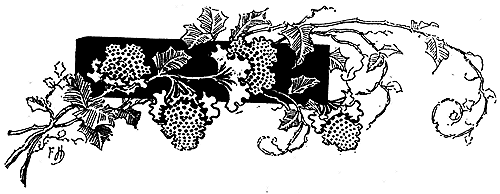
|
|
|
Page 395
|
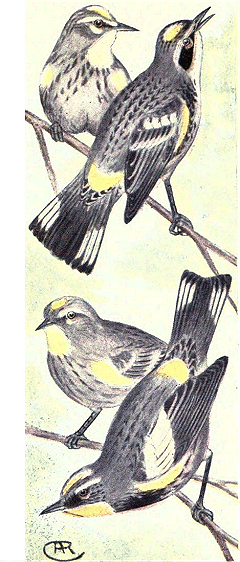
Myrtle Warblers.
Audubon's Warblers. 655. Myrtle Warbler. Dendroica coronata.
Range.--Eastern North America, breeding from
northern United States northward. Winters in
the southern half of eastern United States.
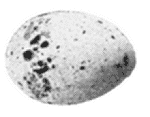
White. This beautiful gray, white and
black Warbler can readily be identified
by its yellow rump, side
patches and crown patch. It is one
of our most common species during
migrations when it is found west
to the Rockies and casually farther.
They nest on the lower branches of coniferous
trees, making their homes of rootlets, plant
fibres and grasses; during June or the latter part
of May, three or four eggs are laid; they are white,
spotted with several shades of brown and lilac;
size .70 × .50. Data.--Lancaster, N. H., June 7,
1888. Nest in a small spruce, about 6 feet up;
made of fine twigs, lined with feathers.
656. Audubon's Warbler. Dendroica auduboni auduboni.
Range.--Mountain ranges of western United
States from British Columbia to Mexico.
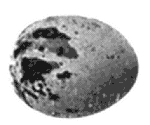
Bluish white. This bird resembles the last in the location of
the yellow patches but has a yellow
instead of a white throat, and is
otherwise differently marked. They
are as abundant in suitable localities
as are the Myrtle Warblers in
the east, nesting on the outer
branches of coniferous trees at any
height from the ground. The nests are made of
bark strips, rootlets, plant fibre, grasses and pine
needles, the three to five eggs are greenish or bluish white marked with brown
and lilac; size .68 × .52. The one figured is from a beautiful set of four in Mr.
C. W. Crandall's collection, and the ground color is a delicate shade of blue.
Data.--Spanaway, Washington, April 23, 1902. Nest on the limb of a large fir
in a clump of three in prairie country.
656a. Black-fronted Warbler. Dendroica auduboni nigrifrons.
Range.--Mountains of southern Arizona and Mexico.
Similar to the preceding, but with the forehead and ear coverts black. Their
nests and eggs are in no way different from those of Audubon's Warbler.
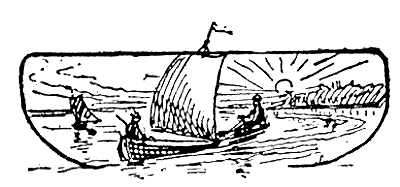
|

|
Page 396

|
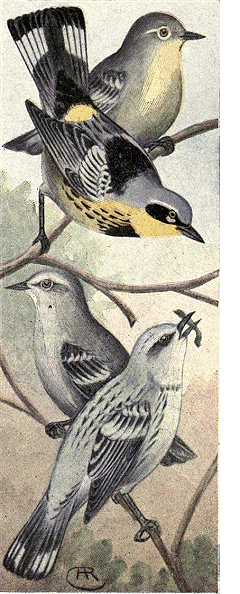
Magnolia Warblers.
Cerulean Warblers. 657. Magnolia Warbler. Dendroica magnolia.
Range.--North America east of the Rockies,
breeding from northern United States to Hudson
Bay region and in the Alleghanies, south to Pennsylvania.
Winters south of our borders. This
species, which is one of the most beautiful of the
Warblers, is entirely yellow below and on the
rump, the breast and sides being heavily streaked
with black; a large patch on the
back and the ear coverts are black.
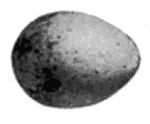
White. They build in coniferous trees at
any elevation from the ground,
making their nests of rootlets and
grass stems, usually lined with
hair; the eggs are dull white,
specked with pale reddish brown; size .65 × .48.
Data.--Worcester, Mass., May 30, 1895. 4 eggs.
Nest of fine rootlets and grasses about 30 feet
up on the end of a limb of a pine overhanging a
brook.
658. Cerulean Warbler. Dendroica cærulea.
Range.--United States east of the Plains, breeding
chiefly in the northern half of the Mississippi
Valley, rare east of the Alleghanies and casual in
New England.
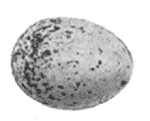
White. These beautiful
Warblers are light blue gray above,
streaked with black on back, white
below, with a grayish blue band on
breast and streaks on the sides;
they have two wide white wing bars
and spots on the outer tail feathers.
They are found chiefly in the higher trees where
they glean on the foliage; they build also usually
above twenty feet from the ground in any kind of
tree, placing the nests well out on the horizontal
limbs, generally in a fork. The nests are made of
fine strips of bark, fibres, rootlets, etc., lined with hair; the eggs are white or
pale bluish white, specked with reddish brown; size .62 × .48. Data.--Fargo,
Ontario, June 2, 1901. Nest in a burr oak, 18 feet from the ground on a horizontal
limb.

|
|
|
Page 397
|

NEST OF MAGNOLIA WARBLER.
|
|
Page 398

|
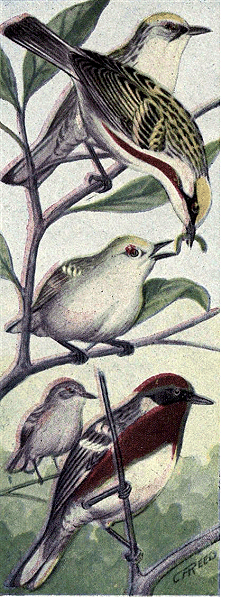
Chestnut-sided Warblers.
Bay-breasted Warblers. 659. Chestnut-sided Warbler. Dendroica pensylvanica.
Range.--United States, east of the Plains, breeding
in the Middle States and Illinois, north to Manitoba
and New Brunswick. Winters south of our
border.
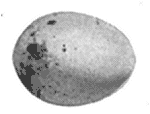
White. The adults of this handsome species
may readily be known by the
white underparts and the broad
chestnut stripe on the flanks; the
crown is yellow. They frequent low
brush in open woods or on hillsides
and pastures, nesting at low elevations,
usually below three feet from the ground,
and often concealing their nests beneath the
leaves in the tops of low small bushes. The nests
are made of grasses, weed stems and some fibres,
but they do not have as wooly an appearance as
those of the Yellow Warblers which nest in the
same localities and similar locations. Their eggs
are white or creamy white (never greenish white),
specked with brown and gray. Size .65 × .50.
Data.--Worcester, Mass., June 6, 1890. Nest in
the top of a huckleberry bush, 2 feet from the
ground; made of grasses and plant fibres. Bird
did not leave nest until touched with the hand.
660. Bay-breasted Warbler. Dendroica castanea.
Range.--North America, east of the Plains,
breeding from northern United States north to
the Hudson Bay; winters in Central and South
America.
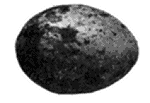
White. This species has the crown, throat and sides a
rich chestnut; forehead and face black; underparts white. They
nest in coniferous trees in swampy places, making their nests
of bark shreds and rootlets and placing them in horizontal
forks at elevations of from five to thirty feet from the ground.
The three or four eggs are laid late in May or during June;
they are white, usually quite heavily spotted and blotched with
reddish brown, umber and grayish. Size .70 × .50.

|
|
|
Page 399
|
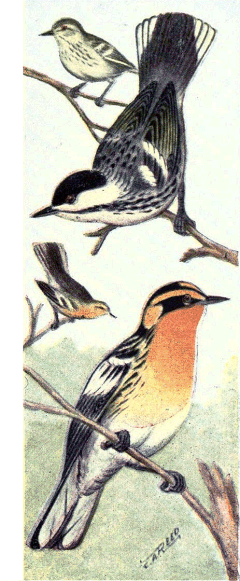
Black-poll Warblers.
Blackburnian Warblers. 661. Black-poll Warbler. Dendroica striata.
Range.--North America, east of the Rockies,
breeding from northern United States north to
Labrador and Alaska; winters in South America.
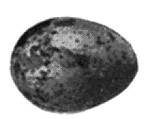
White. This black and white Warbler has
a solid black cap, and the underparts
are white, streaked with
black on the sides. In the woods
they bear some resemblance to the
Black and White Warbler, but do
not have the creeping habits of that
species. During migrations they are found in
equal abundance in swamps or orchards. In their
breeding range, they nest at low elevations in
stunted pines or spruces, making their nests of
rootlets and lichens, lined with feathers. The
eggs are dull whitish, spotted or blotched with
brown and neutral tints. Size .72 × .50. Data.--Grand
Manan, N. B., June 12, 1883. Nest and
four eggs on branch of a stunted spruce 2 feet
from the ground.
662. Blackburnian Warbler. Dendroica fusca.
Range.--North America, east of the Plains,
breeding from Massachusetts and Minnesota north
to Hudson Bay; south in the Alleghanies to the
Carolinas. Winters in Central and South America.

Greenish white. This species is, without exception, the most exquisite
of the family; the male can always be
known by the bright orange throat, breast and
superciliary stripe, the upper parts being largely
black. They arrive with us when the apple trees
are in bloom and after a week's delay pass on to
more northerly districts. Their nests are constructed of rootlets,
fine weed stalks and grasses, lined with hair, and are placed on
horizontal limbs of coniferous trees. The three or four eggs are
greenish white, speckled, spotted and blotched with reddish
brown and neutral tints. Size .70 × .48. Data.--Lancaster, Mass.,
June 21, 1901. Nest in a white pine, 38 feet from the ground on
a limb 4 feet from the trunk; composed of fine rootlets and hair,
resembling the nest of a Chipping Sparrow.

|

|
|
Page 400
|

BLACKBURNIAN WARBLERS.
|
|
|
Page 401
|

Yellow-throated Warblers.
Grace's Warblers. 663. Yellow-throated Warbler. Dendroica dominica dominica.
Range.--South Atlantic and Gulf States, north
to Virginia and casually farther; winters in Florida
and the West Indies.
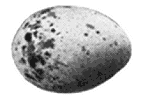
Greenish white. This species has gray upper parts with two
white wing bars, the throat, breast and superciliary
line are yellow, and the lores,
cheeks and streaks on the sides
are black. These birds nest abundantly
in the South Atlantic States,
usually in pines, and either on horizontal
limbs or in bunches of Spanish
moss. The nests are made of
slender pieces of twigs, rootlets and strips of
bark, and lined with either hair or feathers, the
eggs are three to five in number, pale greenish
white, specked about the large end with reddish
brown and gray. Size .70 × .50. Data.--Raleigh,
N. C., May 3, 1890. Nest 43 feet up on
limb of pine; made of grasses and hair.
663a. Sycamore Warbler. Dendroica dominica albilora.
Range.--Mississippi Valley, breeding north to
Ohio and Illinois, and west to Kansas and Texas;
winters south of the United States.
This bird is precisely like the last except that
the superciliary stripe is usually white. Their
nesting habits are precisely like those of the
last, and the nests are usually on horizontal
branches of sycamores; the eggs cannot be distinguished
from those of the Yellow-throated
Warbler.
664. Grace's Warbler. Dendroica graciæ.
Range.--Southwestern United States, abundant in Arizona and New Mexico.
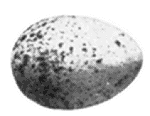
White. This Warbler is similar in markings and colors to the Yellow-throated
variety except that the cheeks are gray instead of black.
The nesting habits of the two species are the same, these birds
building high in coniferous trees; the nests are made of rootlets
and bark shreds, lined with hair or feathers; the eggs are white,
dotted with reddish brown and lilac. Size .68 × .48.

|

|
Page 402

|
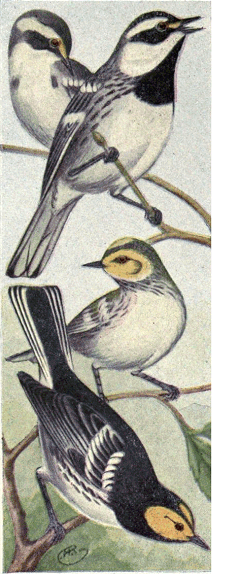
Black-throated Warblers.
Golden-cheeked Warblers. 665. Black-throated Gray Warbler. Dendroica nigrescens.
Range.--United States from the Rockies to the
Pacific coast and north to British Columbia; winters
south of our borders.
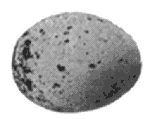
Greenish white. The general color of this species
is grayish above and white below as
is a superciliary line and stripe
down the side of the throat; the
crown, cheeks and throat are black
and there is a yellow spot in front
of the eye. They inhabit woodland
and thickets and are common in
such localities from Arizona to Oregon, nesting
usually at low elevations in bushes or shrubs;
the nests are made of grasses and fibres,
woven together, and lined with hair or fine
grasses, resembling, slightly, nests of the Yellow
Warbler. The eggs are white or greenish white,
specked with reddish brown and umber. Size
.65 × .52. Data.--Waldo, Oregon, June 1, 1901.
Nest 3 feet from the ground in a small oak in
valley. Collector, C. W. Bowles. (Crandall collection.)
666. Golden-cheeked Warbler. Dendroica chrysoparia.
Range.--Central and southern Texas south to
Central America.
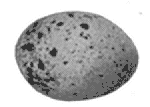
White. This beautiful and rare species
is entirely black above and on the
throat, enclosing a large bright yellow
patch about the eye and a
small one on the crown. In their
very restricted United States range,
the birds are met with in cedar timber where they
nest at low elevations in the upright forks of young trees of this variety. Their
nests are made of strips of cedar bark, interwoven with plant fibres and spider
webs making compact nests, which they line with hair and feathers. Their
three or four eggs are white, dotted and specked with reddish brown and umber.
Size .75 × .55.

|
|
|
Page 403
|

Black-throated Green Warbler.
Townsend's Warblers. 667. Black-throated Green Warbler. Dendroica virens.
Range.--Eastern United States, breeding from
southern New England, South Carolina in the Alleghanies,
and Illinois north to Hudson Bay; winters
south of the United States.
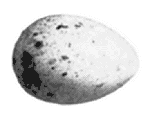
White. These common eastern birds are
similar to the last but the entire
upper parts are olive greenish.
They are nearly always found, and
always nest, in pines, either groves
or hillsides covered with young
pines. The nests are usually placed
out among the pine needles where they are very
difficult to locate, and resemble nests of the Chipping
Sparrow. I have found them at heights ranging
from six to forty or fifty feet from the ground.
The three or four eggs, which they lay in June,
are white, wreathed and speckled with brownish
and lilac. Size .60 × .50.
668. Townsend's Warbler. Dendroica townsendi.
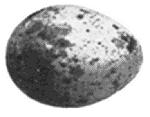
White. Range.--Western United States,
from the Rockies to the Pacific and
from Alaska southward; winters in
Mexico.
This is the common western representative
of the last species, and
is similar but has black ear patches
and the crown is black. They nest
in coniferous woods throughout their United
States and Canadian range, the nests being placed
at any height from the ground and being constructed
like those of the Black-throated Green.
Their eggs are not distinguishable from those of
the latter. Size .60 × .50.
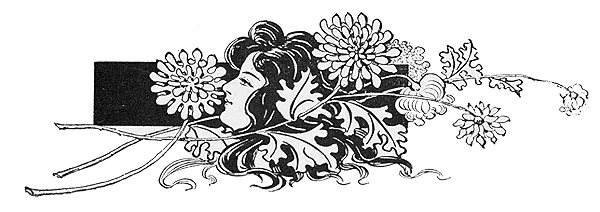
|

|
Page 404

|
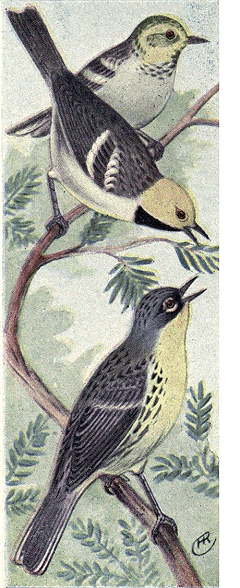
Hermit Warblers.
Kirtland's Warblers. 669. Hermit Warbler. Dendroica occidentalis.
Range.--Western United States and British Columbia
chiefly on the higher ranges. Winters
south to Central America.
This peculiar species has the entire head
bright yellow and the throat black; upperparts
grayish, underparts white. They are found nesting
in wild rugged country, high up in pine trees,
the nests being located among bunches of needles
so that they are very difficult to find. The nests
are made of rootlets, shreds of bark, pine needles,
etc., lined with fine grasses or hair. The three or
four eggs are laid during June or the latter part
of May; they are white or creamy white, and
sometimes with a faint greenish tinge, specked
and wreathed with brown and lilac gray. Size
.68 × .52.
670. Kirtland's Warbler. Dendroica kirtlandi.
Range.--Eastern United States; apt to be found
in any of the South Atlantic, Middle or Central
States, and in Ontario, Canada. Winters in the
Bahamas where by far the greater number of
specimens have been found.
This very rare Warbler is bluish gray above,
streaked with black, and yellow below with the
throat and sides streaked. Until the summer of
1903, the locality where they bred was a mystery.
The capture of a specimen, in June, in Oscodo Co.,
Michigan, led to the search for the nests by N.
A. Wood, taxidermist for the Michigan Museum
at Ann Arbor. He was successful in his quest
and found two nests with young and one egg. The
nest in which the egg was found contained two
young birds also. It was in a depression in the
ground at the foot of a Jack pine tree and only a few feet from a cart road.
The nest was made of strips of bark and vegetable fibres, lined with grass and
pine needles. The egg is white, sprinkled with brown in a wreath about the
large end. Size .72 × .56. It is estimated that there were thirteen pairs of the
birds in this colony.
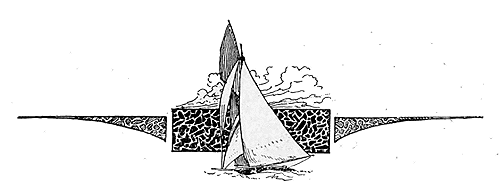
|
|
|
Page 405
|
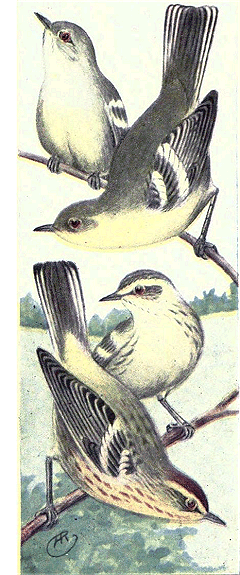
Pine Warblers.
Palm Warblers. 671. Pine Warbler. Dendroica vigorsi.
Range.--Eastern United States, breeding from
the Gulf to southern British Provinces; winters
in the Gulf States and southward.
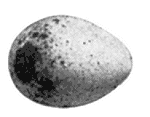
Dull white. This common eastern species
is greenish above and dull yellowish
below, streaked with
dusky on the sides. They are
almost exclusively found in pine
woods, either light or heavy
growth, where they can always
be located by their peculiar, musical
lisping trill. They nest high in these trees,
placing their nests in thick bunches of needles,
so that they are very difficult to locate. They
nest from March in the south to May in the northern
states, laying three or four dull whitish eggs,
specked or blotched with shades of brown and
lilac; size .68 × .52. Data.--Worcester, Mass.,
May 28, 1891. Nest 30 feet up in a pine; made of
pine needles and rootlets.
672. Palm Warbler. Dendroica palmarum palmarum.
Range.--Interior of North America, breeding
about Hudson Bay and northward and wintering
in the lower Mississippi Valley and the West
Indies.
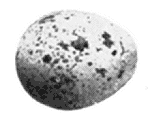
Creamy white. This species is brownish yellow
above and yellow on the throat and
breast, the crown and streaks on
the sides are chestnut. They are
found during migrations on or near
the ground on the edges of woods
or thickets and along roadsides;
have a peculiar habit of "teetering" their tail
which will readily identify them. They nest on the ground in, or on the edges
of swampy places, lining the hollow with grasses and rootlets. In May or June
they lay three or four eggs which are creamy white, variously specked with
brown and lilac; size .68 × .52.
672a. Yellow Palm Warbler. Dendroica palmarum hypochrysea.
Range.--Eastern North America, breeding from Nova Scotia, northward.
This is the common Yellow Redpoll Warbler of the eastern states, and is
very abundant during migrations. Their habits are the same, if not identical
with the interior species. Their nests are also like those of the last, placed
on the ground and the eggs are indistinguishable.

|

|
|
Page 406
|
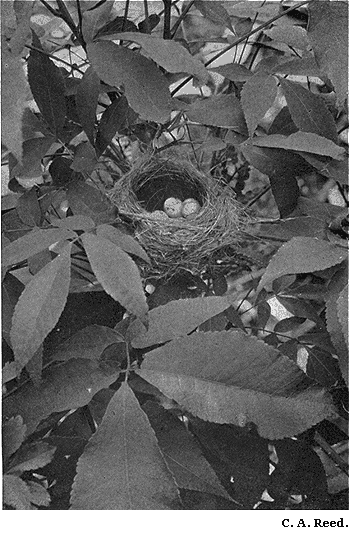
PRAIRIE WARBLER NEST.
|
|
|
Page 407
|
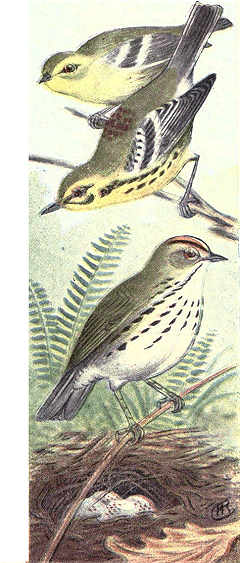
Prairie Warblers.
Oven-bird. 673. Prairie Warbler. Dendroica discolor.
Range.--Eastern United States, breeding from
the Gulf to Massachusetts and Ontario; winters
in southern Florida and the West Indies.
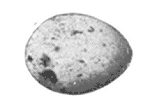
Whitish. A species readily recognized by
its bright yellow underparts and
the black stripes on the face and
sides; several bright chestnut
spots are in the middle of the
greenish back. These birds will
be found on dry scrubby hillsides
and valleys, where they nest in low bushes, and
the male will be found in the tops of the tallest
lookout trees delivering his quaint and very peculiar
lisping song. Their nests are handsomely
made of vegetable fibres and grasses, closely
woven together and lined with hair; this structure
is placed in the top of low bushes so that it is
well concealed by the upper foliage. Their three
to five eggs are whitish, specked and spotted
with shades of brown and neutral tints; size .64
× .48. Data.--Worcester, Mass., June 23, 1891.
Nest in the top of a young walnut, two feet from
ground; made of plant fibres and grasses. Four
eggs.
674. Oven-bird. Seiurus aurocapillus.
Range.--North America east of the Rockies,
breeding from the middle portions of the United
States, north to Labrador and Alaska. Winters
from the Gulf States southward.
This species is fully as often known as the
Golden-crowned Thrush, because of its brownish
orange crown bordered with black.
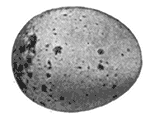
White. They are
woodland birds exclusively and nest on the
ground, arching the top over with rootlets or leaves, the nest
proper being made of grasses and leaf skeletons. As they
are concealed so effectually, the nests are usually found
by flushing the bird. The four to six eggs are white, slightly
glossy and spotted, blotched or wreathed with reddish brown
and lilac; size .80 × .60. Data.--Old Saybrook, Conn., June
19, 1899. Domed nest with a side entrance on the ground in
woods.

|

|
|
Page 408
|

ARCHED NEST OF OVEN-BIRD.
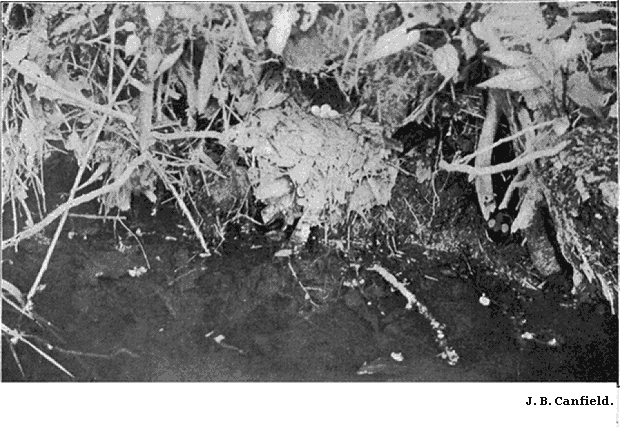
NEST AND EGGS OF LOUISIANA WATER-THRUSH.
|
|
|
Page 409
|
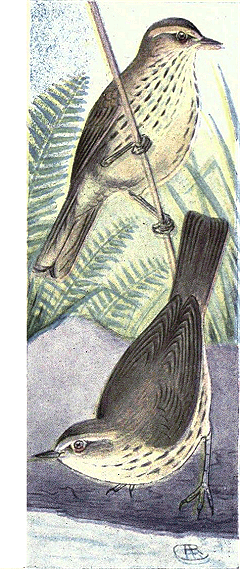
Louisiana Water Thrush.
Water-Thrush. 675. Water-Thrush. Seiurus novebora censis noveboracensis.
Range.--Eastern North America, breeding from
northern United States north to Hudson Bay and
Newfoundland. Winters from the Gulf to South
America.
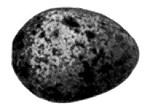
White. This species is uniform brownish
olive above and white below,
streaked heavily with blackish; it
has a whitish superciliary line. It
is known in most of the United
States only as a migrant, being
found in moist woods or swampy
places. They nest in such localities in their
breeding range, placing their nests among the
cavities of rootlets and stumps, the nest being
made of moss, leaves and rootlets. Their eggs
are white, profusely specked and blotched with
reddish brown and lavender gray. Size .80 × .60.
Data.--Listowell, Ontario, May 28, 1895. Nest in
a turned-up root over water; made of moss, grass
and hair. Collector, Wm. L. Kells. This set of
five is in the collection of Mr. C. W. Crandall.
675a. Grinnell's Water-Thrush. Seiurus noveboracensis notabilis.
Range.--Western North America, migrating between
the Mississippi Valley and the Rockies;
breeds from northern United States north to
Alaska; winters in the south.
This sub-species is said to be very slightly
larger, darker on the back, and paler below. Their
nesting habits and eggs are identical with those
of the last.
676. Louisiana Water-Thrush. Seiurus motacilla.
Range.--Eastern United States, breeding from the Gulf, north to southern
New England, Ontario and Minnesota; winters south of our borders.
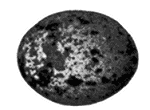
White. This species is similar to the last but is larger, grayer and
less distinctly streaked on the underparts. They nest in
swampy places, concealing their home in nooks among roots
of trees or under overhanging banks, the nest being made
of leaves, moss, mud, grasses, etc., making a bulky structure.
The eggs, which are laid in May and number from four to
six, are white, spotted and blotched with chestnut and neutral
tints. Size .76 × .62.

|

|
Page 410

|
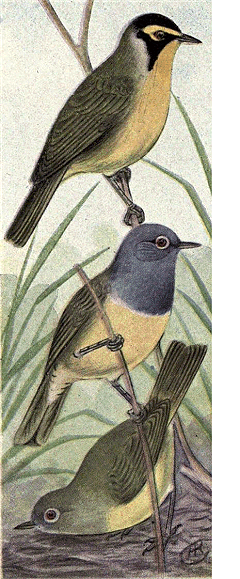
Kentucky Warbler.
Connecticut Warblers. 677. Kentucky Warbler. Oporornis formosus.
Range.--Eastern United States, breeding from
the Gulf to New York and Michigan; winters
south of the United States to South America.
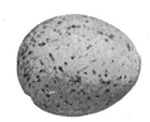
White. Crown and ear coverts black, underparts
and line over eye yellow;
no white in the plumage. These
birds are found in about such localities
as are frequented by Oven-birds,
but with a preference for
woods which are low and damp.
They are locally common in some of the southern
and central states. They are active gleaners of
the underbrush, keeping well within the depths
of tangled thickets. Like the Maryland Yellow-throat,
which has similar habits to those of this
bird, they are quite inquisitive and frequently
come close to you to investigate or to scold. They
nest on the ground in open woods or on shrubby
hillsides, making large structures, of leaves and
strips of bark, lined with grasses. The eggs are
white, sprinkled with dots or spots of reddish
brown and gray. Size .70 × .55. Data.--Greene
Co., Pa., May 26, 1894. 4 eggs. Nest a mass of
leaves, lined with rootlets, placed on the ground
at the base of a small elm sprout in underbrush
on a hillside.
678. Connecticut Warbler.--Oporonis agilis.
Range.--Eastern United States; known to breed
only in Manitoba and Ontario.
These birds have greenish upperparts and
sides, yellowish underparts, and an ashy gray
head, neck and breast; they have a complete whitish
ring about the eye, this distinguishing them
in any plumage from the two following species.
As they do most of their feeding upon the ground
and remain in the depths of the thickets, they are rarely seen unless attention
is drawn to them. They are quite abundant in New England in fall migrations,
being found in swampy thickets. They have been found breeding in Ontario
by Wm. L. Kells, the nest being on the ground in the woods among raspberry
vines. It was made of leaves, bark fibres, grass, rootlets and hair. The eggs
are white, specked with brown and neutral tints. Size .75 × .55.
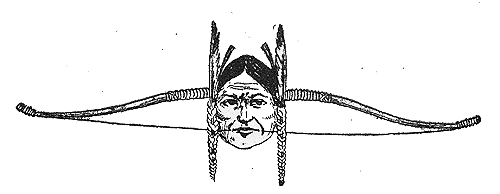
|
|
|
Page 411
|
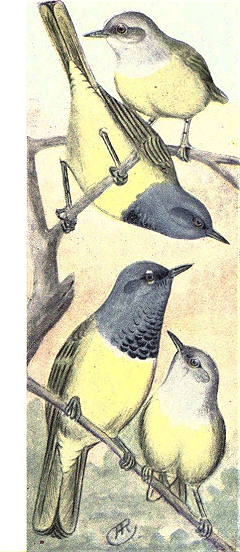
Mourning Warblers.
Macgillivray Warblers. 679. Mourning Warbler. Oporornis philadelphia.
Range.--Eastern United States, breeding from
northern New England, Pennsylvania, (Philadelphia)
and Nebraska northward.

White. Very similar to the last but with
no eye ring and a black patch on
the breast. The habits and nesting
habits of this species are very similar
to those of agilis, the nest being
on or very close to the ground.
With the exception of on mountain
ranges it breeds chiefly north of our borders.
The eggs are white, specked with reddish brown.
Size .72 × .55. They cannot be distinguished from
those of the last. Data.--Listowell, Ontario, June
5, 1898. Nest in a tuft of swamp grass in low
ground; not very neatly made of dry leaves,
grasses and hair. Collector, Wm. L. Kells. (Crandall
collection.)
680. Macgillivray Warbler. Oporornis tolmiei.
Range.--Western United States from the Rockies
to the Pacific, breeding north to British Columbia;
winters in Mexico and Central America.
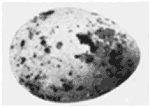
White. Similar to the last but with white
spots on the upper and lower eyelids,
black lores, and the black
patch on the breast mixed with
gray. These ground inhabiting
birds are found in tangled thickets
and shrubbery where they nest at
low elevations, from one to five feet from the
ground. Their nests are made of grasses and
shreds of bark, lined with hair and finer grasses,
and the eggs are white, specked, spotted and blotched with shades of brown
and neutral tints; size .72 × .52. Data.--Sonoma, Cal., May 17, 1897. A small
nest, loosely made of grasses (wild oats) lined with finer grasses; placed in
blackberry vines 14 inches from the ground in a slough in the valley.

|

|
Page 412

|
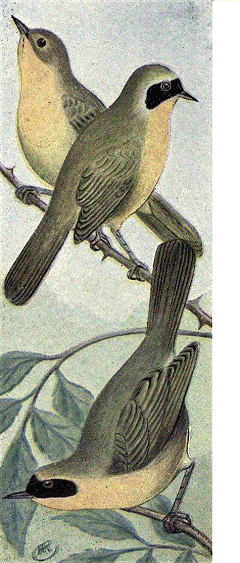
Maryland Yellow-throats.
Belding's Yellow-throat. 681. Maryland Yellow-throat. Geothlypis trichas trichas.
Range.--Eastern United States; this species has
recently been still further sub-divided so that this
form is supposed to be restricted to the south
Atlantic coast of the United States.
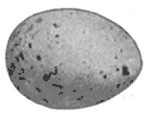
White. The Maryland Yellow-throat is represented in
all parts of the United States by one of its forms.
They are ground loving birds, frequenting swamps
and thickets where they can be
located by their loud, unmistakable
song of "Witchery, w i t c h e r y,
witch." They nest on or very near
the ground, making their nests of
grass, lined with hair; these are
either in hollows in the ground at
the foot of clumps of grass or
weeds, or attached to the weed stalks within a
few inches of the ground. They lay from three
to five eggs in May or June; these are white,
specked about the larger end with reddish brown
and umber, and with shell markings of stone gray.
Size .70 × .50. All the sub-species of this bird
have the same general habits of this one and their
eggs cannot be distinguished from examples of
the eastern form; the birds, too, owing to the
great differences in plumage between individuals
from the same place, cannot be distinguished with
any degree of satisfaction except by the ones who
"discovered" them.
681a. Western Yellow-throat. Geothlypis trichas occidentalis.
Range.--This variety, which is said to be brighter
yellow below, is ascribed to the arid regions of
western United States; not on the Pacific coast.
681b. Florida Yellow-throat. Geothlypis trichas ignota.
Range.--South Atlantic and Gulf coast to Texas.
681c. Pacific Yellow-throat. Geothlypis trichas arizela.
Range.--Pacific coast from British Columbia southward.
681e. Salt Marsh Yellow-throat. Geothlypis trichas sinuosa.
Range.--Salt marshes of San Francisco Bay.
|
|
|
Page 413
|
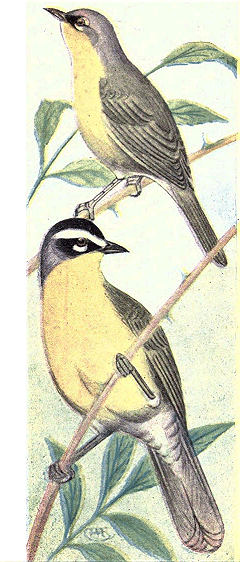
Rio Grande Yellow-throat.
Yellow-breasted Chat. 682. Belding's Yellow-throat. Geothlypis beldingi.
Range.--Lower California.
This peculiar species is like the common Yellow-throat
but has the black mask bordered by
yellow instead of white, and the black on the
forehead extends diagonally across the head from
in front of one eye to the rear of the other. Their
habits are like those of the other Yellow-throats
and the nests are similar to those of the latter,
which are frequently placed in cane over the
water. Nests found by Mr. Walter E. Bryant
were situated in clumps of "cat-tails" between
two and three feet above the water; the nests
were made of dry strips of these leaves, lined
with fibres; the eggs were like those of the common
Yellow-throats but larger; size .75 × .56.
682.1. Rio Grande Yellow-throat. Chamæthlypis poliocephala.
Range.--Mexico north to the Lower Rio Grande
Valley in Texas.
This Yellow-throat has the crown and ear
coverts gray, only the lores and forehead being
black. The nests and eggs of these birds, which
are fairly common about Brownsville, Texas, do
not differ from those of the other Yellow-throats.
683. Yellow-breasted Chat. Icteria virens virens.
Range.--Eastern United States, breeding from the Gulf
coast north to southern New England and Minnesota.
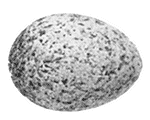
White. This strange but handsome species is very common
in underbrush and thickets in the south; they are
usually shy and endeavor, with success, to keep out of
sight, but their strange song and calls, consisting of
various whistles and squawks mingled together, are often
heard. Their nests are built in bushes or briars at low
elevations, being made of grass, strips of bark and leaves,
lined with finer grass; their eggs are white, sharply
speckled and spotted with various shades of brown and
lavender; size .90 × .70.
683a. Long-tailed Chat. Icteria virens longicauda.
Range.--United States west of the Plains, breeding from Mexico to British
Columbia.
This bird is said to be grayer and to have a slightly longer tail than the last.
Its nesting habits and eggs are precisely the same.
|

|
Page 414

|
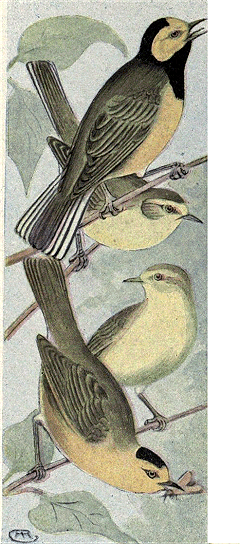
Hooded Warblers.
Wilson's Warblers. 684. Hooded Warbler. Wilsonia citrina.
Range.--Eastern United States,
breeding north to southern New
England and Michigan; winters
south of our borders.

White. This yellow and greenish species
can be identified by its black head,
neck and throat, with the large
yellow patch about the eye and the forehead. The
members of this genus are active fly-catchers,
darting into the air after passing insects in the
manner of the Flycatchers. They frequent tangled
thickets where they build their nests within
a few inches of the ground, making them of leaves,
bark and grass, lined with hair; the four or five
eggs are white, specked with reddish brown and
neutral tints; size .70 × .50. Data.--Doddridge Co.,
Mo., May 29, 1897. Nest one foot from the ground
in a small bush; made of leaves, strips of bark
and fine grasses.
685. Wilson's Warbler. Wilsonia pusilla pusilla.
Range.--Eastern North America, breeding from
northern United States northward; south to Central
America in winter.
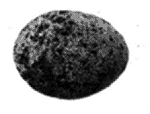
White. These handsome little black-capped
flycatching Warblers are abundant
during migrations, especially
in the spring, being found on the
edges of woods and in orchards.
They nest on the ground, usually
on the edges of swamps, embedding
their nests in the ground under the shelter of low
branches or on the edges of banks; the nest is of
bark strips, fibres and leaves, and the eggs are white, specked with reddish
brown; size .60 × .50.
685a. Pileolated Warbler. Wilsonia pusilla pileolata.
Range.--Western United States, breeding in the Rocky Mountain region from
Mexico to Alaska; winters south of the United States.
Similar to the eastern form but the yellow underparts and greenish back are
brighter. Like the last species, this form nests on the ground or very close to it,
in weeds or rank undergrowth, in swamps. Their eggs which are laid in May
or June are not distinguishable from those of the last.

|
|
|
Page 415
|
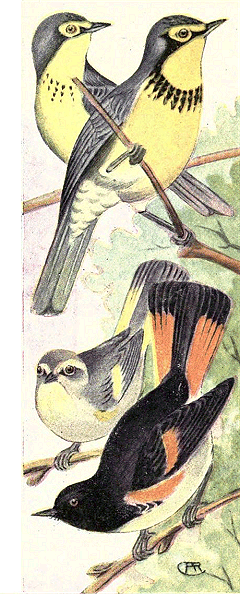
Canadian Warblers.
American Redstart. 685b. Golden Pileolated Warbler. Wilsonia pusilla chryseola.
Range.--Pacific coast of North America, breeding
from southern California in mountain ranges
north to British Columbia.
686. Canadian Warbler. Wilsonia canadensis.
Range.--Eastern North America, breeding from
Mass., New York, and Michigan north to Labrador
and Hudson Bay; winters in Central America.
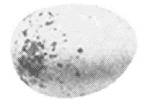
White. This handsome Warbler is plain
gray above and yellow below, with
a black stripe down the sides of
the neck and across the breast in
a broken band. They frequent
swamps or open woods with a
heavy growth of underbrush, where
they build their nests on or very close to the
ground. I have always found them in Massachusetts
nesting about the roots of laurels, the nests
being made of strips of bark, leaves and grass;
in June or the latter part of May they lay from
three to five white eggs, specked and wreathed
with reddish brown and neutral tints; size .68
× .50. Data.--Worcester, Mass., June 10, 1891.
Nest on the ground under laurel roots in swampy
woods; made entirely of strips of laurel bark
lined with fine grass.
[Illustration: ]
687. American Redstart. Setophaga ruticilla.
Range.--North America, chiefly east of the
Rockies, breeding in the northern half of the
United States and north to Labrador and Alaska;
winters south of our borders.
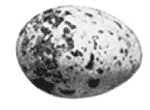
White. The male of this handsome, active and well known species is black with a
white belly, and orange patches on the sides, wings and bases of outer tail
feathers. They breed abundantly in swamps, open woods or
thickets by the roadside, placing their nests in trees or bushes
at elevations of from three to thirty feet above ground and
usually in an upright fork. The nests are very compactly
made of fibres and grasses, felted together, and lined with
hair. Their eggs are white, variously blotched and spotted
with brown and gray; size .65 × .50. Data.--Chili, N. Y., June
1, 1894. Nest, a cup-shaped structure of plant fibres lined with fine grasses
and hair; 4 feet from the ground in the crotch of a small chestnut.

|

|
|
Page 416
|

MALE REDSTART FEEDING YOUNG.
|
|
|
Pgee 417
|
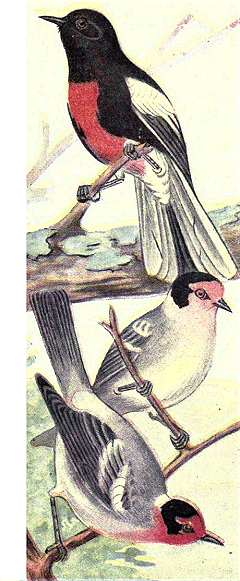
Painted Redstart.
Red-faced Warblers. 688. Painted Redstart. Setophaga picta.

White. Range.--Southern New Mexico
and Arizona, southward.
This beautiful Redstart is black
with a large white patch on the
wing coverts, white outer tail
feathers, and with the belly and
middle of the breast bright red.
These active birds, which have all the habits and
mannerisms of the common species, nest on the
ground in thickets or shrubbery usually near
water, and generally conceal their homes under
overhanging stones or stumps; the nests are
made of fine shreds of bark and grasses, lined
with hair; the eggs are white, dotted with reddish
brown; size .65 x .48. Data.--Chiricahua
Mts., Arizona, May 31, 1900. Nest of fine bark
and grass under a small bush on the ground.
689. Red-bellied Redstart. Setophaga miniata.
Range.--Mexico; admitted to our avifauna on
the authority of Giraud as having occurred in
Texas.
This species is similar to the last, but has a
chestnut crown patch, more red on the underparts,
and less white on the tail; it is not probable
that their nesting habits or eggs differ from
the last.
690. Red-faced Warbler. Cardellina rubrifrons.
Range.--Southern Arizona and New Mexico,
southward.
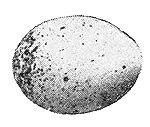
White. This attractive little Warbler is quite common in mountain
ranges of the southern Arizona. They nest on the ground on the
side hills, concealing the slight structure of grasses and rootlets
under overhanging shrubs or stones. Their eggs are specked
and blotched with light reddish brown and lavender. Size
.64 x .48. Data.--Chiricahua Mts., Arizona, May 31, 1902. Nest
in a depression under a tuft of grass growing about 8 feet up on
the side of a bank.

|

|
Page 418

|
WAGTAILS. Family MOTACILLIDÆ
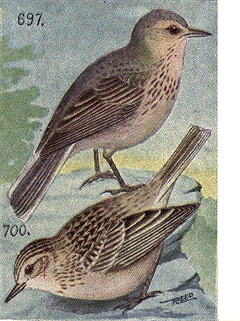
American Pipit.
Sprague's Pipit. 694. White Wagtail. Motacilla alba.
Range.--An Old World species; accidental in
Greenland.
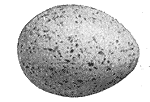
White. These birds are abundant
throughout Europe, nesting
on the ground, in stone walls,
or in the crevices of old
buildings, etc., the nests being
made of grass, rootlets,
leaves, etc.; the eggs are
grayish white, finely specked with blackish
gray. Size .75 × .55.
695. Swinhoe's Wagtail. Motacilla ocularis.
Range.--Eastern Asia; accidental in Lower
California and probably Alaska.
696. Alaska Yellow Wagtail. Budytes flavus alascensis.
Range.--Eastern Asia; abundant on the Bering Sea coast of Alaska in the
summer.

White. These handsome Wagtails are common in summer on the coasts
and islands of Bering Sea, nesting on the ground under tufts of
grass or beside stones, usually in marshy ground. Their eggs
number from four to six and are white, profusely spotted with
various shades of brown and gray. Size .75 × .55. Data.--Kamchatka,
June 20, 1896. Nest on the ground; made of fine rootlets,
grass and moss, lined neatly with animal fur.
697. Pipit. Anthus rubescens.
Range.--North America, breeding in the Arctic regions, and in the Rocky
Mountains south to Colorado, winters in southern United States and southward.
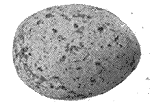
Gray. The Titlarks are abundant birds in the United States during
migrations, being found in flocks in fields and cultivated
ground. Their nests, which are placed on the ground in
meadows or marshes under tufts of grass, are made of moss
and grasses; the four to six eggs are dark grayish, heavily
spotted and blotched with brown and blackish. Size .75 × .55.
698. Meadow Pipit. Anthus pratensis.
Range.--Whole of Europe; accidental in Greenland.
This species is similar to the American Pipit and like that species nests on
the ground; they are very abundant and are found in meadows, woods or thickets
in the vicinity of houses. Their nests are made chiefly of grasses, lined
with hair; the eggs are from four to six in number and are grayish, very heavily
spotted and blotched with grayish brown. Size .78 × .58.
|
|
|
Page 419
|
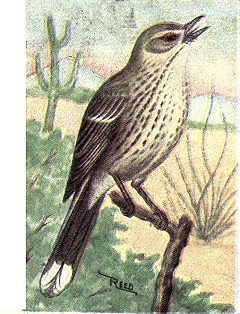
Sage Thrasher. 699. Red-throated Pipit. Anthus cervinus.
Range.--An Old World species; accidental in
the Aleutians and Lower California.
The nesting habits of this bird are like those
of the others of the genus.
700. Sprague's Pipit. Anthus spraguei.
Range.--Interior of North America, breeding
from Wyoming north to Saskatchewan.
Winters in the plains of Mexico.
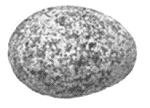
Grayish white. These birds are common on
the prairies and breed abundantly
on the plains of the interior
of northern United
States and Manitoba. They
have a flight song which is
said to be fully equal to that
of the famous European Skylark. They nest on
the ground under tufts of grass or up-turned
sods, lining the hollow with fine grasses; their
three or four eggs are grayish white, finely specked with grayish black or purplish.
Size .85 × .60. Data.--Crescent Lake, Canada. Nest of fine dried
grasses, built in the ground at the side of a sod.
DIPPERS. Family CINCLIDÆ
701. Dipper. Cinclus mexicanus unicolor.
Range.--Mountains of western North America from Alaska to Central America.
These short-tailed, grayish colored birds are among the strangest of feathered
creatures; they frequent the sides of mountain streams where they feed upon
aquatic insects and small fish. Although they do not have webbed feet, they
swim on or under water with the greatest of ease and rapidity, using their
wings as paddles. They have a thrush-like bill and the teetering habits of the
Sandpiper, and they are said to be one of the sweetest of songsters. They nest
among the rocks along the banks of swiftly flowing streams, and sometimes
beneath falls; the nests are large round structures of green moss, lined with
fine grass and with the entrance on the side. The eggs are pure white, four or
five in number, and laid during May or June. Size 1.00 × .70.
WRENS, THRASHERS, ETC. Family TROGLODYTIDÆ
702. Sage Thrasher. Oreoscoptes montanus.
Range.--Plains and valleys of western United States, east of the Sierra Nevadas,
from Montana to Mexico.
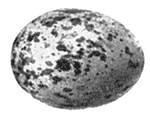
Greenish blue. This species is abundant in the sage regions of the west,
nesting on the ground or at low elevations in sage or other
bushes. Their nests are made of twigs, rootlets and bark
strips, lined with fine rootlets; the three or four eggs are a
handsome greenish blue, brightly spotted with reddish brown
and gray. Size .95 × .70. Data.--Salt Lake Co., Utah, May
11, 1900. Nest placed in a sage bush; made of twigs of the
same and lined with bark strips. Collector, W. H. Parker,
(Crandall collection.)
|

|
Page 420

|
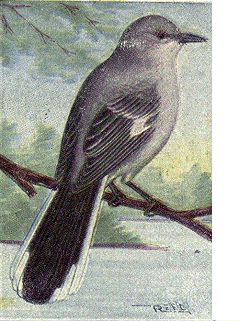
Mockingbird. 703. Mockingbird. Mimus polyglottos polyglottos.
Range.--South Atlantic and Gulf States,
north to New Jersey and Illinois.
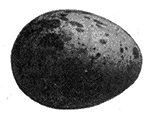
Dull greenish blue. These noted birds are
very common in the south
where they are found, and
nest about houses in open
woods, fields, and along
roadways; their nests are
rude, bulky structures of
twigs, grasses, leaves, etc.,
placed in trees or bushes
at low elevations; the three to five eggs are
usually dull greenish blue, boldly spotted with
brownish. Size .95 × .72.
703a. Western Mockingbird. Mimus polyglottos leucopterus.
Range.--Southwestern United States from
Texas to California, and southward.
This subspecies is as common in its range,
and its habits are the same as those of the eastern bird. The nests and eggs
are identical with those of the last, and like that variety they frequently nest
in odd places as do all common birds when they become familiar with civilization.

Catbird. 704. Catbird. Dumetella carolinensis.
Range.--North America, breeding from the
Gulf States to the Saskatchewan; rare on the
Pacific coast; winters in the Gulf States and
southward.
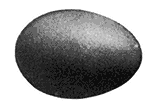
Bluish green. This well known mimic is abundant in the
temperate portions of its range, frequenting
open woods, swamps, hillsides
and hedges. Their
nests are usually low
down in bushes or trees,
and are constructed similarly
to those of the Mockingbird,
of twigs and rootlets;
a tangled mass of
vines and briers is a favorite
place for them to locate their home.
Their eggs are laid in the latter part of May
or during June, and are from three to five in
number and a bright bluish green in color,
unmarked. Size .95 × .70.

|
|
|
Page 421
|

Brown Thrasher. 705. Brown Thrasher. Toxostoma rufum.
Range.--Eastern North America, breeding
from the Gulf States north to Canada. Winters
in the Gulf States and southward.
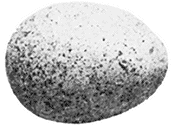
Greenish white. This large, handsome songster is found
breeding in just such localities
as are preferred by
the Catbird and the two
are often found nesting in
the same hedge or thicket.
The nests, too, are similar
but that of the Thrasher is
usually more bulky; besides
building in bushes
they frequently nest on
the ground, lining the hollow under some bush
with fine rootlets. Their three to five eggs
are laid during May or June; they are whitish
or pale greenish white, profusely dotted with
reddish brown. Size 1.05 × .80.
706. Sennett's Thrasher. Toxostoma longirostre sennetti.
Range.--Southern Texas and northeastern Mexico.
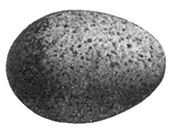
Greenish white. Very similar to the last but darker above and with the spots on the breast
blacker and more distinct. This species which is very abundant in the Lower
Rio Grande Valley nests the same as the last species
in thick hedges and the eggs are very similar to those
of the Brown Thrasher, but in a large series, average
more sparingly marked over the whole surface and with
a more definite wreath about the large end.
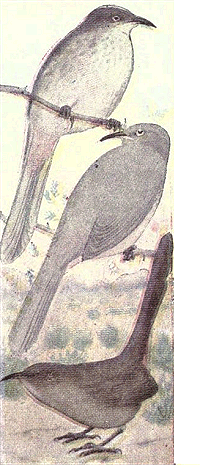
707a--708--710. Data.--Corpus
Christi, Texas, May 12, 1899. Nest
of twigs and vines in a bush in
thicket. Six feet from the ground.
707. Curve-billed Thrasher. Toxostoma curvirostre curvirostre.
Range.--Mexico, north to southern Texas and eastern
New Mexico.
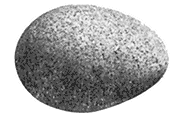
Bluish green. This species is a uniform ashy gray above and soiled
white below; the bill is stout and decurved. These
birds are as numerous in the Lower Rio Grande Valley
as are the Sennett's Thrasher, frequenting thickets
where they breed in scrubby bushes and cacti. Their
nests are rather larger and more
deeply cupped than are those of
the last species and the eggs can
easily be distinguished. They
have a ground color of light bluish
green, minutely dotted evenly
all over the surface with reddish
brown. Size 1.10 × .80.
Data.--Brownsville, Texas, April
6, 1900. 5 eggs. Nest of sticks and thorns on a cactus
in a thicket; 6 feet from the ground.
|

|
Page 422

|
707a. Palmer's Thrasher. Toxostoma curvirostre palmeri.
Range.--Very abundant in southern Arizona and southward into Mexico.
The nesting habits and eggs of these birds are exactly like those of the last;
they show a preference for placing their nests of sticks and thorny twigs upon
cacti at elevations below five feet from the ground. Like the last, they generally
raise two broods a season.
708. Bendire's Thrasher. Toxostoma bendirei.
Range.--Southern Arizona and Mexico; north locally to southern Colorado.
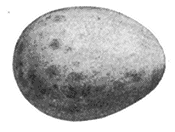
Grayish white. This species is not as abundant in the deserts of southern
Arizona as are the last species with which they associate.
They nest at low elevations in mesquites or cacti, laying
their first sets in March and early April and usually raising
two broods a season; their three or four eggs are dull
whitish, spotted and blotched with brownish drab and lilac
gray. Size 1.00 × .72. Data.--Tucson, Arizona, April 15,
1896. Nest 3 feet up in a cholla cactus; made of large
sticks lined with fine grasses.
709. San Lucas Thrasher. Toxostoma cinereum cinereum.
Range.--Southern Lower California.
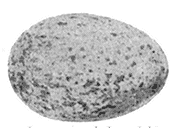
Pale greenish white. This species is similar to curvirostre but the under
parts are spotted with dusky. Their habits and nests
are similar to those of the other Thrashers and the three
or four eggs are pale greenish white, spotted with reddish
brown. Size 1.08 × .75. Data.--Santa Anita, June
3, 1896. 3 eggs. Nest in a cactus.
709a. Mearns's Thrasher. Toxostoma cinereum mearnsi.
Range.--Northern Lower California.
This species is described as darker than the last and with larger, blacker spots
on the breast and underparts.
710. California Thrasher. Toxostoma redivivum.
Range.--Southern half of California, west of the Sierra Nevadas.
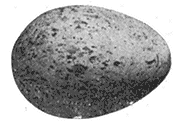
Bluish green. This species is more brownish than the other curve-billed
species and has a much longer and more curved
bill. They are common in the under brush of hillsides
and ravines, where they locate their nests at low elevations.
Their nests are made of sticks and grass, lined
with rootlets, and the three or four eggs are bluish
green with spots of russet brown. Size 1.12 × .82. Data.--San
Diego, Cal., Feb. 7, 1897. Nest of sticks and rootlets
in a grease-wood bush 4 feet from the ground.
Collector, Chas. W. Brown.
|
|
|
Page 423
|
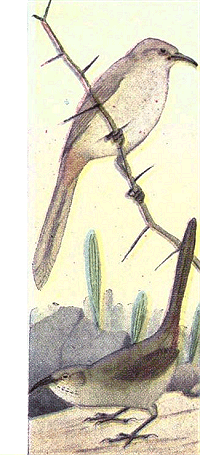
711--712. 711. Leconte's Thrasher. Toxostoma lecontei lecontei.
Range.--Desert regions of southwestern United States,
chiefly in the valleys of the Gila and Colorado Rivers.
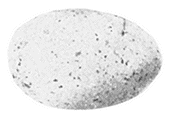
Pale greenish blue. This species is much paler
than the last and has a shorter
bill. It is fairly common but
locally distributed in its range
and nests at low elevations in
bushes or cacti. The three or
four eggs are pale greenish blue,
sparingly dotted with reddish
brown. Size 1.10 × .75. Data.--Phoenix,
Arizona, April 2, 1897. 3 eggs. Large nest
of dry twigs, rootlets, etc., lined with bits of rabbit hair
and feathers; 4 feet from the ground in a small shrub.
711a. Desert Thrasher. Toxostoma lecontei arenicola.
Range.--Northern Lower California.
This form of the last is said to differ in being darker
above. It is a very locally confined race, chiefly about
Rosalia Bay, Lower California. Its eggs will not be distinctive.
712. Crissal Thrasher. Toxostoma crissale.
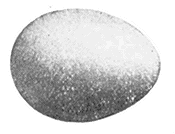
Pale greenish blue. Range.--Southwestern United States from western Texas
to eastern California; north to southern Utah and Nevada.
This species may be known from any other of the curve-billed
Thrashers by its grayish underparts and bright
chestnut under tail coverts. These sweet songsters are
abundant in suitable localities, nesting at low elevations in
chaparral. Their nests are large, and bulkily made of
sticks and rootlets; the eggs range from two to four in number
and are pale greenish blue, unmarked. Size 1.10 × .75.
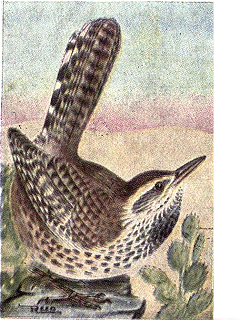
Cactus Wren. 713. Cactus Wren. Heleodytes brunneicapillus couesi.
Range.--Southwestern United States from
Texas to eastern California; north to southern
Nevada and Utah.
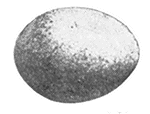
Creamy white. This species is the largest of the Wrens, being
8.5 inches in length. They are very common
in cactus and chaparrel districts, where
they nest at low elevations in bushes or cacti,
making large purse-shaped structures of
grasses and thorny twigs, lined with feathers
and with a small entrance at
one end. They raise two or
three broods a year, the first
set of eggs being laid early in
April; the eggs are creamy
white, dotted, so thickly as to
obscure the ground color, with
pale reddish brown. Size .95
× .65. Data.--Placentia, Cal., April 15, 1901.
Nest in cactus about 6 feet from the ground;
made of grasses and lined with feathers and rabbit
fur; nest 8 inches in diameter, 18 inches long.
|

|
Page 424

|
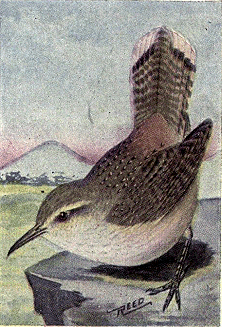
Rock Wren. 713a. Bryant's Cactus Wren. Heleodytes brunneicapillus bryanti.
Range.--Northern Lower California and
coast of southern California.
The nesting habits of this variety differ in
no respect from those of the last.
713b. San Lucas Cactus Wren. Heleodytes brunneicapillus affinis.
Range.--Southern Lower California.
Eggs indistinguishable from those of the last.
715. Rock Wren. Salpinctes obsoletus obsoletus.
Range.--United States, west of the plains,
breeding north to British Columbia, and south
to Mexico; winters in southwestern
United States and southward.
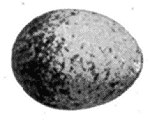
white. This species appears to be
quite abundant on rocky hillsides
throughout its range; like
most of the Wrens they draw
attention to themselves by their loud and varied
song. They nest in crevices or beneath overhanging rocks, making the
nest out of any trash that may be handy, such as weeds, grass, wool, bark, rootlets,
etc.; their eggs range from four to eight in number and are pure white,
finely specked with reddish brown. Size .72 × .50.
716. Guadalupe Rock Wren. Salpinctes guadeloupensis.
Range.--Guadalupe Island, Lower California.
A similar but darker and browner species than the Rock Wren. It breeds in
abundance throughout the island from which it takes its name, placing its
nests in crevices among the boulders or cavities of fallen tree trunks and, as is
often done by the last species, lining the pathway to the nest with small
pebbles. The eggs, which are laid from January to April, resemble, in all
respects, those of the common Rock Wren.
717. White-throated Wren. Catherpes mexicanus albifrons.
Range.--Northeastern Mexico and the Lower Rio Grande Valley in Texas.
The habits of the White-throated Wren are the same as those of the Canon
Wren, which variety is more common and better known; the eggs of this
species are not distinguishable from those of the next.

|
|
|
Page 425
|
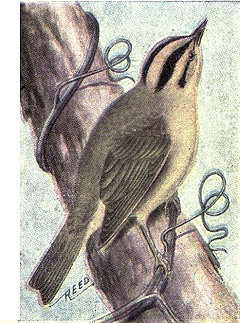
Carolina Wren. 717a. Canon Wren. Catherpes mexicanus conspersus.
Range.--Rocky Mountain region and west to
the Sierra Nevadas; north to Wyoming and
Idaho and south to New Mexico and Arizona.
The Canon Wrens are uniform rusty brown
all over except the large sharply defined white
throat patch; the underparts, wings and tail
are barred with black, and the back is specked
with white. Their name is well chosen for
they are found abundantly in rocky canyons,
ravines, and side hills. They nest in crevices
or caves among the rocks, placing their nests
in small niches; they are made of twigs, leaves,
grasses and feathers, and the three to six eggs,
which are laid from April to June according to
locality, are white, sprinkled and blotched with
reddish brown and lilac. Size .72 × .52.
717b. Dotted Canon Wren. Catherpes mexicanus punctulatus.
Range.--Pacific coast from Oregon to Lower California.
The habits and eggs of this coast form of the White-throated Wren do not
vary in any particular from those of the preceding variety.
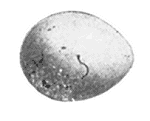
White. 718. Carolina Wren. Thryothorus ludovicianus ludovicianus.
Range.--Eastern United States, breeding from the Gulf to
southern New England and Illinois; resident in the greater
part of its range.
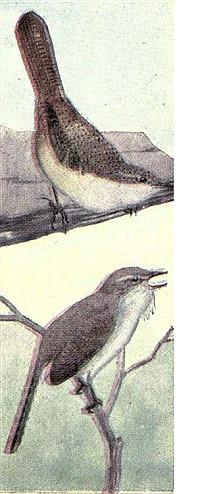
717a--719a. These loud-voiced songsters are well known in the south
where they are very abundant, being found along banks of
streams, in thickets, along walls, or about brush heaps. They
nest in almost any suitable nook or corner, in hollow trees
or stumps, bird boxes, about buildings, and in brush or
bushes. When in exposed positions, the nest, which is
made of all sorts of trash, is arched over; the eggs, which
are laid from March to June, and frequently later, as several
broods are sometimes reared in a season, are white,
profusely specked with light reddish brown and purplish.
Size .74 × .60.
718a. Florida Wren. Thryothorus ludovicianus miamensis.
Range.--Southern Florida.
A similar bird to the last but darker above and brighter
below. Its eggs are not distinguishable from those of
the last.
718b. Lomita Wren. Thryothorus ludovicianus lomitensis.
Range.--Southern Texas.
This sub-species is abundant along the Lower Rio
Grande in southern Texas, where its habits are the same as
those of the others and the eggs are not distinctive.
|

|
Page 426

|
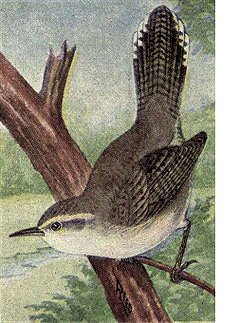
Bewick's Wren. 719. Bewick's Wren. Thryomanes bewicki bewicki.
Range.--South Atlantic and Gulf States, and
the Mississippi Valley north to Minnesota and
locally to the Middle States in the east.

White. This species is not common on the Atlantic
coast but in the interior it is
the most abundant of the Wrens,
nesting in holes in trees, stumps,
fences, bird boxes, tin cans, etc.,
filling the cavities with grass
and rootlets. Their eggs are
laid in the latter part of April
or May; they are white, specked and usually
wreathed about the large end with reddish
brown and purplish. Size .65 × .50.
719a. Vigors's Wren. Thryomanes bewicki spilurus.
Range.--Pacific coast of California.
This similar bird to the last has the same
general habits and the eggs are not in any way different from those of Bewick's
Wren.
719b. Baird's Wren. Thryomanes bewicki bairdi.
Range.--Southwestern United States, from western Texas to eastern California
and north to Colorado and Nevada.
Like the two preceding Wrens, this one nests in natural or artificial cavities,
and the four to seven eggs that they lay are precisely alike, in every respect,
to those of the others.
719c. Texas Wren. Thryomanes bewicki cryptus.
Range.--Texas, north in summer to western Kansas.
A very abundant bird in Texas. Nesting habits not unusual nor eggs distinctive.
719d. San Diego Wren. Thryomanes bewicki charienturus.
Range.--Coast of southern California.
719e. Seattle Wren. Thryomanes bewicki calophonus.
Range.--Pacific coast from Oregon to British Columbia.
These last two sub-species have recently been separated from Vigors's Wren,
but their habits and eggs remain the same as those of that variety.
719.1. San Clemente Wren. Thryomanes leucophrys.
Range.--San Clemente Island, California.
This species is similar to Vigors's Wren but is grayer and paler above. It is
not peculiar in its nesting habits and the eggs are like those of bewicki.
720. Guadalupe Wren. Thryomanes brevicauda.
Range.--Guadalupe Island.
A very similar species to the Vigors's Wren; nesting habits and the eggs are
not apt to differ in any respect.
|
|
|
Page 427
|
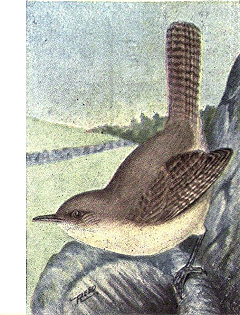
House Wren. 721. House Wren. Troglodytes aëdon.
Range.--North America east of the Mississippi,
breeding from the Gulf north to Manitoba
and Ontario; winters in the southern half
of the United States.
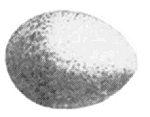
Pinkish white. This familiar and noisy little Wren is the
most abundant and widely distributed of the
Wrens; they are met with on
the edges of woods, swamps,
fields, pastures, orchards and
very frequently build about
houses, in bird houses or any
nook that may suit them; they
fill the cavity of the place they
may select with twigs, grass, feathers, plant
down, etc., and lay from five to nine eggs in a
set and frequently three sets a year. The eggs
are pinkish white, very profusely and minutely
dotted with pale reddish brown so as to make
the egg appear to be a nearly uniform salmon
color and with a wreath of darker spots about
the large end. Size .65 × .52. Data.--Gretna,
N. Y., May 29, 1896. Nest three feet from the ground in cavity of an apple tree;
made of twigs and grass, and lined with hair and feathers.
721a. Western House Wren. Troglodytes aëdon parkmani.
Range.--United States, from the Mississippi Valley to eastern California.
This variety is grayer above and below than the eastern form, but its habits
and eggs do not differ in any respect.
722. Winter Wren. Nannus hiemalis hiemalis.
Range.--Eastern North America, breeding from northern United States northward,
and south in the Alleghanies to North Carolina; winters in the United
States.
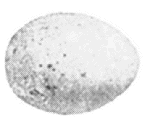
White. These are the smallest of the Wrens, being but four inches in
length; they have a very short tail which, like those of the
others, is carried erect over the back during excitement or
anger. They are very sly birds and creep about through stone
walls and under brush like so many mice; they have a sweet
song but not as loud as that of the House Wren. Their nests
are placed in crevices of stumps, walls, old buildings or in brush
heaps, being made of twigs and leaves, lined with feathers. Their eggs, which
are laid during May or June, are pure white, finely and sparingly dotted with
reddish brown; size .60 × .48.

|

|
Page 428

|

Winter Wren. 722a. Western Winter Wren. Nannus hiemalis pacificus.
Range.--Western North America from the
Rockies to the coast, north to Alaska.
This species is much browner both above and
below and is more heavily barred than the
last; its habits and eggs are like those of
hiemalis.
722b. Kadiak Winter Wren. Nannushiemalis helleri.
Range.--Kadiak Island, Alaska.
Said to be slightly larger and paler than
pacificus.
723. Alaska Wren. Nannus alascensis.
Range.--Aleutian and Pribilof Islands, Alaska.
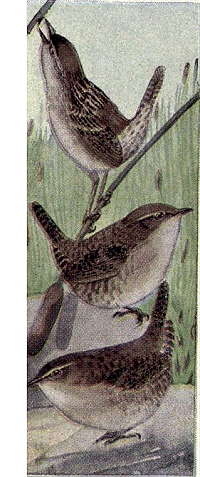
723--723.1--725a. 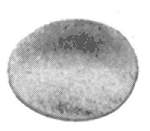
White. Larger and paler than the Western Winter
Wren. The habits of this species are similar to those of
the eastern Winter Wren; they nest between
boulders and in crevices of rocks or
stumps, making their nests of moss and
rootlets, lined with feathers. The eggs are
like those of the Winter Wren but slightly
larger; size .65 × .51.
723.1. Aleutian Wren. Nannus meliger.
Range.--Western Aleutian Islands to Alaska. Very similar
to the above, both in song and general habits. They
nest in the crevices of rocks or between boulders, making
their nests of rootlets and grass, lining it with hair and
feathers. Usually six eggs are laid, white with a few specks
of brown (.58 × .46).
724. Short-billed Marsh Wren. Cistothorus stellaris.
Range.--Eastern United States, breeding from the Gulf
to Manitoba and Maine.
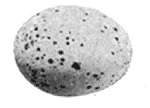
White. This species does not appear to be as common anywhere
as is the Long-billed variety, whose habits and nests are
similar. They nest in or on the borders of
marshes, and nests being globular structures
of grasses, lined with hair, and with
the entrance on the side; they are attached above the ground or
water in marsh grass or reeds. Their eggs, which number from
six to eight, are pure white; size .64 × .48.
|
|
|
Page 429
|
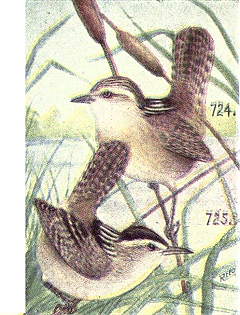
Short-billed Marsh Wren.
Long-billed Marsh Wren. 725. Long-billed Marsh Wren. Telmatodytes palustris palustris.
Range.--United States east of the Rockies,
breeding from the Gulf north to Manitoba and
New England; winters in southern United
States.

Pale brown. These birds are very abundant in suitable
localities throughout their range, breeding in
colonies in large marshes and in smaller numbers
in small marshy places.
Their nests are similar to those
of the last, being globular and
attached to cat-tails or reeds;
the entrance is a small round
hole in the side of the rush-woven
structures and the interior
is neatly finished with fine grass and hair.
They lay from five to eight eggs of a pale chocolate
color, dotted and spotted with darker
shades of the same; size .64 × .45. Data.--Delray,
Mich., May 27, 1900. Six eggs. Nest
a ball of woven flags and grasses, lined with
cat-tail down, and attached to rushes in salt marsh over two feet of water.
Collector, Geo. W. Morse.
725a. Tule Wren. Telmatodytes palustris paludicola.
Range.--Western United States on the Pacific coast; north to British
Columbia.
The nesting habits and eggs of these birds are in all respects like those of
the last.
725b. Worthington's Marsh Wren. Telmatodytes palustris griseus.
Range.--Coast of South Carolina and Georgia.
The habits and eggs of this paler form are identical with those of palustris.
725c. Western Marsh Wren. Telmatodytes palustris plesius.
Range.--United States west of the Rockies, except the Pacific coast; north to
British Columbia. This variety is like the Tule Wren but slightly paler; its
nesting habits and eggs are the same.
725.1. Marian's Marsh Wren. Telmatodytes palustris marianæ.
Range.--West coast of Florida.
This species is similar to the Long-billed variety but is darker and more barred
above and below. Its nests and eggs will not be found to differ materially
from those of the others of this genus.
|

|
Page 430

|
CREEPERS. Family CERTHIIDÆ
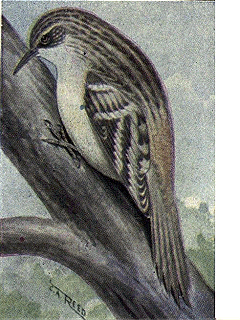
Brown Creeper. 726. Brown Creeper. Certhia familiaris americana.
Range.--Eastern North America, breeding
from the northern tier of states northward;
winters in the United States.
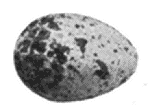
White. These peculiar, weak-voiced Creepers are
common in northern United States during the
winter, when they may be seen slowly toiling
up the tree trunks, searching the
crannies of the bark for larvae.
They make their nests behind
loose hanging bark on old tree
stubs, usually at low elevations,
building them of twigs, bark,
moss, etc., held together with
cobwebs. The eggs, which are laid in May
or June, are pure white, specked and spotted
with reddish brown; they average in size .58
× .48. The nests are most often found under
the loosened bark on coniferous trees.
[Illustration: ]
726a. Mexican Creeper. Certhia familiaris albescens.
Range.--Western Mexico north to southern Arizona.
The nesting habits of this brighter colored form are the same as those of
the others.
726b. Rocky Mountain Creeper. Certhia familiaris montana.
Range.--Rocky Mountains, breeding from New Mexico to Alaska.
The eggs of this grayer variety cannot be distinguished from those of the
eastern birds and the nests are in similar situations.
726c. California Creeper. Certhia familiaris occidentalis.
Range.--Pacific coast from southern California north to Alaska.
An abundant species, especially on mountain ranges, breeding behind the
bark chiefly on pine trees. The eggs are not different from those of the others.
726d. Sierra Creeper. Certhia familiaris zelotes.
Range.--Sierra Nevada Mountains in California and the Cascade Range in
Oregon.
Very similar to the last and with the same habits; eggs indistinguishable.
|
|
|
Page 431
|
NUTHATCHES AND TITS. Family SITTIDÆ
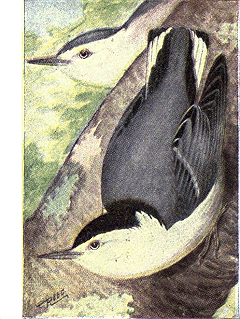
White-breasted Nuthatch. 727. White-breasted Nuthatch. Sitta carolinensis carolinensis.
Range.--United States east of the Rockies,
breeding from the Gulf to southern Canada;
resident throughout its range.

White. These birds are creepers, but unlike the last
species, these run about on the trunks, either
up or down; their tails are not pointed and
stiffened like those of the Brown
Creepers, and their plumage is
gray and black above with a
black crown, and white below.
They nest in holes in trees,
usually deep in the woods and
at any elevation from the
ground; they nearly always use deserted Woodpeckers'
holes but are said at times to excavate
their own, with great labor as their bills
are little adapted for that work. They line the
cavities with bark strips and hair or feathers,
and during April or May, lay from four to nine
white eggs, profusely specked with reddish
brown and lilac. Size .80 × .60. Data.--Lancaster, Mass., May 16, 1902. Nest in
hole in an oak tree, 45 feet above ground; made of fine strips of bark fibre and
hair.
727a. Slender-billed Nuthatch. Sitta carolinensis aculeata.
Range.--North America, west of the Rockies and from Mexico to British Columbia.
This species is as abundant in the west as the last is in the east, and nests in
like situations. The eggs cannot be distinguished from those of the eastern
birds.
727b. Florida White-breasted Nuthatch. Sitta carolinensis atkinsi.
Range.--Florida and the South Atlantic coast to South Carolina.
The habits and eggs of these birds are like those of the northern ones.
727c. Rocky Mountain Nuthatch. Sitta carolinensis nelsoni.
Range.--Rocky Mountains from Mexico north to British Columbia.
Their nesting habits or eggs are not distinctive in any respect.
727d. San Lucas Nuthatch. Sitta carolinensis lagunæ.
Range.--Mountain ranges of Lower California.
Said to be like aculeata but with the wings and tail slightly shorter.
|

|
Page 432

|
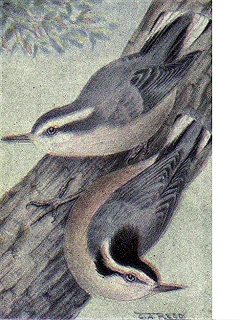
Red-breasted Nuthatch. 728. Red-breasted Nuthatch. Sitta canadensis.
Range.--North America, breeding from the
northern tier of states northward, and farther
south in mountain ranges; winters south to
southern United States.
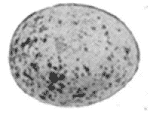
White. This species is smaller than
the last and has reddish brown
underparts and a black stripe
through the eye. The breeding
habits are the same as those
of the White-bellied variety, but
these birds almost invariably
coat the tree below the opening with pitch,
for what purpose is unknown. They lay from
four to six white eggs, numerously spotted
with reddish brown; size, .60 × .50. Data.--Upton,
Maine, June 21, 1898. Nest in hole of
dead birch stub, 20 feet from the ground; made
of strips of bark and a few feathers. 5 eggs.
729. Brown-headed Nuthatch. Sitta pusilla.
Range.--South Atlantic and Gulf States.
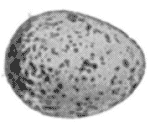
White. This species has a yellowish brown crown and whitish underparts. Their
habits are like those of the other Nuthatches, they nesting in
cavities at varying heights, from two to fifty feet from the ground.
That they sometimes depart from the usual custom is evidenced
by the data accompanying this egg. They lay from four to
seven eggs, white with profuse markings of reddish brown; size
.60 × .48. Data.--St. Mary's, Ga. Nest situated under the bark
of an old dead pine stump, 4 feet from the ground; made of fine
strips of bark.
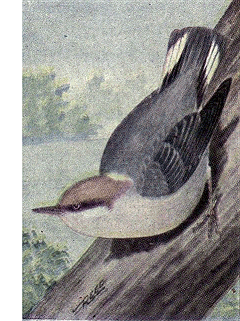
Brown-headed Nuthatch. 730. Pygmy Nuthatch. Sitta pygmæa pygmæa.
Range.--North America west of the Rockies,
breeding from Mexico north to British Columbia.
Resident throughout its range.
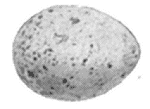
White. This species has an olive gray crown bordered
by dusky, the back is ashy blue and the
underparts soiled white or rusty. They are
common in mountains of western United States,
nesting in holes in trees the
same as the other species of
Nuthatches. They lay from five
to nine eggs which are white,
speckled thickly with reddish
brown; size .60 × .50. Data.--Huachuca
Mts., Arizona, May
25, 1901. Nest in cavity (10 inches deep) in
dead pine stump about 15 feet from the ground;
composed of a mass of vegetable down; altitude
9000 feet.
|
|
|
Page 433
|
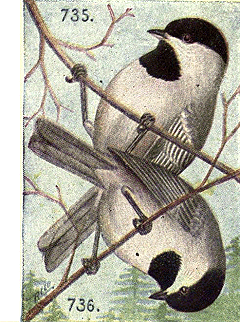
Tufted Titmouse.
Black-crested Titmouse. 730a. White-naped Nuthatch. Sitta pygmæa leuconucha.
Range.--Lower California.
Like the last but grayer above and white
below. Its habits and eggs are the same as
those of the Pygmy Nuthatch.
731. Tufted Titmouse. Bæolophus bicolor.
Range.--Eastern United States, resident and
breeding from the Gulf north to New York and
Illinois.
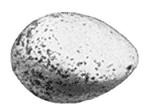
White. This species has a grayish
crest and upper parts, and is
white beneath with brownish
sides and black forehead.
These common and noisy
birds nest in natural cavities
in trees or in holes deserted
by Woodpeckers; they may
be found at any elevation, from two to thirty
feet from the ground. They line the bottom
of the cavity with leaves, bark, fibres and hair, and during April or May lay
five to eight white eggs, plentifully specked with reddish brown. Size .74 × .54.
732. Black-crested Titmouse. Bæolophus atricristatus atricristatus.
Range.--Lower Rio Grande Valley in Texas and southward.

White. This Titmouse has a black crest and the forehead is white; otherwise similar
to the preceding. Like the last, these birds nest in deserted
Woodpeckers' holes and natural cavities in trees, either in open
woods or in the vicinity of habitations. Their eggs are sparsely
spotted with reddish brown, and not usually distinguishable from
those of the Tufted Titmouse. Size .70 × .54. Data.--Brownsville,
Texas, May 11, 1892. Nest of moss, hair, down and wool in
cavity in tree in open woods near town; 4 feet from the ground.

|

|
Page 434

|
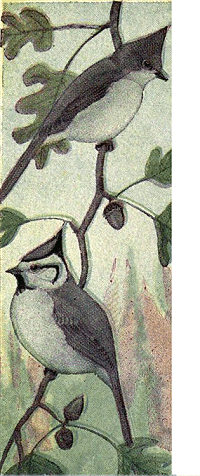
733--734. 733. Plain Titmouse. Bæolophus inornatus inornatus.
Range.--California and Oregon west of the Sierra Nevadas.
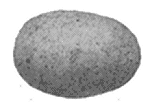
White. This common, slightly crested Titmouse is grayish brown
above and grayish white below. They nest anywhere in
cavities that meet with their approval, about
old buildings, in fence posts, etc., as well
as holes in trees. Their eggs range from
five to eight in number and are white, usually
spotted with pale brownish. Size .72 ×
.52. Data.--Tulare Co., California, April 3,
1895. Nest in an oak tree, 32 feet from the
ground, in a natural cavity of a horizontal limb; composed
of grasses, feathers and fur.
733a. Gray Titmouse. Bæolophus inornatus griseus.
Range.--Southeastern United States, from Colorado and
Nevada southward.
The nesting habits of this gray Titmouse are just the
same as those of the other.
733b. Ashy Titmouse. Bæolophus inornatus cineraceus.
Range.--Southern Lower California.
The habits of this variety are the same as those of the Plain Titmouse and
doubtless the eggs are also.
734. Bridled Titmouse. Bæolophus wollweberi.
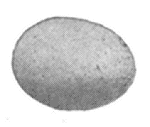
White. Range.--Mexico north to southern Arizona, New Mexico and western Texas.
This handsome species is quite abundant in the mountains
of southern Arizona, and nests in woods or about ranches,
lining the cavities of trees with moss, down, leaves, etc. The
three to seven eggs that they lay are pure white, unmarked.
Size .65 × .52. Data.--Huachuca Mountains, Arizona, April
5, 1901. Nest in the natural cavity of a live oak, 12 feet
from the ground; cavity lined
with bark and feathers.
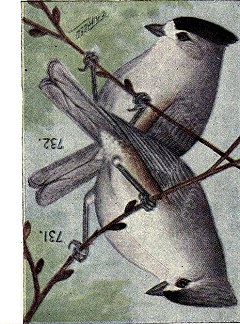
Chickadee.
Carolina Chickadee. 735. Chickadee. Penthestes atricapillus atricapillus.
Range.--Eastern North America, breeding
from the Middle and Central States northward
to Labrador; only migratory to a slight extent.
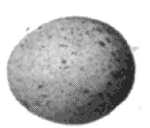
White. The Chickadee is too well known
to need any description; suffice it
to say that they are the favorites,
with everybody, among all the
North American birds. They breed
in holes in trees in orchards or
woods, and also in bird boxes. I
have found by far the greater number in decayed
birch stubs. They line the cavities
with fine grasses and feathers, and during
May or June lay from five to eight white
eggs, dotted with reddish brown; size .55 × .45.
|
|
|
Page 435
|
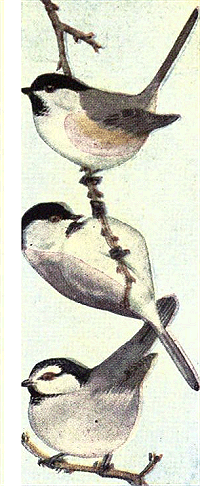
735b--737--738. 735a. Long-tailed Chickadee. Penthestes ataricapillus septentrionalis.
Range.--Rocky Mountain region, north to British Columbia.
This variety is very similar to the last but has a slightly
longer tail and the colors are purer. Its nesting habits
are the same and the eggs are indistinguishable from those
of the eastern Chickadee.
735b. Oregon Chickadee. Penthestes atricapillus occidentalis.
Range.--Pacific coast from California to Alaska.
The habits and eggs of this slightly darker variety are
just the same as those of the common Chickadee of
the east.
736. Carolina Chickadee. Penthestes carolinensis carolinensis.
Range.--Southern United States from the
Gulf to New Jersey and Illinois.
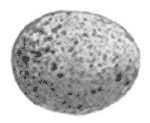
White. The southern Chickadee is smaller than
the northern and the wing coverts and feathers have little or
no white edgings. Their nesting habits are in every particular
the same as those of atricapillus and the eggs cannot be distinguished
with certainty, but average smaller; size .53 × .43.
736a. Plumbeous Chickadee. Penthestes carolinensis agilis.
Range.--Eastern and central Texas.
This variety is said to be more plumbeous above and much whiter below
than the preceding. No differences can be found in the eggs of the two varieties
and the nesting habits are the same.
737. Mexican Chickadee. Penthestes sclateri.
Range.--Mountains of western Mexico north to southern Arizona.
This species has the black more extended on the throat and the under parts
are grayish of a lighter shade than the upper, the cheeks, however, remaining
white. Their nests are in hollow stubs and the eggs are indistinguishable from
those of the foregoing Chickadees.
738. Mountain Chickadee. Penthestes gambeli gambeli.
Range.--Rocky Mountain region and west to the Pacific; north to British
Columbia chiefly in higher ranges.
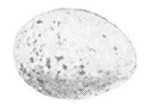
White. This handsome little Titmouse has a white superciliary
line, leaving a black stripe through the eye. Their habits
are like those of the other Chickadees and they are equally
confiding and inquisitive. Their eggs range from five to eight
in number and are either pure white or faintly marked with
reddish brown; size .60 × .45. Data.--Estes Park, Colorado,
June 8, 1803. Nest in an old Sapsucker's hole in a live aspen
tree, 28 feet from the ground; cavity lined with hair and fur.
|

|
Page 436

|
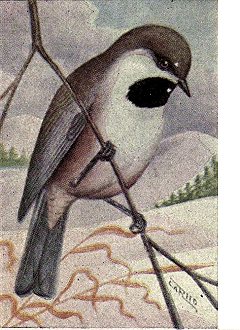
Hudsonian Chickadee. 739. Alaska Chickadee. Penthestes cinctus alascensis.
Range.--Northern Alaska and eastern Siberia.
This bird, which is most like the Hudsonian
Chickadee, nests in the usual manner and its
eggs are like those of the common Chickadee
of the east.
740. Hudsonian Chickadee. Penthestes hudsonicus hudsonicus.
Range.--Western half of British America.
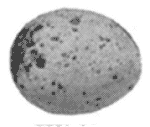
White. These brown capped Chickadees
are very abundant throughout the
northwest and are even tamer than
our United States varieties. They
usually make their nests at low elevations
in dead and decayed stumps
and line the bottom of the cavity,
which varies from three to eight inches in
depth, with moss and fur. Their eggs, which
they lay in May, June or July, are white, specked with reddish brown and
cannot with any certainty be distinguished from those of the Black-capped
Chickadees, the eggs of all the species showing considerable variations; size
.60 × .45.
740a. Acadian Chickadee. Penthestes hudsonicus littoralis.
Range.--Kowak River, northwest Alaska.
A larger and grayer form of the last species; nesting habits and eggs not
differing.
740b. Columbian Chickadee. Penthestes hudsonicus columbianus.
Range.--Rocky Mountains from northern United States to Alaska.
Like hudsonicus but with the crown slaty instead of brownish. No difference
can be distinguished either in their habits or eggs.
740c. Canadian Chickadee. Penthestes hudsonicus littoralis.
Range.--Eastern half of Canada and northern New England and New York.
These birds were formerly hudsonicus in company with the western ones, but
they are now supposed to be a trifle smaller and with the crown duller; this
division does not affect the similarity of their habits and eggs.
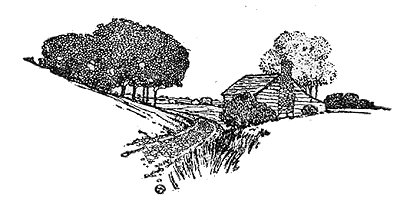
|
|
|
Page 437
|
741. Chestnut-backed Chickadee. Penthestes rufescens rufescens.
Range.--Pacific coast from Oregon to Alaska.
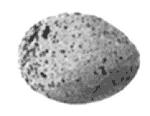
White. This species is similar to the Hudsonian in having a
brown crown and black throat, but has in addition, a chestnut
colored back and sides. They breed locally in Oregon,
more commonly in Washington and are abundant in British
Columbia, making the nests of animal fur in holes in dead
stubs. Their eggs vary in number from five to eight and are
creamy white, dotted with reddish; size .60 × .45. Data.--Dayton, Oregon,
May 28, 1906. Nest of hair and fur in willow stub, 10 feet up.
741a. California Chickadee. Penthestes rufescens neglectus.
Range.--Coast regions of California.
This variety is not as rufous on the sides as the more northern one. Its habits
and eggs are the same.
741b. Barlow's Chickadee. Penthestes rufescens barlowi.
Range.--About Monterey Bay, California.
This variety is said to have no rusty on the flanks. Its habits and eggs are
like those of the others.
742a. Pallid Wren-Tit. Chamæa fasciata henshawi.
Range.--Interior of California from Lower California to the Sacramento
Valley.
This duller colored variety has the same nesting habits and similar eggs to
those of the Coast Wren-tit.
742b. Coast Wren-Tit. Chamæa fasciata fasciata.
Range.--Pacific coast from southern California north to Oregon.
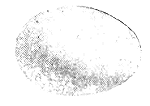
White. These peculiar brownish gray colored birds frequent the tangled
underbrush of ravines and mountain sides where they lead
the life of a recluse. They nest at low elevations in the densest
thickets, making them of twigs, strips of bark, grasses and
feathers, compactly woven together and located in bushes from
one to four feet from the ground. They lay from three to five
plain, unmarked, pure white eggs; size .75 × .54. Data.--Wrights,
Cal. Nest in a tangle of vines in a deep ravine; composed
of strips of bark, moss and grasses, lined with cattle hair; a bulky nest.
743. Bush-Tit. Psaltriparus minimus minimus.
Range.--Pacific coast of northern California, Oregon and Washington.
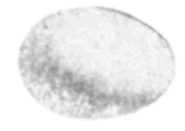
White. These diminutive little birds build nests that are marvels of
architecture, making long purse-like structures, suspended from
twigs usually at low elevations from the ground. The nests are
made of moss, lichens, fibres, ferns and grasses and lined with
feathers or wool; the opening is on one side near the top, and a
typical nest averages 12 inches in length, by 4.5 inches in diameter
at the bottom and 3 at the top. Their eggs number from four to
nine and are pure white; size .54 × .40. The birds are very active and have the
same habits as the Chickadees, being seen often suspended, head downward,
from the ends of twigs, in their search for insects.
|

|
Page 438

|
743a. California Bush-Tit. Psaltriparus minimus californicus.
Range.--California with the exception of the northern part.
This sub-species, which is like the last but with a lighter brown head, has
the same habits, nests in the same manner and its eggs are not distinguishable
from those of the others.
743b. Grinda's Bush-Tit. Psaltriparus minimus grindæ.
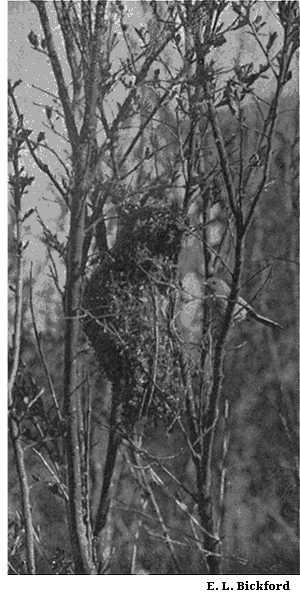
BUSH-TIT AND NEST. Range.--Southern Lower California.
The nesting habits of this variety,
which is very similar to the last, do
not vary in any respect; eggs indistinguishable.
744. Lead-colored Bush-Tit. Psaltriparus plumbeus.
Range.--Rocky Mountain region
from Wyoming south to Arizona.
This species suspends its semi-pensile
nests in bushes or trees, and some
times from the mistletoe, which grows
on numerous trees in southern Arizona.
The nests are composed like
those of the Cal. Bush-Tit and range
from 6 to 10 inches in length. The
eggs are white, five or six in number
and measure .55 × .42.
745. Lloyd's Bush-Tit. Psaltriparus melanotis lloydi.
Range.--Northern Mexico north into
western Texas and New Mexico.
This species is similar to the lead-colored
Bush-Tit but has the ear coverts
glossy black. Like the others, it
builds a long pensile nest of similar
material and suspended from the
extremities of limbs near the ground
The five to seven eggs are pure white.
Size .58 × .42.

|
|
|
Page 439
|
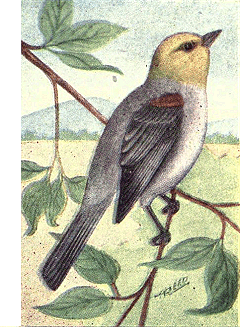
Verdin. 746. Verdin. Auriparus flaviceps flaviceps.
Range.--Mexican border of the United States,
north to Colorado and Nevada.
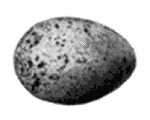
Greenish blue. This Bush-Tit has a bright yellow head and
throat, the upper parts being gray and the
belly, white. They are abundant in chaparral
brush, locally throughout their
range. Their large globular
nests are situated in bushes at
low elevations from the ground,
and are made of twigs and
weeds, softly lined with fur and
feathers. Their three to six eggs
are pale greenish blue, specked and dotted
with reddish brown. Size .58 × .44. Data.--Brownsville,
Texas, May 8, 1894. Large nest
of sticks and thorns, lined with hair and
feathers, and located in a bush in brush thicket,
8 feet from the ground.
746a. Cape Verdin. Auriparus flaviceps lamprocephalus.
Range.--Lower California.
This new sub-species is said to have shorter wings and tail, and also to be
brighter yellow on the head. Its habits and eggs will not differ from those of
the common Verdin or Yellow-headed Bush-Tit.
WARBLERS, KINGLETS and GNATCATCHERS. Family SYLVIIDÆ
747. Kennicott's Willow Warbler. Acanthopneuste borealis.
Range.--Asia, casually found in Alaska.
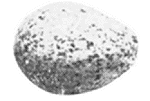
White. This species breeds in the extreme northern parts of Asia, and
I believe its eggs have never been found on this continent. They
build their nests of moss and grasses, on the ground in open
woods, concealing them under tufts of grass or tussocks of earth.
The three to five eggs are white, spotted with pale reddish brown.
Size .70 × .50.
748. Golden-crowned Kinglet. Regulus satrapa satrapa.
Range.--North America, breeding from northern United States northward,
and south in the Rockies to Mexico, and in the Alleghanies to the Carolinas;
winters throughout the United States.
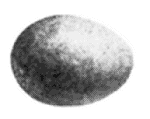
Gray. This rugged little fellow appears to be perfectly content in our
northern states even during the most severe winters and leaves
us early in the spring for his breeding grounds farther north.
They are usually found in company with Chickadees and, like
them, may be seen hanging to twigs in all sorts of positions as
they search for their meagre fare. Their nests are large, round
structures of green moss, bark strips and fine rootlets, very
thickly lined with soft feathers; these are placed in forks or partially suspended
among the branches of spruce trees, usually high above the ground. During
June they lay from five to ten eggs of a dull whitish or grayish color, spotted
heavily with pale brown and lilac. Size .55 × .42.
|

|
Page 440

|
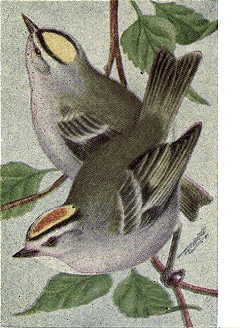
Golden-crowned Kinglets. 748a. Western Golden-crowned Kinglet. Regulas satrapa olivaceus.
Range.--Pacific coast from southern California
to Alaska.
This variety is said to be brighter colored
than the last; its habits and eggs are the same
in all particulars.
749. Ruby-crowned Kinglet. Regulus calendula calendula.
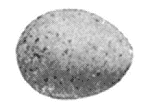
White. Range.--North America, breeding
from the northern border of
the United States northward,
and farther south in mountain
ranges; winters in southern
United States.
This little bird is of the size
of the Golden-crowned Kinglet (4.25 inches
long) and has a partially concealed patch of
red on the crown, not bordered by black and
yellow as is the last species. Their nests are
similar in construction to those of the last species and are situated in coniferous
trees at any altitude from the ground. Their four to nine eggs are creamy
white, finely specked with reddish brown. Size .56 × .44.
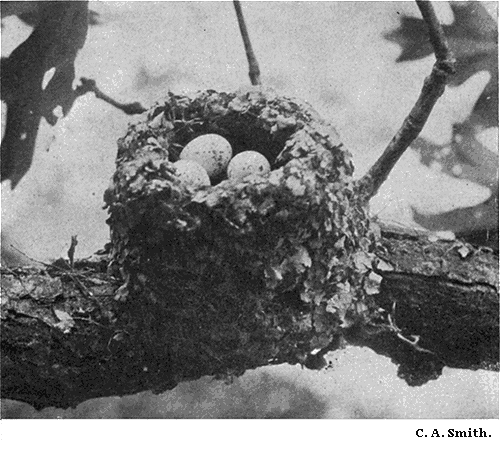
NEST AND EGGS OF BLUE-GRAY GNATCATCHER.
|
|
|
Page 441
|
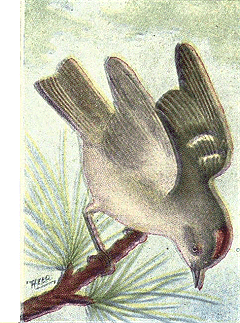
Ruby-crowned Kinglet. 749a. Sitka Kinglet. Regulas calendula grinnelli.
Range.--Pacific coast, breeding in Alaska.
Said to be brighter than the preceding variety.
749b. Dusky Kinglet. Regulus calendula obscurus.
Range.--Guadalupe Island, Lower California.
This species nests during March in the large
cypress and pine groves at high elevations
above the ground. The nests are similar in
construction to those of the common Ruby-crown,
and the eggs are scarcely different from
some specimens of that species; white, dotted
and wreathed with reddish brown. Size .56
× .43.
751. Blue-Gray Gnatcatcher. Polioptila cærulea cærulea.
Range.--United States, east of the Rockies, breeding from the Gulf to the
Middle and Central States; casually north to Massachusetts and Minnesota.
These graceful birds are bluish gray above with a black forehead and central
tail feathers, and white underparts. They are common in wooded districts in
the south, where they saddle their beautiful nests upon horizontal branches or
in crotches usually at quite an elevation from the ground; they
resemble large Ruby-throated Hummers' nests but the walls are
much higher and thicker; they are made of plant fibres and
down, lined with cottony substances and hair, and covered on
the outside with lichens to match the limb upon which it is
placed.

Bluish white. Their eggs are bluish white, specked with reddish chestnut.
Size .58 × .45. Data.--Chattanooga, Tenn., April 30, 1900.
Nest of moss, covered with lichens and lined with hair and feathers; 20 feet
from the ground in a small tree.
751a. Western Gnatcatcher. Polioptila cærulea obscura.
Range.--Western United States and Lower California.
The habits and eggs of this sub-species are the same as those of the eastern
bird, and the nests do not differ except, perhaps, in less ornamentation of the
exterior.
752. Plumbeous Gnatcatcher. Polioptila plumbea.
Range.--Mexican boundary from western Texas to southern California.
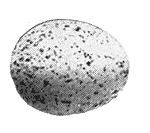
Greenish blue. This species has a bright shining black crown and more black
on the tail than the eastern Gnatcatcher. They saddle their
nests upon the branches of trees or in upright forks, usually at an
elevation of ten feet or more from the ground; the nests are
made of plant fibres and fine bark strips, compactly felted together,
and with little, if any, ornamental lichens on the exterior.
Their eggs are pale greenish blue, spotted with reddish brown, and vary from
three to five in number. Size .54 × .44.
|

|
Page 442

|
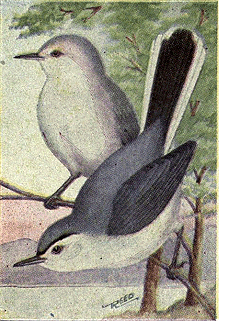
Blue-gray Gnatcatcher. 753. Black-tailed Gnatcatcher. Polioptila californica.
Range.--Pacific coast of southern California
and northern Lower California.
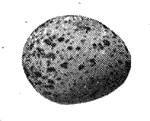
Grayish white. This bird is very similar to the last but has
still less white on the outer tail feathers. Like
the last, the nests of this species
usually lack the exterior
covering of lichens, being made
of vegetable fibres and plant
down, firmly quilted together and
saddled on horizontal limbs or
placed in forks of trees at any
height from the ground. Their eggs are grayish
white, specked with bright reddish brown.
Size .55 × .44. Data.--Escondido, Cal., May 17,
1903. 5 eggs. Nest on a large limb of a sycamore,
30 feet above ground; made of weed
fibres, etc., lined with hair and fine fibres.
THRUSHES, SOLITAIRES, BLUEBIRDS, ETC. Family TURDIDAE
754. Townsend's Solitaire. Myadestes townsendi.
Range.--Western United States, breeding from Arizona, New Mexico and
southern California north to British Columbia.
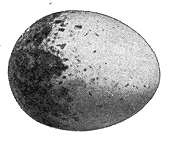
Grayish white. This unique species is of a uniform brownish gray color, with a white eye
ring, narrow bar on wing, and outer tail feathers, and
with the bases of the primaries rusty colored. It is a
ground inhabiting bird, feeding upon insects and berries
in shrubbery and thickets. Their song is said to be liquid,
melodious and often long continued, equaling that of any
other bird. They nest on the ground in hollows under
banks or crevices about roots of trees or fallen stumps,
making a large, loosely constructed pile of weeds and
trash, hollowed and lined with rootlets. The three or
four eggs, which are laid in June, are grayish white,
spotted with pale brown, chiefly or most abundantly about the large end. Size
.96 × .70.
755. Wood Thrush. Hylocichla mustelina.
Range.--Eastern United States, breeding from North Carolina and Kansas
north to northern United States; winters south of our borders.
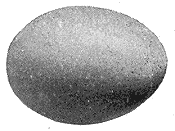
Greenish blue. This Thrush with his brightly spotted breast is the most handsome of this
group of musical birds. They are common in damp woods
and thickets, in which places they breed, placing their
nests of straw, leaves and grasses in low trees usually between
four and ten feet from the ground; their nests are
often very rustic, being ornamented by pieces of paper
and twigs with dead leaves attached hanging from the
sides of the quite bulky structures. During May or June
they lay three or four greenish blue eggs of about the
shade of a Robin's. Size 1.05 × .70.
|
|
|
Page 443
|
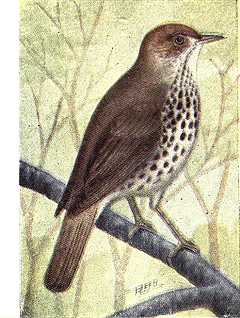
Wood Thrush. 756. Veery. Hylocichla fuscescens fuscescens.
Range.--Eastern North America, breeding in
the northern half of its United States range
and in the southern British Provinces.
The Veery is very abundantly distributed in
woodland, either moist or dry, and nests on
the ground or within a very few inches of it,
usually placing its structures of woven bark
strips and grasses, in the midst of a clump of
sprouts or ferns. The three or four eggs which
they lay in May or June are bluish green, much
darker than those of the Wood Thrush, and
nearly the color of those of the Catbird. Size
.90 × .65.
756a. Willow Thrush. Hylocichla fuscescens salicicola.
Range.--Rocky Mountain region, north to
British Columbia.
The nests and eggs of this similar bird do
not differ from those of the last.
757. Gray-cheeked Thrush. Hylocichla aliciæ aliciæ.
Range.--Breeds from Labrador to Alaska; winters south to Central America.
The nesting habits and eggs of this species are very similar to those of the
following sub-species and the same description will answer for both.
757. Bicknell's Thrush. Hylocichla aliciæ bicknelli.
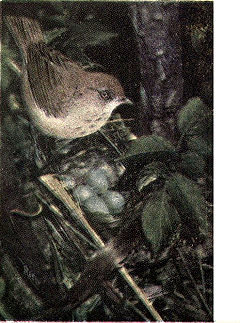
Wilson's Thrush. Range.--Breeds in the Catskills, White Mountains and Nova Scotia.

Greenish blue. These birds, which are practically identical
with the preceding, build their nests at low
elevations in trees, usually evergreens when
present, making them of twigs, moss and rootlets,
lined with fine grasses.
The eggs, which are laid during
May or June, are pale
greenish blue, spotted and
blotched with pale brown or
russet. Size .88 × .64. Data.--Seal
Island, Nova Scotia,
June 3, 1901. Nest of green
moss and rootlets, in a spruce, 5 feet from the
ground.
758. Russet-backed Thrush. Hylocichla ustulata ustulata.
Range.--Pacific coast, breeding in Oregon
and Alaska; winters in Central America.
This species is very abundant in moist
thickets throughout its range, nesting in bushes
and low trees, and making them of weed
stalks, bark strips, grasses and moss, lined
with fine black rootlets.
|

|
|
Page 444
|
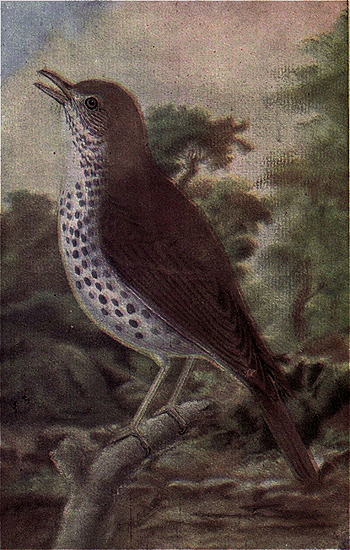
WOOD THRUSH.
|
|
|
Page 445
|
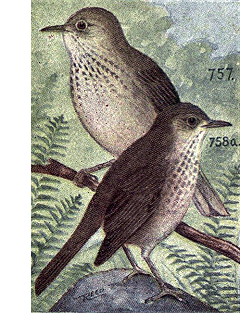
Gray-cheeked Thrush.
Olive-backed Thrush. They are found at
elevations of from two to ten feet above the
ground. Like the Wood Thrush the birds are
tame while sitting on the nest and will allow a
very close approach, without taking alarm;
nests are frequently found which are made almost
entirely out of green
moss and are very handsome
structures.

Greenish blue. Their three to
five eggs are laid in May or
June; they are greenish blue,
spotted with brown of varying
shades. Size .92 × .65.
Data.--Eureka, California,
July 6, 1899. Nest in a fir tree, 5 feet from the
ground; made of moss and strips of redwood
bark. 4 eggs.
758a. Olive-backed Thrush. Hylocichla swainsoni.
Range.--Eastern North America, breeding
chiefly north of the United States, but locally in the northern parts, and abundantly
in mountain ranges.
The nesting habits and eggs of this eastern representative of the last species
are like those of that bird in all respects and the eggs cannot be distinguished
from those of ustulatus.
758b. Olive-Backed Thrush. Hylocichla œdica.
Range.--California and southern Oregon.
Nesting habits and eggs identical with those of ustulatus.
759. Alaska Hermit Thrush. Hylocichla guttata guttata.
Range.--Pacific coast from British Columbia to Alaska. Winters in Mexico.
The Hermit Thrushes can readily be identified from any other by the reddish
brown tail which is in marked contrast to the color of the back. The nesting
habits and eggs of this species are precisely like those of the eastern Hermit
Thrush, which is a sub-species of this.
759a. Audubon's Hermit Thrush. Hylocichla guttata auduboni.
Range.--Rocky Mountain region of the United States. Winters in Central
America.
The nesting habits of this bird are like those of the next except that it more
frequently nests in bushes above the ground. The eggs are not distinctive.

|

|
Page 446

|
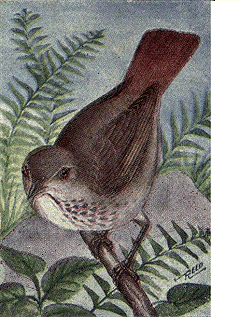
Hermit Thrush. 759b. Hermit Thrush. Hylocichla guttata pallasi.
Range.--Eastern North America, breeding in
northern United States and north to Labrador;
winters in southern United States.
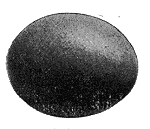
Bluish green. This species, which is noted for its sweet and
musical song, frequents damp swamps and
thickets where it builds its nest either on the
ground or near it, like that of the Wilson
Thrush; it is made of shreds
of bark, grasses, leaves and
rootlets, lined with fine rootlets;
the three or four eggs,
which are deposited in May
or June, are bluish green and
cannot, with certainty, be
distinguished from those of
the Veery; size .85 × .65.
759c. Dwarf Hermit Thrush. Hylocichla guttata nanus.
Range.--Pacific coast of United States, from Washington, southward.
The nesting habits and eggs of this slightly smaller and duller colored variety
are like those of the other Hermit Thrushes.
760. Red-winged Thrush. Turdus musicus.
Range.--An Old World species, accidentally straying to Greenland.
This common European bird nests at low elevations in bushes or trees, laying
four or five bluish green eggs, spotted with reddish brown; size 1.05 × .75.
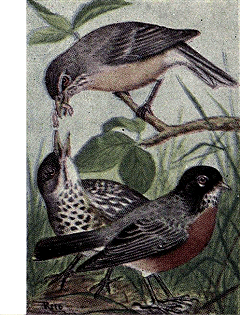
American Robin. 761. Robin. Planesticus migratorius migratorius.
Range.--North America east of the Rockies,
breeding from the middle portions of the United
States, north to the Arctic Ocean.
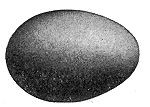
Greenish blue. These common birds nest in trees about
houses, in orchards, open woods, in corners of
fences, on blinds on houses, and in fact almost
every conceivable
position. Their nests
are made of grasses,
firmly cemented together
with mud and lined
with finer grasses;
when placed in trees
they are generally firmly
saddled in crotches
and may be found at any height, from on the
ground to sixty feet above it. Their eggs are
greenish blue; size 1.15 × .80. Eggs may be
found at any time from May until July or
August as they raise several broods a season.
|
|
|
Page 447
|
761b. Southern Robin. Planesticus migratorius achrusterus.
Range.--The Carolinas and Georgia.
The eggs of this bird, which is said to be smaller and duller colored than the
northern variety, show no differences in any respect.
762. San Lucas Robin. Planesticus confinis.
Range.--Southern Lower California.
This is a very much paler form of the American Robin; its eggs probably
will not differ from those of the others.
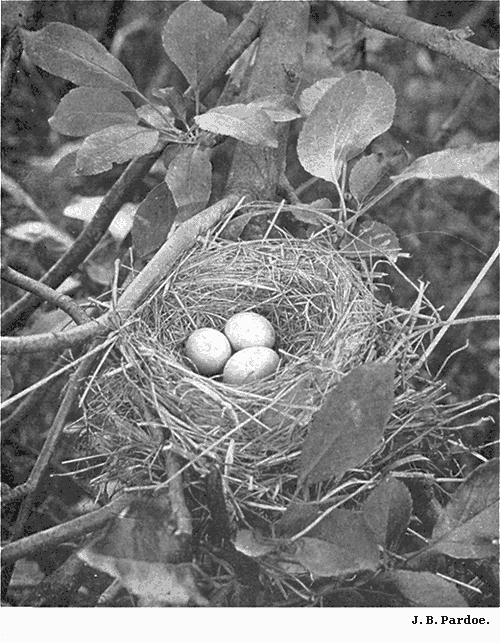
NEST AND EGGS OF ROBIN.
|

|
Page 448

|
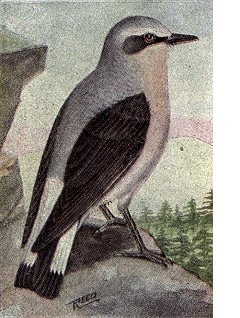
Wheatear. 763. Varied Thrush. Ixoreus nævius nævius.
Range.--Pacific coast from northern California
to Alaska; south to Mexico in winter.

Greenish blue. These handsome birds breed abundantly in
Alaska and locally in mountain ranges south
to northern California. They nest at low elevations
in trees, making
them of moss, twigs,
weeds and grasses,
forming a flat shallow
structure. Their eggs
are greenish blue sharply
but sparingly spotted
with dark brown; size
1.12 × .80. Data.--Delta
of Kowak River, Alaska, June 11, 1899. Four
eggs. Nest 12 feet from the ground, against
the trunk of a slender spruce and supported
by a clump of stiff twigs.
763a. Northern Varied Thrush. Ixoreus nævius meruloides.
Range.--Interior of western North America, breeding from British Columbia
to Alaska. Its habits and eggs do not differ from those of the last.
764. Siberian Red-spotted Bluethroat. Cyanosylvia suecica robusta.
Range.--Northern Asia; casually to Alaska.
This beautiful foreigner nests on the ground and lays four to six greenish blue
eggs, spotted with reddish brown; size .75 × .50.
765. Wheatear. Saxicola œnanthe œnanthe.
Range.--Asia; casual in Alaska in summer; nesting habits and eggs like the
next.
765a. Greenland Wheatear. Saxicola œnanthe leucorhoa.
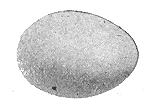
Pale greenish blue. Range.--Europe and Greenland; casual on the Atlantic coast
of North America.
This very abundant Old World species is a common breeding
bird in Greenland and probably also in Labrador. They
nest in crevices of quarries, holes in the ground, or stone
walls, making a rude nest of weeds, moss or grasses, lined
with hair or feathers, and during May lay from four to six
pale greenish blue eggs; size .90 × .60.
|
|
|
Page 449
|
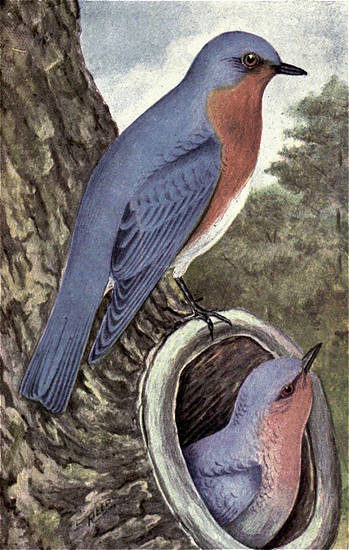
BLUEBIRD.
|
|
Page 450

|
766. Bluebird. Sialia sialis sialis.
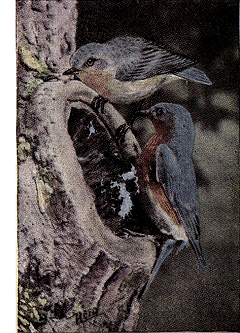
Bluebird. Range.--Eastern United States, breeding from the Gulf to southern Canada.
Winters in the southern half of the United States.

Bluish white. These familiar birds build in cavities in trees,
usually below 20 feet from the ground, crevices
among ledges, bird boxes and in any suitable
nook they may discover about buildings,
providing that English Sparrows do not molest
them. They raise several
broods a year, commencing in
April when they lay from
three to six pale bluish white
eggs (rarely pure white);
size .80 × .60. The cavities
of their nesting sites are lined
with grasses and feathers
usually, although I have found the eggs on
the unlined bottom of cavities in trees.
766a. Azure Bluebird. Sialia sialis fulva.
Range.--This pale variety is found in southern
Arizona and southward.
Its nesting habits are the same and the eggs
are indistinguishable from the last.
[Illustration: ]
767. Western Bluebird. Sialia mexicana occidentalis.
Range.--Pacific coast from Lower California to British Columbia.
The Western Bluebird is as common and familiar in its range as the common
Bluebird is in the east. It nests in similar locations and its eggs are scarcely
distinguishable, although averaging a trifle darker in shade; size .80 × .60.
767a. Chestnut-backed Bluebird. Sialia mexicana bairdi.
Range.--Rocky Mountain region from Mexico to Wyoming.
The nesting habits or eggs of this brighter colored bird do not differ from
those of the last species.
767b. San Pedro Bluebird. Sialia mexicana anabelæ.
Range.--San Pedro Martir Mountains in Lower California.
The eggs of this variety will not in all probability be any different from those
of the preceding Bluebirds.
768. Mountain Bluebird. Sialia currucoides.
Range.--Rocky Mountain region, breeding from New Mexico north to Great
Slave Lake; winters in southwestern United States and Mexico.
This azure blue species is common in the greater part of its range and is found
west to the Sierra Nevadas in California. Like the eastern Bluebird they nest
in holes in trees or anywhere that they can find a suitable cavity or crevice.
Their eggs are slightly larger than those of the other Bluebirds and have a
slight greenish tint; size .85 × .64.
|
|
INDEX
|
Page 451
|
Acanthis hornemanni............... 328
" exilipes........ 328
linaria......................... 329
" holbœli.................. 329
" rostrata................. 329
Acanthopneuste borealis........... 430
Accipiter cooperi................. 205
velox........................... 204
Actitis macularia................. 158
Æchmophorus occidentalis.......... 11
Æegialitis dubia.................. 166
hiaticula....................... 166
meloda.......................... 166
mongola......................... 167
nivosa.......................... 167
semipalmata..................... 165
Aeronautes melanoleucus........... 270
Æstrelata fisheri................. 67
hasitata........................ 67
scalaris........................ 67
Aethia cristatella................ 25
" pygmaea.................... 25
" pusilla.................... 26
Agelaius gubernator californicus.. 317
phœniceus....................... 316
" bryanti............... 316
" caurinus.............. 316
" floridanus............ 316
" fortis................ 316
" neutralis............. 316
" sonoriensis........... 316
tricolor........................ 317
Aimophila carpalis................ 353
ruficeps........................ 353
" eremœca................ 353
" scotti................. 353
" sororia................ 353
Aix sponsa........................ 95
Ajaja ajaja....................... 115
Alauda arvensis................... 297
Alaudidæ.......................... 297
Albatross, Black-footed........... 59
Laysan.......................... 60
Short-tailed.................... 59
Sooty........................... 60
Yellow-nosed.................... 60
Alca torda........................ 31
Alcedinidæ........................ 247
Alcidæ............................ 21
Alle alle......................... 34
Aluconidæ......................... 227
Alucopratincola................... 227
|
Amzillis cerviniventris chalconota 279
tzacatl......................... 278
Ammodramus bairdi................. 338
savannarum australis............ 338
" bimaculatus.......... 338
" floridanus........... 340
Amphispiza belli.................. 351
nevadensis cinerea.............. 352
" nevadensis........... 352
bilineata bilineata............. 351
" deserticola........... 351
Anas platyrhynchos................ 88
fulvigula fulvigula............. 90
" maculosa.............. 91
rubripes........................ 90
Anatidæ........................... 87
Anhinga........................... 77
anhinga......................... 77
Anhingidæ......................... 77
Ani............................... 241
Grove-billed.................... 243
Anous stolidus.................... 57
Anser albifrons albifrons......... 108
" gambeli........... 108
fabalis......................... 108
Anseres........................... 87
Anthus cervinus................... 419
pratensis....................... 418
rubescens....................... 418
spraguei........................ 419
Antrostomus carolinensis.......... 263
vociferus vociferus............. 263
" macromystax........... 264
Aphelocoma californica californica 307
Aphelocoma californica hypoleuca.. 307
" obscura.... 307
cyanea.......................... 306
cyanotis........................ 307
insularis....................... 307
sieberi arizonæ................. 307
" couchi.................. 308
texana.......................... 307
woodhousei...................... 306
Aphriza virgata................... 169
Aphrizidæ......................... 169
Aquila chrysætos.................. 215
Aramidæ........................... 129
Aramus vociferus.................. 129
Archibuteo ferrugineus............ 215
lagopus sancti-johannis......... 214
Archilochus alexandri............. 273
" colubris.............. 273
|
|
|
Page 452
|
Arctonetta fischeri............... 102
Ardea cinerea..................... 122
" herodias.................... 121
" fannini............ 121
" wardi.............. 122
" occidentalis................ 121
Ardeidæ........................... 119
Arenaria interpres interpres...... 169
melanocephala................... 170
morinella....................... 169
Arquatella maritima couesi........ 146
ptilocnemis..................... 147
maritima maritima............... 146
Arremonops rufivirgatus........... 357
Asio accipitrinus................. 229
" flammeus..................... 229
" wilsonianus.................. 227
Astragalinus lawrencei............ 331
psaltria psaltria............... 331
tristis tristis................. 329
" pallidus................ 331
" salicamans.............. 331
Astur atricapillus atricapillus... 205
" striatulus..... 207
Asturina plagiata................. 214
Asyndesmus lewisi................. 257
Atthis morcomi.................... 278
Auk, Great...................... 33-32
Razor-billed.................... 31
Auklet, Cassin's.................. 24
Crested......................... 26
Least........................... 27
Paroquet........................ 26
Rhinoceros...................... 23
Whiskered....................... 26
Auriparus flaviceps flaviceps..... 439
" lamprocephalus.. 439
Avocet............................ 139
Bæolophus atricristatus atricrista-
tus.......................... 433
bicolor......................... 433
inornatus inornatus............. 434
" cineraceus............ 434
" griseus............... 434
wollweberi...................... 434
Baldpate.......................... 92
Bartramia longicauda.............. 156
Basilinna leucotis................ 279
xantusi......................... 279
Becard, Xantus's.................. 280
Bittern........................... 119
Cory's Least.................... 120
Least........................... 120
Blackbird, Bicolored.............. 317
Brewer's........................ 322
Red-winged...................... 316
Rusty........................... 322
|
Tricolored...................... 317
Yellow-headed................... 315
Bluebird.......................... 448
Azure........................... 448
Chestnut-backed................. 450
Mountain........................ 450
San Pedro....................... 450
Western......................... 450
Bluethroat Siberian Red-spotted... 448
Bobolink.......................... 314
Bob-white......................... 175
Florida......................... 175
Masked.......................... 175
Texan........................... 175
Bombycilla cedrorum............... 375
garrula......................... 375
Bombycillidæ...................... 375
Bonasa umbellus umbellus.......... 180
" sabini............ 182
" togata............ 182
" umbelloides....... 182
Booby............................. 75
Blue-faced...................... 74
Blue-footed..................... 74
Brewster's...................... 75
Red-footed...................... 75
Botaurus lentiginosus............. 119
Brachyramphus brevirostris........ 27
craveri's....................... 28
hypoleucus...................... 27
marmoratus...................... 27
Brant............................. 111
Black........................... 111
Branta bernicla glaucogastra...... 111
canadensis canadensis........... 109
" hutchinsi............ 109
" minima............... 109
" occidentalis......... 109
leucopsis....................... 112
Branta nigricans.................. 111
Bubo virginianus virginianus...... 235
" elachistus....... 237
" pacificus........ 235
" pallescens....... 235
" saturatus........ 235
" subarticus....... 235
Budytes flavus alascensis......... 418
Buffle-head....................... 100
Bullfinch, Cassin's............... 325
Bulweria bulweri.................. 67
Bunting, Beautiful................ 367
Indigo.......................... 366
Lark............................ 369
Lazuli.......................... 366
McKay's Snow.................... 333
Painted......................... 367
Pribilof Snow................... 332
|
|
|
Page 453
|
Snow............................ 332
Varied.......................... 367
Bush-Tit.......................... 437
California...................... 438
Grinda's........................ 438
Lead-colored.................... 438
Lloyd's......................... 438
Buteo abbreviatus................. 211
albicaudatus sennetti........... 212
borealis borealis............... 208
" calurus..................... 208
" harlani..................... 209
" krideri..................... 208
brachyurus...................... 213
lineatus lineatus............... 209
" alleni...................... 209
" elegans..................... 211
platypterus..................... 213
swainsoni....................... 212
Buteonidæ......................... 201
Butorides virescens virescens..... 124
" anthonyi............ 125
" frazari............. 125
Buzzard, Turkey................... 199
Calamospiza melanocorys........... 369
Calcarius lapponicus lapponicus... 333
" alascensis......... 333
ornatus......................... 334
pictus.......................... 334
Calidris leucophæa................ 151
Callichelidon cyaneoviridis....... 374
Callothrus robustus...............
Callipepla squamata squamata...... 176
" castanogastris...... 177
Calothorax lucifer................ 278
Calypte anna...................... 275
costæ........................... 275
Campephilus principalis........... 249
labradorius..................... 101
Camptostoma imberbe............... 296
Canachites canadensis canadensis.. 179
" canace............. 179
" osgoodi............ 179
franklini....................... 180
Canvas-back....................... 97
Caprimulgidæ...................... 263
Caracara, Audubon................. 224
Guadalupe....................... 224
Cardellina rubrifrons............. 417
Cardinal.......................... 363
Arizona......................... 363
Florida......................... 364
Gray-tailed..................... 364
San Lucas....................... 363
Cardinalis cardinalis cardinalis.. 363
" canicaudus......... 364
" floridanus.......... 364
|
Cardinalis igneus................. 363
" superbus........... 363
Carpodacus amplus................. 326
cassini......................... 326
mcgregori....................... 326
mexicanus clementis............. 326
" frontalis.......... 326
" ruberrimus........ 326
purpureus purpureus............... 325
" californicus........ 325
Casarca ferruginea................ 93
Catbird........................... 420
Catharista urubu.................. 199
Cathartes aura septentrionalis.... 199
Cathartidæ........................ 198
Catherpes mexicanus albifrons..... 424
" conspersus.......... 425
" punctulatus......... 425
Catoptrophorus semipalmatus semi-
palmatus..................... 155
semipalmatus inornatus.......... 156
Centrocercus urophasianus......... 188
Centurus aurifrons................ 258
carolinus....................... 257
uropygialis..................... 258
Cepphus columba................... 29
grylle.......................... 28
mandti.......................... 29
Cerorhinca monocerata............. 23
Certhia familiaris albescens...... 430
" americana............. 430
" montana............... 430
Certhia familiaris occidentalis... 430
" zelotes................ 430
Certhiidæ......................... 430
Ceryle alcyon..................... 247
americana septentrionalis....... 249
torquata........................ 247
Chachalaca........................ 191
Chæmepelia passerina terrestris... 195
" pallescens......... 195
" bermudiana......... 195
Chætura pelagica.................. 269
vauxi........................... 270
Chamæa fasciata fasciata.......... 437
" henshawi................ 437
Chamæthlypis poliocephala......... 413
Charadriidæ....................... 161
Charadrius apricarius............. 163
dominicus dominicus............. 163
" fulvus...................... 163
Charitonetta albeola.............. 100
Chat, Long-tailed................. 413
Yellow-breasted................. 413
Chaulelasmus streperus............ 91
Chen cærulescens.................. 107
hyperboreus hyperboreus......... 107
|
|
|
Page 454
|
Chen hyperboreus Nivalis.......... 107
rossi........................... 108
Chewink........................... 358
Chickadee......................... 434
Acadian......................... 436
Alaska.......................... 436
Barlow's........................ 437
California...................... 437
Carolina........................ 435
Chestnut-backed................. 437
Hudsonian....................... 436
Long-tailed..................... 435
Mexican......................... 435
Mountain........................ 435
Oregon.......................... 435
Plumbeous....................... 435
Chondestes grammacus grammacus.... 342
strigatus....................... 342
Chordeiles acutipennis texensis... 268
virginianus virginianus......... 266
" chapmani................... 266
" henryi...................... 266
" sennetti.................... 268
Chuck-will's widow................ 263
Ciconiidæ......................... 118
Cinclidæ.......................... 419
Cinclus mexicanus unicolor........ 419
Circus hudsonius.................. 204
Cistothorus stellaris............. 428
Clangula clangula americana....... 99
islandica....................... 99
Coccyges.......................... 241
Coccyzus americanus americanus.... 244
" occidentalis.......... 246
erythrophthalmus................ 246
Cœreba bahamensis................. 385
Cœrebidæ.......................... 385
minor minor..................... 244
" maynardi.................... 244
Colaptes auratus auratus.......... 258
" luteus................ 259
cafer collaris.................. 259
Colaptes cafer saturatior......... 259
chrysoides...................... 262
rufipileus...................... 262
Colinus ridgwayi.................. 175
virginianus..................... 175
" floridanus.................. 175
" texanus.................... 175
Columba fasciata fasciata......... 192
" vioscæ................. 192
flavirostris.................... 192
leucocephala.................... 192
squamosa........................ 192
Columba........................... 192
Columbæ........................... 192
Columbidæ......................... 192
|
Colymbidæ......................... 11
Colymbus auritus.................. 13
dominicus brachypterus.......... 15
holbœlli........................ 11
nigricollis californicus........ 13
Compsothlypis americana ameri
cana......................... 390
americana usneæ................. 390
nigrilora....................... 391
Conuropsis carolinensis........... 241
Coot.............................. 136
European........................ 136
Cormorant......................... 79
Baird's......................... 82
Brandt's........................ 82
Double-crested.................. 79
Farallon........................ 81
Florida......................... 81
Mexican......................... 81
Pelagic......................... 82
Red-faced....................... 82
Violet-green.................... 82
White-crested................... 81
Corvidæ........................... 300
Corvus brachyrhynchos brachy-
rhynchos.................. 312
brachyrhynchos pascuus.......... 312
corax principalis............... 311
" sinuatus............... 311
cryptoleucus.................... 311
ossifragus...................... 312
Cotingidæ......................... 280
Cowbird........................... 314
Dwarf........................... 315
Red-eyed........................ 315
Cracidæ........................... 191
Crake, Corn....................... 135
Spotted......................... 133
Crane, Little Brown............... 127
Sandhill........................ 129
Whooping........................ 127
Creciscus jamaicensis............. 134
coturniculus.................... 134
Creeper, Brown.................... 430
California...................... 430
Mexican......................... 430
Rocky Mountain.................. 430
Sierra.......................... 430
Crex Crex......................... 135
Crossbill......................... 327
Mexican......................... 327
White-winged.................... 327
Crotophaga ani.................... 241
sulcirostris.................... 243
Crow.............................. 312
Carrion......................... 199
Fish............................ 312
|
|
|
Page 455
|
Florida......................... 312
Cryptoglaux funerea richardsoni... 232
acadica acadica................. 232
" scotæa...................... 232
Cuckoo, Black-billed.............. 246
California...................... 246
Kamchatka........................ 246
Mangrove........................ 244
Maynard's....................... 244
Yellow-billed................... 244
Cuculidæ.......................... 241
Cuculus canorus telephonus........ 246
Curlew, Bristle-thighed........... 160
Eskimo.......................... 160
Hudsonian....................... 159
Long-billed..................... 159
Cyanocephalus cyanocephalus....... 313
Cyanolæmus clemenciæ.............. 271
Cyanocitta cristata cristata...... 303
" florincola.......... 303
stelleri stelleri............... 303
" annectens................... 306
" carlottæ.................... 306
" diademata................... 303
" frontalis................... 303
Cyanosylvia suecica robusta....... 448
Cyanthus latirostris.............. 279
Cypseloides niger borealis........ 268
Cyrtonyx montezumæ mearnsi........ 178
Dafila acuta...................... 94
Daption capense................... 67
Darters........................... 77
Dendragapus obscurus obscurus..... 178
" fuliginosus........ 178
" richardsoni....... 179
Dendrocygna autumnalis............ 113
bicolor......................... 113
Dendroica æstiva æstiva........... 392
" rubiginosa........... 392
" sonorana............ 292
auduboni auduboni............... 395
" nigrifrons.................. 395
bryanti castaneiceps............ 394
castanea........................ 398
cærulea......................... 396
cærulescens cærulescens........, 394
" cairnsi..................... 394
chrysoparia..................... 402
coronata........................ 395
discolor........................ 407
dominica albilora............... 401
dominica dominica............... 401
fusca........................... 399
graciæ.......................... 401
kirtlandi....................... 404
magnolia........................ 396
nigrescens...................... 402
|
occidentalis.................... 404
palmarum palmarum............... 405
" hypochrysea................. 405
pensylvanica.................... 398
striata......................... 399
tigrina......................... 391
townsendi....................... 403
vigorsi......................... 405
virens.......................... 403
Dichromanassa rufescens........... 123
Dickcissel........................ 368
Diomedea albatrus................. 59
immutabilis..................... 60
nigripes........................ 59
Diomedeidæ........................ 59
Dipper............................ 419
Dolichonyx oryzivorus............. 314
Dotterel.......................... 161
Dove, Bermuda Ground.............. 195
Blue-headed Quail............... 196
Ground.......................... 195
Inca............................ 196
Key West Quail.................. 196
Mexican Ground.................. 195
Mourning........................ 193
Ruddy Quail..................... 196
White-fronted................... 195
White-winged.................... 195
Zenaida......................... 194
Dovekie........................... 34
Dowitcher......................... 144
Long-billed..................... 145
Dryobates arizonæ................. 252
borealis........................ 252
nuttalli........................ 252
pubescens pubescens............. 251
" gairdneri.................. 251
" homorus.................... 251
" medianus................... 251
" nelsoni.................... 251
" turati...................... 251
scalaris bairdi................. 252
" lucasanus.................. 252
villosus villosus............... 250
" auduboni.................... 250
" harrisi..................... 250
" hyloscopus................. 250
" leucomelas................. 250
" monticola.................. 250
" picoideus.................. 250
Duck, Black....................... 90
Florida......................... 90
Harlequin....................... 101
Labrador........................ 101
Lesser Scaup.................... 98
Masked.......................... 106
Mottled......................... 91
|
|
|
Page 456
|
Ring-necked..................... 98
Ruddy........................... 106
Rufous-crested.................. 95
Scaup........................... 97
Wood............................ 95
Dumetella carolinensis............ 420
Dunlin............................ 149
Eagle, Bald....................... 217
Golden.......................... 215
Gray Sea........................ 217
Northern Bald................... 217
Ectopistes migratorius............ 193
Egret............................. 122
Reddish......................... 123
Snowy........................... 122
Egretta candidissima candidissima. 122
Eider............................. 103
King............................ 104
Northern........................ 102
Pacific......................... 103
Spectacled...................... 102
Steller's....................... 102
Elanoides forficatus.............. 201
Elanus leucurus................... 201
Empidonax difficilis cineritius... 294
difficilis difficilis........... 293
flaviventris.................... 293
fulvifrons pygmæus.............. 296
griseus......................... 296
hammondi........................ 295
minimus......................... 295
trailli trailli................. 294
" alnorum..................... 295
virescens....................... 294
wrighti......................... 295
Ereunetes mauri................... 151
pusillus........................ 150
Erismatura jamaicensis............ 106
Erolia ferruginea................. 149
Eudromias morinellus.............. 161
Eugenes fulgens................... 271
Euphagus carolinus................ 322
cyanocephalus................... 322
Eurynorhynchus pygmeus............ 150
Falco æsalon...................... 221
columbarius columbarius......... 220
" suckleyi.................... 220
fusco-cærulescens............... 221
islandus........................ 218
mexicanus....................... 219
peregrinus anatum............... 220
" pealei...................... 220
" peregrinus................. 219
richardsoni..................... 220
rusticolus rusticolus........... 218
" gyrfalco.................... 218
" obsoletus................... 219
|
sparverius sparverius........... 222
" peninsularis................ 222
" phalœna..................... 221
sparveroides.................... 222
" tinnunculus................. 221
Falcon Aplomado................... 221
Peale's......................... 220
Peregrine....................... 219
Prairie......................... 219
Finch, Aleutian Rosy.............. 327
Black Rosy...................... 328
Brown-capped Rosy............... 328
California Purple............... 325
Cassin's Purple................. 326
Gray-crowned Rosy............... 328
Guadalupe House................. 326
Hepburn's Rosy.................. 328
House........................... 326
McGregor's House................ 326
Purple.......................... 325
San Clemente House.............. 326
San Lucas House................. 326
Flamingo.......................... 115
Flicker........................... 258
Gilded.......................... 262
Guadalupe....................... 262
Northern........................ 259
Northwestern.................... 259
Red-shafted..................... 259
Florida Cœrulea................... 124
Flycatcher, Acadian............... 294
Alder........................... 295
Arizona Crested................. 286
Ash-throated.................... 286
Beardless....................... 296
Buff-breasted................... 296
Coues's......................... 291
Crested......................... 285
Derby........................... 284
Fork-tailed..................... 280
Gray............................ 296
Hammond's....................... 295
Least........................... 295
Lower California................ 287
Flycatcher, Mexican Crested..... 286
Olivaceous...................... 287
Olive-sided..................... 290
San Lucas....................... 294
Scissor-tailed.................. 281
Sulphur-bellied................. 285
Traill's........................ 294
Vermilion....................... 296
Western......................... 293
Wright's........................ 295
Yellow-bellied.................. 293
Fratercula arctica arctica........ 22
" naumanni............ 23
|
|
|
Page 457
|
corniculata..................... 23
Fregata aquila.................... 86
Fregatidæ......................... 86
Fregetta grallaria................ 71
Frigate Bird...................... 86
Fringillidæ....................... 324
Fulica americana.................. 136
atra............................ 136
Fulmar............................ 62
Giant........................... 62
Pacific......................... 63
Rodgers's....................... 63
Slender-billed.................. 63
Fulmarus glacialis glacialis...... 62
" glupischa............. 63
rodgersi........................ 63
Gadwall........................... 91
Gallinæ........................... 175
Gallinago delicata................ 143
gallinago....................... 140
meda............................ 143
Gallinula galeata................. 136
Gallinule, Florida................ 136
Purple.......................... 135
Gannet............................ 76
Gavia adamsi...................... 18
arctica......................... 18
immer........................... 18
stellata........................ 19
pacifica........................ 19
Gaviidæ........................... 17
Gelochelidon nilotica............. 50
Geococcyx californianus........... 243
beldingi........................ 413
trichas arizela................. 412
" trichas..................... 412
" arizela...................... 412
" ignota...................... 412
" occidentalis................ 412
" sinousa..................... 412
Geotrygon chrysia................. 196
montana......................... 196
Glaucidium gnoma californicum..... 239
" gnoma............... 239
hoskinsi........................ 239
phalænoides..................... 240
Glottis nebularia................. 152
Gnatcatcher, Black-tailed......... 442
Blue-gray....................... 441
Plumbeous....................... 441
Western......................... 441
Godwit, Black-tailed.............. 152
Hudsonian....................... 152
Marbled......................... 151
Pacific......................... 152
Golden-eye........................ 99
Barrow's........................ 99
|
Goldfinch......................... 329
Arkansas........................ 331
Black-headed.................... 331
Lawrence's...................... 331
Pale............................ 331
Willow.......................... 331
Goose, American White-fronted..... 108
Barnacle........................ 112
Bean............................ 108
Blue............................ 107
Canada.......................... 109
Cackling........................ 109
Emperor......................... 112
Greater Snow.................... 107
Hutchins's...................... 109
Ross's.......................... 108
Snow............................ 107
White-cheeked................... 109
White-fronted................... 108
Goshawk........................... 205
Mexican......................... 214
Western......................... 207
Grackle, Boat-tailed.............. 323
Bronzed......................... 323
Florida......................... 323
Great-tailed.................... 324
Purple.......................... 323
Grassquit......................... 368
Melodious....................... 368
Grebe, Eared...................... 13
Holbœll's...... .............. 11-12
Horned........................ 12-13
Least........................... 15
Pied-billed................... 15-16
Mexican......................... 15
Western......................... 11
Greenshank........................ 152
Grosbeak, Alaska Pine............. 325
Black-headed.................... 365
Blue............................ 366
California Pine................. 325
Evening......................... 324
Kadiak Pine..................... 325
Pine............................ 324
Rocky Mountain Pine............. 325
Rose-breasted................... 365
Western Blue.................... 366
Western Evening................. 324
Grouse............................
Canada Ruffed................... 182
Columbian Sharp-tailed.......... 187
Dusky........................... 178
Franklin's...................... 180
Gray Ruffed..................... 182
Oregon Ruffed................... 182
Prairie Sharp-tailed............ 187
Richardson's.................... 179
|
|
|
Page 458
|
Ruffed.......................... 180
Sharp-tailed.................... 187
Sooty........................... 178
Gruidæ............................ 127
Grus americana.................... 127
canadensis...................... 127
mexicana........................ 129
Guara alba........................ 117
rubra........................... 117
Guillemot, Black.................. 28
Mandt........................... 29
Pigeon.......................... 29
Guiraca cærulea................... 366
" lazula................. 366
Gull, Bonaparte's................. 48
California...................... 45
Franklin's...................... 48
Glaucous........................ 40
Glaucous-winged................. 42
Great Black-backed.............. 43
Heerman's....................... 46
Herring......................... 44
Iceland......................... 41
Ivory........................... 39
Kittiwake....................... 39
Kumlien......................... 42
Laughing........................ 47
Little.......................... 49
Mew............................. 46
Nelson.......................... 42
Pacific Kittiwake............... 40
Point Barrow.................... 41
Red-legged Kittiwake............ 40
Ring-billed..................... 45
Ross's.......................... 49
Sabine's........................ 49
Short-billed.................... 46
Siberian........................ 44
Slaty-backed.................... 43
Vega............................ 45
Western......................... 44
Gymnogyps californianus........... 198
Gyrfalcon......................... 218
Black........................... 219
Gray............................ 218
White........................... 218
Hæmatopodidæ...................... 170
Hæmatopus bachmani................ 171
frazari......................... 171
ostralegus...................... 170
palliatus....................... 170
Haliæetus albicilla............... 217
leucocephalus leucocephalus..... 217
" alascanus................... 217
Halocyptena microsoma............. 68
Harelda hyemalis.................. 100
|
Hawk, Black Pigeon................ 220
Broad-winged.................... 213
Cooper's........................ 205
Cuban Sparrow................... 222
Desert Sparrow.................. 221
Duck............................ 220
Florida Red-shouldered.......... 209
Harlan's........................ 209
Harris's........................ 207
Krider's........................ 208
Marsh........................... 204
Mexican Black................... 213
Pigeon.......................... 220
Red-bellied..................... 211
Red-shouldered.................. 209
Red-tailed...................... 208
Richardson's Pigeon............. 220
Rough-legged.................... 214
Sennett's White-tailed.......... 212
Sharp-shinned................... 204
Short-tailed.................... 213
Sparrow......................... 222
San Lucas Sparrow............... 222
Swainson's...................... 212
Western Red-tail................ 208
Zone-tailed..................... 211
Heath Hen......................... 186
Heleodytes brunneicapillus affinis 424
" couesi.............. 423
" bryanti............. 424
Helinaia swainsoni................ 386
Helmitheros vermivorus............ 386
Helodromas ochropus............... 155
solitarius solitarius........... 154
" cinnamomeus................ 155
Herodias egretta.................. 122
Herodiones........................ 115
Heron, Anthony's Green............ 125
Black-crowned Night............. 126
European........................ 122
Frazar's Green.................. 125
Great Blue...................... 121
Great White..................... 121
Green........................... 124
Little Blue..................... 124
Louisiana....................... 123
Northwestern Coast.............. 121
Snowy........................... 122
Ward's.......................... 122
Yellow-crowned Night............ 126
Heteractitis incanus.............. 156
Hesperiphona vespertina vespertina 324
vespertina montana.............. 324
Himantopus mexicanus.............. 139
Hirundinidæ....................... 372
Hirundo erythrogastra............. 373
|
|
|
Page 459
|
Histrionicus histrionicus......... 101
Honey Creeper, Bahama............. 385
Hummingbird, Allen's.............. 277
Anna's.......................... 275
Black-chinned................... 273
Blue-throated................... 271
Broad-billed.................... 279
Broad-tailed.................... 276
Buff-bellied.................... 279
Calliope........................ 278
Costa's......................... 275
Lucifer......................... 278
Morcom's........................ 278
Reiffer's....................... 278
Rivoli's........................ 271
Ruby-throated................... 273
Rufous.......................... 276
White-eared..................... 279
Xantus's........................ 279
Hydranassa tricolor ruficollis.... 123
Hydrochelidon leucoptera.......... 57
nigra surinamensis.............. 56
Hylocichla aliciæ aliciæ.......... 443
" bicknelli........... 443
fuscescens fuscescens........... 443
" salicicola................. 443
guttata auduboni................ 445
" guttata..................... 445
" mustelina................... 442
" nanus....................... 446
" pallasi..................... 446
ustulata swainsoni.............. 445
" ustulata.................... 443
Ibididæ........................... 117
Ibis, Glossy...................... 118
Scarlet......................... 117
White........................... 117
White-faced Glossy.............. 118
Wood............................ 118
Icteria virens virens............. 413
" longicauda............. 413
Icteridæ.......................... 314
Icterus melanocephalus auduboni... 319
bullocki........................ 322
cucullatus nelsoni.............. 320
" sennetti.................... 320
galbula......................... 321
parisorum....................... 320
spurius......................... 321
Ictinia mississippiensis.......... 202
Ionornis martinicus............... 135
Iridoprocne bicolor............... 373
Ixobrychus exilis................. 120
neoxenus........................ 120
Ixoreus nævius meruloides......... 448
" nævius................. 448
Jabiru............................ 119
|
Jabiru mycteria................... 119
Jacana, Mexican................... 172
spinosa......................... 172
Jacanidæ.......................... 172
Jæger, Long-tailed................ 37
Parastic........................ 37
Pomarine........................ 36
Jay, Alaska....................... 309
Arizona......................... 307
Belding's....................... 307
Black-headed.................... 306
Blue............................ 303
Blue-eared...................... 307
Blue-fronted.................... 303
California...................... 307
Canada.......................... 308
Couch's......................... 308
Florida......................... 306
Florida Blue.................... 303
Gray............................ 311
Green........................... 308
Labrador........................ 309
Long-crested.................... 303
Oregon.......................... 309
Pinon........................... 313
Queen Charlotte................. 306
Rocky Mountain.................. 309
Santa Cruz...................... 307
Steller's....................... 303
Texas........................... 307
Woodhouse's..................... 306
Xantus's........................ 307
Junco aikeni...................... 348
Arizona......................... 350
Baird's......................... 351
bairdi.......................... 351
Carolina........................ 350
Guadalupe....................... 351
hyemalis hyemalis............... 349
hyemalis carolinensis........... 350
" mearnsi.................... 350
" connectens................. 349
" montanus................... 350
" oreganus................... 349
" pinosus..................... 349
" thurberi.................... 349
insularis......................... 351
mearnsi.........................
Montana......................... 350
Oregon.......................... 349
phæonotus dorsalis.............. 350
" palliatus................... 350
Pink-sided...................... 350
Point Pinos..................... 349
Red-backed...................... 350
Shufeldt's...................... 349
Slate-colored................... 349
|
|
|
Page 460
|
Thurber's....................... 349
Townsend's...................... 350
townsendi's..................... 350
White-winged.................... 348
Kestrel........................... 221
Killdeer.......................... 165
Kingbird.......................... 281
Arkansas........................ 283
Cassin's........................ 284
Couch's......................... 283
Gray............................ 283
Kingfisher, Belted................ 247
Ringed.......................... 247
Texas........................... 249
Kinglet, Dusky.................... 441
Golden-crowned.................. 439
Ruby-crowned.................... 440
Sitka........................... 441
Western Golden crowned.......... 440
Kite, Everglade................... 202
Mississippi..................... 202
Swallow-tailed.................. 201
White-tailed.................... 201
Kittiwake......................... 39
Kittiwake, Pacific.............. 40
Red-legged...................... 40
Knot.............................. 146
Lagopus evermanni................. 184
lagopus lagopus................. 183
" alleni...................... 183
leucurus leucurus............... 185
" peninsularis............... 185
rupestris....................... 183
" atkhensis................... 184
" nelsoni..................... 184
" reinhardi................... 184
" townsendi.................. 184
welchi.......................... 184
Laniidæ........................... 376
Lanius borealis................... 376
ludovicianus ludovicianus....... 376
anthonyi........................ 376
" excubitorides............... 378
" gambeli..................... 378
Lanivireo flavifrons.............. 382
solitarius alticola............. 383
cassini......................... 382
lucasanus....................... 383
plumbeus........................ 382
solitarius...................... 382
Lapwing........................... 161
Laridæ............................ 38
Lark, California Horned........... 298
Desert Horned................... 298
Dusky Horned.................... 299
Horned.......................... 297
Hoyt's Horned................... 299
|
Island Horned................... 299
Montezuma Horned................ 299
Pallid Horned................... 297
Prairie Horned.................. 298
Ruddy Horned.................... 298
Scorched Horned................. 298
Sonora Horned................... 299
Streaked Horned................. 299
Texan Horned.................... 298
Larus affinis..................... 44
argentatus...................... 44
atricilla....................... 47
brachyrhynchus.................. 46
californicus.................... 45
canus........................... 46
delawarensis.................... 45
franklini....................... 48
glaucescens..................... 42
hyporboreus..................... 40
heermanni....................... 46
kumlieni........................ 42
leucopterus..................... 41
marinus......................... 43
minutus......................... 49
nelsoni......................... 42
occidentalis.................... 44
philadelphia.................... 48
schistisagus.................... 43
vegæ............................ 45
Leptotila fulviventris brachyptera 195
Leucosticte, atrata............... 328
australis....................... 328
griseonucha..................... 327
tephrocotis tephrocotis......... 328
" littoralis.................. 328
Limicolæ.......................... 137
Limosa fedoa...................... 151
hæmastica....................... 152
lapponica baueri................ 152
limosa.......................... 152
Limpkin........................... 129
Lobipes Lobatus................... 137
Longipennes....................... 35
Longspur, Alaska.................. 333
Chestnut-collared............... 334
Lapland......................... 333
McCown's........................ 334
Smith's......................... 334
Loon...................... 38-17-20-18
Black-throated.................. 18
Pacific......................... 19
Red-throated.................... 19
Yellow-billed................... 18
Lophodytes cucullatus............. 88
Lophortyx californica............. 177
" vallicola............ 177
gambeli......................... 177
|
|
|
Page 461
|
Loxia curvirostra minor........... 327
" stricklandi.............. 327
leucoptera...................... 327
Lunda cirrhata.................... 22
Machetes Pugnax................... 156
Macrochires....................... 262
Macronectes giganteus............. 62
Macrorhamphus griseus griseus..... 144
" scolopaceus...... 145
Magpie, Yellow-billed............. 300
Mallard........................... 88
Man-o'-War Bird................... 86
Mareca americana.................. 92
penelope........................ 91
Marila affinis.................... 98
americana....................... 95
collaris........................ 98
marila.......................... 97
valisineria..................... 97
Martin, Cuban..................... 372
Purple.......................... 372
Western......................... 372
Meadowlark........................ 317
Rio Grande...................... 317
southern........................ 319
Western......................... 319
Megalestris skua.................. 36
Megaquiscalus major major......... 323
" macrourus........ 324
Melanerpes erythrocephalus........ 256
formicivorus formicivorus....... 256
" angustifrons.............. 257
" bairdi.................... 257
Meleagridæ........................ 178
Meleagris gallopavo intermedia.... 191
" merriami............ 190
" osceola............. 191
" silvestris.......... 190
Melopelia asiatica................ 195
Melospiza melodia caurina......... 355
" cooperi.............. 355
" clementæ............. 355
" fallax............... 354
" graminea............. 355
" heermanni............ 354
" insignis............. 355
" juddi................ 355
" kenaiensis........... 355
" melodia.............. 354
" merrilli............. 355
" montana.............. 354
" morphna.............. 354
" pusillula............ 355
" rivularis............ 355
" rufina............... 355
" samuelis............. 354
georgiana....................... 356
|
lincolni lincolni............... 356
" striata............. 356
Merganser......................... 87
Hooded.......................... 88
Red-breasted.................... 88
Mergus americanus................. 87
serrator........................ 88
Merlin............................ 221
Micropalama himantopus............ 145
Micropallas whitneyi.............. 240
Micropodidæ....................... 268
Mimus polyglottos................. 420
" polyglottos.............. 420
" leucopterus.............. 420
Mniotilta varia................... 385
Mniotiltidæ....................... 385
Mockingbird....................... 420
Western......................... 420
Molothrus ater ater............... 314
" obscurus........................ 315
Motacilla alba.................... 418
ocularis........................ 418
Motacillidæ....................... 418
Murre............................. 29
Brunnich's...................... 31
California...................... 30
Pallas's........................ 31
Murrelet, Ancient................. 26
Craveri's....................... 28
Kittlitz........................ 27
Marbled......................... 27
Xantus.......................... 27
Muscivora forficata............... 281
tyrannus........................ 280
Myadestes townsendi............... 442
Mycteria americana................ 118
Myiarchus cinerascens cinerascens. 286
Myiarchus cinerascens pertinax.... 287
crinitus........................ 285
olivascens...................... 287
magister magister............... 286
nelsoni......................... 286
Myiochanes pertinax pallidiven-
tris........................ 291
richardsoni richardsoni......... 293
" peninsulæ................... 293
virens.......................... 291
Myiodynastes luteiventris......... 285
Nannus alascensis............... 428
meliger......................... 428
niemalis helleri................ 428
" niemalis.................... 427
" pacificus................... 428
Netta rufina...................... 95
Nettion carolinense............... 92
crecca.......................... 92
Nighthawk......................... 266
|
|
|
Page 462
|
Florida......................... 266
Sennett's....................... 268
Texas........................... 268
Western......................... 266
Noddy............................. 57
Nomonyx dominicus................. 106
Nucifraga columbiana.............. 313
Numenius americanus............... 159
borealis........................ 160
hudsonicus...................... 159
phæopus......................... 160
tahitiensis..................... 160
Nutcracker, Clark's............... 313
Nuthatch, Brown-headed............ 432
Florida White-breasted.......... 431
Pygmy........................... 432
Red-breasted.................... 432
Rocky Mountain.................. 431
Slender-billed.................. 431
San Lucas....................... 431
White-breasted.................. 431
White-naped..................... 433
Nuttallornis borealis............. 290
Nyctanassa violacea............... 126
Nyctea nyctea..................... 237
Nycticorax nycticorax nævius...... 126
Nyctidromus albicollis merrilli... 265
Oceanites oceanicus............... 71
Oceanodroma furcata............... 68
homochroa....................... 70
kædingi......................... 69
leucorhoa....................... 69
macrodactyla.................... 69
melania......................... 70
socorrœnsis..................... 70
Ochthodromus wilsonius............ 168
Odontoglossæ...................... 115
Odontophoridæ..................... 175
Oidemia americana................. 104
deglandi........................ 105
fusca........................... 105
perspicillata................... 105
Old-squaw......................... 100
Olor buccinator................... 114
columbianus..................... 114
cygnus.......................... 114
Oporornis agilis.................. 410
formosus........................ 410
philadelphia.................... 411
tolmei.......................... 411
Oreortyx picta picta.............. 176
" confinis.............. 176
" plumifera............. 176
Oreospiza chlorura................ 361
Oriole, Arizona Hooded............ 320
Audubon's....................... 319
Baltimore....................... 321
|
Bullock's....................... 322
Scott's......................... 320
Sennett's....................... 320
Orchard........................... 321
Oreoscoptes montanus.............. 419
Ortalis vetula mccalli............ 191
Osprey............................ 225
Octocoris alpestris alpestris..... 297
" actia................ 298
" adusta............... 299
" articola............. 297
" giraudi.............. 298
" hoyti................ 299
" insularis............ 299
" leucolæma............ 298
" merrilli............. 299
" occidentalis......... 299
" pallida.............. 299
" praticola............ 298
" rubea................ 298
" strigata............. 299
Otus asio aikeni.................. 234
" asio...................... 233
" bendirei.................. 233
" cineraceus................ 234
" floridanus................ 233
" kennicotti................ 233
" macfarlanei............... 234
" maxwelliæ................. 233
" mccalli................... 233
flammeolus flammeolus........... 234
" idahoensis................ 234
Trichopsis...................... 234
Xantusi......................... 234
Ouzel, Water...................... 419
Oven-bird......................... 407
Owl, Aiken's Screech.............. 234
Arctic Horned................... 235
Barn............................ 227
Barred.......................... 229
Burrowing....................... 238
California Pygmy................ 239
California Screech.............. 233
Dusky Horned.................... 235
Dwarf Horned.................... 237
Dwarf Screech................... 234
Elf............................. 240
European Hawk................... 237
Ferruginous Pygmy............... 240
Flammulated Screech............. 234
Florida Barred.................. 229
Florida Burrowing............... 239
" Screech..................... 233
Great Gray...................... 231
Great Horned.................... 235
Hawk............................ 238
Hoskin's Pygmy.................. 239
|
|
|
Page 463
|
Kennicott's Screech............. 233
Lapp............................ 232
Long-eared...................... 227
MacFarlane's Screech............ 234
Mexican Screech................. 234
Northern Spotted................ 231
Northwestern Saw-whet........... 232
Pacific Horned.................. 235
Pygmy........................... 239
Richardson's.................... 232
Rocky Mountain Screech.......... 233
Saw-whet........................ 232
Screech......................... 233
Short-eared..................... 229
Snowy........................... 237
Spotted......................... 237
" Screech................ 234
Texas Barred.................... 231
Texas Screech................... 233
Western Horned.................. 235
Xantus's Screech................ 234
Oxyechus vociferus................ 165
Oyster-catcher.................... 170
European.......................... 170
Black............................. 171
Frazar's.......................... 171
Pagophila alba.................... 39
Paludicolæ........................ 127
Pandion haliætus carolinensis..... 225
Parabuteo unicinctus harrisi...... 207
Parauque, Merrill's............... 265
Paroquet, Carolina................ 241
Parrot, Thick-billed.............. 141
Partridge, Alaska Spruce.......... 179
Canada Spruce................... 179
Hudsonian Spruce................ 179
Passer domesticus................. 335
Passerculus beldingi.............. 337
princeps........................ 337
rostratus rostratus............. 338
" guttatus................... 337
" santorum................... 338
sandwichensis sandwichensis..... 337
" alaudinus.................. 337
" bryanti.................... 337
" savanna.................... 337
Passerella iliaca fuliginosa...... 357
" iliaca........... 357
" insularis........ 357
" megarhyncha...... 357
" schistacea....... 357
" stephensi........ 357
" townsendi........ 357
" unalaschensis.... 357
Passeres.......................... 280
Passerherbulus henslowi henslowi.. 340
" occidentalis.. 340
|
caudacutus...................... 340
lecontei........................ 340
maritimus fisheri............... 341
" macgillivrai..... 342
" maritimus........ 341
" peninsulæ........ 341
" sennetti......... 341
nelsoni nelsoni................. 341
" subvirgatus................ 341
nigrescens...................... 342
Passerina amœna................... 366
ciris........................... 367
cyanea.......................... 366
versicolor versicolor........... 367
" pulchra..................... 367
Pediœcetes phasianellus phasianel
lus....................... 187
phasianellus campestris......... 187
" columbianus................. 187
Pelagodroma marina................ 71
Pelecanidæ........................ 83
Pelecanus californicus............ 85
erythrorhynchos................. 83
occidentalis.................... 85
Pelican, White.................... 83
Brown........................... 85
California Brown................ 85
Pelidna alpina alpina............. 149
" sakhalina............. 149
Penthestes atricapillus atricapillus 434
" occidentalis....... 435
" septentrionalis.... 435
carolinensis agilis............. 435
" carolinensis.......... 435
cinctus alascensis.............. 436
" gambeli.................... 435
hudsonicus hudsonicus........... 436
" littoralis................. 436
rufescens barlowi............... 437
" neglectus.................. 437
" rufescens.................. 437
sclateri........................ 435
Perisoreus canadensis canadensis.. 308
" capitalis......... 309
" fumifrons......... 309
" nigricapillus..... 309
obscurus obscurus............... 309
" griseus.................... 311
Petrel, Ashy...................... 70
Black........................... 70
Black-capped.................... 67
Bulwer's........................ 67
Fisher's........................ 67
Fork-tailed..................... 68
Guadalupe....................... 69
Kæding's........................ 69
Leach's......................... 68
|
|
|
Page 464
|
Least........................... 68
Pintado......................... 67
Scaled.......................... 67
Socorro......................... 70
Storm........................... 68
White-bellied................... 71
White-faced..................... 71
Wilson's........................ 71
Petrochelidon fulva............... 372
lunifrons lunifrons............. 372
melanogastra.................... 373
Peucæa æstivalis æstivalis........ 352
" bachmani................ 352
botterii........................ 352
cassini......................... 353
Peucedramus olivaceus............. 391
Pewee, Western Wood............... 293
Large-billed Wood............... 293
Wood............................ 291
Phæthon americanus................ 72
æthereus........................ 73
rubricaudus..................... 73
Phæthontidæ....................... 72
Phainopepla....................... 376
nitens.......................... 376
Phalacrocoracidæ.................. 78
Phalacrocorax carbo............... 79
auritus auritus................. 79
" albociliatus............... 81
" cincinatus................. 81
" floridanus................. 81
vigua mexicanus................. 81
pelagicus pelagicus............. 82
" resplendens................ 82
" robustus................... 82
penicillatus.................... 82
urile........................... 82
Phalænoptilus nuttalli nuttalli... 264
" californicus..... 264
" nitidus.......... 264
Phalarope, Northern............... 137
Red............................. 137
Wilson's........................ 138
Phalaropodidæ..................... 137
Phalaropus fulicarius............. 137
Phaleris psittacula............... 25
Phasianidæ........................ 188
Phasianus torquatus............... 188
Pheasant, Ring-necked............. 188
Philacte canagica................. 112
Philohela minor................... 140
Phlœotomus pileatus pileatus...... 255
Phœbe............................. 287
Black........................... 289
Say............................. 289
Phœbetria palpebrata.............. 60
Phœnicopteridæ.................... 115
|
Phœnicopterus ruber............... 115
Pica pica hudsonia................ 300
nuttalli........................ 300
Pici.............................. 249
Picidæ............................ 249
Picoides americanus americanus.... 253
" dorsalis.............. 254
" fasciatus............. 254
arcticus........................ 253
Pigeon, Band-tailed............... 192
Passenger....................... 193
Red-billed...................... 192
Scaled.......................... 192
Viosca's........................ 192
White-crowned................... 192
Pinicola enucleator alascensis.... 325
" californica........... 325
" flammula.............. 325
" leucura............... 324
" montana.............. 325
Pintail........................... 94
Pipilo aberti..................... 361
consobrinus..................... 360
erythrophthalmus erythrophthal-
mus......................... 358
erythrophthalmus alleni......... 358
fuscus albigula................. 360
crissalis crissalis............. 360
fuscus mesoleucus............... 360
crissalis senicula.............. 361
maculatus arcticus.............. 358
" clementæ................... 360
" magnirostris............... 360
" megalonyx.................. 360
" montanus................... 358
" oregonus................... 360
Pipit............................. 418
Meadow.......................... 418
Red-throated.................... 419
Sprague's....................... 419
Piranga erythromelas.............. 369
hepatica........................ 370
ludoviciana..................... 369
rubra rubra..................... 370
" cooperi..................... 370
Pisobia aurita.................... 147
bairdi.......................... 148
damacensis...................... 149
fuscicollis..................... 148
maculata........................ 147
minutella....................... 148
Pitangus sulphuratus derbianus.... 284
Planesticus confinis.............. 447
migratorius achrusterus......... 447
" migratorius................ 446
" propinquus................. 446
|
|
|
Page 465
|
Plataleidæ........................ 115
Platypsaris aglaiæ albiventris.... 280
Plautus impennis................ 32-33
Plectrophenax hyperboreus......... 333
nivalis nivalis................. 332
" townsendi................... 332
Plegadis autumnalis............... 118
guarauna........................ 118
Plover, Black-bellied............. 161
European Golden................. 163
Golden.......................... 163
Little Ringed................... 166
Mongolian....................... 167
Mountain........................ 168
Pacific Golden.................. 163
Piping.......................... 166
Ringed.......................... 166
Semipalmated.................... 165
Snowy........................... 167
Upland.......................... 156
Wilson's........................ 168
Podasocys montanus................ 168
Podilymbus podiceps............... 15
Polioptila cærulea cærulea........ 441
" obscura............. 441
californica..................... 442
plumbea......................... 441
Polyborus cheriway................ 224
lutosus......................... 224
Polysticta stelleri............... 102
Poœcetes gramineus gramineus...... 335
" affinis............... 335
" confinis............. 335
Poor-will......................... 264
Dusky........................... 264
Frosted......................... 264
Porzana carolina.................. 133
porzana......................... 133
Prairie Chicken................... 185
Attwater's...................... 186
Lesser.......................... 187
Priocella glacialoides............ 63
Priofinus cinereus................ 66
Procellariidæ..................... 61
Progne cryptoleuca................ 372
subis subis..................... 372
" hesperia.................... 372
Protonotaria citrea............... 386
Psaltriparus melanotis lloydi..... 438
minimus minimus................. 437
" californicus................ 438
" grindæ...................... 438
plumbeus........................ 438
Psittaci.......................... 241
Psittacidæ........................ 241
Ptarmigan, Allen's................ 183
Evermann's...................... 184
|
Kenai White-tailed.............. 185
Nelson's........................ 184
Reinhardt's..................... 184
Rock............................ 183
Townsend's...................... 184
Turner's........................ 184
Welch's......................... 184
White-tailed.................... 185
Willow.......................... 183
Ptychoramphus aleuticus........... 24
Puffin.......................... 22
Horned.......................... 23
Large-billed.................... 23
Tufted.......................... 22
Puffinus assimilis................ 65
auricularis..................... 65
borealis........................ 64
creatopus....................... 65
cuneatus........................ 66
gravis.......................... 64
griseus......................... 66
lherminieri..................... 65
opisthomelas.................... 65
puffinus........................ 64
tenuirostris.................... 66
Pygopodes......................... 10
Pyrocephalus rubineus mexicanus... 296
Pyrrhula cassini.................. 325
Pyrrhuloxia, Arizona.............. 364
sinuata sinuata................. 364
" peninsulæ................... 364
" texana...................... 364
San Lucas....................... 364
Texas........................... 364
California...................... 177
Chestnut Bellied Scaled......... 177
Gambel's........................ 177
Mearn's......................... 178
Quail, Mountain................... 176
Plumed.......................... 176
San Pedro....................... 176
Scaled.......................... 176
Valley.......................... 177
Querquedula cyanoptera............ 93
discors......................... 93
Quiscalus quiscula quiscula....... 323
" aglæus............... 323
" æneus................ 323
Rail, Belding's................... 131
Black........................... 134
California Clapper.............. 131
Carribean Clapper............... 132
Clapper......................... 132
Farallon........................ 134
Florida Clapper................. 132
King............................ 131
Louisiana Clapper............... 132
|
|
|
Page 466
|
Virginia........................ 133
Wayne's Clapper................. 132
Yellow.......................... 131
Rallidæ........................... 131
Rallus beldingi................... 131
crepitans crepitans............. 132
" saturatus................... 132
" scotti...................... 132
" waynei...................... 132
elegans......................... 131
longirostris caribæus........... 132
obsoletus....................... 131
virginianus..................... 132
Raptores.......................... 198
Raven............................. 311
Northern........................ 311
White-necked.................... 311
Recurvirostra americana........... 139
Recurvirostridæ................... 139
Redhead........................... 95
Redpoll........................... 329
Greater......................... 329
Greenland....................... 328
Hoary........................... 328
Holbœll's....................... 329
Redstart.......................... 415
Painted......................... 417
Red-wing, Bahama.................. 316
Bicolored....................... 317
Florida......................... 316
Northwestern.................... 316
San Diego....................... 316
Sonora.......................... 316
Thick-billed.................... 316
Tricolored...................... 317
Regulus calendula calendula....... 440
" grinnelli............. 441
" obscurus.............. 441
satrapa olivaceus............... 440
" satrapa..................... 439
Rhodostethia rosea................ 49
Rhynchophanes mccowni............. 334
Rhynchopsitta pachyrhyncha........ 241
Riparia riparia................... 374
Rissa brevirostris................ 40
tridactyla tridactyla........... 39
" pollicaris................. 40
Road-runner....................... 243
Robin............................. 446
Southern........................ 447
San Lucas....................... 447
Western......................... 446
Rostrhamus sociabilis............. 202
Rough-leg, Ferruginous............ 215
Ruff.............................. 156
Rynchopidæ........................ 58
Rynchops nigra.................... 58
|
Sage Hen.......................... 188
Salpinctes obsoletus obsoletus.... 424
guadeloupensis.................. 424
Sanderling........................ 151
Sandpiper, Aleutian............... 146
Baird........................... 148
Buff-breasted................... 158
Curlew.......................... 149
Green........................... 155
Least........................... 148
Pectoral........................ 147
Pribilof........................ 147
Purple.......................... 146
Red-backed...................... 149
Semipalmated.................... 150
Sharp-tailed.................... 147
Solitary........................ 154
Spoonbill....................... 150
Spotted......................... 158
Stilt........................... 145
Western......................... 151
Western Solitary................ 155
White-rumped.................... 148
Sapsucker, Northern Red-breasted.. 255
Red-breasted.................... 255
Red-naped....................... 254
Williamson's.................... 255
Yellow-bellied.................. 254
Saxicola œnanthe œnanthe.......... 448
" leucorhoa............ 448
Sayornis nigricans................ 289
phœbe........................... 287
sayus........................... 289
Scardafella inca.................. 196
Scolopacidæ....................... 140
Scolopax rusticola................ 140
Scoter............................ 104
Surf............................ 105
Velvet.......................... 105
White-winged.................... 105
Scotiaptex nebulosa lapponica..... 232
" nebulosa............ 231
Seed-eater, Sharpe's.............. 368
Seiurus aurocapillus.............. 407
motacilla....................... 409
noveboracensis noveboracensis... 409
" notabilis................... 409
Selasphorus alleni................ 276
platycercus..................... 276
rufus........................... 277
Steophaga picta................... 417
ruticilla....................... 415
Shearwater, Allied................ 65
Audubon's........................ 65
Black-tailed..................... 66
Black-vented..................... 65
Cory's........................... 64
|
|
|
Page 467
|
Greater......................... 64
Manx............................ 64
Pink-footed..................... 65
Slender-billed.................. 66
Sooty........................... 66
Townsend's...................... 65
Wedge-tailed.................... 66
Sheldrake, Ruddy.................. 93
Shoveller......................... 94
Shrike, California................ 378
Island.......................... 378
Loggerhead...................... 376
Northern........................ 376
White-rumped.................... 378
Sialia currucoides................ 450
mexicana anabelæ................ 450
" bairdi...................... 450
" occidentalis............... 450
sialis sialis................... 448
" fulva....................... 448
Siskin, Pine...................... 332
Sitta canadensis.................. 432
carolinensis carolinensis....... 431
" aculeata.................. 431
" atkinsi..................... 431
" lagunæ...................... 431
" nelsoni..................... 431
pusilla......................... 432
pygmæa pygmæa................... 432
" leuconucha.................. 433
Sittidæ........................... 431
Skimmer, Black.................... 58
Skua.............................. 36
Skylark........................... 297
Snakebird......................... 77
Snipe, European................... 140
Great........................... 143
Wilson's........................ 143
Solitaire, Townsend's............. 442
Somateria dresseri................ 103
mollissima borealis............. 102
spectabilis..................... 104
v-nigra......................... 103
Sora.............................. 133
Sparrow, Acadian Sharp-tailed..... 341
Alameda Song.................... 355
Aleutian Song................... 337
Bachman's....................... 352
Baird's......................... 338
Belding's....................... 337
Bell's.......................... 351
Black-chinned................... 348
Black-throated.................. 351
Botteri's....................... 352
Brewer's........................ 346
Brown's Song.................... 355
Bryant's........................ 337
|
Cassin's........................ 353
Chipping........................ 345
Clay-colored.................... 355
Dakota Song..................... 355
Desert.......................... 351
Desert Song..................... 354
Dusky Seaside................... 342
English......................... 335
Field........................... 348
Florida Grasshopper............. 340
Forbush's....................... 356
Fox............................. 356
Gambel's........................ 343
Golden-crowned.................... 343
Grasshopper..................... 338
Gray Sage....................... 352
Harris's........................ 342
Heermann's Song................. 354
Henslow's....................... 340
Ipswich......................... 337
Kadiak Fox...................... 357
Kenai Song...................... 355
Laguna.......................... 353
Large-billed.................... 338
Lark............................ 342
Leconte's....................... 340
Lincoln's....................... 356
Louisiana Seaside............... 341
Macgillivray's Seaside............ 342
Merrill's Song.................. 355
Mountain Song................... 354
Nelson's........................ 341
Nuttall's....................... 343
Oregon Vesper................... 335
Pine Woods...................... 352
Rock............................ 353
Rufous-crowned.................. 353
Rufous-winged................... 353
Rusty Song...................... 354
Sage............................ 352
Samuel's Song................... 354
San Benito...................... 338
San Clemente Song............... 355
San Diego Song.................. 355
San Lucas....................... 338
Santa Barbara Song.............. 355
Savannah........................ 337
Scott's......................... 353
Scott's Seaside................. 341
Seaside......................... 341
Sharp-tailed.................... 340
Shumagin Fox.................... 357
Slate-colored Fox............... 357
Song............................ 354
Sooty Fox....................... 357
Sooty Song...................... 355
Stephen's Fox................... 357
|
|
|
Page 468
|
Swamp........................... 356
Texas........................... 357
Texas Seaside................... 341
Thick-billed Fox................ 357
Townsend's Fox.................. 357
Tree............................ 345
Vesper.......................... 335
Western Chipping................ 346
Western Field................... 348
Western Grasshopper............. 338
Western Henslow's............... 340
Western Lark.................... 342
Western Savannah................ 337
Western Tree.................... 345
Western Vesper.................. 335
White-crowned................... 343
White-throated.................. 345
Worthen's....................... 348
Yakutat Song.................... 355
Spatula clypeata.................. 94
Speotyto cunicularia floridana.... 239
" hypogæa............... 238
Sphyrapicus ruber ruber........... 255
" notkensis.......... 255
thyroideus...................... 255
varius varius................... 254
" nuchalis.................... 254
Spinus notatus.................... 331
pinus........................... 332
Spiza americana................... 368
Spirella atrogularis.............. 348
breweri......................... 346
monticola monticola............. 345
" ochracea................... 345
passerina arizonæ............... 346
" passerina.................. 345
pallida......................... 346
pusilla pusilla................. 348
" arenacea.................... 348
" arizonæ..................... 346
wortheni........................ 348
Spoonbill, Roseate................ 115
Sporophila morelleti sharpei...... 368
Squatarola squatarola............. 161
Starling.......................... 314
Starnœnas cyanocephala............ 196
Steganopodes...................... 72
Stegonopus tricolor............... 138
Stelgidopteryx serripennis........ 374
Stellula calliope................. 278
Stercorariidæ..................... 35
Stercorarius longicaudus.......... 37
parasiticus..................... 37
pomarinus....................... 36
Sterna aleutica................... 54
anætheta........................ 56
antillarum...................... 55
|
caspia.......................... 50
dougalli........................ 54
elegans......................... 51
forsteri........................ 53
fuscata......................... 55
hirundo......................... 53
maxima.......................... 51
paradisæa....................... 54
sandvicensis acuflavida......... 52
trudeaui........................ 52
Stilt, Black-necked............... 139
Stint, Long-toed.................. 149
Strigidæ.......................... 227
Strix occidentalis caurina........ 231
" occidentalis............ 231
varia allogilva................. 231
" alleni...................... 229
" varia....................... 229
Sturnella magna magna............. 317
" argutula............. 319
" hoopesi.............. 317
" neglecta............. 319
Sturnidæ.......................... 314
Sturnus vulgaris.................. 314
Sula bassana...................... 76
brewsteri....................... 75
cyanops......................... 74
leucogactra..................... 75
nebouxi......................... 74
piscator........................ 75
Sulidæ............................ 74
Surf Bird......................... 169
Sunia ulula ulula................. 237
" caparoch................. 238
Swallow, Bahama................... 374
Bank............................ 374
Barn............................ 373
Cliff........................... 372
Cuban Cliff..................... 373
Mexican Cliff................... 373
Northern Violet-green........... 374
Rough-winged.................... 374
San Lucas....................... 374
Tree............................ 373
Swallow-tailed Kite............... 201
Swan, Trumpeter................... 114
Whistling....................... 114
Whooping........................ 114
Swift, Black...................... 268
Chimney......................... 269
Vaux's.......................... 270
White-throated.................. 270
Slyviidæ.......................... 433
Sylthliboramphus antiquus......... 26
Tachycineta thalassina lepida... 374
" brachyptera..... 374
|
|
|
Page 469
|
Tanager, Cooper's................. 370
Hepatic......................... 370
Western......................... 369
Scarlet......................... 369
Summer.......................... 370
Tangaridæ......................... 369
Tangavius æneus involucratus...... 315
Tattler, Wandering................ 156
Teal, Blue-winged................. 93
Cinnamon........................ 93
European........................ 82
Green-winged.................... 92
Telmatodytes palustris............ 429
" griseus........... 429
" marianæ........... 429
" paludicola........ 429
" plesius........... 429
" palustris......... 429
Tern, Aleutian.................. 54
Arctic.......................... 54
Black........................... 56
Bridled......................... 56
Cabot's......................... 52
Caspian......................... 50
Common.......................... 53
Elegant......................... 51
Forster's....................... 53
Gull-billed..................... 50
Least........................... 55
Roseate......................... 54
Royal........................... 51
Sooty........................... 55
Trudeau's....................... 52
White-winged Black.............. 57
Thalassidroma pelagica............ 68
Thalassogeron culminatus.......... 60
Thrasher, Bendire's............... 422
Brown........................... 421
California...................... 422
Crissal......................... 423
Curve-billed.................... 421
Desert......................... 423
Leconte's....................... 423
Mearns's........................ 422
Palmer's........................ 422
Sage............................ 419
San Lucas....................... 422
Sennett's....................... 421
Thrush, Alaska Hermit............. 445
Audubon's Hermit................ 445
Bicknell's...................... 443
Dwarf Hermit.................... 446
Gray-cheeked.................... 443
Hermit.......................... 446
Olive-backed.................... 445
Northern Varied................. 448
Red-winged...................... 446
|
Russet-backed................... 443
Varied.......................... 448
Willow.......................... 443
Wood............................ 442
Thryomanes bewicki bairdi......... 426
bewicki bewicki................. 426
" calophonus................... 426
" charienturus................ 426
" cryptus..................... 426
" spilurus.................... 426
brevicauda...................... 426
leucophrys...................... 426
Thryothorus ludovicianus ludovi-
cianus.................... 425
ludovicianus lomitensis......... 425
" miamensis.................. 425
Tiaris bicolor.................... 368
canora.......................... 368
Titlark........................... 418
Titmouse, Ashy.................... 434
Black-crested................... 433
Bridled......................... 434
Gray............................ 434
Plain........................... 434
Tufted.......................... 433
Totanus flavipes.................. 153
melanoleucus.................... 153
Towhee............................ 358
Abert's......................... 361
Anthony's....................... 361
Arctic.......................... 358
California...................... 360
Canon........................... 360
Green-tailed.................... 361
Guadalupe....................... 360
Large-billed.................... 360
Mountain........................ 360
Oregon.......................... 360
San Clemente.................... 360
San Diego....................... 360
San Lucas....................... 360
Spurred......................... 358
White-eyed...................... 358
Toxostima bendirei................ 422
cinereum cinereum............... 422
" mearnsi.................... 422
crissale........................ 423
curvirostre curvirostre......... 421
" palmeri.................... 422
lecontei lecontei............... 423
lecontei arenicola.............. 423
longirostre sennetti............ 421
redivivum....................... 422
rufum........................... 421
Tree Duck, Black-bellied.......... 113
Fulvous......................... 113
Tringa canutus.................... 146
|
|
|
Page 470
|
Trochilidæ........................ 271
Troglodytes aëdon aëdon........... 427
" parkmani........... 427
Troglodytidæ...................... 423
Trogon ambiguus................... 246
Coppery-tailed.................. 246
Trogonidæ......................... 246
Tropic Bird, Red-billed........... 73
Red-tailed...................... 73
Yellow-billed................... 72
Troupial..........................
Tryngites subruficollis........... 158
Tubinares......................... 59
Turdidæ........................... 442
Turdus musicus.................... 446
Turkey, Florida................... 191
Merriam's....................... 190
Rio Grande...................... 191
Wild............................ 190
Turnstone......................... 169
Black........................... 170
Ruddy........................... 169
Tympanuchus americanus ameri-
canus..................... 185
americanus attwateri............ 186
cupido.......................... 186
pallidicinctus.................. 187
Tyrannidæ......................... 280
Tyrannus dominicensis............. 283
melancholicus couchi............ 283
tyrannus........................ 281
verticalis...................... 283
vociferans...................... 284
Uria lomvia lomvia................ 30
" arra...................... 31
troille troille................. 29
" californica................. 30
Urubitinga anthracina............. 213
Vanellus vanellus................. 161
Veery............................. 443
Verdin............................ 439
Cape............................ 439
Vermivora bachmani................ 387
pinus........................... 387
celata celata................... 389
" lucescens................... 389
" sordida..................... 390
chrysoptera..................... 388
luciæ........................... 388
peregrina....................... 390
Vermivora rubricapella gutturalis. 389
" rubricapella......... 389
virginiæ........................ 388
Vireo, Anthony's.................. 384
atricapillus.................... 383
Bell's.......................... 384
belli belli..................... 384
|
belli pusillus.................. 385
Bermuda......................... 384
Black-capped.................... 383
Black-whiskered................. 378
Blue-headed..................... 382
Cassin's........................ 382
griseus bermudianus............. 384
" maynardi.................... 383
" micrus...................... 384
Gray............................ 385
Hutton's........................ 384
huttoni huttoni................. 384
" obscurus.................... 384
" stephensi................... 384
Key West........................ 383
Least........................... 385
Mountain........................ 383
Philadelphia.................... 380
Plumbeous....................... 382
Red-eyed........................ 380
San Lucas....................... 383
Small White-eyed................ 384
Stephens's...................... 383
vicinior........................ 385
Warbling........................ 380
Western Warbling................ 382
White-eyed...................... 383
Yellow-green.................... 380
Yellow-throated................. 382
Vireonidæ......................... 378
Vireosylva calidris barbatula..... 378
flavoviridis.................... 380
gilva gilva..................... 380
" swainsoni................... 382
olivacea........................ 380
philadelphica................... 380
Vulture, Black.................... 199
California...................... 198
Turkey.......................... 199
Wagtail Alaska Yellow............. 418
Swinhoe's....................... 418
White........................... 418
Warbler, Alaska Yellow............ 392
Audubon's....................... 395
Bachman's....................... 387
Bay-breasted.................... 398
Black and White................. 385
Blackburnian.................... 399
Black-fronted................... 395
Black-poll...................... 399
Black-throated Blue............. 394
Black-throated Gray............. 402
Black-throated Green............ 403
Blue-winged..................... 387
Cairns's........................ 394
Calaveras....................... 389
Canada.......................... 415
|
|
|
Page 471
|
Cape May........................ 391
Cerulean........................ 396
Chestnut-sided.................. 398
Connecticut..................... 410
Dusky........................... 390
Golden-cheeked.................. 402
Golden Pileolated............... 415
Golden-winged................... 388
Grace's......................... 401
Hermit.......................... 405
Hooded.......................... 414
Kennicott's Willow.............. 439
Kentucky........................ 410
Kirtland's...................... 404
Lucy's.......................... 388
Lutescent....................... 389
Macgillivray's.................. 411
Magnolia........................ 396
Mangrove........................ 394
Mourning........................ 411
Myrtle.......................... 395
Nashville....................... 389
Northern Parula................. 390
Olive........................... 391
Orange-crowned.................. 389
Palm............................ 405
Parula.......................... 390
Pileolated...................... 414
Pine............................ 405
Prairie......................... 407
Prothonotary.................... 386
Red-faced....................... 417
Sennett's....................... 391
Sonora Yellow................... 392
Swainson's...................... 386
Sycamore........................ 401
Tennessee....................... 390
Townsend's...................... 403
Virginia's...................... 388
Wilson's........................ 414
Worm-eating..................... 386
Yellow.......................... 392
Yellow Palm..................... 405
Yellow-throated................. 401
Water Thrush...................... 409
Grinnell's...................... 409
Louisiana....................... 409
Water Turkey...................... 77
Waxwing, Bohemian................. 375
Cedar........................... 375
Wheatear........................ 448
Greenland....................... 448
Whimbrel.......................... 160
Whip-poor-will.................... 263
Stephens's...................... 264
Widgeon, European................. 91
|
Willet............................ 155
Western,........................ 156
Wilsonia canadensis............... 415
citrina......................... 414
pusilla pusilla................. 414
" chryseola................... 415
" pileolata................... 414
Woodcock.......................... 140
European......................... 140
Woodpecker, Alaska Three-toed..... 254
Alpine Three-toed............... 254
Ant-eating...................... 256
Arctic Three-toed............... 253
Arizona......................... 252
Batchelder's.................... 251
Cabanis's....................... 250
California...................... 257
Downy........................... 251
Gairdner's...................... 251
Gila............................ 258
Golden-fronted.................. 258
Hairy........................... 250
Harris's........................ 250
Ivory-billed.................... 249
Lewis's......................... 257
Narrow-fronted.................. 257
Nelson's Downy.................. 251
Northern Hairy.................. 250
Northern Pileated............... 256
Nuttall's....................... 252
Pileated........................ 255
Queen Charlotte................. 250
Red-bellied..................... 257
Red-cockaded.................... 251
Red-headed...................... 256
Rocky Mountain Hairy............ 250
San Lucas....................... 252
Southern Downy.................. 251
Southern Hairy.................. 250
Texas........................... 252
Three-toed...................... 253
White-headed.................... 253
Willow.......................... 251
Wren, Alaska...................... 428
Aleutian........................ 428
Baird's......................... 426
Bewick's........................ 426
Bryant's Cactus................. 424
Cactus.......................... 423
Cañon........................... 425
Carolina........................ 425
Dotted Cañon.................... 425
Florida......................... 425
Guadalupe....................... 426
Guadalupe Rock.................. 424
House........................... 427
Kadiak Winter................... 428
|
|
|
Page 472
|
Lomita.......................... 425
Long-billed Marsh............... 429
Marian's Marsh.................. 429
Seattle......................... 426
Rock............................ 424
San Clemente ................... 426
Short-billed Marsh.............. 428
San Diego....................... 426
San Lucas Cactus................ 424
Texas .......................... 426
Tule............................ 429
Vigors's........................ 426
Western House................... 427
Western Marsh................... 429
Western Winter.................. 428
White-throated ................. 424
Winter.......................... 427
Worthington's Marsh ............ 429
Wren-tit ......................... 437
Pallid ......................... 437
Xanthocephalus xanthocephalus..... 315
Xanthoura luxuosa glaucescens..... 308
|
Xema sabini........................ 49
Xenopicus albolarvatus ........... 253
Yellow-legs ...................... 153
Greater ........................ 153
Yellow-throat, Belding's.......... 413
Florida ........................ 412
Maryland ....................... 412
Pacific ........................ 412
Rio Grande...................... 413
Salt Marsh...................... 412
Western......................... 412
Zamelodia ludoviciana............. 365
melanocephala................... 365
Zenaida zenaida................... 194
Zenaidura macroura carolinensis... 193
Zonotrichia albicollis ........... 345
coronata ....................... 343
leucophrys leucophrys .......... 343
" gambeli .................... 343
" nuttalli.................... 343
querula ........................ 342
|
|
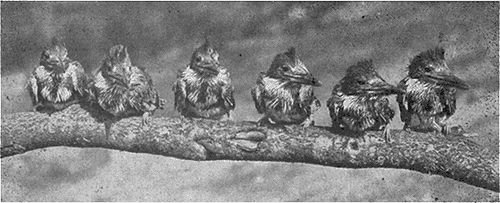
|
Page 473
|
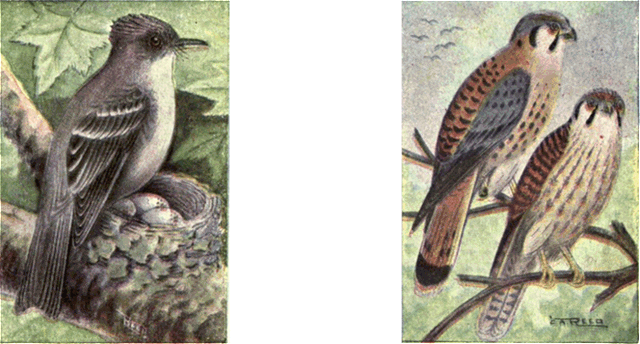
Birds of Eastern North America
By CHESTER A. REED, B. S.
The Bird Book of the year. It is authentic. The author KNOWS birds.
He has studied them for thirty years--in the hand, for plumage, and in their
haunts, for habits. He has studied them in their homes and has photographed
hundreds as they were actually feeding their young. Besides being able to
write about these things in an interesting and instructive manner, he is classed
as one of the foremost bird artists in America. This rare combination of
Artist-Author-Naturalist
has produced, in "Birds of Eastern North America," the
ultimate bird book.
The technical descriptions aided by the pictures give perfect ideas of the
plumage of adults and young.
The descriptive text gives the important and characteristic features in the
lives of the various species.
The illustrations--well, there are 408 PICTURES IN NATURAL COLORS;
they show practically every species, including male, female, and young when
the plumages differ, and they are perfectly made by the best process.
Bound in cloth, handsomely illuminated in gold; 464 pages (4½ × 6½); 408
colored illustrations; every bird described and pictured.
$3.00 postpaid
Color Key To N. A. Birds
By F. M. CHAPMAN and C. A. REED
This might well be called an illustrated dictionary of North American birds,
the male of each species being shown in COLOR from pen and ink drawings.
Uniform with Egg Book. 350 pages.
$2.50 net
|
|
|
Page 474
|
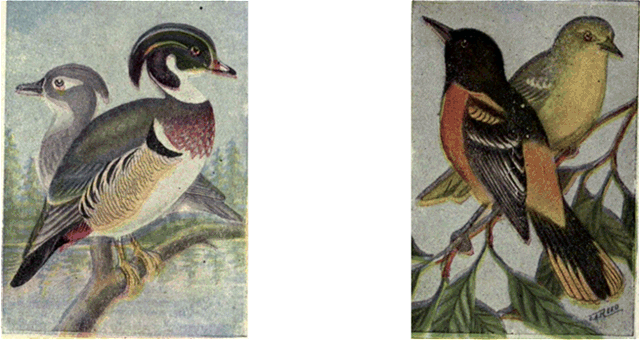

LAND BIRDS
By CHESTER A. REED, B. S.
An illustrated, pocket text book that enables anyone to quickly identify any
song or insectivorous bird found east of the Rocky Mountains. It describes
their habits and peculiarities; tells you where to look for them and describes
their nests, eggs and songs.
EVERY BIRD IS SHOWN IN COLOR, including the females and young
where the plumage differs, from watercolor drawings by the four-color process.
The illustrations are the BEST, the MOST ACCURATE, and the MOST VALUABLE
ever printed in a bird book.
"LAND BIRDS" is the most popular and has the LARGEST SALE (over
300,000 copies) of any bird book published in this country. It is used and recommended
by our leading ornithologists and teachers. 230 pages.
Bound in Cloth, 75c. net; in Leather, $1.00 net; postage 5c.
WATER BIRDS
By CHESTER A. REED, B. S.
This book is uniform in size and scope with LAND BIRDS. It includes all
of the Water Birds, Game Birds and Birds of Prey, east of the Rockies. Each
species is ILLUSTRATED IN COLOR from oil paintings; the bird, its habits
and nesting habits are described.
The pictures show more than 230 birds in color, every species found in our
range. They exceed in number those in any other bird book. In quality they
cannot be surpassed--exquisite gems, each with an attractive background, typical
of the habits of the species.
"LAND BIRDS" and "WATER BIRDS" are the only books, regardless of
price, that describe and show in color every bird. 250 pages, neatly boxed.
Bound in Cloth, $1.00 net; in Leather, $1.25 net; postage 5c.
|
|
|
Page 475
|
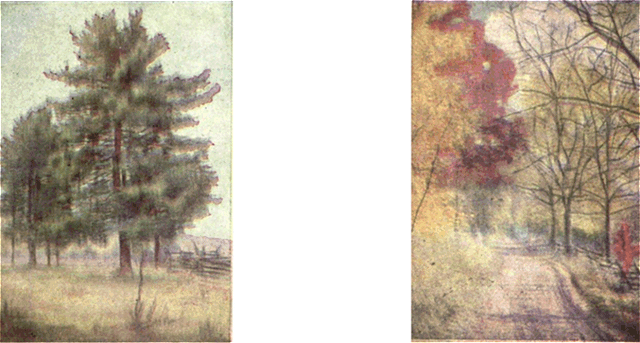
THE TREE GUIDE
By JULIA ELLEN ROGERS
Author of "The Tree Book"
The Tree Guide is uniform in style and size with the well known pocket
Bird Guides which have become so universally popular. It contains illustrations
(32 of them colored and many in black and white) and descriptions of
every tree east of the Rocky Mountains. The descriptions include the range,
the classification, the distinctive features such as flowers, leaves, fruit, etc.,
and all other marks that lead to an easy identification of the tree. No detail
that will help the student has been omitted and the small size of the volume,
about the length and width of the hand, makes it convenient to carry. An
ideal volume for expert naturalist or amateur for field work or even more
exhaustive study.
32 illustrations in color; many in black and white.Cloth, net, $1.00. Leather, net, $1.25
Animal Post Cards
We have been fortunate in securing from the well known artist, Harry F.
Harvey, a number of his best paintings of our North American Wild Animals.
These have been Faithfully reproduced in NATURAL COLORS, postcard size,
and are by far, twenty-five of the best animal cards ever published.
Ask your dealer for the "REED NATURE CARDS."
25 Animals, 25 Birds, 50 Wild Flowers.
ALL IN NATURAL COLORS
If your dealer is out of them we will fill your order (postpaid).
25 Animals for 50c; 25 Birds for 25c; 50 Flowers for
50c.
Special--The complete set of 100 accurately colored cards postpaid, $1.00.
Send for list of Nature Books in Colors.
CHAS. K. REED WORCESTER, MASS.
|
|
|
Page 476
|
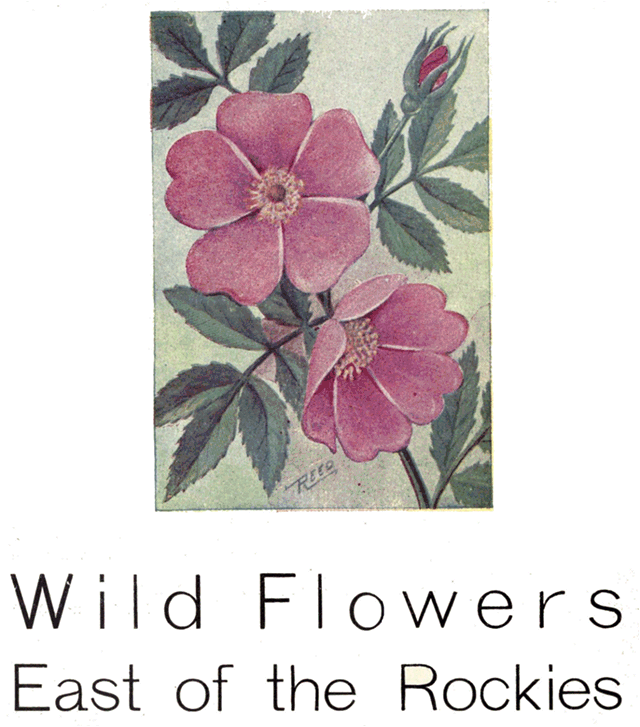
BY
CHESTER A. REED
The latest flower book. In a class by itself. Original, beautiful, compact,
complete, interesting. Pictures 320 flowers, ALL IN COLOR. 450 pages.
Handsomely bound; boxed. $2.50 net; postage 15c
|
|
|
Page 477
|
American Game Birds
By CHESTER A. REED, B. S.
Over ONE HUNDRED SPECIES OF GAME
BIRDS are faithfully depicted by the colored pictures
and the text gives considerable idea of their
habits and tells where they are to be found at
different seasons of the year.
This book is prepared especially at the request
of a large number of sportsmen for a concise
guide devoted solely to game birds and figuring
all species.
Remember that it is the ONLY book at any
price that figures all these game birds in their
proper colors. It is the real sportsmen's guide
and companion. Nicely bound and boxed.
Price 60 cents; postage 5 cents
|
|
|
Page 478
|
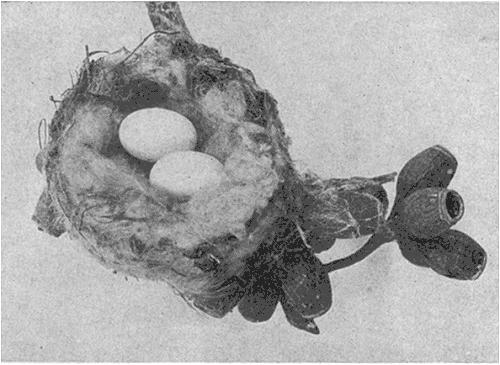
North American Birds' Eggs
By CHESTER A. REED, B. S.
This is the only book on the market that gives illustrations of the eggs of
all North American birds. Each egg is shown FULL SIZE, photographed
directly from an authentic and well marked specimen. There are a great many
full-page plates of nests and eggs in their natural situations.
The habitat and habits of each bird are given.
It is finely printed on the best of paper and handsomely bound in cloth.
350 pages--6 × 9 inches.
$2.50 net
Nature Studies--In Field and Wood
By CHESTER A. REED, B. S.
This book is destined to be one of the most important that the author has
written. Absorbingly interesting in itself, yet its greatest value will lie in
the fact that it will lead the reader to realize how blind he has been to the
many wonderful things that are happening on every hand.
The brook, the pond, the field, the woods, the swamps and even the back
yards yield quantities of very interesting subjects for study. This book treats
entertainingly of many of these interesting creatures, but its chief aim is to be
an "awakener"--to arouse within the reader the desire to go out and verify
some of the facts given, or to do some original investigation himself. Such
studies develop the senses of perception and observation immensely, and the
one who is "alive" to what is going on about him surely is better able to cope
with all situations in life than one who sees nothing until it is forcibly brought
to his attention.
112 pages; size--5½ × 7½ in. 40 illustrations in color, and black and white.
60c. net; postage 10c.
|
|
|
Page 479
|
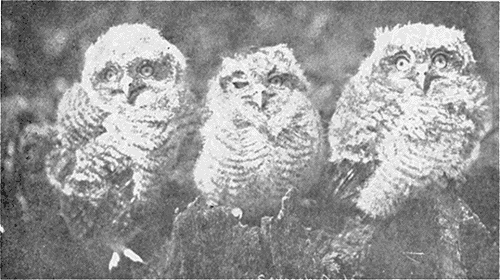
Camera Studies of Wild Birds in Their Homes
By CHESTER A. REED, B. S.
"CAMERA STUDIES" affords everyone an opportunity for a very intimate
study of bird life. A good photograph of an event together with an interesting
description of it is the next best thing to witnessing the event itself.
"CAMERA STUDIES" has 250 photographs of events right in birds' home.
These pictures are selected from the author's collection of over 2000 bird photographs,
this being one of the best collections of pictures of free, living wild
birds in existence.
Many rare and interesting poses are faithfully shown by the camera. For
instance, a pair of adult Chipping Sparrows, standing on a branch by the sides
of their four young, are engaged in pulling apart a large worm that was too
large to be given whole.
The stories accompanying these pictures are as interesting as the photographs
and above all they are all actual facts.
300 pages, 5½ × 7½ in.; 250 photographs of living, wild birds.
Handsomely bound in Cloth, $2.00 net; postage 20c.
Western Bird Guide
This new book, a companion and uniform in size to the Bird and Flower
Guides East of the Rockies, is much more complete and shows every species of
bird, BOTH LAND AND WATER to be found IN THE ROCKY MOUNTAINS
and westward to the PACIFIC COAST, and from Mexico north to the Arctic
regions. EVERY BIRD IN NATURAL COLORS.
320 of them are faithfully pictured, and the text gives the more prominent
identifying features, as well as the habits, haunts and all about their nests and
eggs. 256 pages, bound and neatly boxed.
In Sock Cloth, $1.00 net; in Leather, $1.25 net; postage 5c.
CHAS. K. REED, WORCESTER, MASS.
|
|
|
Page 480
|
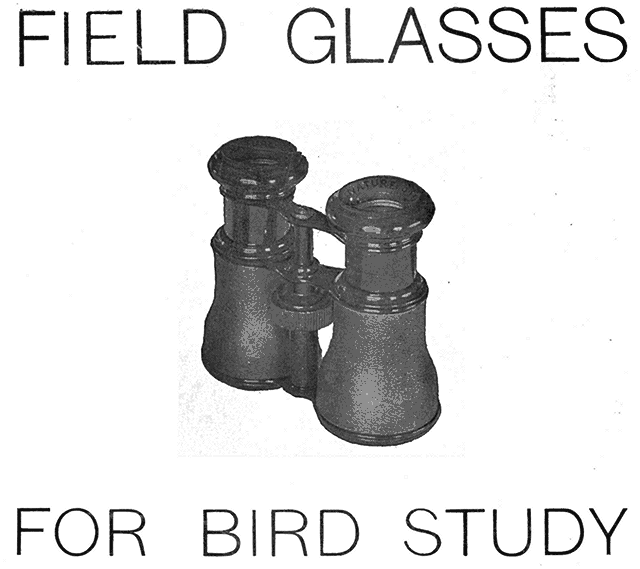
or equally good for the mountains, seashore or theatre, or whenever a large,
clear image of an object is desired.
We carefully examined more than a hundred makes of field glasses, to select
the ones best adapted for bird study.
We found one make that was superior to any other of the same price and
equal optically, and nearly as well made as those costing three times as much.
They magnify about three diameters, and have an unusually large field of
vision or angle of view, making it easy to find a bird or keep him in sight.
Price only $5.00 postpaid.
CHAS. K. REED WORCESTER, MASS.
|
|
End of the Project Gutenberg EBook of The Bird Book, by Chester A. Reed
*** END OF THIS PROJECT GUTENBERG EBOOK THE BIRD BOOK ***
***** This file should be named 30000-h.htm or 30000-h.zip *****
This and all associated files of various formats will be found in:
https://www.gutenberg.org/3/0/0/0/30000/
Produced by David Edwards, Rénald Lévesque and the Online
Distributed Proofreading Canada Team at
http://www.pgdpcanada.net (This file was produced from
images generously made available by The Internet
Archive/American Libraries.)
Updated editions will replace the previous one--the old editions
will be renamed.
Creating the works from public domain print editions means that no
one owns a United States copyright in these works, so the Foundation
(and you!) can copy and distribute it in the United States without
permission and without paying copyright royalties. Special rules,
set forth in the General Terms of Use part of this license, apply to
copying and distributing Project Gutenberg-tm electronic works to
protect the PROJECT GUTENBERG-tm concept and trademark. Project
Gutenberg is a registered trademark, and may not be used if you
charge for the eBooks, unless you receive specific permission. If you
do not charge anything for copies of this eBook, complying with the
rules is very easy. You may use this eBook for nearly any purpose
such as creation of derivative works, reports, performances and
research. They may be modified and printed and given away--you may do
practically ANYTHING with public domain eBooks. Redistribution is
subject to the trademark license, especially commercial
redistribution.
*** START: FULL LICENSE ***
THE FULL PROJECT GUTENBERG LICENSE
PLEASE READ THIS BEFORE YOU DISTRIBUTE OR USE THIS WORK
To protect the Project Gutenberg-tm mission of promoting the free
distribution of electronic works, by using or distributing this work
(or any other work associated in any way with the phrase "Project
Gutenberg"), you agree to comply with all the terms of the Full Project
Gutenberg-tm License (available with this file or online at
https://gutenberg.org/license).
Section 1. General Terms of Use and Redistributing Project Gutenberg-tm
electronic works
1.A. By reading or using any part of this Project Gutenberg-tm
electronic work, you indicate that you have read, understand, agree to
and accept all the terms of this license and intellectual property
(trademark/copyright) agreement. If you do not agree to abide by all
the terms of this agreement, you must cease using and return or destroy
all copies of Project Gutenberg-tm electronic works in your possession.
If you paid a fee for obtaining a copy of or access to a Project
Gutenberg-tm electronic work and you do not agree to be bound by the
terms of this agreement, you may obtain a refund from the person or
entity to whom you paid the fee as set forth in paragraph 1.E.8.
1.B. "Project Gutenberg" is a registered trademark. It may only be
used on or associated in any way with an electronic work by people who
agree to be bound by the terms of this agreement. There are a few
things that you can do with most Project Gutenberg-tm electronic works
even without complying with the full terms of this agreement. See
paragraph 1.C below. There are a lot of things you can do with Project
Gutenberg-tm electronic works if you follow the terms of this agreement
and help preserve free future access to Project Gutenberg-tm electronic
works. See paragraph 1.E below.
1.C. The Project Gutenberg Literary Archive Foundation ("the Foundation"
or PGLAF), owns a compilation copyright in the collection of Project
Gutenberg-tm electronic works. Nearly all the individual works in the
collection are in the public domain in the United States. If an
individual work is in the public domain in the United States and you are
located in the United States, we do not claim a right to prevent you from
copying, distributing, performing, displaying or creating derivative
works based on the work as long as all references to Project Gutenberg
are removed. Of course, we hope that you will support the Project
Gutenberg-tm mission of promoting free access to electronic works by
freely sharing Project Gutenberg-tm works in compliance with the terms of
this agreement for keeping the Project Gutenberg-tm name associated with
the work. You can easily comply with the terms of this agreement by
keeping this work in the same format with its attached full Project
Gutenberg-tm License when you share it without charge with others.
1.D. The copyright laws of the place where you are located also govern
what you can do with this work. Copyright laws in most countries are in
a constant state of change. If you are outside the United States, check
the laws of your country in addition to the terms of this agreement
before downloading, copying, displaying, performing, distributing or
creating derivative works based on this work or any other Project
Gutenberg-tm work. The Foundation makes no representations concerning
the copyright status of any work in any country outside the United
States.
1.E. Unless you have removed all references to Project Gutenberg:
1.E.1. The following sentence, with active links to, or other immediate
access to, the full Project Gutenberg-tm License must appear prominently
whenever any copy of a Project Gutenberg-tm work (any work on which the
phrase "Project Gutenberg" appears, or with which the phrase "Project
Gutenberg" is associated) is accessed, displayed, performed, viewed,
copied or distributed:
This eBook is for the use of anyone anywhere at no cost and with
almost no restrictions whatsoever. You may copy it, give it away or
re-use it under the terms of the Project Gutenberg License included
with this eBook or online at www.gutenberg.org
1.E.2. If an individual Project Gutenberg-tm electronic work is derived
from the public domain (does not contain a notice indicating that it is
posted with permission of the copyright holder), the work can be copied
and distributed to anyone in the United States without paying any fees
or charges. If you are redistributing or providing access to a work
with the phrase "Project Gutenberg" associated with or appearing on the
work, you must comply either with the requirements of paragraphs 1.E.1
through 1.E.7 or obtain permission for the use of the work and the
Project Gutenberg-tm trademark as set forth in paragraphs 1.E.8 or
1.E.9.
1.E.3. If an individual Project Gutenberg-tm electronic work is posted
with the permission of the copyright holder, your use and distribution
must comply with both paragraphs 1.E.1 through 1.E.7 and any additional
terms imposed by the copyright holder. Additional terms will be linked
to the Project Gutenberg-tm License for all works posted with the
permission of the copyright holder found at the beginning of this work.
1.E.4. Do not unlink or detach or remove the full Project Gutenberg-tm
License terms from this work, or any files containing a part of this
work or any other work associated with Project Gutenberg-tm.
1.E.5. Do not copy, display, perform, distribute or redistribute this
electronic work, or any part of this electronic work, without
prominently displaying the sentence set forth in paragraph 1.E.1 with
active links or immediate access to the full terms of the Project
Gutenberg-tm License.
1.E.6. You may convert to and distribute this work in any binary,
compressed, marked up, nonproprietary or proprietary form, including any
word processing or hypertext form. However, if you provide access to or
distribute copies of a Project Gutenberg-tm work in a format other than
"Plain Vanilla ASCII" or other format used in the official version
posted on the official Project Gutenberg-tm web site (www.gutenberg.org),
you must, at no additional cost, fee or expense to the user, provide a
copy, a means of exporting a copy, or a means of obtaining a copy upon
request, of the work in its original "Plain Vanilla ASCII" or other
form. Any alternate format must include the full Project Gutenberg-tm
License as specified in paragraph 1.E.1.
1.E.7. Do not charge a fee for access to, viewing, displaying,
performing, copying or distributing any Project Gutenberg-tm works
unless you comply with paragraph 1.E.8 or 1.E.9.
1.E.8. You may charge a reasonable fee for copies of or providing
access to or distributing Project Gutenberg-tm electronic works provided
that
- You pay a royalty fee of 20% of the gross profits you derive from
the use of Project Gutenberg-tm works calculated using the method
you already use to calculate your applicable taxes. The fee is
owed to the owner of the Project Gutenberg-tm trademark, but he
has agreed to donate royalties under this paragraph to the
Project Gutenberg Literary Archive Foundation. Royalty payments
must be paid within 60 days following each date on which you
prepare (or are legally required to prepare) your periodic tax
returns. Royalty payments should be clearly marked as such and
sent to the Project Gutenberg Literary Archive Foundation at the
address specified in Section 4, "Information about donations to
the Project Gutenberg Literary Archive Foundation."
- You provide a full refund of any money paid by a user who notifies
you in writing (or by e-mail) within 30 days of receipt that s/he
does not agree to the terms of the full Project Gutenberg-tm
License. You must require such a user to return or
destroy all copies of the works possessed in a physical medium
and discontinue all use of and all access to other copies of
Project Gutenberg-tm works.
- You provide, in accordance with paragraph 1.F.3, a full refund of any
money paid for a work or a replacement copy, if a defect in the
electronic work is discovered and reported to you within 90 days
of receipt of the work.
- You comply with all other terms of this agreement for free
distribution of Project Gutenberg-tm works.
1.E.9. If you wish to charge a fee or distribute a Project Gutenberg-tm
electronic work or group of works on different terms than are set
forth in this agreement, you must obtain permission in writing from
both the Project Gutenberg Literary Archive Foundation and Michael
Hart, the owner of the Project Gutenberg-tm trademark. Contact the
Foundation as set forth in Section 3 below.
1.F.
1.F.1. Project Gutenberg volunteers and employees expend considerable
effort to identify, do copyright research on, transcribe and proofread
public domain works in creating the Project Gutenberg-tm
collection. Despite these efforts, Project Gutenberg-tm electronic
works, and the medium on which they may be stored, may contain
"Defects," such as, but not limited to, incomplete, inaccurate or
corrupt data, transcription errors, a copyright or other intellectual
property infringement, a defective or damaged disk or other medium, a
computer virus, or computer codes that damage or cannot be read by
your equipment.
1.F.2. LIMITED WARRANTY, DISCLAIMER OF DAMAGES - Except for the "Right
of Replacement or Refund" described in paragraph 1.F.3, the Project
Gutenberg Literary Archive Foundation, the owner of the Project
Gutenberg-tm trademark, and any other party distributing a Project
Gutenberg-tm electronic work under this agreement, disclaim all
liability to you for damages, costs and expenses, including legal
fees. YOU AGREE THAT YOU HAVE NO REMEDIES FOR NEGLIGENCE, STRICT
LIABILITY, BREACH OF WARRANTY OR BREACH OF CONTRACT EXCEPT THOSE
PROVIDED IN PARAGRAPH F3. YOU AGREE THAT THE FOUNDATION, THE
TRADEMARK OWNER, AND ANY DISTRIBUTOR UNDER THIS AGREEMENT WILL NOT BE
LIABLE TO YOU FOR ACTUAL, DIRECT, INDIRECT, CONSEQUENTIAL, PUNITIVE OR
INCIDENTAL DAMAGES EVEN IF YOU GIVE NOTICE OF THE POSSIBILITY OF SUCH
DAMAGE.
1.F.3. LIMITED RIGHT OF REPLACEMENT OR REFUND - If you discover a
defect in this electronic work within 90 days of receiving it, you can
receive a refund of the money (if any) you paid for it by sending a
written explanation to the person you received the work from. If you
received the work on a physical medium, you must return the medium with
your written explanation. The person or entity that provided you with
the defective work may elect to provide a replacement copy in lieu of a
refund. If you received the work electronically, the person or entity
providing it to you may choose to give you a second opportunity to
receive the work electronically in lieu of a refund. If the second copy
is also defective, you may demand a refund in writing without further
opportunities to fix the problem.
1.F.4. Except for the limited right of replacement or refund set forth
in paragraph 1.F.3, this work is provided to you 'AS-IS' WITH NO OTHER
WARRANTIES OF ANY KIND, EXPRESS OR IMPLIED, INCLUDING BUT NOT LIMITED TO
WARRANTIES OF MERCHANTIBILITY OR FITNESS FOR ANY PURPOSE.
1.F.5. Some states do not allow disclaimers of certain implied
warranties or the exclusion or limitation of certain types of damages.
If any disclaimer or limitation set forth in this agreement violates the
law of the state applicable to this agreement, the agreement shall be
interpreted to make the maximum disclaimer or limitation permitted by
the applicable state law. The invalidity or unenforceability of any
provision of this agreement shall not void the remaining provisions.
1.F.6. INDEMNITY - You agree to indemnify and hold the Foundation, the
trademark owner, any agent or employee of the Foundation, anyone
providing copies of Project Gutenberg-tm electronic works in accordance
with this agreement, and any volunteers associated with the production,
promotion and distribution of Project Gutenberg-tm electronic works,
harmless from all liability, costs and expenses, including legal fees,
that arise directly or indirectly from any of the following which you do
or cause to occur: (a) distribution of this or any Project Gutenberg-tm
work, (b) alteration, modification, or additions or deletions to any
Project Gutenberg-tm work, and (c) any Defect you cause.
Section 2. Information about the Mission of Project Gutenberg-tm
Project Gutenberg-tm is synonymous with the free distribution of
electronic works in formats readable by the widest variety of computers
including obsolete, old, middle-aged and new computers. It exists
because of the efforts of hundreds of volunteers and donations from
people in all walks of life.
Volunteers and financial support to provide volunteers with the
assistance they need are critical to reaching Project Gutenberg-tm's
goals and ensuring that the Project Gutenberg-tm collection will
remain freely available for generations to come. In 2001, the Project
Gutenberg Literary Archive Foundation was created to provide a secure
and permanent future for Project Gutenberg-tm and future generations.
To learn more about the Project Gutenberg Literary Archive Foundation
and how your efforts and donations can help, see Sections 3 and 4
and the Foundation web page at https://www.pglaf.org.
Section 3. Information about the Project Gutenberg Literary Archive
Foundation
The Project Gutenberg Literary Archive Foundation is a non profit
501(c)(3) educational corporation organized under the laws of the
state of Mississippi and granted tax exempt status by the Internal
Revenue Service. The Foundation's EIN or federal tax identification
number is 64-6221541. Its 501(c)(3) letter is posted at
https://pglaf.org/fundraising. Contributions to the Project Gutenberg
Literary Archive Foundation are tax deductible to the full extent
permitted by U.S. federal laws and your state's laws.
The Foundation's principal office is located at 4557 Melan Dr. S.
Fairbanks, AK, 99712., but its volunteers and employees are scattered
throughout numerous locations. Its business office is located at
809 North 1500 West, Salt Lake City, UT 84116, (801) 596-1887, email
business@pglaf.org. Email contact links and up to date contact
information can be found at the Foundation's web site and official
page at https://pglaf.org
For additional contact information:
Dr. Gregory B. Newby
Chief Executive and Director
gbnewby@pglaf.org
Section 4. Information about Donations to the Project Gutenberg
Literary Archive Foundation
Project Gutenberg-tm depends upon and cannot survive without wide
spread public support and donations to carry out its mission of
increasing the number of public domain and licensed works that can be
freely distributed in machine readable form accessible by the widest
array of equipment including outdated equipment. Many small donations
($1 to $5,000) are particularly important to maintaining tax exempt
status with the IRS.
The Foundation is committed to complying with the laws regulating
charities and charitable donations in all 50 states of the United
States. Compliance requirements are not uniform and it takes a
considerable effort, much paperwork and many fees to meet and keep up
with these requirements. We do not solicit donations in locations
where we have not received written confirmation of compliance. To
SEND DONATIONS or determine the status of compliance for any
particular state visit https://pglaf.org
While we cannot and do not solicit contributions from states where we
have not met the solicitation requirements, we know of no prohibition
against accepting unsolicited donations from donors in such states who
approach us with offers to donate.
International donations are gratefully accepted, but we cannot make
any statements concerning tax treatment of donations received from
outside the United States. U.S. laws alone swamp our small staff.
Please check the Project Gutenberg Web pages for current donation
methods and addresses. Donations are accepted in a number of other
ways including including checks, online payments and credit card
donations. To donate, please visit: https://pglaf.org/donate
Section 5. General Information About Project Gutenberg-tm electronic
works.
Professor Michael S. Hart was the originator of the Project Gutenberg-tm
concept of a library of electronic works that could be freely shared
with anyone. For thirty years, he produced and distributed Project
Gutenberg-tm eBooks with only a loose network of volunteer support.
Project Gutenberg-tm eBooks are often created from several printed
editions, all of which are confirmed as Public Domain in the U.S.
unless a copyright notice is included. Thus, we do not necessarily
keep eBooks in compliance with any particular paper edition.
Most people start at our Web site which has the main PG search facility:
https://www.gutenberg.org
This Web site includes information about Project Gutenberg-tm,
including how to make donations to the Project Gutenberg Literary
Archive Foundation, how to help produce our new eBooks, and how to
subscribe to our email newsletter to hear about new eBooks.














































































































































































































































































































































































































































